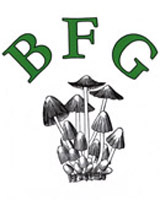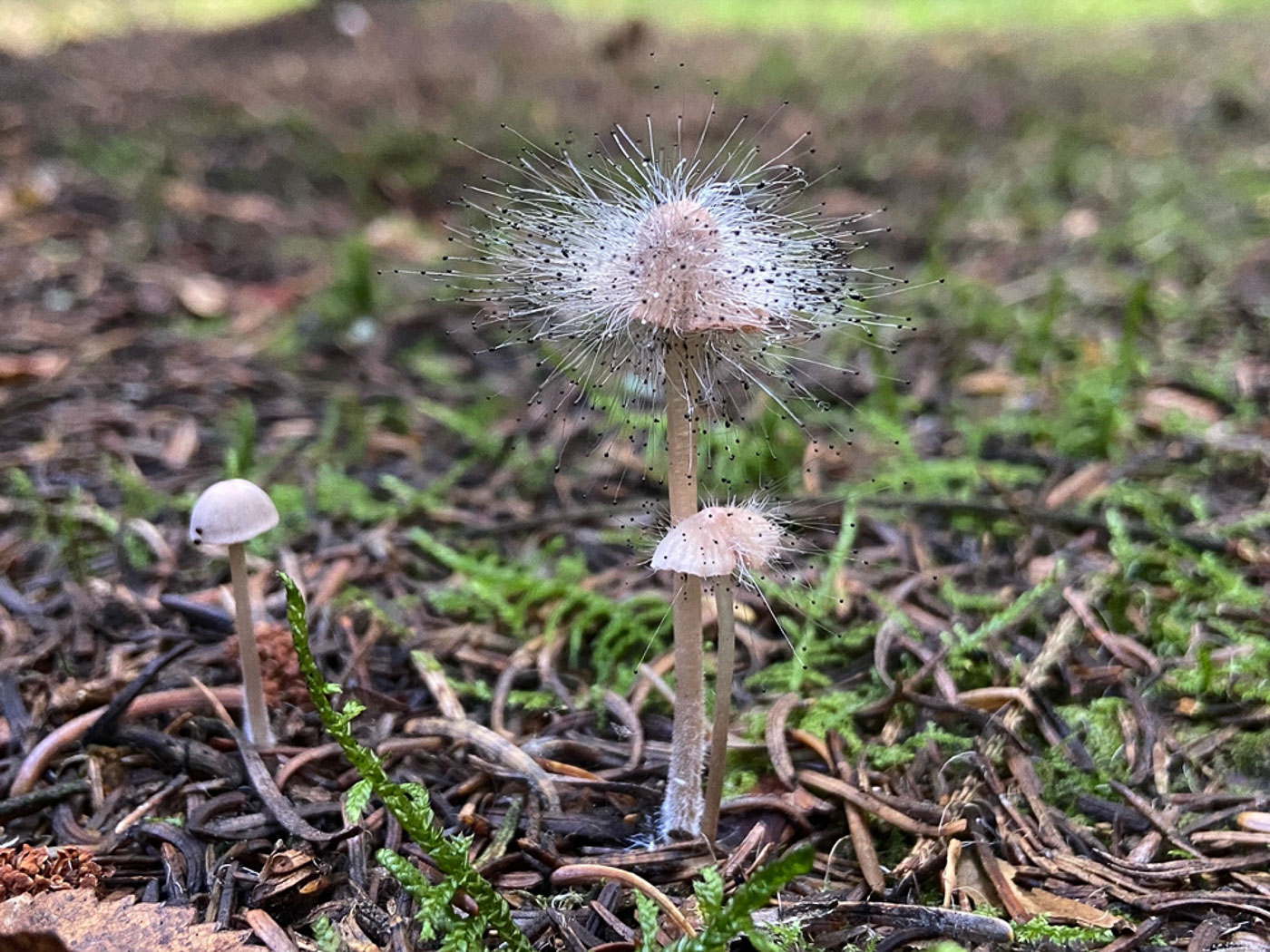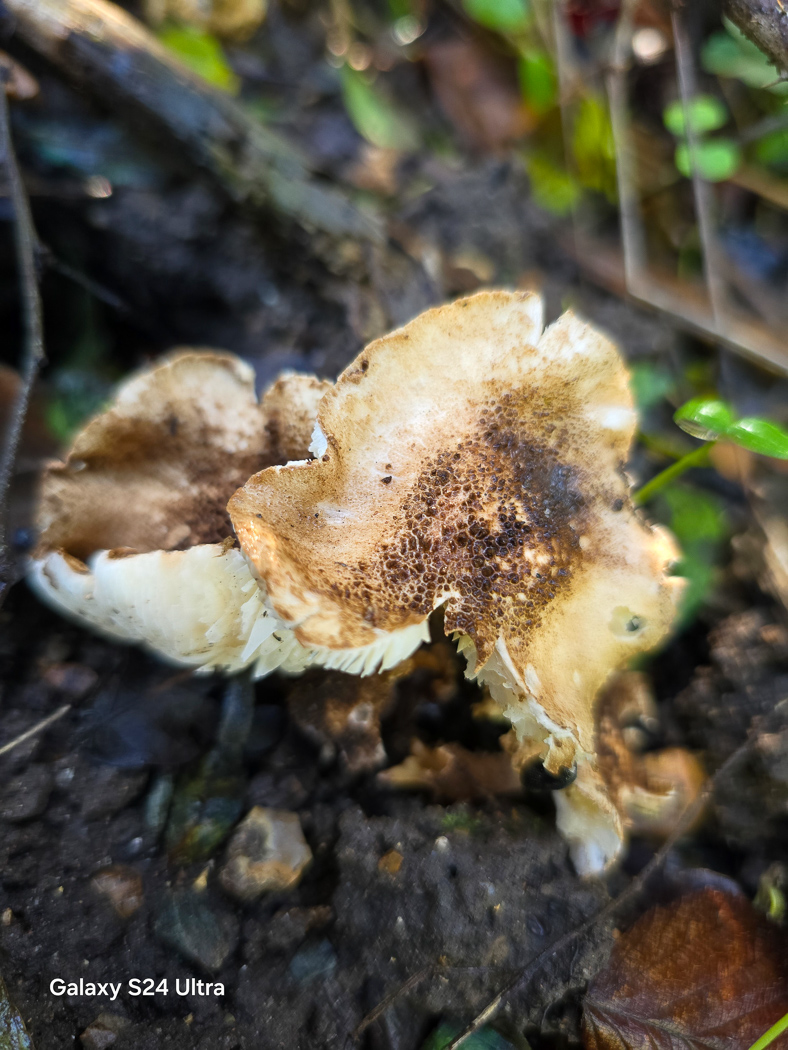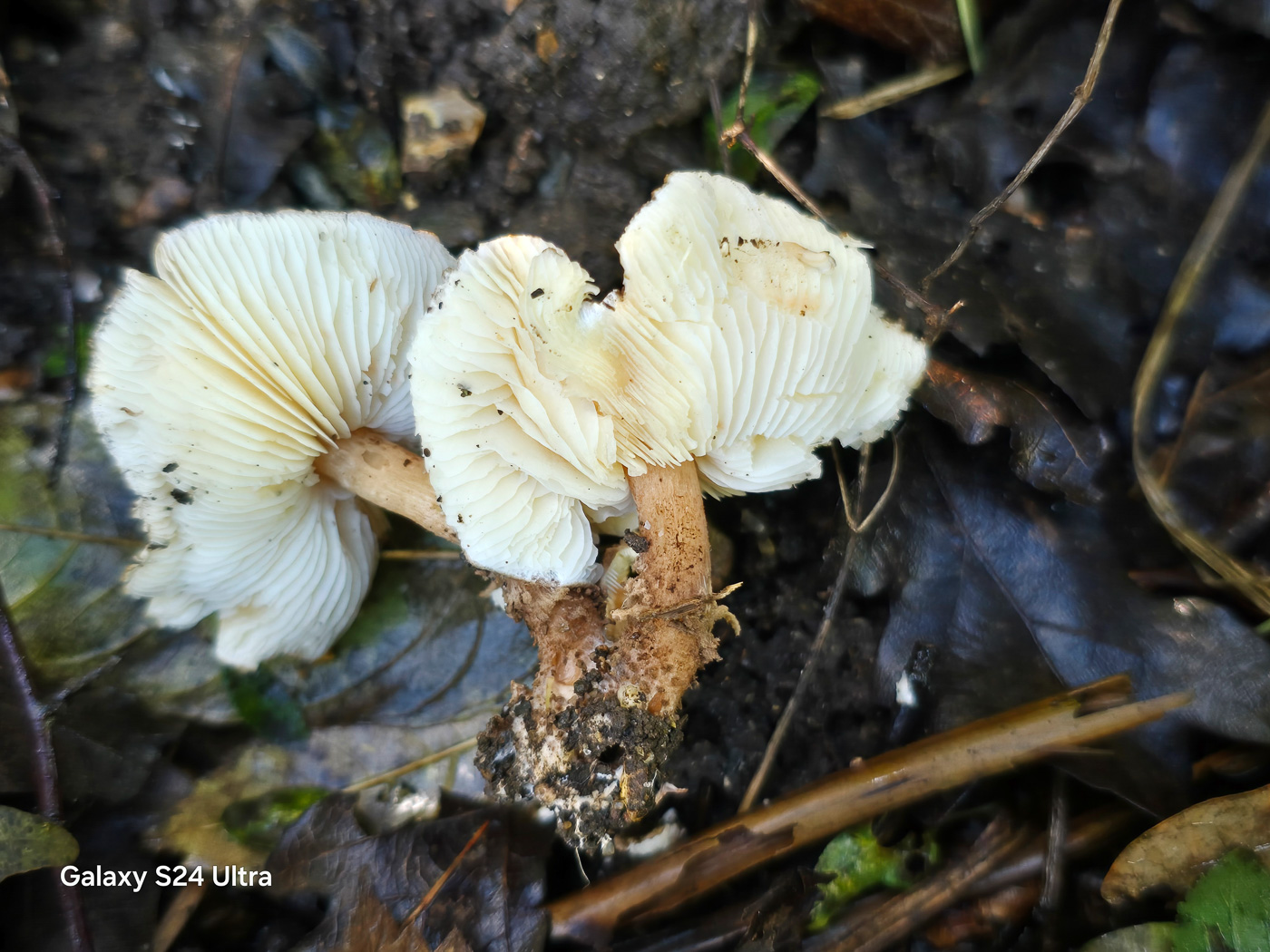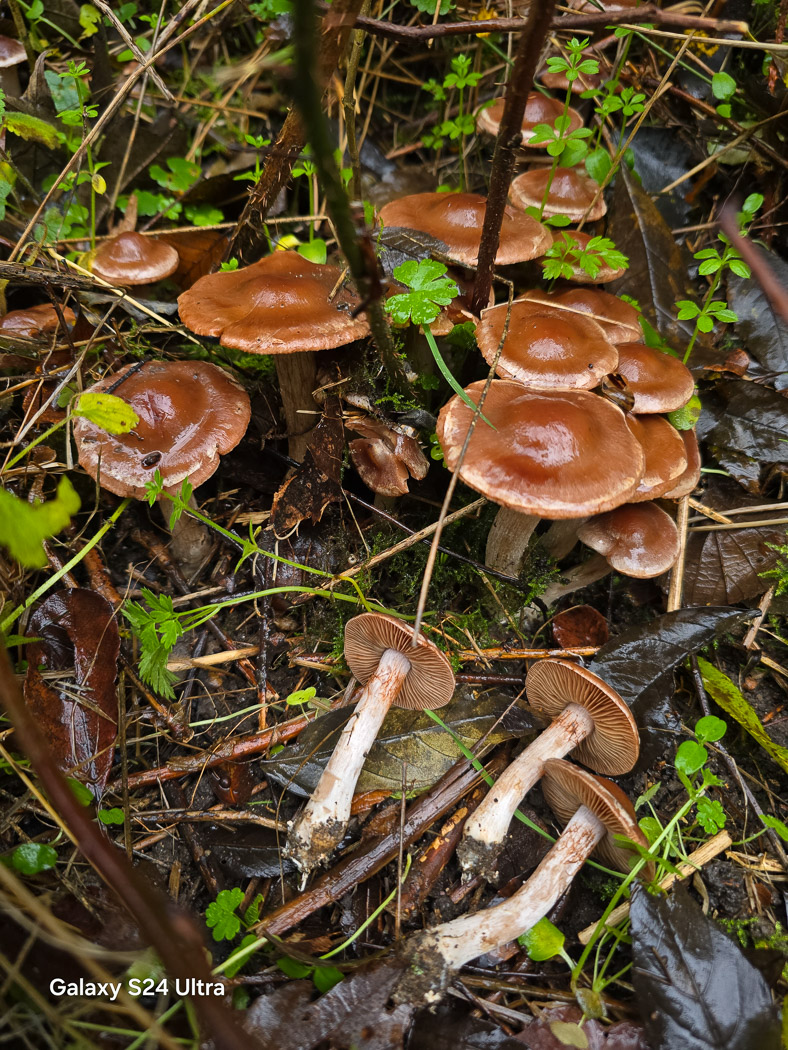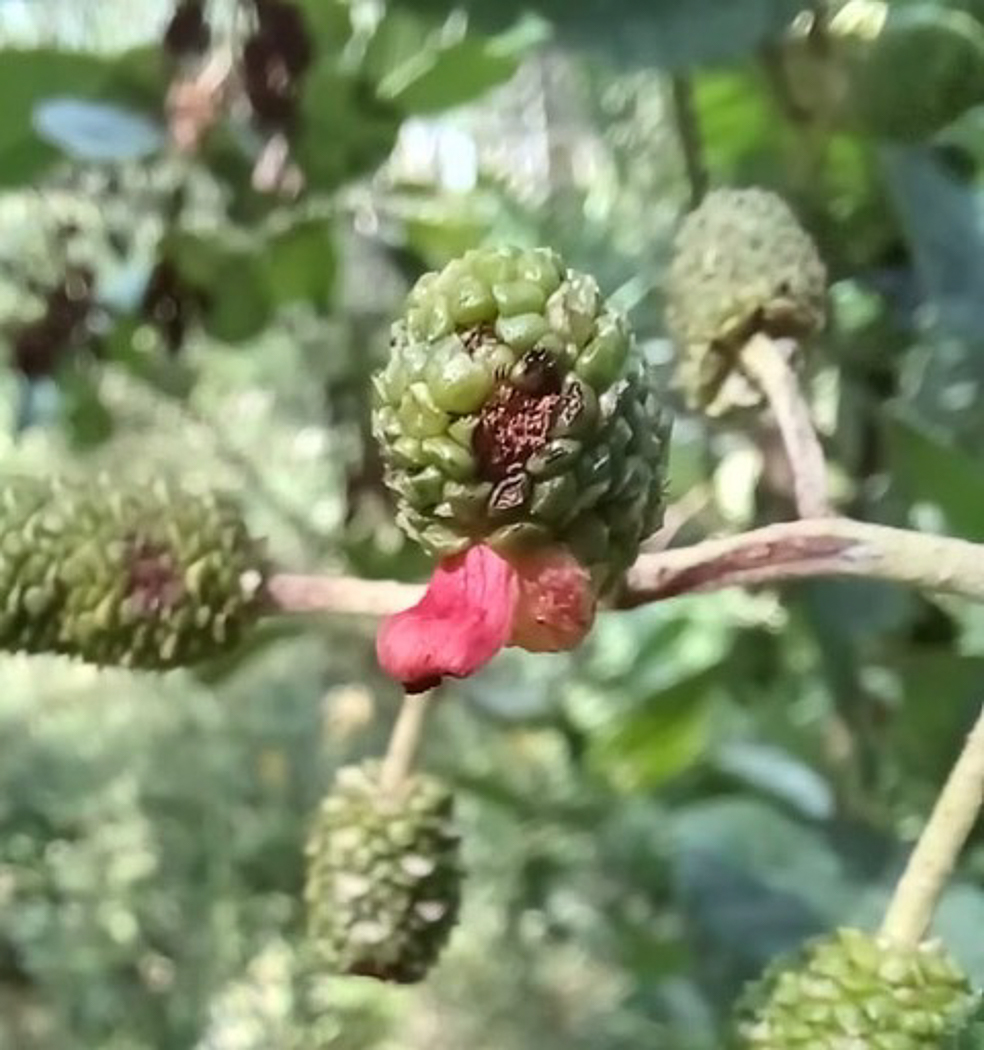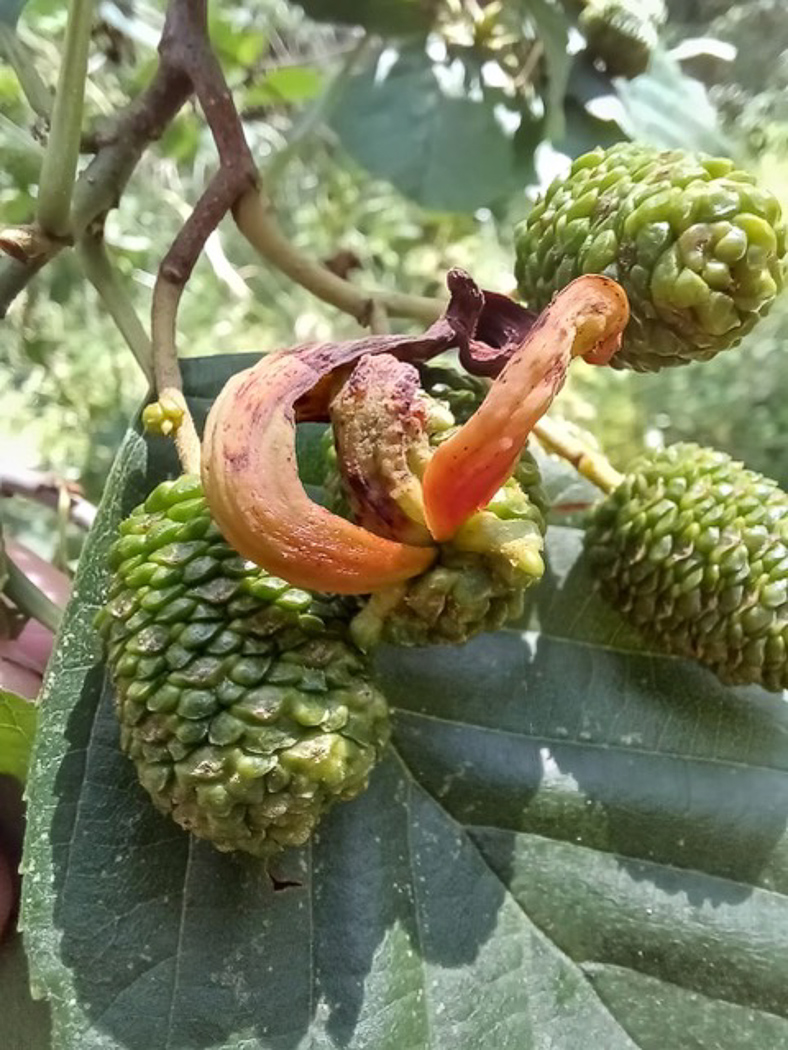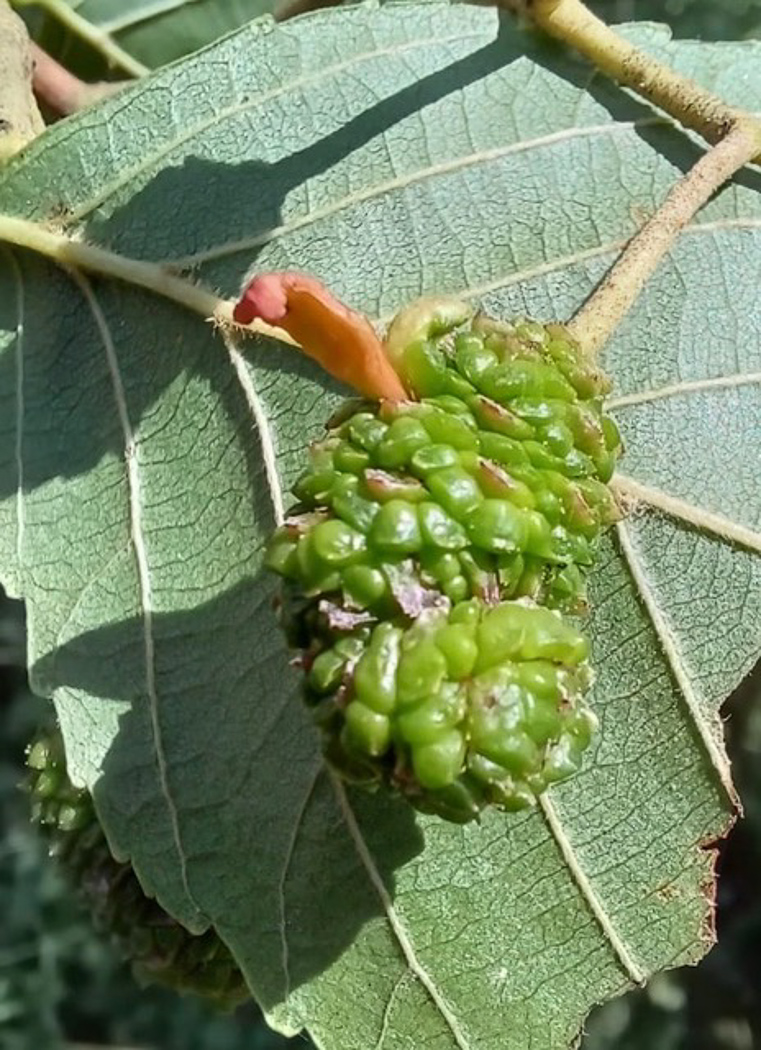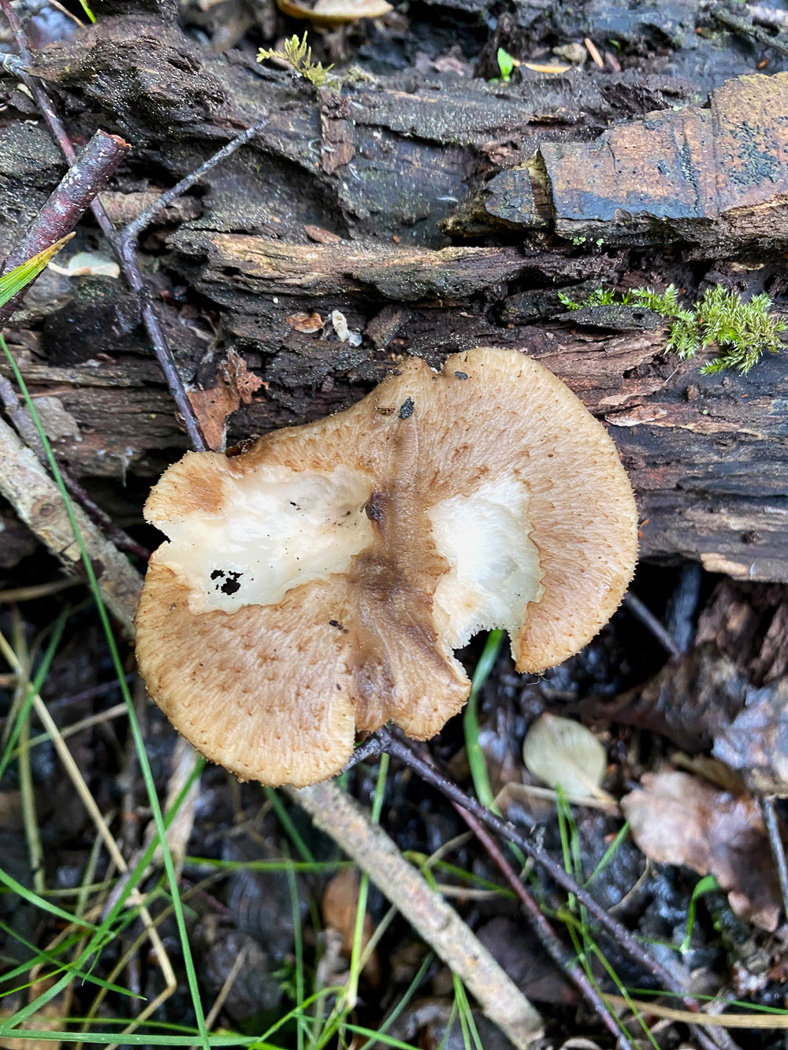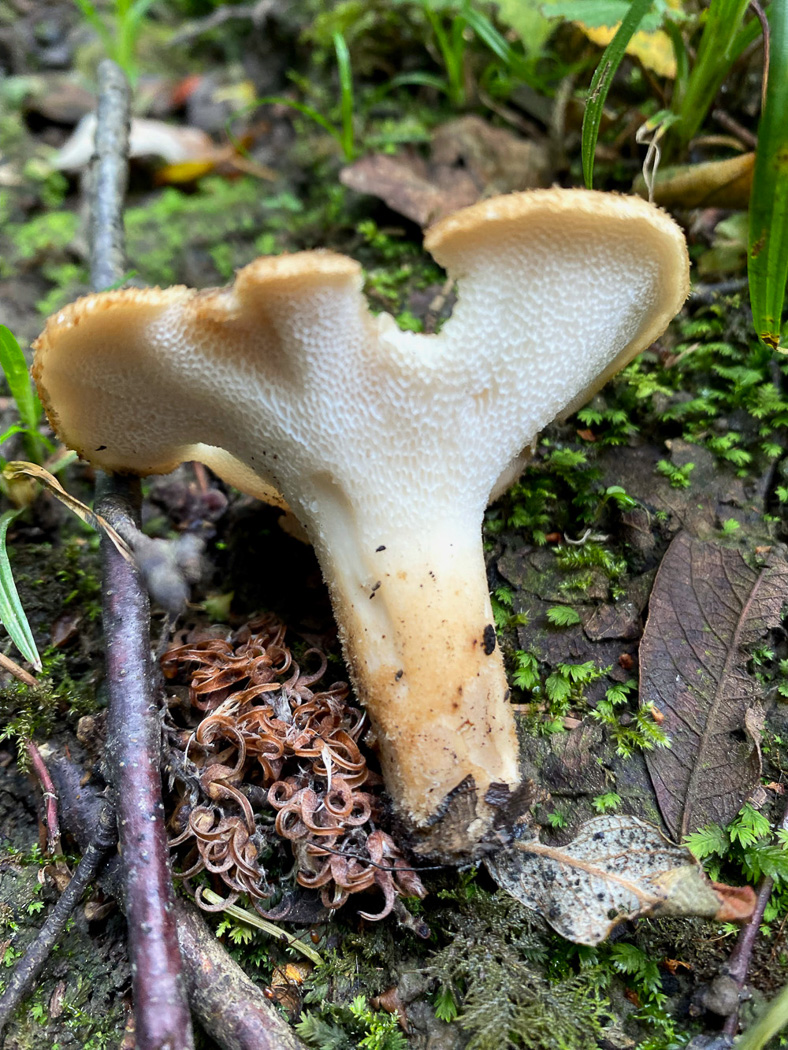Members’ Finds, July to December 2024
Following the success of our Members' Finds project introduced in 2020, here is our new page for July to December 2024 to which members are again invited to contribute. Please email Penny photos of anything you find - even of species already on previous lists. Common or rare: all are welcome! Thanks to all our many contributors, we now have well over 1000 species illustrated here, all from Buckinghamshire!
• Aim to show all aspects of the fruitbody even if this necessitates several photos.
• Please send images as an attachment and not embedded into the email text.
• All photos should be captioned with fungus name if known, site, date, your initials. EG Amanita muscaria Penn Wood 01.10.2024 PC1.
• Please include in your email as much detail as possible (eg size, smell, substrate, habitat, microscopic details if available). All clues are vital when identifying solely from photos.
• If possible collect and retain at least one specimen until you've heard back from Penny in case further investigation is required - records of rarities are invalid without voucher material which may well need to be dried for molecular sequencing to confirm.
• NEW FOR 2024! Click on Previous finds at the end of any entry to view all other Members' Finds entries for that species.
• NEW FOR 2024! We now have a SEARCH FACILITY for the LATIN MASTERLIST INDEX, speeding up access and automatically grouping all entries for any one species together for convenient comparison etc.
• The regularly updated list of entries remains in place as previously, in a choice of either Latin binomial or English common names.
• ![]() Only entries marked with this symbol have been microscopically examined. There is no guarantee on identifications made of entries lacking this symbol though all photos are checked and selected by Penny to the best of her ability. Basic accompanying notes are also Penny's.
Only entries marked with this symbol have been microscopically examined. There is no guarantee on identifications made of entries lacking this symbol though all photos are checked and selected by Penny to the best of her ability. Basic accompanying notes are also Penny's.
• ![]() Entries marked with this symbol have been confirmed or identified using DNA sequencing.
Entries marked with this symbol have been confirmed or identified using DNA sequencing.
HAPPY HUNTING!
Click on thumbnail to see full size
For the complete and regularly updated list of entries click Latin or English
To search the LATIN MASTERLIST INDEX since its inception click here
Contributors / Photographers: Bob Simpson; Chris Grimbly; Claire Williams; Eleanor Page; Gill Ferguson; Greg Douglas; Jackie Ewan; Jesper Launder; Jim Wills; John Catterson; Leigh McMahon; Mark Harper; Mick Jones; Neil Fletcher; Phil Townsend; Piermario Maculan; Russell Ness; Sarah Ebdon; Stephen Plummer.
Rare sightings 46 |
New to Buckinghamshire 21 |
New to UK 0 |
July August September October November December
| Image | Details |
|---|
December 26th 2024

 |
December 26th Mycena speirea (Bark Bonnet) At Stampwell Farm Jackie Ewan spotted these two small Bonnets on some buried wood and though they are atypical for the species in some respects the microscopic details all matched well. This is one of several small pale Bonnets found on wood and often can be spotted in the field for its decurrent gills and brown central spot in the cap which helps to separate it from others. Fungi as we know can be fickle, however, which is where the scope comes in handy as microscopic features tend to be much more consistent than field characters. (We will soon have to adopt the new genus name Phleomania for this species which is one of our commonest Bonnets found on fallen deciduous wood. Previous finds |

 |
December 26th Dichomitus campestris (Hazel Porecrust) In Bernwood Forest Chris Grimbly noticed this 'honeycomb'-like resupinate fungus on a fallen deciduous twig, possibly Hazel but could have been Oak - both are plentiful at this site. Checking at home later he identified it from similar images and Penny agrees with his determination. (Note the black surround apparently typical of the species and visible in photo 1.) Both tree hosts are typical for this unusual species for which we have just four previous county records - two from this site, two from Burnham Beeches. This is a new entry for Finds. |
 |
December 26th Polycephalomyces tomentosus (an unusual asco with no English name) In Bernwood Forest Chris Grimbly noticed these tiny white fungi parasitising a colony of an unidentified species of slime mould belonging to the genus Trichia. The species is extremely similar to another we've featured in Members' Finds, Stilbella byssiseda, but that species parasitises a different genus of slime mould: Cribraria. We have only a handful of records for today's species and one of those (recorded on Cribraria) is presumably incorrect and should be the Stilbella. This is a new entry for Finds and interestingly the species is apparently loosely related to the genus Cordyceps. |

 |
December 26th Stropharia inuncta (Smoky Roundhead) At Stampwell Farm Jackie Ewan found this pair of rather nondescript little mushrooms in a grassy pathside and recognised the species having found it in a similar spot earlier in the year. Testing for the gelatinous peelable cuticle quickly confirmed it. This is a species which can cause confusion, however, because though similar in grassy habitat, size, sliminess with a dark ring zone to Stropharia caerulea (Blue Roundhead) it lacks the distinctive blue/green cap colour of that species, being just dull palish grey. The microscopic characters of this genus are distinctive and should help if in doubt. Previous finds |
December 14th 2024
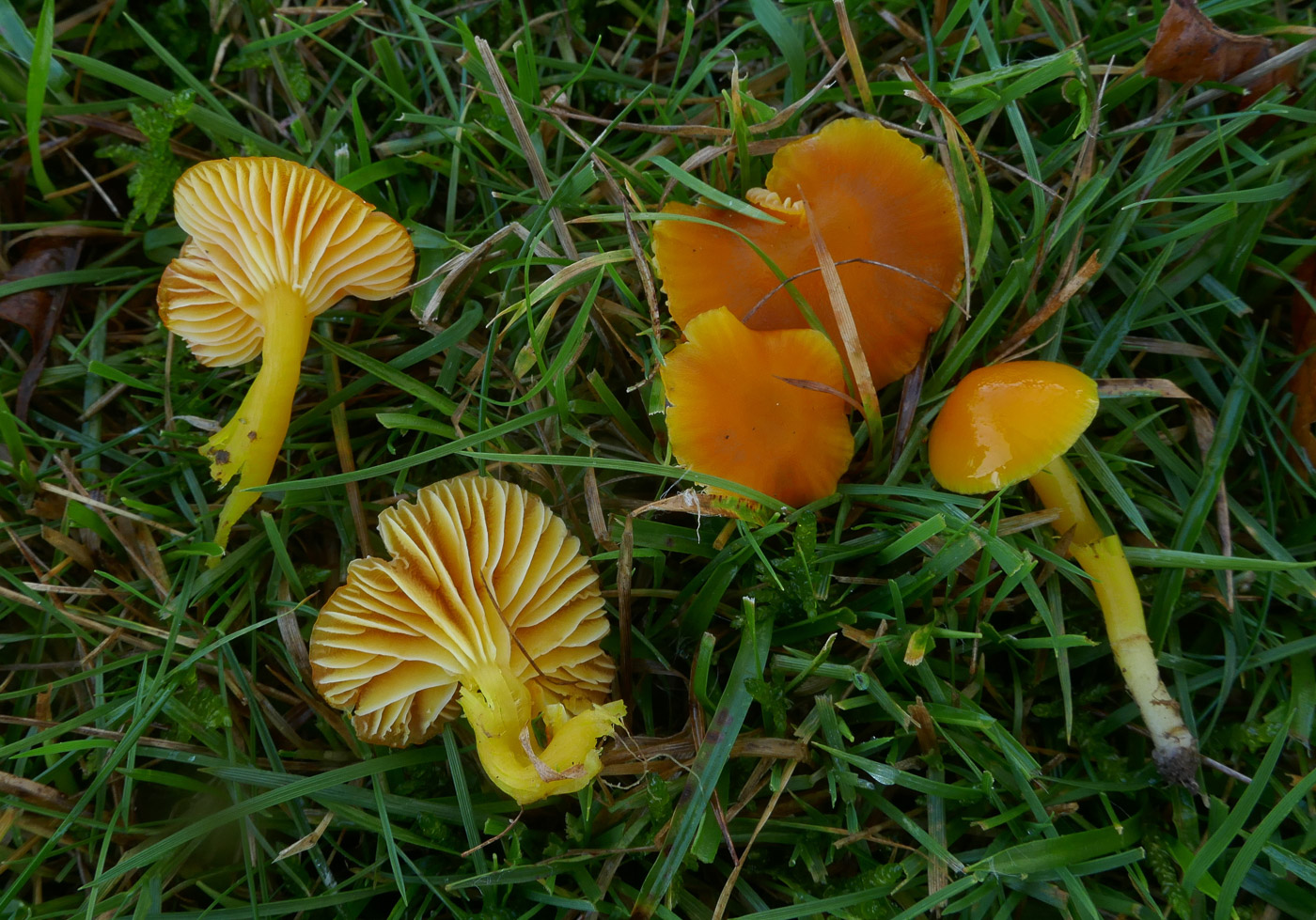
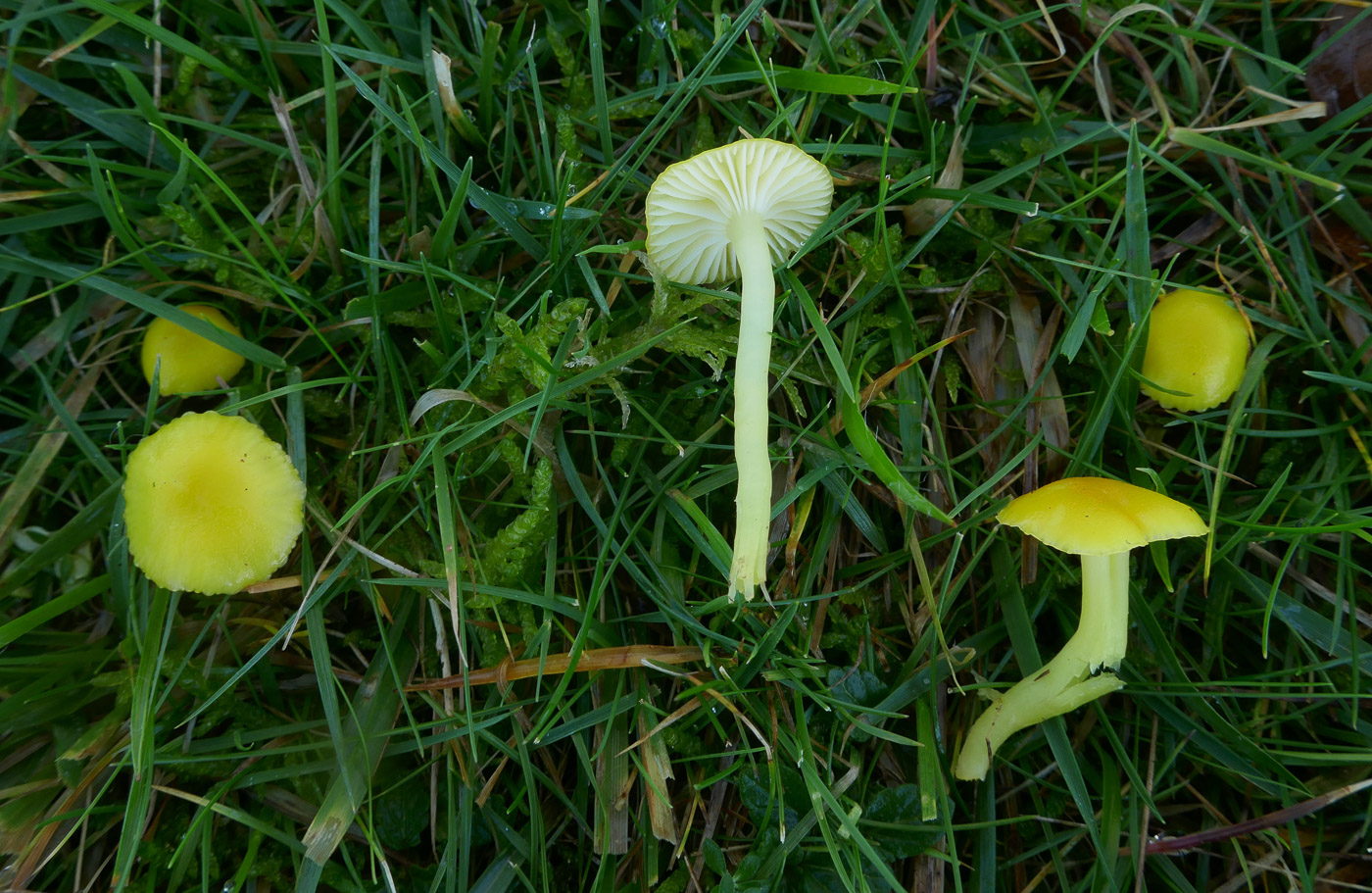
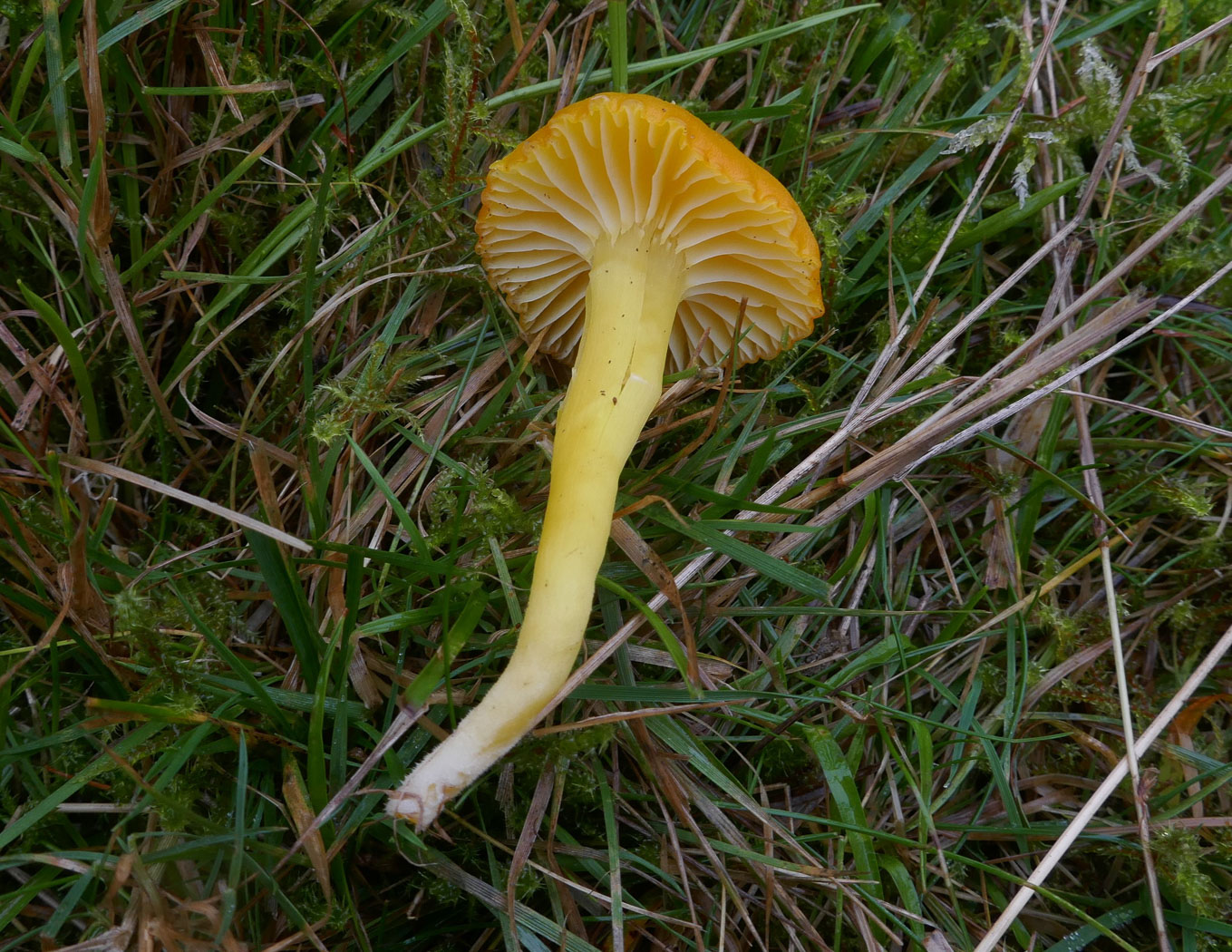 |
December 14th Hygrocybe ceracea (Butter Waxcap) At Stampwell Farm Jackie Ewan found several examples of this small to medium yellow Waxcap which is a regular at this site. Easily confused with H. chlorophana (Golden Waxcap) which can be very similar in colour though is medium to large, in the field the smaller species has a greasy cap but a dry stem as opposed to both cap and stem feeling greasy. There are also clear microscopic differences which should help to confirm if in doubt. Photos 1 and 2 show a variation in colour tone and photo 3 was taken in the same spot on Boxing Day where it was still fruiting. Previous finds |
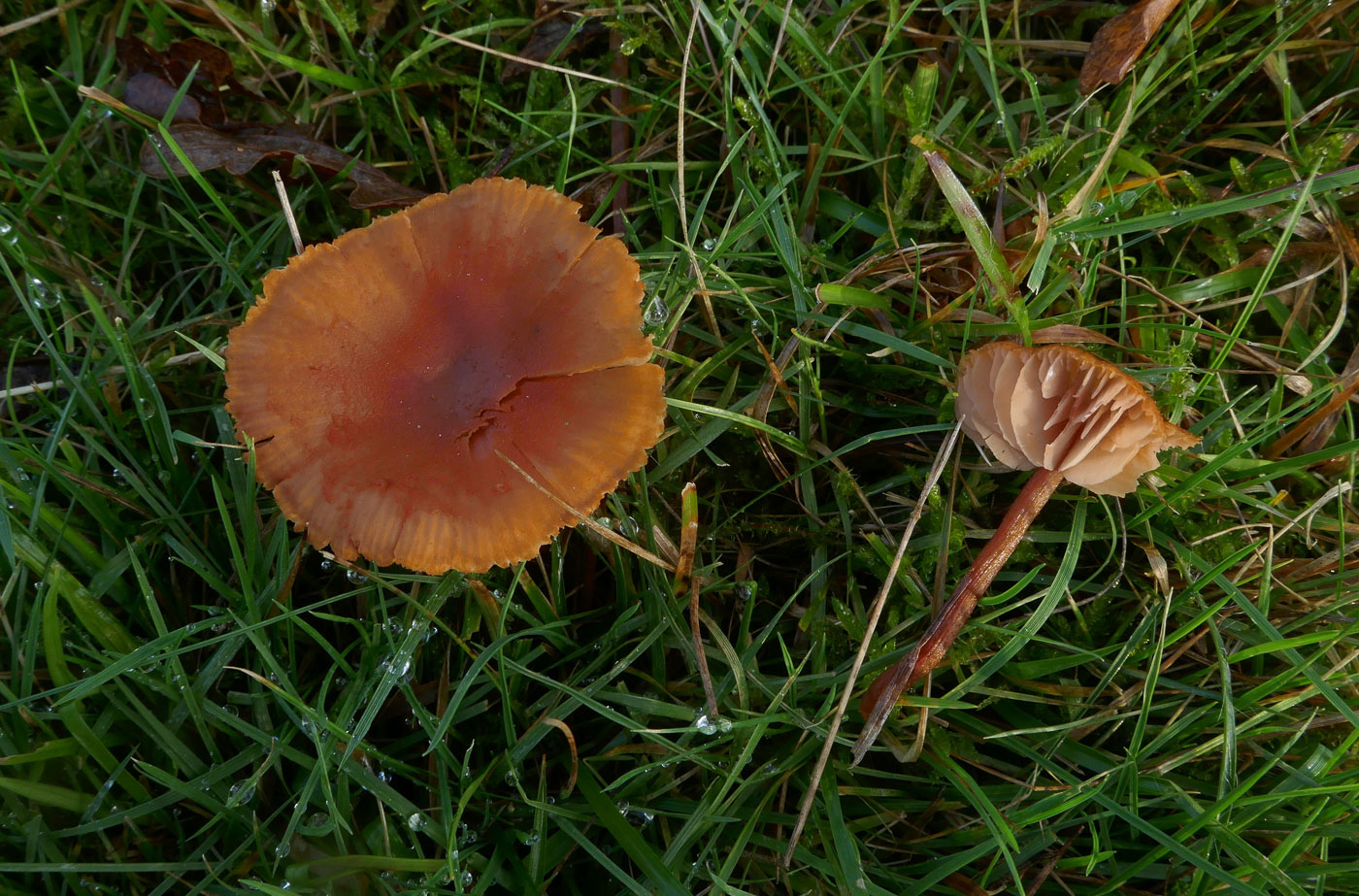 |
December 14th Laccaria proxima (Scurfy Deceiver) At Stampwell Farm Jackie Ewan came across this pair of Deceivers in a grassy area and though they appeared just like the common L. laccata without much sign of the scurfy cap, also quite small, she had found typical larger coarser specimens of L. proxima in this same spot a few week earlier so decided to check the spore shape and sure enough they were ovall as in L. proxima rather than round as in L. laccata. It can often be tricky to separate these two species when found in 'heathy' habitat more suited to L. proxima because L. laccata can also occur in this habitat. Checking the spores is the only way to be sure ............. Previous finds |
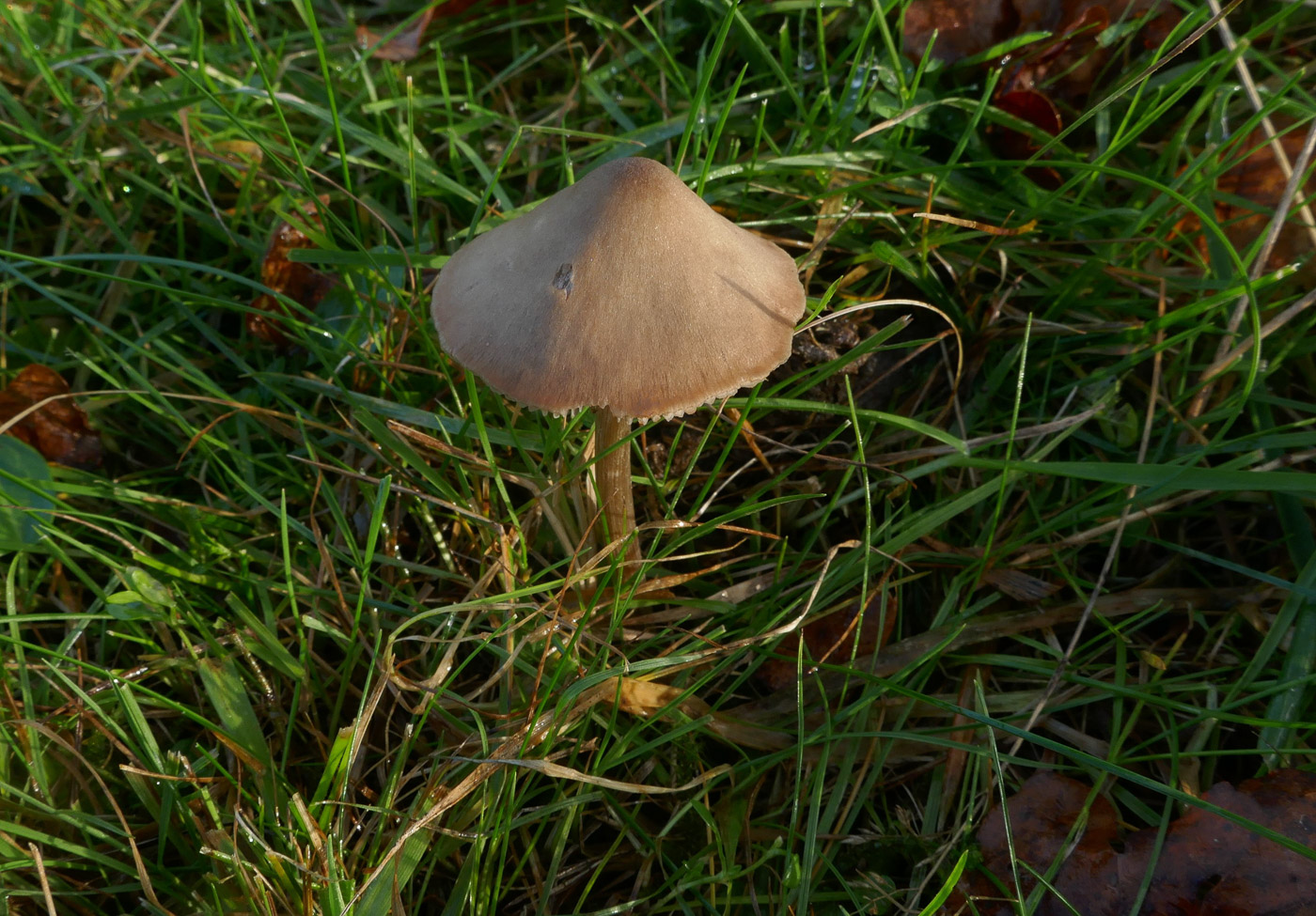
 |
December 14th Entoloma conferendum (Star Pinkgill) At Stampwell Farm Jackie Ewan noticed this late fruiting of this Pinkgill in a grassy area - one of our commonest and also luckily one of the easiest to name once you look at the spores with a scope. All species of Entoloma develop pink gills and have typically distinctive ornamented spores with nobbles but this species is almost alone in having unmistakeably stellate-shaped spores. Previous finds |
December 12th 2024


 |
December 12th Trichia crateriformis (a slime mould with no English name) At Burnham Beeches a small group of us met up specifically to look for slime moulds and we were rewarded with about 10 different species of which this unusual species was one. Originally known as T. decipiens var. olivacea, then as T. meylanii, it is now a species within its own right, and for a full descriptions see https://en.wikipedia.org/wiki/Trichia_crateriformis. This is a new county record and is also a new entry for Finds. The photo is Sarah Ebdon's; photos 2 and 3 are Barry Webb's. |



 |
December 12th Metatrichia vesparium (a slime mould with no English name) At Burnham Beeches a small group of us met up specifically to look for slime moulds and we were rewarded with about 10 different species of which this was one which we found on several different rotting Beech logs. This is not a common species and was found by Barry Webb at this site new to the county a year ago. It is distinctive enough, however, to recognise in the field and although tiny has clustered heads on one stalk reminiscent of a wasp's nest - hence its Latin species name. The elaters (fine tubes) and spores are reddish orange, as is the stalk. Photos 1 and 2 are Sarah Ebdon's; photos 3 and 4 are Barry Webb's taken on this same trunk on October 30th and December 18th respectively. Previous finds |

.jpg)
.jpg) |
December 12th Metatrichia floriformis (a slime mould with no English name) At Burnham Beeches a small group of us met up specifically to look for slime moulds and we were rewarded with about 10 different species of which this was one. It is one of the commonest and also one of the easiest to recognise from its reddish stalks and round black heads which split open 'flowerlike' to reveal the orange mass of elaters (fine tubes) which act as protection for the spores - also orange - as they mature. Photos 1 and 2 are Sarah Ebdon's, photo 3 is Barry Webb's. Previous finds |
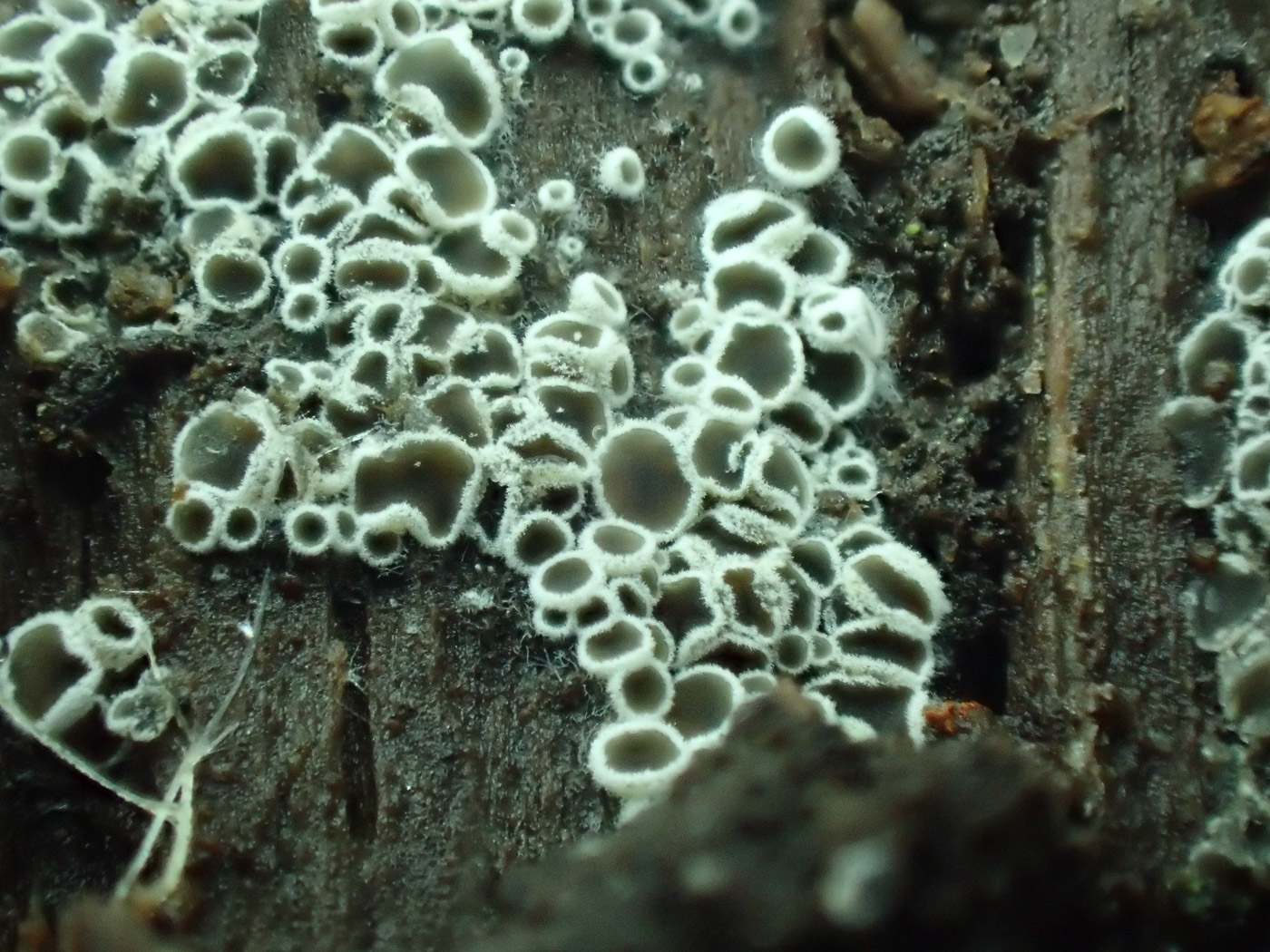 |
December 12th Eriopezia caesia (discomycete with no English name) On a piece of fallen rotting Oak at Burnham Beeches Stephen Plummer spotted this swarm of tiny discs which attracted his attention, looking similar but distinctly different from the genus Mollisia, ie greyish, tiny and round. At home he was able to identify it, confirmed also by Sarah Ebdon who checked the spores. It is apparently not especially rare, favours Oak as host, and we have just three records on our database but all are out of the county, so this is a first for the site, the county, and for Finds. The photo is Sarah Ebdon's. |

 |
December 12th Ganoderma pfeifferi (Beeswax Bracket) At Burnham Beeches Sarah Ebdon noticed these brackets at the base of a living Beech and on closer inspection saw that the upper surface, when dampened and free of the brown spore deposit, was not only hard but remarkably shiny, also more 'half-oval' in shape rather than semicircular as in the far more common species of Ganoderma. She and Penny suspected this was one of the genus to have an upper surface with a lacquered crust which melts when heated. Spores were collected from the surface to check and as no flame was available Sarah took a very small piece from the corner to allow her to study it in detail later, including applying a flame! Watch for the melted resin bubbling right at the end. The spore size (particularly the width) together with the melting surface and distinct smell of beeswax Sarah noted at home confirmed our ID. The species is not at all common, nearly always on mature Beech, and about half of our dozen or so records are from this site. The two photos are Penny's and the video is Sarah's. Previous finds |
 |
December 12th Ascocoryne cylichnium (Budding Jellydisc) At Burnham Beeches on the underside of a bare fallen Pine trunk Claire Williams found this generous spread of purplish pink discs. This aroused interest amongst our small group as we were unsure whether either of the two Ascocoryne species (the second being A. sarcoides) commonly recorded on Beech could occur on conifer as well. Sarah Ebdon (whose photo is shown here) did a fair amount of research at home, examining a sample in detail, and concluded that both species were known from Pine and that this collection matched best with A. cylichnium considering not only spore size and shape but other microscopic features as well. Previous finds |
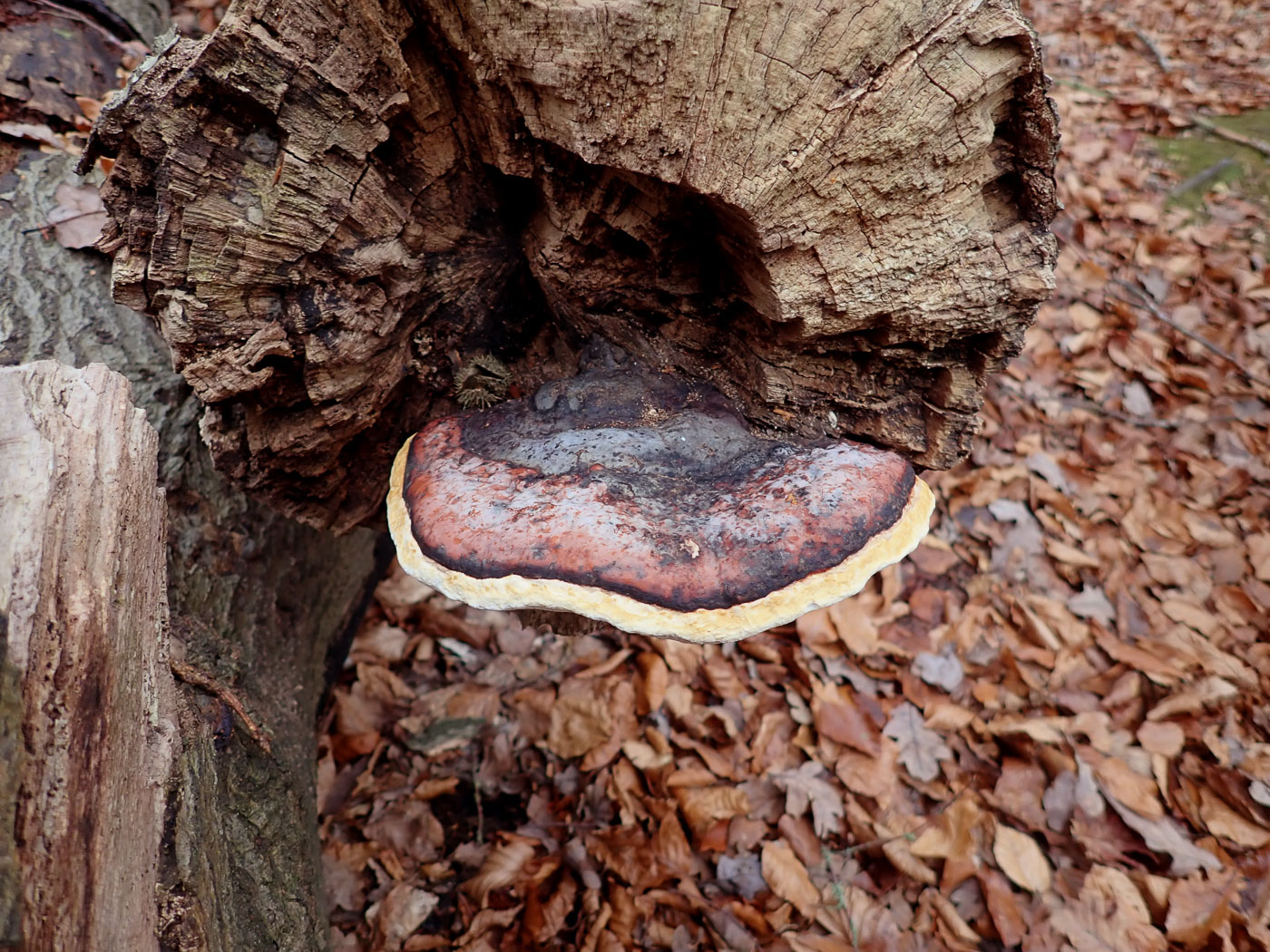
m.jpg) |
December 12th Fomitopsis pinicola (Redbelted Bracket) On a fallen Beech trunk at Burnham Beeches our small group admired this now common bracket which is a regular on this particular trunk. The mature singleton (Penny's photo) was impressively marked with the red belt though when younger this features is far less obvious making the species quite difficult to separate from other similar hard brackets. Photo 2 is of a less mature collection we found a week earlier here on fallen Birch, taken by Claudi Soler, when we also found it on standing Pine - the host for which it is named though it is by no means restricted to that tree and seems much more common on both Beech and Birch here. Previous finds |
 |
December 12th Pleurotus ostreatus (Oyster Mushroom) At Burnham Beeches Gill Ferguson spotted this photogenic cluster on a rotting deciduous trunk which then spurred Claire Williams to get out the camera! Usually an abundant fruiter it has not been as common as usual this autumn, also this particular collection is notably dark and it's unusual to find it with such marked contrast between the cap colour and gills. Previous finds |
 |
December 12th Bjerkandera adusta ISmoky Bracket) At Burnham Beeches Penny noticed this common species fruiting in rows all along a fallen Beech trunk. Looking quite similar, as it does, to the even more common Trametes versicolor (Turkeytail) it's always worth checking a piece by turning it over to see the smooth smoky grey underside but with a white exterior rim - distinctly different from the all white pored underside of Turkeytail. Previous finds |
December 9th 2024


 |
December 9th Trametes pubescens (a bracket with no English name) On a Cherry log at Stampwell Farm Jackie Ewan noticed this bracket starting to emerge several week ago, then returned today to see how it was developing. The pale downy upper surface, rather angular and mazelike but distinct pores together with narrow allantoid spores led her to this species, which resembles a finely furry but colourless T. versicolor (Turkeytail) though completely lacks the contrasting bands which characterise that common species. She discovered that it is known to occur on fruit trees as well as deciduous woodland trees which helped to confirm her ID. We have just one previous record, from Burnham Beeches where the ID was confirmed by expert Leif Ryvarden, so it appears that this is either not at all common or maybe just misidentified. |
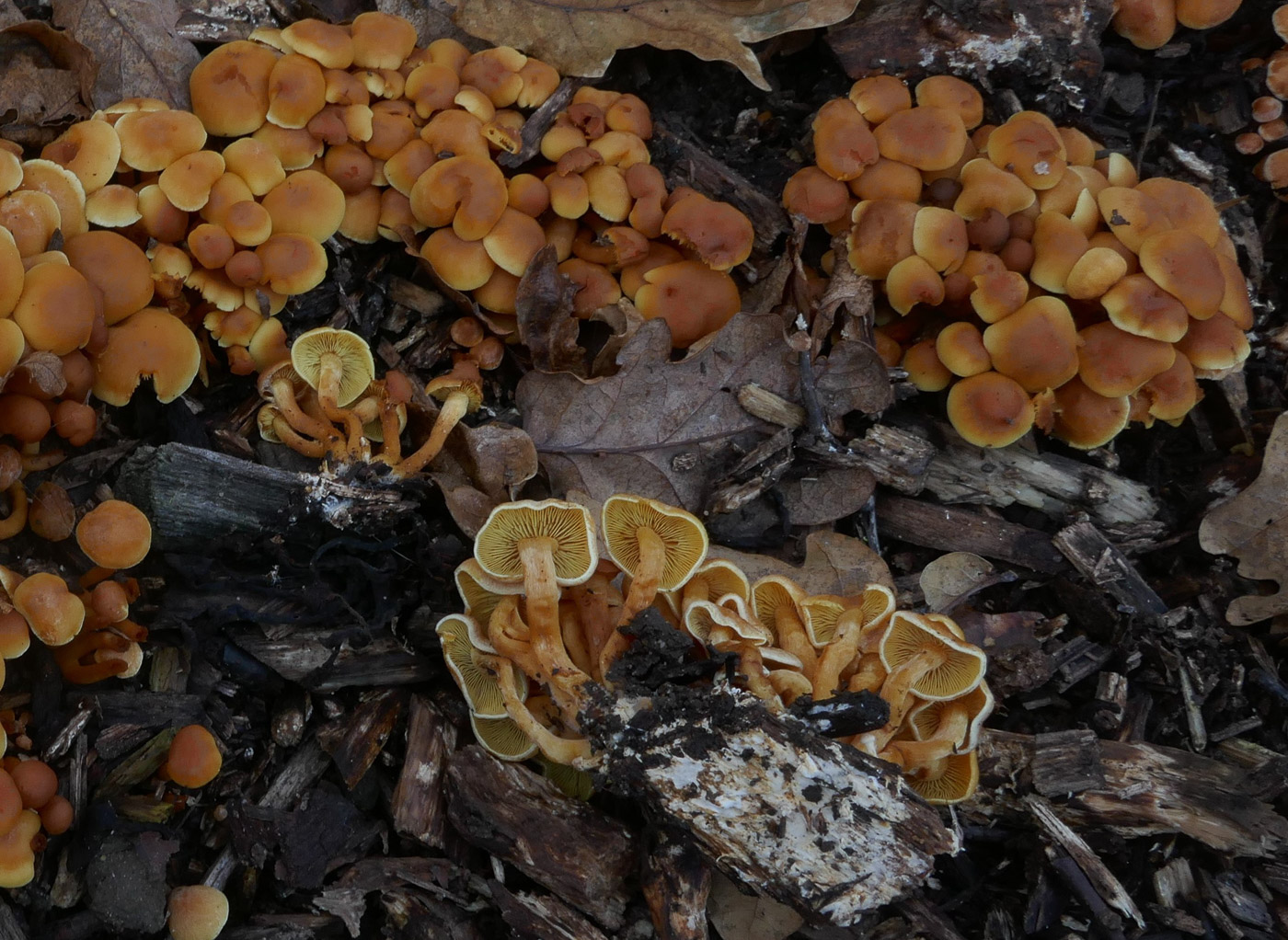
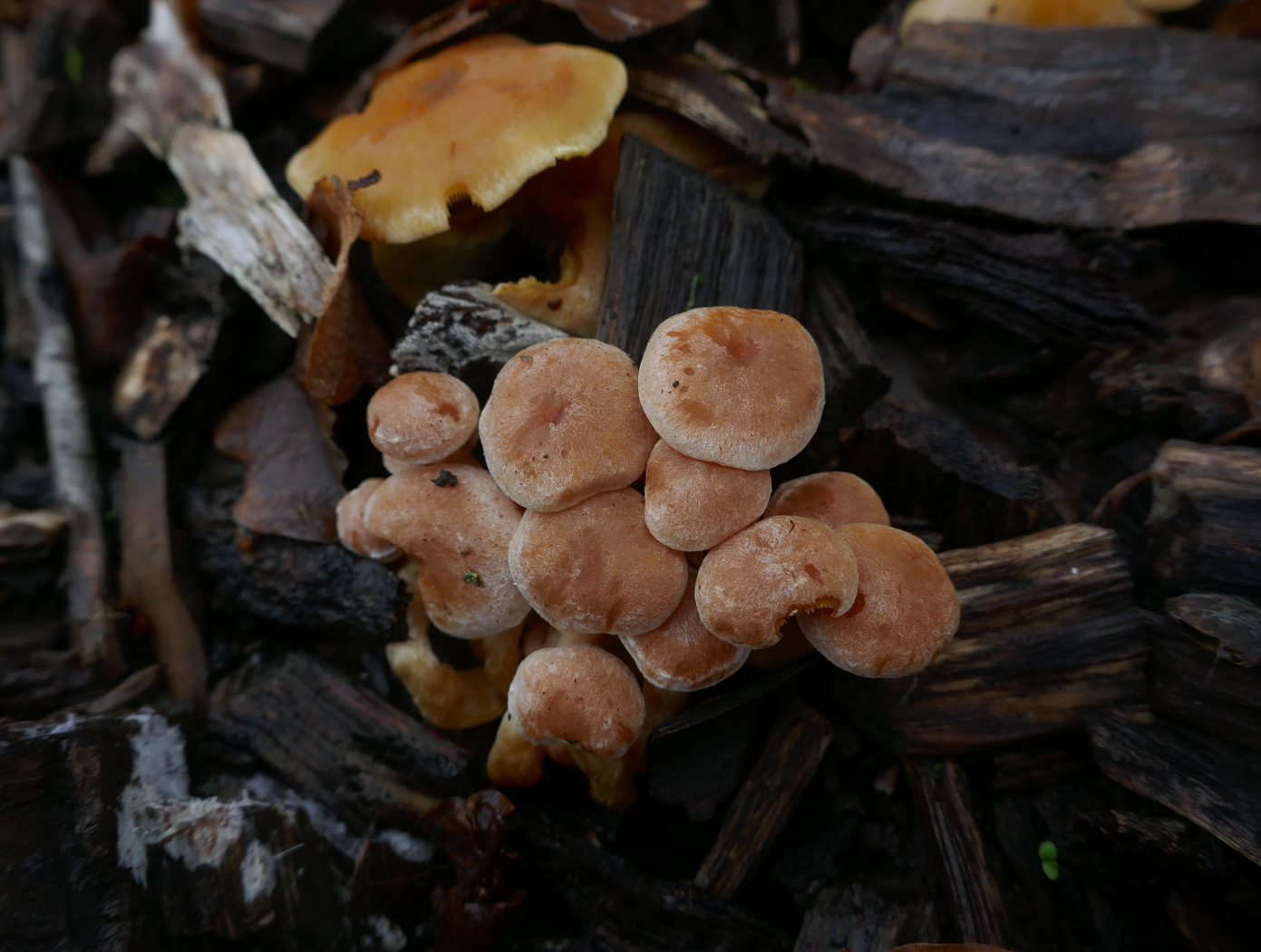
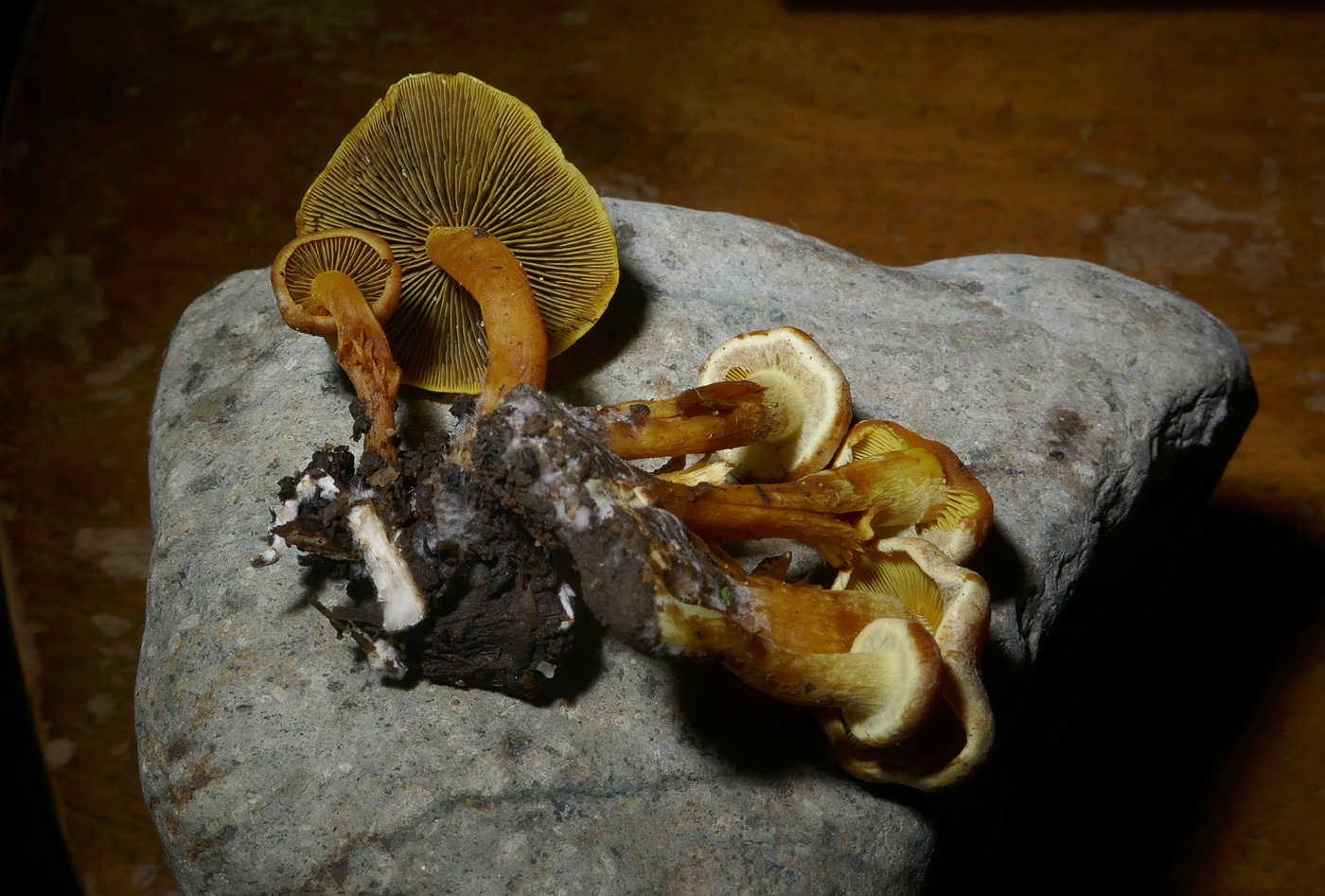 |
December 9th Hypholoma lateritium (Brick Tuft) On a large woodchip pile at Stampwell Farm Jackie Ewan noticed this generous fruiting of a species somewhat similar to the common Hypholoma fasciculare (Sulphur Tuft) but with differences. The species is far less common, favours deciduous stumps and woody remains, and lacks the greenish yellow cap colours of the H. fasciculare, having much rustier red tones which are also apparent in the lower stem. Previous finds |
December 7th 2024


 |
December 7th Trichia decipiens ( a slime mould) In Lott Wood near Stokenchurch Jackie Newcombe noticed these tiny bright orange globes in a pile of fallen wood. New to her, she worked out their identity from online photos and sent them to Penny to check. With its combination of orange blobs with short white stalks this is one of few slime moulds distinctive enough at this early plasmodium stage to identify in the field. In fact once mature it looks like many others and needs a scope to name though it is possibly one of our commonest species. Previous finds |
December 4th 2024
 |
December 4th Trichia cf ambigua (a rare slime mould with no English name) At Burnham Beeches on some rotting woody debris Barry Webb found these distinctive tiny orange clustered blobs, and is fairly confident that they will be confirmed as this newly described species of Trichia now that the T. botrytis complex has been sorted out. However, the name T. ambigua is yet to be accepted by either FRDBI or Species Fungorum so at present it is not possible to record it as this. Once the name has filtered through the system it is possible that this find will be the first for the UK. Watch this space ............... |
 |
December 4th Physarum pusillum (a slime mould) At Burnham Beeches on a rotting heap of woody debris Barry Webb found this tiny slime mould, recognising the species from its distinctive red stalk. He's found it twice before in the county - once from this site three years ago, so a nice find. Previous finds |
 |
December 4th Didymium eximium (a slime mould) and Volutella ciliata (an ascomycete with no English name) Two for the price of one here. At Burnham Beeches on a rotting heap of woody debris Barry Webb found this tiny slime mould accompanied by this remarkably hairy but even tinier ascomycete. If one considers that the Didymium is no taller than a few mms it puts the Volutella into perspective! The Didymium is not common and was new to the county when found recently by Barry on our walk at Stoke Common and subsequently identified by Jackie McKenzie-Dodds. The Volutella is also not that common with two previous county records - one from this site. Previous finds - Didymium eximium Previous finds - Volutella ciliata |
_Burnham_Beeches_241204 CVS(1)m.jpg) |
December 4th Botryobasidium candicans (Stardust Crust) At Burnham Beeches Claudi Soler was on the lookout for any corticioid species on fallen wood and this was one of his collections which he made and then studied at home to identify. In the field it looks much like many other corticioid species - often affectionately described as splashes of white paint - but under the scope their individual and often distinctive features are revealed though finding these is a skilled job! Though not rare, we have just two previous county records and today's find is new to the site and to Finds. |
m.jpg) |
December 4th Athelia epiphylla (Candelabra Duster) At Burnham Beeches Claudi Soler was on the lookout for any corticioid species on fallen wood and this was one of his collections which he made and then studied at home to identify. In the field it looks much like many other corticioid species - often affectionately described as splashes of white paint - but under the scope their individual and often distinctive features are revealed though finding these is a skilled job! Though not rare, we have only two previous county records made by Kerry Robinson in 2000 and today's find is new to the site and to Finds. |
.jpg) |
December 4th Henningsomyces candidus At Burnham Beeches these tiny white beauties were spotted by Jesper Launder on some fallen Pine. Each miniscule tube is less than 1mm tall and the species tends to form swarms on conifer wood though a hand lens is needed to appreciate the detail. It is a basidiomycete belonging to the cyphelloids, and is not uncommon but easily overlooked for obvious reasons. The photo is Barry Webb's. Previous finds |



|
December 4th Steccherinum bourdotii (an unusual fungus with no English name) On a fallen Birch trunk at Burnham Beeches this toothed bracket-cum-corticioid was noticed by our group and the discussion that followed led us to this genus - superficially similar to Junghunia nitida but having a toothed undersurface rather than pored. We have examples of S. ochraceum (Ochre Spreading Tooth) and S. fimbriatum (no English name) on Finds for comparison, but today's species is much rarer, first described in 1988, is new to the county and with only about 40 FRDBI records. Claudi Soler was able to make the ID from the microscopic characters and a sample will be dried for sequencing. Photo 1 is Claudi's, photo 2 is Sarah Ebdon's, photo 3 is Barry Webb's. |


 |
December 4th Sarcomyxa serotina (Olive Oysterling) At Burnham Beeches on a living Oak branch but conveniently at eye level, Claudi Soler noticed this attractive cluster. The species, previously in genus Panellus, is a late season fruiter on deciduous wood though is not that common. The distinctive dark olive green cap colour tends to fade but is showing well in these fresh specimens together with the crowded cream gills and short eccentric stem. Photos 1 and 2 are Penny's photo 3 is Sarah Ebdon's. Previous finds |
 |
December 4th Stereum rameale (a Crust with no common name) On a deciduous stick at Burnham Beeches Penny noticed this small pale fungus, suspected it was this likely to be this species and as Claudi was present she took the opportunity to ask him to check it. It is considerably paler, smoother and smaller than the very common S. hirsuta (Hairy Curtain Crust) and is a species we tend to name with some doubt in the field, so it was useful to be able to get it microscopically confirmed by someone becoming somewhat expert with corticioids and brackets. Though not a rarity this is a new entry for Finds. |

 |
December 4th Plicatura crispa (Crimped Gill) Near the Burnham Beeches cafe our small group spotted this fallen Birch literally smothered in this now common small bracket. The now fully mature fruibodies, no more than 3 cm across, showed some interesting bands of blue-green, also apparent on the underside of the upturned examples in photo 2, which though not mentioned in descriptions clearly must sometimes develop at maturity and had been previously observed by Jesper. The photos are Penny's. Previous finds |
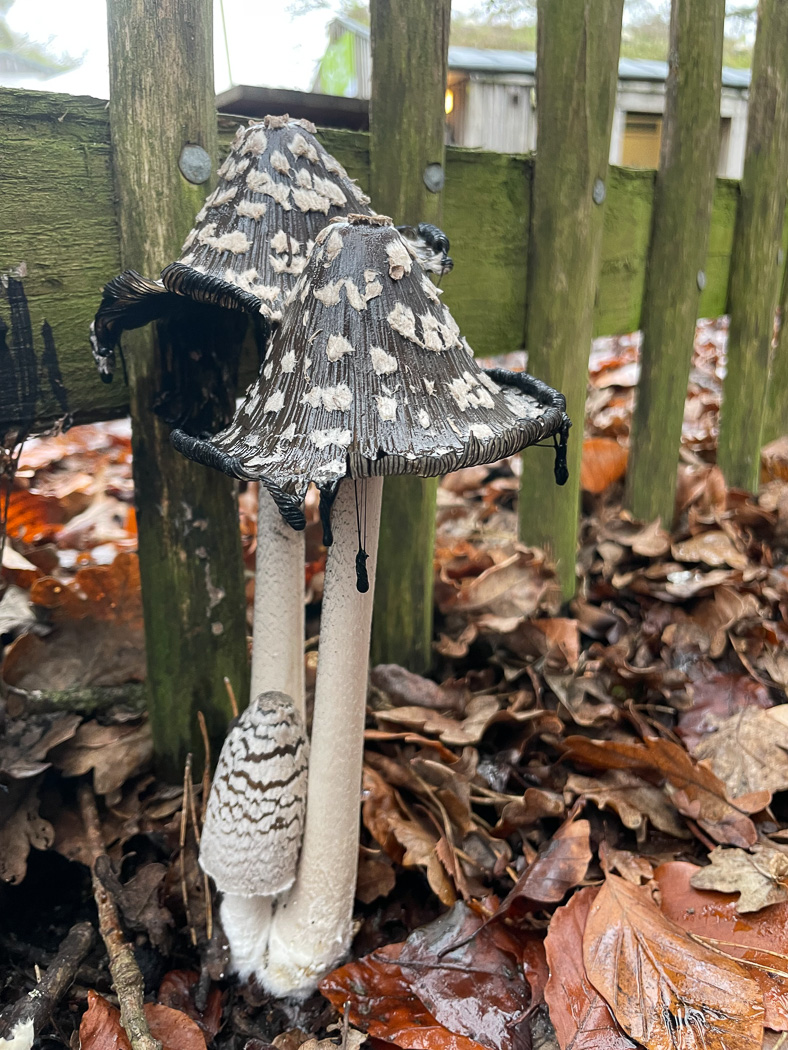 |
December 4th Coprinopsis picacea (Magpie Inkcap) Whilst enjoying a warming drink in the Burnham Beeches cafe, Jesper Launder noticed this attractive cluster nestling against the fence! Somewhat late in the season for this species, it was much admired by our group. The photo is Sarah Ebdon's. Previous finds |
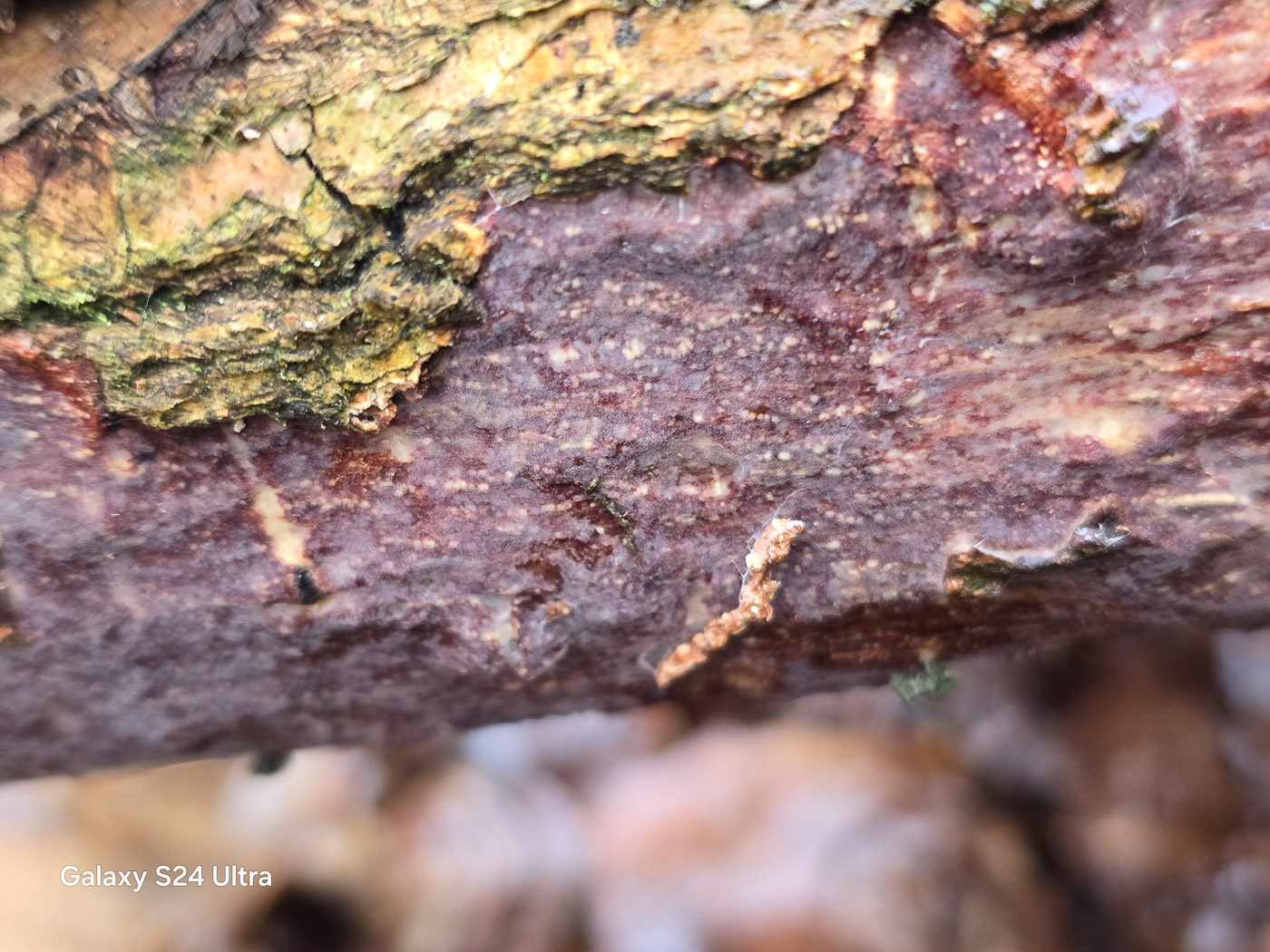 |
December 4th Vuilleminia comedens (Waxy Crust) At Burnham Beeches Jesper Launder noticed this purplish lilac waxy patch of corticioid on a piece of fallen Oak and, recognising it, checked it later at home. This is an inconspicuous species, not rare, and has very distinctive allantoid (sausage-shaped) spores. We have plenty of county records though none since 2007 and it appears to be new to the Beeches also. This is a new entry for Finds. |
 |
December 4th Conocybe anthracophila (Bonfire Conecap) At Burnham Beeches a group of us found a few examples of this little LBJ in a cleared area with litter and woody remains which may possibly have been burnt ground. Jesper Launder took it home to identify (the photo is his) and keyed it out from its microscopic characters, learning that despite its name it is not restricted to burnt ground and it could also have been on old dung of some sort. The species appears to be new to the site and to the county. |
November 29th 2024
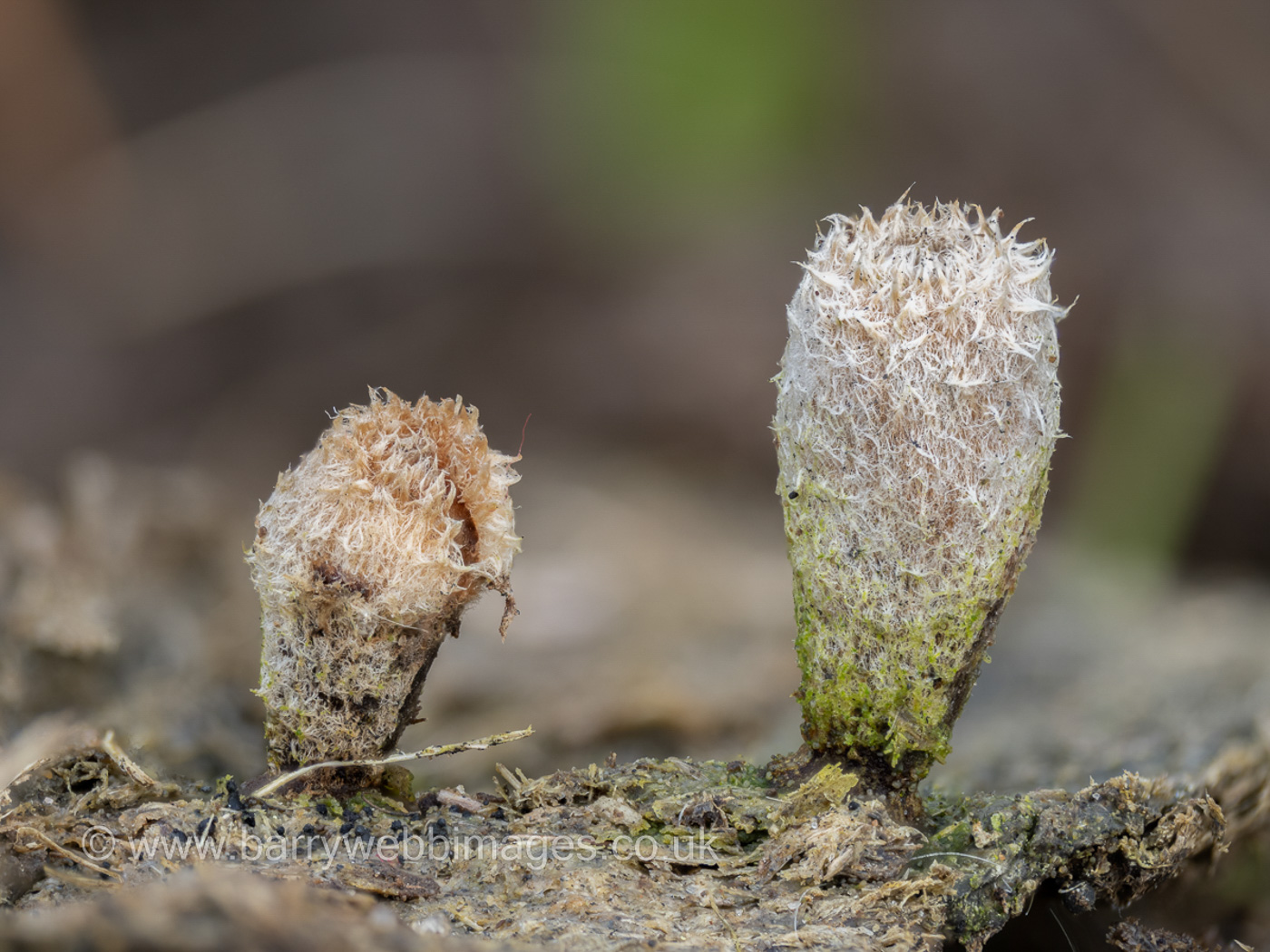
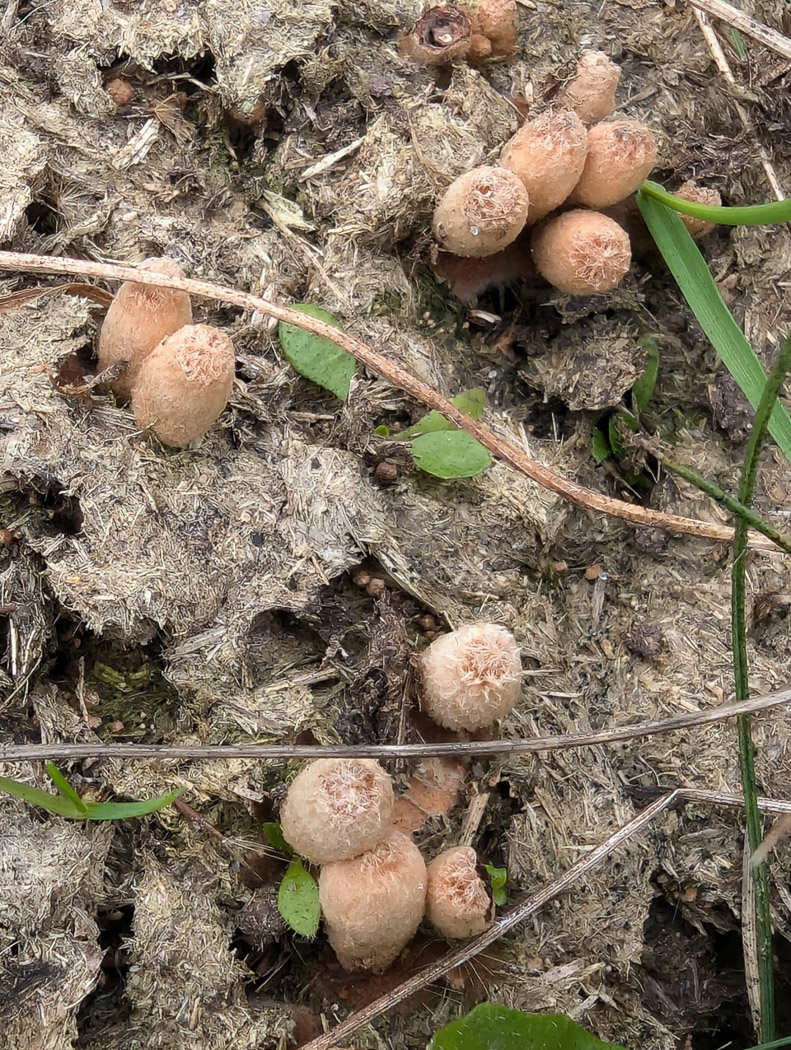
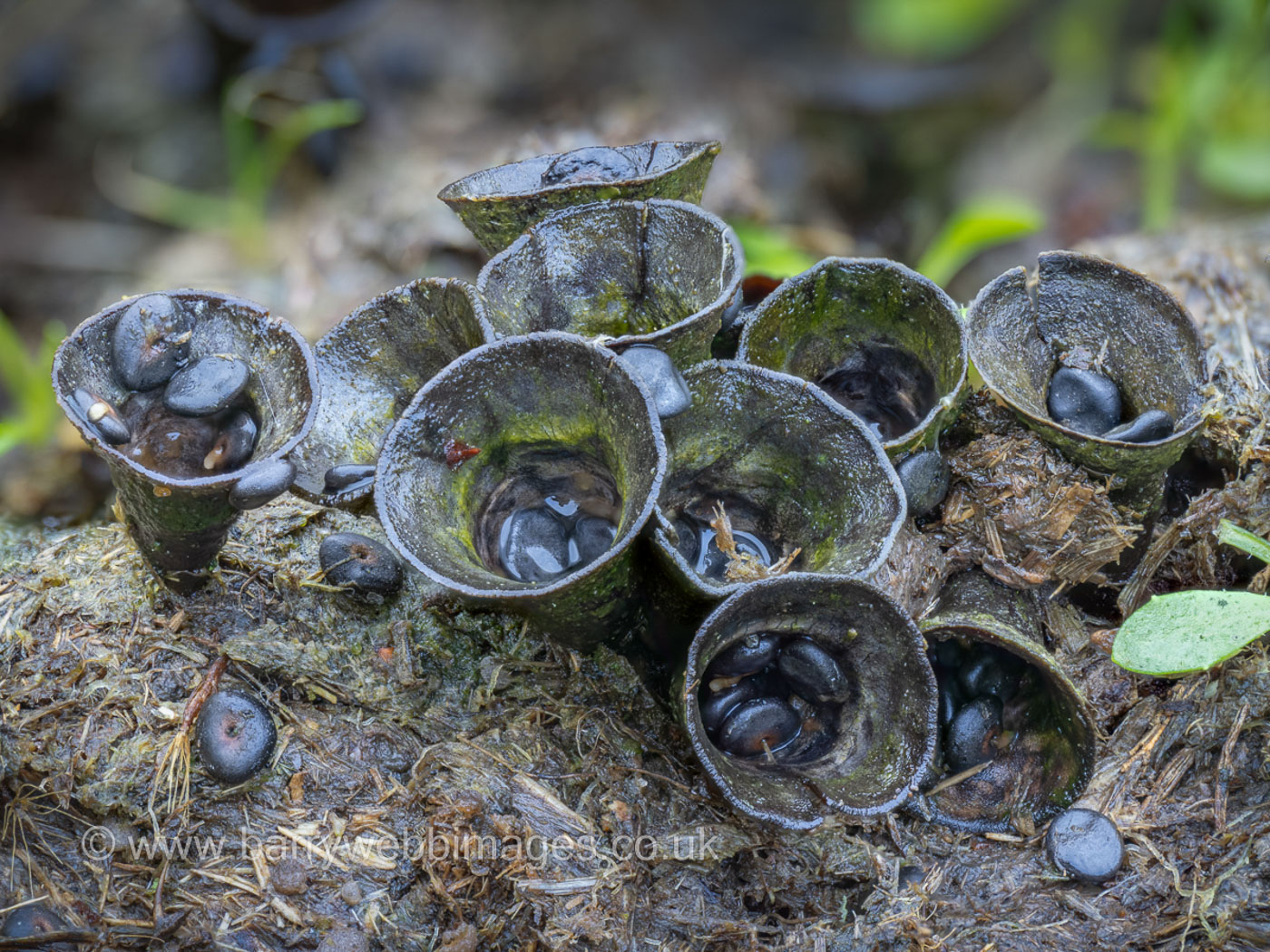 |
November 29th Cyathus stercoreus (Dung Bird's Nest) Ten days ago at Burnham Beeches Barry Webb was taken to see this very rare species of Bird's Nest (photo 1) by a member of the public who'd been shown it by a mycologist friend a few days earlier and though there were only these two immature specimens remaining, she explained that there had been plenty more previously though still not fully developed (photo 2, taken by Piermario Maculan, London Nat. Hist. Soc. member). It was growing on cow dung in a grassy area and Barry collected a sample to incubate at home in the hope of further development. This didn't happen, however, but on returning to the site today he was rewarded with these fully developed fruitbodies (photo 3) leaving little doubt as to their identity, each 'nest' less than 8mm across and having a smooth blackish interior with equally dark packets of spores within. He took Penny to collect some samples a few days later and she was able to confirm the ID from the spore size.This species is a real rarity and the few UK records are mainly from dunes on dung of various sorts, particularly on rabbit dung. Inlaend records are extremely scarce and not surprisingly this is new to both the site and the county. A sample will be sequenced. |
 |
November 29th Sphaerobolus stellatus (Shooting Star) On a patch of cow dung in a grassy area at Burnham Beeches Barry Webb found two interesting species of which this tiny species was one (see entry above for the second!). Only 3mm across when expanded, it is not unlike a miniscule Earthstar (and is distantly related to the genus Geastrum) and Barry's photo shows unopened examples with the central one open with its spore-containing 'peridiole' not yet expelled. When this happens it is forcibly ejected several feet away and has a gelatinous coating which helps it stick to whatever it lands on. Other common names are Shotgun Fungus, Artillery Fungus or Cannonball Fungus – all suitably descriptive. It is not rare and occurs on dung or rotting vegetative matter including wood and we have only three county records this century, the only two from Burnham Beeches are dated 1923 and 1947!! For further information on the species try this link: https://en.wikipedia.org/wiki/Sphaerobolus. This is a new entry for Finds. |
November 15th 2024
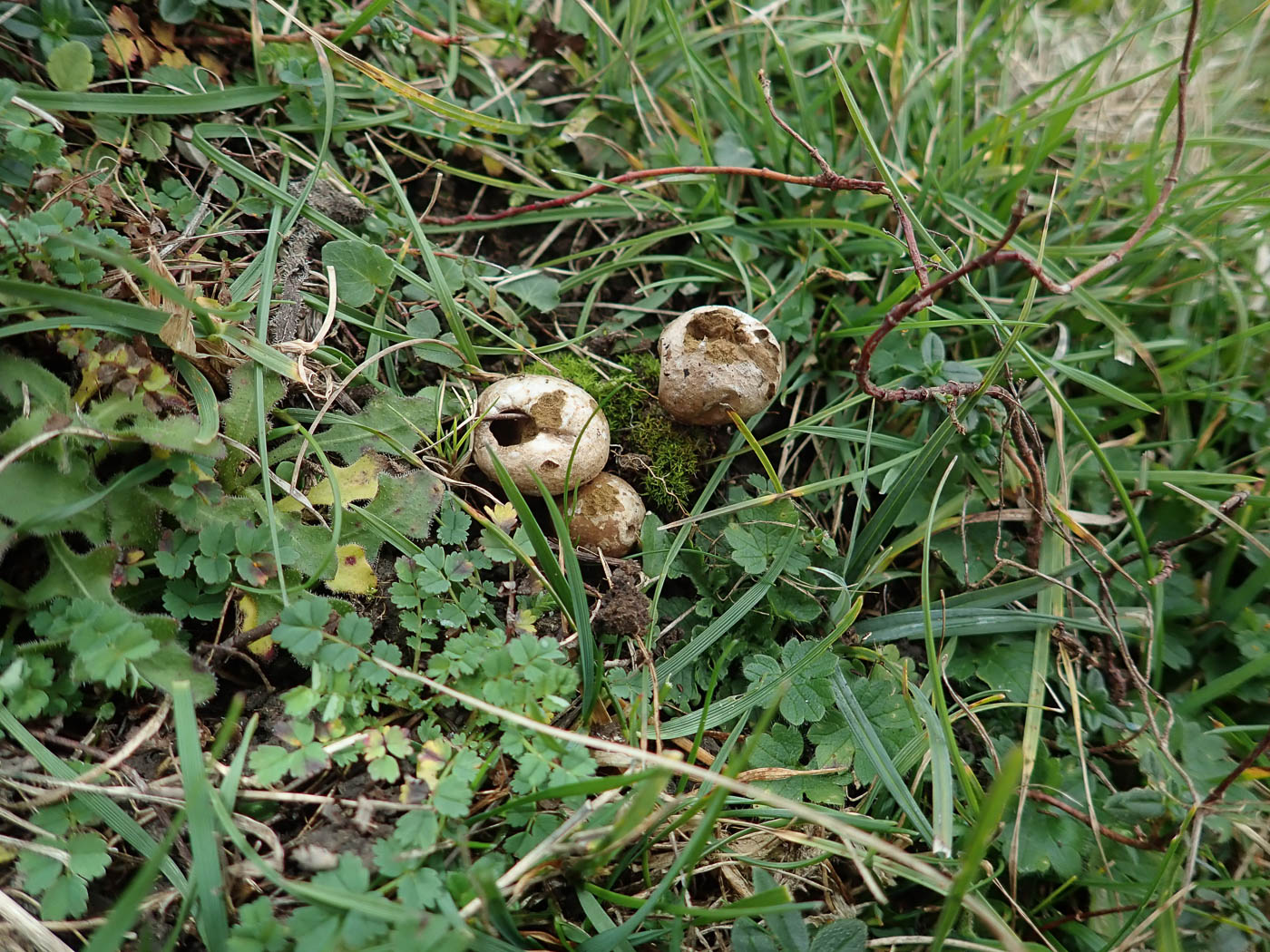 |
November 15th Lycoperdon lividum (Grassland Puffball) On the Helianthemum-covered escarpment at Coombe Hill Penny came across just a very few of these unusual and tiny puffballs which caught her attention having seen them in good number recently in the Forest of Dean. Checking the spores is important with this genus for species other than those which are common and familiar, and she was able to confirm her ID, then discovering that of our three previous county records- no wonder she'd forgotten all about it! This is a new entry for Finds. |
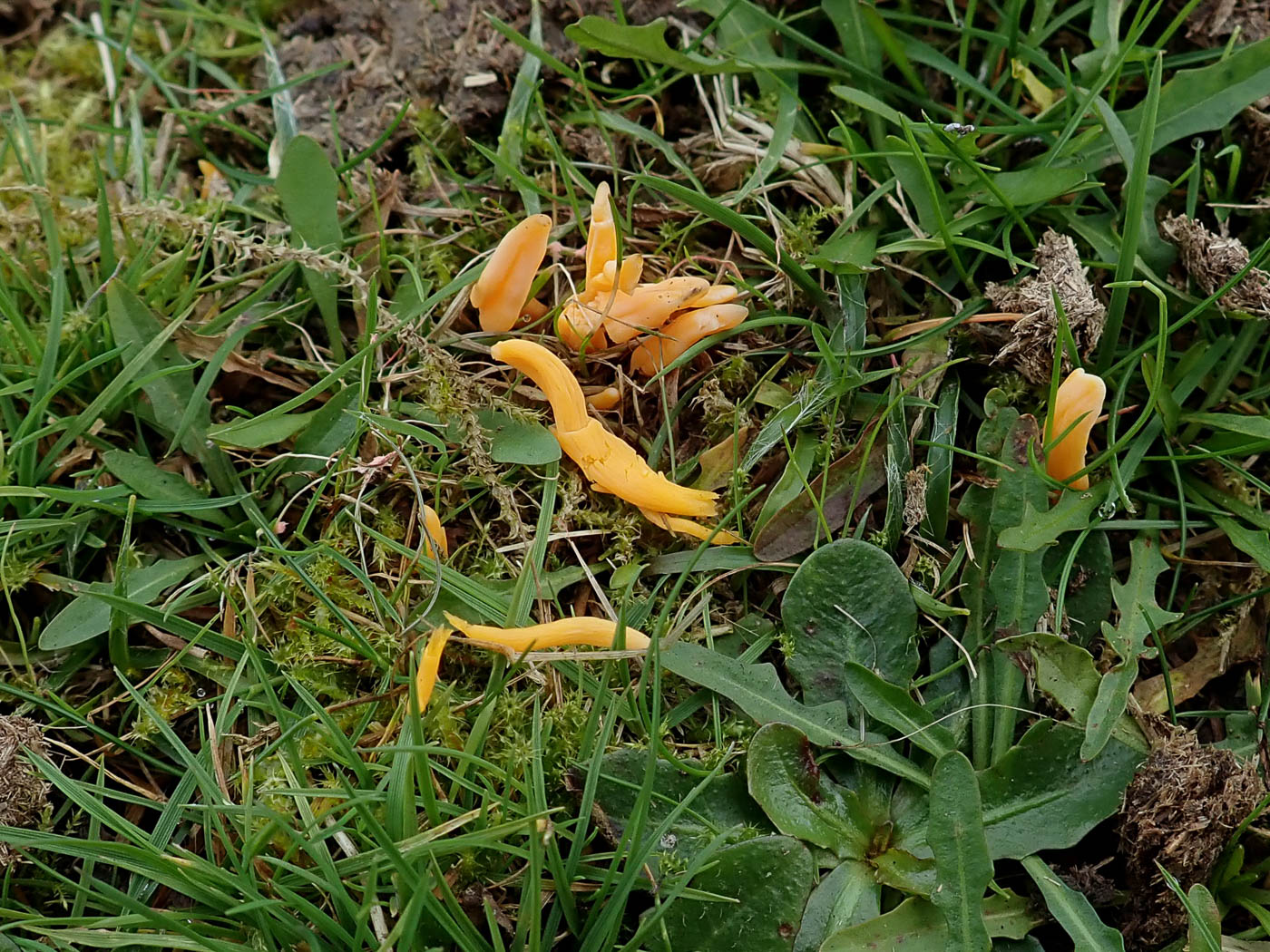 |
November 15th Clavulinopsis luteoalba (Apricot Club) In the mossy short grass at Coombe Hill Penny noticed these bright orange spikes everywhere and they were much more apparent than the normally very frequent C. helvola (Yellow Club). Though one is advised that these small and attractive fungi always need a scope to name safely, it is becoming increasingly likely that the distinctive orange rather than yellow of this particular species - often also with white tips as can be seen here - is one that can be safely named in the field. Separating C. helvola from the much rarer C. laeticolor is still, however, a job for the scope! Previous finds |
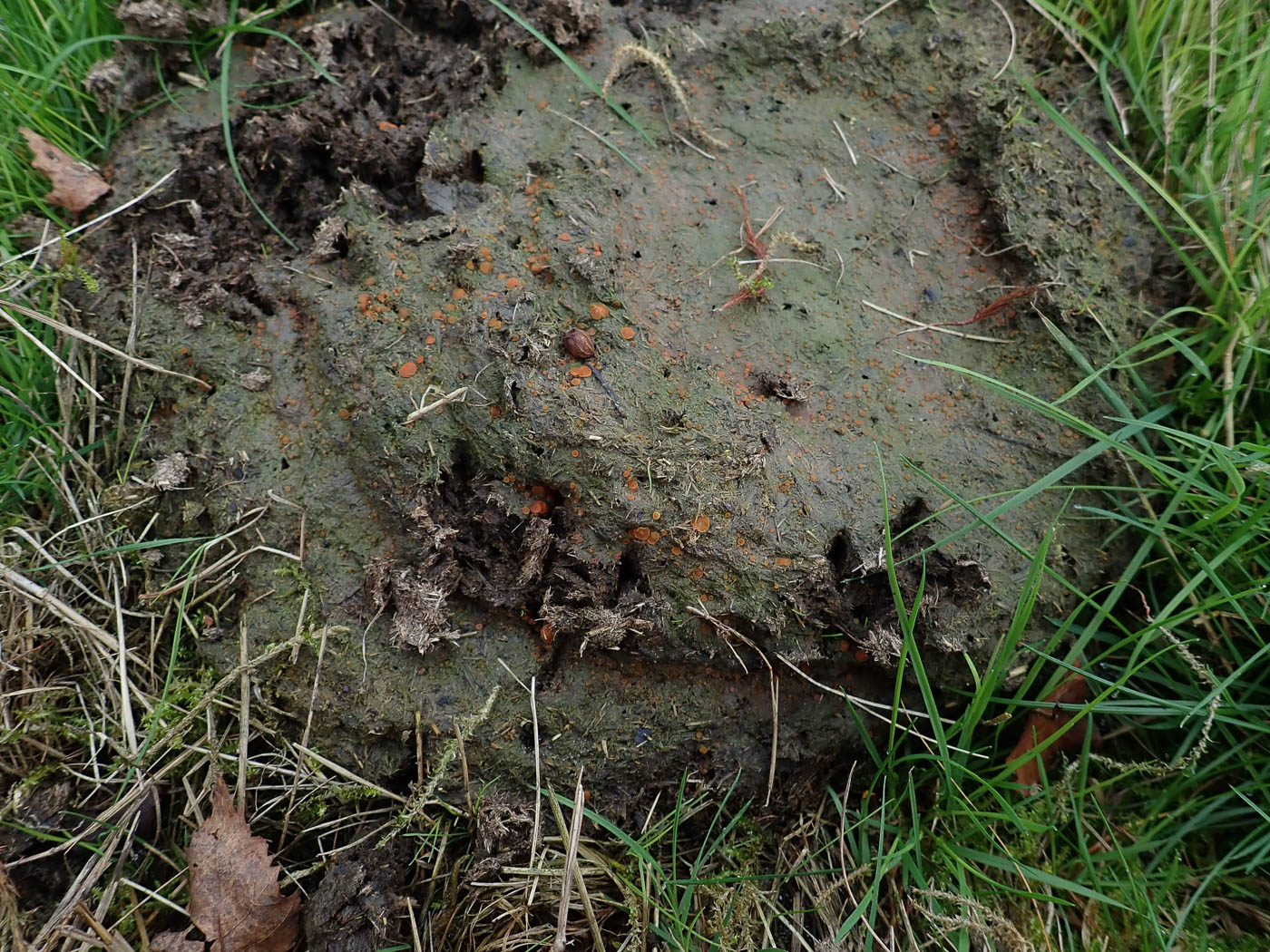
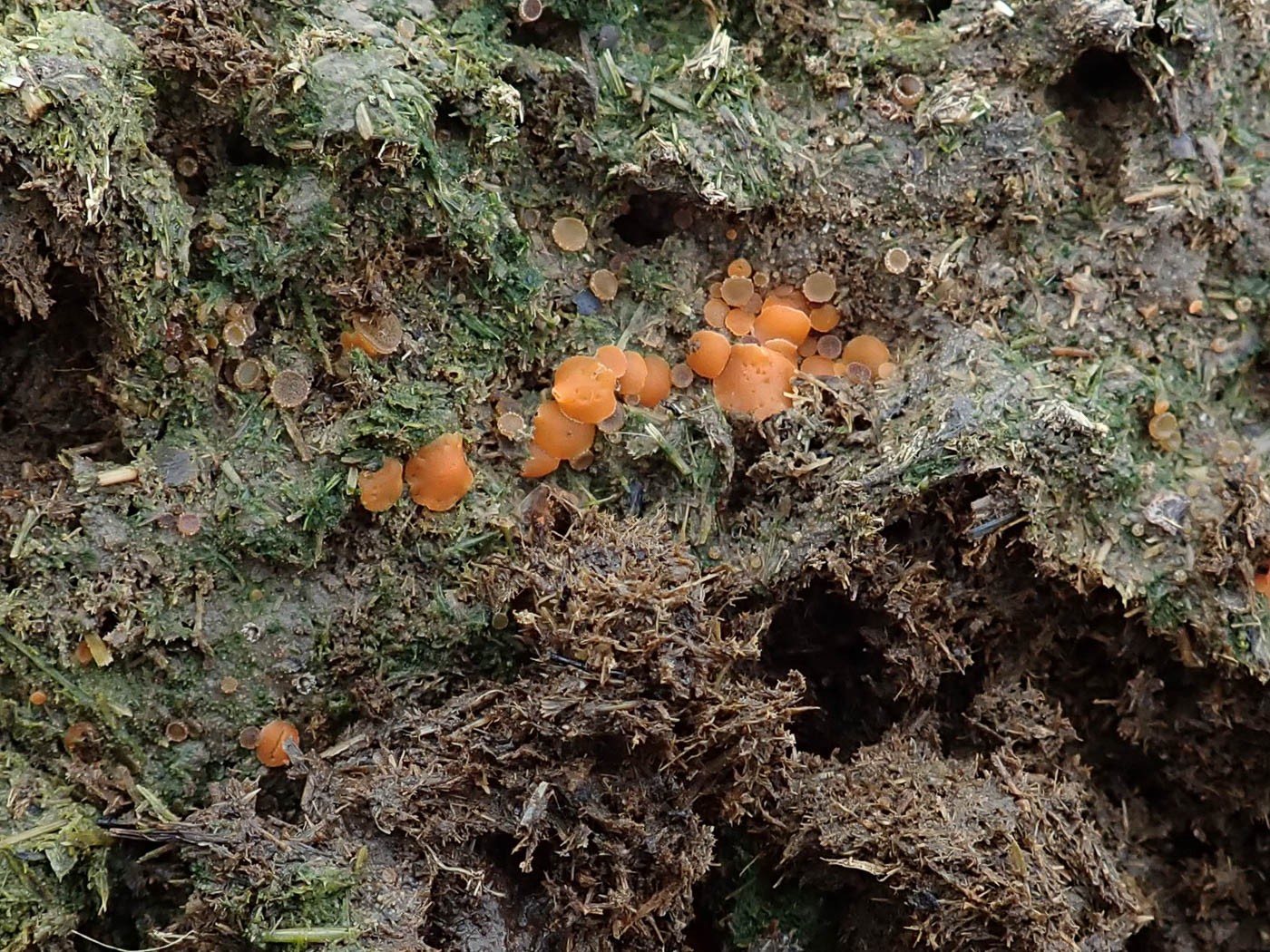 |
November 15th Cheilymenia granulata (an ascomycete with no English name) On many of the cowpats at Coombe Hill Penny saw these patches of tiny bright orange-red cup fungi. A scope at home revealed the large smooth cylindrical spores of this species, also the absence of septate pointed hairs around the margin which are present in other similar species found in dung. C. granulata is very common and was previously and better known in genus Coprobia which now appears to be obsolete genus name. Previous finds |

 |
November 15th Parasola plicatilis (Pleated Inkcap) In the grassy areas at Coombe Hill Penny found this pretty and delicate species and took it home to check the spores which are all important when separating the several likely members of genus Parasola which occur in grass. Though the name plicatilis is the most familiar it is by no means the commonest and has longer less heart-shaped spores than more common P. leiocephala. The cap was about 1 cm across. |
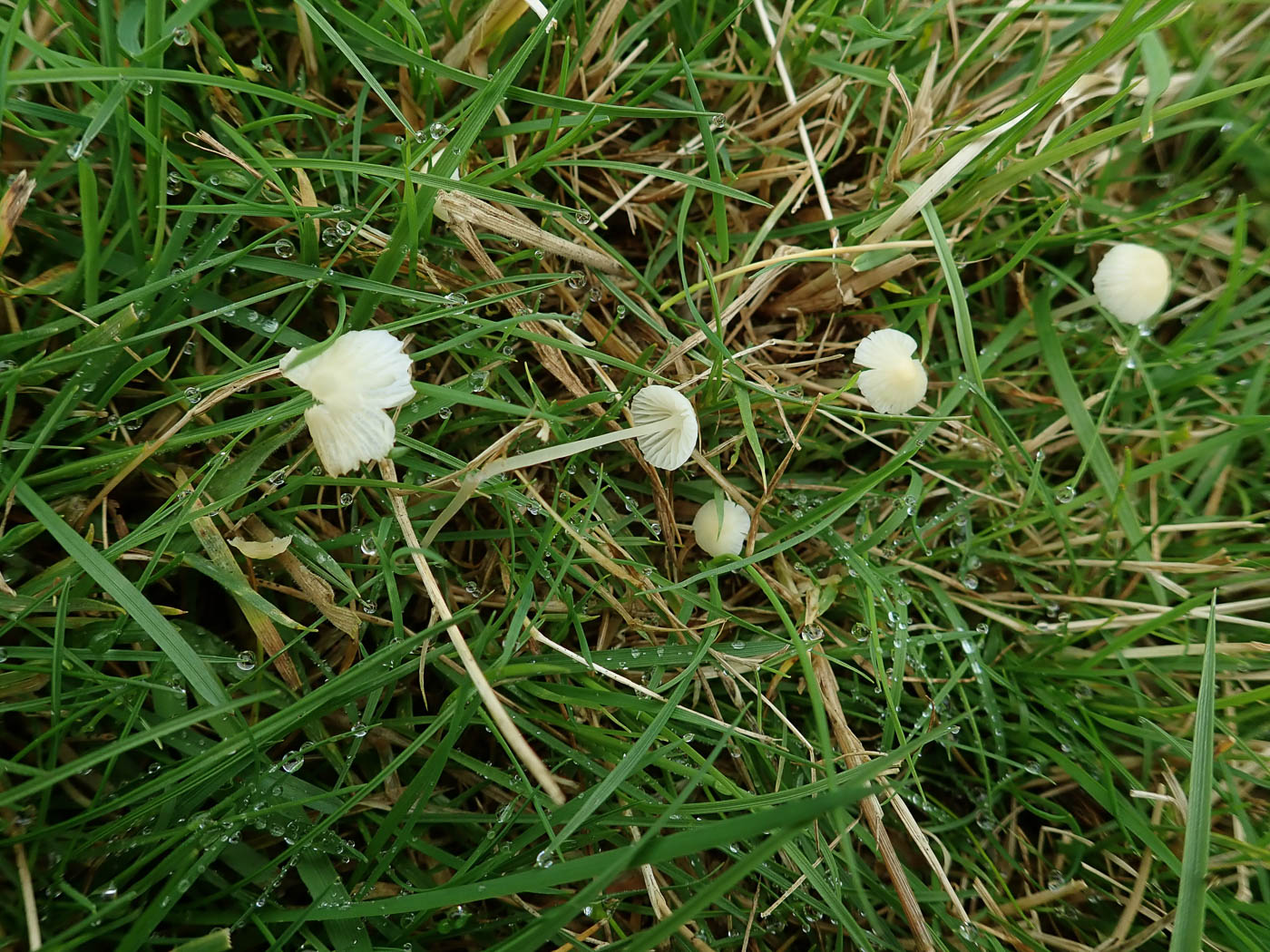
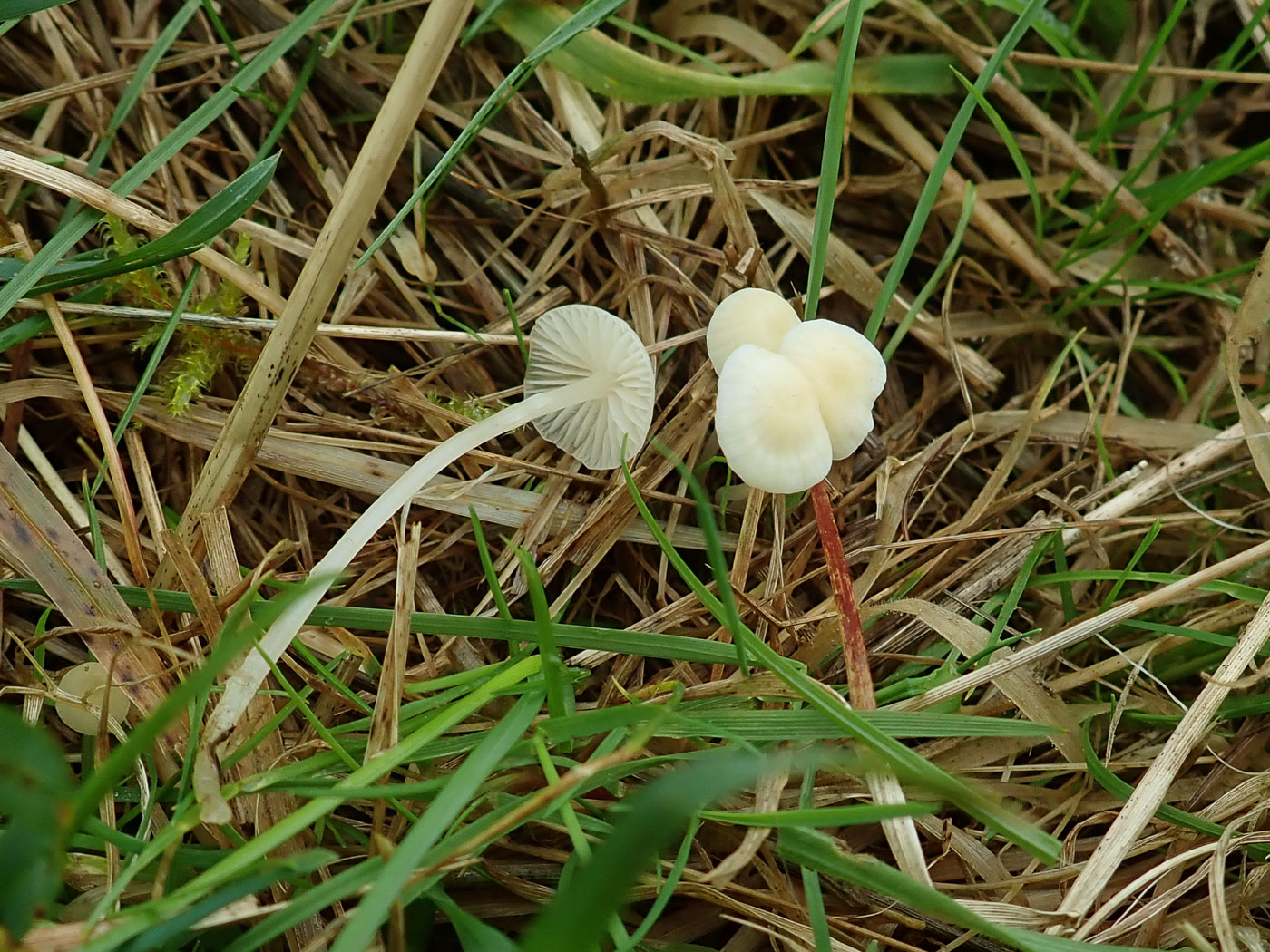 |
November 15th Atheniella flavoalba (Ivory Bonnet) This may be a new genus name to many, but as it is now accepted in Species Fungorum we need to start using it! Previously in genus Mycena, this is a common small grassland species and easy to recognise with its white cap having a yellowish centre. Today's photos come from Coombe Hill where Penny found it in good numbers in the short well manured mossy grassy areas. You might like to note that two other Mycena species which are moved to Atheniella are A. amicta (Coldfoot Bonnet) and the very common A. leptocephala (Nitrous Bonnet). Previous finds |
November 14th 2024
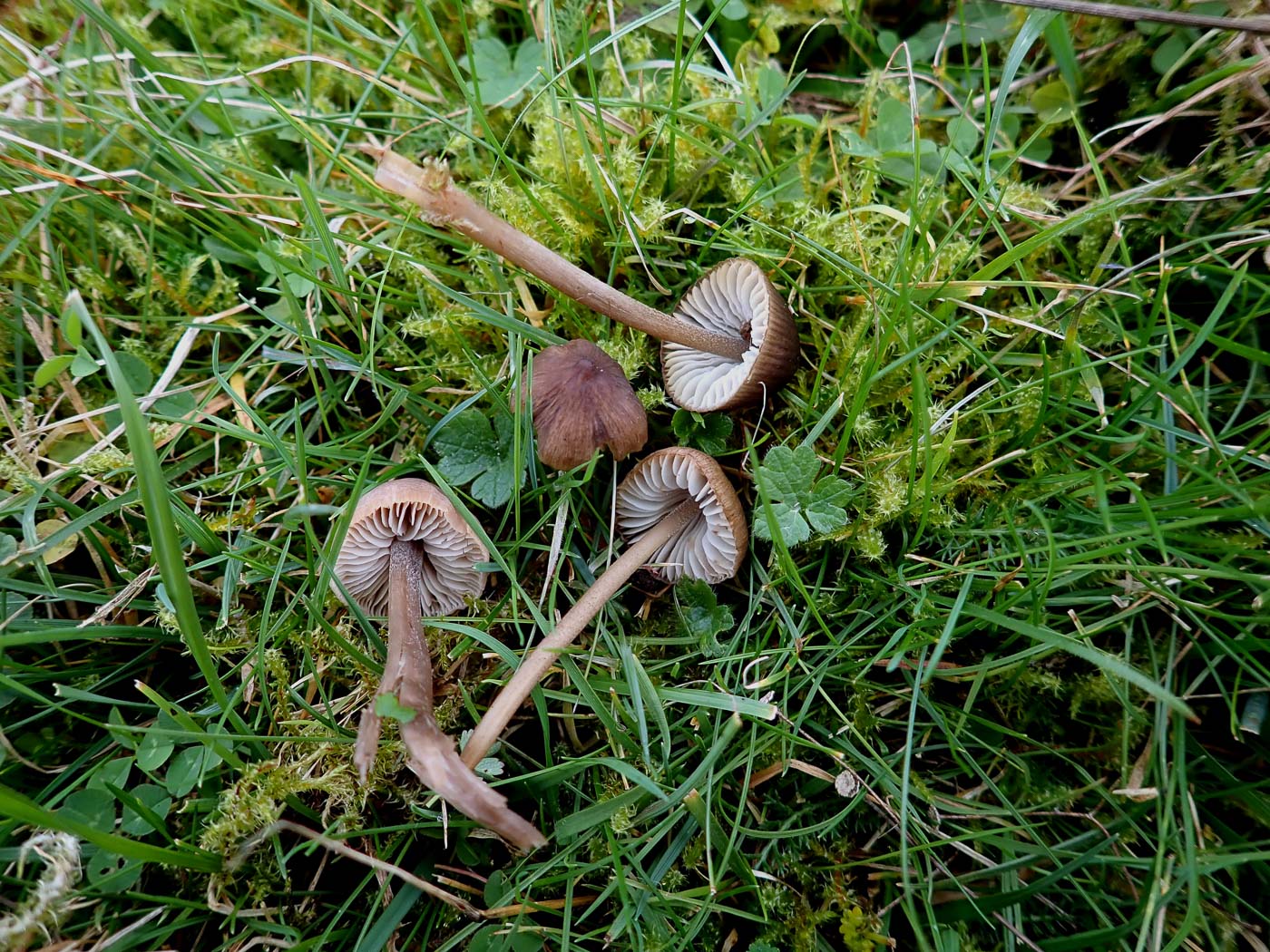
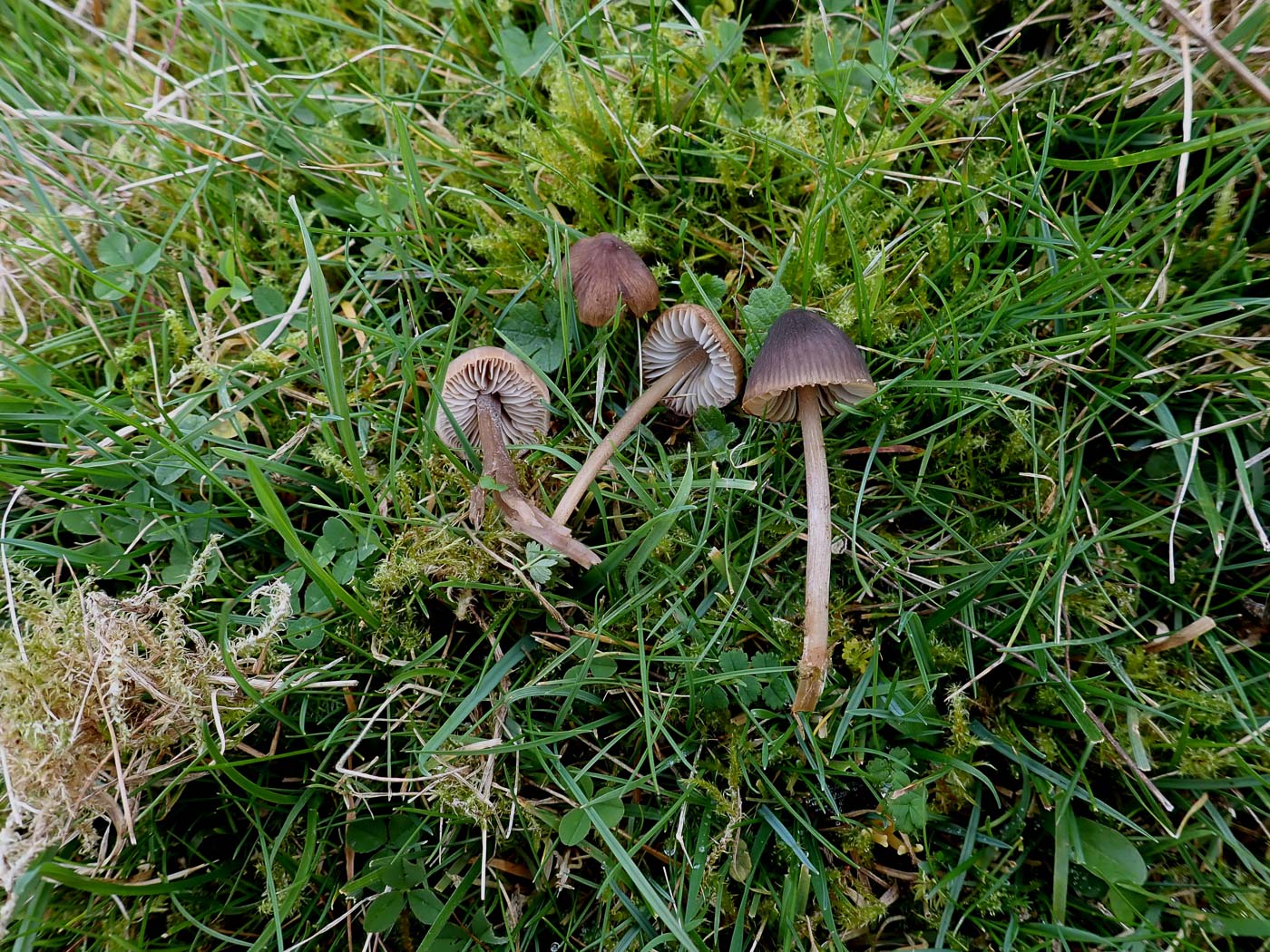
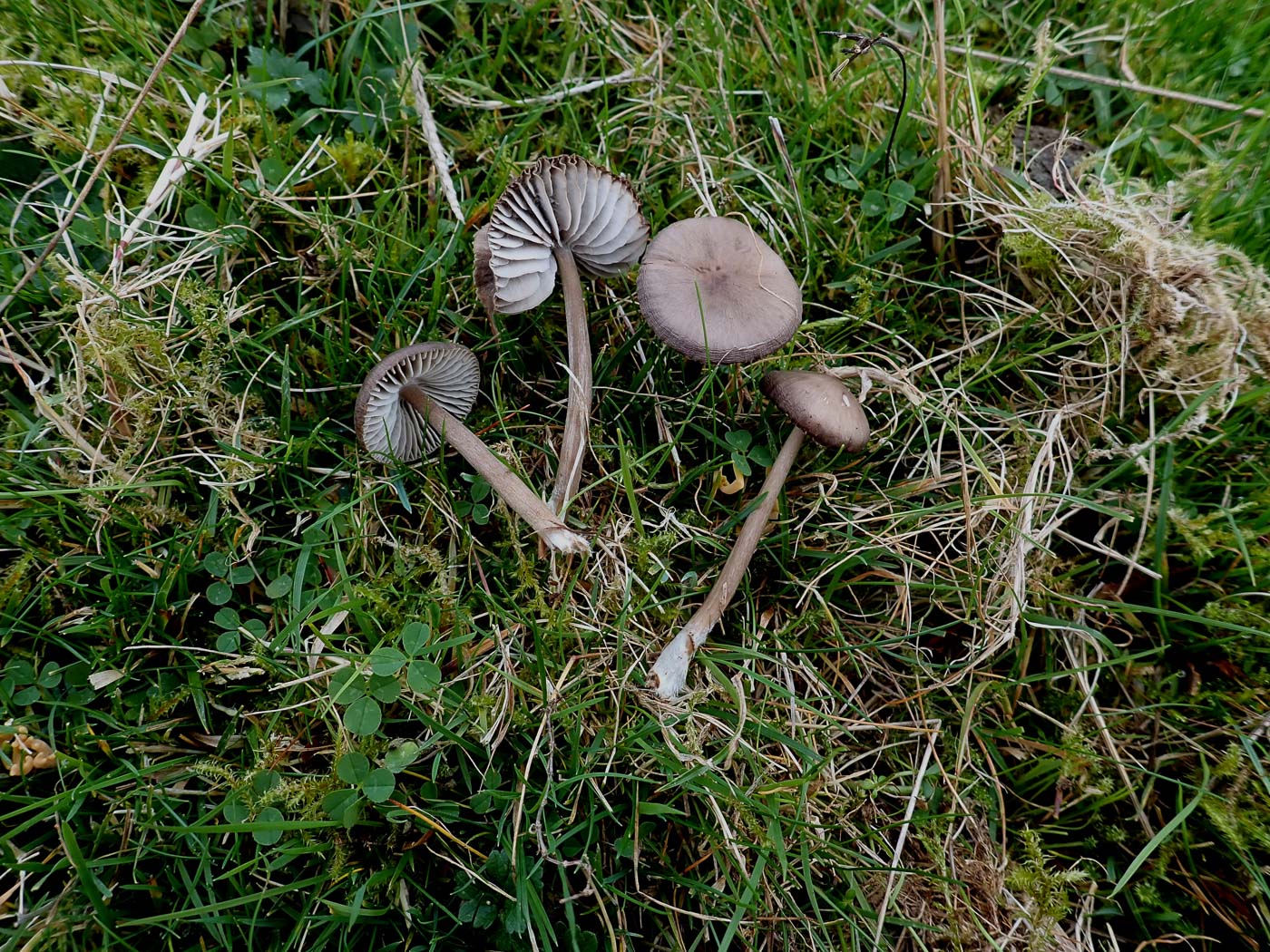 |
November 14th Mycopan scabripes (a rare mushroom with no English name) On the Helianthemum-covered escarpment at Coombe Hill Penny came across two separate collections of a brown mycenoid mushroom which she was confused by. The white gills contrasted strongly with the brown cap and stem and it lacked a smell and didn't seem to fit with any of the grassland Mycena species she knew of. At home she found quantities of large lageniform cystidia which started to ring a bell, not because they matched any Mycena but because she recalled finding something very similar at Watlington Hill (Oxon) also with Helianthemum. Looking up her notes and photos, her found her descriptions for Hydropus scabripes from 2015 and 2019 at Watlington were spot on for today's Coombe Hill collections. Back in 2019 BFG had no access to DNA sequencing so there had to be doubt over her IDs - there are still only two FRDBI records for this species dated 2018 and 2021 - so clearly it is important to have a Coombe Hill sample sequenced as this in not only new to the county but obviously very rare. Many species previously in genus Hydropus have now been moved elsewhere, so Mycopan is the current genus name for our species but it is just possible that this particular collection, made now several times with Helianthemum, may be a cryptic unnamed species as neither of the two previous FRDBI records were with this plant. Fingers crossed that sequencing will shed more light ............... |
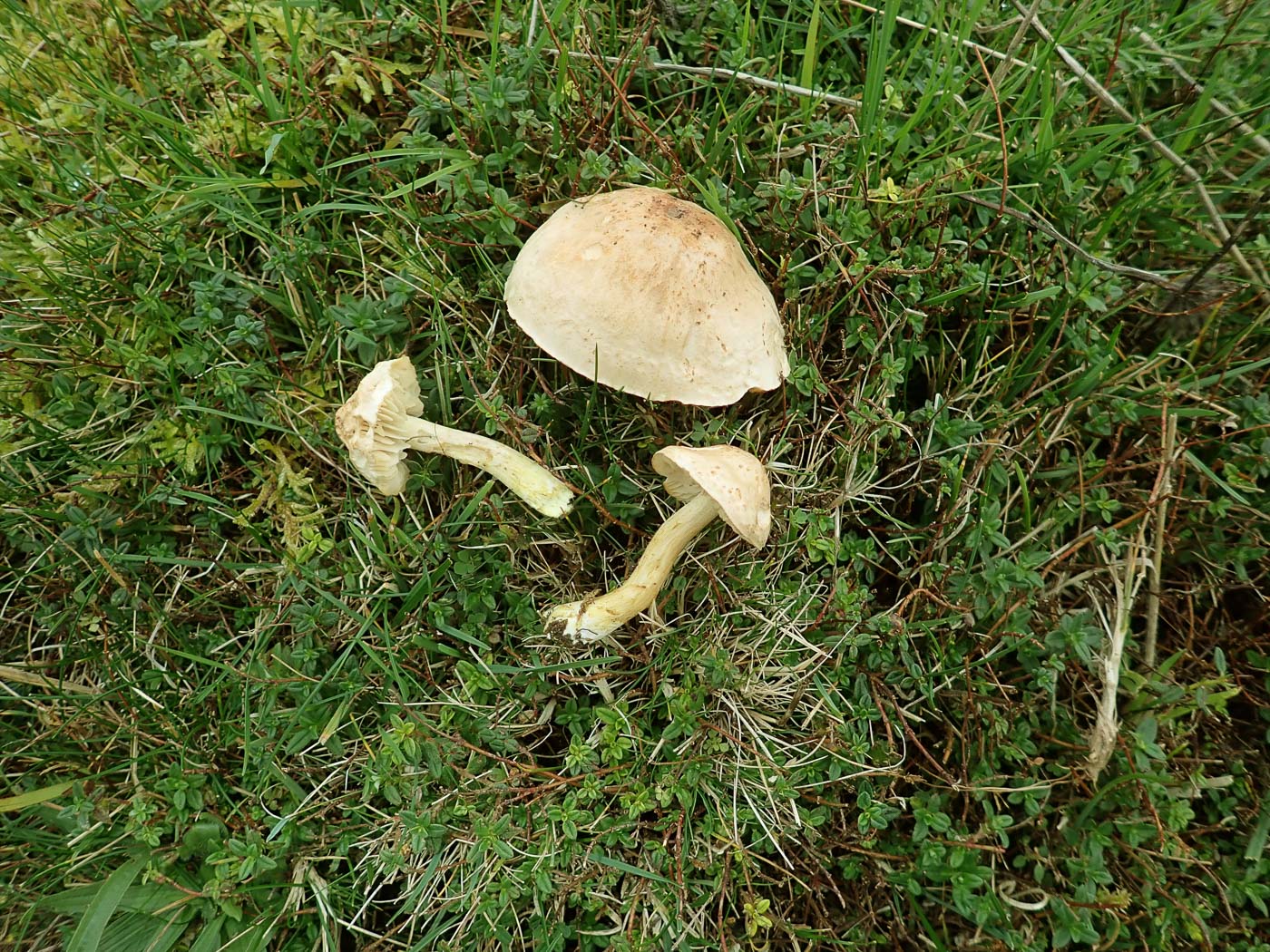 |
November 14th Tricholoma hemisulphureum (a species of Knight with no English name) On the Helianthemum-covered escarpment at Coombe Hill Penny was on the lookout for any of the special mushrooms which associate with this particular plant. She found only this one, a fairly nondescript species which, however, is clearly related to the familiar yellow T. sulphureum (Sulphur Knight) sharing its remarkably pungent and unpleasant smell of coal gas tar. Once smelt never forgotten! It appears to be host specific to Helianthemum so well worth looking out for, as are many other mycorrhizal species, wherever that plant occurs. Previous finds |
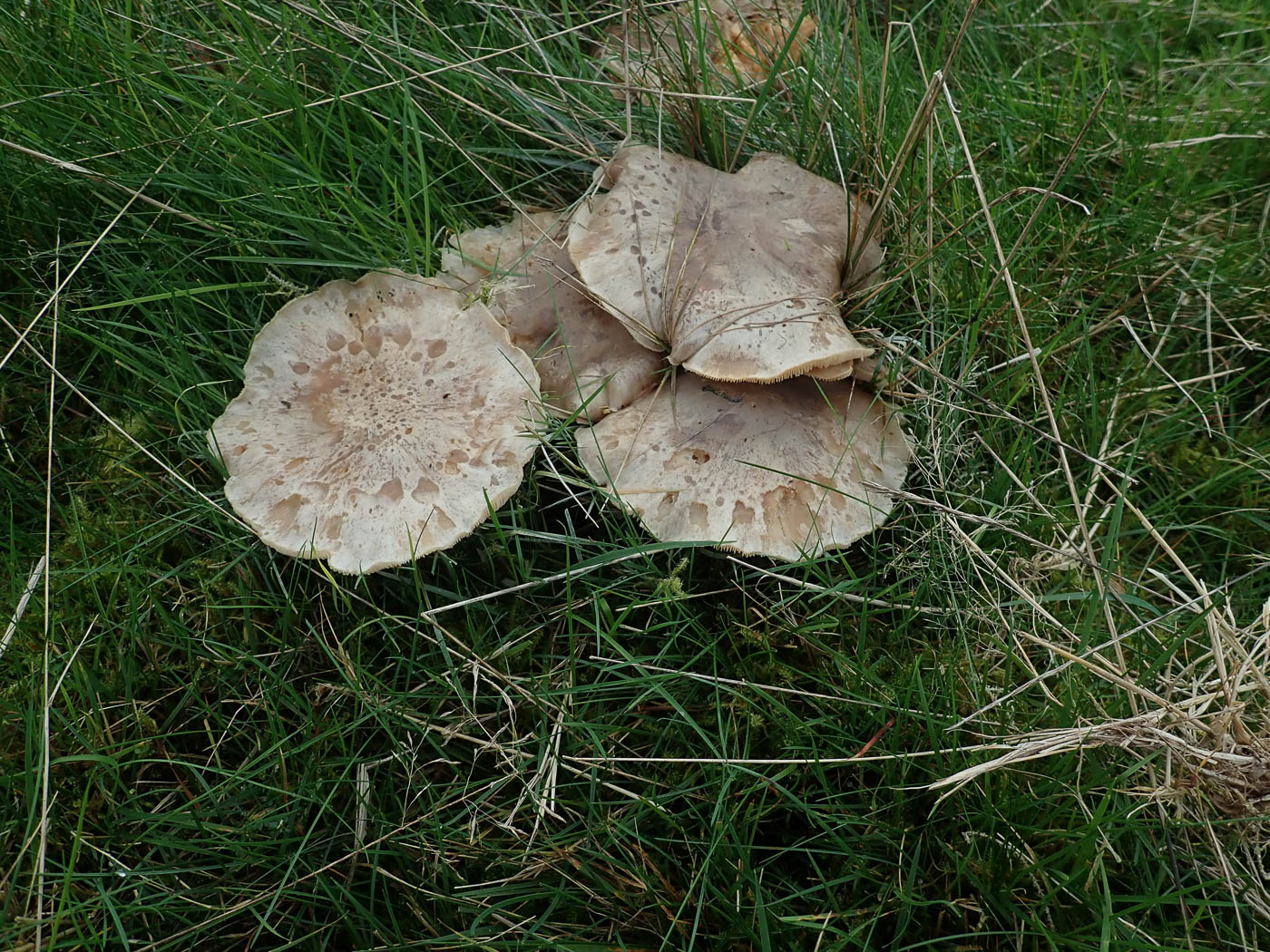
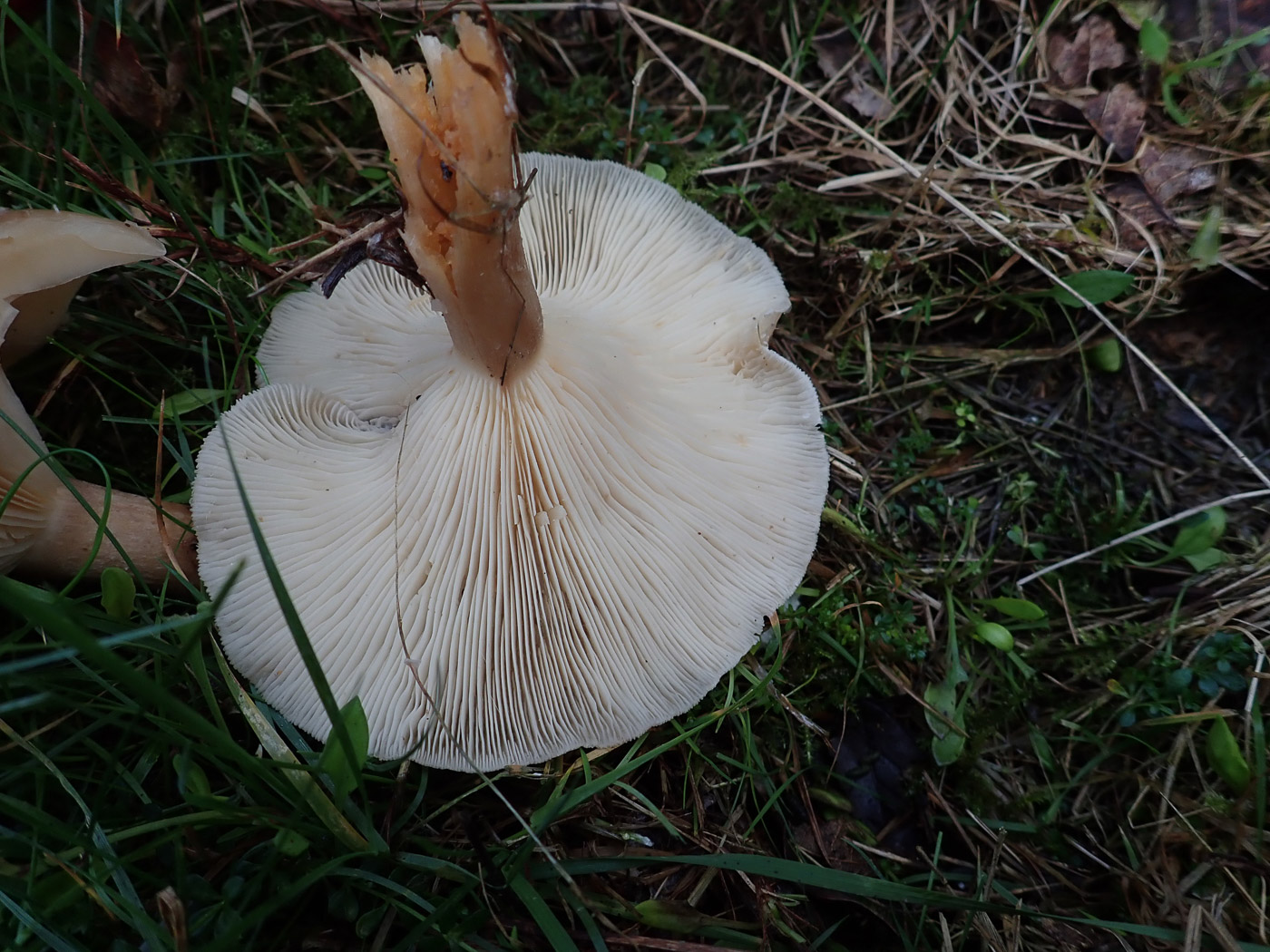 |
November 14th Lepista luscina (Spotted Blewit) In various different grassy areas at Coombe Hill Penny came across clumps of large specimens of this quite unusual species which seems to be a regular at this site. Unfortunately they were all well past their sell-by date except for one which she managed to turn over without it collapsing to show the crowded decurrent gills of the species. They were too far gone to have their typical sweet smell but the caps - up to 10-11 cm across - showed the distinctive droplet markings which characterise this grassland species. Previous finds |
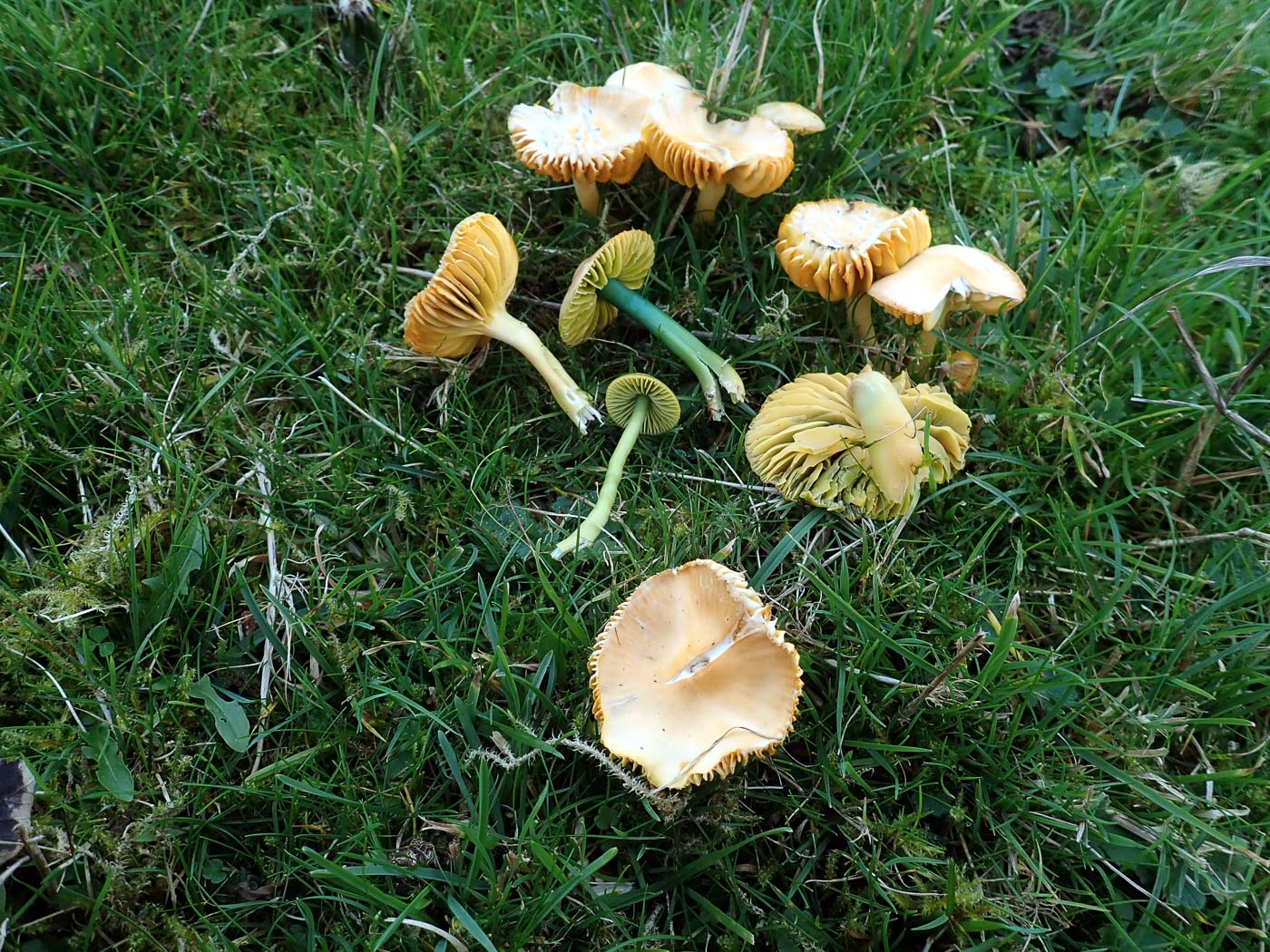 |
November 14th Gliophorus psittacinus (Parrot Waxcap) Near the monument at Coombe Hill Penny noticed these large yellow caps (4-5 cm across) which proved to be Parrot Waxcaps - a common species but what was unusual about them was their size and the lack of green even at the stem apex on several specimens. They were suitably sticky and enough of them were indeed showing the typical green to remove any doubt but she felt it was worth including here as an example of how varied the species can be. Previous finds |
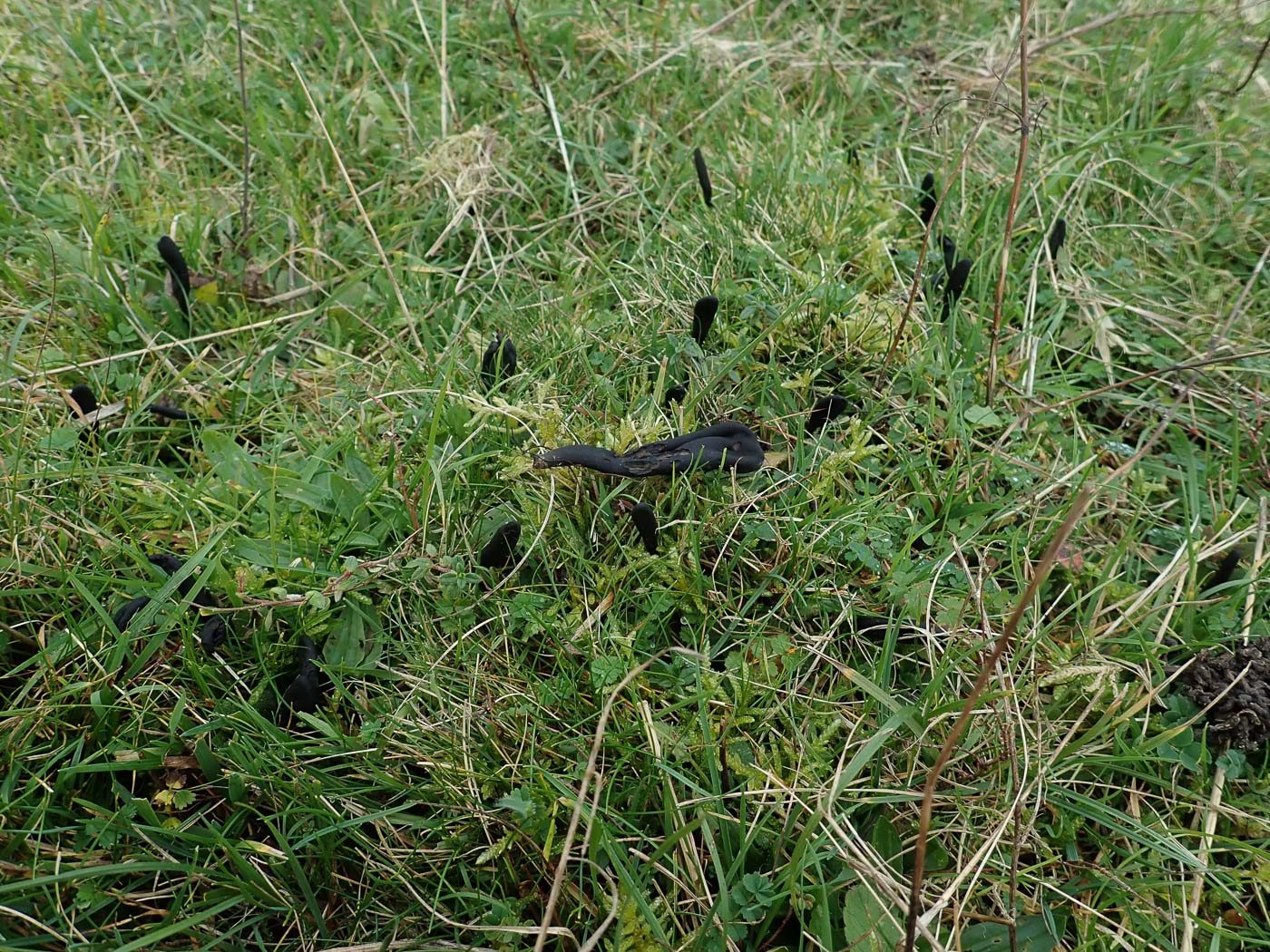
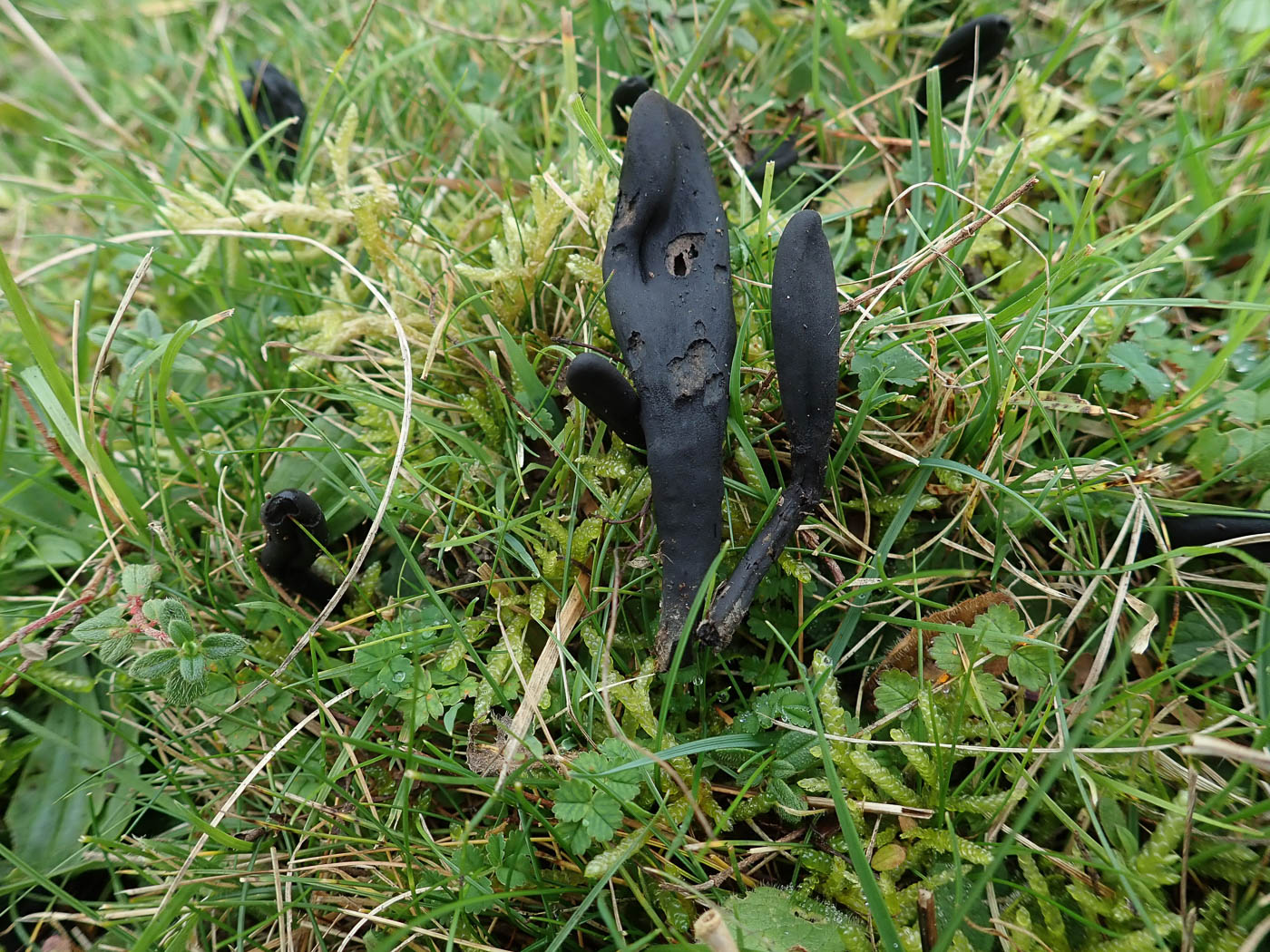 |
November 14th Geoglossum cookeanum (an Earthtongue with no English name) As Penny stepped onto the Helianthemum-covered escarpment at Coombe Hill the first fungi she saw was a large patch of black clubs near the main path. Not having seen this genus here before she took one home to identify, following the key and counting the number of septa in the amazing long spear-like spores and taking note of the shape of the paraphyses (cells which lie between the spore-containing asci). Having worked out the species name, she then found that it had been seen here back in 2001 when identified by Steve Kelly (it being one of his favourite genera). We have quite a few records from elsewhere and this is not considered a rarity. Previous finds |
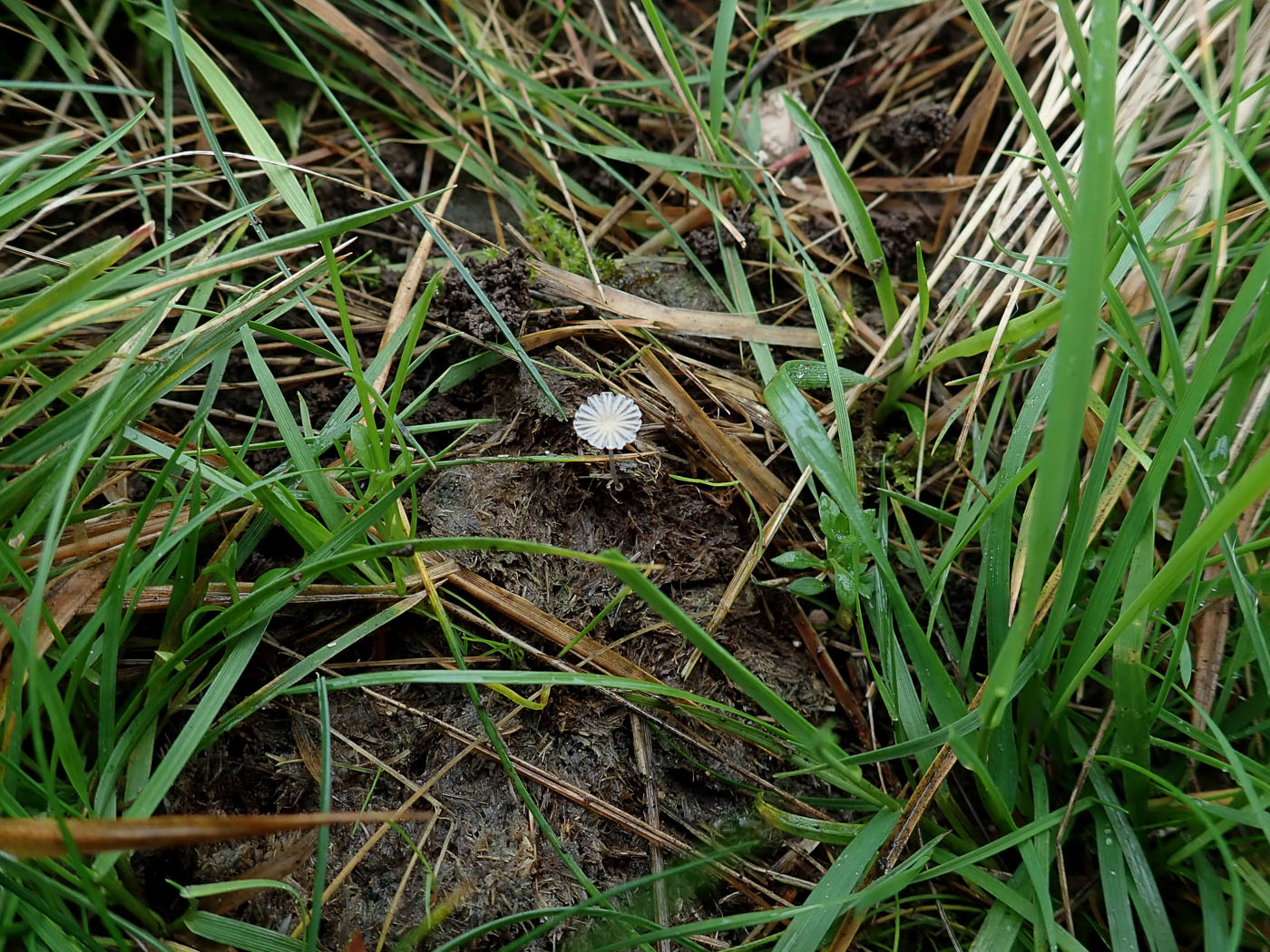
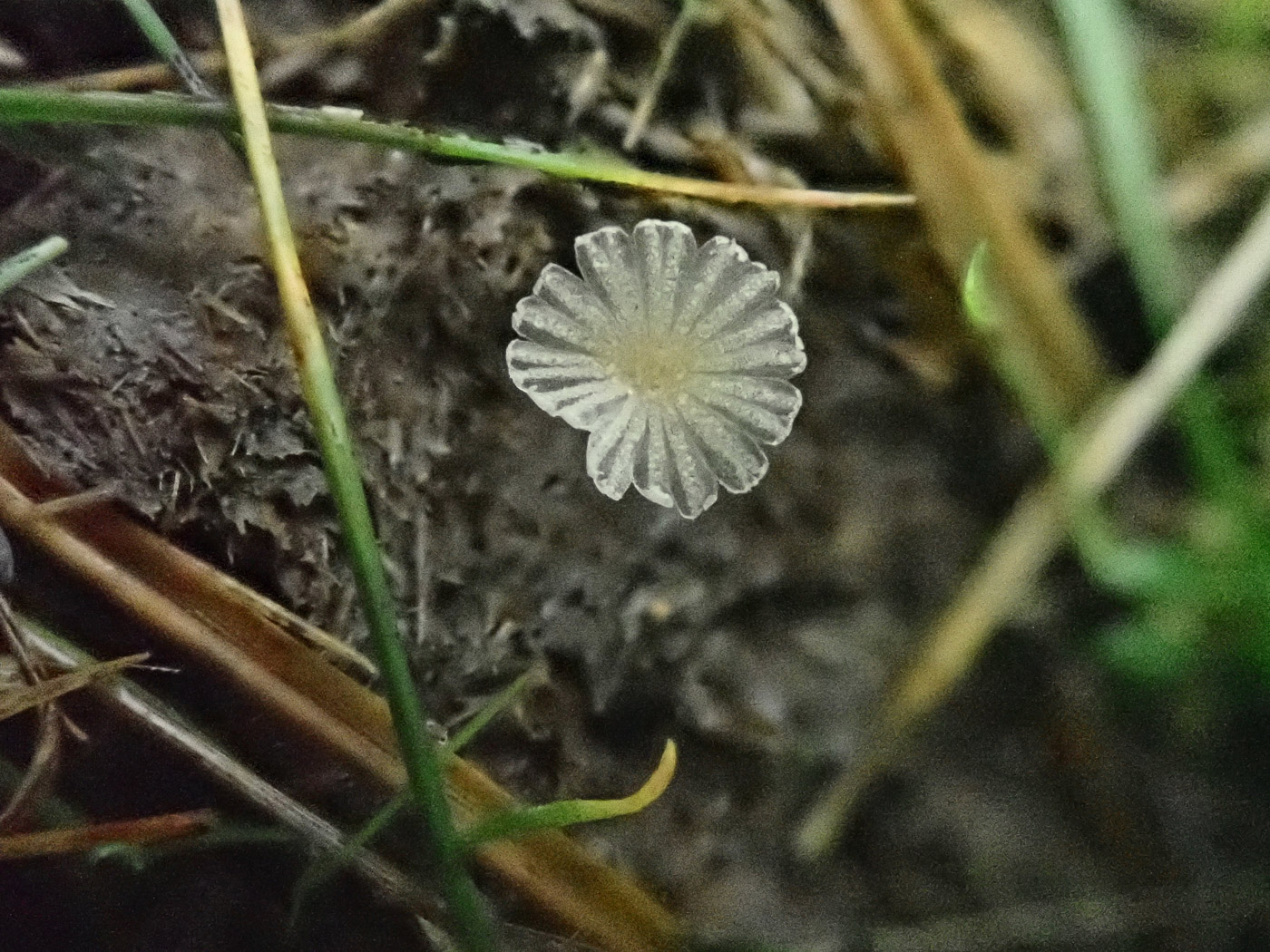 |
November 14th Parasola misera (Least Inkcap) In a patch of cow dung at Coombe Hill Penny spotted this tiny star-shaped white cap and guessed it was likely to be this species as it was on dung though despite its name there are even smaller Inkcaps! Members of genus Parasola are often easier to tackle at home purely because they don't deliquesce like the other Inkcap genera which tend to provide one with no more than a black mess in ones pot! Penny was therefore able to check the spore size and shape to confirm the determination. The cap was no more than 4 mm across. Previous finds |

 |
November 14th Xylaria hypoxylon (Candlesnuff Fungus) In Salden Wood Bob Simpson was intrigued by these somewhat skinny white threads emerging from the sawn end of a Hazel log. Was this really just the very common X. hypoxylon or could it be a different species from that genus, maybe H. filiformis, the name of which seemed to fit the bill but he could find no details about it? When he sent his photos round to a selection of colleagues for their opinions. Sarah Ebdon came up with the information that H. filiformis grows on herbaceous stems and leaf litter therefore was eliminated, also several of us have noticed this phenomenon this season with very thin whispy examples of X. hypoxylon appearing. It's been a funny season ................. Previous finds |
November 9th 2024
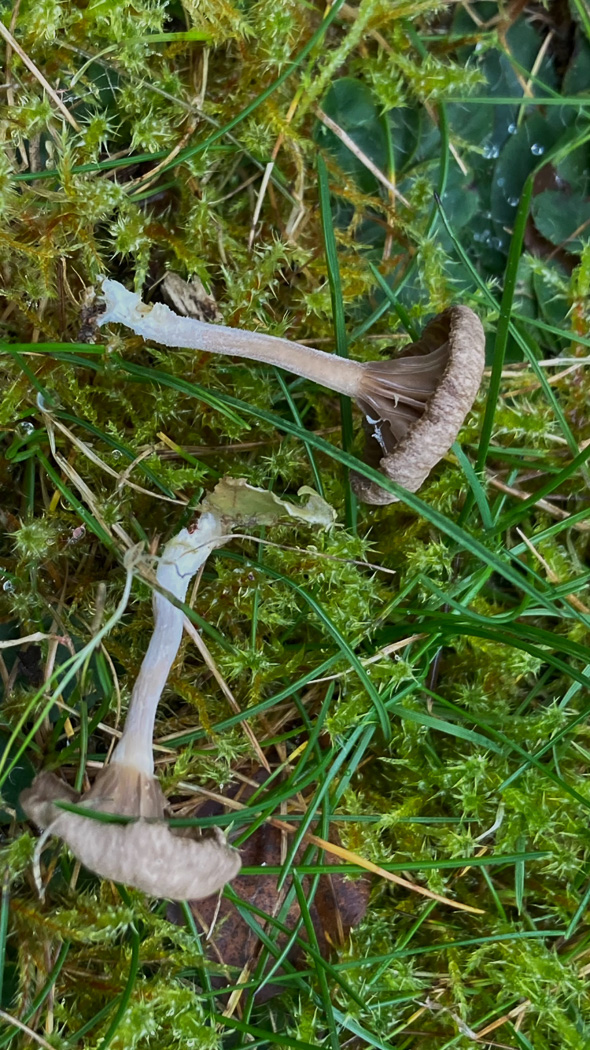 |
November 9th Arrhenia velutipes (Alpine Navel) In low cut mossy grass at Cliveden Estate Russell Ness found this small 'omphaloid' species where he'd discovered this genus in previous years though this collection seemed a bit different. He noted the stem was thickly pubescent and it had a faint Pelargonium smell and these characters together with microscopic details led to this species in the key. It appears that it is by no means restricted to alpine conditions despite the English name though this is new to the county with only 10 FRDBI records which come from all over the UK. This was a nice find. |
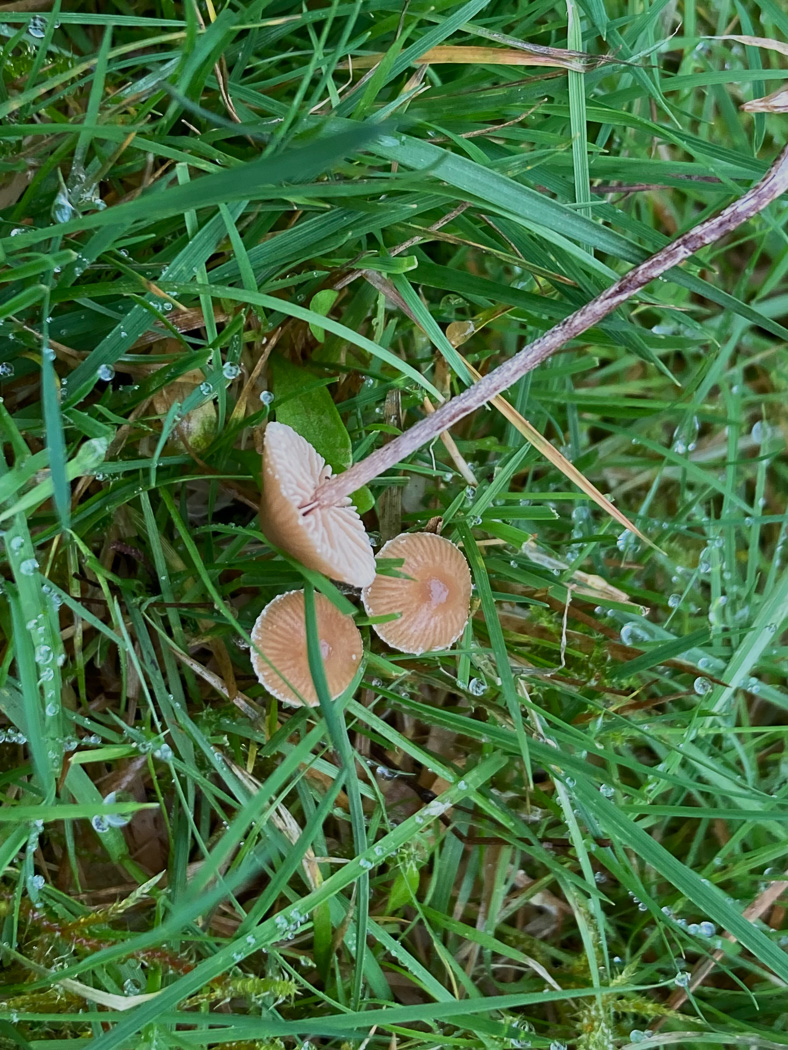
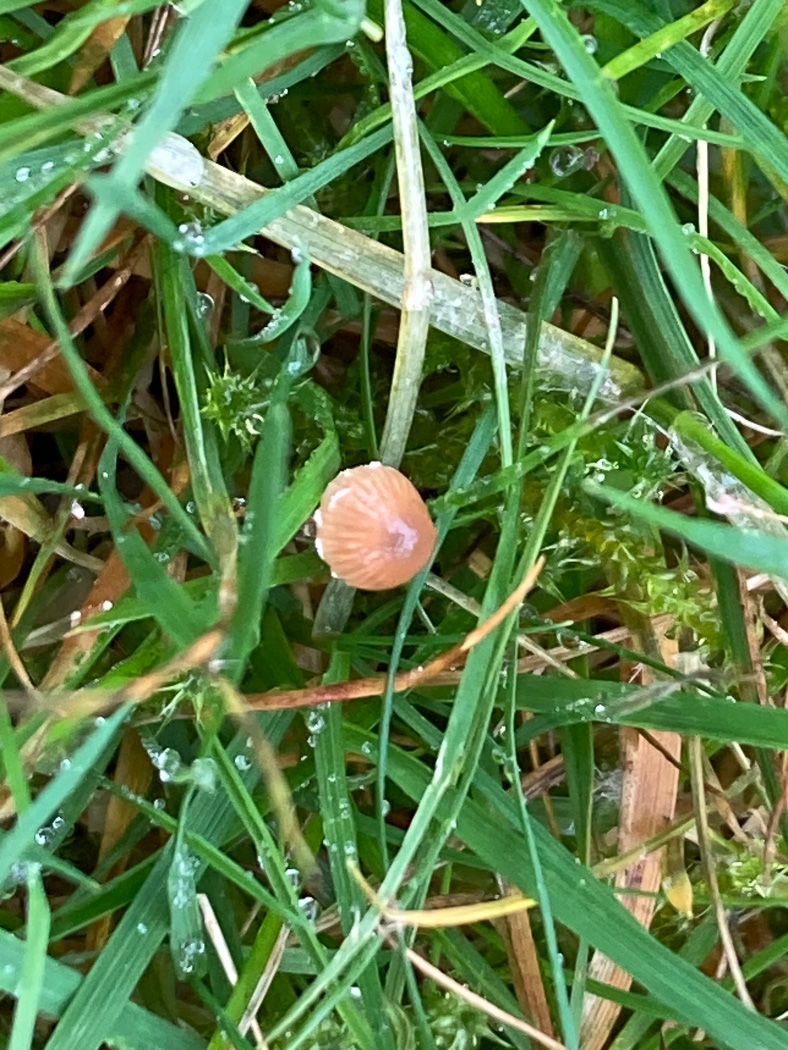 |
November 9th Deconica crobula (a species of Brownie with no English name) In low cut mossy grass at Cliveden Estate Russell Ness found these few LBJs and took them home to work on. The gelatinous peelable cap cuticle together with spore colour, size and shape took him to this species with which the pale cap having visible veil remnants fitted well. The species is somewhat similar to D. inquilina which (judging from descriptions) has slightly longer spores and more widely spaced gills (see Finds entry from Stampwell Farm Nov 2nd for comparison) though both are found on woody debris- sometimes submerged - and also in grassy areas. Previous finds |
November 8th 2024
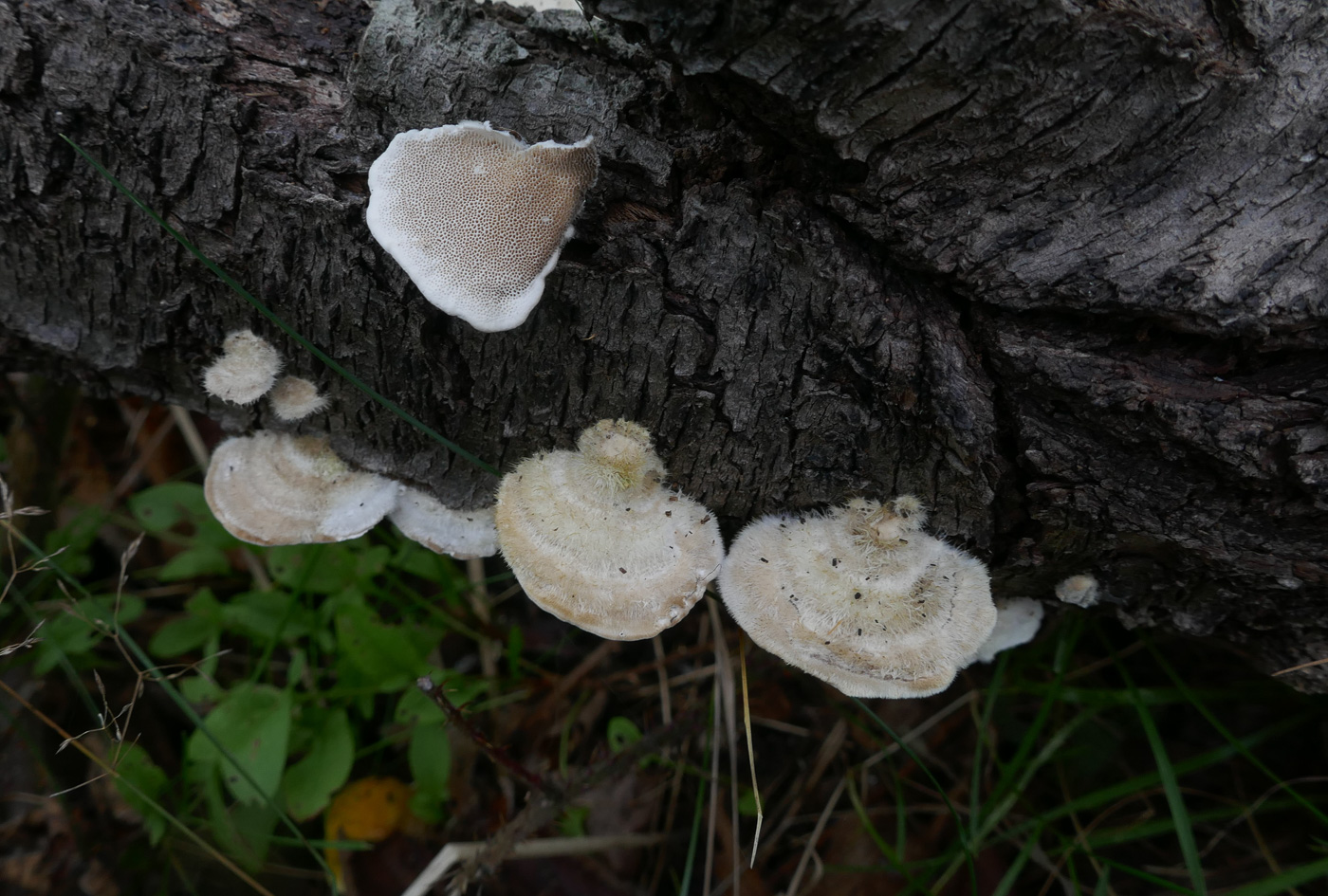 |
November 8th Trametes hirsuta (Hairy Bracket) On a fallen Plum branch at Stampwell Farm Jackie Ewan noticed these brackets and thought they were likely to be this species - similar to but much less common than T. versicolor (Turkeytail) with which many are familiar. Penny suggested she should ask Claudi Soler to check her photo and he was able to confirm her ID. The top specimen in her photo show the pores typical of the genus but the lower specimens wshow the pale somewhat hairy surface of this species. Previous finds |
November 7th 2024
 |
November 7th Marasmius hudsonii (Holly Parachute) At Stoke Poges Memorial Gardens Barry and Gill, whilst searching under bushes in litter for slime moulds, discovered this special little mushroom which appears to be becoming much more common in our area. It is miniscule and only grows on dead Holly leaves and was new to the county only a few years ago. New to the site today it caused the usual stir and amazement when found especially when viewed with a hand lens which is essential to see the rusty red prickles which adorn both the cap and stem. The photo is Barry Webb's. Previous finds |
 |
November 7th Diachea leucopodia (a slime mould with no English name) At Stoke Poges Memorial Gardens Barry and Gill were on the hunt for slime moulds and came across a beautiful swarm of these tiny little stunners on the edge of a leafy compost heap together with several other interesting slime moulds and fungi. The glistening irridescence contrasting with white stalk of this particular species makes it an easy one to identify but though described as common in the south this is a first for the county and there appear to be only a handful of records on FRDBI. The photo is Barry Webb's. |
 |
November 7th Didymium squamulosum (a slime mould with no English name) At Stoke Poges Memorial Gardens Barry and Gill were on the hunt for slime moulds and came across this species on some twiggy litter. One of the commonest members of this large genus, it often goes unnoticed being so tiny - only a few mm high- and the squamulose surface is showing nicely here. The photo is Barry Webb's. Previous finds |
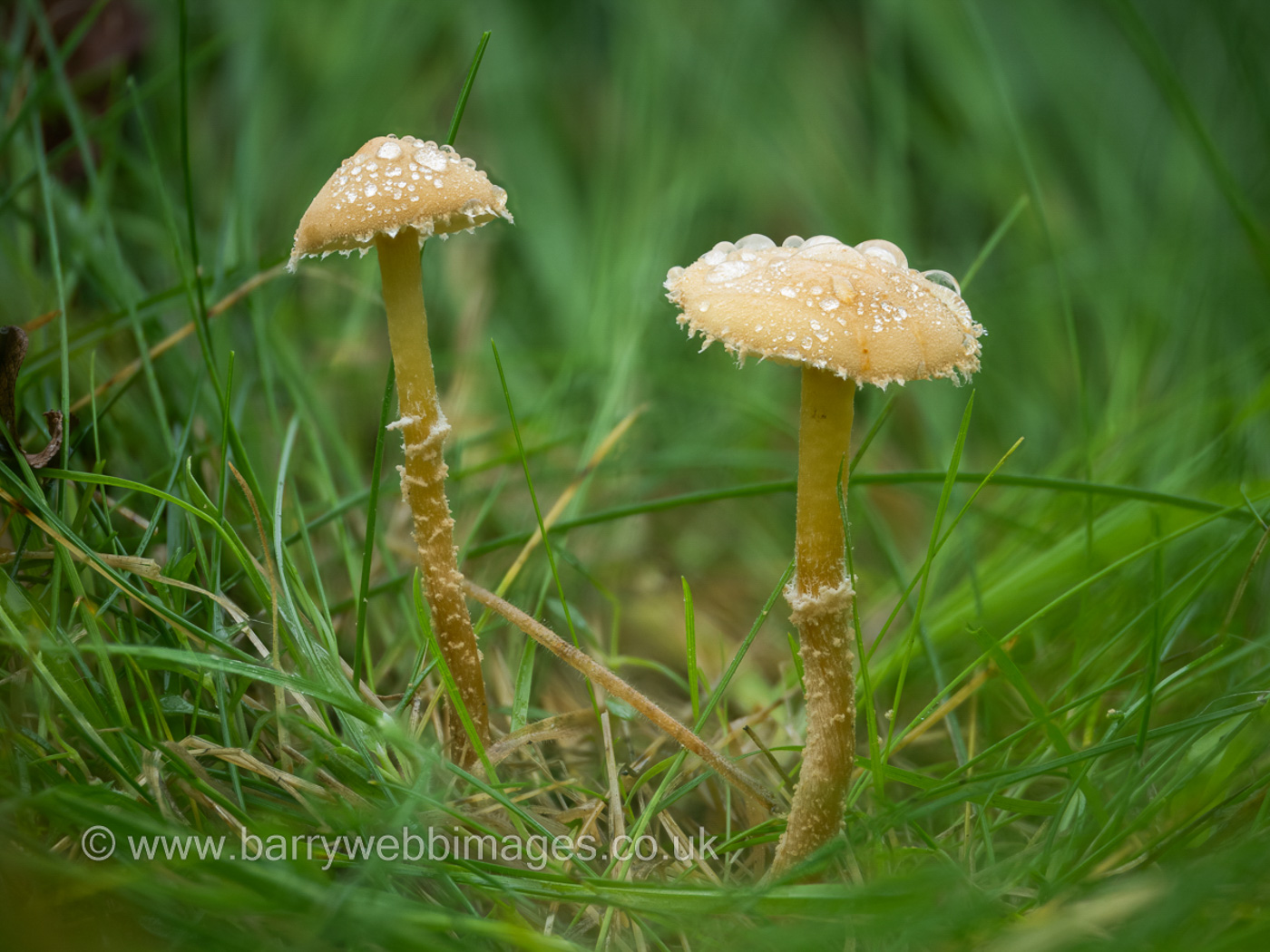 |
November 7th Cystoderma amianthinum (Earthy Powder-cap) At Stoke Poges Memorial Gardens our large group found only one or two examples of this normally quite common grassland species though for some inexplicable reason and unlike many grassland species it seems to have been quite scarce this autumn. Similar to a small Lepiota (Dapperling), it has a scurfy coating on the cap and the veil often leaves white flecks on the cap margin with a ring on the stem though this can be ephemeral. These features are nicely clear in the photo and have not yet been washed off by the rain droplets. The photos is Barry Webb's. Previous finds |
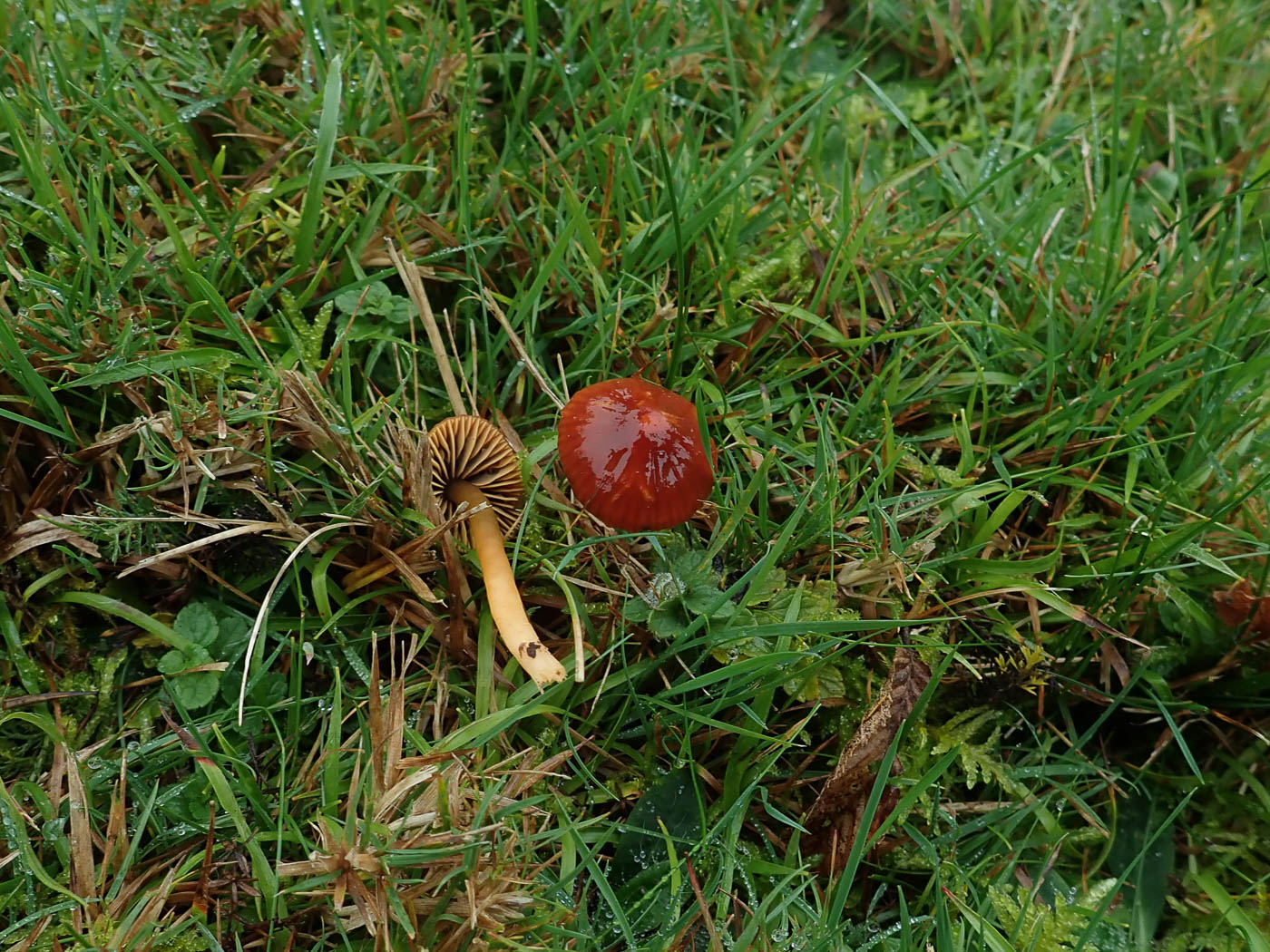 |
November 7th Gliophorus aff. europerplexus (Butterscotch Waxcap) In St Giles Churchyard Stoke Poges, Penny went to check if this rare species - found here several times in the last few years - was by any chance fruiting at the moment. Success! There were just these two unmistakable and slimy fruitbodies showing their distinctive colour in cap, gills and stem though there was just a hint of green in one of the caps shedding a little doubt because it is thought that the 'psittacina'-like green should be absent. However, Jackie Ewan has also found this same species at Stampwell Farm showing hints of green and we'll get both samples sequenced to aid Martyn Ainsworth at RBG Kew in his research to determine whether this UK species is the same as those found in Europe or maybe a unique as yet unnamed Waxcap. Watch this space! Previous finds |

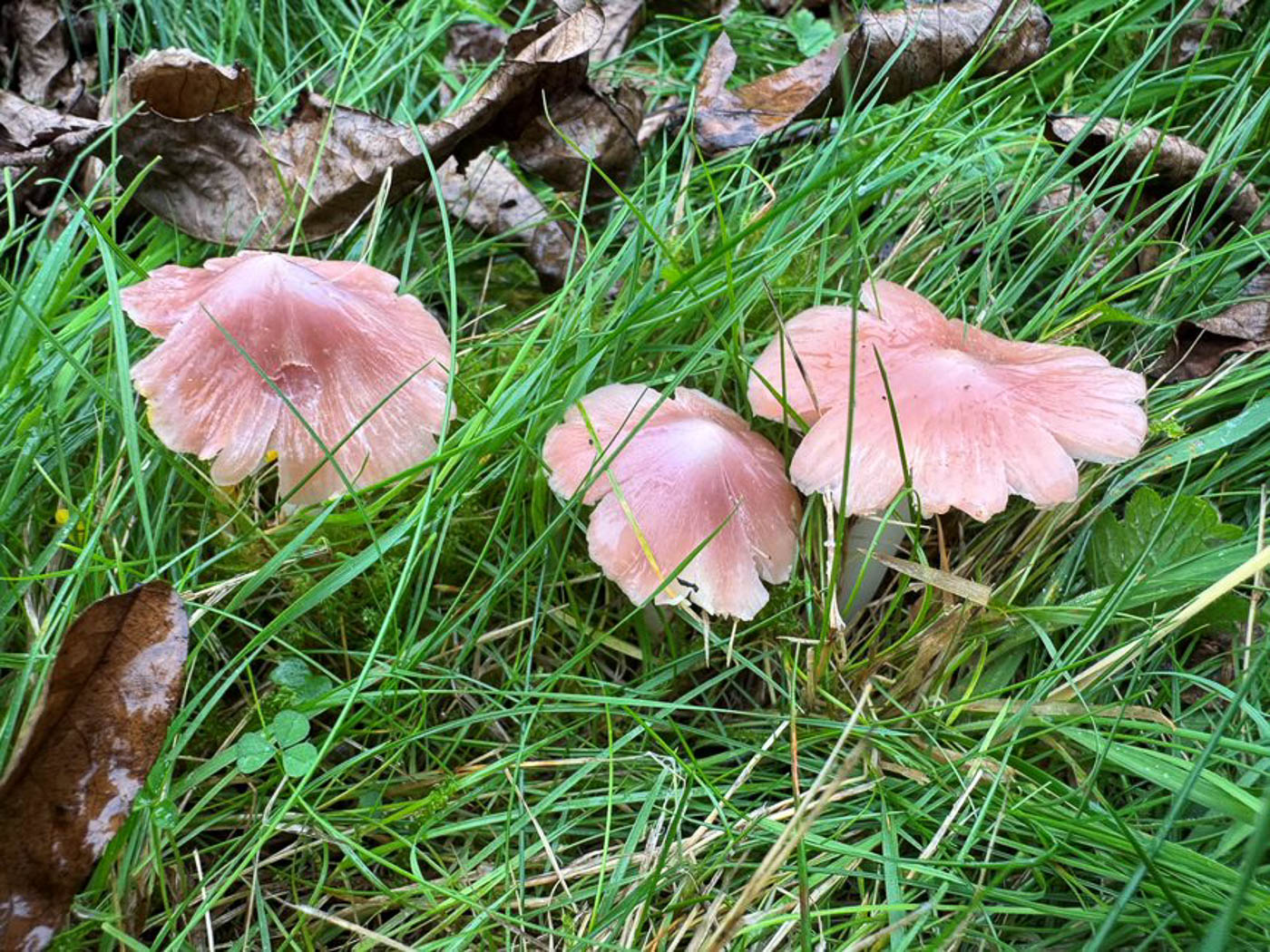
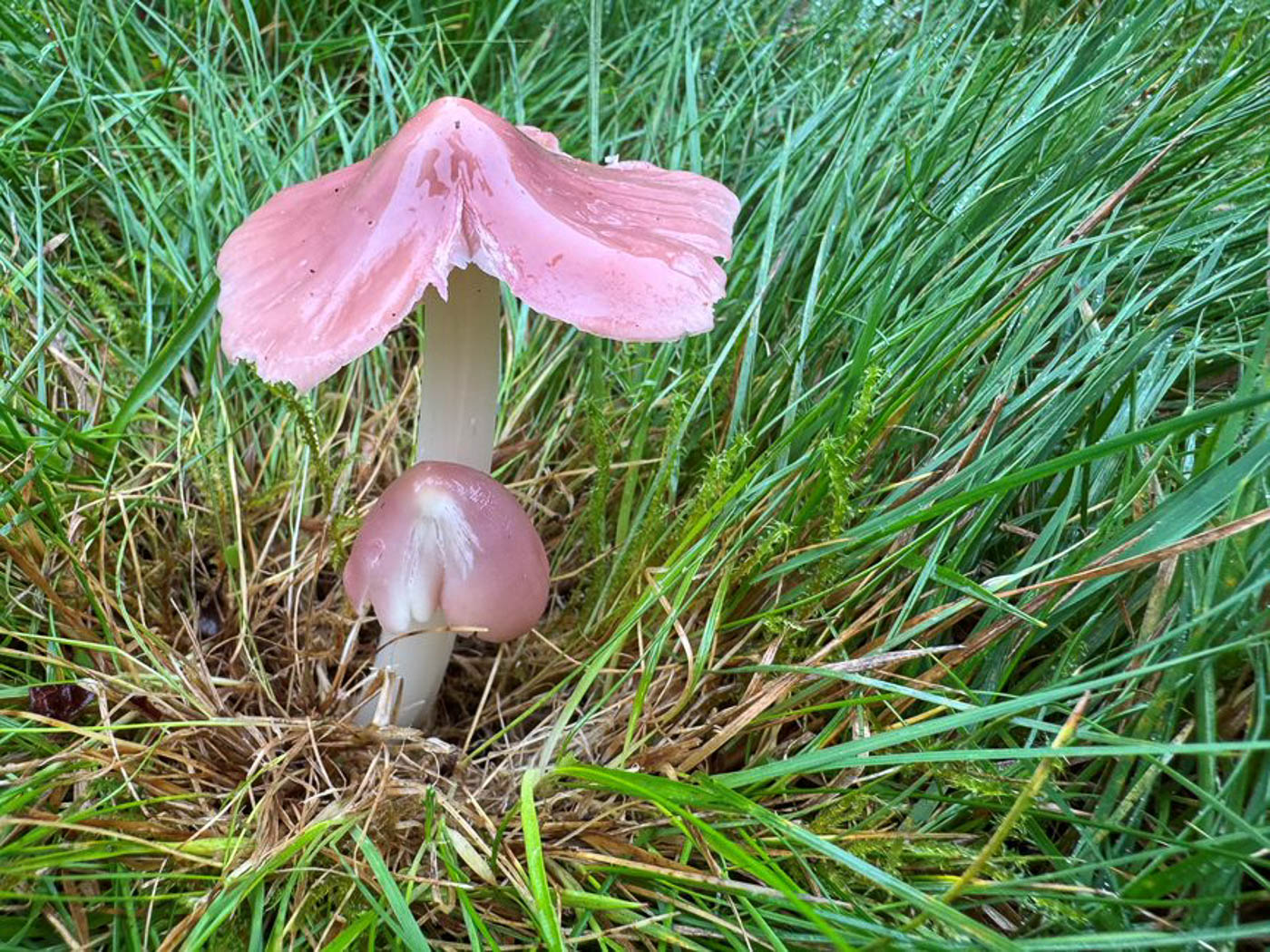 |
November 7th Porpolomopsis calyptriformis (Pink Waxcap / Ballerina Waxcap) At Stoke Poges Memorial Gardens our large group was hopeful of seeing this charismatic Waxcap and we were certainly not disappointed. This site is now one of the county's strongholds for the species and there were good numbers on display in its usual spot; we found it elsewhere in the lawns as well. The photos are Leigh McMahon's. Previous finds |
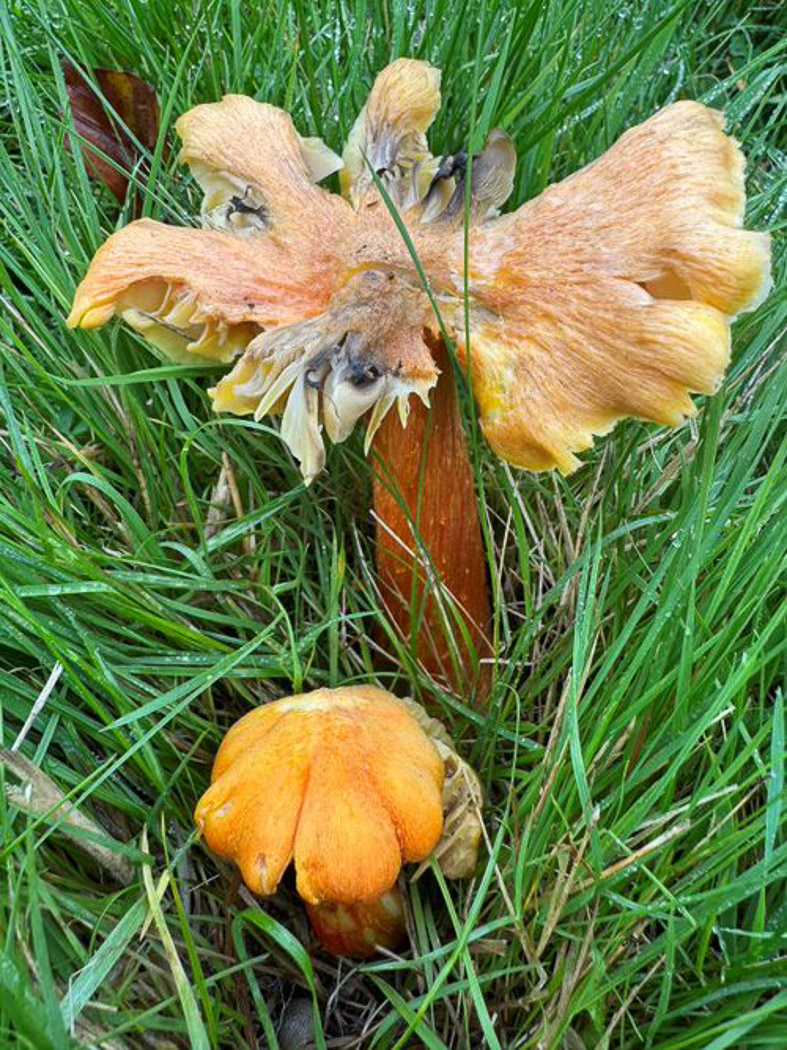 |
November 7th Hygrocybe intermedia (Fibrous Waxcap) At Stoke Poges Memorial Gardens our large group were particularly pleased to see this species, new to the site and quite a rarity. This is a large chunky dry waxcap with a conical streaky orange / yellow / reddish cap which tends to split and a concolorous thick fibrous stem and was one of 15 waxcaps seen here today, three of which were new to the site. We have only one or two known county sites with very few records but this year would be a good one to look out for it in likely grassy spots, being the best year for waxcaps for quite a time. The photo is Leigh McMahon's Previous finds |
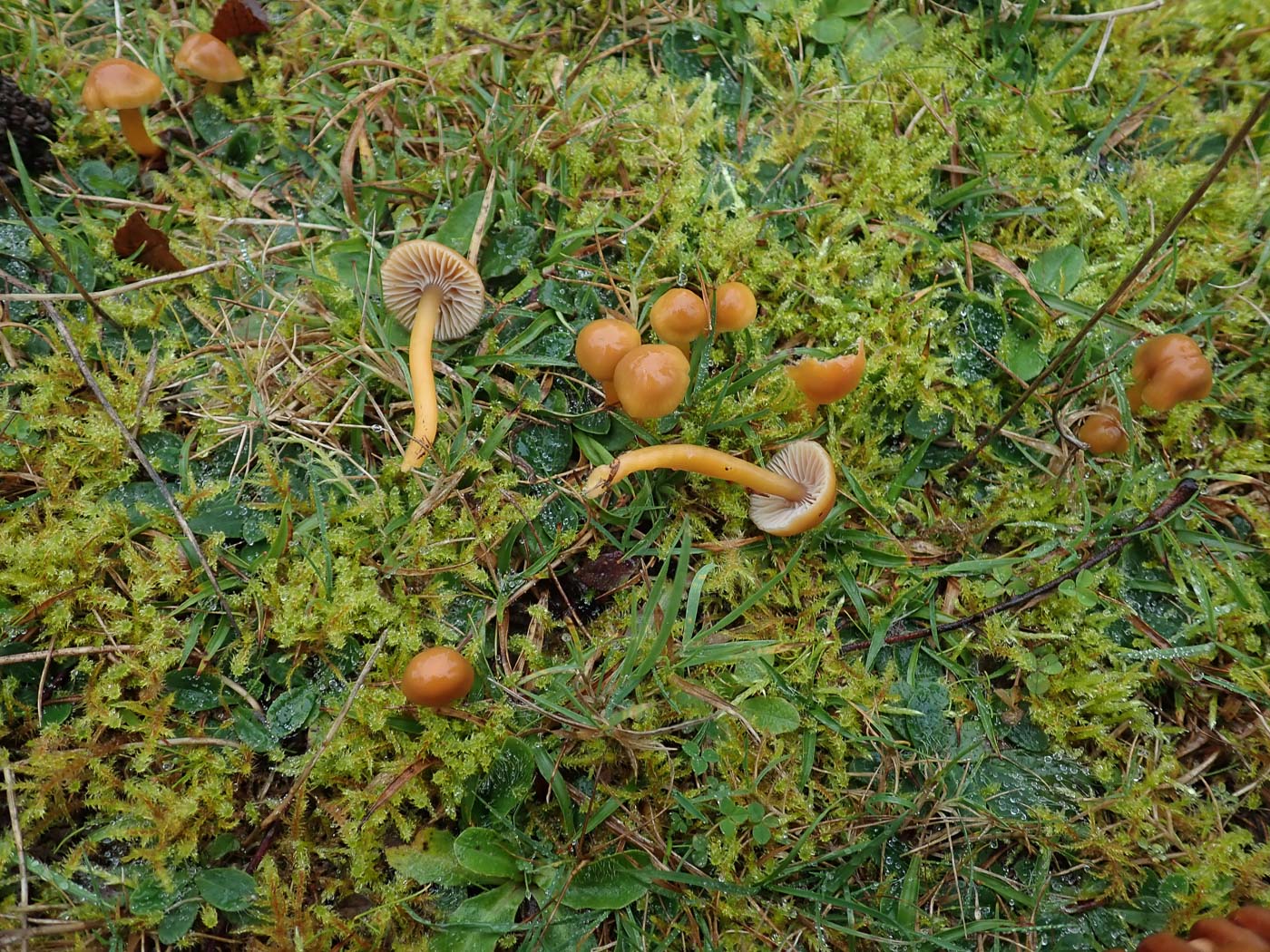
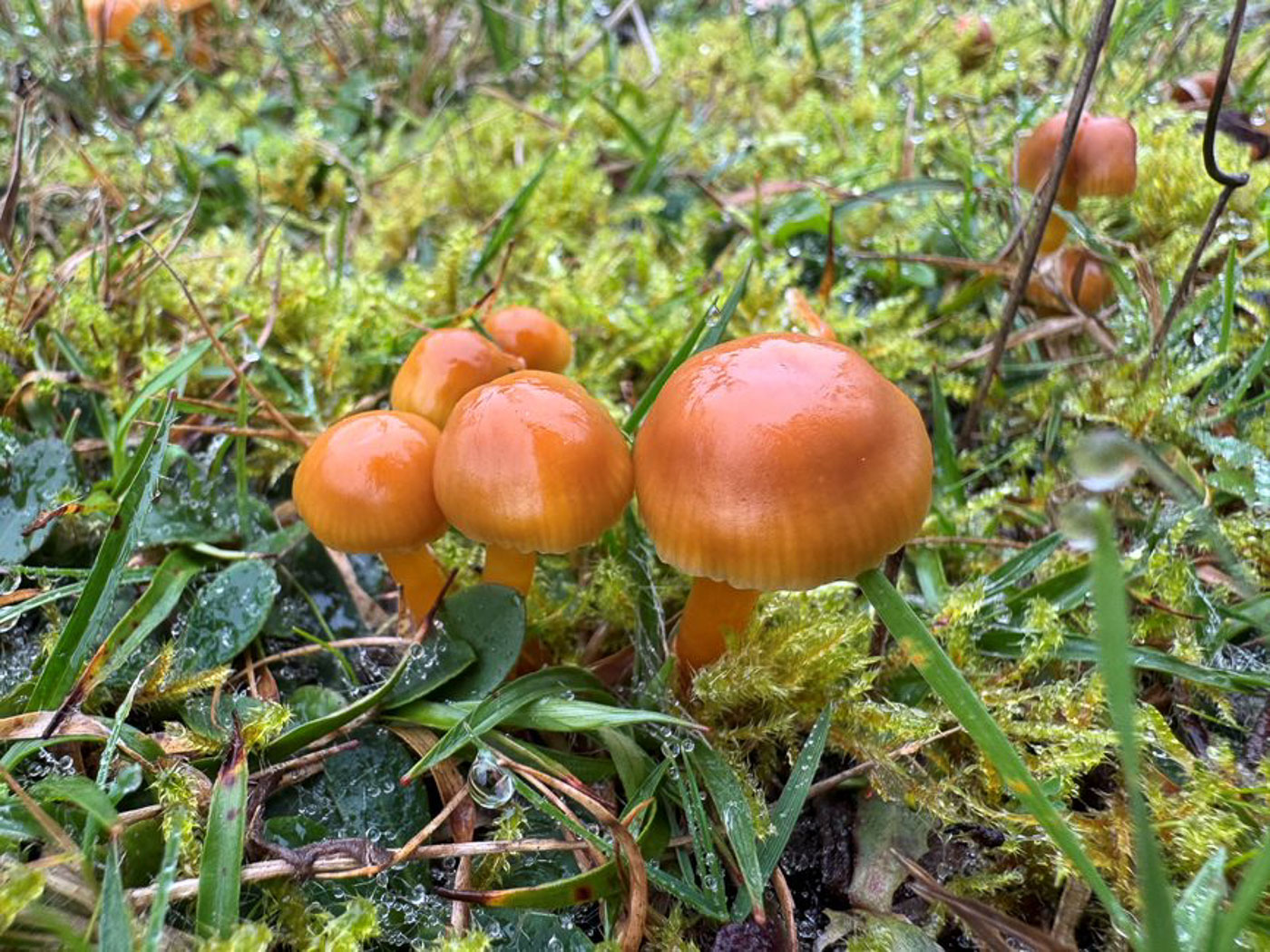 |
November 7th Gliophorus laetus (Heath Waxcap) At Stoke Poges Memorial Gardens our large group were pleased to see this species, new to the site, coming up in good numbers. Similar to G. psittacinus (Parrot Waxcap) which we also saw here today, it is slimy all over but lacks any green - even at the stem top - as in that species and also has a gelatinous coating on the gill edge which with care can be lifted away from the gill with a pin. (Sadly Penny didn't have a pin to hand!). The species is uncommon and though we have quite a few county records these are only from two or three other sites. Photo 1 is Penny's, photo 2 is Leguih McMahon's. Previous finds |
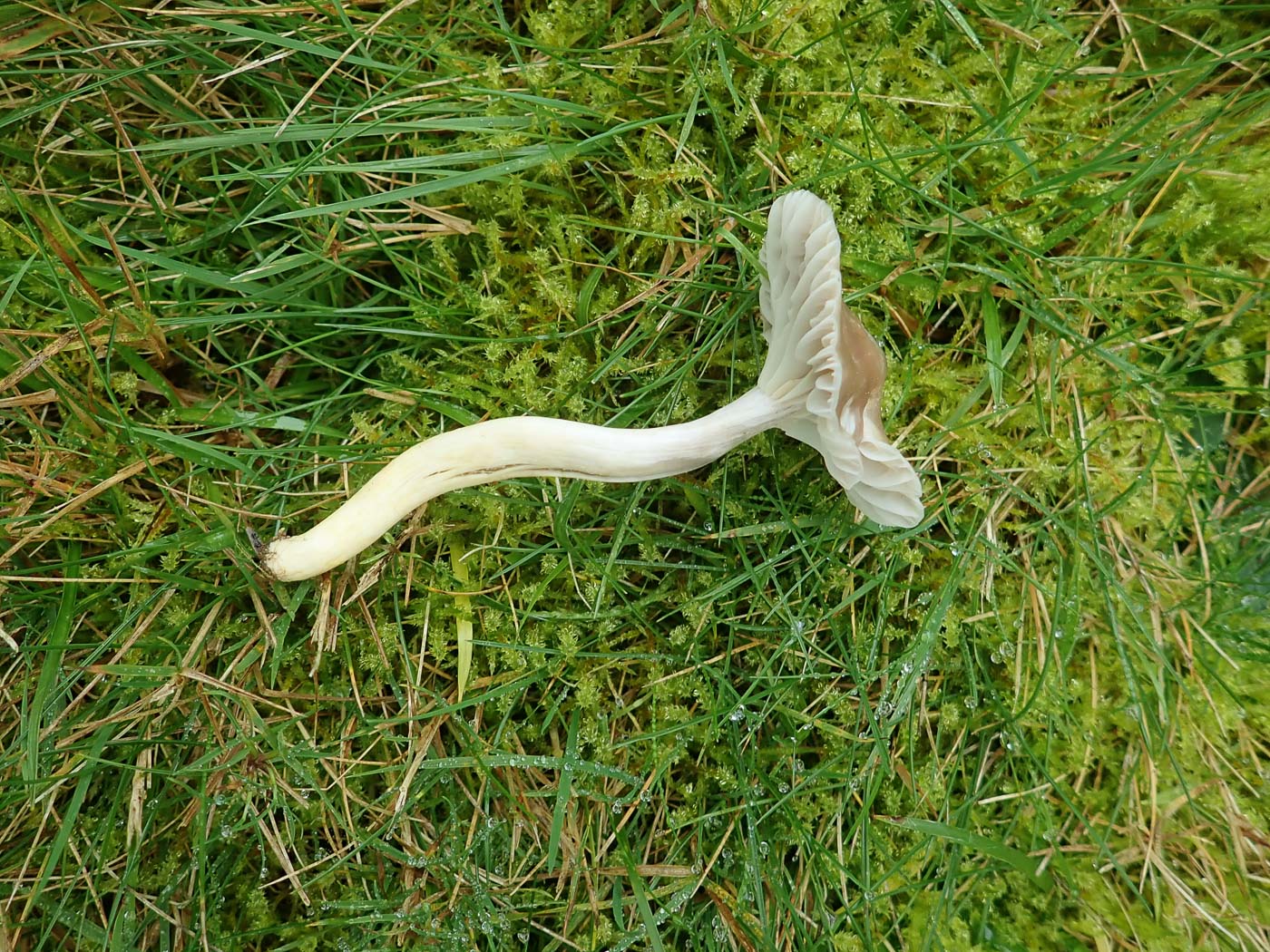
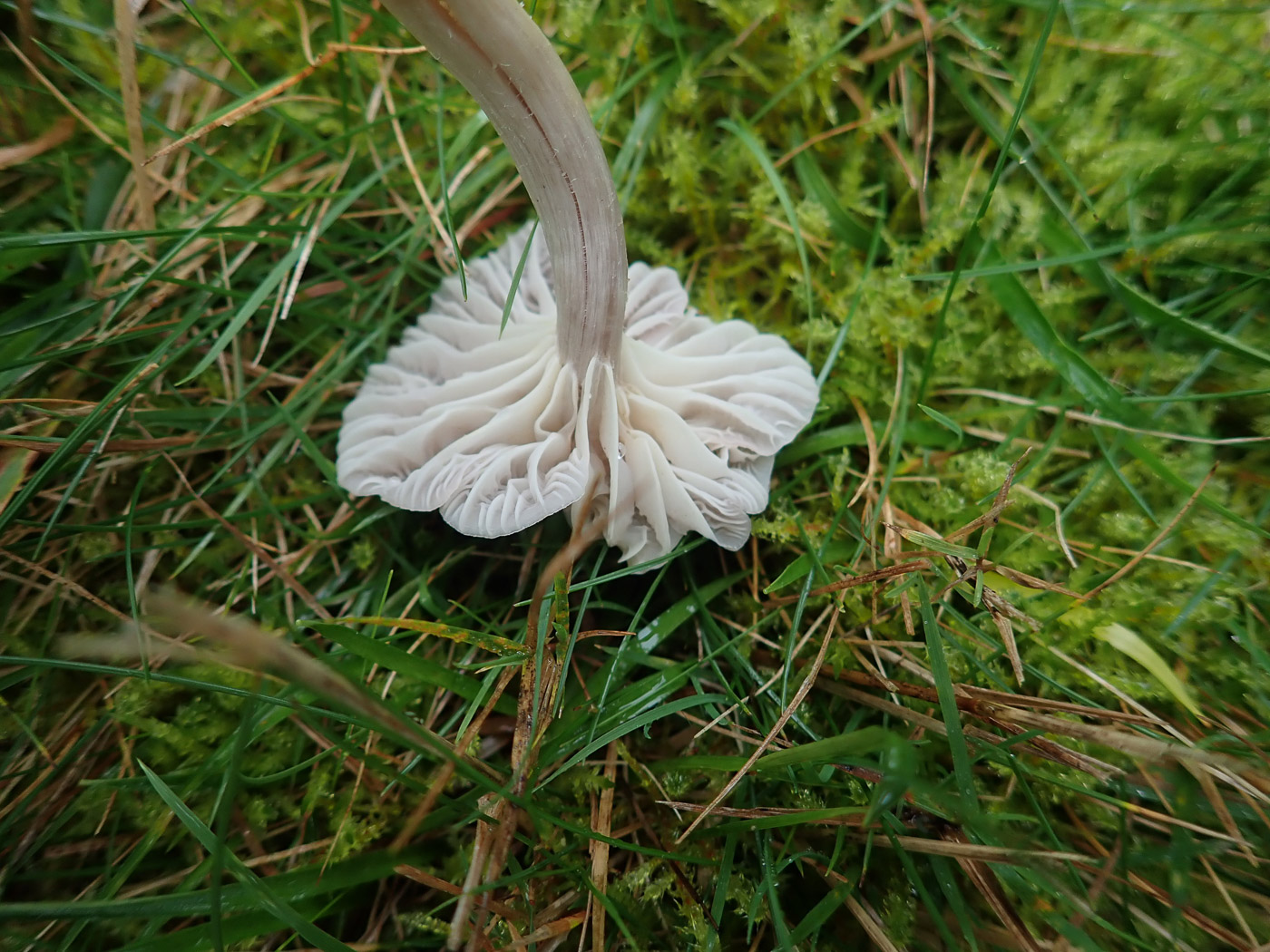 |
November 7th Cuphophyllus flavipes (Yellowfoot Waxcap) Amongst the 15 different waxcap species our large group were treated to at Stoke Poges Memorial Gardens this was one of the most unusual and was new to the site today though we found it last year in the adjacent St Giles Churchyard. It is one of the dry waxcaps now moved into genus Cuphophyllus and has a grey cap, white widely spaced gills and and a white stem which has a distinct hint of yellow towards the base. This was a nice find. The photos are Penny's. Previous finds |
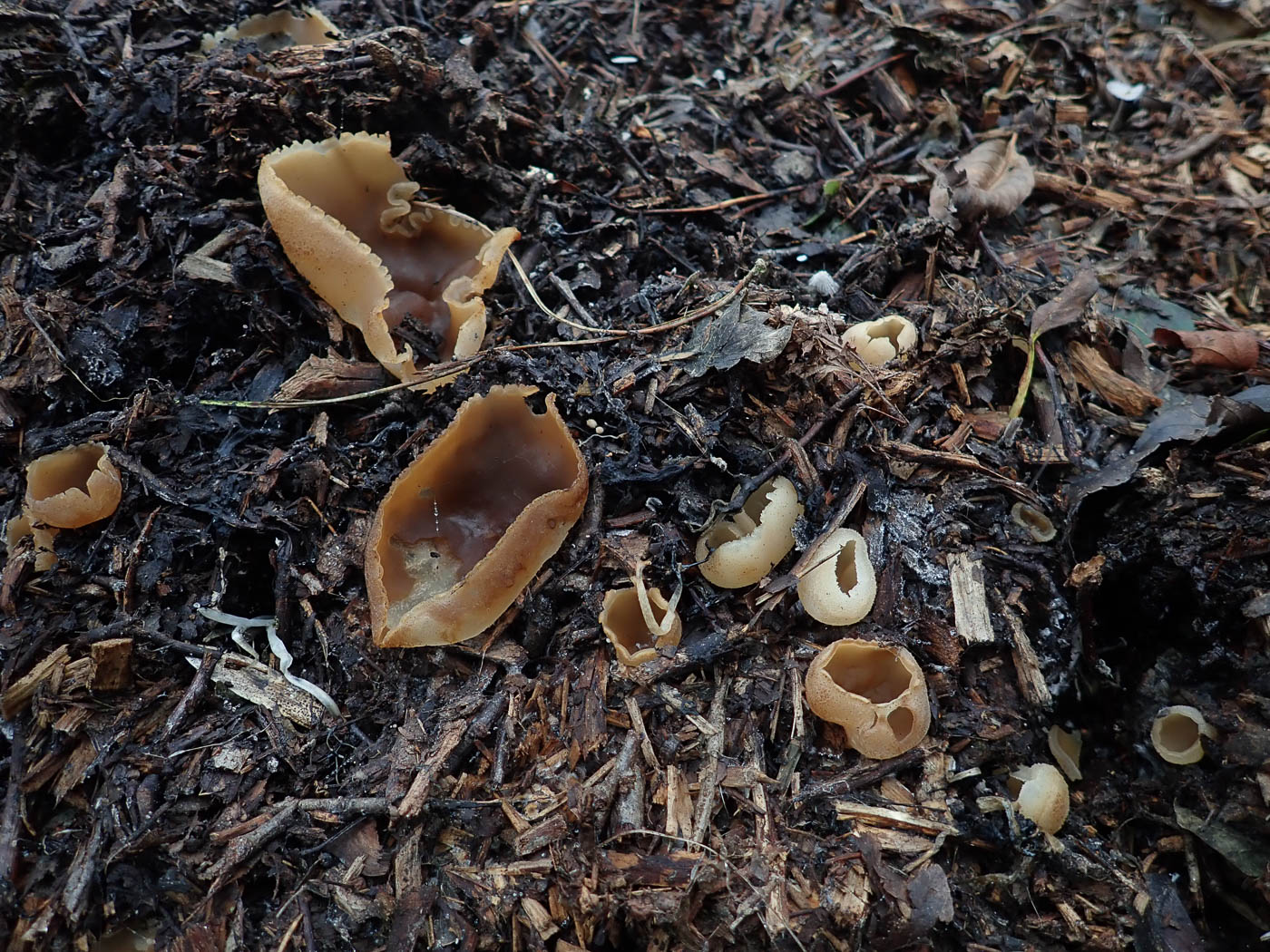 |
November 7th Peziza granulosa (a rare Peziza with no English name) On a large rotting heap of leaves and debris at Stoke Poges Memorial Gardens Barry Webb and Gill Ferguson found a range of species including this cup fungus which Penny suggested at first might possibly be a species of Tarzetta owing to its tightly rounded shape and pale colour when young with a slight fringed edge. However, a drop of Melzers reagent when examining under a scope turned the asci tips blue confirming it was in fact a species of Peziza. It keyed out convincingly to P. granulosa with large smooth spores and online images also showed its similarity to Tarzetta, confirming the ID. A sample will be dried for sequencing to confirm as we have only two previous county records. This is a new entry for Finds. The photo is Penny's. |
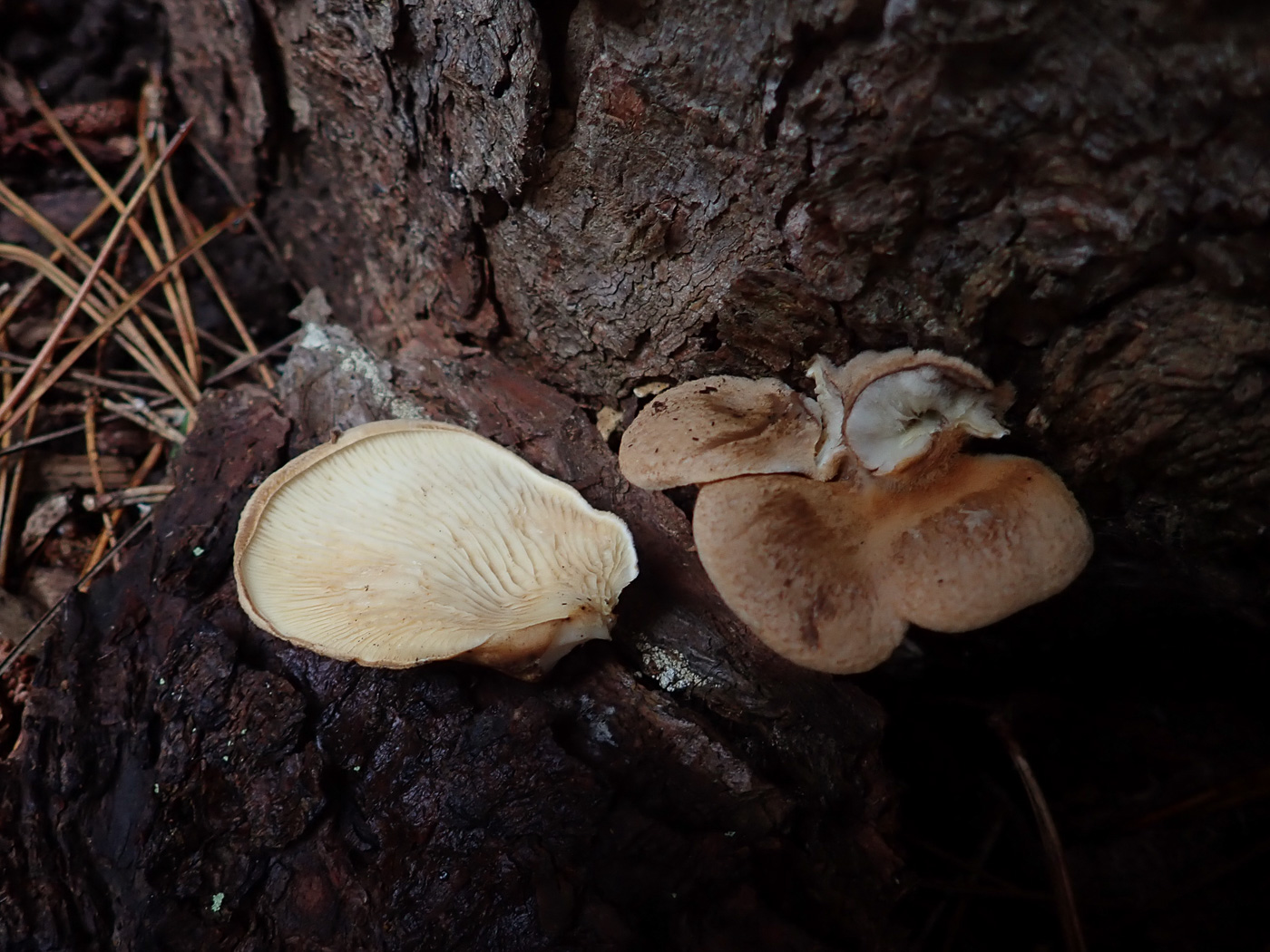
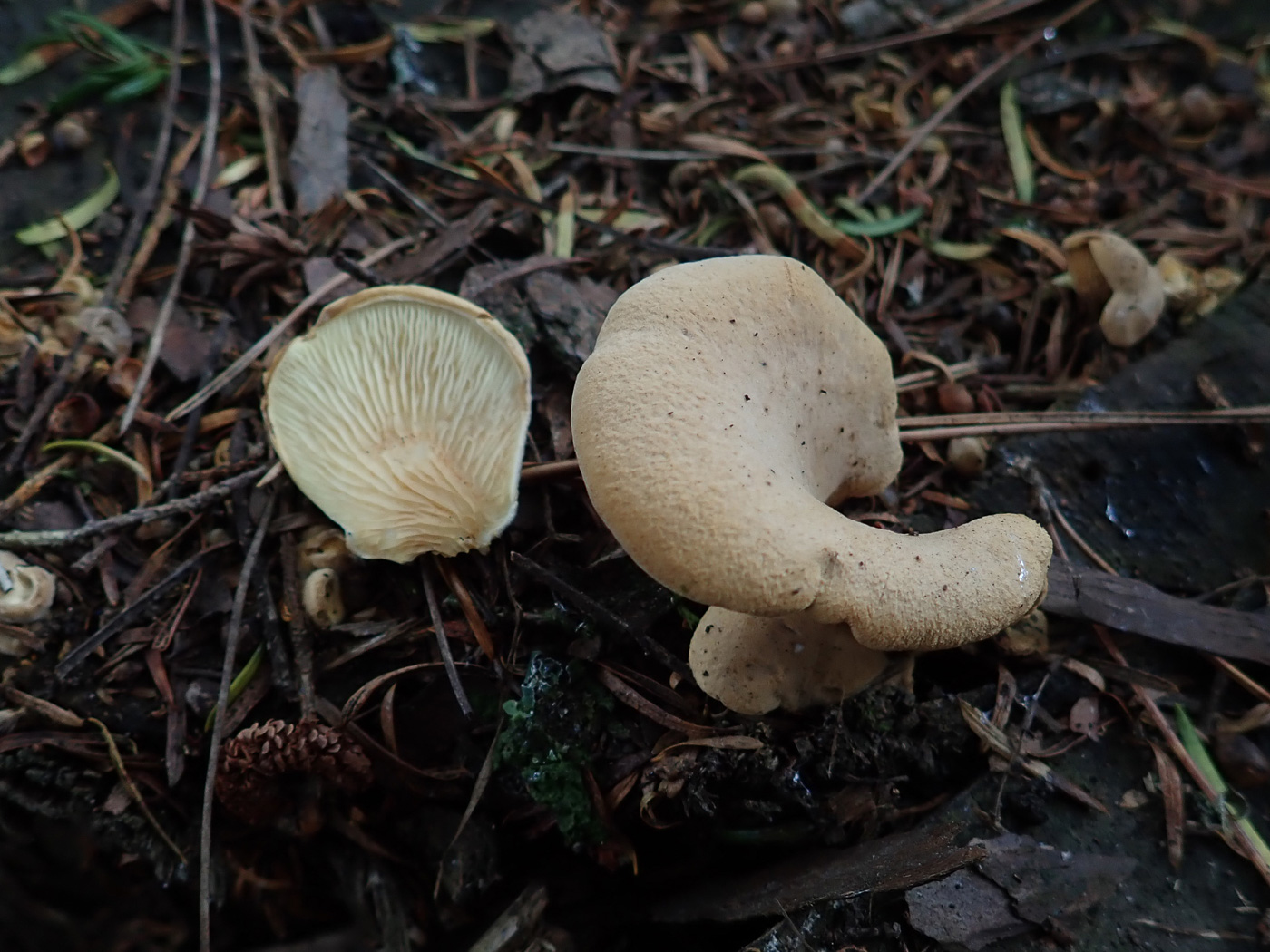 |
November 7th Tapinella panuoides (Oyster Rollrim) On some sawn off conifer stumps in Stoke Poges Memorial Gardens Penny spotted several small clusters of this quite unusual species, thought to be related to Paxillus (Rollrim) though in appearance rather similar to Pleurotus (Oyster) - hence its English name. It has a cap and gills with an orange peachy tinge and lacks a stem and favours fallen conifer wood. Previous finds |
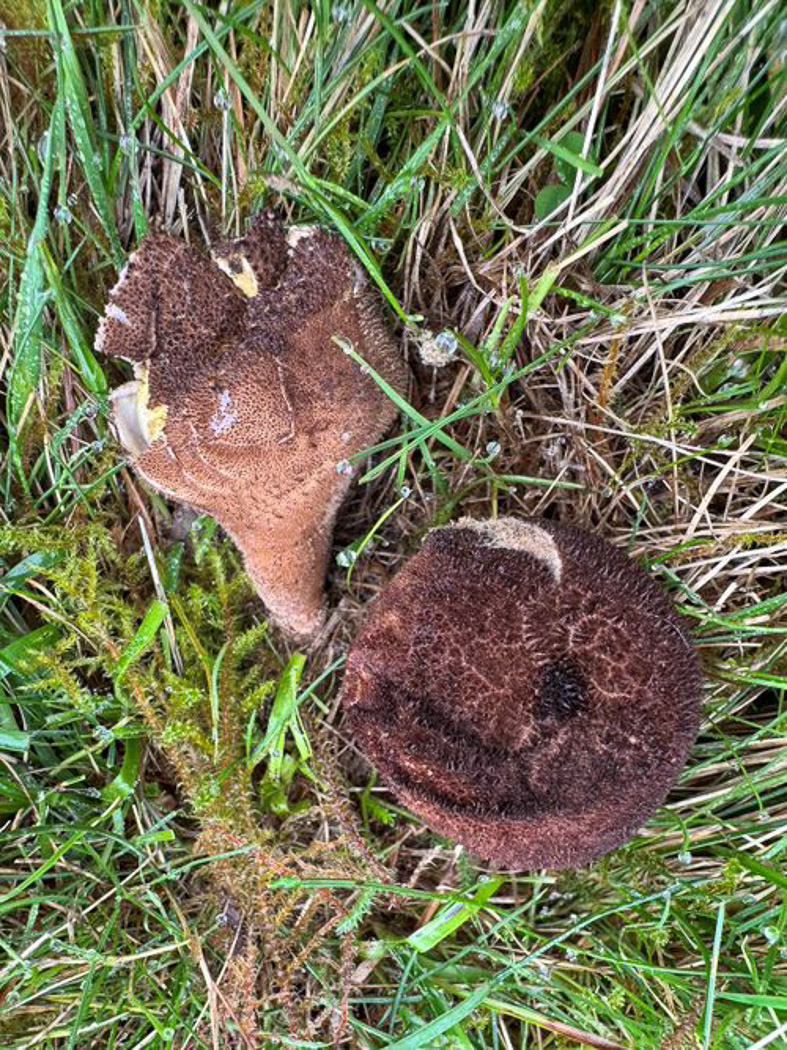 |
November 7th Lycoperdon nigrescens (Dusky Puffball) At Stoke Poges Memorial Gardens our large group found this very dark brown puffball in grass and questioned what species it might be. Later Penny checked the spores and also examined the spines on the surface which overlapped forming a pyramid, both features fitting with L. nigrescens which can sometimes be confused with other puffballs. The photo is Leigh McMahon's. Previous finds |
November 5th 2024
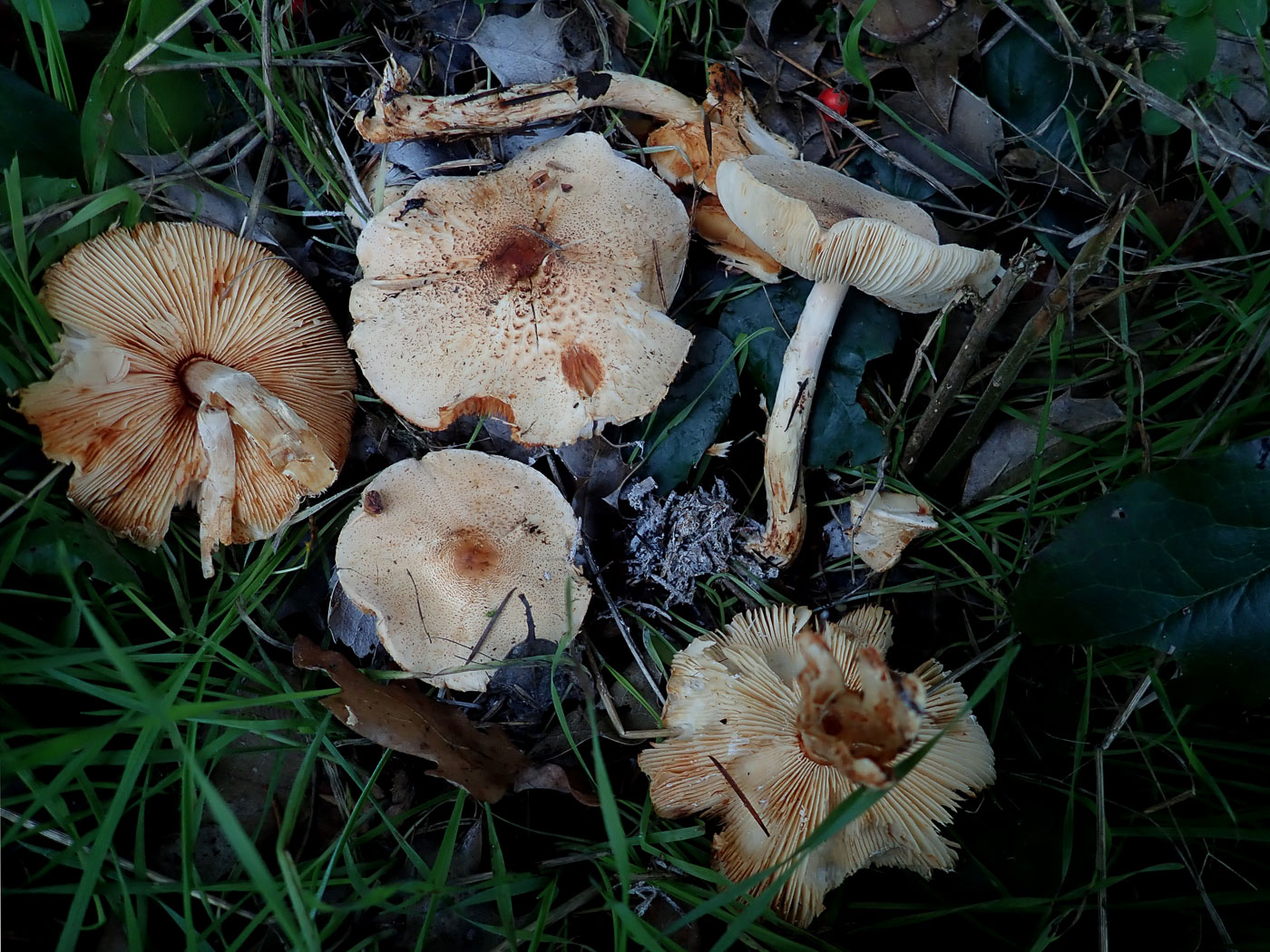
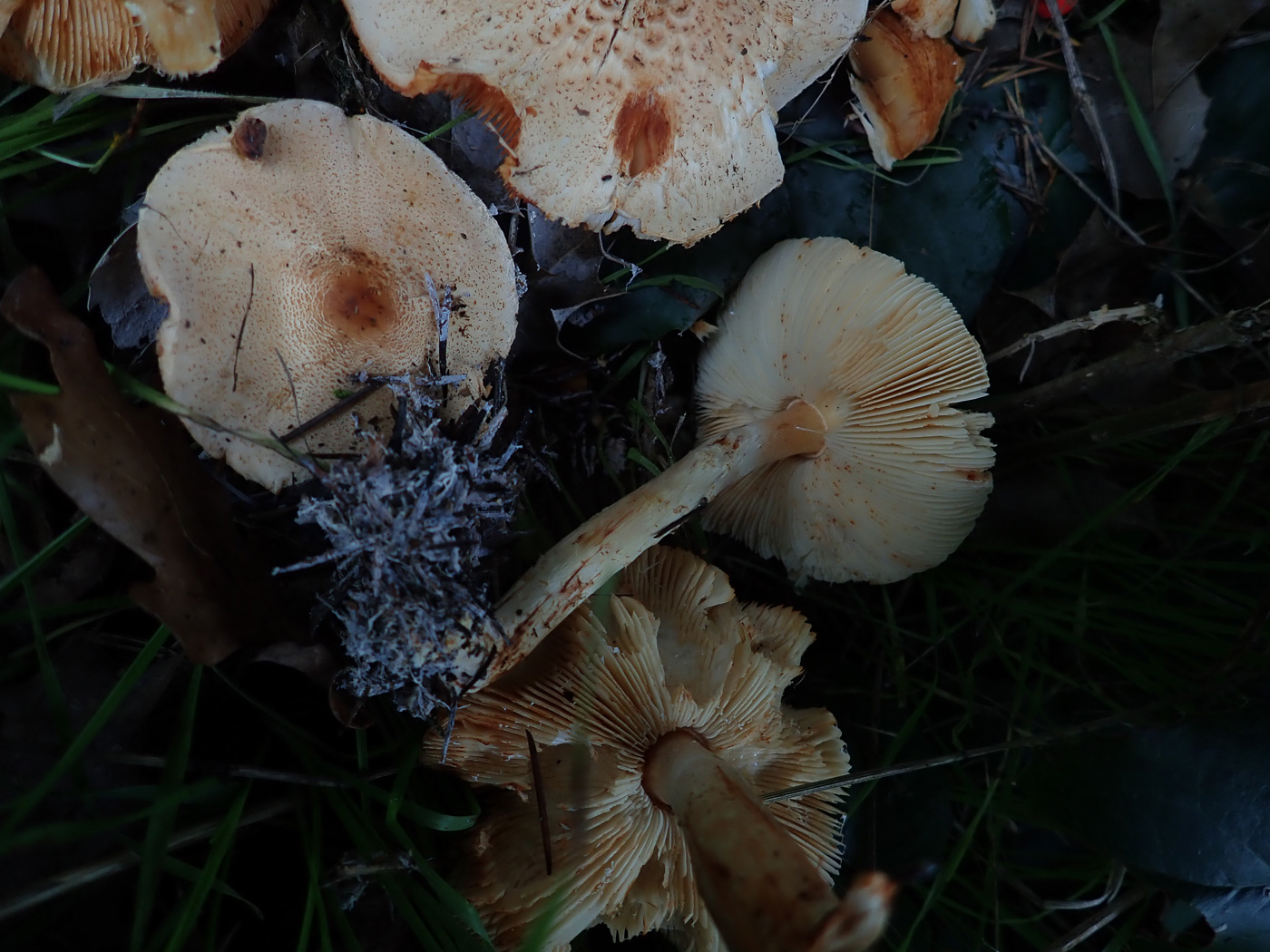 |
November 5th Lepiota ochraceofulva (A rare Dapperling with no English name) Just outside Prestwood Churchyard Penny and Sarah spotted first one cap amongst the grassy litter under a large Cedar, then several more. The caps were about 6-7 cm across with a dark rusty centre but pale pinkish beige and finely tomentose towards the margin. Turning one over revealed cream to orange free gills, this colour also on the stem which was clearly orange-reddening where damaged. At first Penny was convinced this was a species of Leucoagaricus but it failed to key out satisfactorily in this genus, and Sarah, who'd also taken a specimen to work on, then suggested Lepiota ochraceofulva which fitted much better. This was a species which had also been found recently at Penn Churchyard and was new to the county in 2021 when found by Jesper Launder also under conifer. It appears to have an affinity with Cedar which also helped to confirm today's collection which will be dried for sequencing. The photos are Penny's. Previous finds |

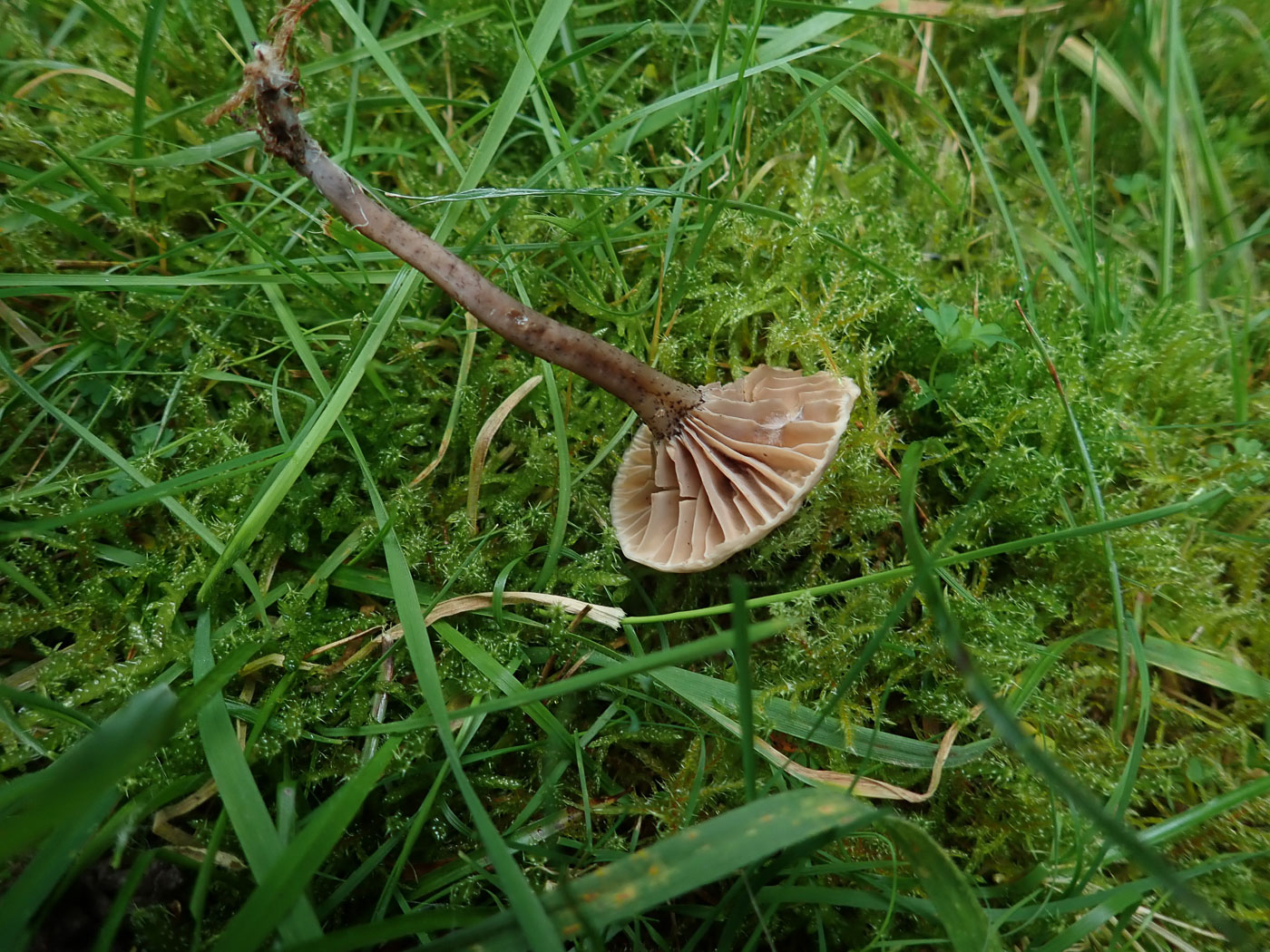
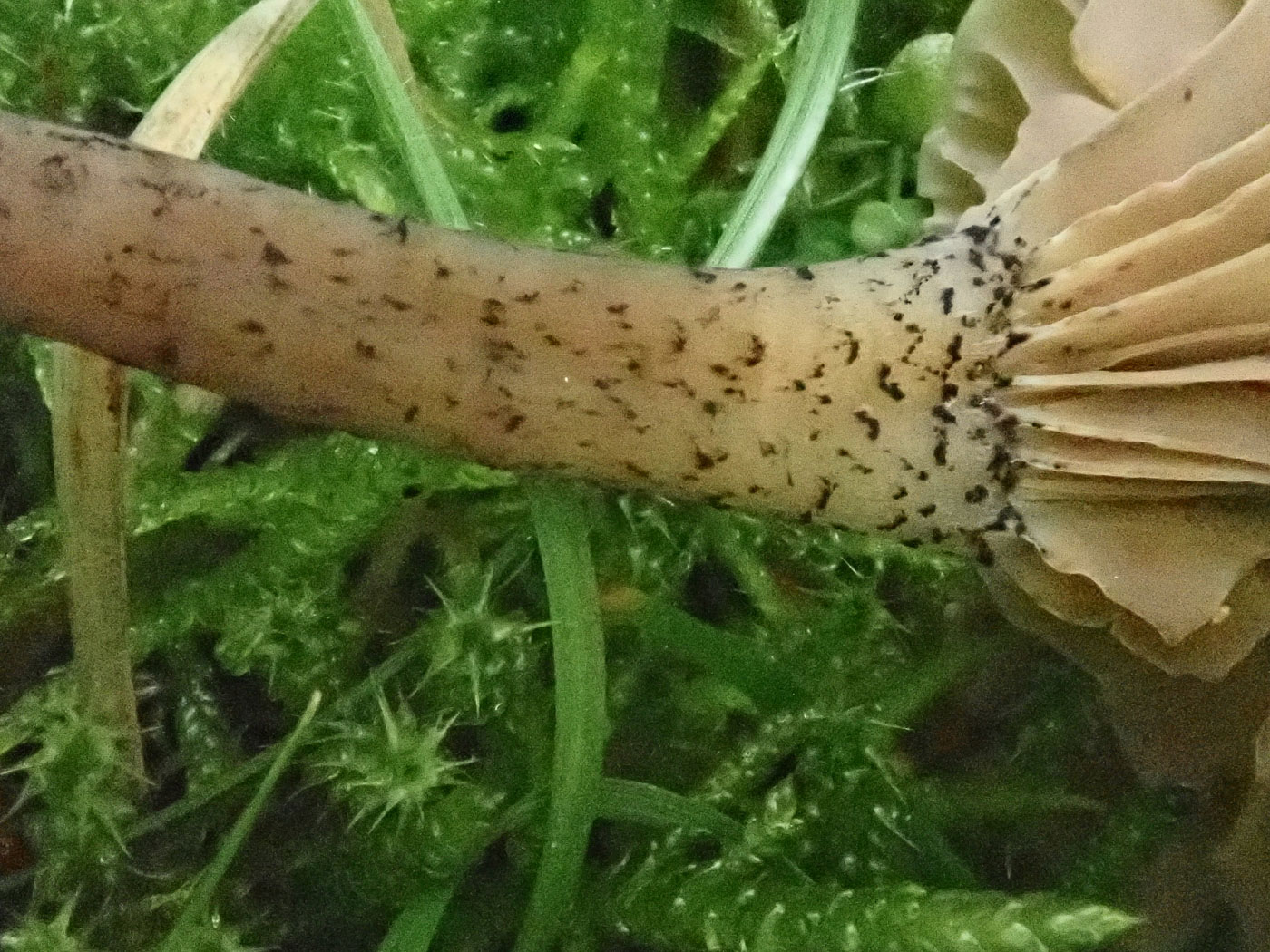 |
November 5th Hodophilus cf. variabilipes (a rare species of Fanvault with no English name) Under a large Yew at Prestwood Churchyard Penny and Sarah spotted this singleton amongst the mossy grass. The cap was unfamiliar to them both and it was not until picked that the strongly decurrent and widely spaced gills together with black markings on the stem became apparent. They wondered at the time about the genus Arrhenia but later both guessed at the genus Hodophilus which the microscopic features seemed to fit. However, there are two very similar species which can have these black spots on the stem, both rare, and without access to more detailed descriptions they cannot be sure if this is the species suggested here or maybe H. atropunctus (Dotted Fanvault). Hopefully sequencing will remove the doubt. The photos are Penny's. |

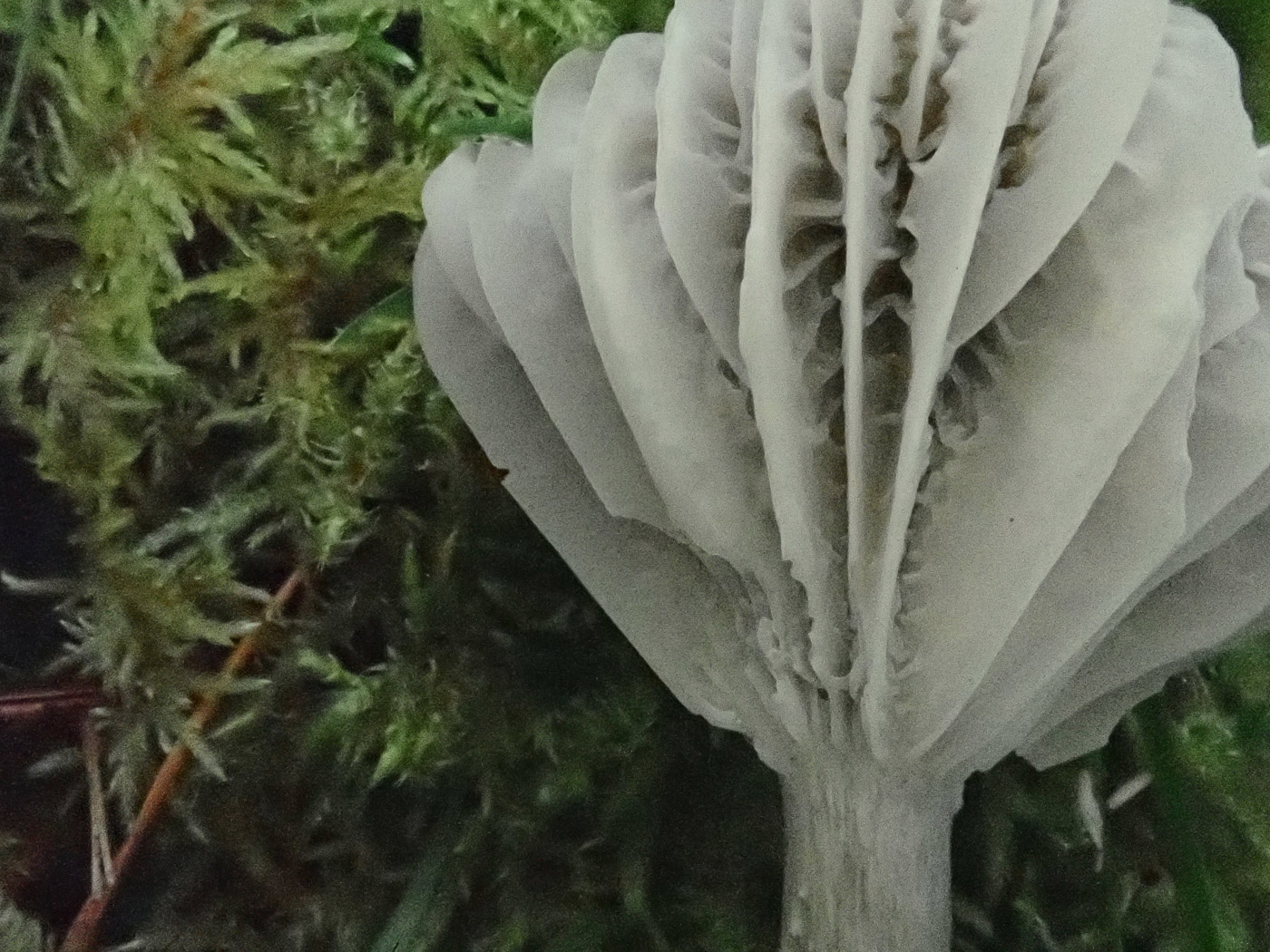 |
November 5th Cuphophyllus canescens (a rare waxcap with no English name) At Prestwood Churchyard Penny and Sarah found a couple of these pale grey waxcaps which they intantly knew was something un familiar and probably special. The widely spaced and upturned gills were remarkably interveined and unlike the unusual C. flavipes (Yellowfoot Waxcap - also grey and rare) it lacked any sign of yellow at the stem base. At home Penny found remarkably small subglobose spores, similar in shape to those of the common C. pratensis (Meadow Waxcap and also present here today) and this together with the notable gills and colour confirmed the ID. This is new to the county and appears to have only one previous UK record which seem extraordinary. So yet another exciting find for this special site with a growing list of interesting species. A sample will be sequenced. The photos are Penny's. |
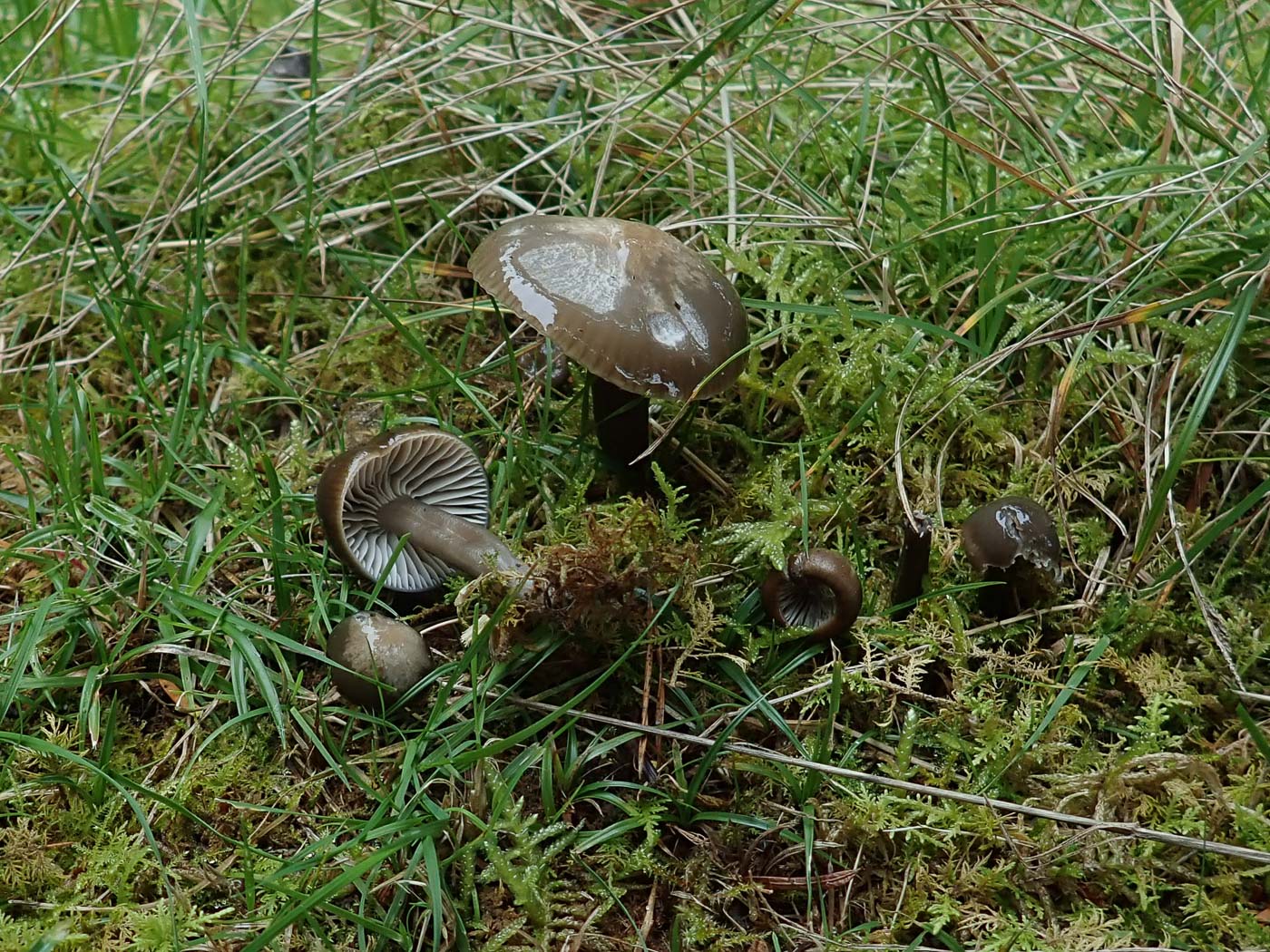 |
November 5th Gliophorus irrigatus ((Slimy Waxcap) At Prestwood Churchyard Penny and Sarah found several patches where this extremely slippery species was coming up. It may be dull grey brown in colour but what it lacks in brightness it makes up for in sliminess, proving difficult to collect as even the stem resists on gripping it! All the waxcaps now residing in this genus have slimy caps and stems but this one really deserves its English name. Previous finds |
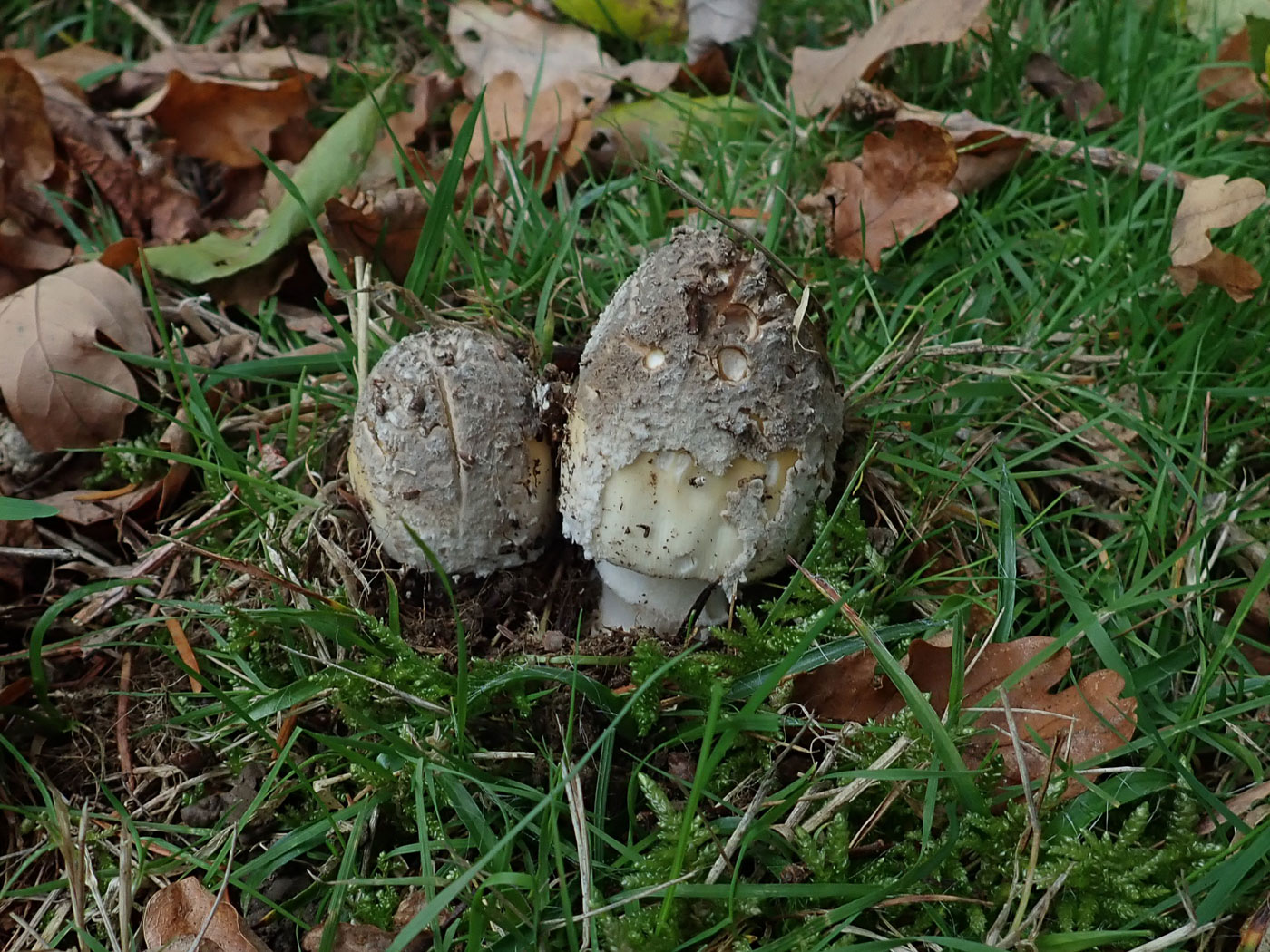 |
November 5th Amanita ceciliae (Snakeskin Grisette) This species was a surprise for Penny and Sarah when visiting Prestwood Churchyard in search of grassland species. It was in longish grass under Oak and though still at the 'button' stage was recognisable from the distinctly dingy grey thick veil remnants with the yellowish cap colour just showing through. It was new to this well recorded and special site and like many mycorrhizal genera Amanita has made a poor showing this autumn, this bieng one of the less common species. Previous finds |
November 4th 2024
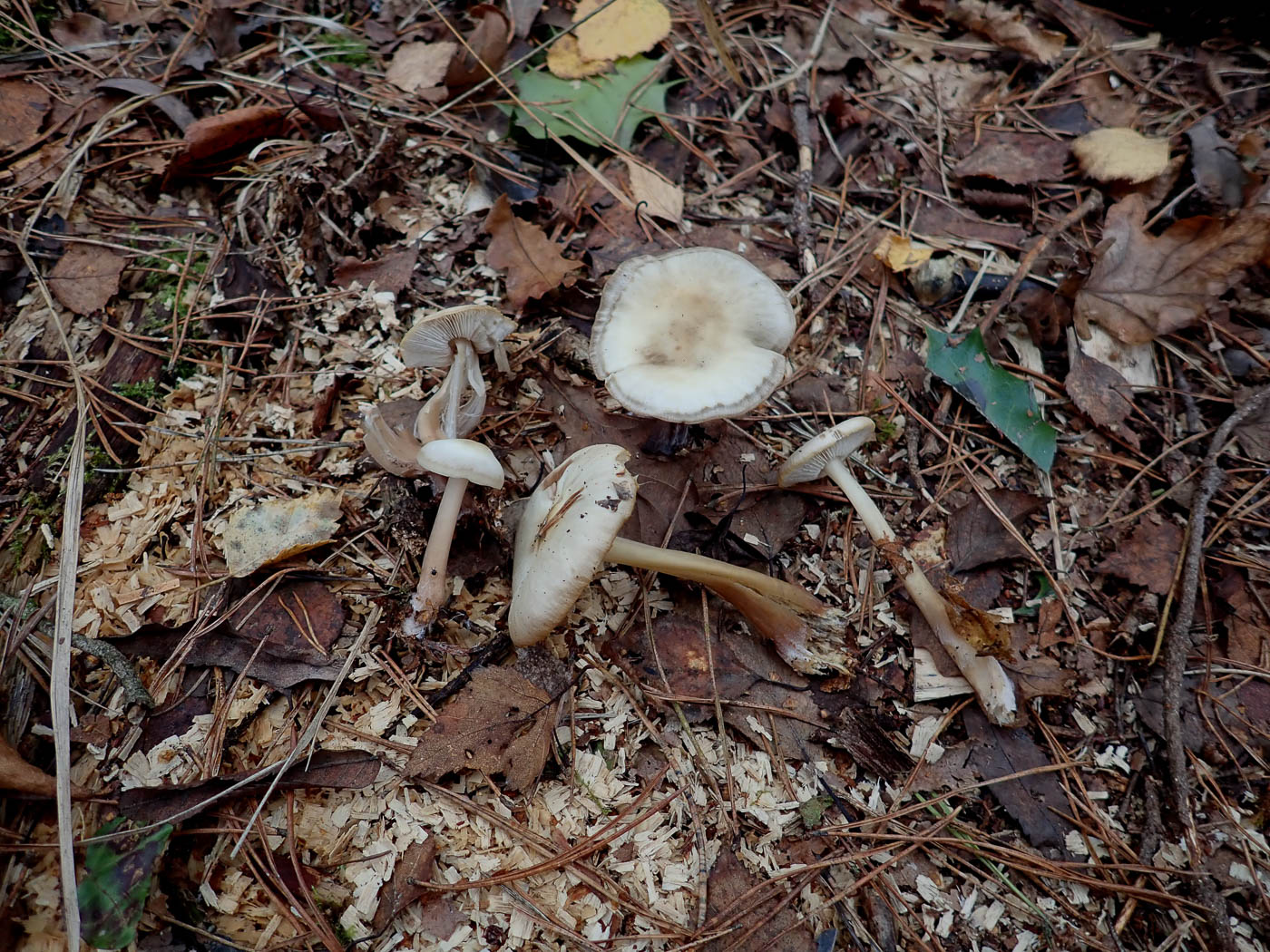 |
November 4th Rhodocollybia asema (Pale Butter Cap) In Burnham Beeches under mixed trees Penny found a patch of very pale capped Butter Caps, and having just learnt from Geoffrey Kibby that though previously considered just a pale variety of R. butyracea, this var. asema has apparently now been raised to specific status. So in effect this is a new species name for the county but will not count as such because we've been well aware of the wide variety of cap colour in specimens for some time. There will no doubt be intermediates found which are tricky to decide which name to apply, but for now this pale collection seem to fit the bill as R. asema. Previous entries for R. butyracea certainly include one other which should now be moved to R. asema in due course. |
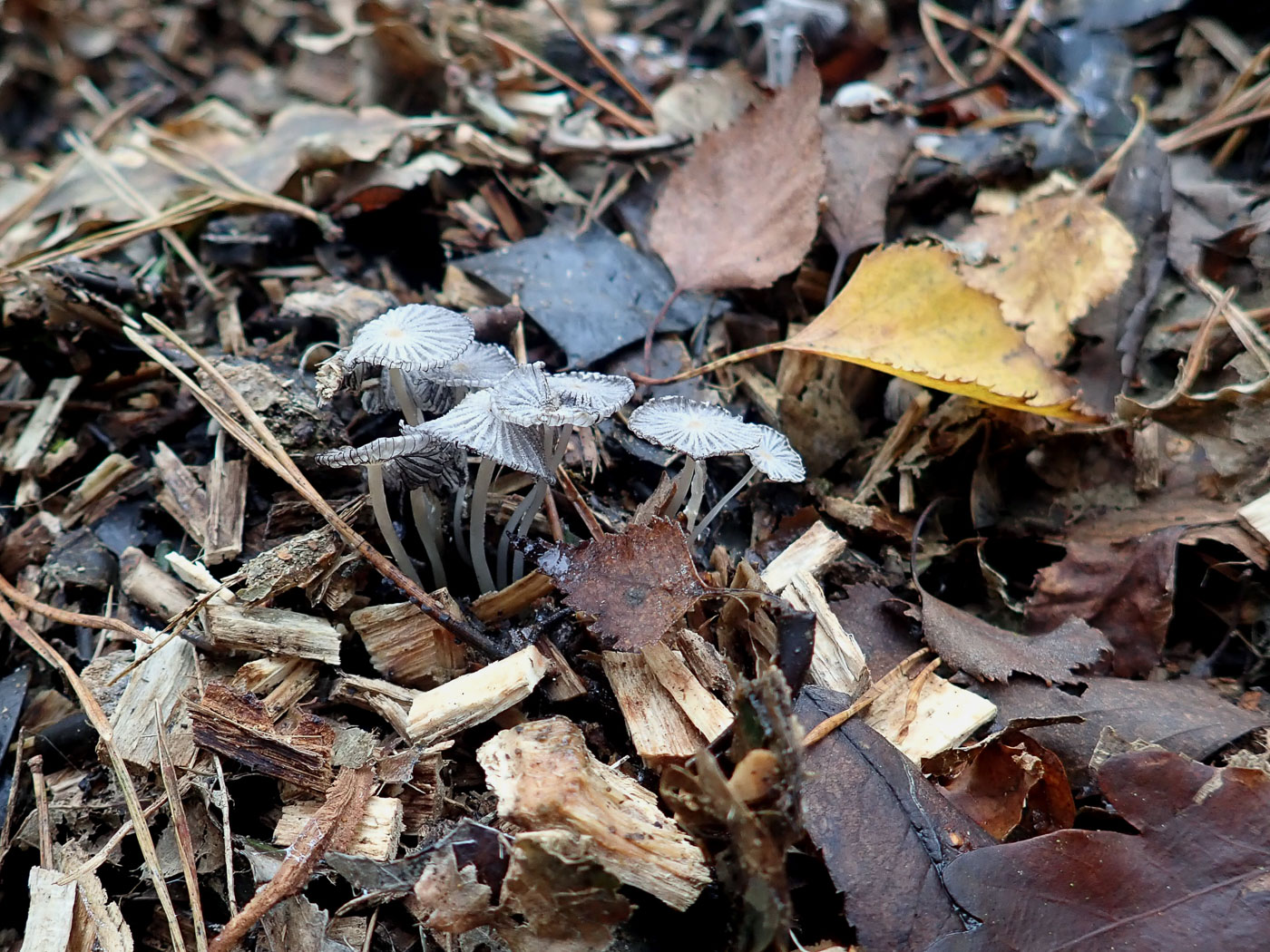
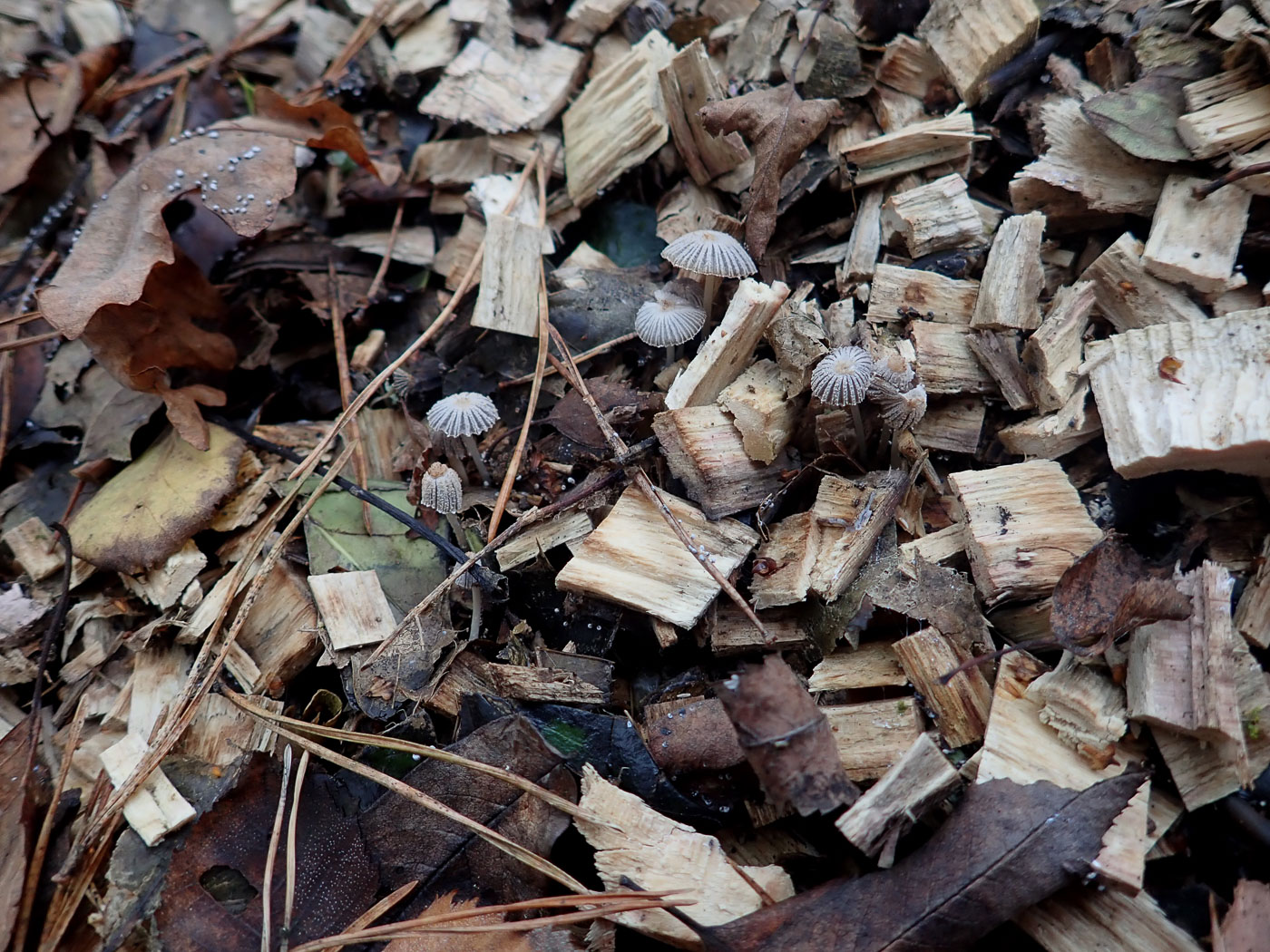
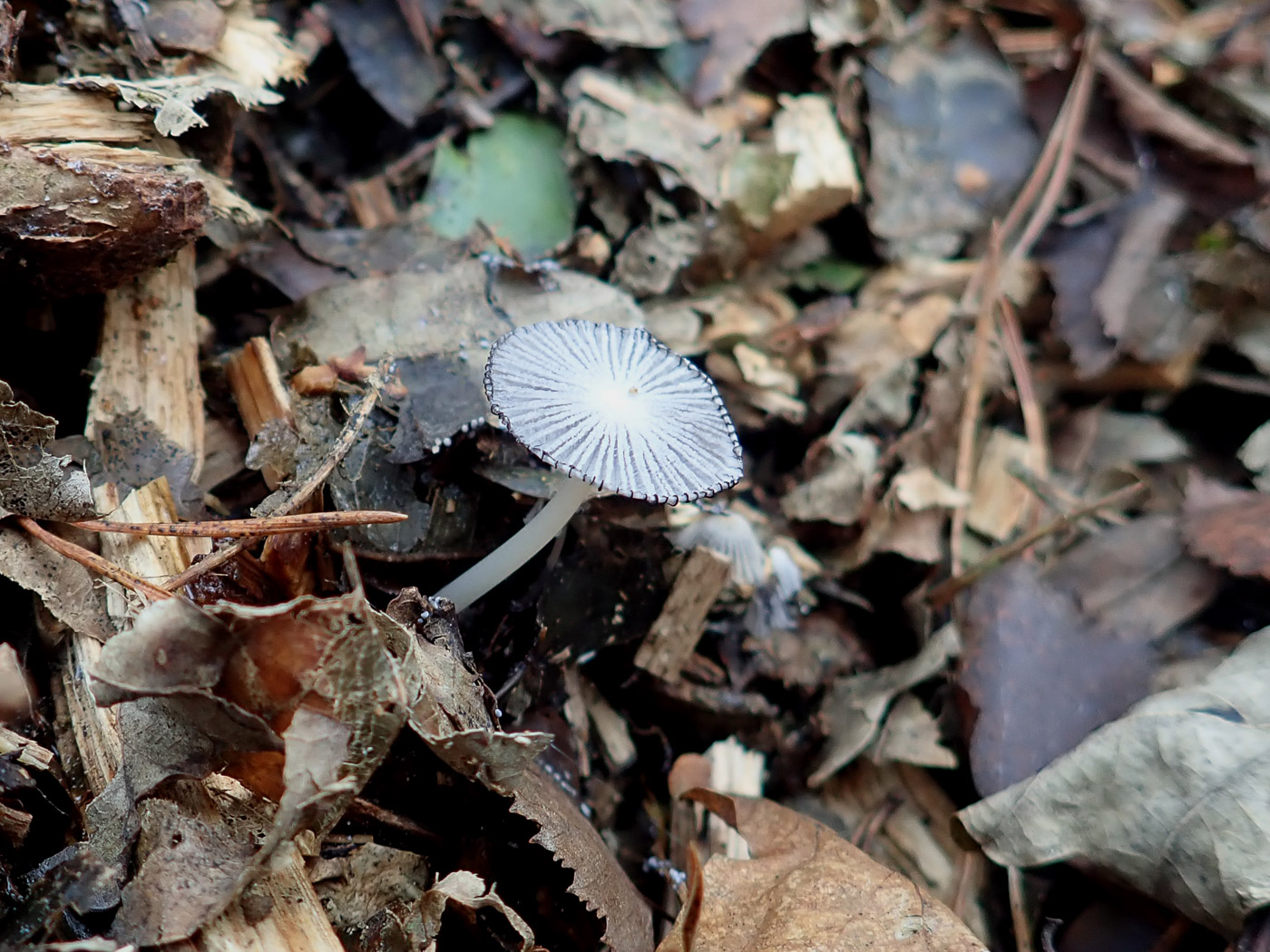
 |
November 4th Narcissea patouillardii (Composting Inkcap) On a large heap comprising woodchip mixed with fallen leaves at Burnham Beeches Penny checked to see if anything was emerging. The heap was just beginning to heat up and sure enough she was rewarded with a nice display of Inkcaps in various stages of development. Taking them home to work on she found the spore size and shape pointed to this not uncommon species (previously in genus Coprinopsis) and the veil cells and other characteristics seemed to confirm it. However, a sample is dried for Derek to check as we appear to have very few county records and this is a new entry for Finds. |
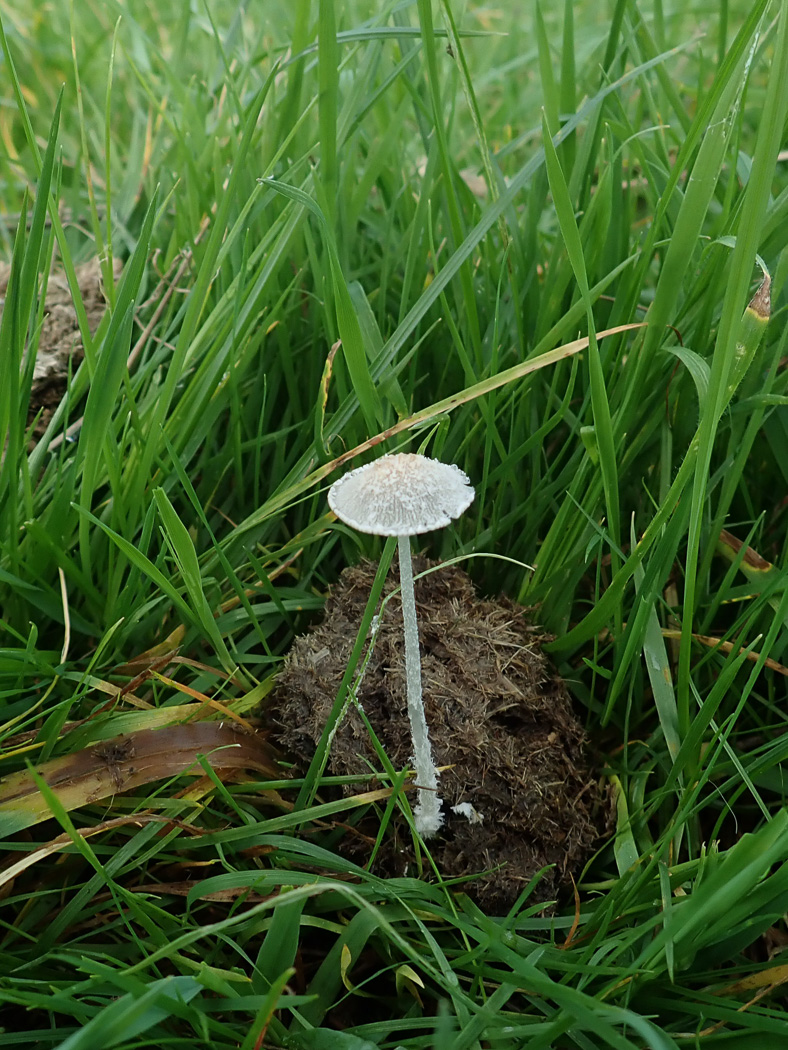 |
November 4th Coprinopsis pseudonivea (Aromatic Inkcap) In grassland at Burnham Beeches Penny noticed this species on some pony dung and recognised it from its thick whitish veil but with a pink tinge particularly in the centre. There are two medium sized very similar Inkcaps found on dung, the commonest being the pure white C. nivea (Snowy Inkcap), but in recent years this more unusual species having a pinkish cap has been becoming much more prevalent (or maybe we're more aware of its existence now?). Certainly at the Beeches it seems to be commoner of the two species. Previous finds |
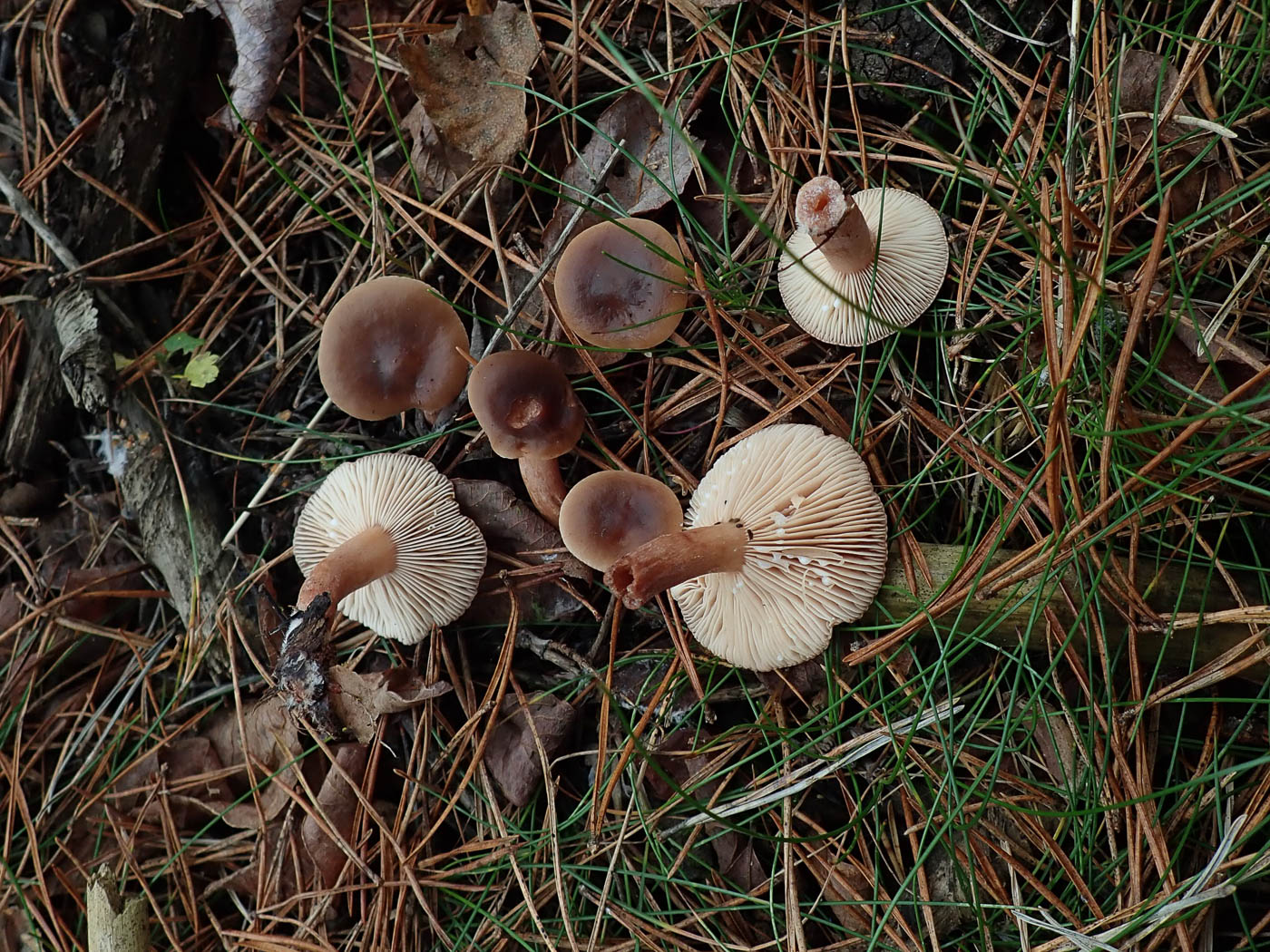 |
November 4th Lactarius hepaticus (Liver Milkcap) Under Pine at Burnham Beeches Penny found quite a few of these Milkcaps which only occur under this tree species. The English name refers to the liver-coloured cap and stem, and it has a smell similar to that of L. quietus and copious white milk which turns yellowish on a hankie. Previous finds |
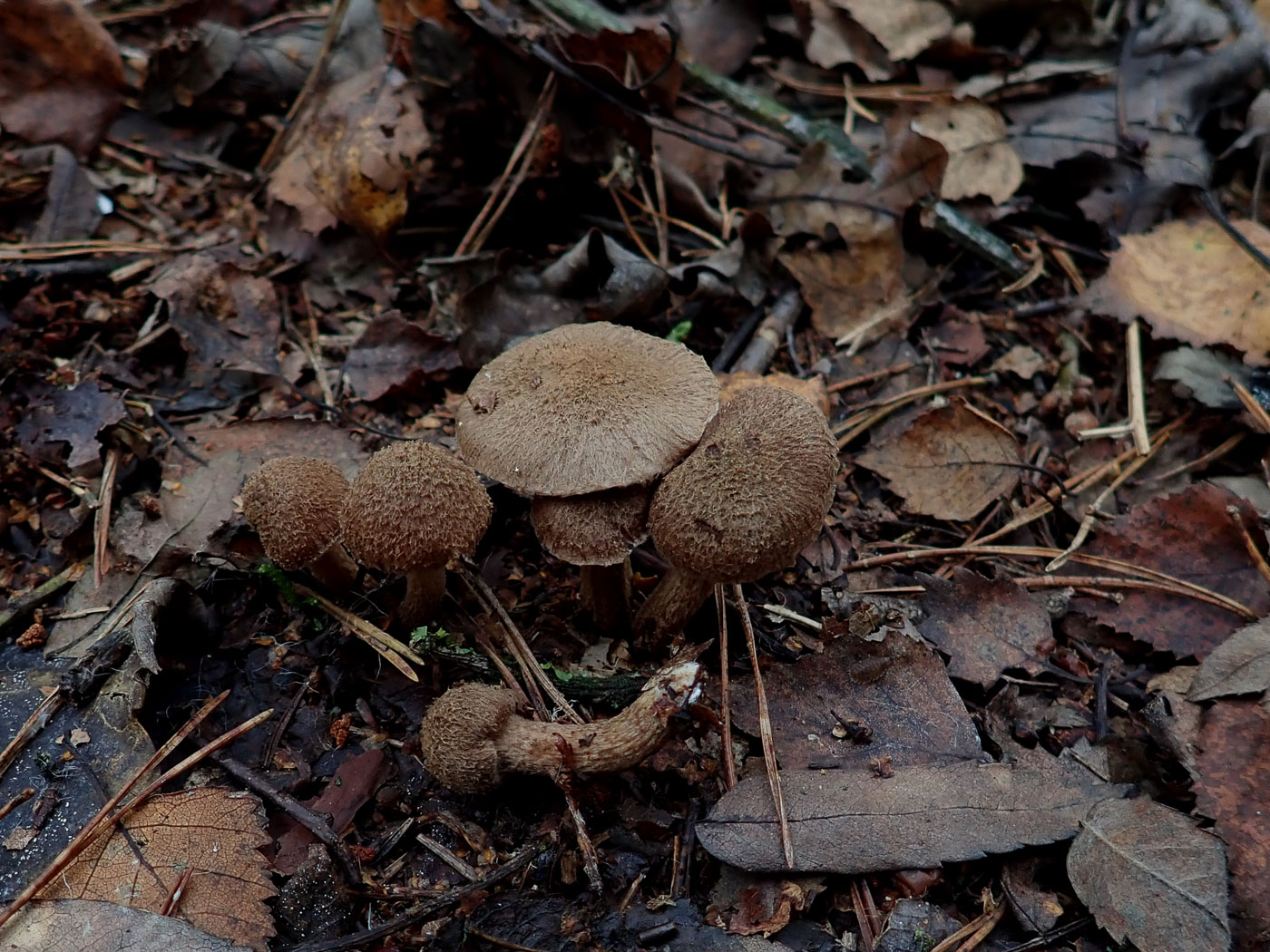
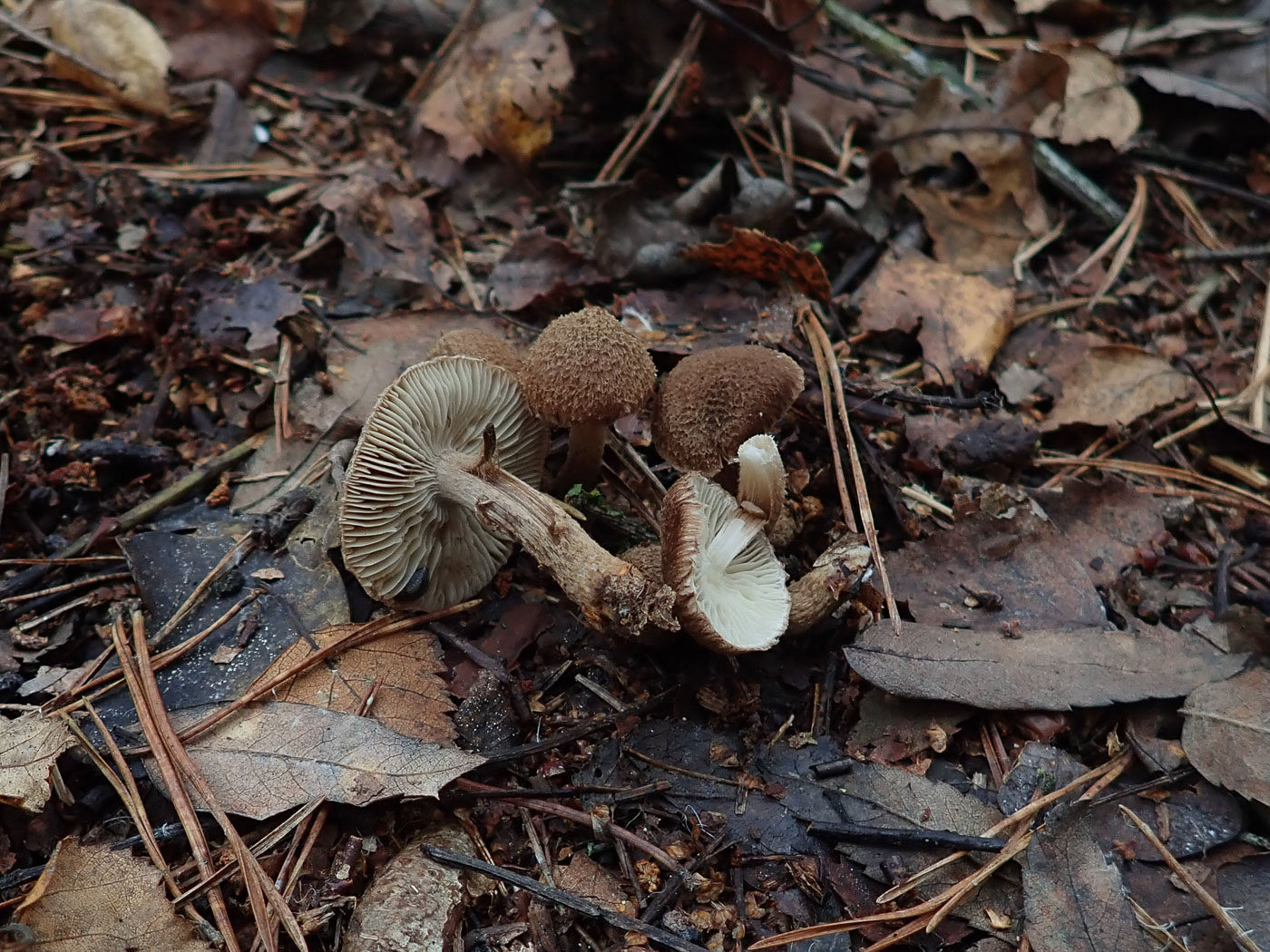 |
November 4th Inocybe stellatospora (Woolly Fibrecap) Under Pine at Burnham Beeches Penny found a few examples of this Fibrecap which is quite distinctive both in the field and under the scope. It favours conifers and has a shaggy cap and stem rather than truly woolly, and with a scope, as its Latin epithet suggests, it has somewhat stellate spores together with metuloid cystidia - those having thick walls and topped with crystals. It is not rare but is probably best described as occasional. Previous finds |
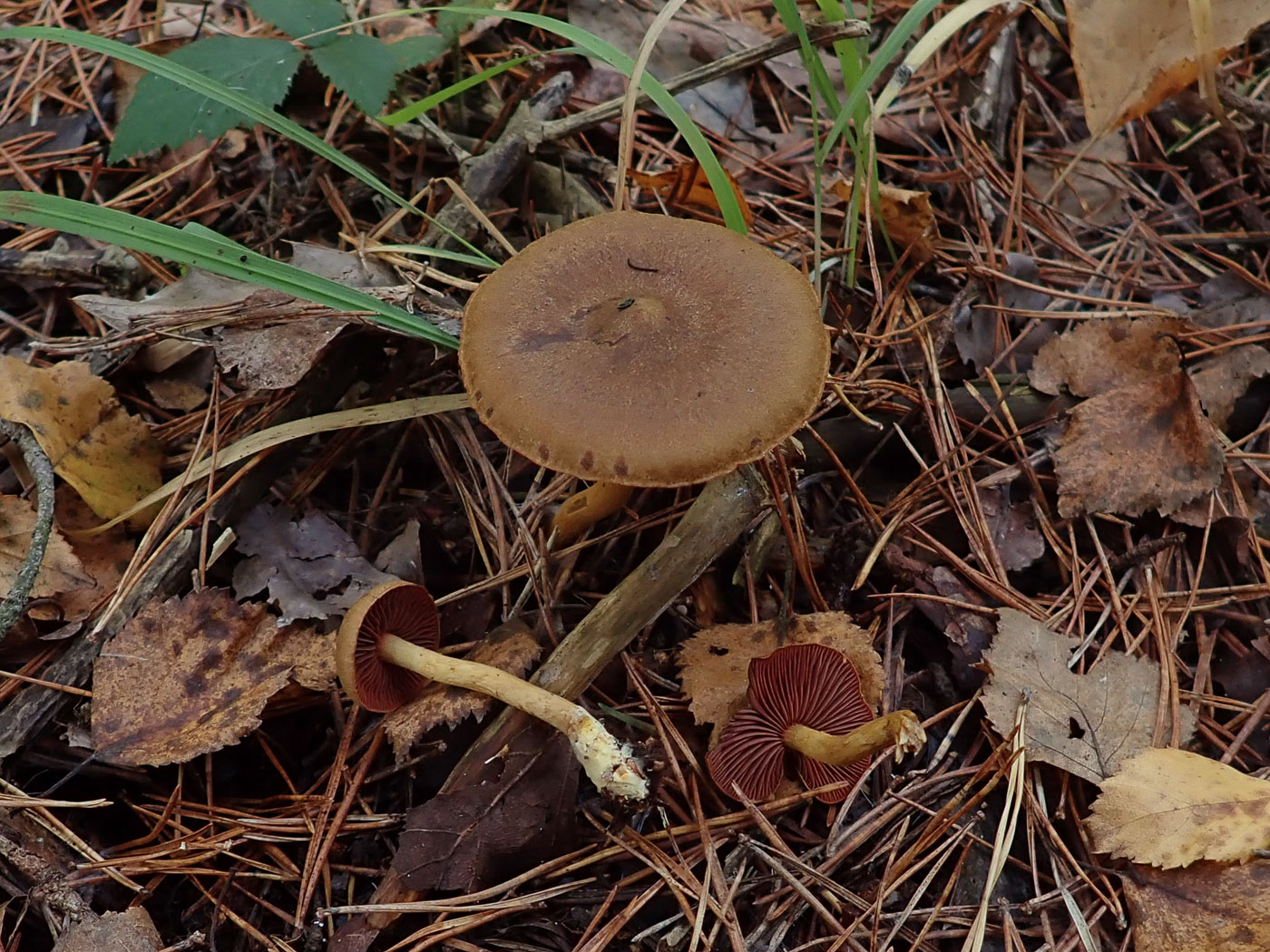
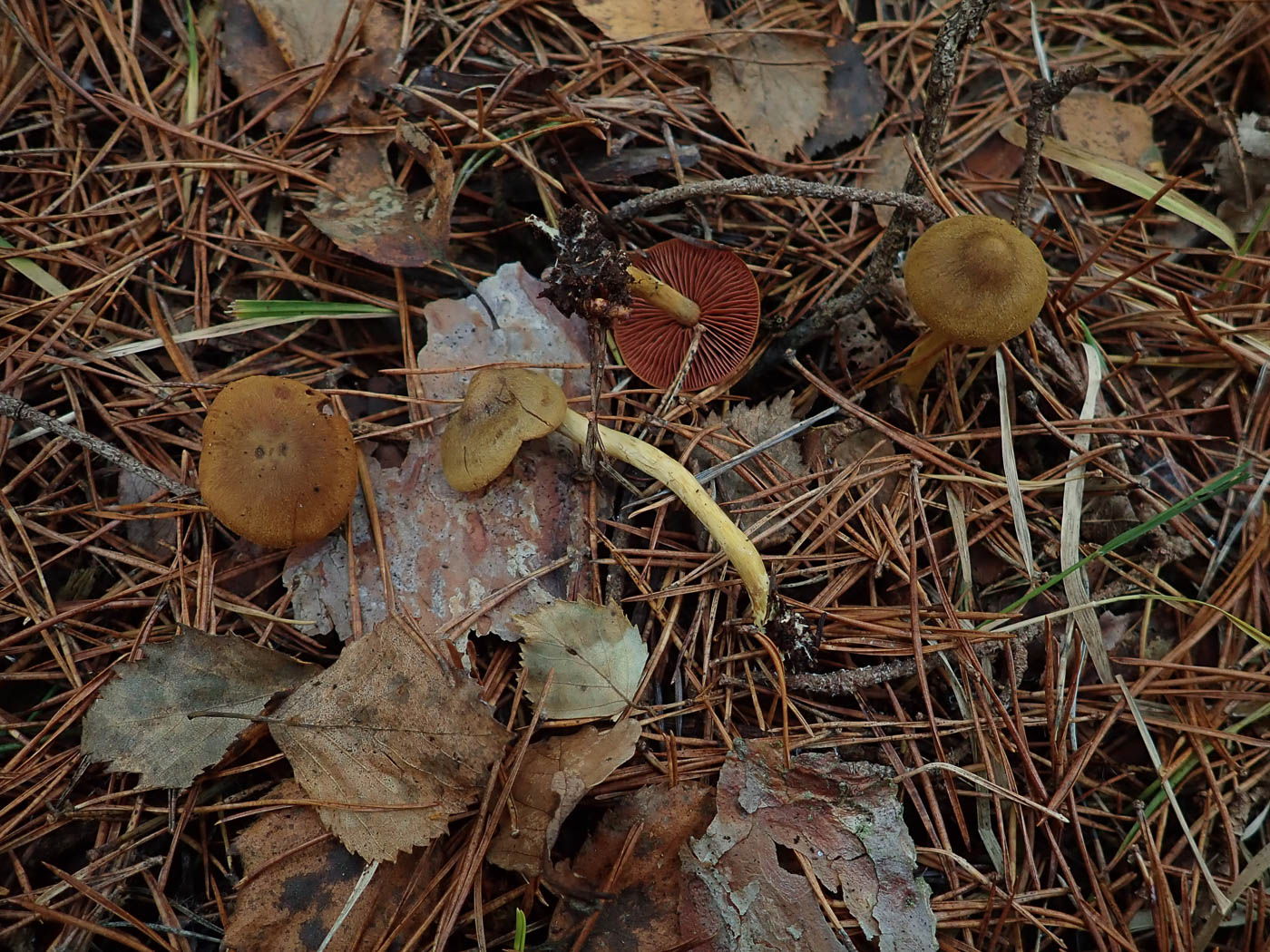 |
November 4th Cortinarius semisanguineus (Surprise Webcap) Under Pine at Burnham Beeches Penny found good numbers of this attractive golden-capped species which never fails to surprise when one turns it over to reveal the contrasting blood red gills beneath. It was recently thought that examples occurring under Pine were a different species from those occurring under Birch, but the very latest thinking is that they are in fact all the same. Time will tell ............. Previous finds |
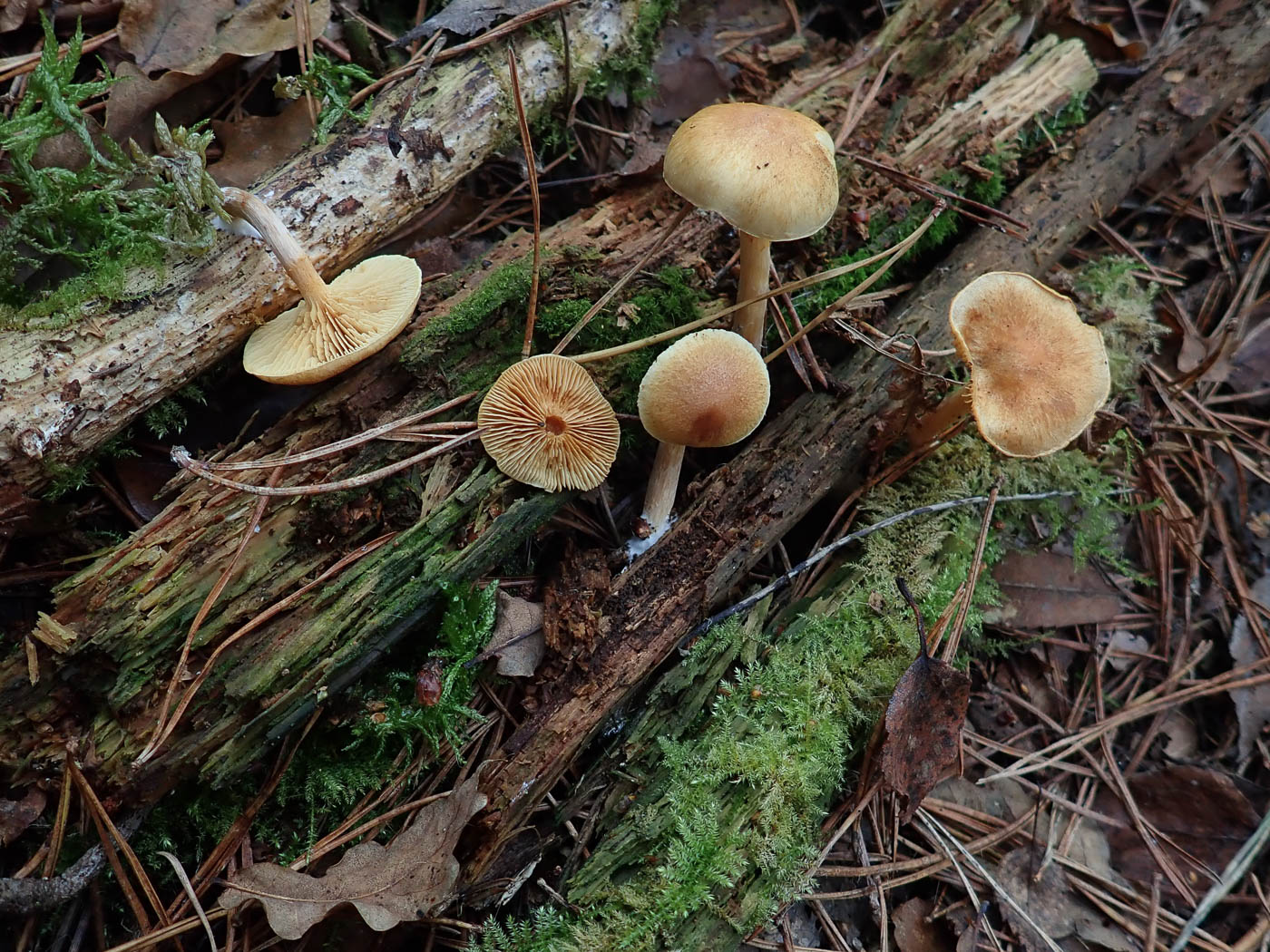 |
November 4th Gymnopilus penetrans (Common Rustgill) Under Pine at Burnham Beeches Penny was pleased to find this normally common woodland mushroom fruiting on fallen wood and debris. It is always on fallen wood and favours conifer though also occurs on deciduous wood, and is recognised by its yellowish gills take on a rusty look as it ages Previous finds |
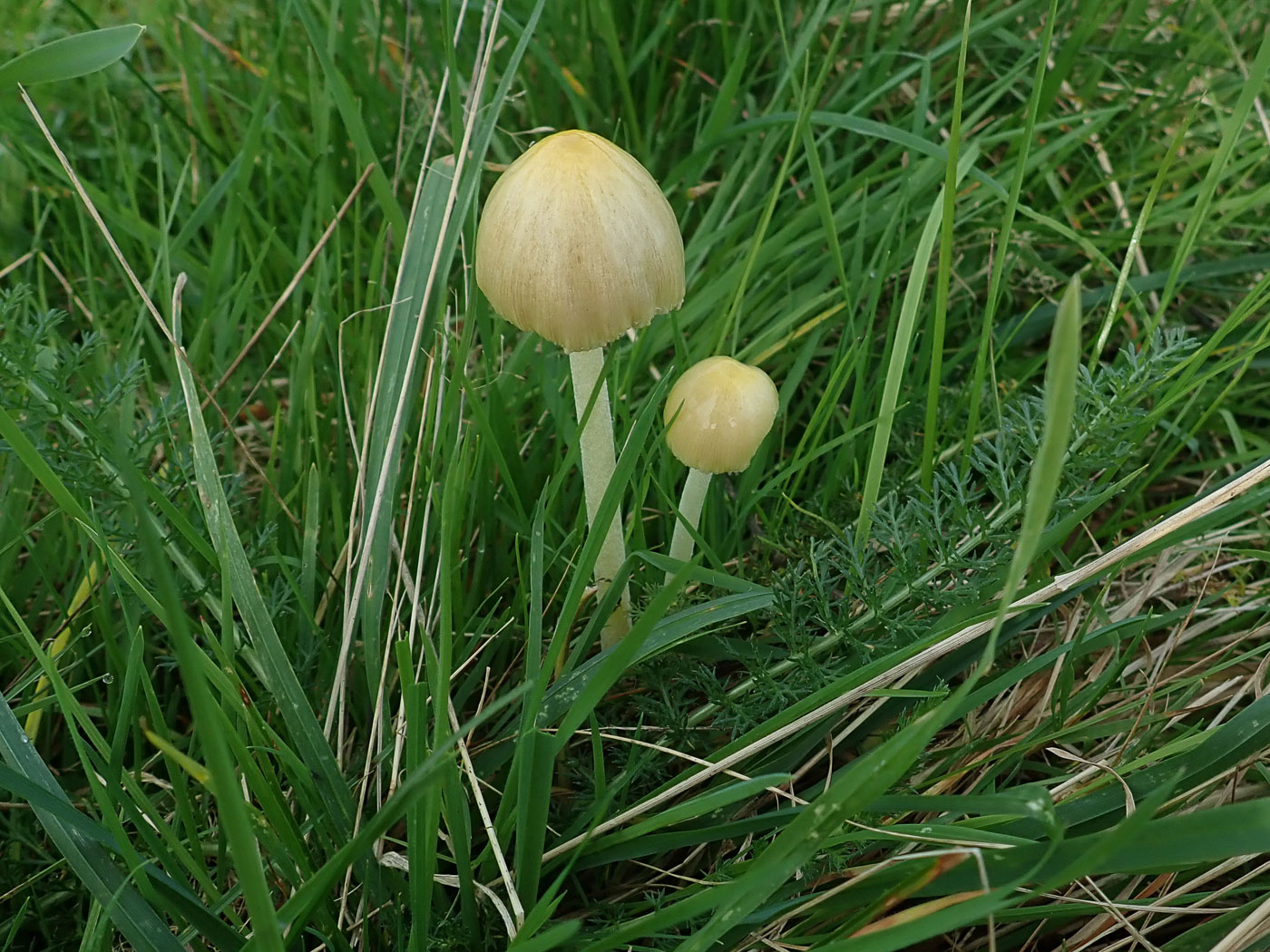
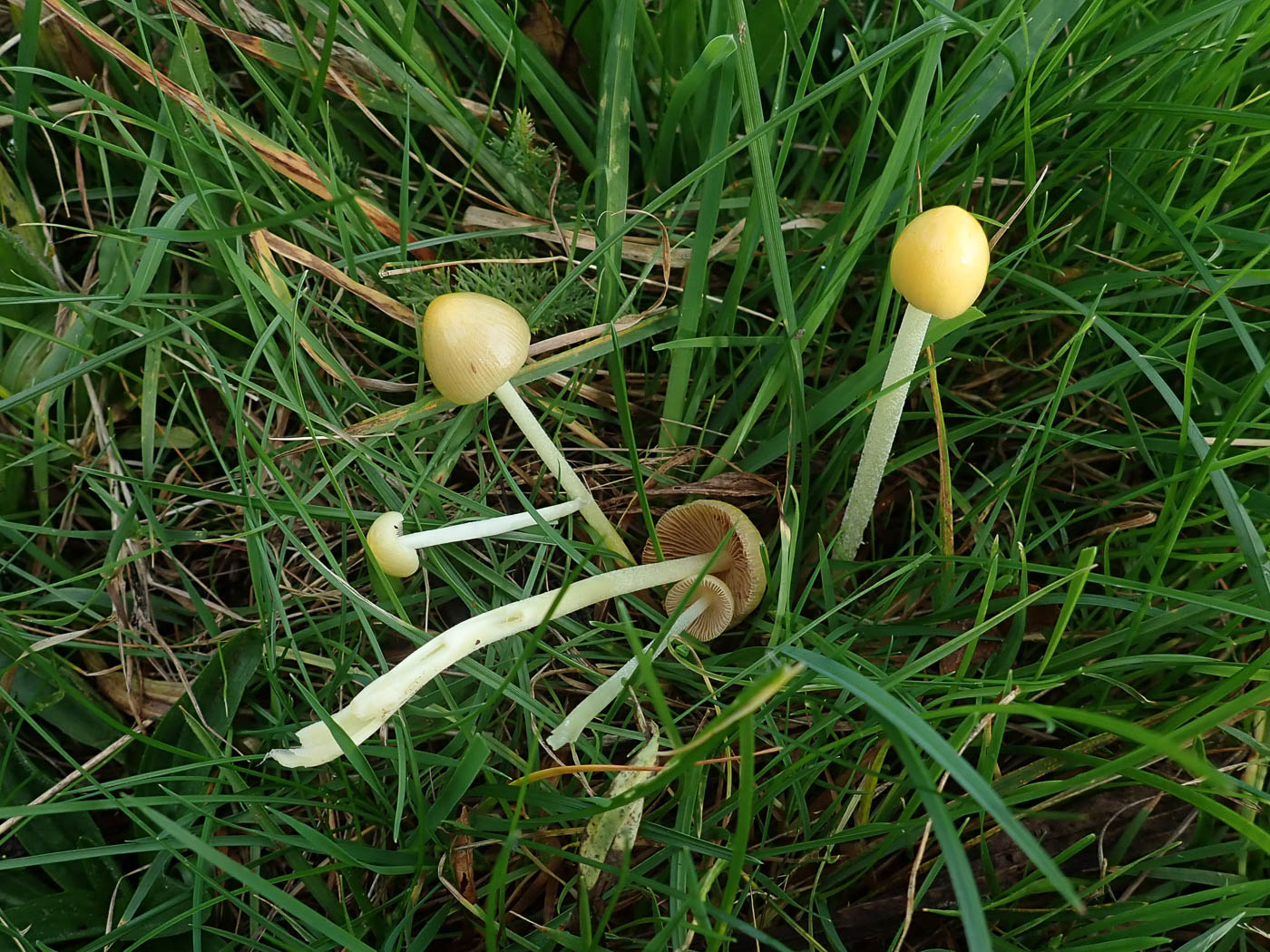 |
November 4th Bolbitius titubans (Yellow Fieldcap) At Burnham Beeches Penny found this normally common grassland species fruiting nicely, but it caught her attention because she's hardly seen it at all so far this season and has been notably conspicuous by its absence. Previous finds |
November 3rd 2024
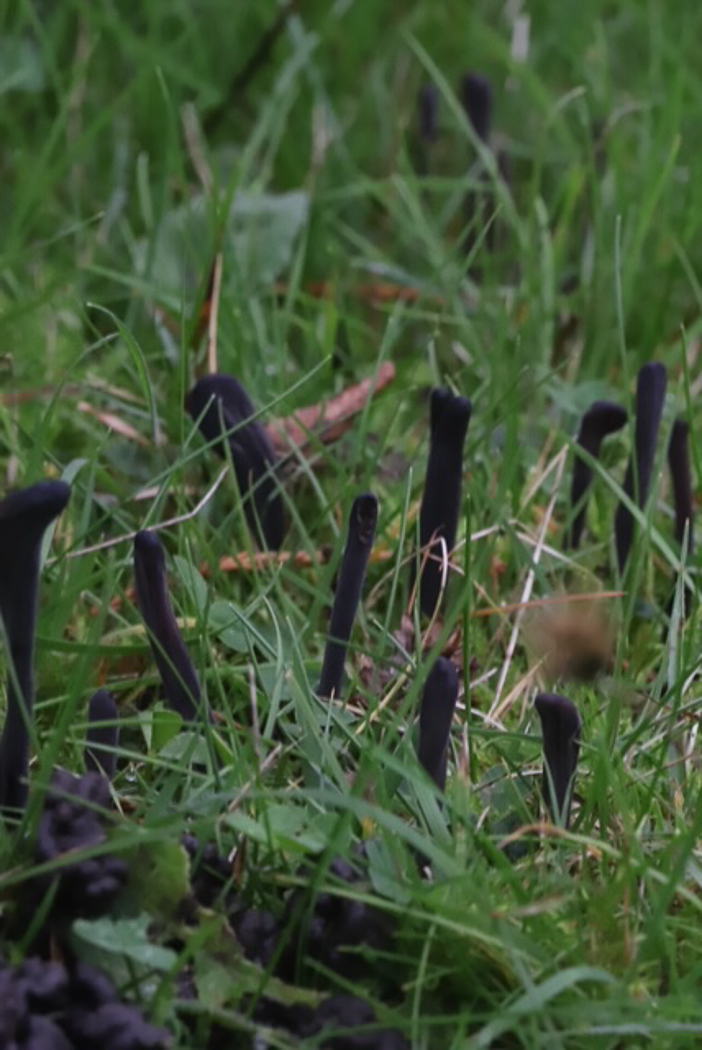
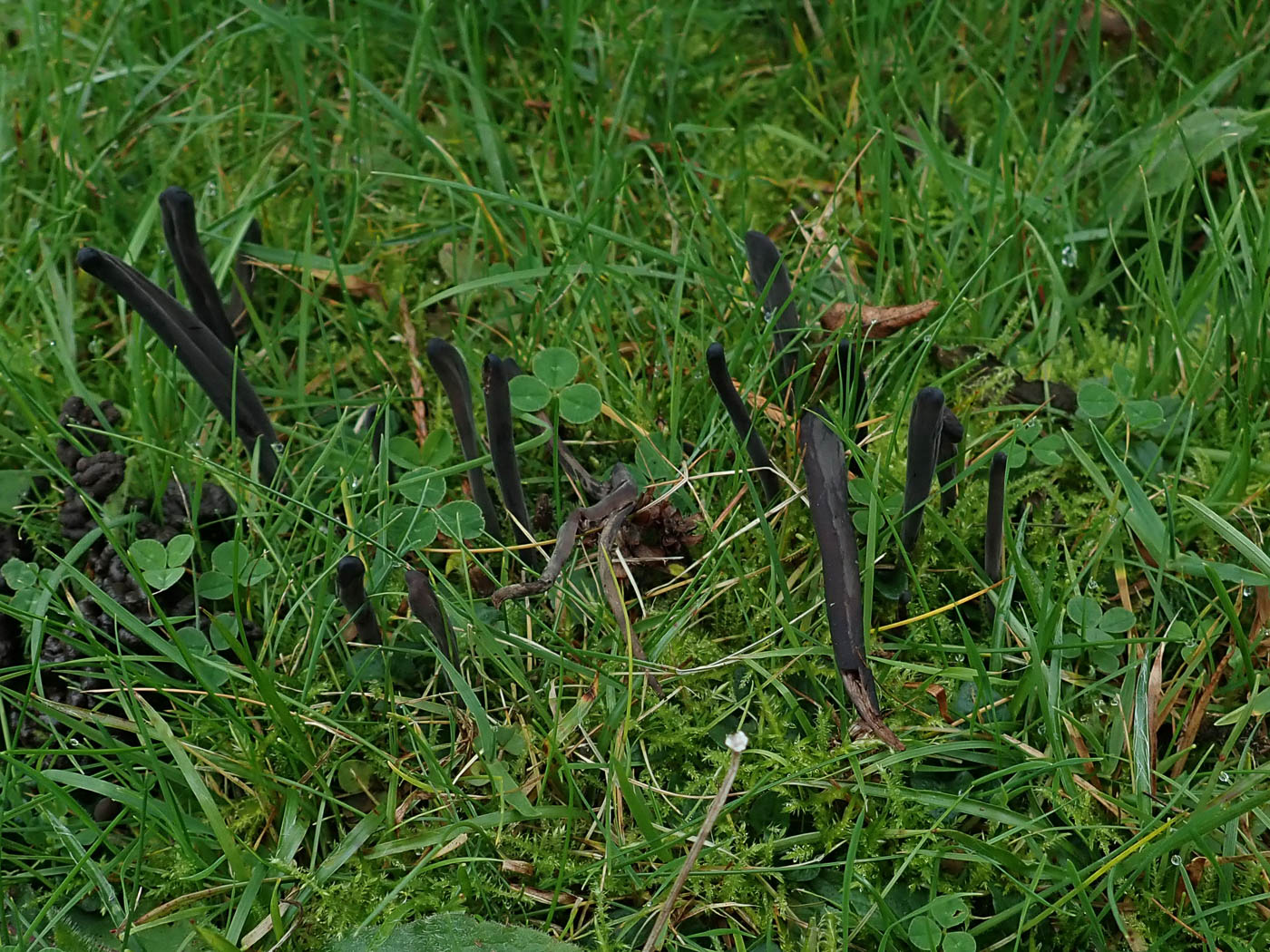 |
November 3rd Clavaria asperulispora (a rare Club with no English name) In the grass at Prestwood Churchyard Phil Townsend found a remarkable group of what appeared to be dark purple clubs near to a small Yew bush (photo 1). He sent his photos to Penny in the hope of help with ID but Penny was nonplussed as well! She and Sarah visited this site two days later and found this same group though now appearing more dark brown to black rather than purple as it appeared earlier (Penny's photo 2). At home Penny found the spores were tiny, round and finely ornamented which matched perfectly with C. asperulispora, a rare species which was found here new to the county in 2021 by Jesper Launder though in small numbers and under a different Yew. The species reportedly favour Yew and there are still only three UK records other than Jesper's on FRDBI so to find such a rare species in impressive numbers like this is quite remarkable and it's exciting to find the species apparently thriving here. We will have a sample sequenced. Previous finds |
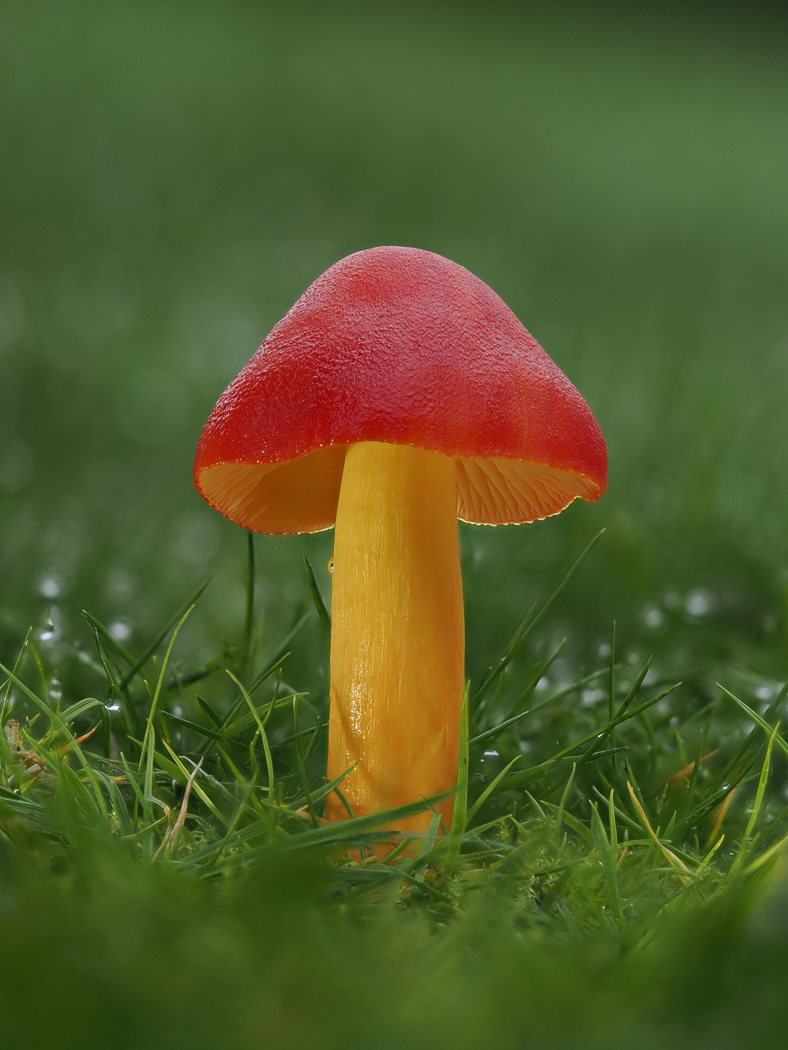
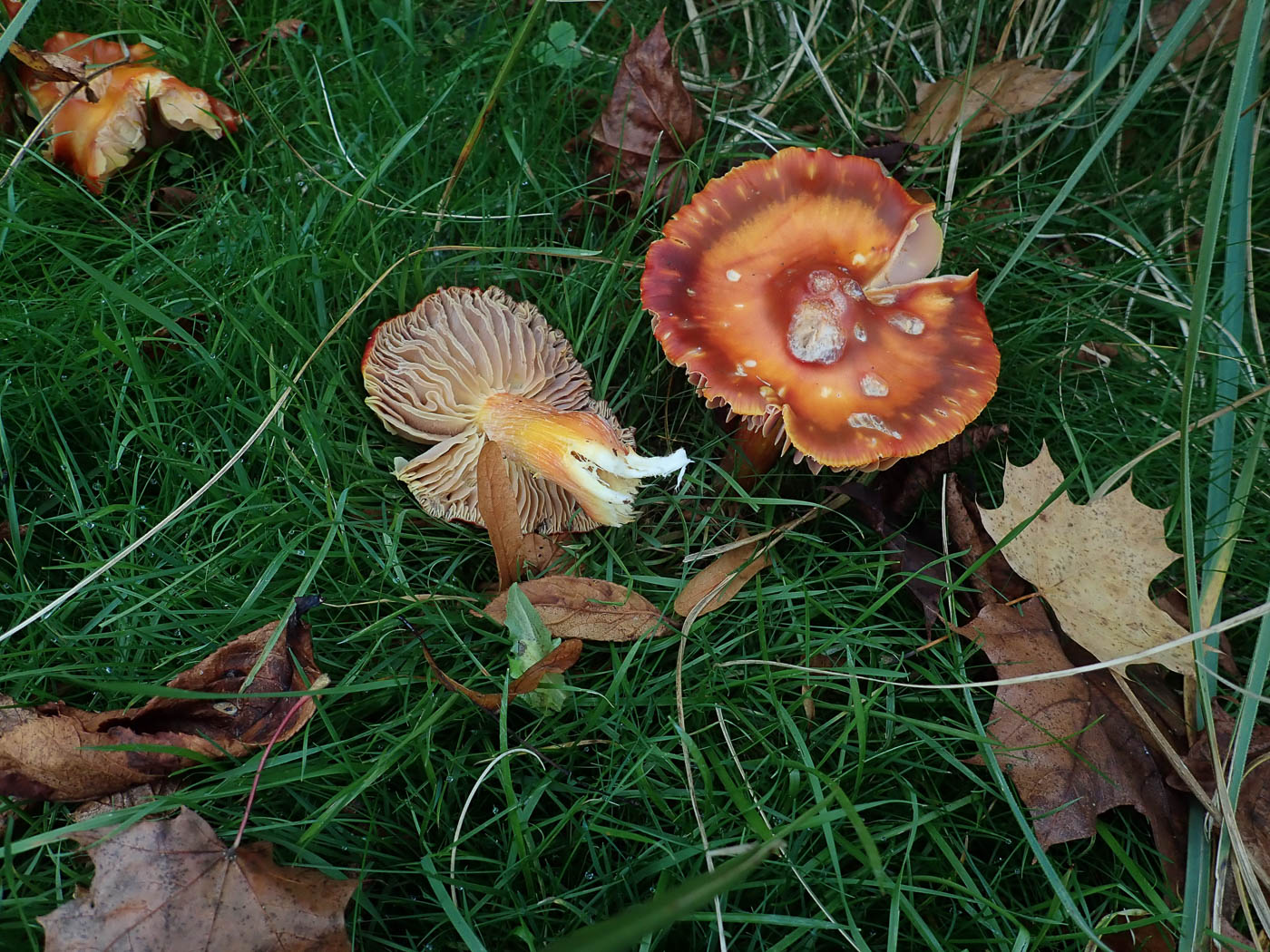 |
November 3rd Hygrocybe punicea (Crimson Waxcap) At Stoke Poges Memorial Gardens Eleanor Page took this lovely photo of one of our less common waxcaps though this site is one of its county strongholds along with Prestwood Churchyard. This is a large chunky waxcap with a thick fibrous stem and even when young as here one can tell it has the potential to grow much bigger. Sarah and Penny found it 2 days later at Prestwood when the largest cap was a good 8 cm across (photo 2), and it was still fruiting well at Stoke Poges a week later. Previous finds |
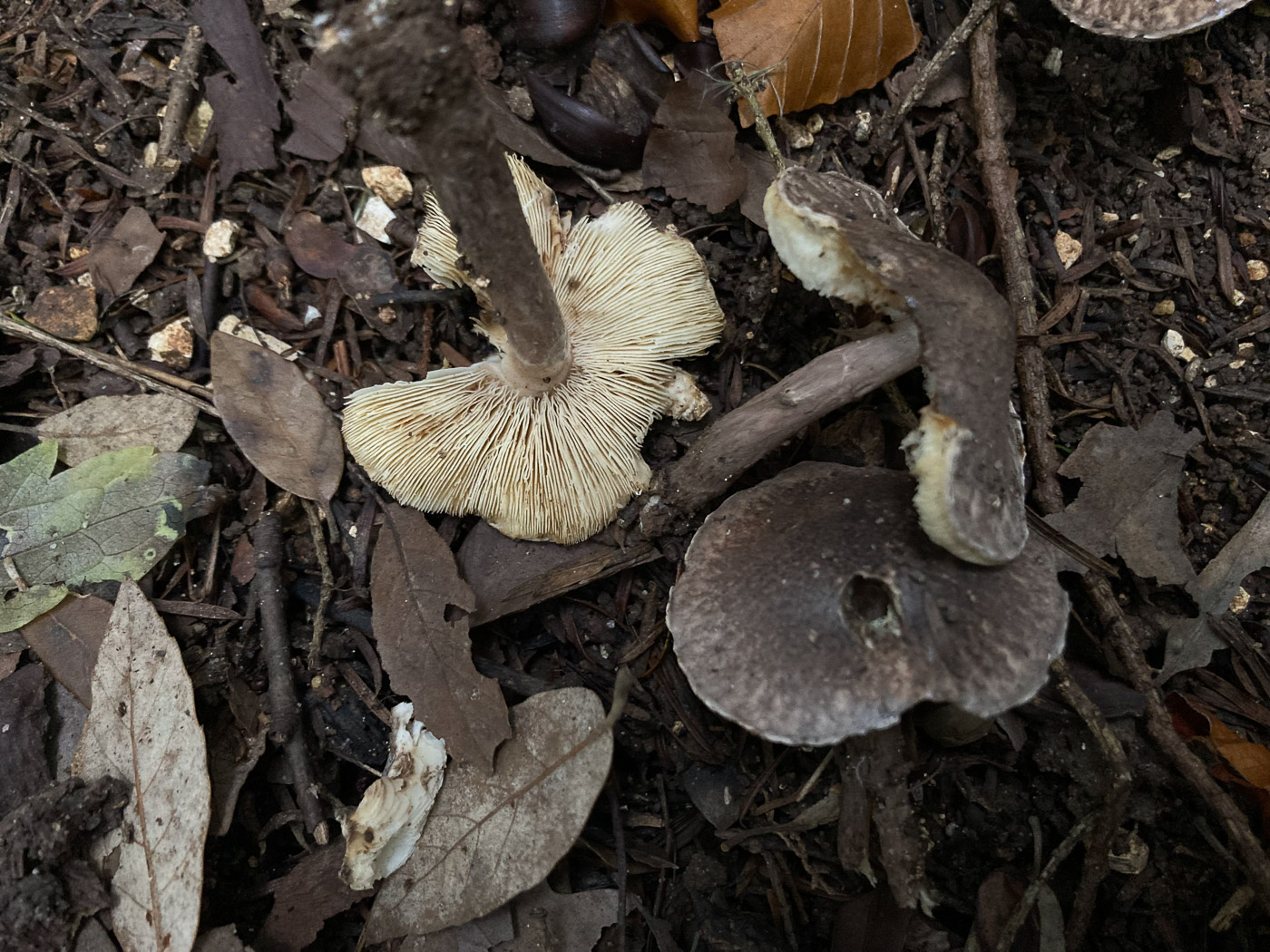 |
November 3rd Lepiota fuscovinacea (Dark Dapperling) At Cliveden Russell Ness spotted these dark caps in litter under mixed trees. They keyed out at home to this unusual Dapperling for which we have just handful of records. This genus has been scarce this autumn with even L. cristata (Stinking Dapperling) hardly making an appearance, so if you come across one have a good look around for other Dapperlings nearby as they often seem to come up quite near together. Previous finds |
November 2nd 2024
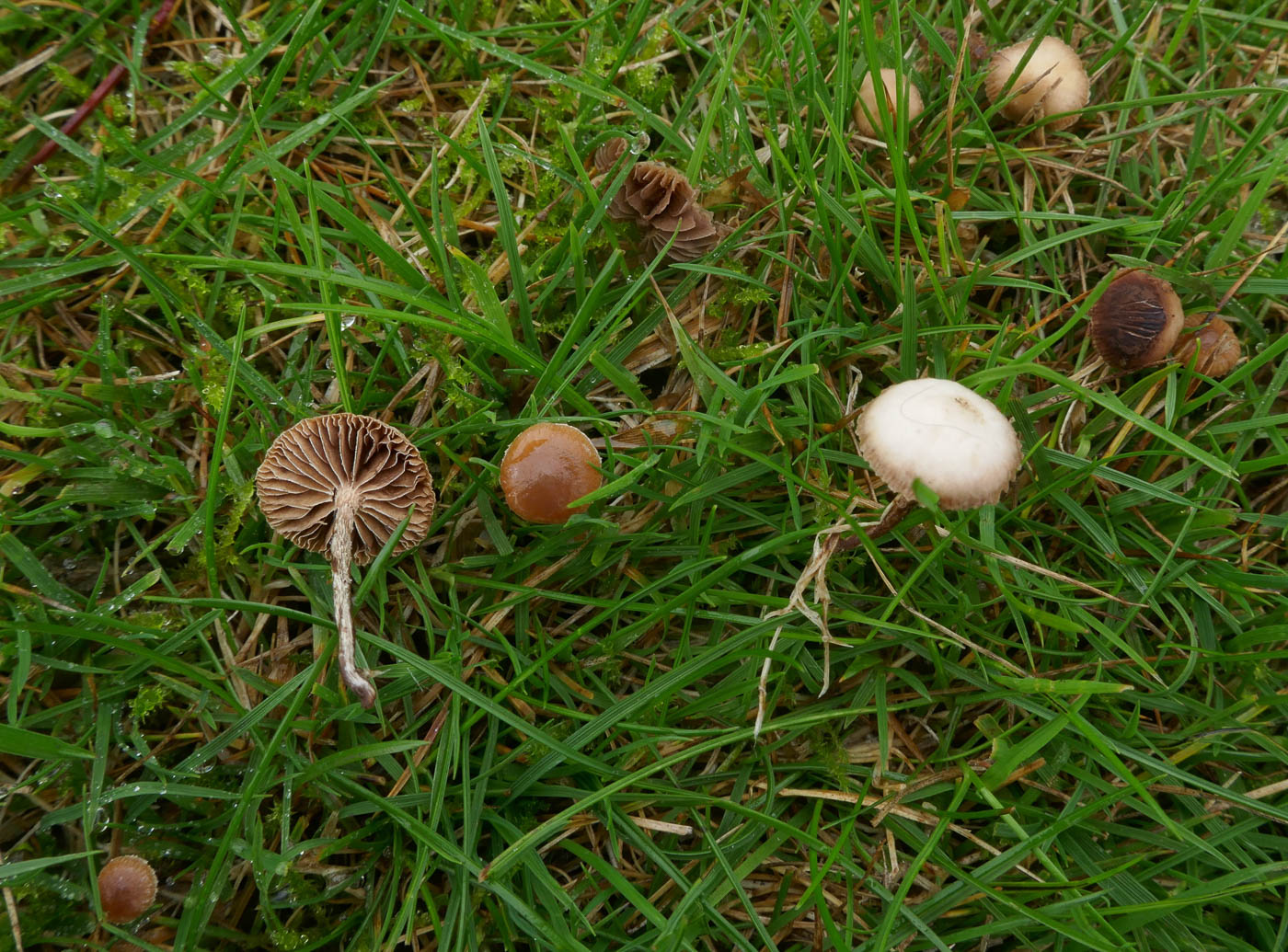
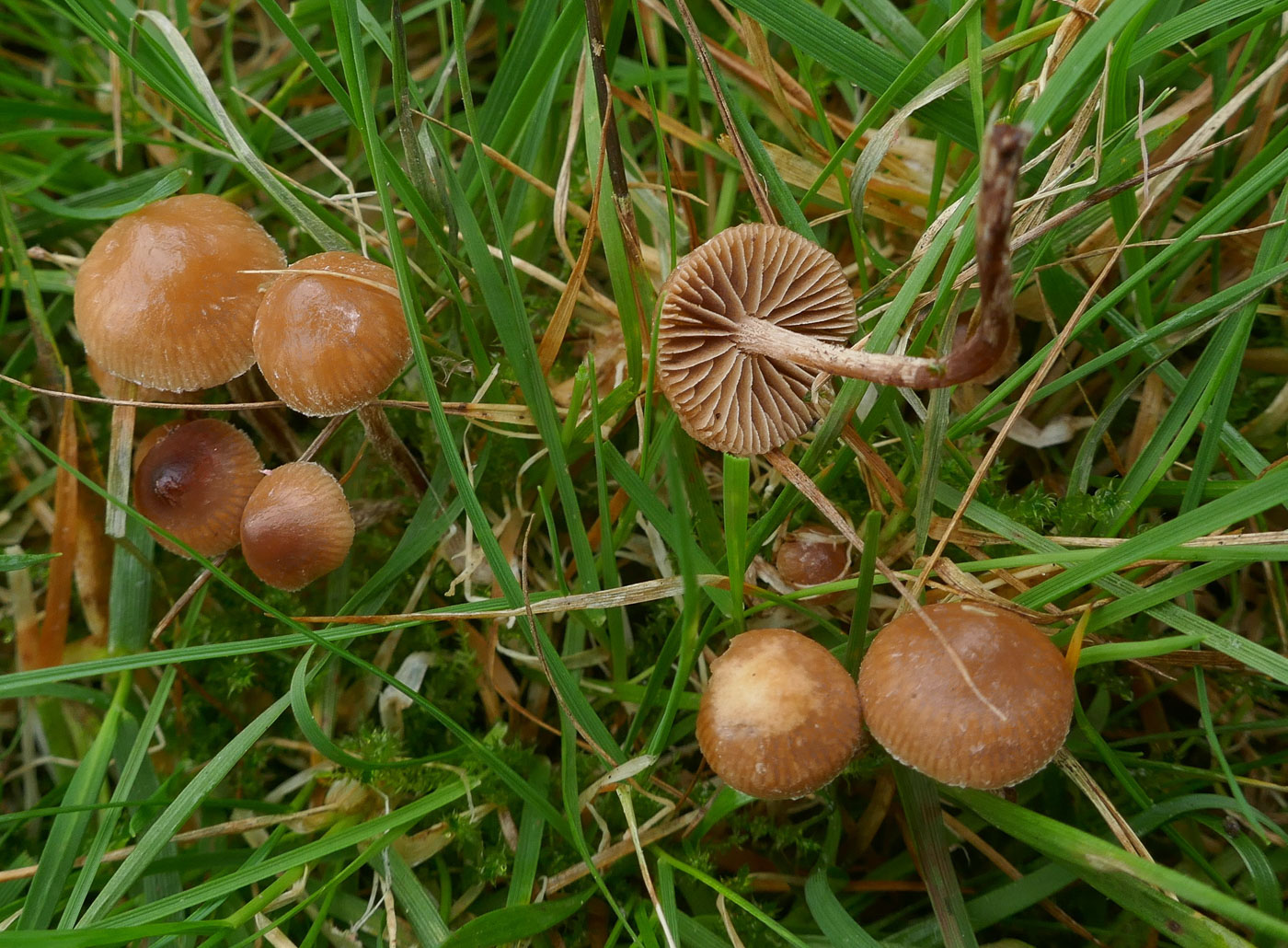 |
November 2nd Deconica inquilina (Flecked Brownie) At Stampwell Farm Jackie Ewan noticed this LBJ growing on dead grass stems, one that she didn't recognise and needed work to identify. She discovered that it had an unusual cap surface which was gelatinous and entirely peelable, and this together with the obvious white veil markings around the cap margin led her to this unusual species for which we have just a handful of previous records, mostly under its previous genus name Psilocybe. Previous finds |
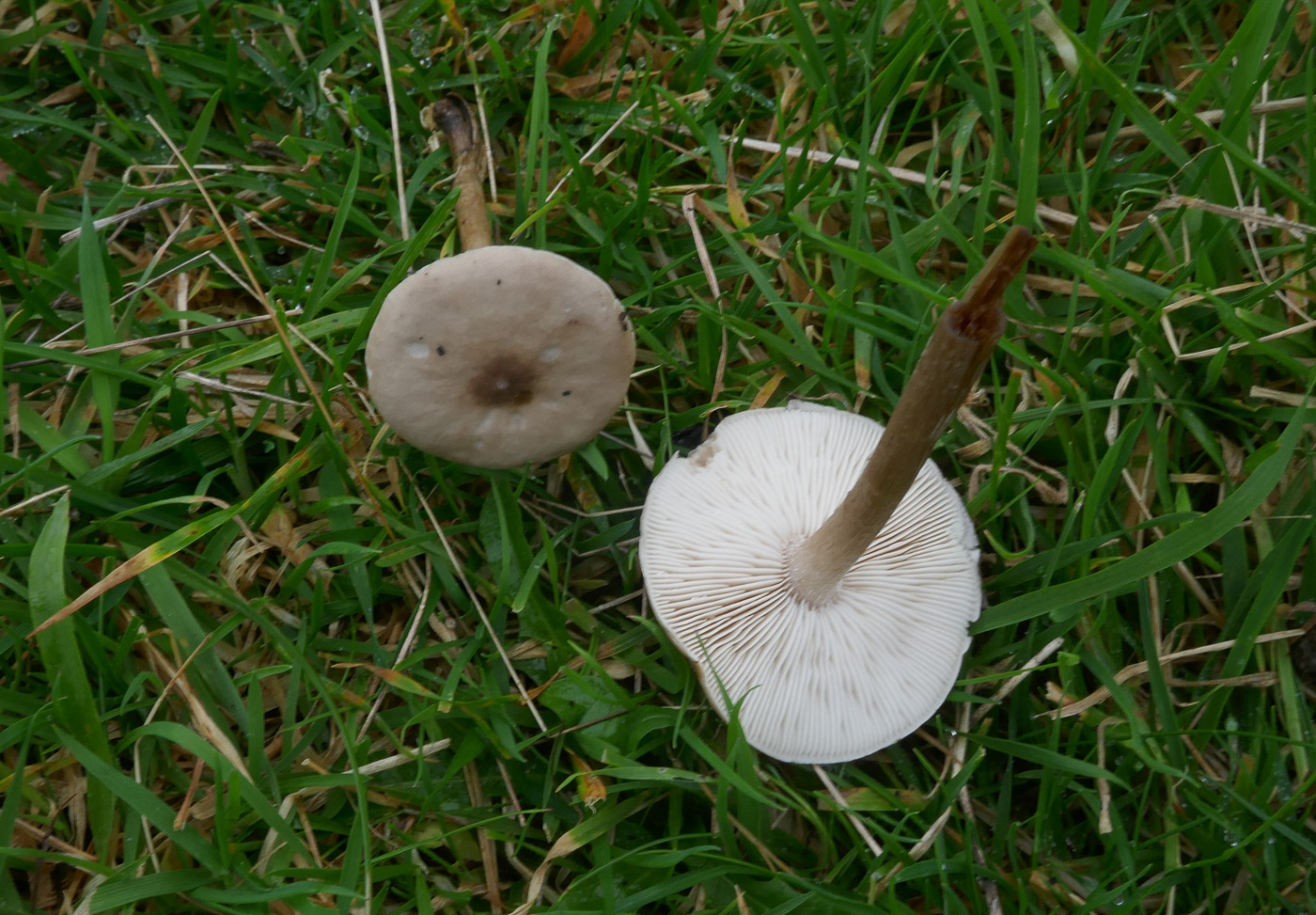 |
November 2nd Melanoleuca excissa (Smoky Cavalier) At Stampwell Farm Jackie Ewan spotted this quite unusual species in a sheep paddock where she recalls finding it several years ago. The genus is often one which confuses, has nothing very distinctive to help in the field other than a somewhat rounded umbo, and one tends to end up suggesting it having eliminated other likely candidates! Under the scope, however, the situation becomes more obvious if one checks with Melzers reagent for the amyloid spores which are also finely ornamented, then looks for the cystidia which are characteristically harpoon shaped with fine points though they can sometimes be hard to find. This particular species is not common and rather paler than others and is a new entry for Finds. We've not recorded it for about 20 years. |
November 1st 2024

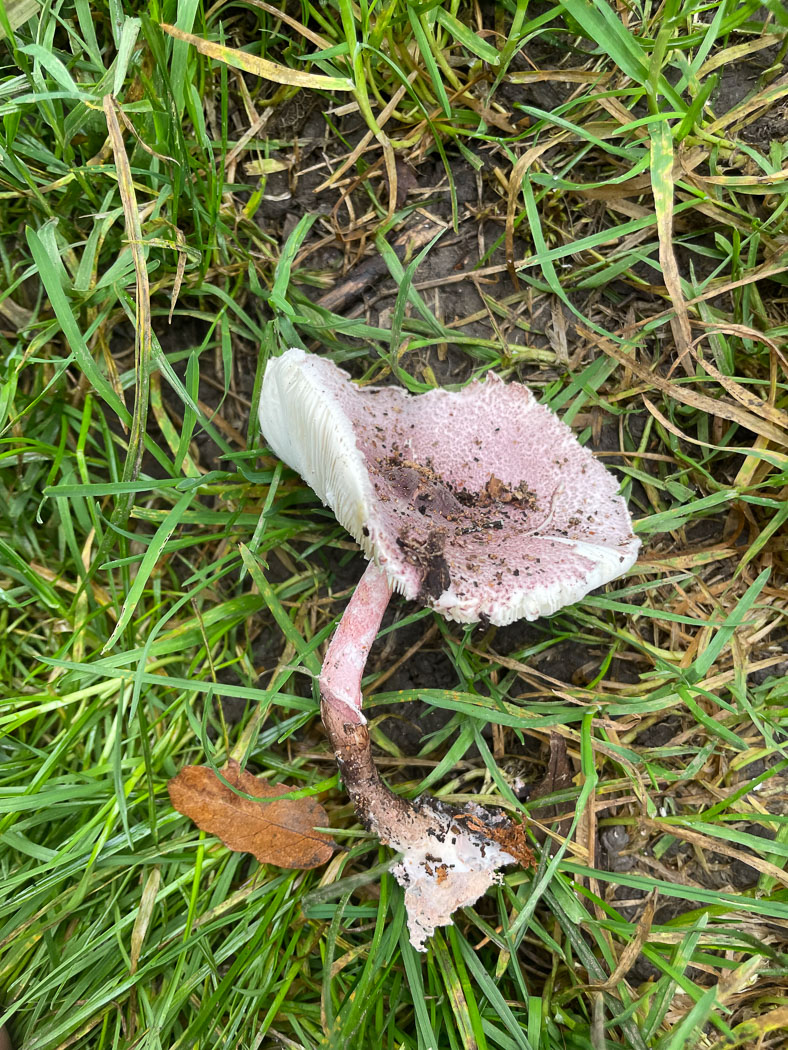 |
November 1st Leucoagaricus ionidicolor (a rare Dapperling with no English name) In Naphill Common Sarah Ebdon was amazed to come across this rare and beautiful species which she'd also found on our Walk at Mousells Wood only a week earlier. Today's was not quite such a photogenic collection (see her stunning photo in the Mousells Wood October 23rd report) but nevertheless recognisable by its remarkable and unique violet tinted cap and stem contrasting with the white crowded gills. Previous finds |
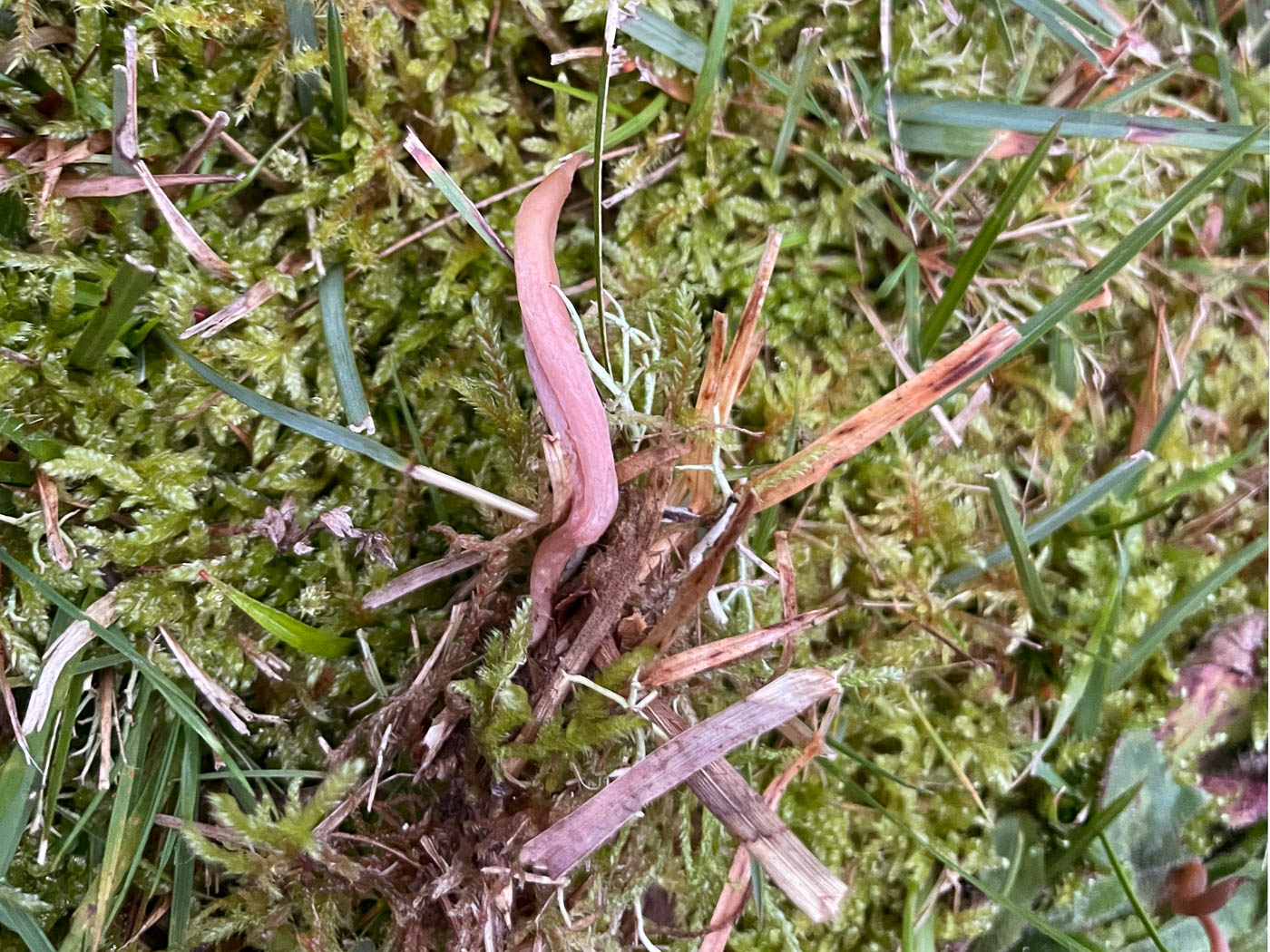

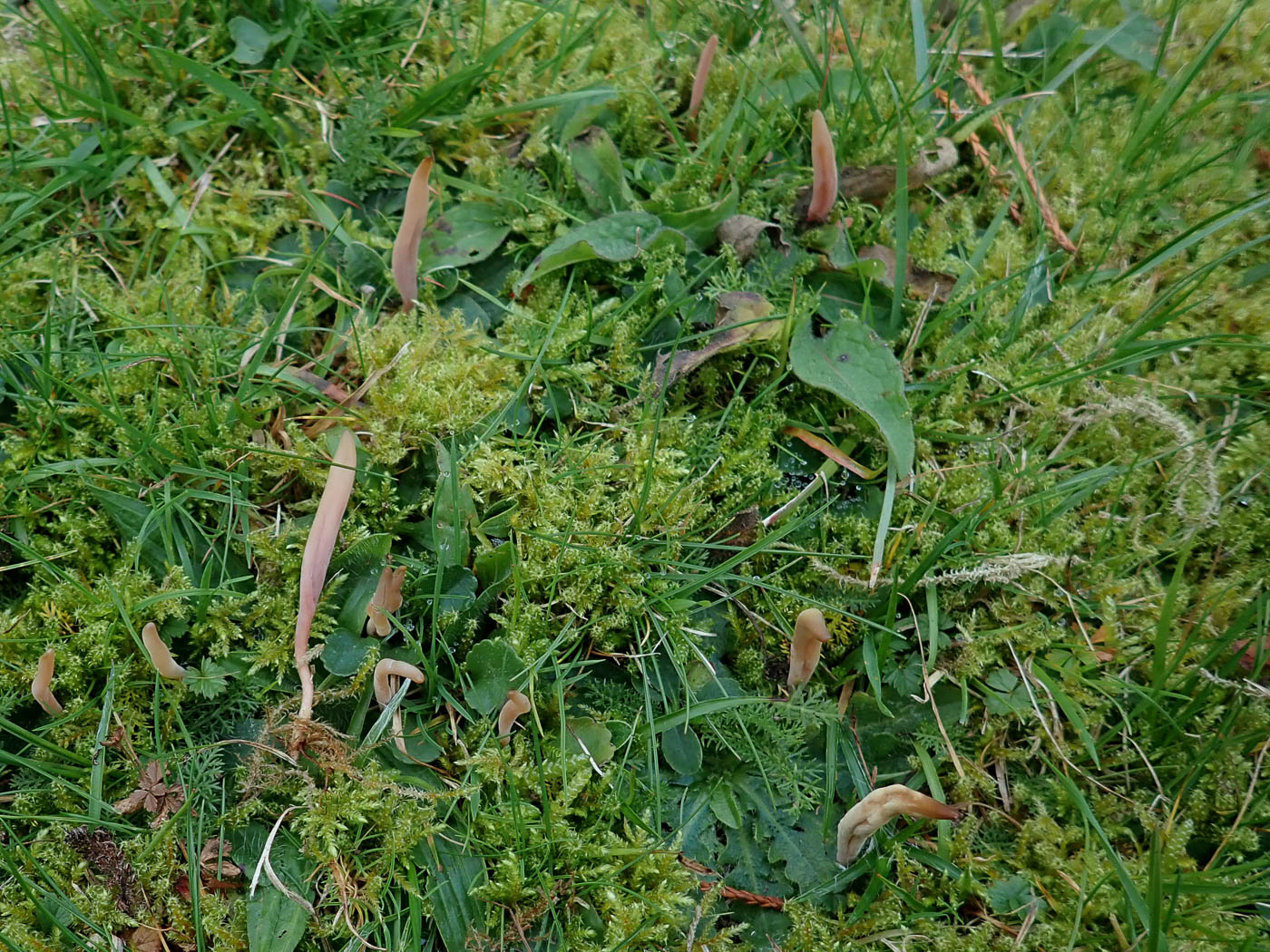 |
November 1st Clavaria cf incarnata (Skinny club) At Prestwood Churchyard Sarah Ebdon came across a few of these pale salmon pink clubs growing inidividually rather than clustered and close to the much larger Cuphophyllus pratensis (Meadow Waxcap). Never having seen a pink club apart from the clustered C. fumosa (Smoky Spindles and a regular fruiter at this site though rare) before, she was intrigued and took one home to work on. She discovered there are in fact several pink clubs, none very common, and without detailed information very tricky to name and in fact only recently separated with DNA sequencing. The new and somewhat pricy monograph is probably the only way forward other than sequencing (which we will hope to do) Sarah discovered from the BMS Facbook page that C. incarnata seems to have an affinity with C. pratensis together with a variety of Thistle and this in fact checked out when she went back to the site . She and Penny then visited the site a week later and refound this beautiful club (photo 3 is Penny's) together with a host of other interesting species. We appear to have one previous county record dating from 1925 (!) in Gt Missenden (only a couple of miles from Prestwood) made by the eminent and highly acclaimed mycologist E. Corner. Far be it from Penny to discount this record but bearing in mind the developments in speciation over the last 100 years, we are hopeful that Sarah's find will turn out to be the first sequenced collection in Bucks therefore worthy of the prestigious yellow box here! |
October 31st 2024
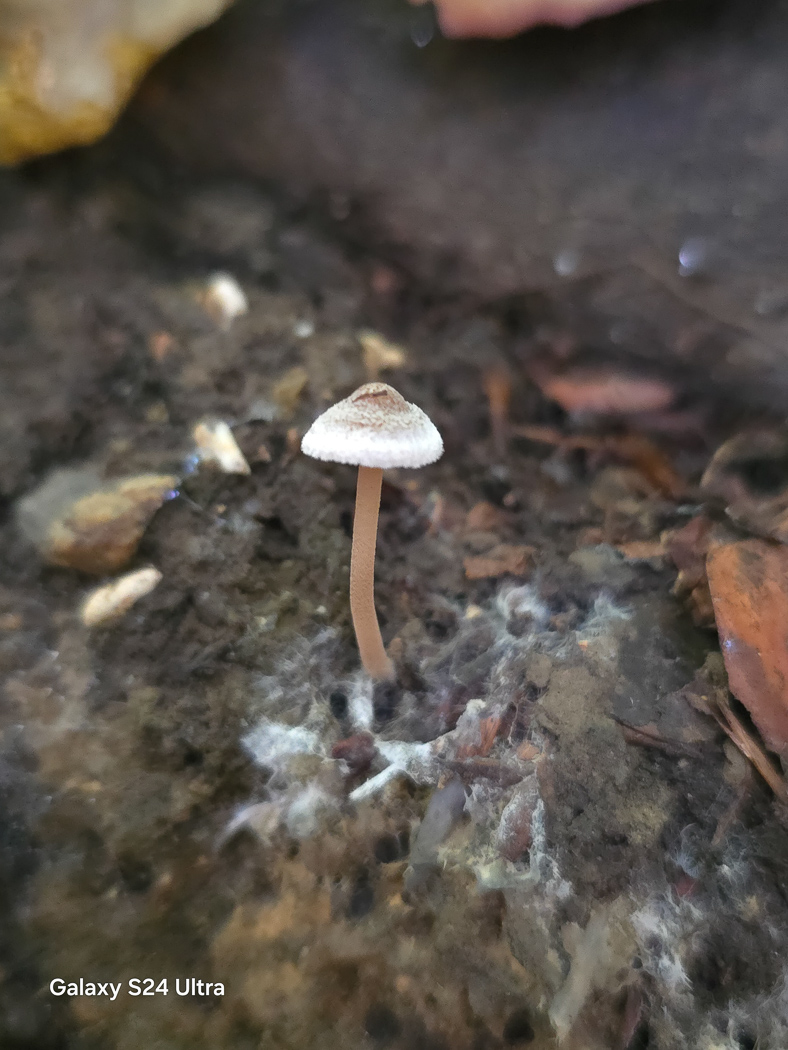
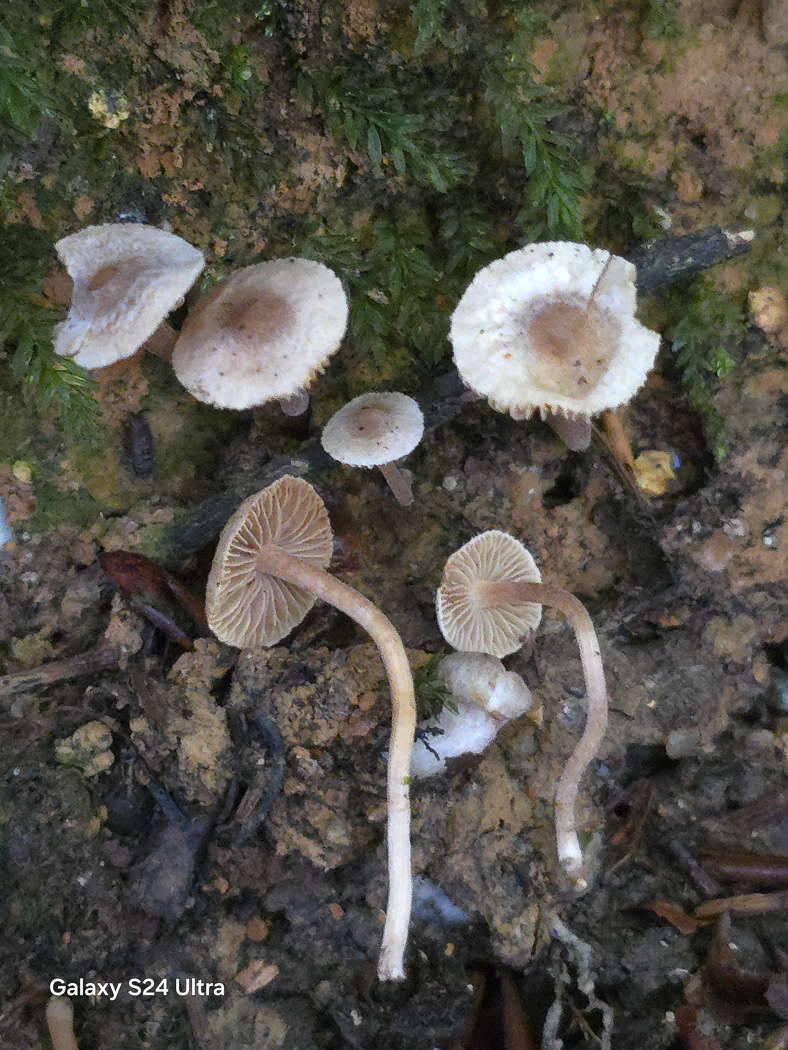 |
October 31st Inocybe petiginosa (Scurfy Fibrecap) Under Beech in the Gerrards Cross area Jesper Launder noticed these small LBJs which didn't ring a bell of any sort. At home, however, there was no doubt over the genus once he'd seen the distinctive nodulose spores and metuloid cystidia (with thick yellow walls and topped with crystals) which when combined indicate the genus Inocybe (Fibrecap). This species, however, is not typical of the genus in appearance and regularly confuses even knowledgeable mycologists until this process of confusion in the field followed by revelation under the scope has been experienced! It is not that rare but is easily overlooked when mistaken maybe for a Tubaria or some other small brown capped species though the twotone cap with reddish brown centre and very pale rim is distinctive once you know it. Previous finds |
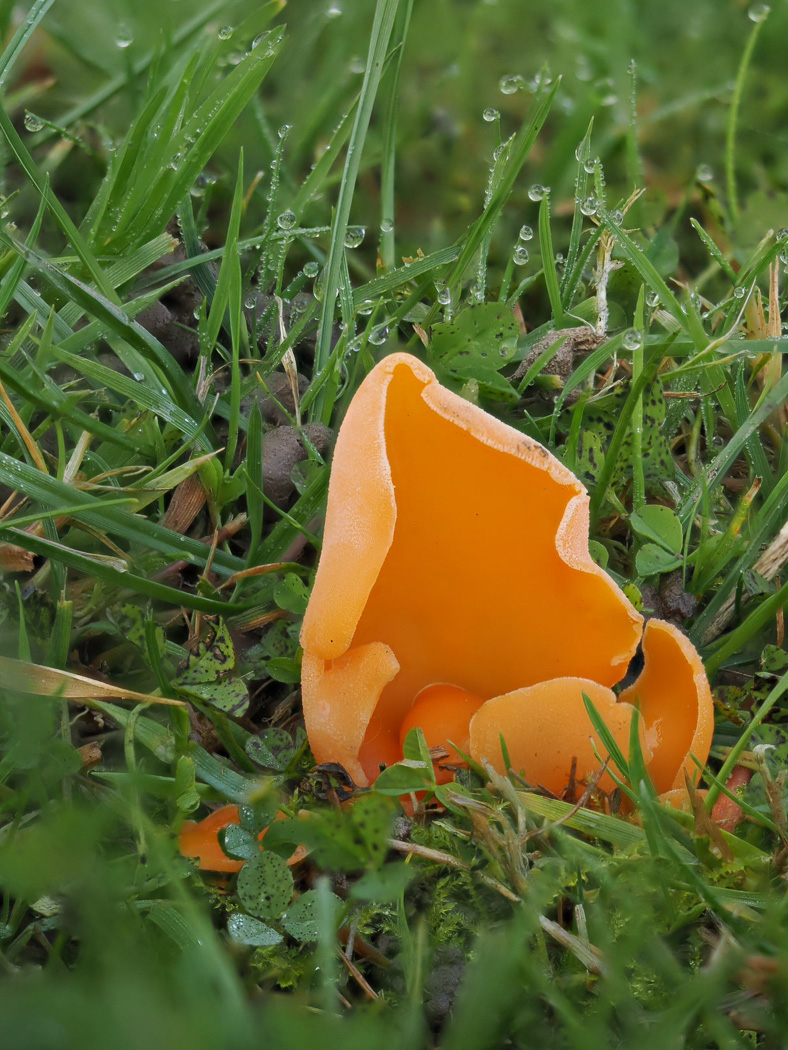 |
October 31st Aleuria aurantia (Orange Peel Fungus) In Naphill Common Claire Williams could hardly miss this brightly coloured cup fungus - one which is quite common at this site and which favours disturbed soil. One of our larger cup fungi, it is similar in appearance to the genus Peziza apart from its dazzling bright orange flesh and of course its microscopic features (which one rarely needs to check for confirmation). Previous finds |
October 30th 2024
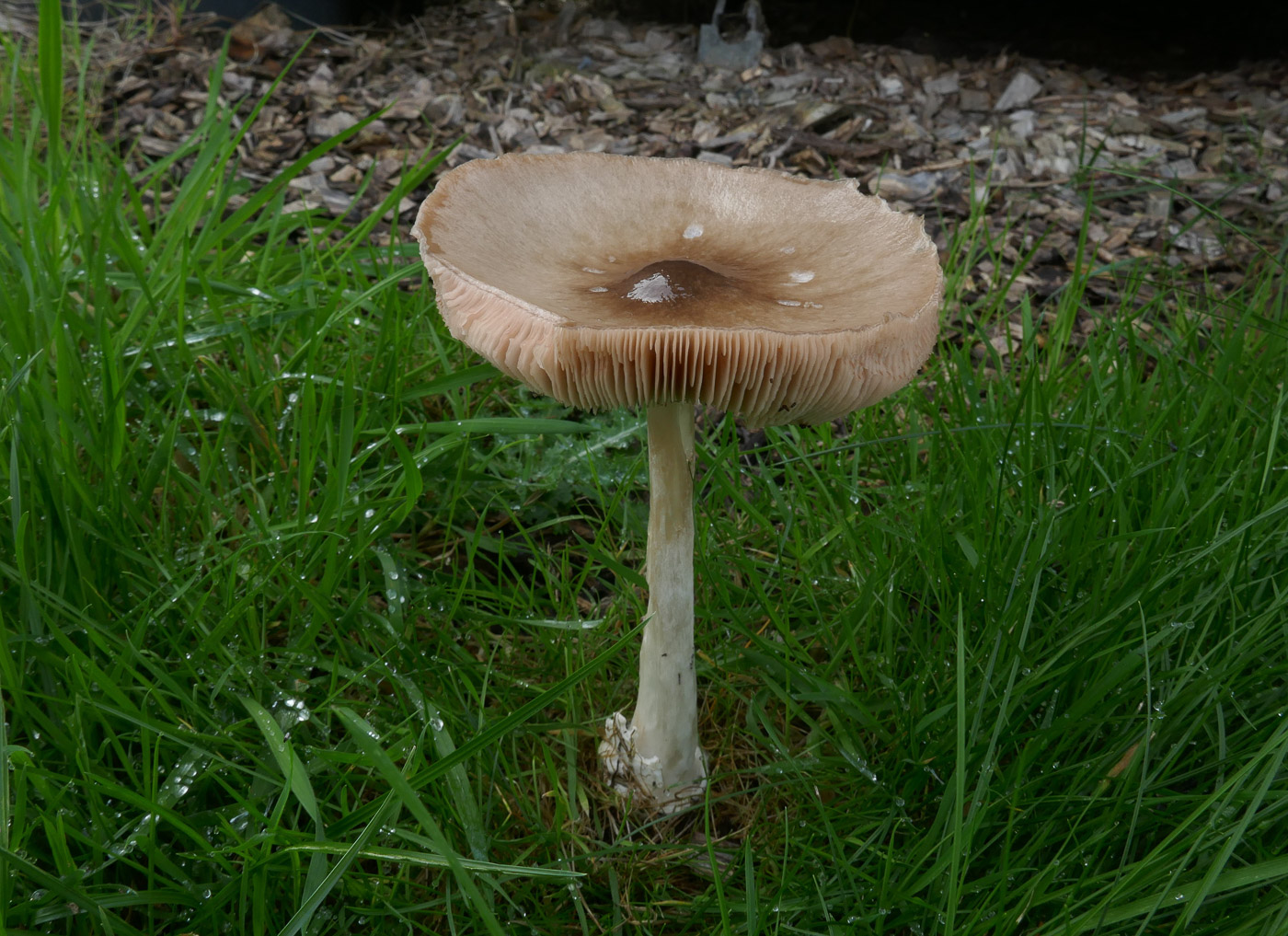 |
October 30th Volvopluteus gloeocephalus (Stubble Rosegill) At Stampwell Farm Jackie Ewan found this fairly uncommon grassland species which is easy to mistake for a large Pluteus if one fails to notice the white volva at the stem base - just visible in Jackie's photo. So if you come across a species with pink free gills which is well away from any fallen wood, take a careful look to see if there are remnants of a volva which can disintegrate and be easily missed. Back in the days when farmers regularly burnt their stubble fields after harvesting this species was much more common than it is now. Previous finds |
October 25th 2024
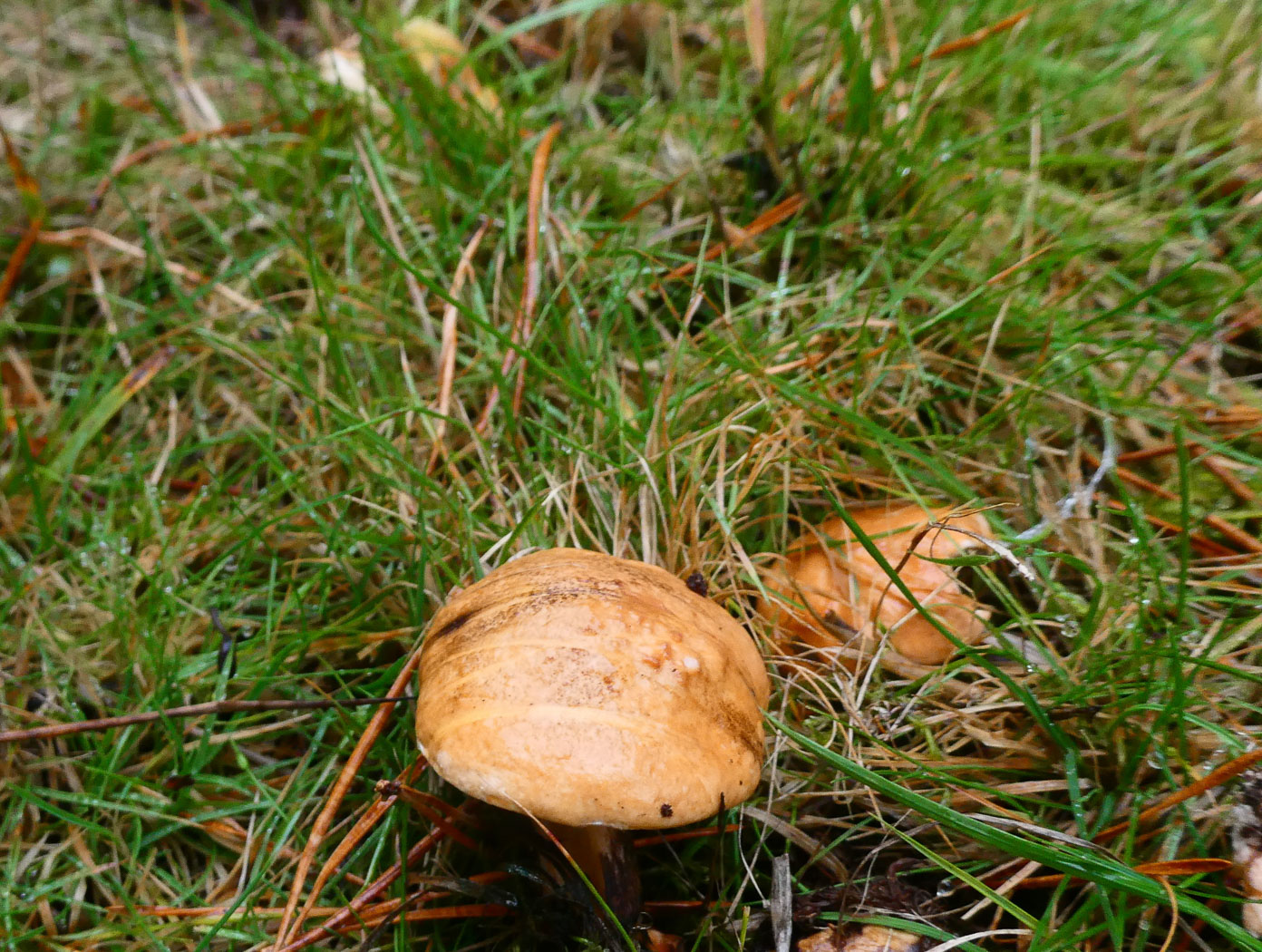
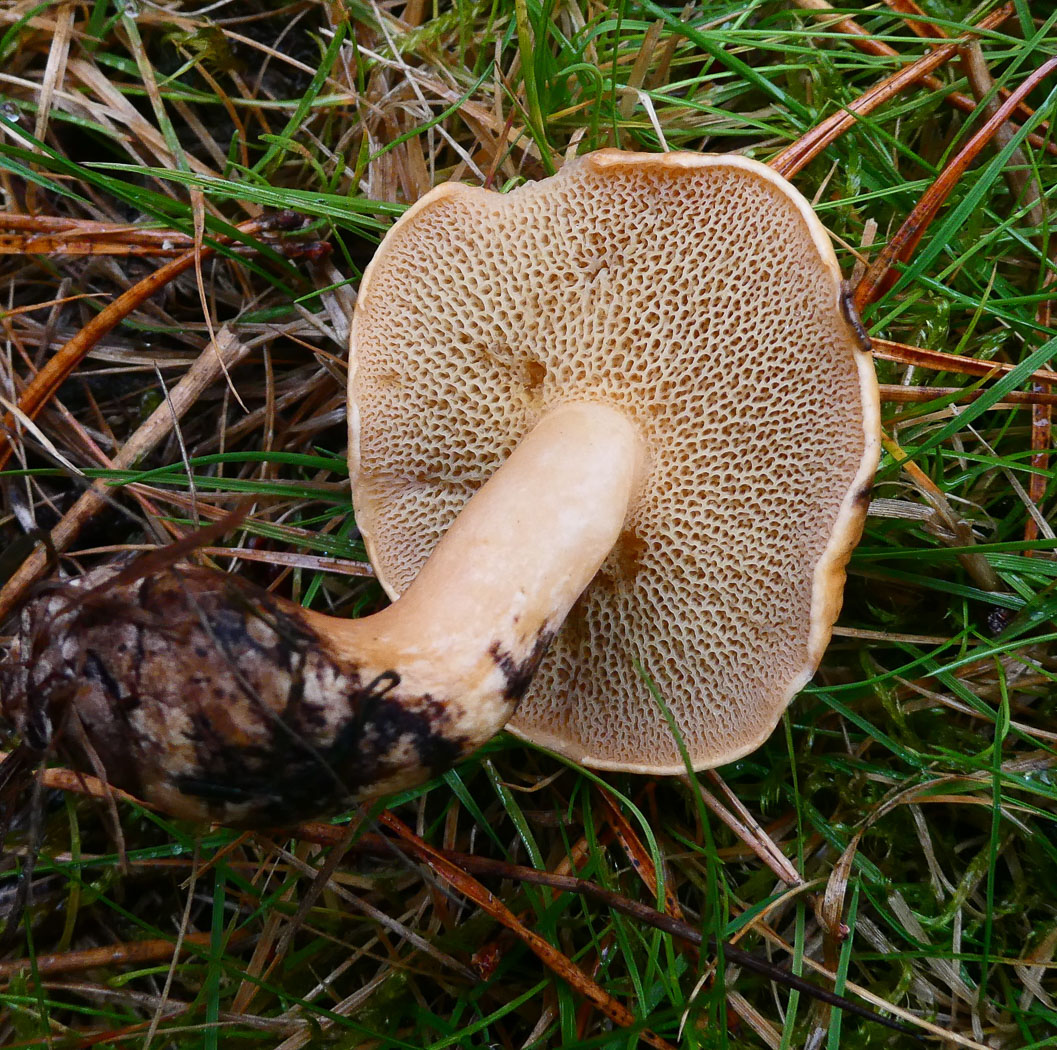 |
October 25th Suillus bovinus (Bovine Bolete) At Stoke Common under Pine Jim Wills found this pair, and picking one to turn it over found it to be somewhat sticky. This observation together with the presence of pores underneath placed it into genus Suillus; then at home the distinctive shape of the pores, the cap colour and occurrence under Pine all pointed to this species - one of the commonest wherever Pine occurs. If you find it do have a quick look around for the accompanying pink-red cap of Gomphidius roseus (Rosy Spike), a small gilled mushroom which associates with this particular bolete. Previous finds |
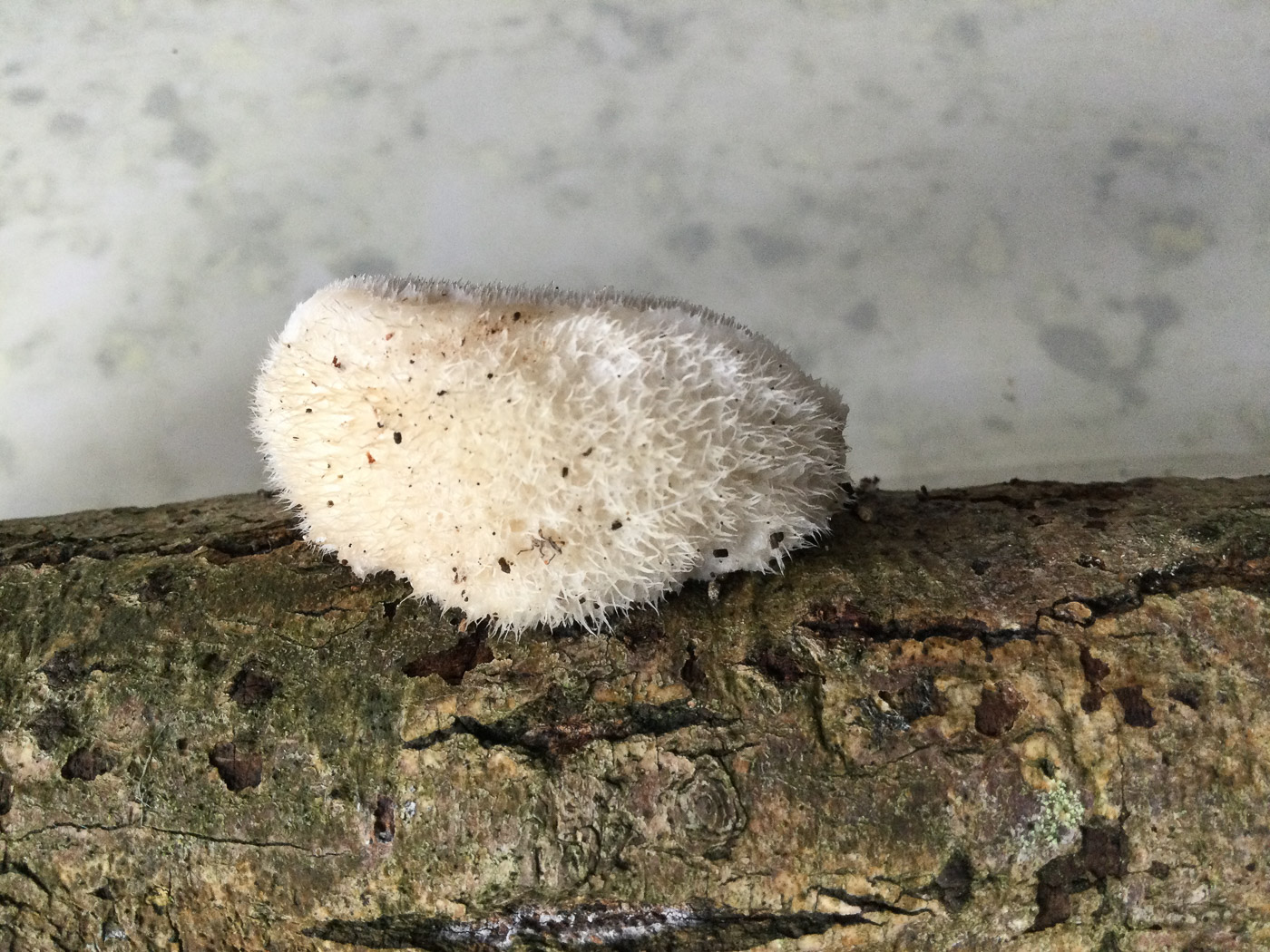
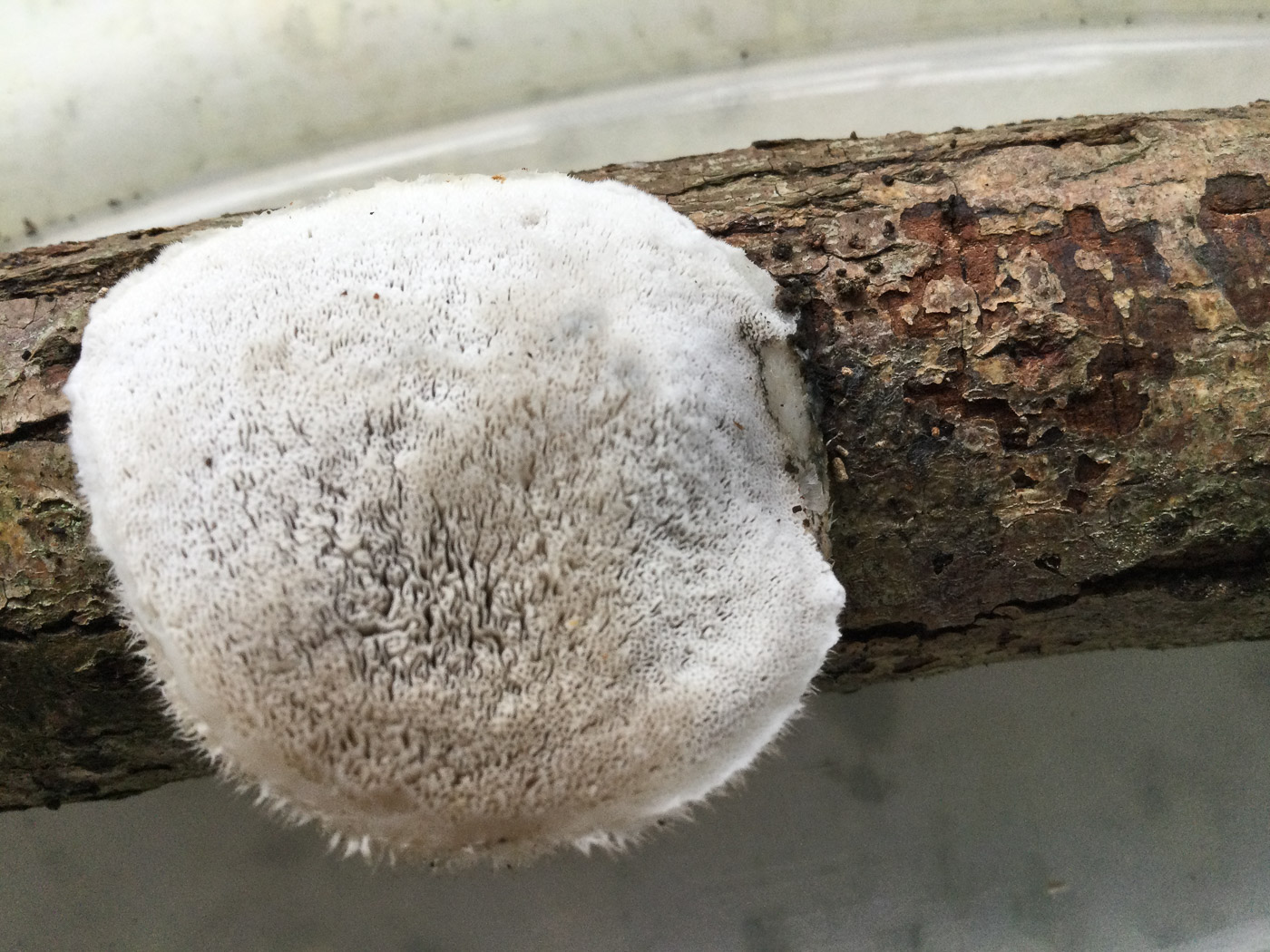 |
October 25th Postia ptychogaster (Powderpuff Bracket) At Little Marlow gravel pit David Corfield noticed these fluffy pompoms on fallen conifer, wondered what they could be and sent his photos to Mick Jones for any ideas. Mick was able to identify them and sent his photos on to Penny for confirmation. This is not a typical bracket - as is obvious from its appearance - but is the resting stage of the fungus when full of chlamydophores (asexual spores). However, it is rare to find this fungus in any other state! Previous finds |
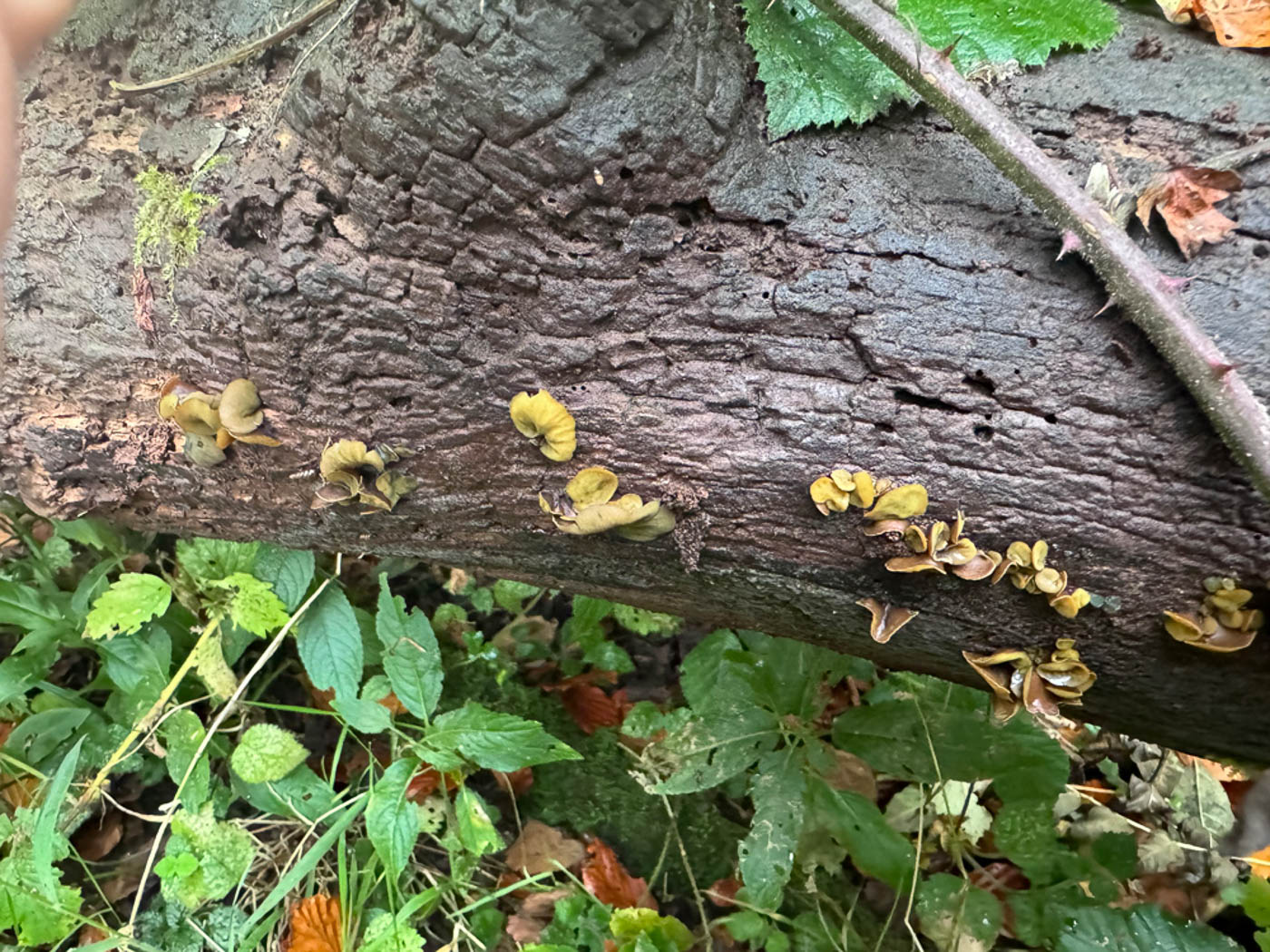
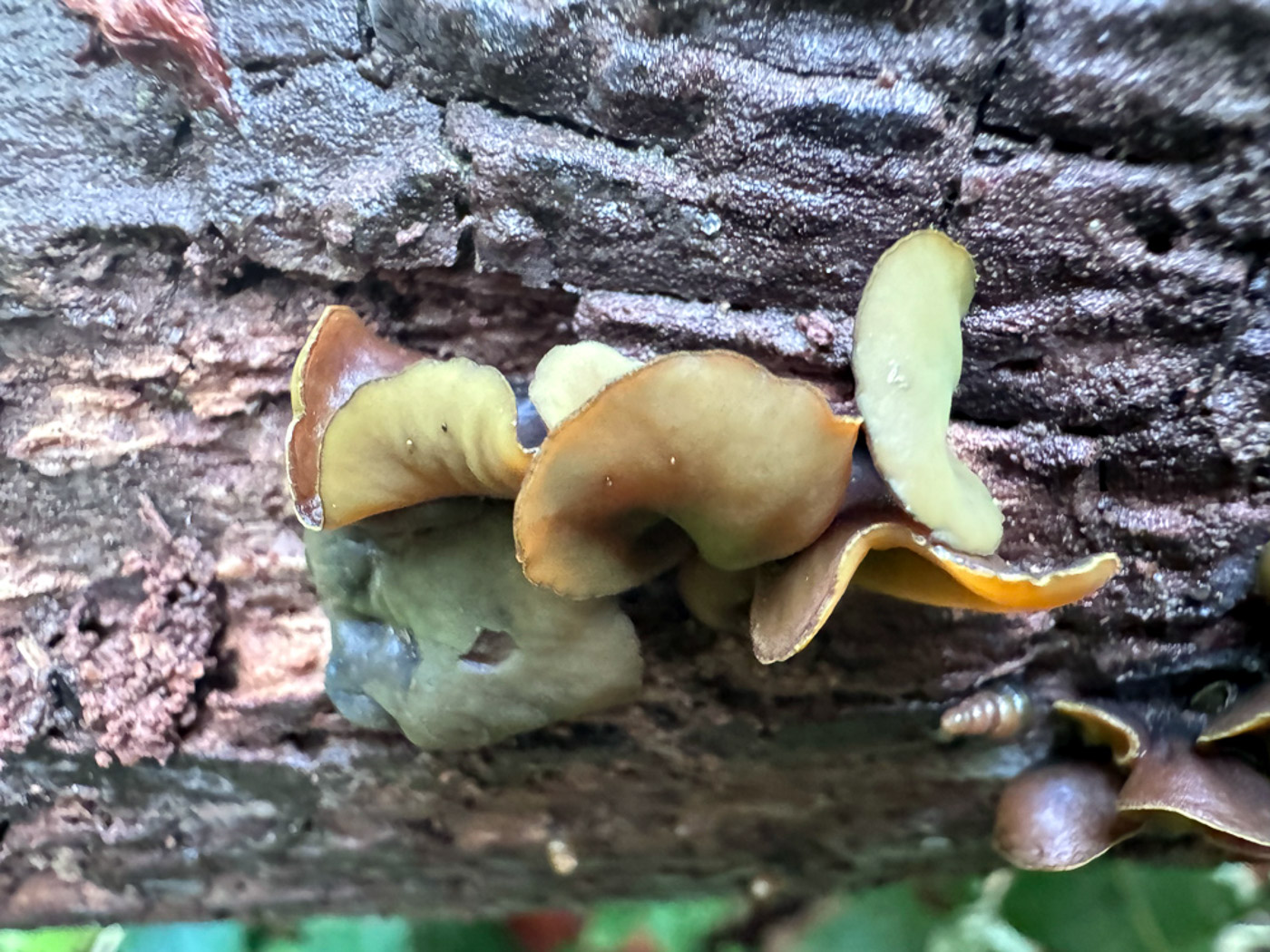
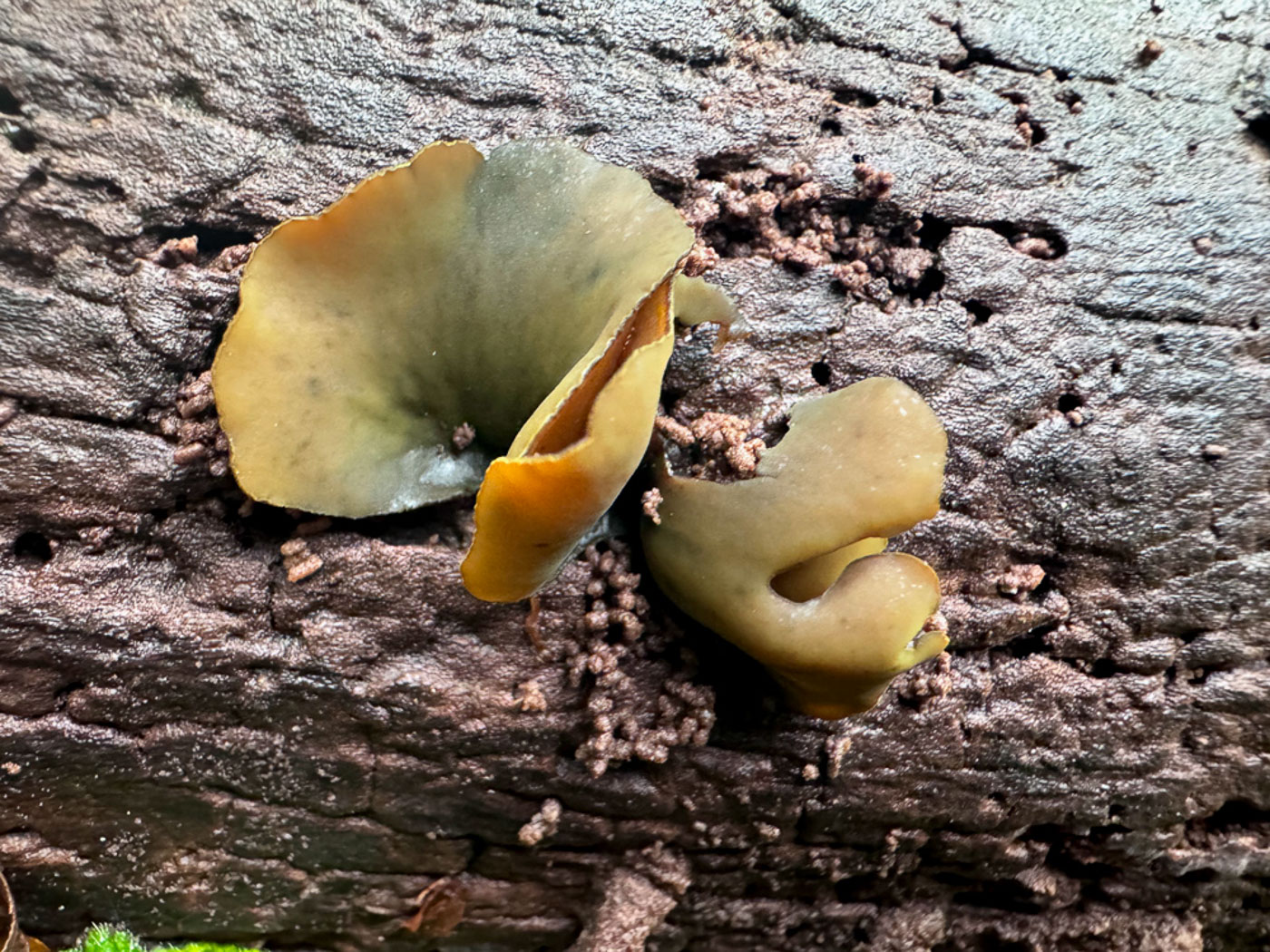
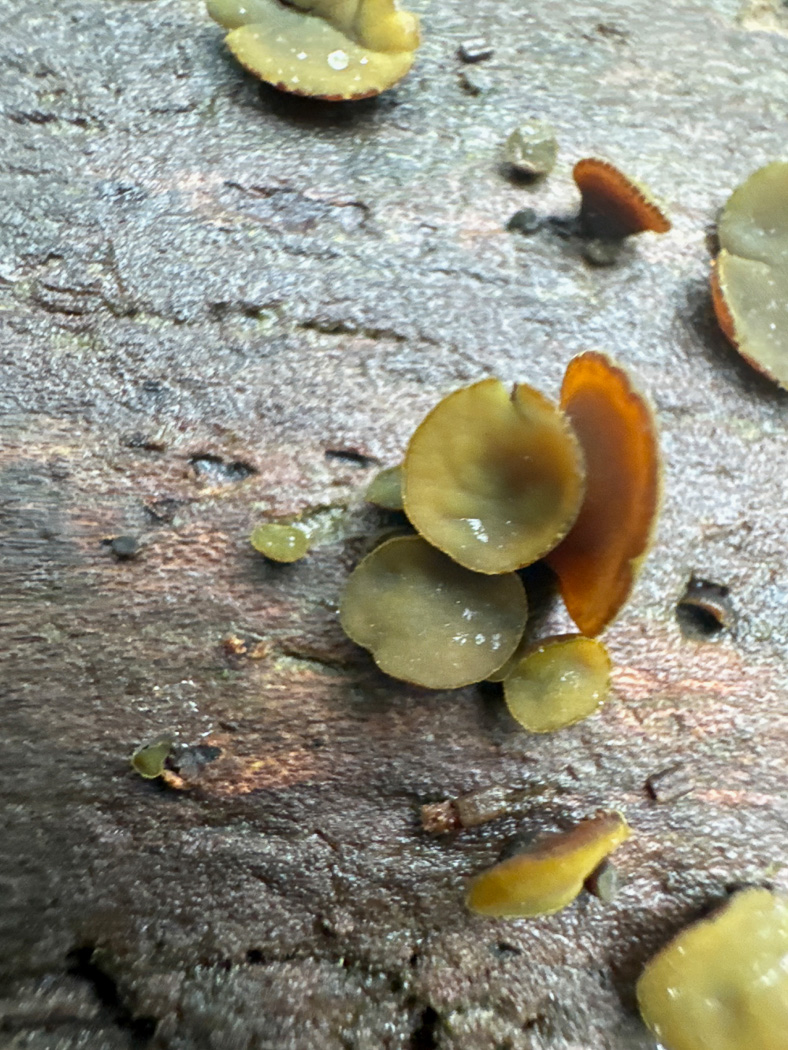 |
October 25th Chloroencoelia versiformis (an extremely rare cup fungus with no English name) In Stockfield Wood near Stokenchurch Jackie Newcombe noticed these olive green cup fungi on a rotting Ash trunk, the largest being about 2cm across. She struggled to find anything remotely like it in what books she had to hand but did find some images online which looked remarkably similar, though on discovering how rare the species was she doubted herself. On receiving her photos Penny, having never heard of this species, was equally dubious until finding further information both online and in Fungi of Temperate Europe (vol 2 p 1412). Despite the fact that this collection has not yet been checked microscopically she has no doubt from Jackie's images in in fact correct. The species has been included in provisional Red lists and has few UK records though has in recent years apparently been occurring in Sussex usually on rotten Ash as here. Maybe therefore it will become more common with the demise of Ash through Dieback disease. This was a significant find and is new to the county. Congratulations to Jackie for both finding and identifying it. The collection will be dried and sequenced. |
October 22nd 2024
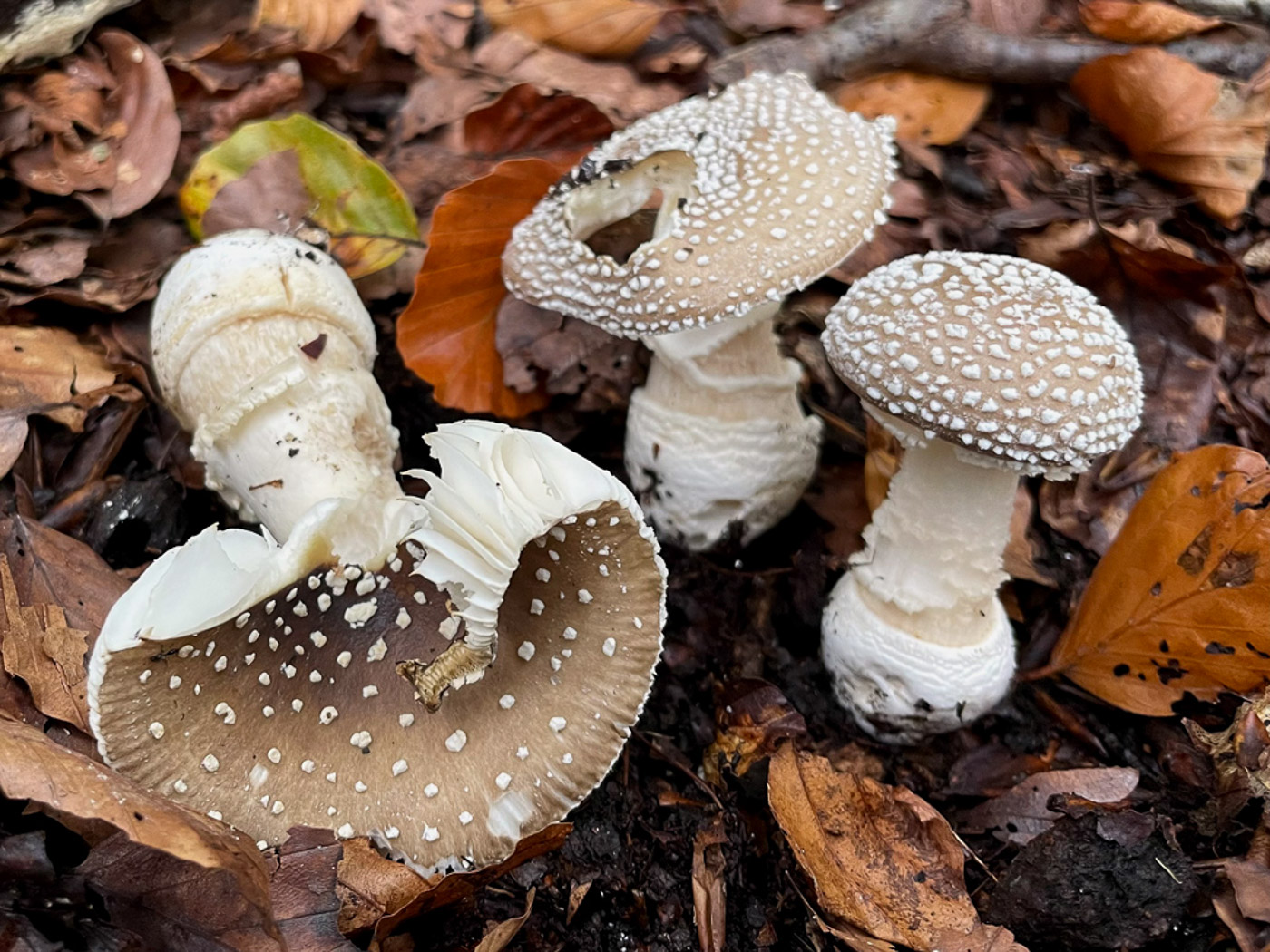
 |
October 22nd Amanita pantherina (Panther Cap) In Bradenham Woods Sarah Ebdon came across this unusual Amanita - particular unusual this year when the genus has been in surprisingly short supply. The combination of brown cap with small white (not grey) evenly spaced flecks of veil should separate it from other similar species, and for further confirmation check the stem above the ring and the upper ring surface, both of which are smooth and not striate. Previous finds |
October 21st 2024
October 20th 2024
October 19th 2024
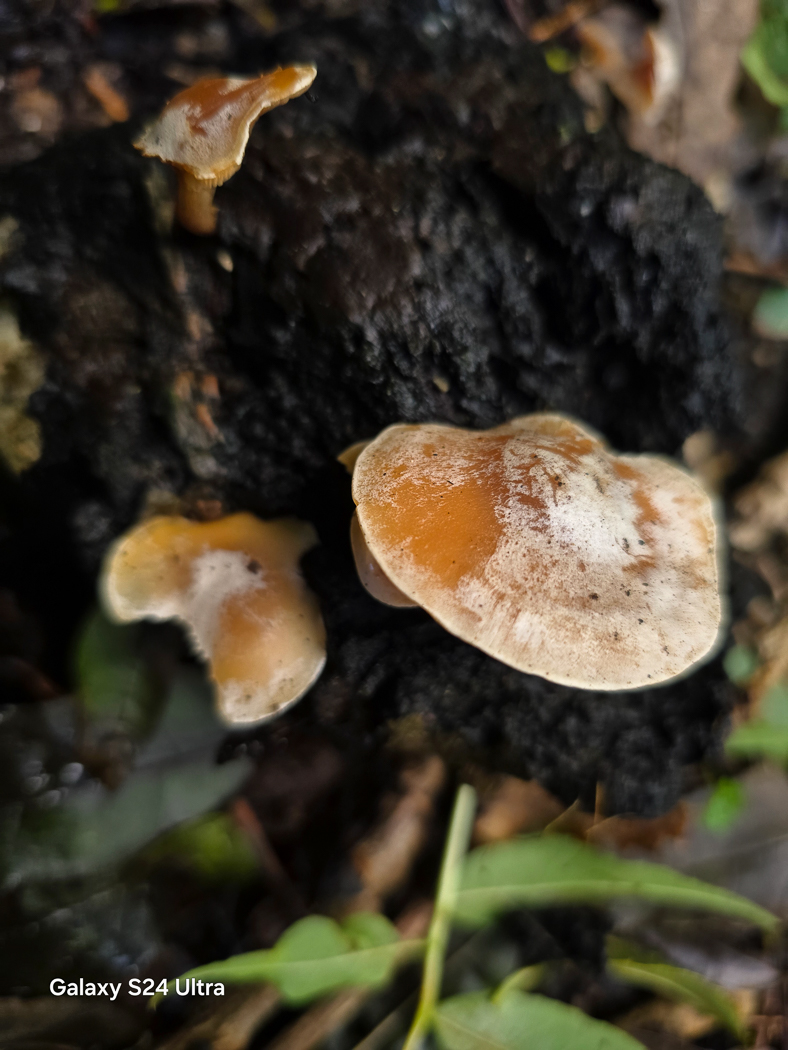
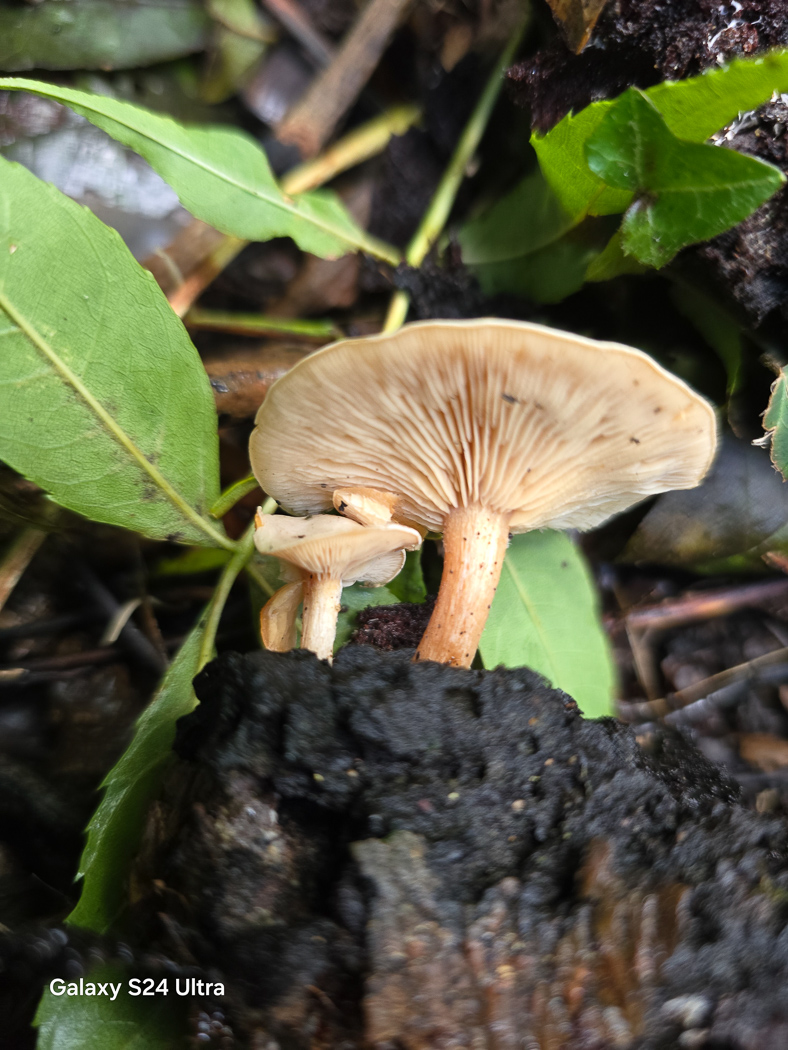
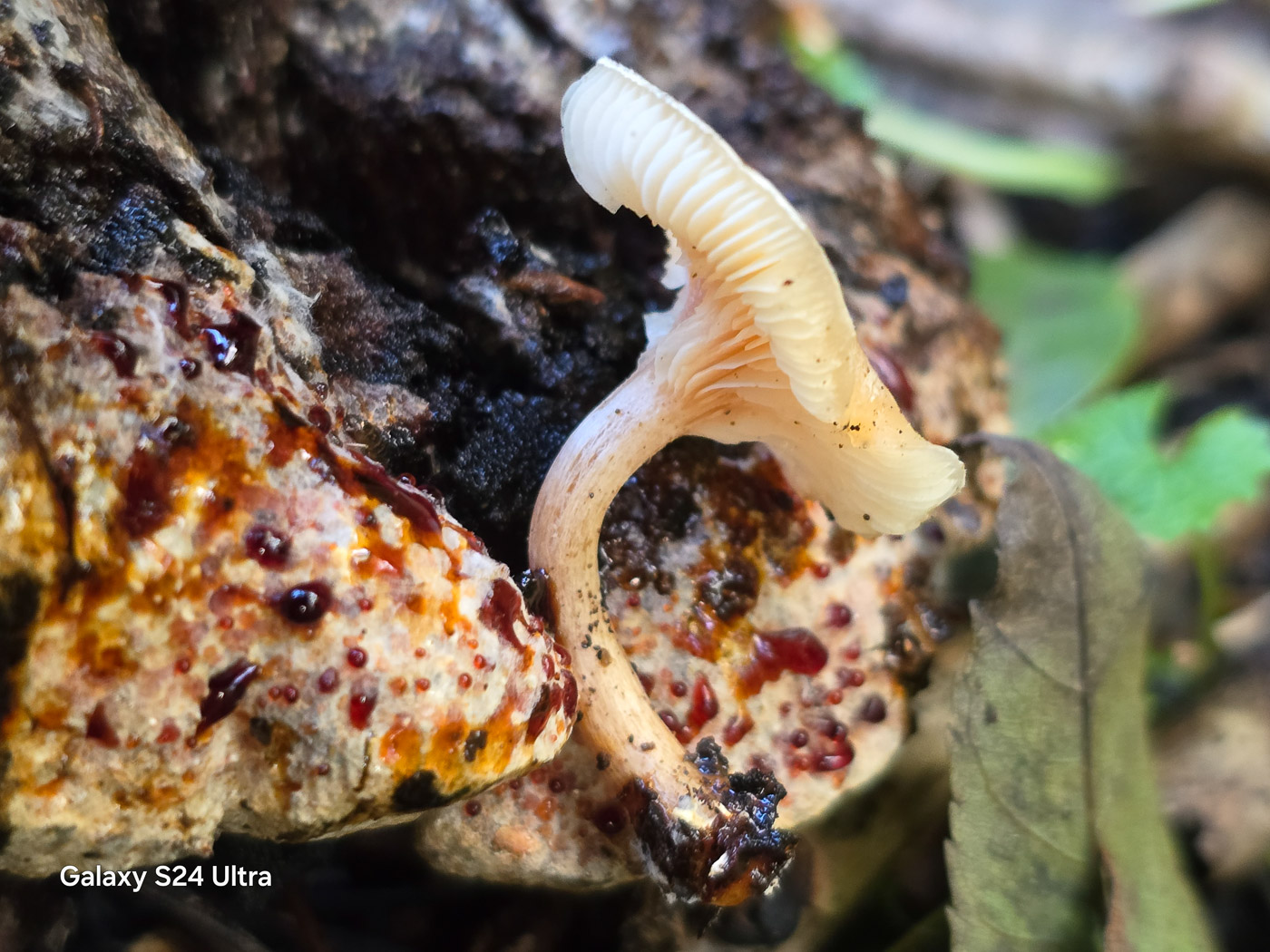 |
October 19th Clitocybe truncicola (Trunk Funnel) In a roadside verge near Denham Jesper Launder spotted this somewhat unusual mushroom which appeared to be fruiting on the remains of an old bracket. Nonplussed as to what it might be, he spent considerable time eventually arriving at this ID which apparently seems to fit well. The species has an earthy smell and grows on rotting wood (unusual for the genus) so presumably it was attaching to and getting nutrients from the wood through the old bracket. We have just one previous county record, so this was a significant find and the material will be sequenced. |
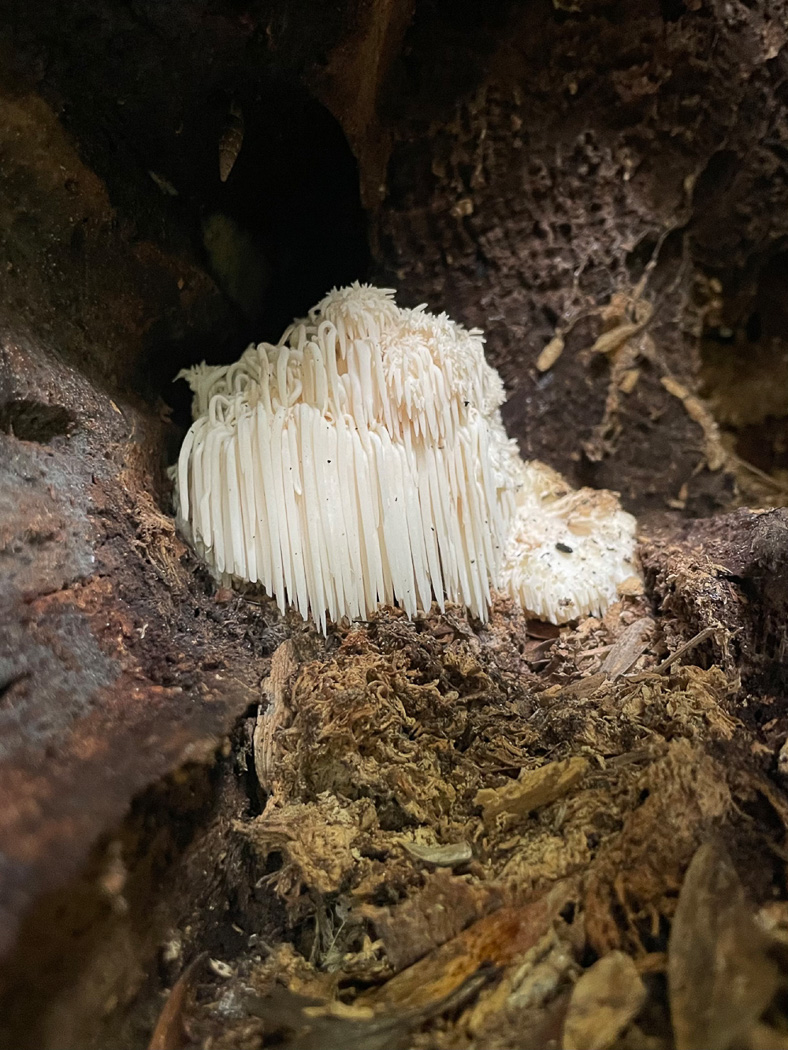
.jpg) |
October 19th Hericium erinaceus (Bearded Tooth) After information from a member of the public of a sighting of this rare species in the Bucks part of the Ashridge Estate, Sarah Ebdon went to investigate. She managed to find it though it was apparently still only a few cms across and inside a fallen rotting Beech trunk. This is a beautiful and special fungus, protected by law, and has probably been fruiting on this tree for several years though unnoticed. Hopefully it will continue to do so - this is an important find. Previous finds |
October 18th 2024
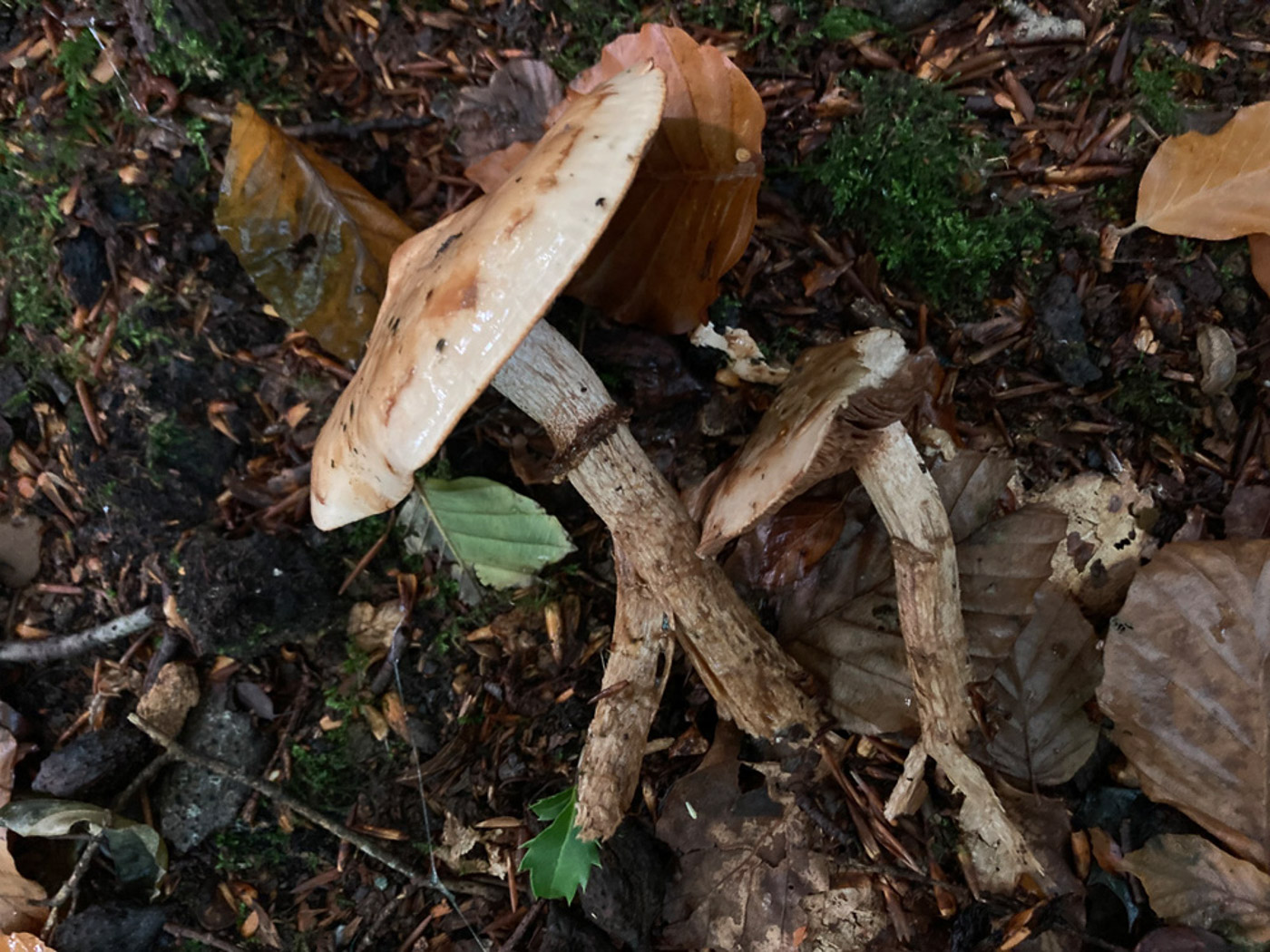
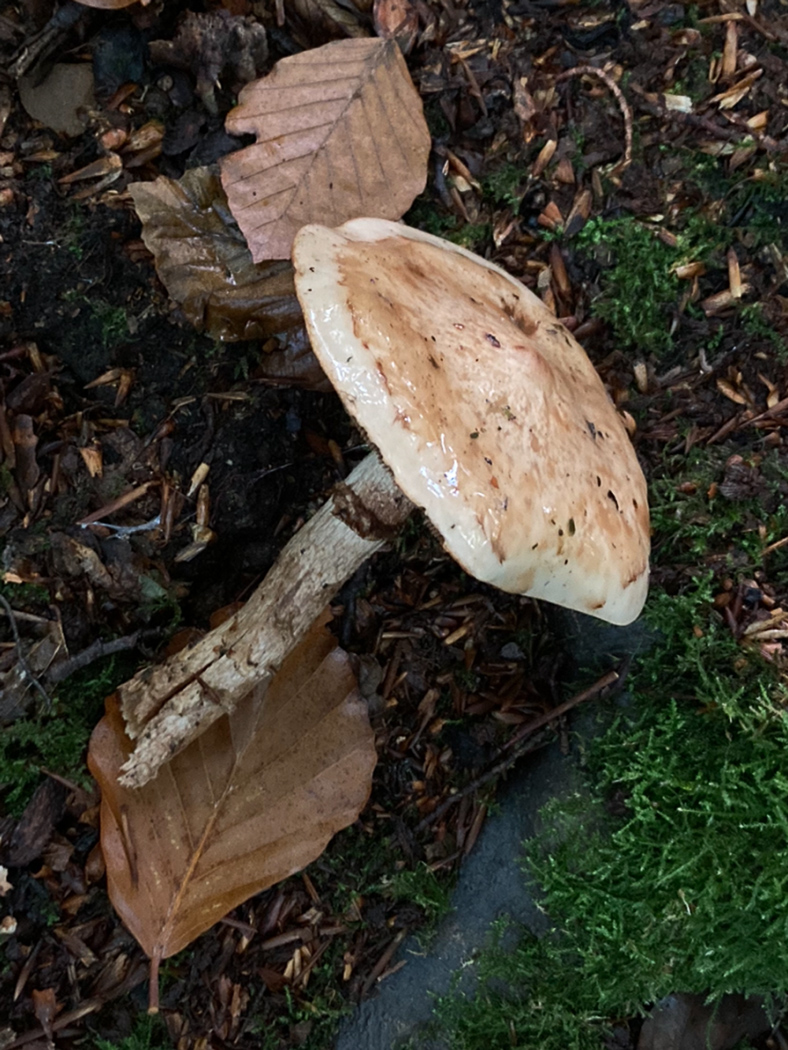
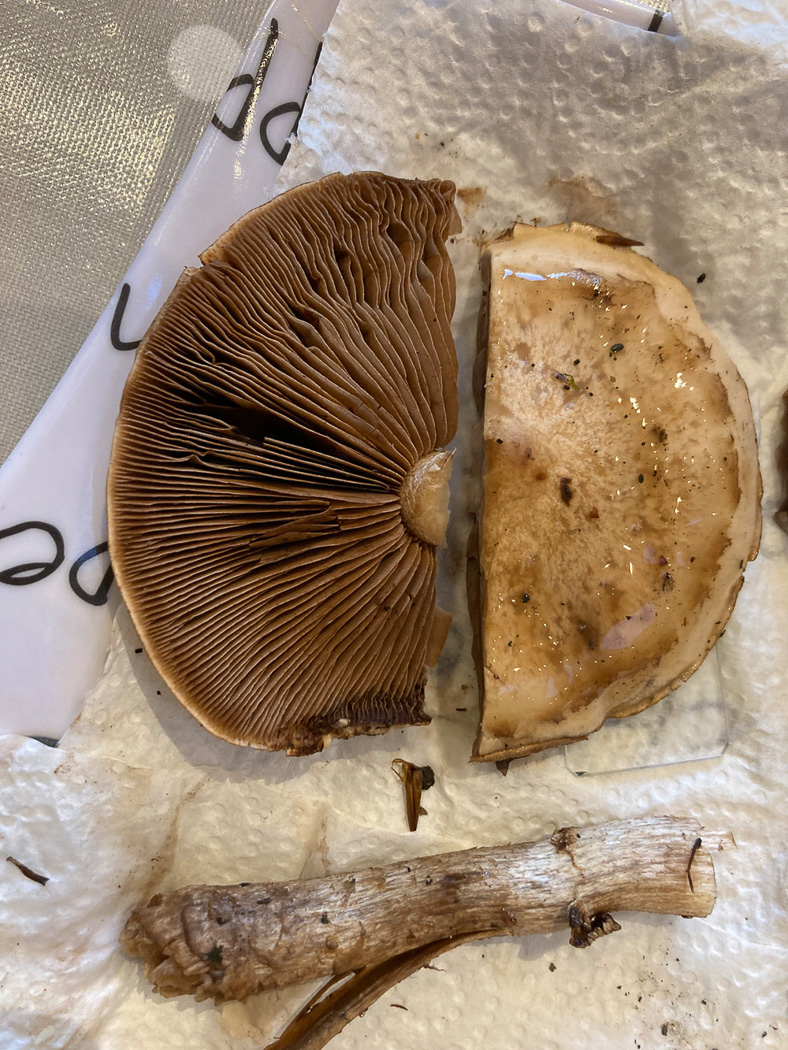 |
October 18th Hebeloma radicosum (Rooting Poisonpie) In Burnham Beeches Russell Ness found this quite large singleton, with cap about 7 cm across, which stumped him for identification at the time. He initially thought it might be a species of Pholiota, having a sticky cap, a ringed stem and found at the base of a Beech trunk, and it was not until spore colour and microscopic features together with the developing strong smell of marzipan were noted at home that he twigged what it was! This uncommon Hebeloma is unique amongst members of the genus in three ways: it has a ring on the stem, it roots deeply into its substrate and it has a distinctive marzipan smell. The least obvious of these features is probably the rooting stem which in older specimens is likely to snap off on collection and therefore be missed, especially if you don't know to check for it at the time - this is exactly what happened here! (Surely Marzipan Poisonpie would be a more apt name?) It is known that the root links to the latrines of voles and mice presumably supplying an extra source of nutrients. We have a handful of previous county records but this is a new entry for Finds. |
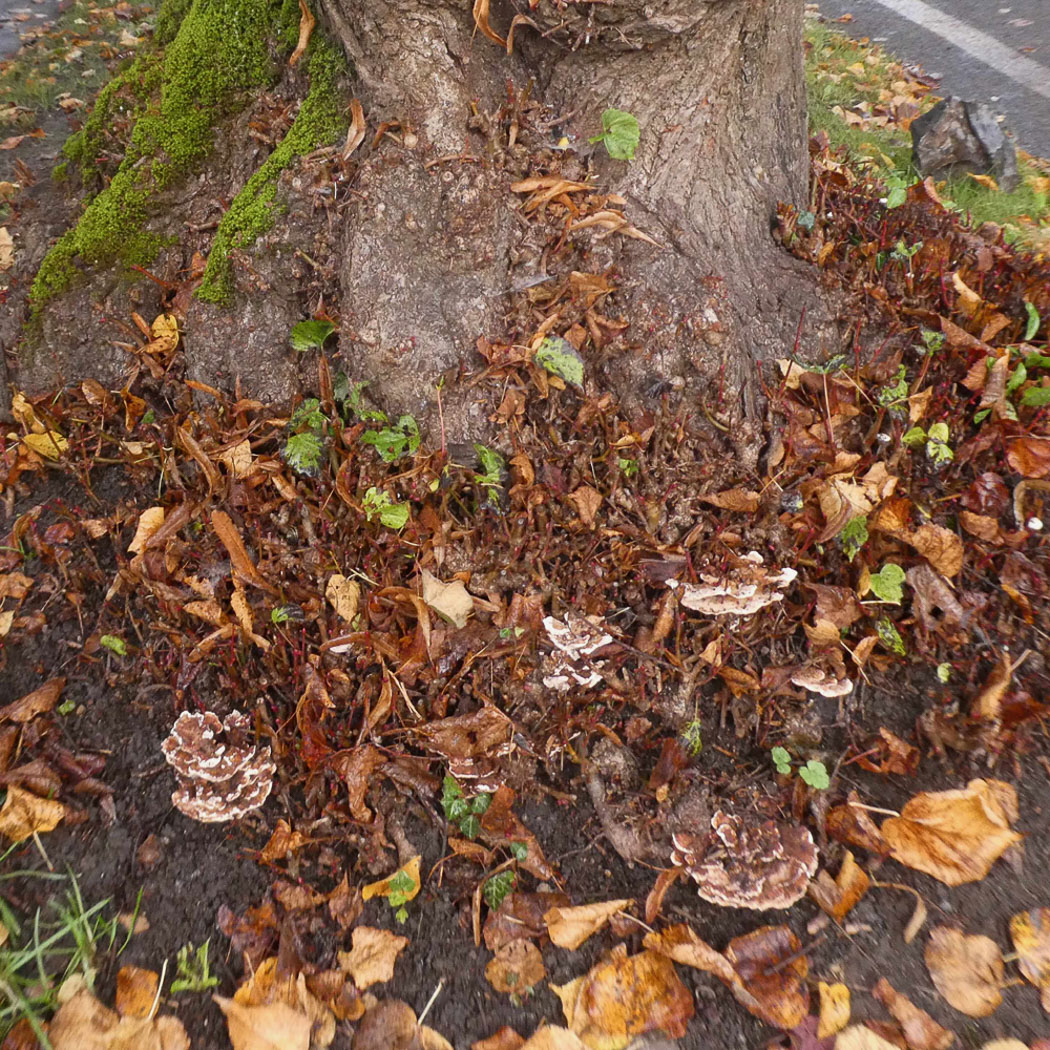
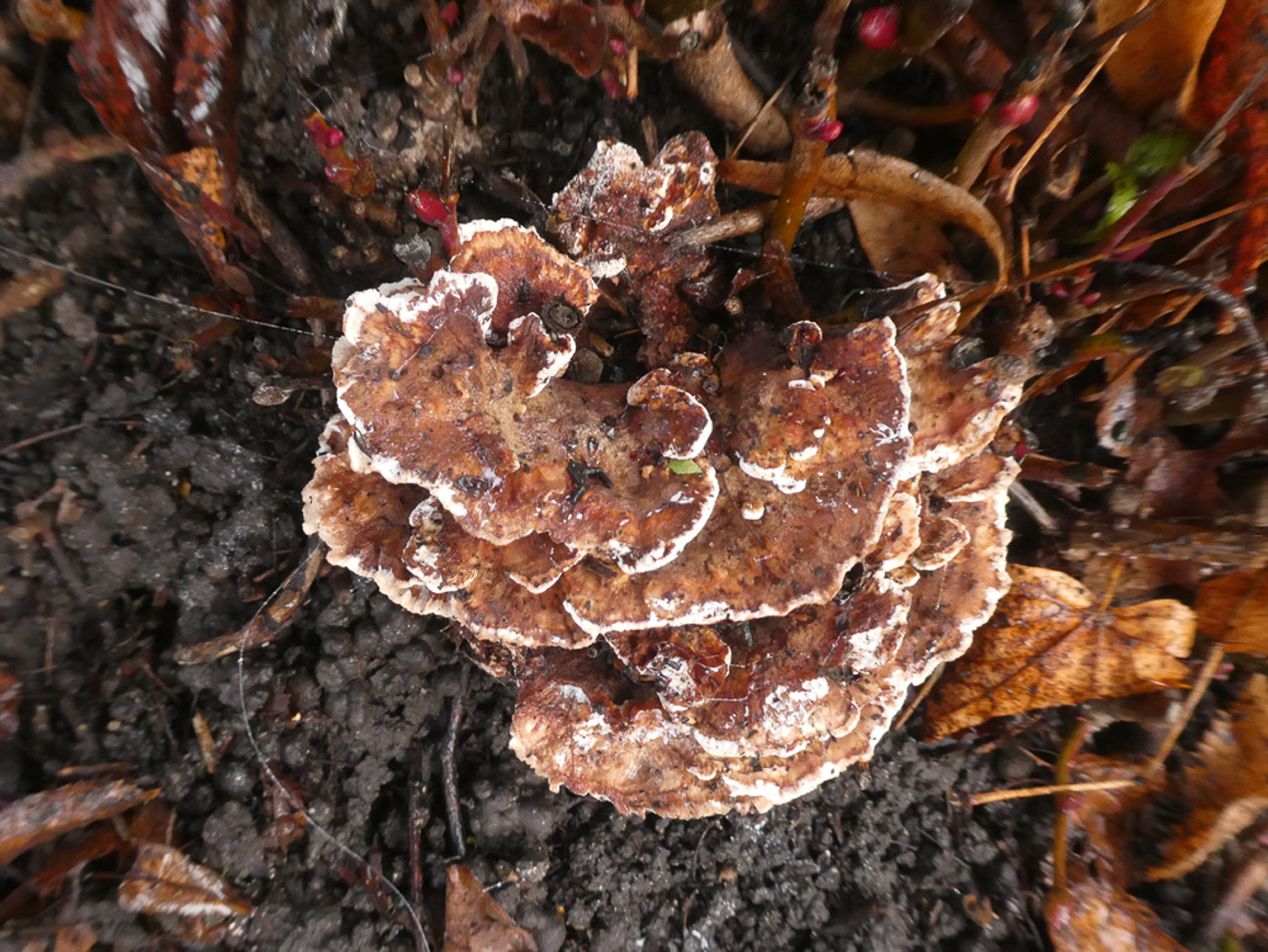
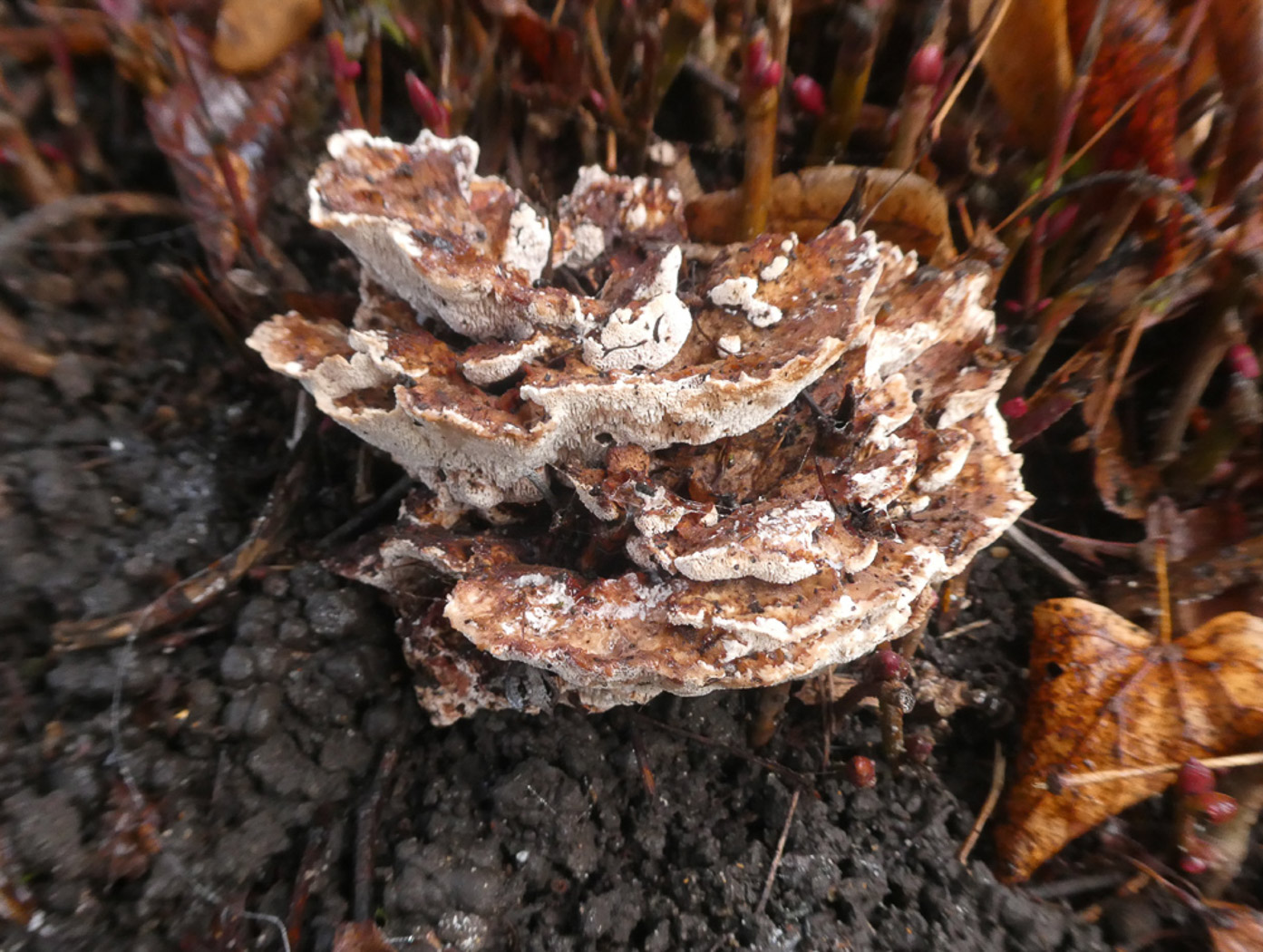
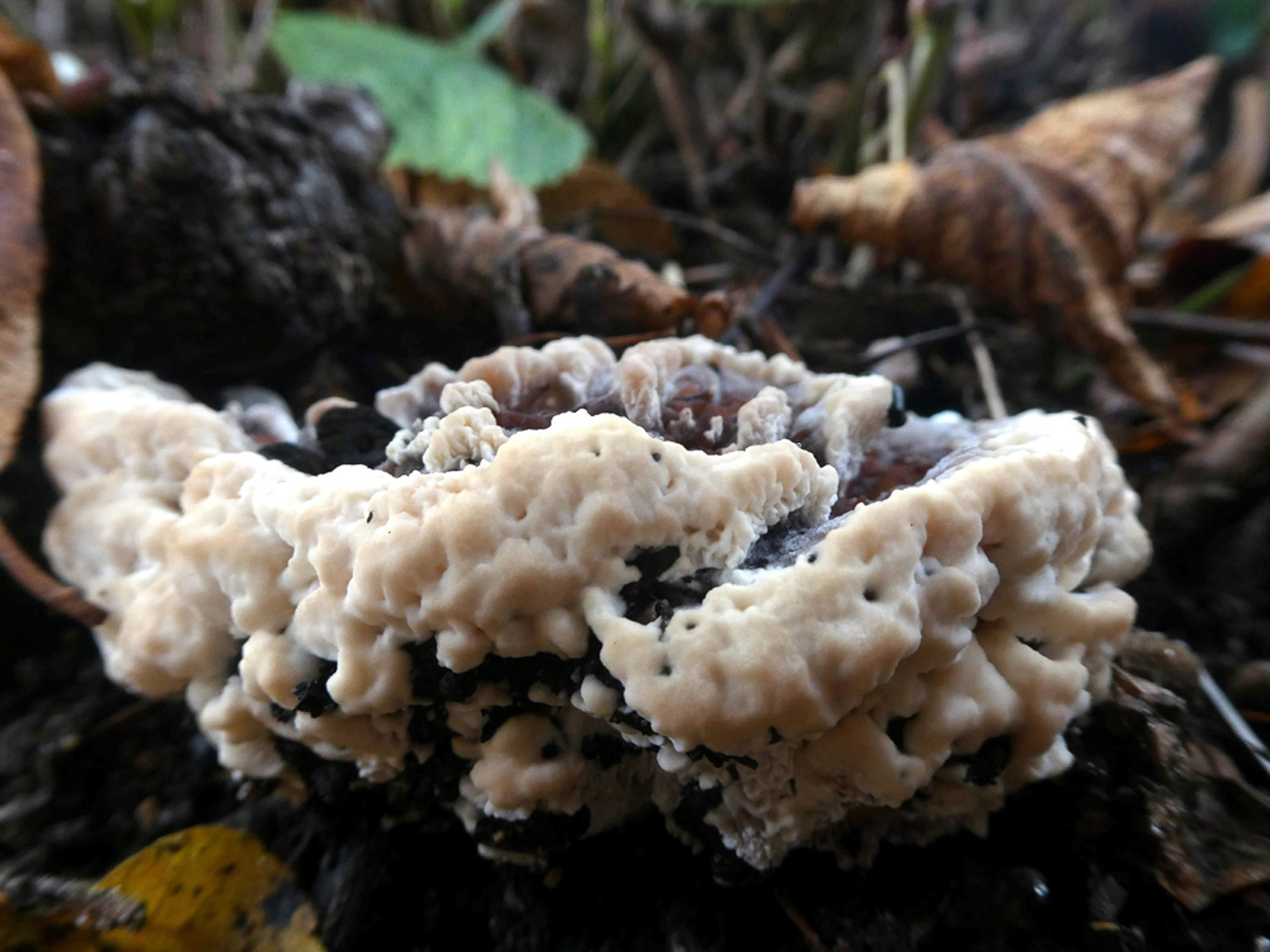 |
October 18th Abortiporus biennis (Blushing Rosette) At the base of a roadside Lime in Gerrards Cross Jim Wills spotted this species emerging a few weeks ago when undeveloped and looking odd, so then returned to see what it had turned into. This a species which confuses quite often, being mistaken for a hydnoid type having spines or teeth and particular when sporting red droplets (not seen in this example). It grows on fallen branches - when easier to recognise from the more obvious tiered rosette shape - but when on submerged roots as here, sometimes apparently on soil at a path edge, the pinkish rosette shape is often less defined. The pores are mazelike and bruise brown if pressed which can be a useful confirmation if in doubt. Previous finds |
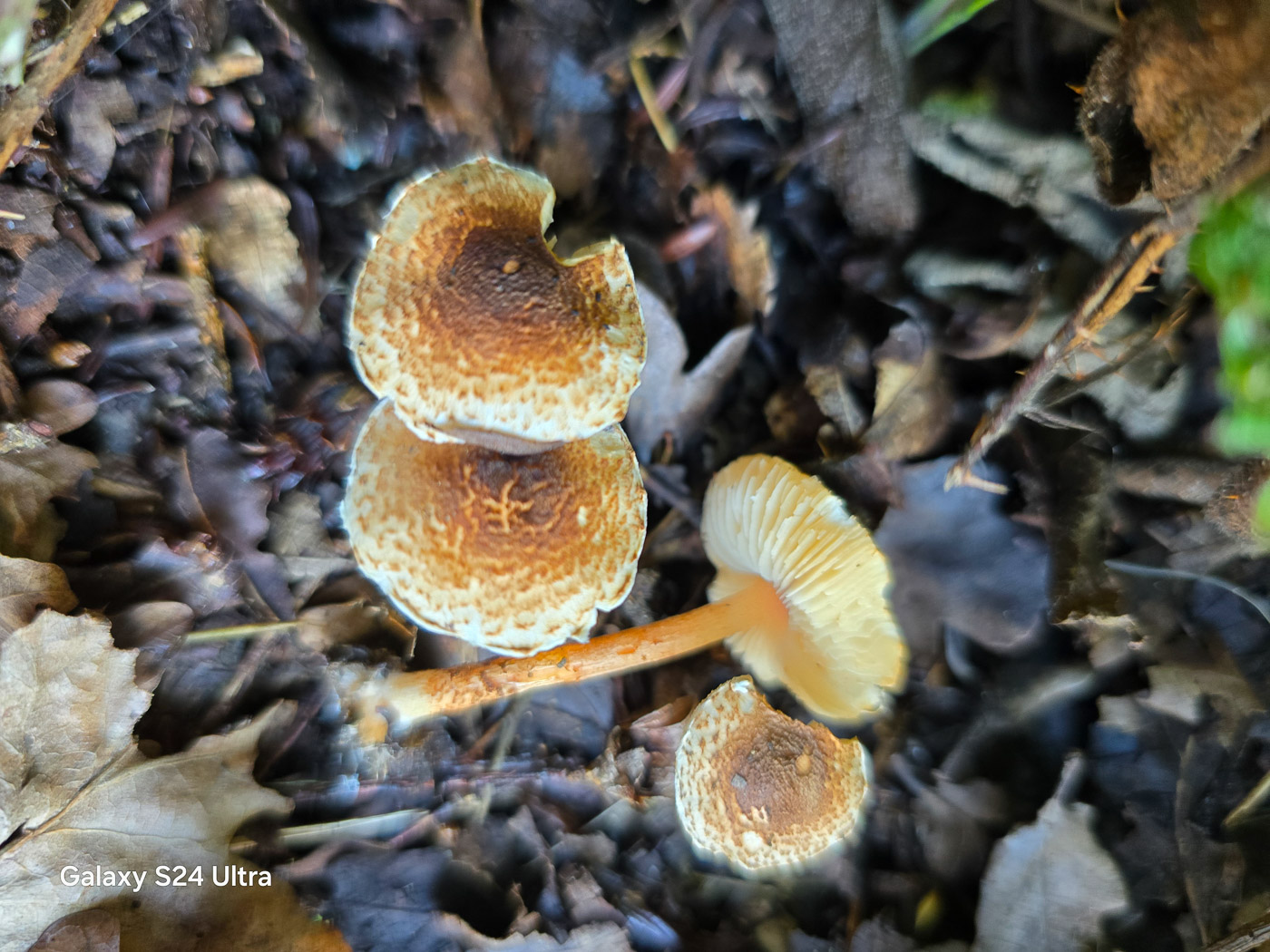 |
October 18th Lepiota castanea (Chestnut Dapperling) In Gerrards Cross Jesper Launder found this attractive species in litter. Similar to the much more common L. cristata (Stinking Dapperling) in size and shape, it not only lacks the smell of that species but has a thicker covering of small richer brown scales. Previous finds |
October 17th 2024
 |
October 17th Pluteus salicinus (Willow Shield) On fallen Willow at Burnham Beeches Russell Ness found this species of Shield, one can be fairly sure of in the field owing to its grey cap and smallish size compared to the much more common and browner P. cervinus (Deer Shield). However, the cap colour can sometimes be intermediate between the two species so a microscopic check is always recommended. They both share the same cystidia topped with 'cats' ears but the cuticle hyphae - clamped in today's species but unclamped in P. cervinus - are the definitive test. Though Russell found it on Willow today, it is just as common on other deciduous fallen woods despite its English name. Previous finds |
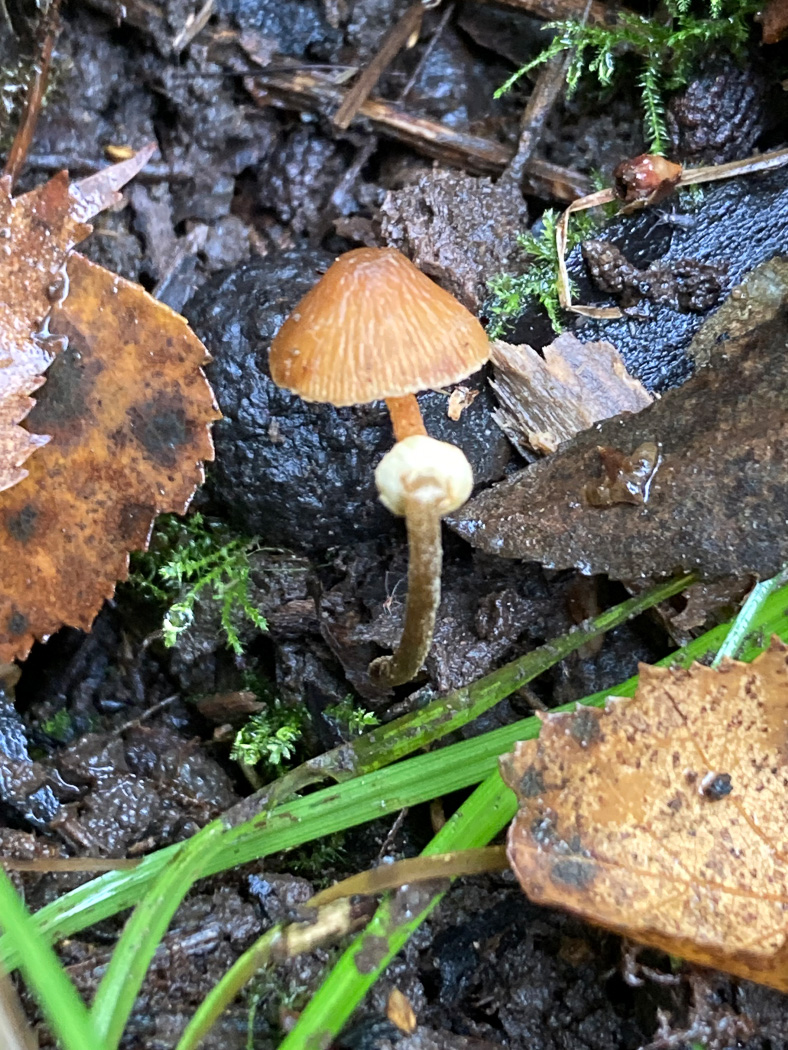 |
October 17th Pholiotina rugosa (Wrinkled Conecap) At Burnham Beeches Russell Ness spotting this small LBJ in woody debris and noting the distinctive ring on the stem instantly knew from which genus it belonged. The presence of a ring conveniently eliminates a whole range of similar LBJs, cutting the number of contenders down to around 7 species in genus Pholiotina - previously part of genus Conocybe with which it still shares the English genus name Conecap. Microscopic features are key here but a good clue to P. rugosa in the field is the faintly veined or grooved cap surface (clearly visible here) and the ring which is rather lower down the stem than in most other ringed mushrooms. Previous finds |
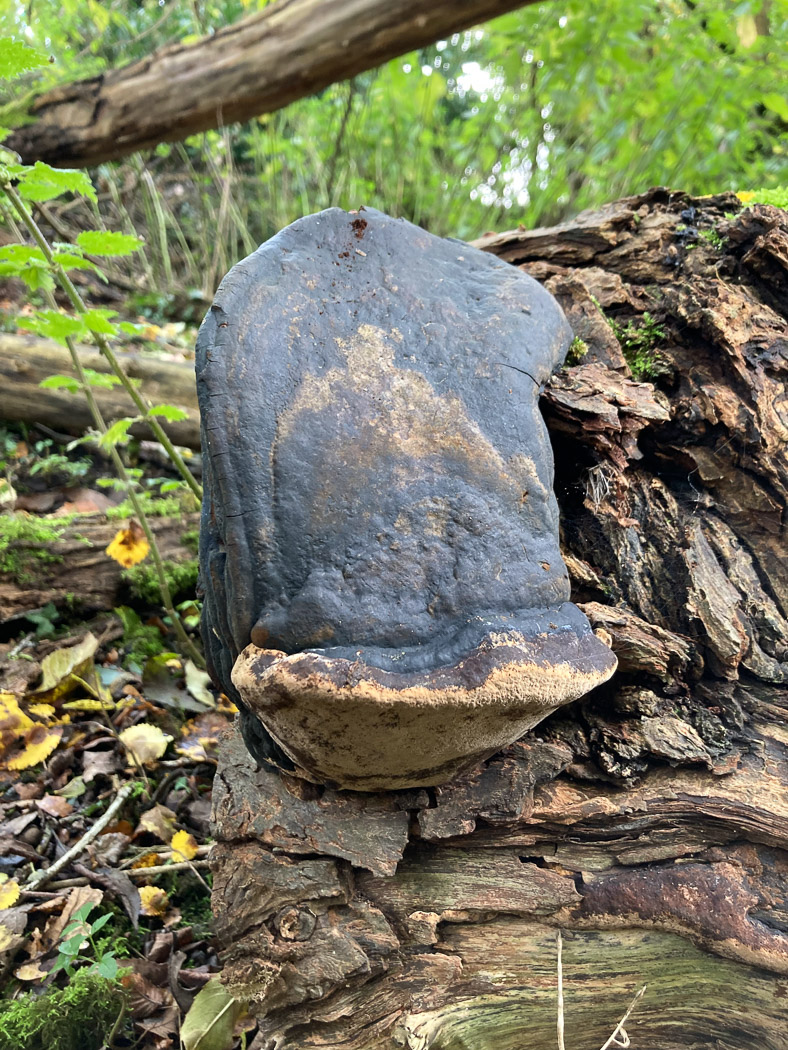
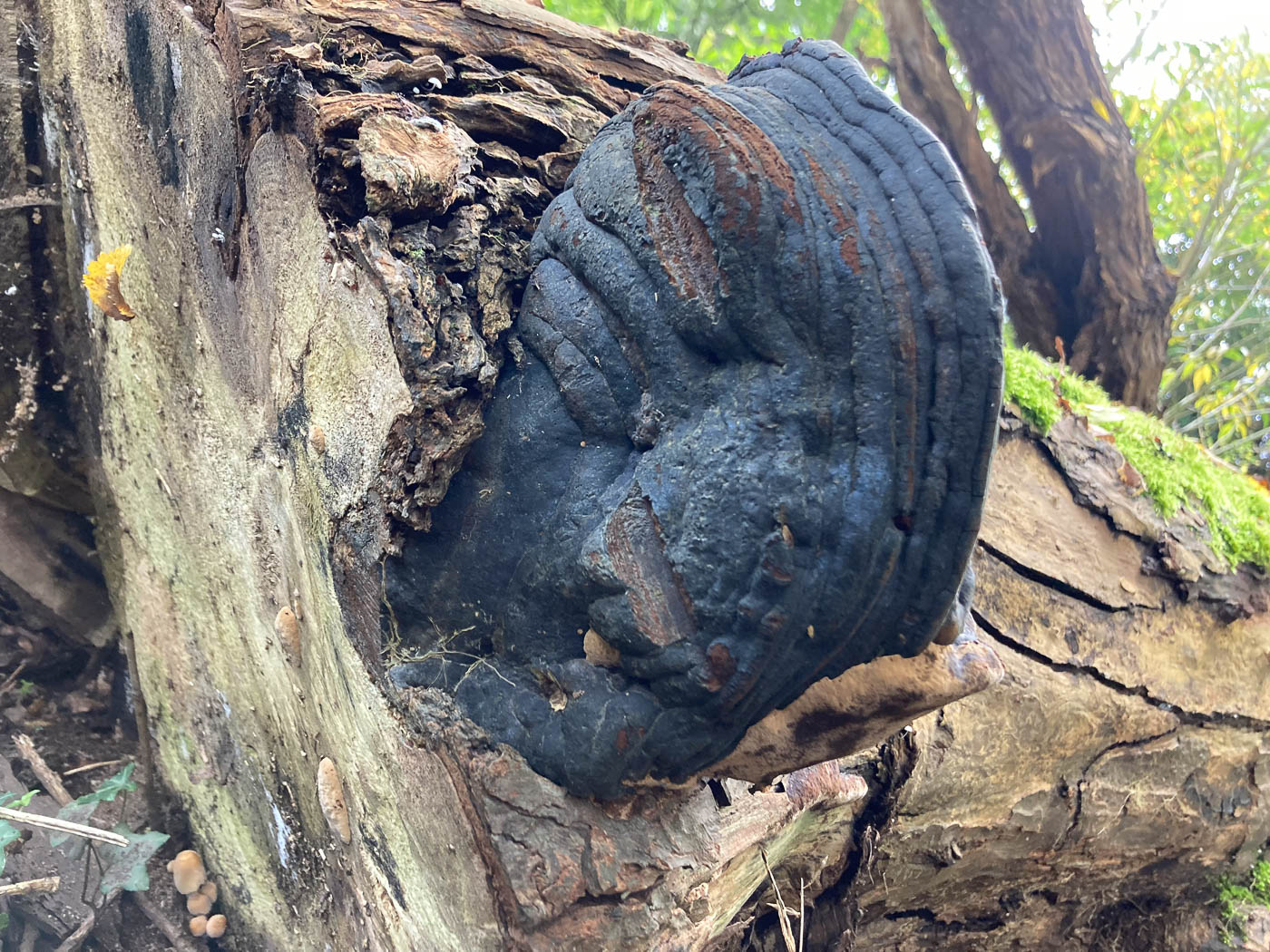 |
October 17th Phellinus igniarius (Willow Bracket) In Burnham Beeches Russell Ness noticed a couple of these solid hooflike brackets on Willow, took his photos then researched at home to discover its identity. Superficially similar to Fomes fomentarius (Hoof Fungus) - now becoming quite common at this site but only occurring on Birch - this is another large perennial species which favours Willow and here was clearly well established on a Willow which had fallen but was continuing to support the fungus. Though there are plenty of UK records we have only one previous county record dating from 1978 in Denham where found by the well-known natural history author Roger Phillips and identified by Derek Reid, then president of the BMS. So Russell is in good company! |
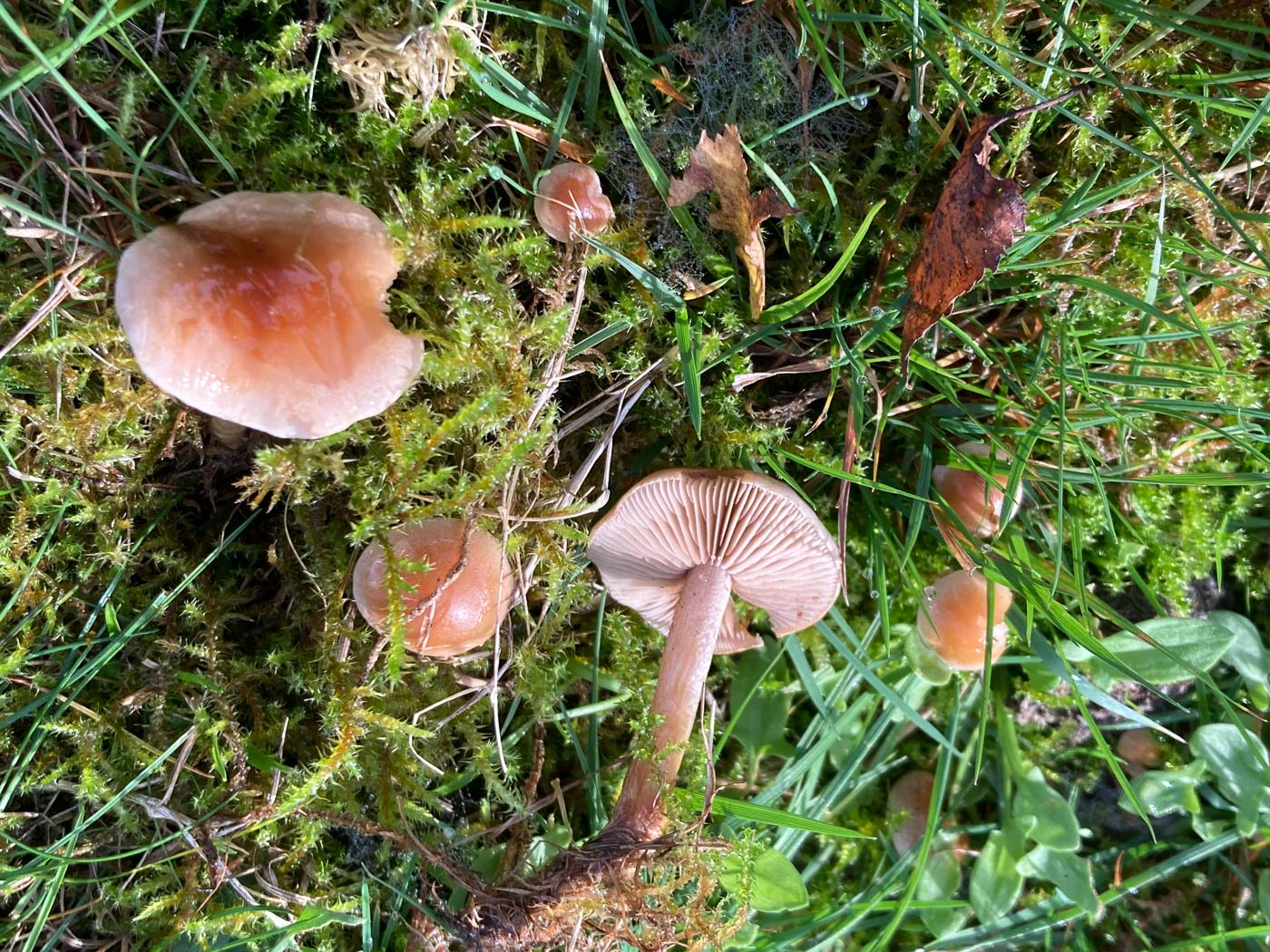
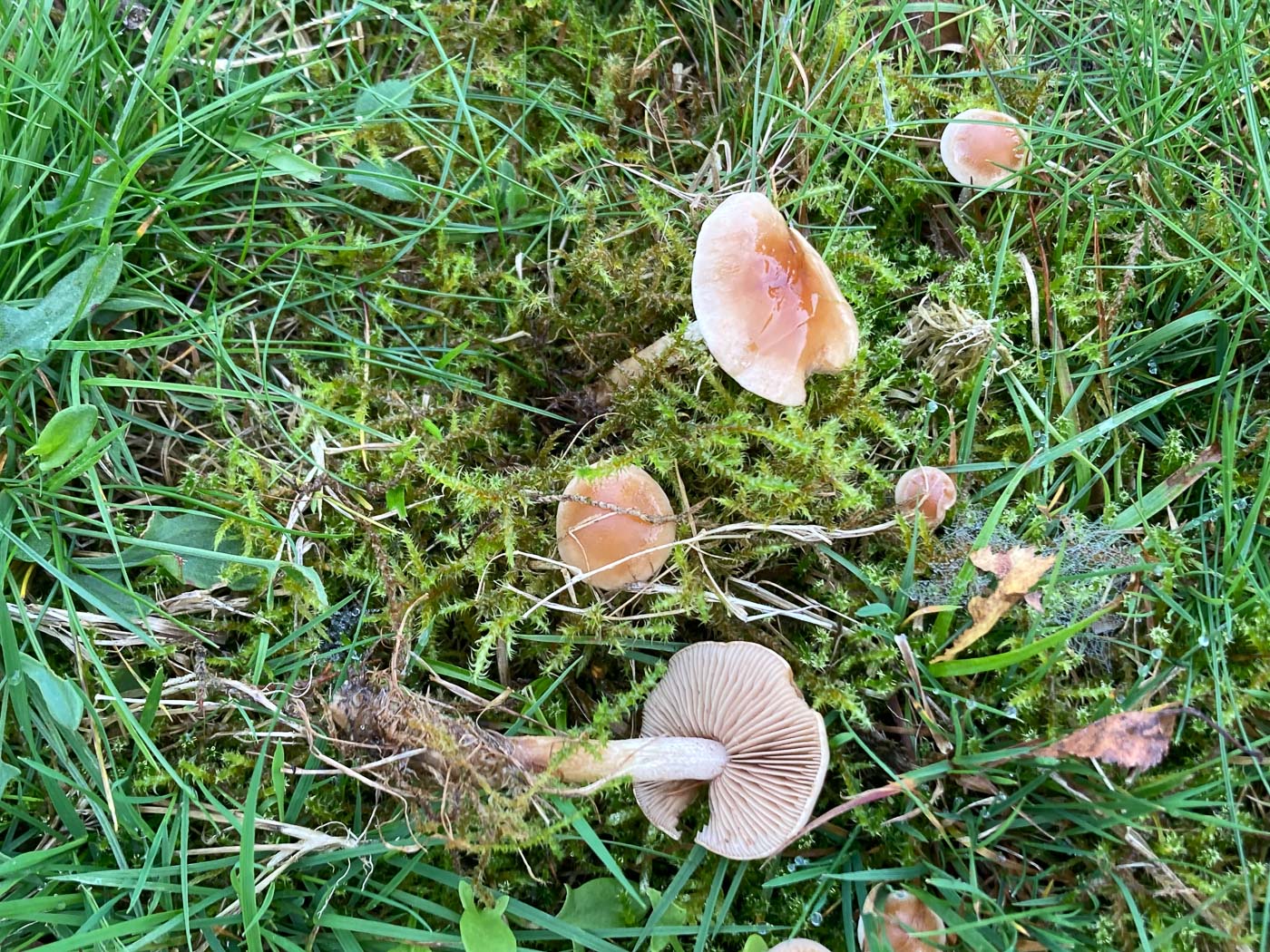 |
October 17th Hebeloma birrus (a species of Poisonpie with no English name) At Burnham Beeches in grassy soil under deciduous trees Russell Ness found a group of this Poisonpie which is quite common locally and usually has a clearly twotone cap which dark centre and pale rim. However all members of this tricky genus need identification using a scope. They have moist to sticky caps and most have a sharp radish smell though a few have a sweet burnt sugar smell and today's species has a faint component of cocoa especially in contained in a covered pot after collection. Previous finds |
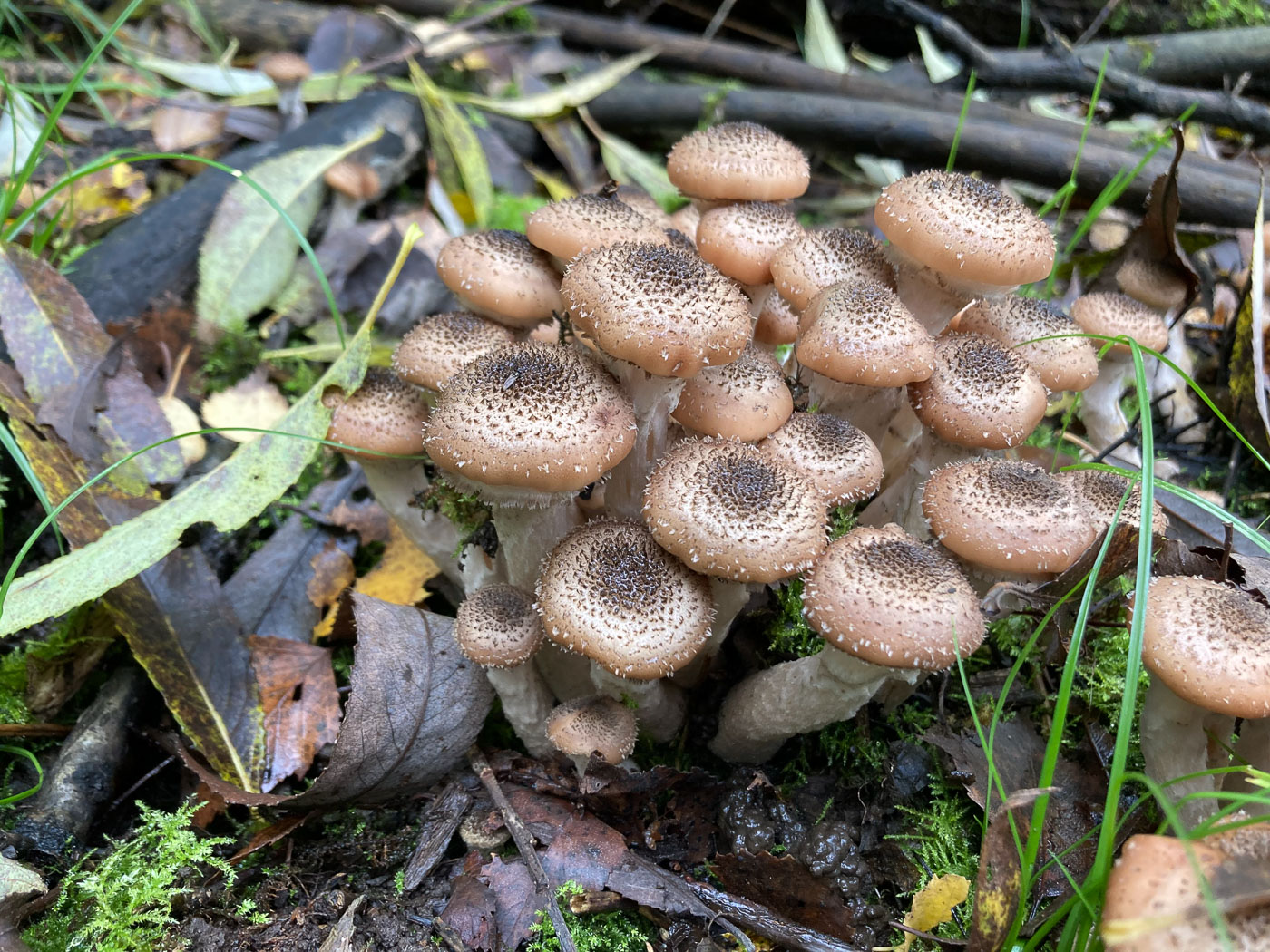 |
October 17th Armillaria ostoyae (Dark Honey Fungus) At Burnham Beeches Russell Ness found this nice fresh clump just emerging on some mossy wood. The species is much less common than A. mellea (Honey Fungus) and A. gallica (Bulbous Honey Fungus) and often described as occurring on conifer but we certainly find it on deciduous wood locally. Not developed or visible here on this immature material is the typical dark brown markings on the base of the stem ring which help to separate it from the other contenders. Previous finds |
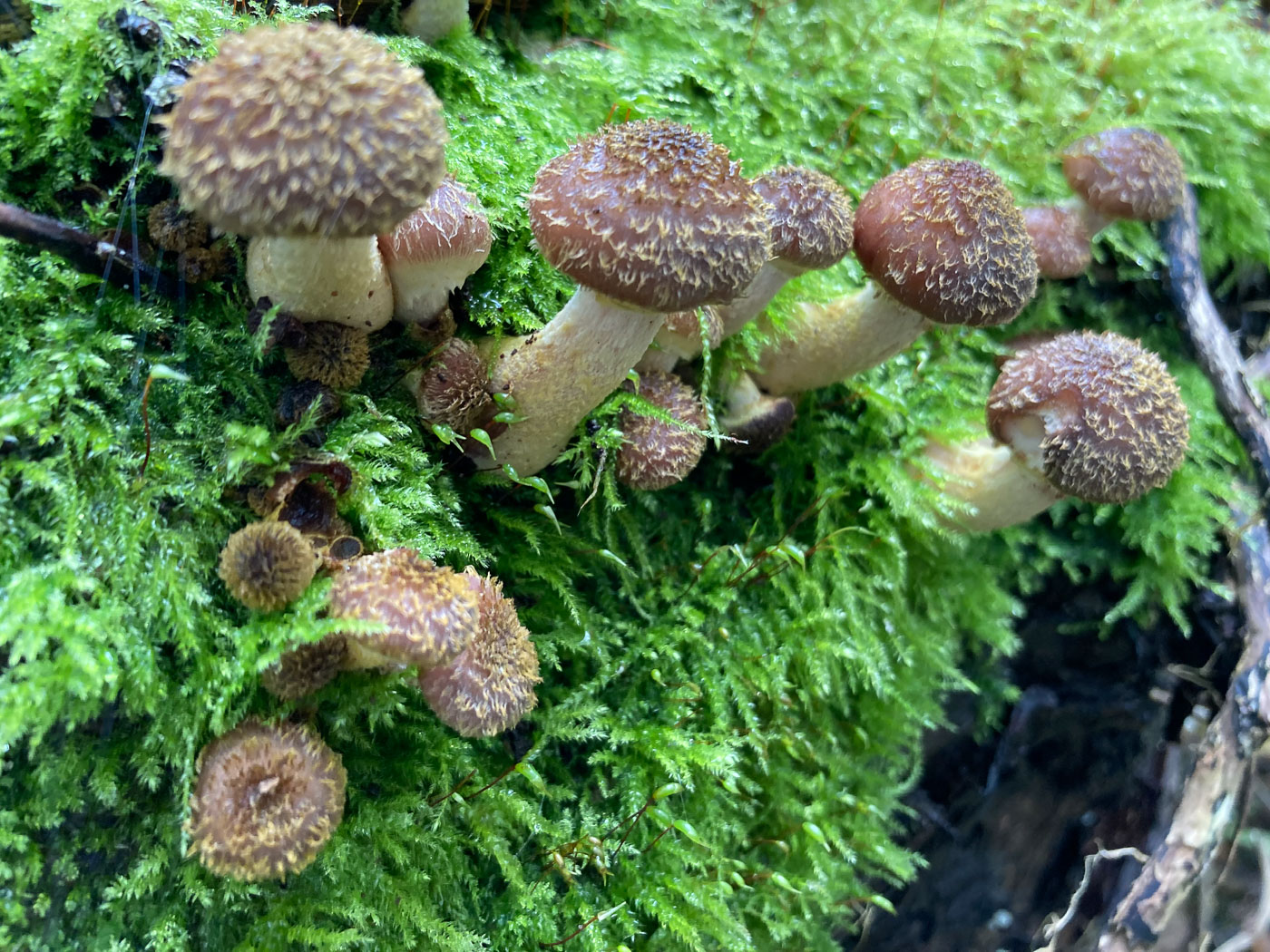 |
October 17th Armillaria gallica (Bulbous Honey Fungus) At Burnham Beeches Russell Ness found this nice fresh clump just emerging on some mossy wood. This is perhaps the commonest species of Honey Fungus locally, separated from A. mellea (Honey fungus) by its thickened stem base which develops a yellow tinge (not yet visible here, however). Previous finds |
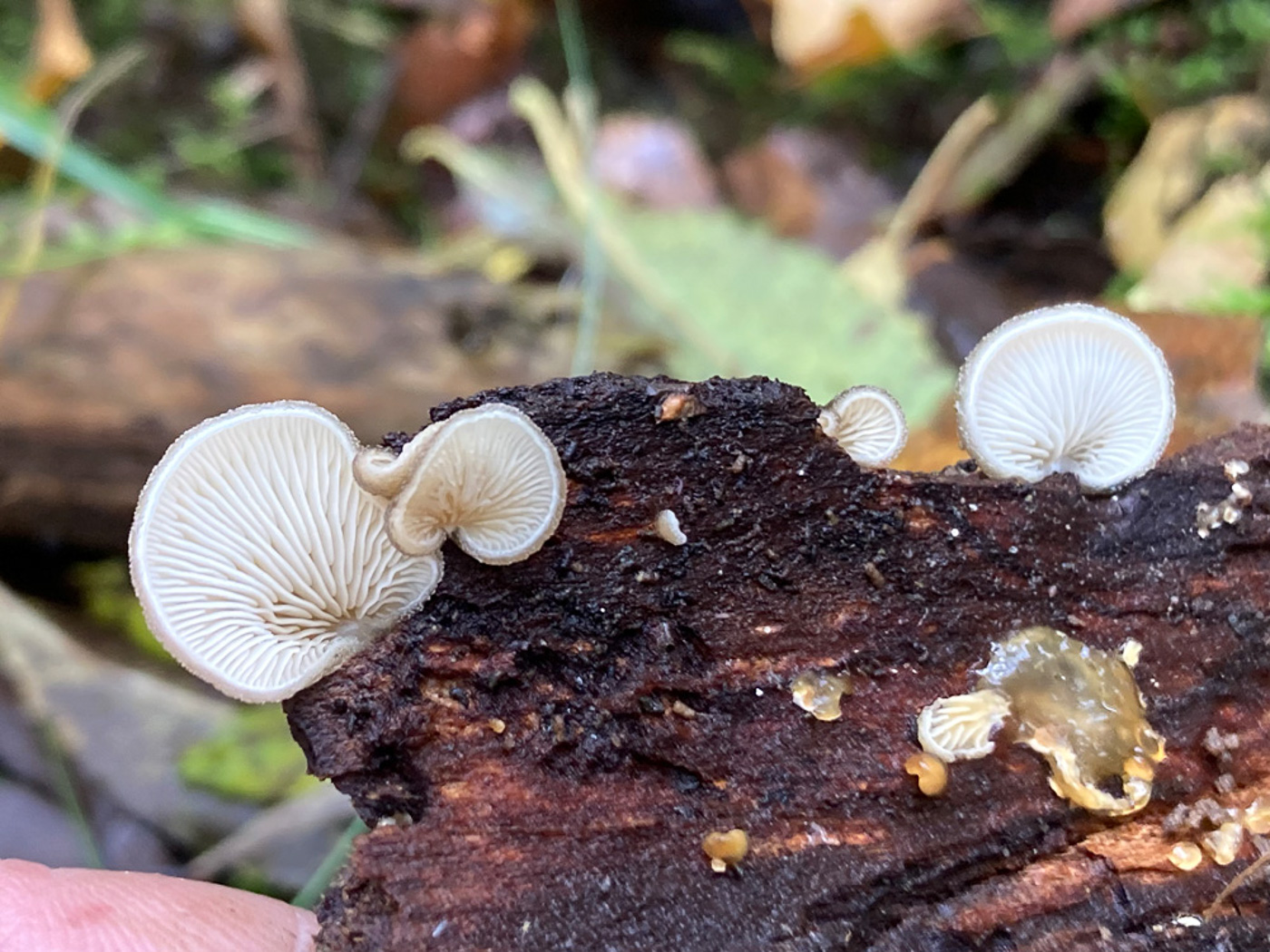
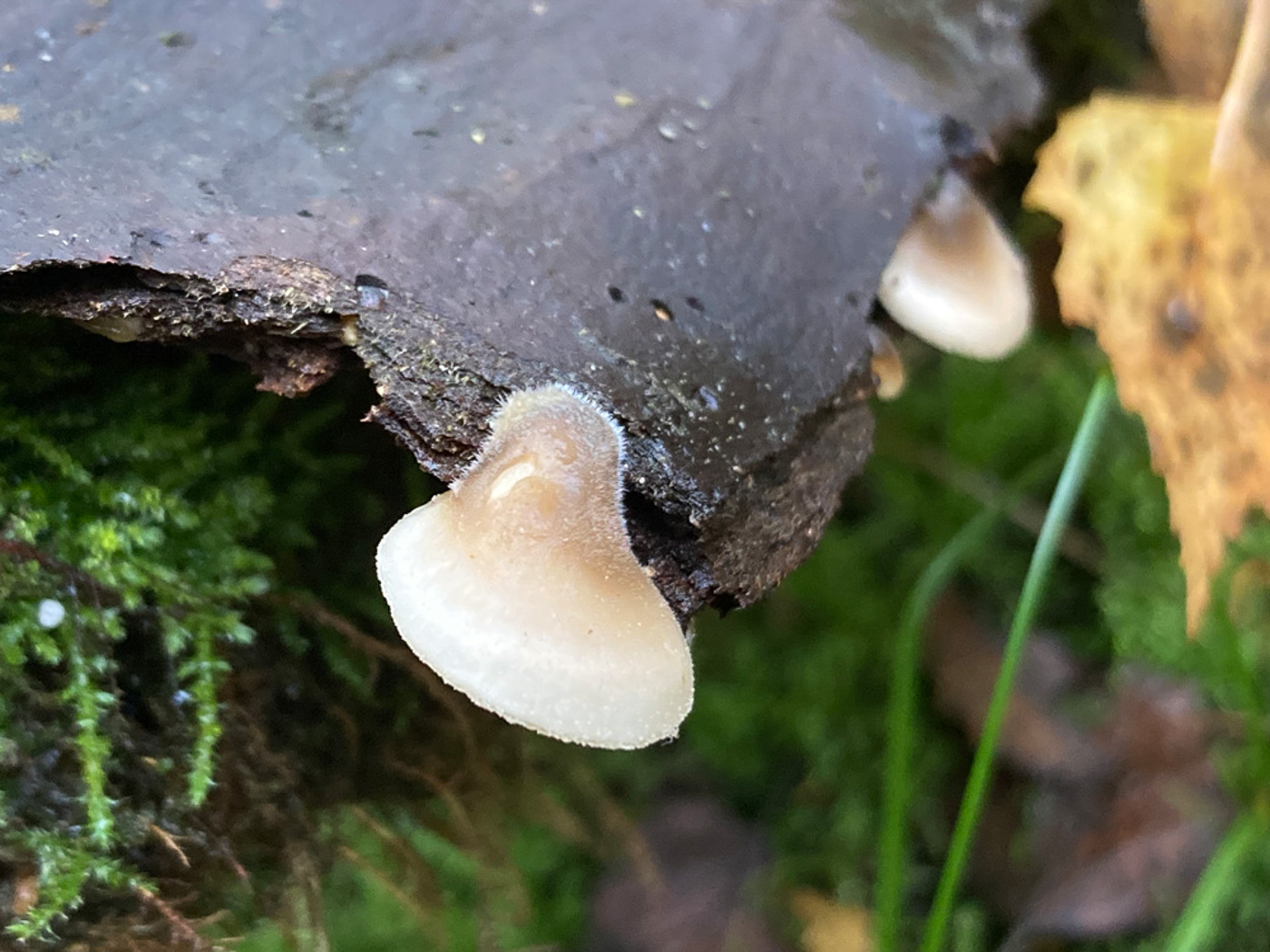 |
October 17th Hohenbuehelia cf. atrocoerulea (a rare Oyster with no English name) In Burnham Beeches Russell Ness came across this small 'pleurotoid 'species on fallen Willow. Though superficially similar to some other small species having either no stem or an eccentric stem, this rare genus has very different microscopic features and rather gelatinous sticky texture (which enables it to trap nematodes which supply an extra source of nutrients). Russell keyed this collection out with care and found it fitted best with H. atrocoerulea despite the complete lack of blue - normally a distinctive feature. For this reason there has to be some doubt in the determination and we hope to get a sample sequenced. This is a new entry for Finds and we have just three previous county records. |

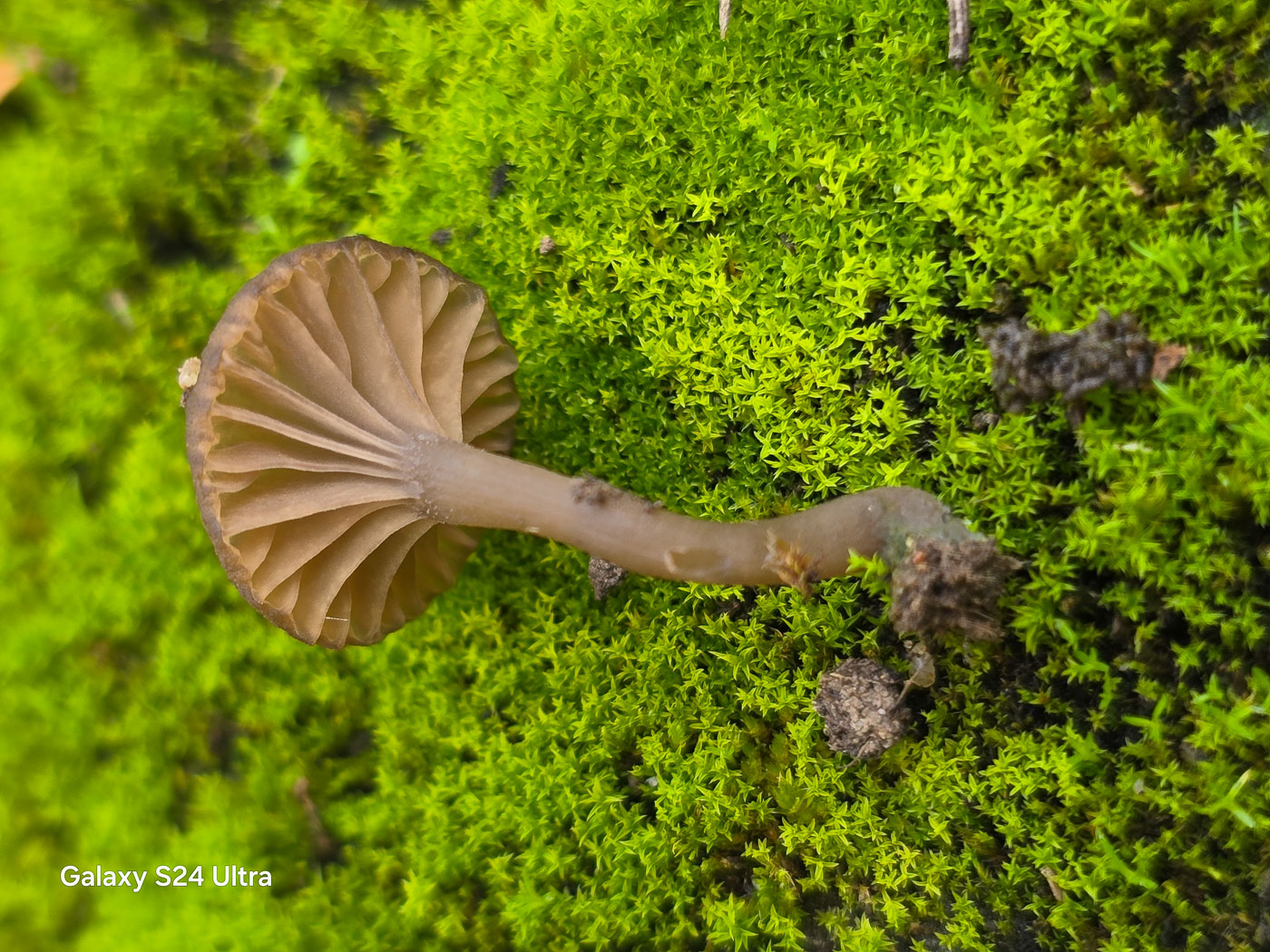 |
October 17th Arrhenia obscurata (Dark Navel) In a mossy roadside bank in Gerrards Cross Jesper Launder spotted this special little species which is new to the county. It keyed out comfortably leaving little doubt over its identity in Jesper's mind thought there appear to be just 13 UK records in FRDBI. The dingy colour, widely spaced decurrent gills together with the sunken translucent umbilicate cap seem definitive together with spore size. A nice find. |
October 16th 2024

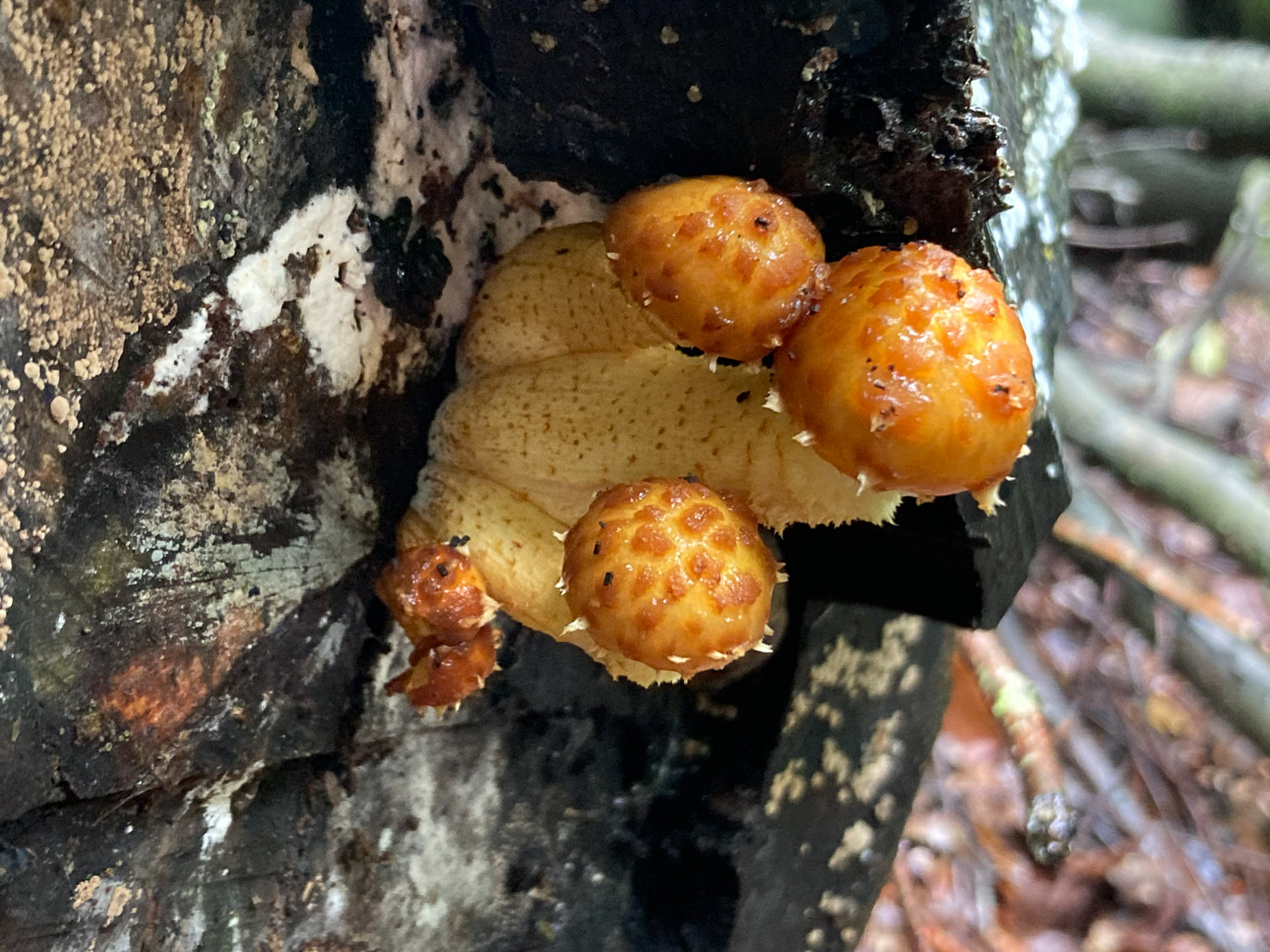 |
October 16th Pholiota adiposa (Golden Scalycap) On fallen Beech at Burnham Beeches Russell Ness found nice fresh examples of this species - a genus which has been poorly represented this season so far. The young buttons are particularly attractive and here showing the sticky surface which separates it in the field from the dry-capped and much more common P. squarrosa (Shaggy Scalycap). One should be aware that there are other very similar sticky-capped species, all of which should be checked microscopically for definitive ID, though on Beech this probably the most likely candidate. Previous finds |
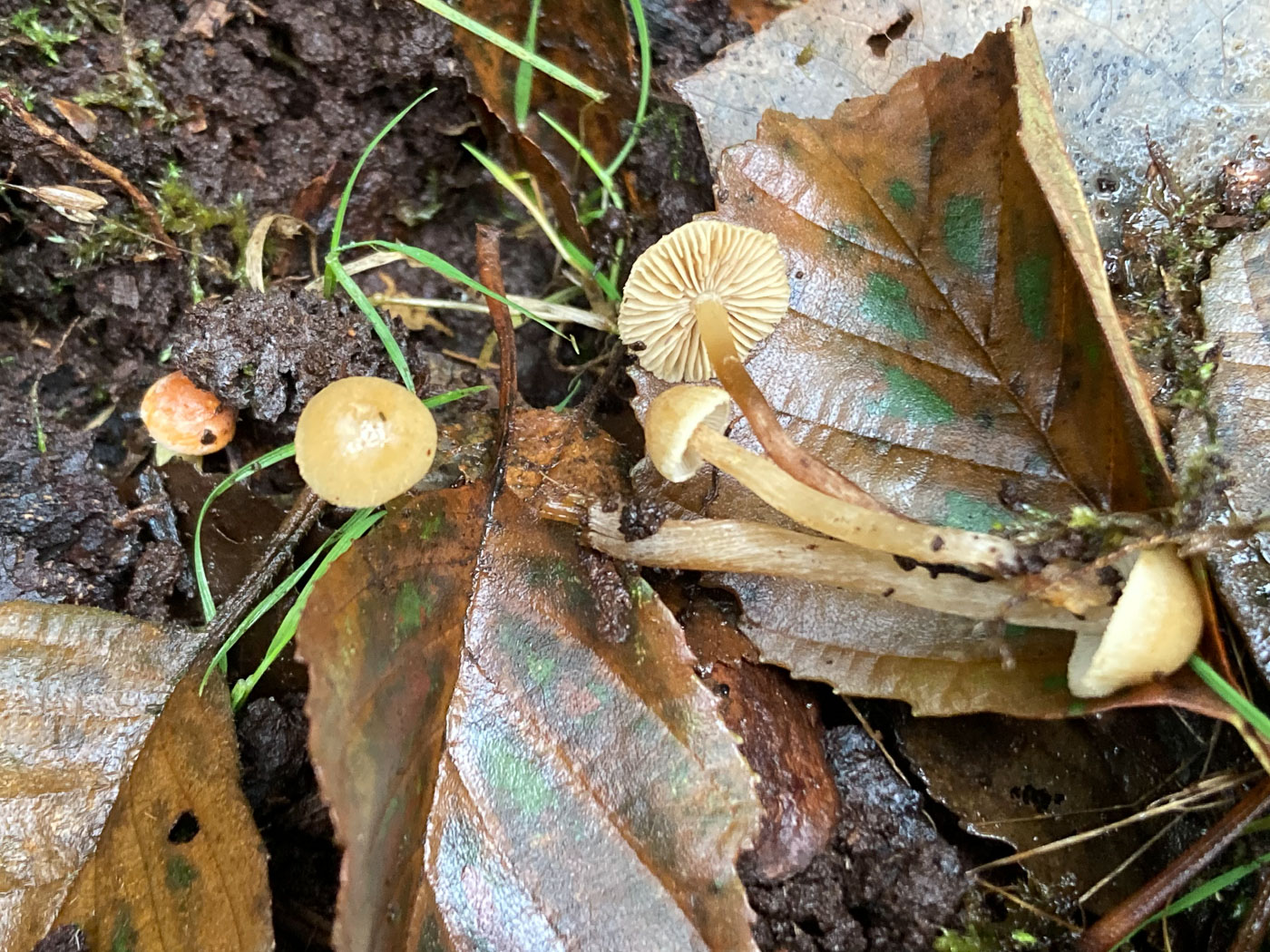 |
October 16th Naucoria escharoides (Ochre Aldercap) In Burnham Beeches Russell Ness, when under Alder, found these small inconspicuous LBJs and took them home to identify. Many members of this genus are host specific to Alder - one or two to Willow - and for this reason we have only a few county records of the Alder species as the tree is generally in short supply locally. This particular species is perhaps the commonest and also the palest, somewhat similar in stature and colour to Tubaria though withe very different microscopic characters. So if you encounter Alder it is well worth a close look at any LBJs found nearby! This is a new entry for Finds. |
October 15th 2024
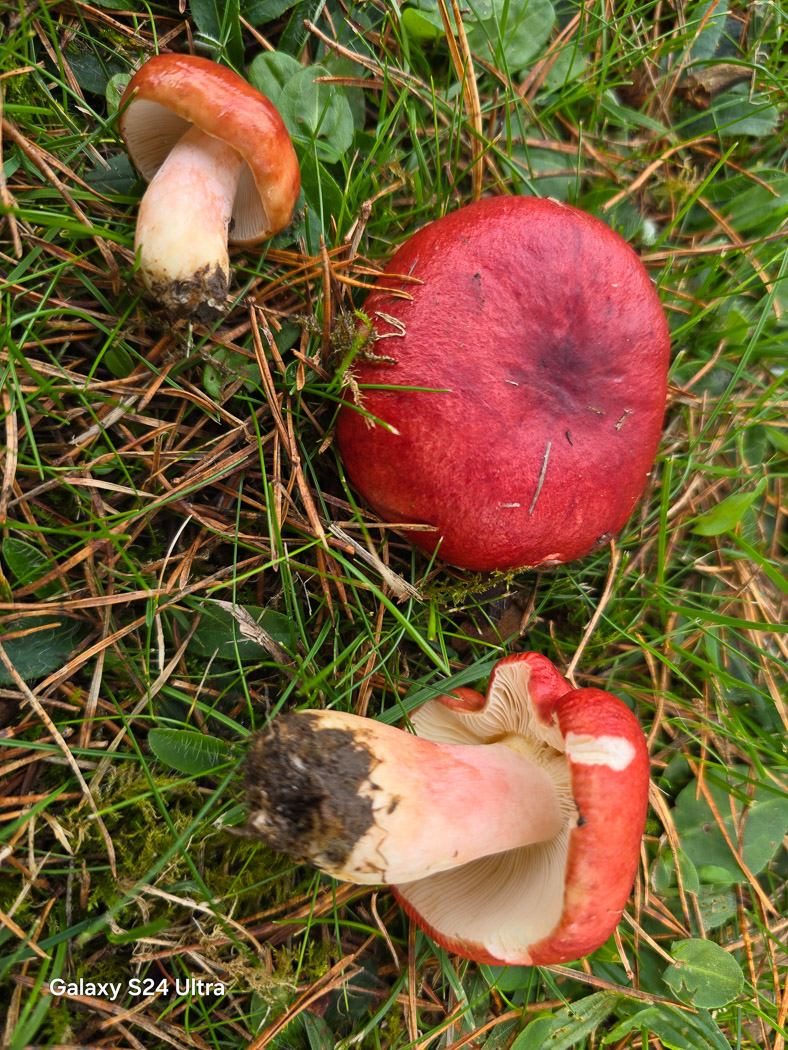 |
October 15th Russula sanguinaria Russula sanguinaria This genus has been extremely poorly represented so far this season. Jesper Launder was pleased, therefore, to find this collection under Pine at Audley Chalfont Dene retirement village. The species is host specific with Pine and the stem is characteristically cap coloured whihc helps to separate it in the field form other red-capped species. Previous finds |
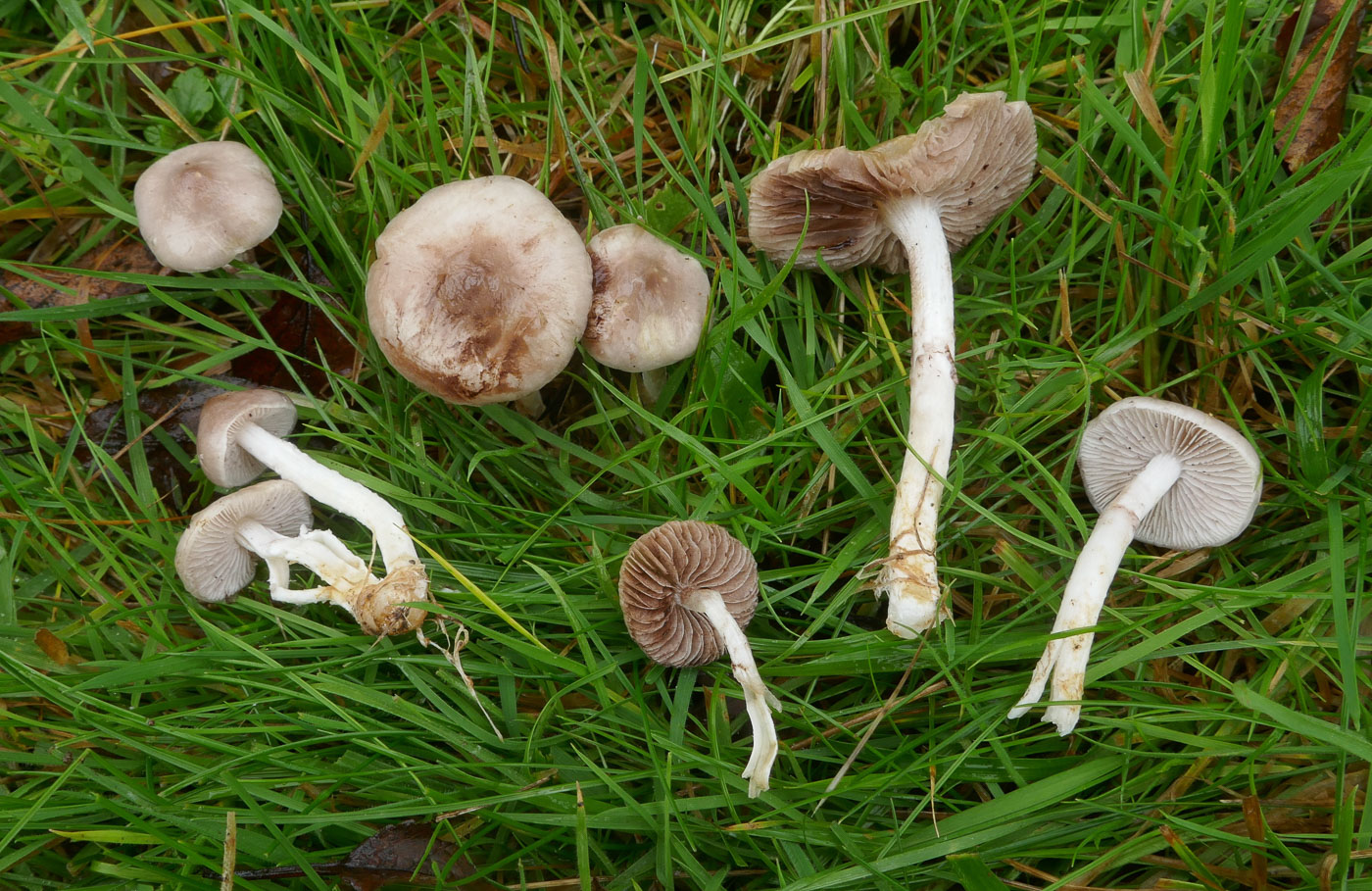 |
October 15th Stropharia inuncta (Smoky Roundhead) At Stampwell Farm in a grassy area Jackie Ewan noticed this rather innocuous-looking collection. This is a species which can confuse and is very different from the distinctively coloured blue-green grassland Roundheads. Its viscid surface, gills which eventually darken as the spores mature, and stem with a somewhat ephemeral ring - seen in the RH specimens here - are all good pointers to recognise in the field, though it is less common than the blue-green members of the genus. Previous finds |
October 14th 2024
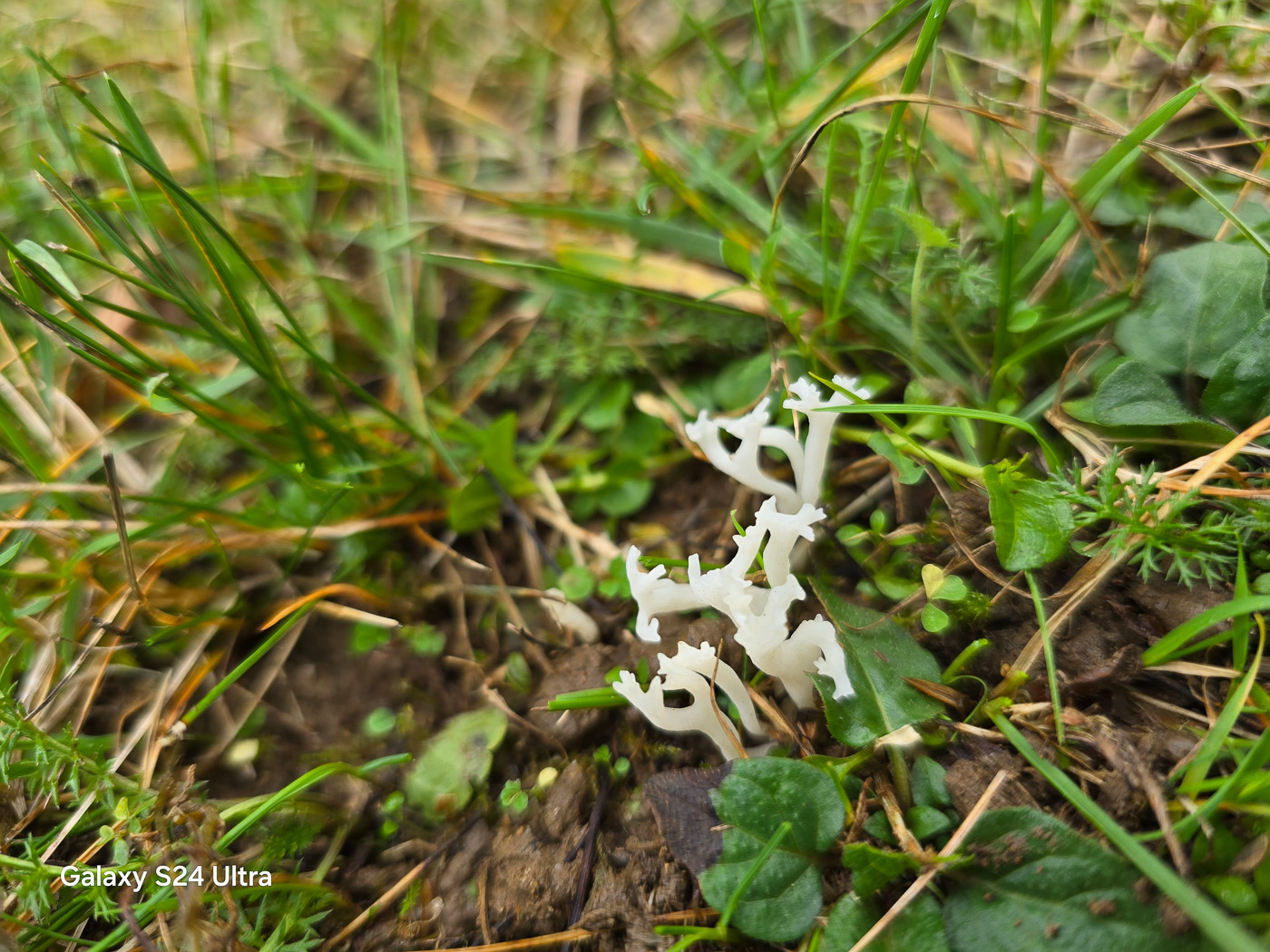 |
October 14th Ramariopsis kunzei (Ivory Coral) In Jordans Village Jesper Launder found this delicate branching coral in a grassy patch, recognised it as having a very different jizz from the woodland Clavulina coralloides (Crested Coral). This is an a unusual grassland species though we now have quite a few records in recent years. Previous finds |
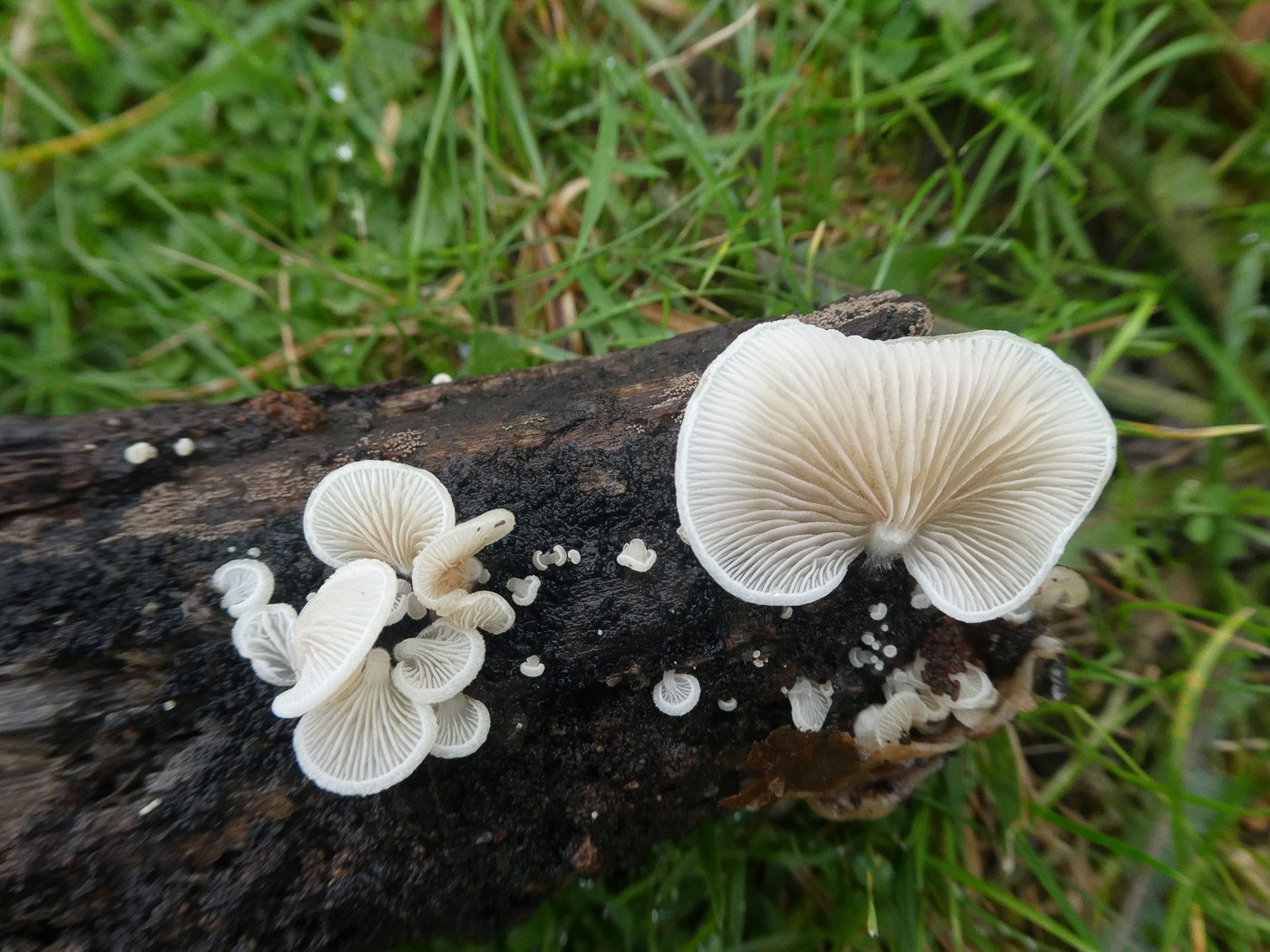
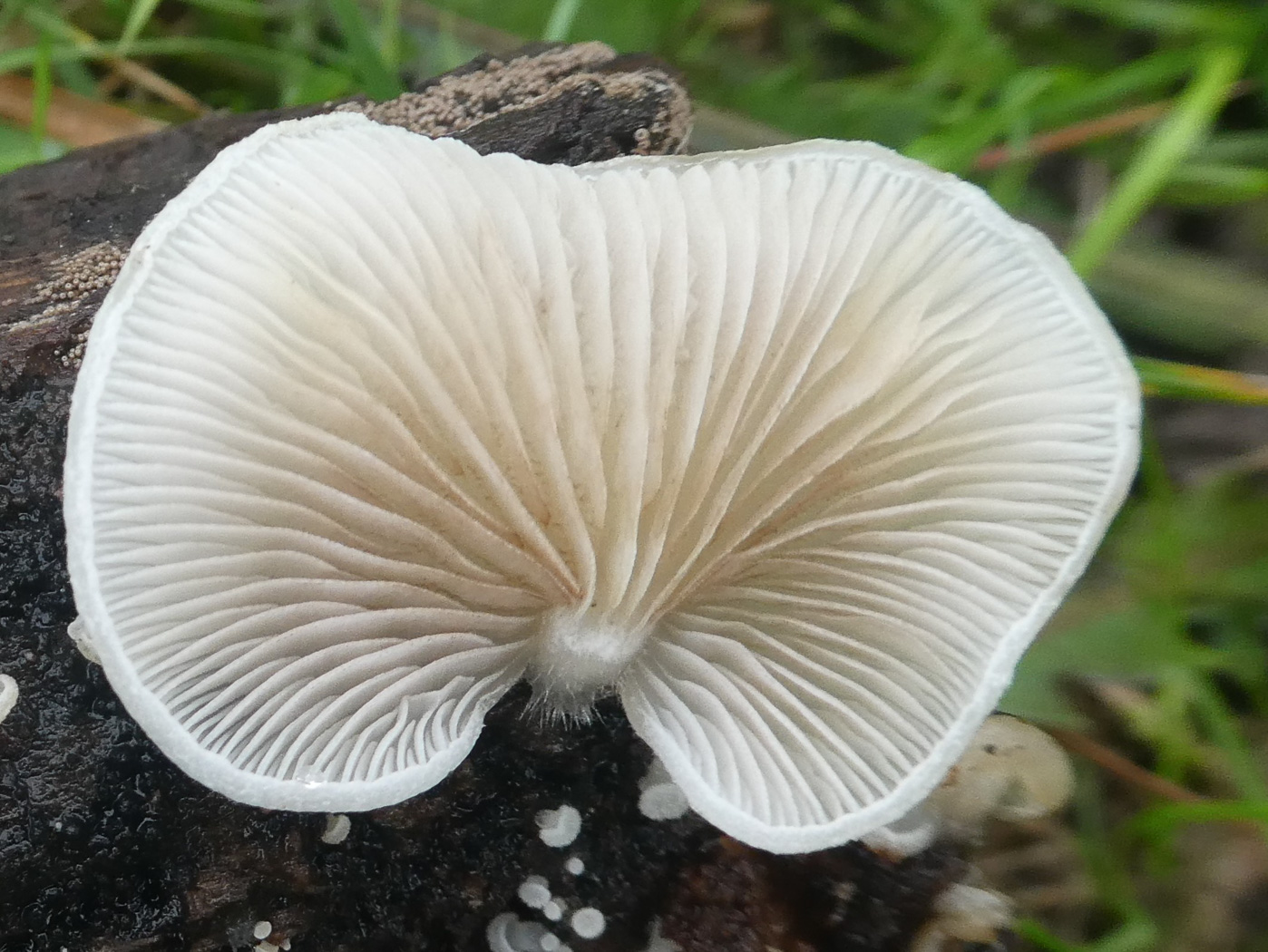 |
October 14th Crepidotus mollis Crepidotus mollis In Gerrards Cross Jim Wills noticed this beautifully formed example of a large Crepidotus which owing to its size he guessed was likely to be C. mollis. Not only does this species get much bigger that other Oysterlings but it also has an elastic cuticle so that the cap can be stretched sideways to reveal its transparent covering. This makes an easy way to identify it in the field though others in the genus always need a microscopic check to name to species. Previous finds |
October 13th 2024

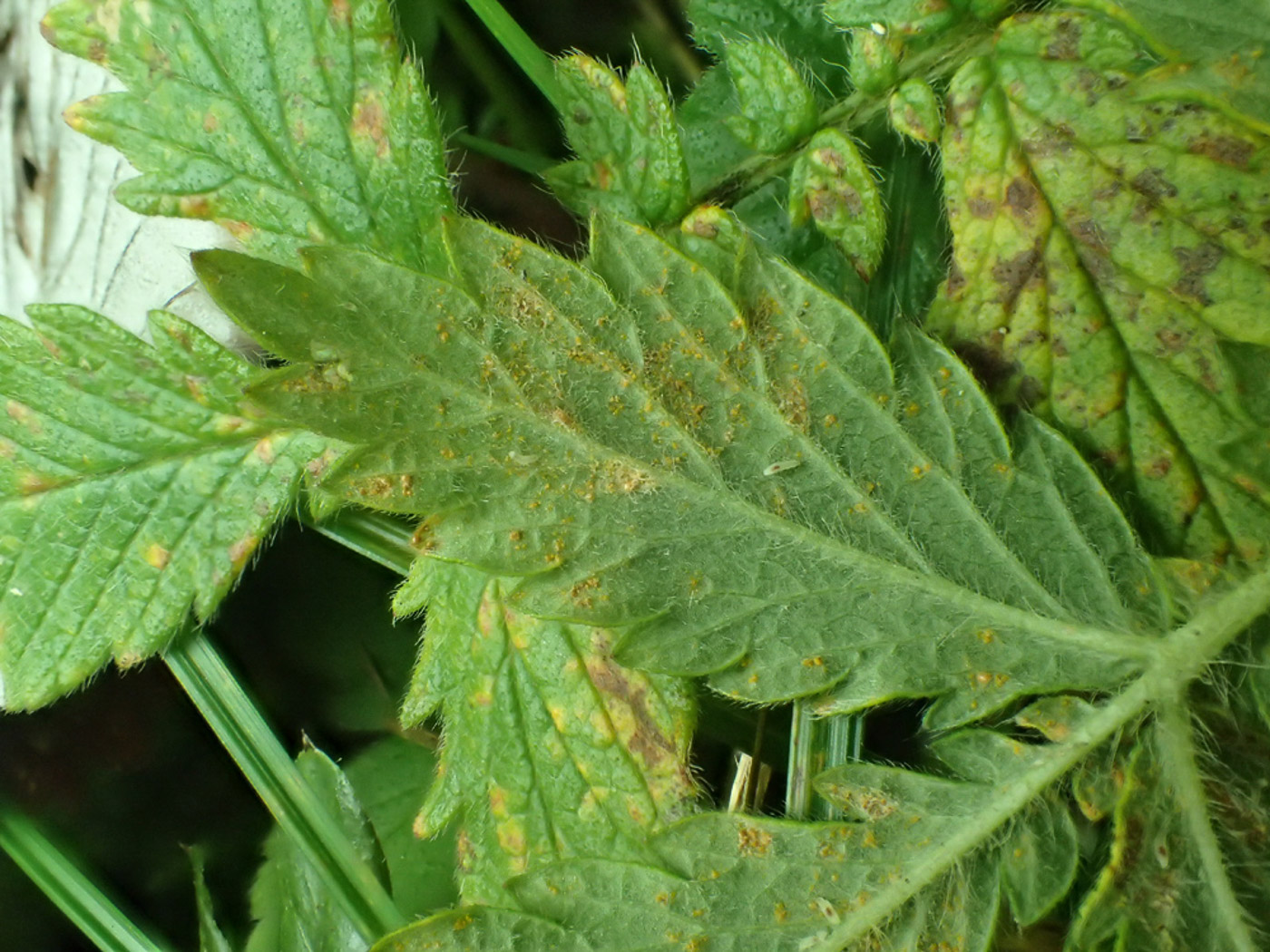
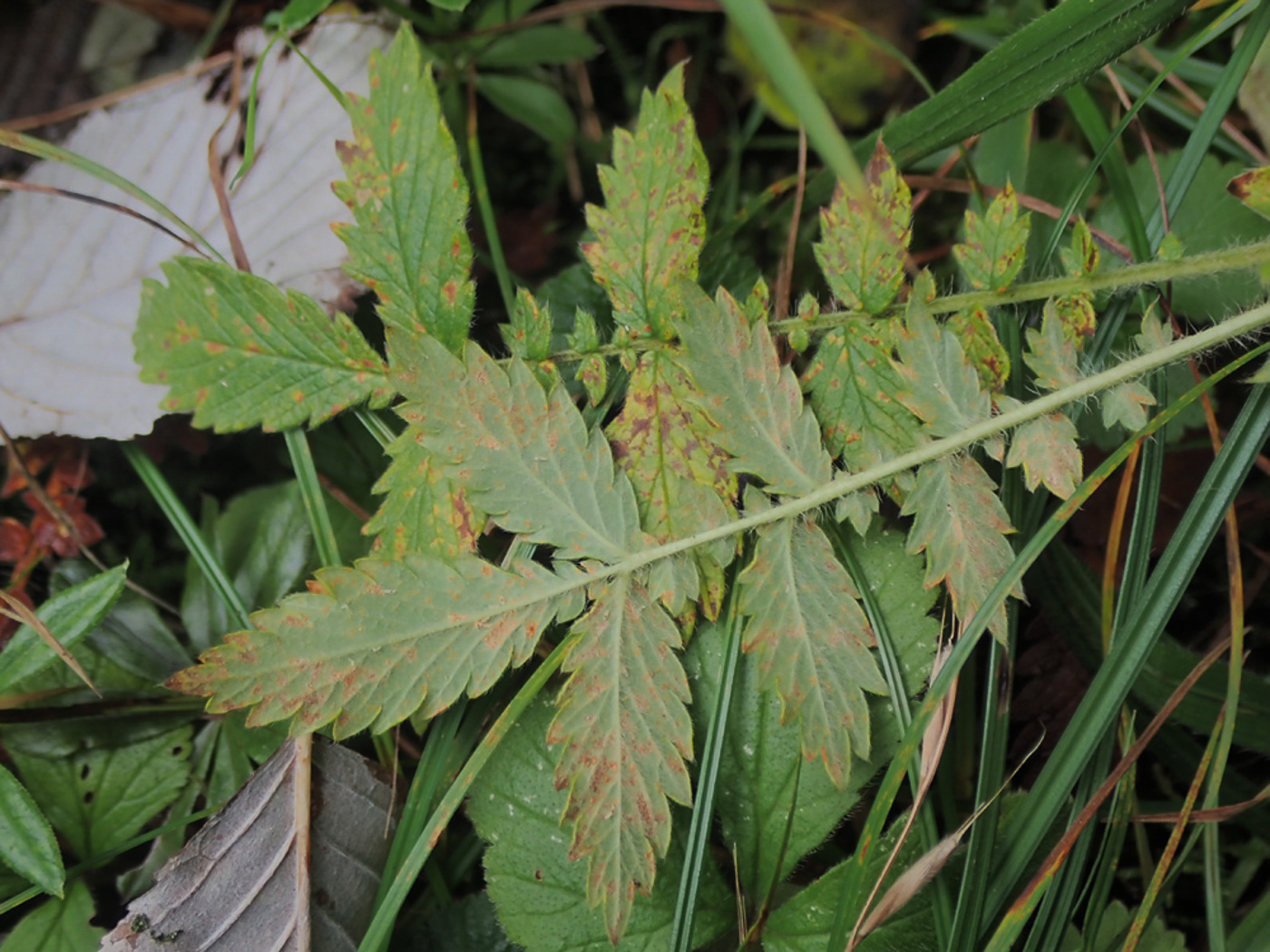 |
October 13th Pucciniastrum agrimoniae (a species of rust with no English name) Whilst visiting Holtspur Bank in Beaconsfield Sarah Ebdon noticed this rust affecting the leaves of Common Agrimony, then checked it at home, discovering that the rust is host specific to this plant, is quite common wherever the plant is found though is not that often recorded. We have just one previous county record from 2003, so this is anew entry for Finds. |
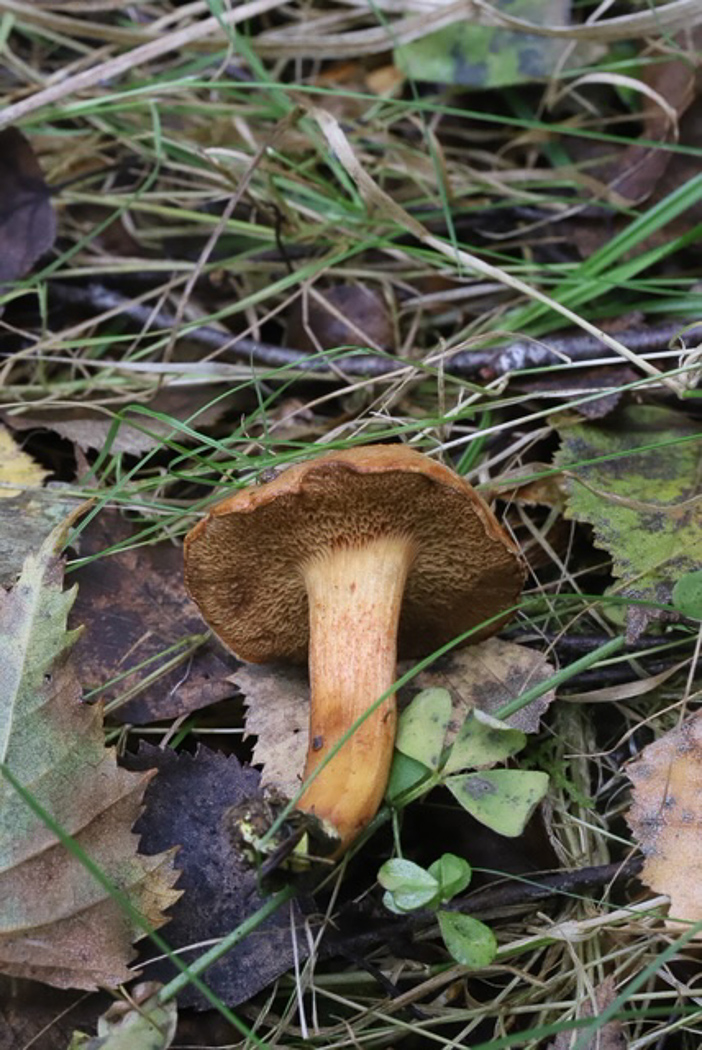 |
October 13th Chalciporus piperatus (Peppery Bolete) This is a species Penny has been on the lookout for but not found yet this season. Here it was found at Oakley Wood, Bernwood Forest, by Phil Townsend under Birch and near to Amanita muscaria with which it appears to have a close relationship. However, both species are often found fruiting without their partner but maybe the link is ever present via their mycelium therefore hidden from sight?! Previous finds |
October 12th 2024
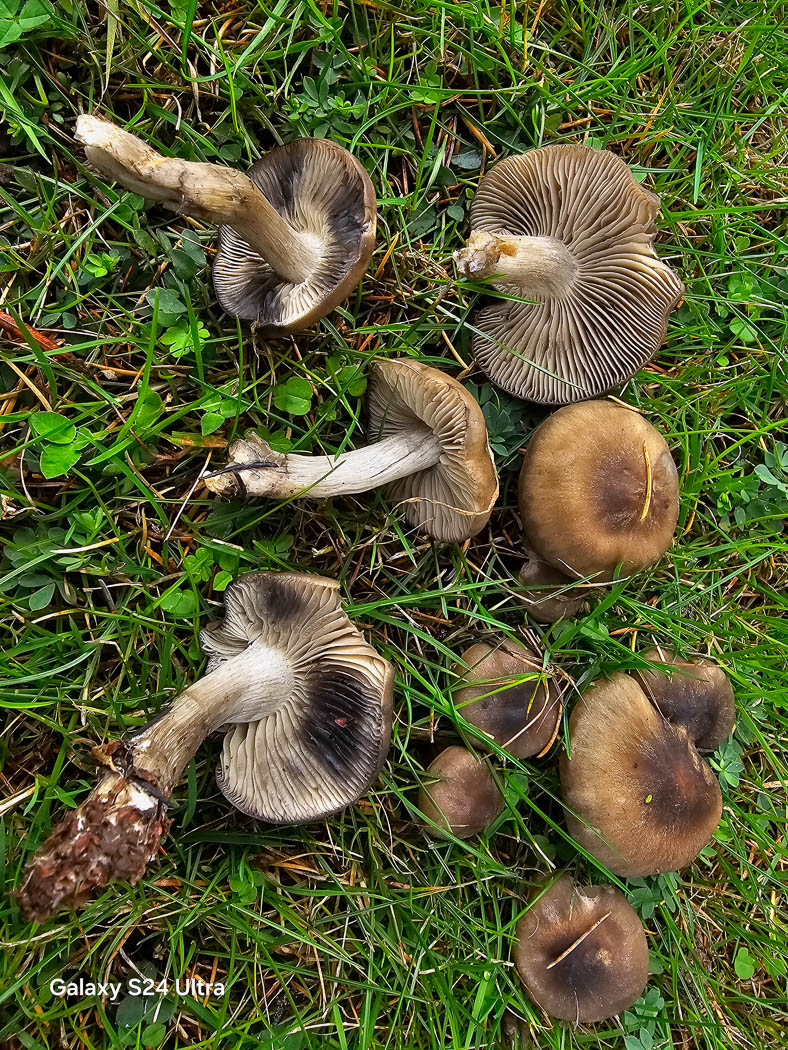
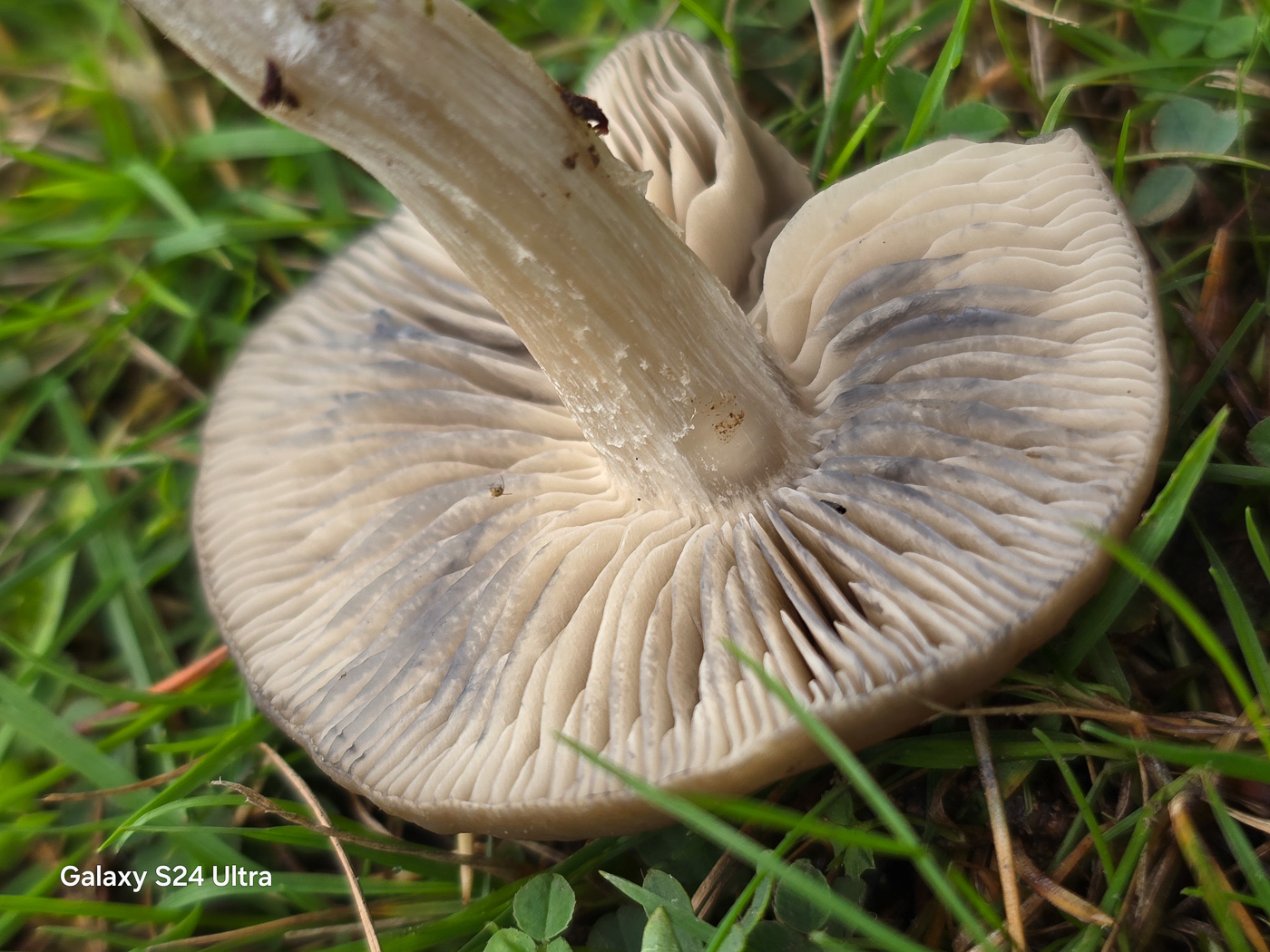 |
October 12th Lyophyllum paelochroum (a rare Domecap with no English name) In Jordans village under Cedar Jesper Launder was intrigued by this collection which on handling started turning faintly then strongly blue before becoming almost black. This pointed to some species of genus Lyophyllum and it keyed straight out in Funga Nordica to this rare species, also included in Kibby vol 2. However, though the name is accepted in Species Fungorum it is not listed in the FRDBI dictionary, nor can Penny trace an earlier name for it. It is obviously a significant find and will be sequenced but unless someone can enlighten her Penny is at a loss as to how to record this species ............... |
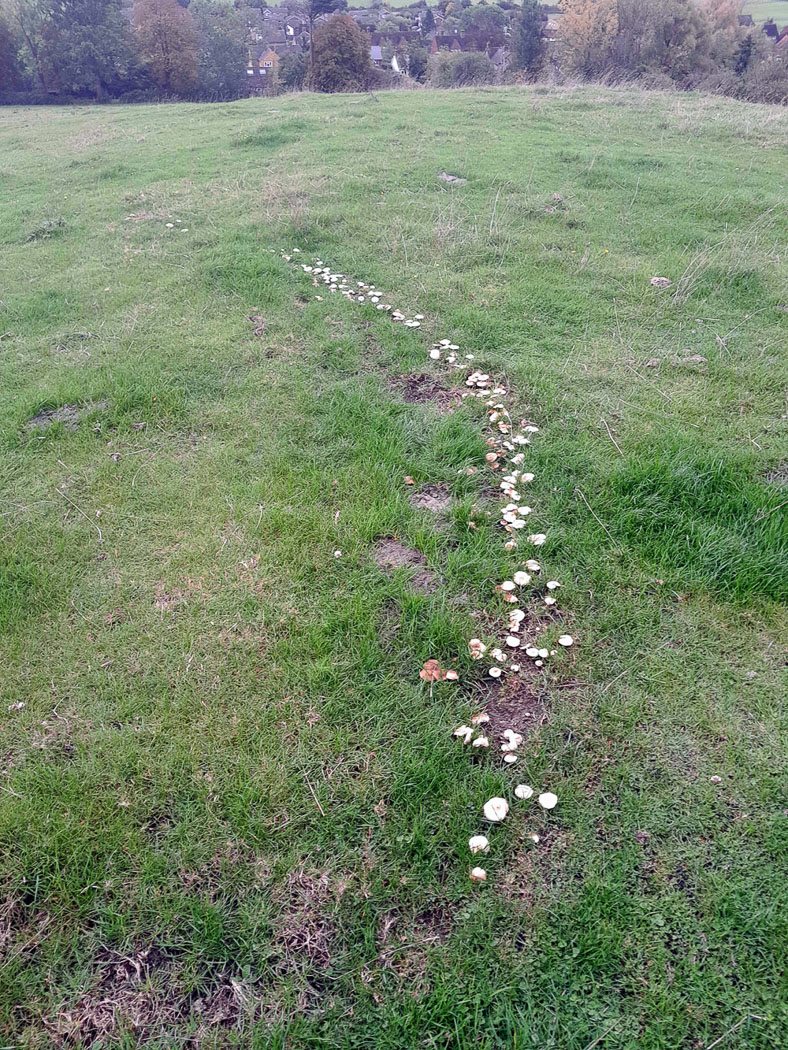
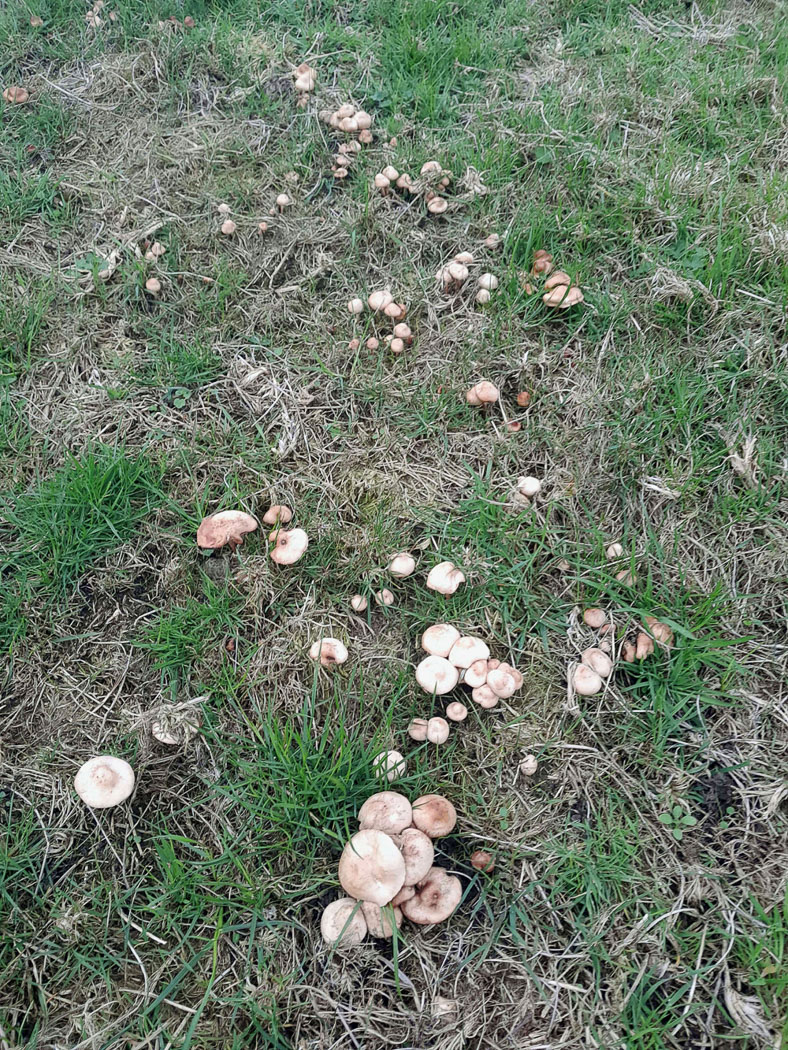
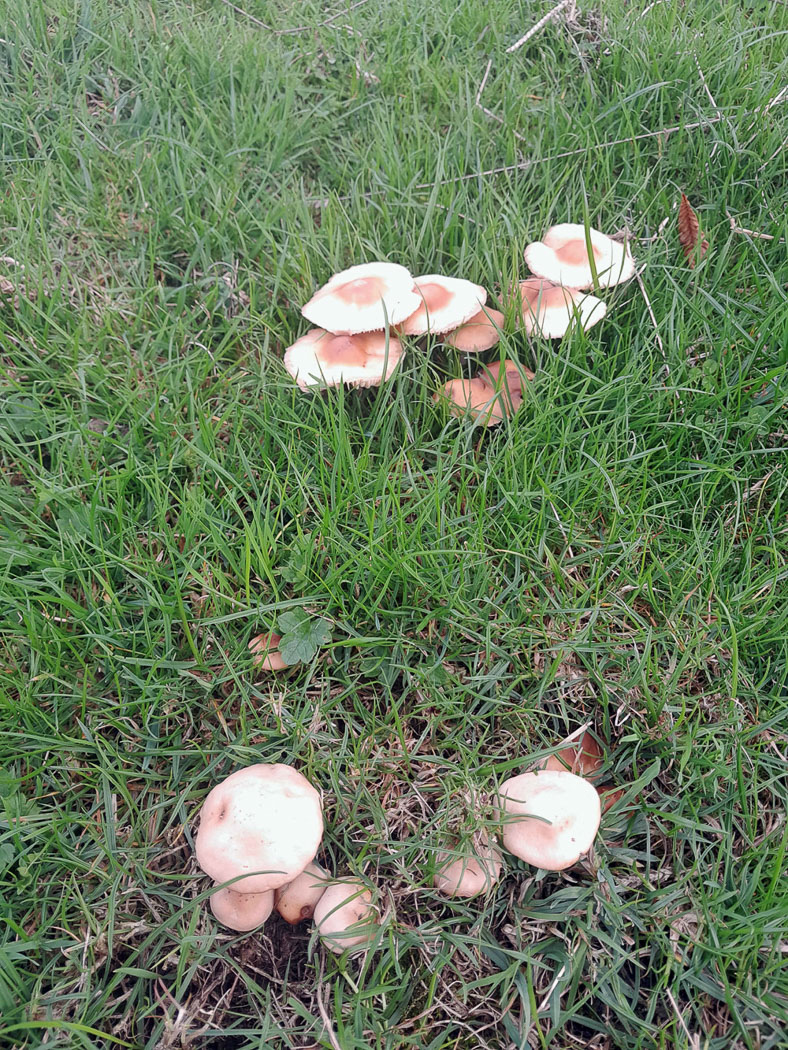
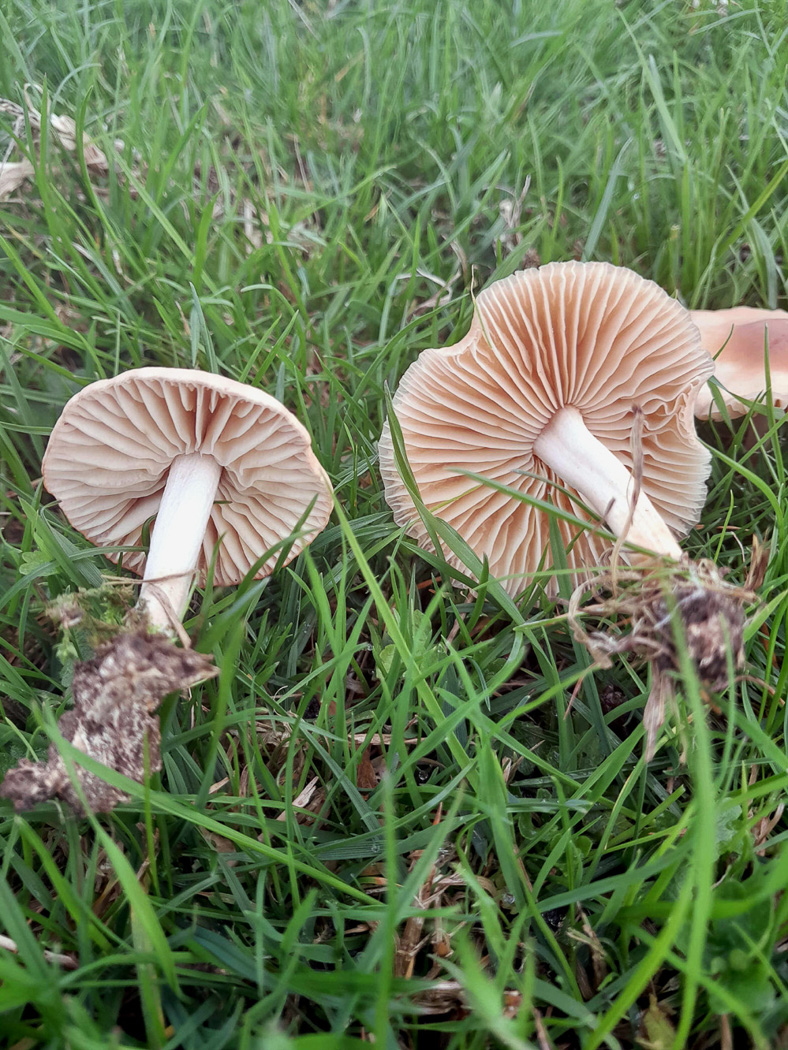 |
October 12th Marasmius oreades (Fairy Ring Champignon) In a meadow near Quainton Mark Harper came across this impressive partial ring and sent Penny the photos to check if he was correct in his iD. It can hardly be anything else forming this enormous ring which will no doubt have been increasing in size for years and will probably continue to do so, getting ever larger as the fungus uses up available nutrients so searched further and further afield. Sometimes these rings get so large they can be spotted from light aircraft. Previous finds |
October 11th 2024
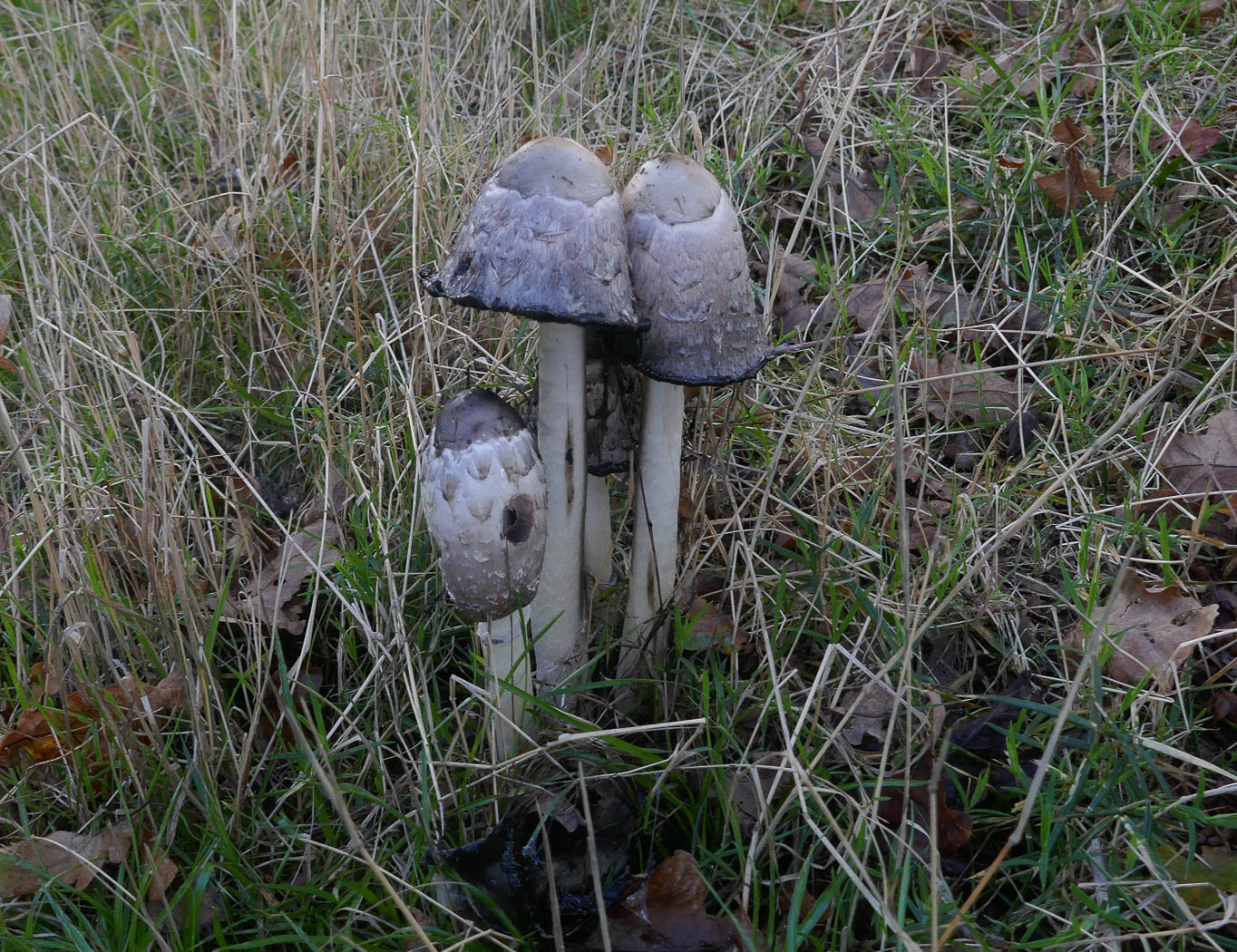 |
October 11th Coprinus comatus (Lawyer's Wig) This rather drab-looking cluster was found at Stampwell Farm by Jackie Ewan. The species tends to catch the eye when fresh, white and extremely woolly / shaggy but like many Inkcaps that stage is shortlived as the deliquescent stage sets in and can be seen just starting here with the wet black rim to the caps. Previous finds |
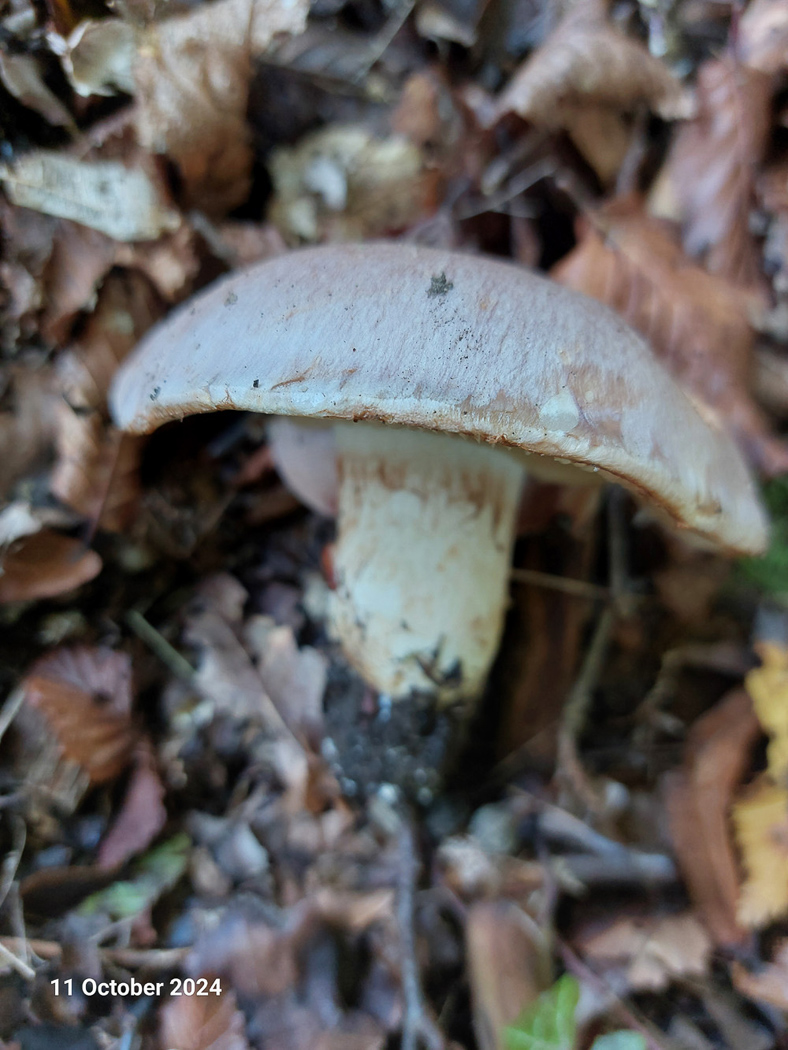
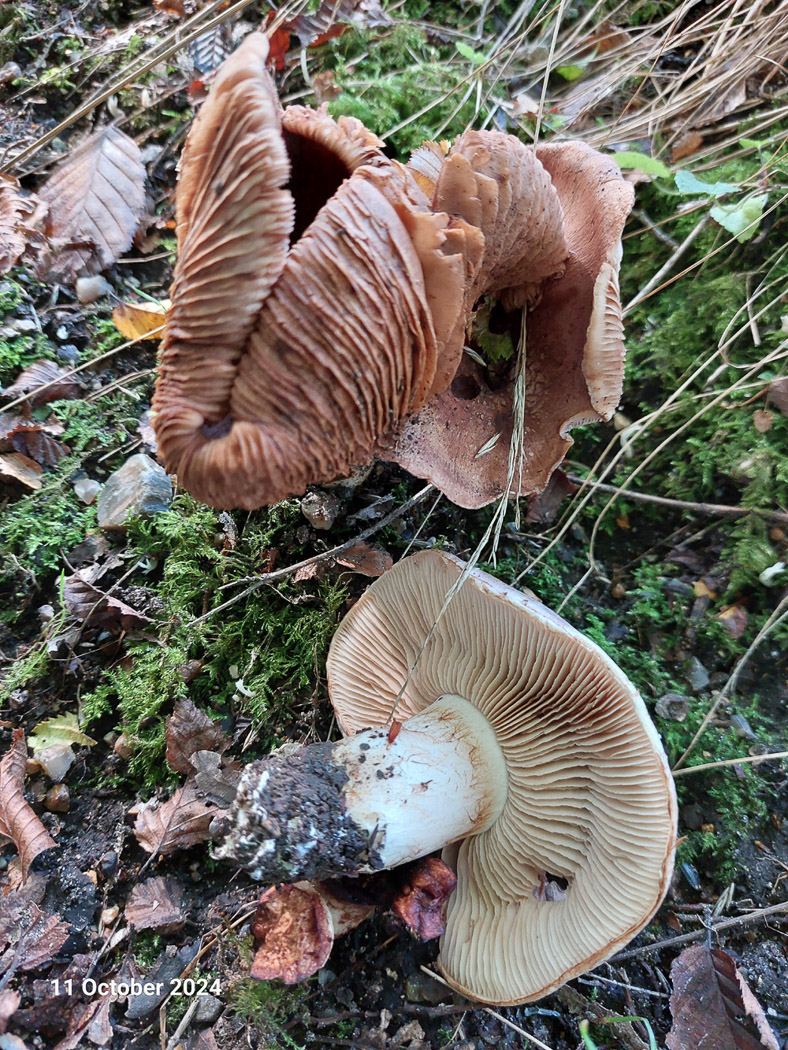
 |
October 11th Cortinarius daulnoyae (Strapping Webcap) Near Burnham Beeches under Hornbeam Jesper Launder spotted these mushrooms and as he approached he noticed a strong unpleasant chemical smell akin to that of the white smelly Tricholoma species. Thinking at first it was a Webcap in Section Telamonia he failed to key it out, then after further research tried the key for Section Phlegmacium with instant success! All features fitted, including the immature pale lilac specimen (photo 3), the somewhat contorted shape when older and of course this remarkable smell. There, however, appears to be only one previous UK record so this is a very rare species here and an exciting find. The material will be sequenced. |
 |
October 11th Cortinarius pilatii (Lemonbalm webcap) In Burnham Beeches Jesper Launder noticed this small LBG, under Oak and Birch which at home keyed out nicely to this species. Clearly belonging in Section Telamonia, this is one we found on our BFG visit to Hockeridge Wood just two days earlier also under Oak when it appeared to be new to the county. (How many times this happens?!) The white rim of veil around the cap edge together with silvery streaky stem and a delicate sweet smell are the key field characters. |
October 10th 2024
 |
October 10th Hygrocybe reidii (Honey Waxcap) At Stampwell Farm Jackie Ewan found several Waxcaps coming up including this one. Though similar to other small species it can be distinguished in the field by its orange tint, pale gills, and if you squash the cap a bit it has a distinct smell of honey. Previous finds |
 |
October 10th Hygrocybe miniata (Vermillion Waxcap) At Stampwell Farm Jackie Ewan found several Waxcaps coming up including this one. Though similar to other small red species it can be distinguished in the field by its dry cap and stem, the cap surface also finely squamulose with golden flecks clearly seen here. Previous finds |
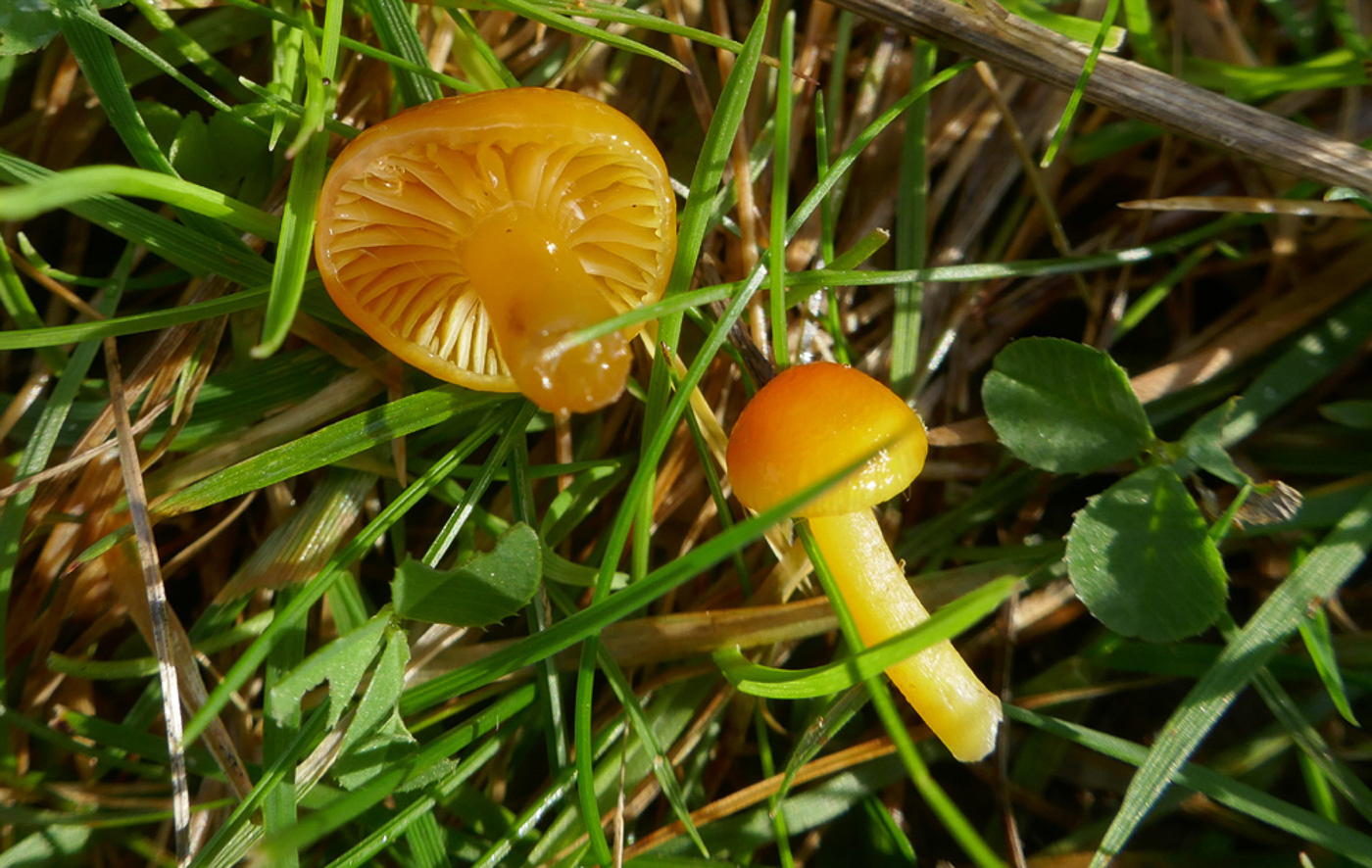 |
October 10th Hygrocybe glutinipes (Glutinous Waxcap) At Stampwell Farm Jackie Ewan found several Waxcaps coming up including this one. Though similar to other small yellow species its somewhat sticky cap and stem - especially after a rain spell - are distinctive. Previous finds |
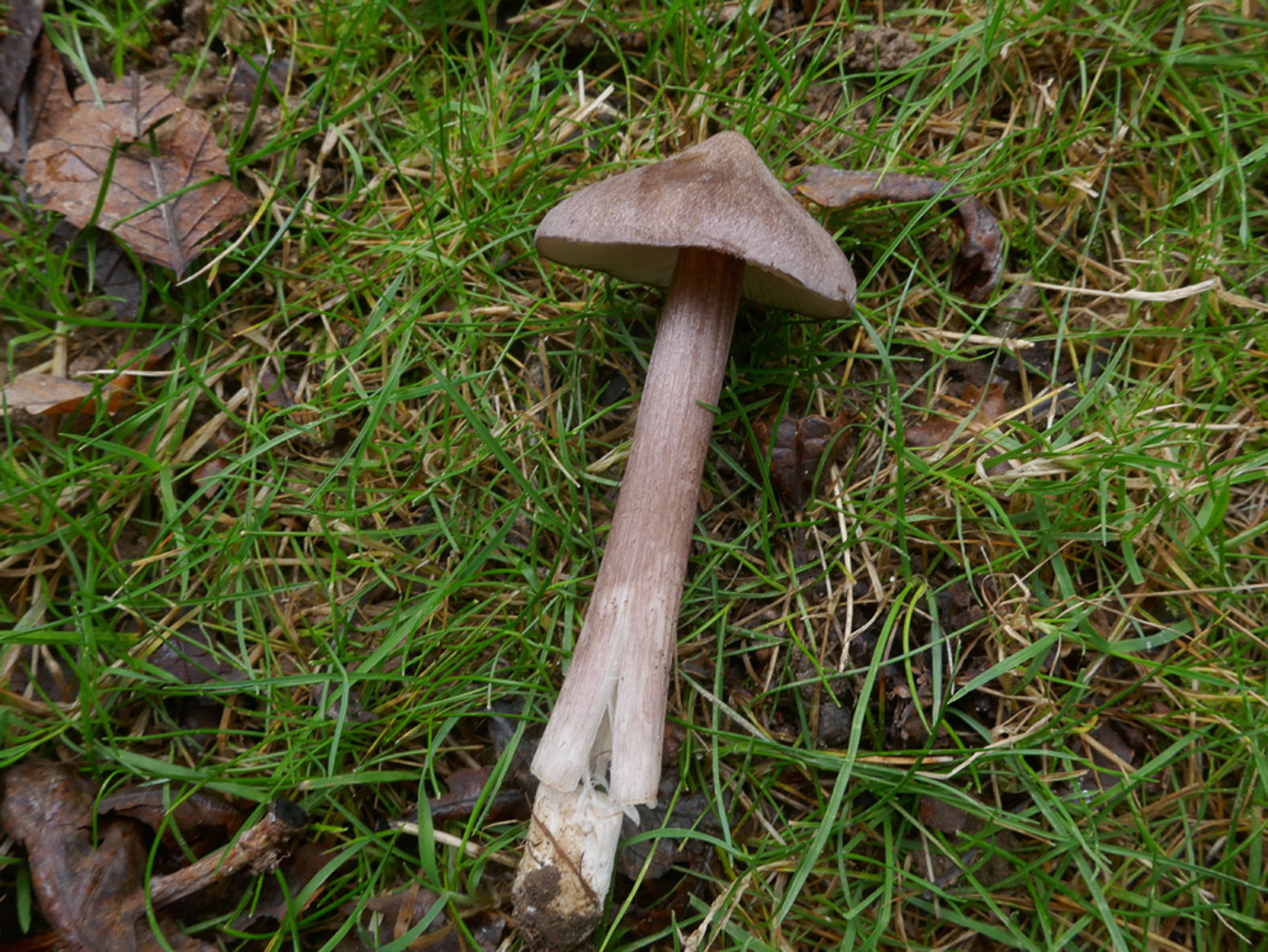
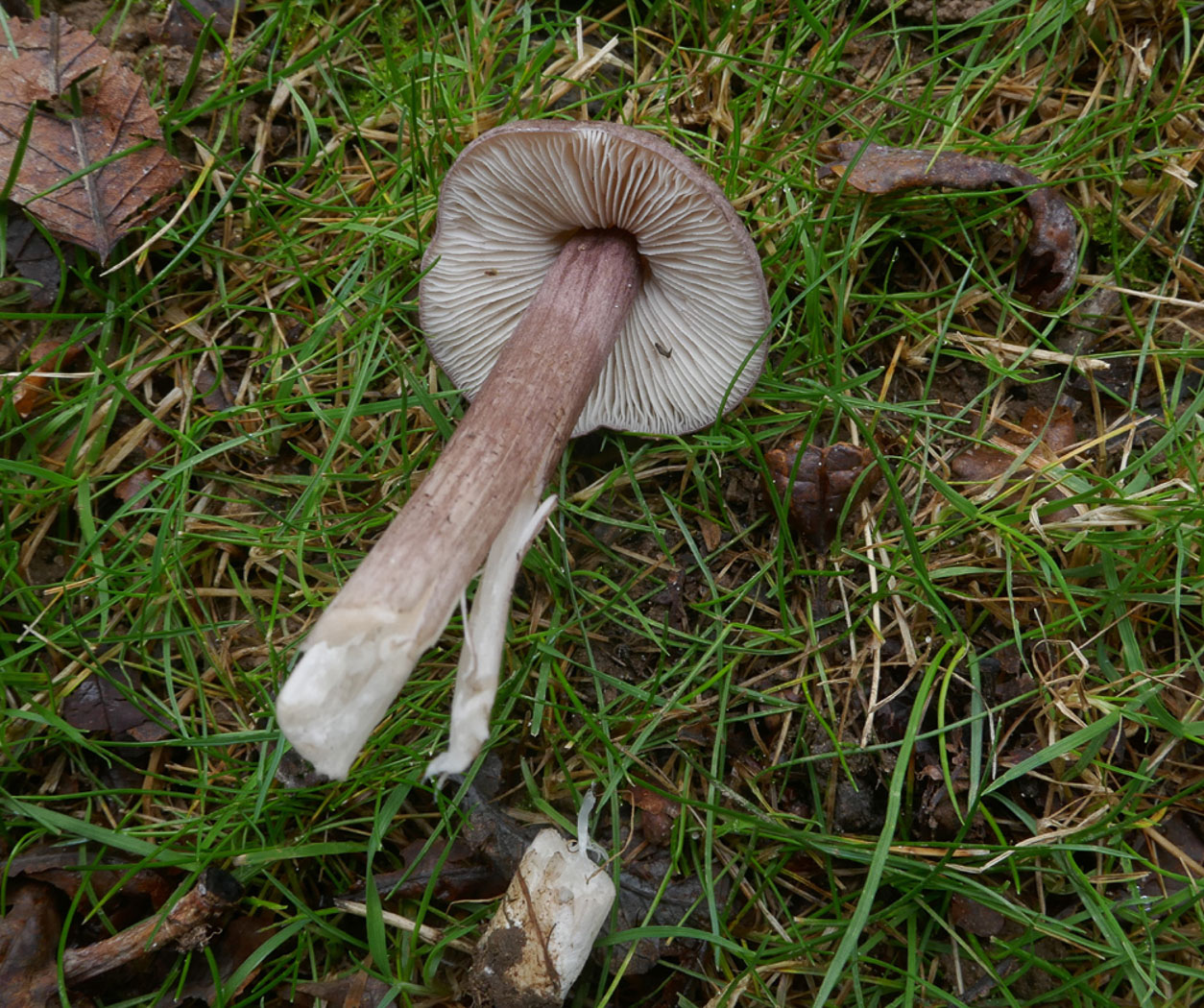 |
October 10th Entoloma porphyrophaeum (Lilac Webcap) At Stampwell Farm Jackie Ewan found this unusual waxcap which has a subtle purplish pink tint, also rather a thick stem for the genus and the cap tends to have an umbo. Microscopic characters are also quite distinct which helps with the ID in a genus a tricky as this one. We have just a few county records and this is a new entry for Finds. |
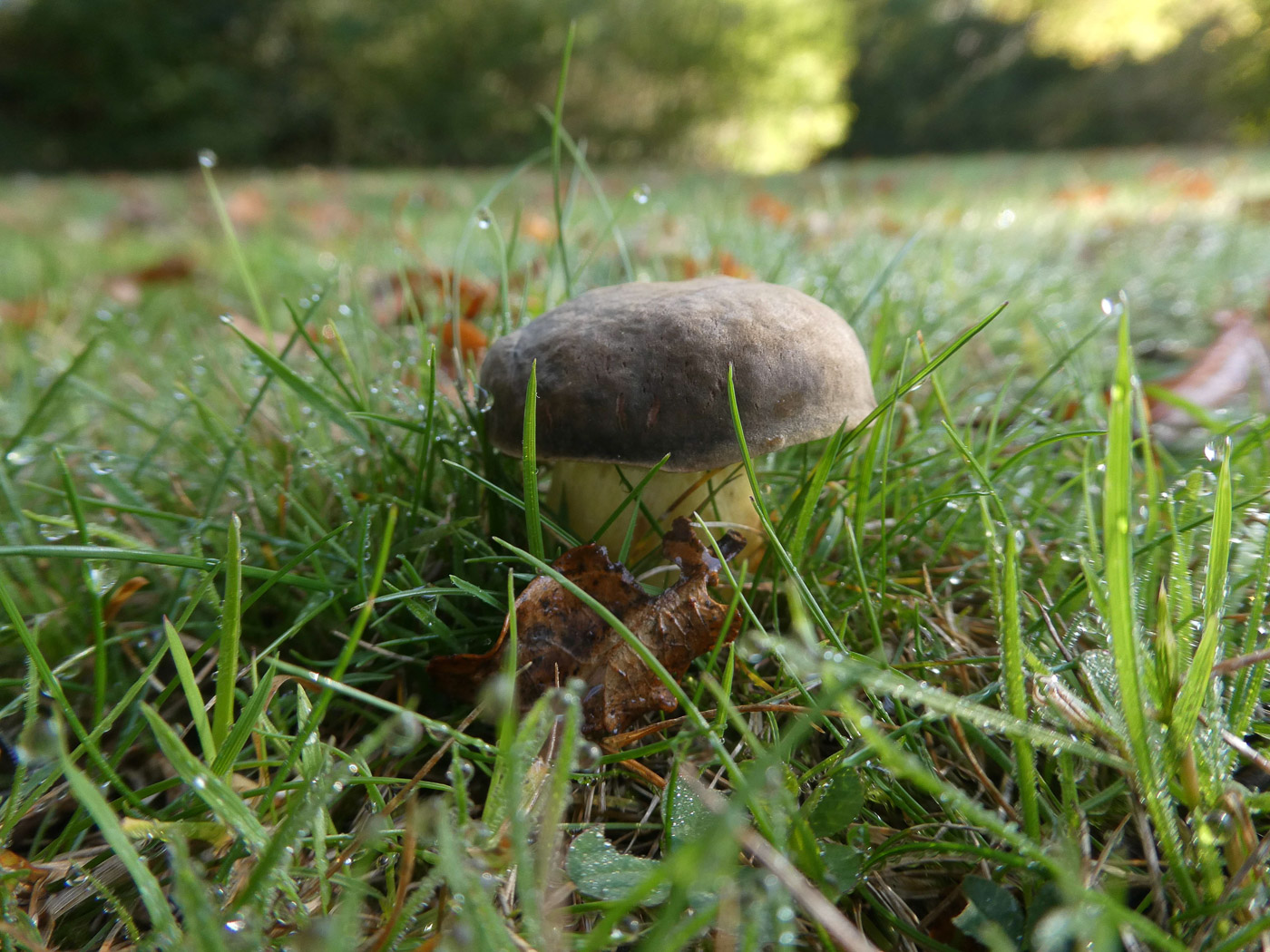
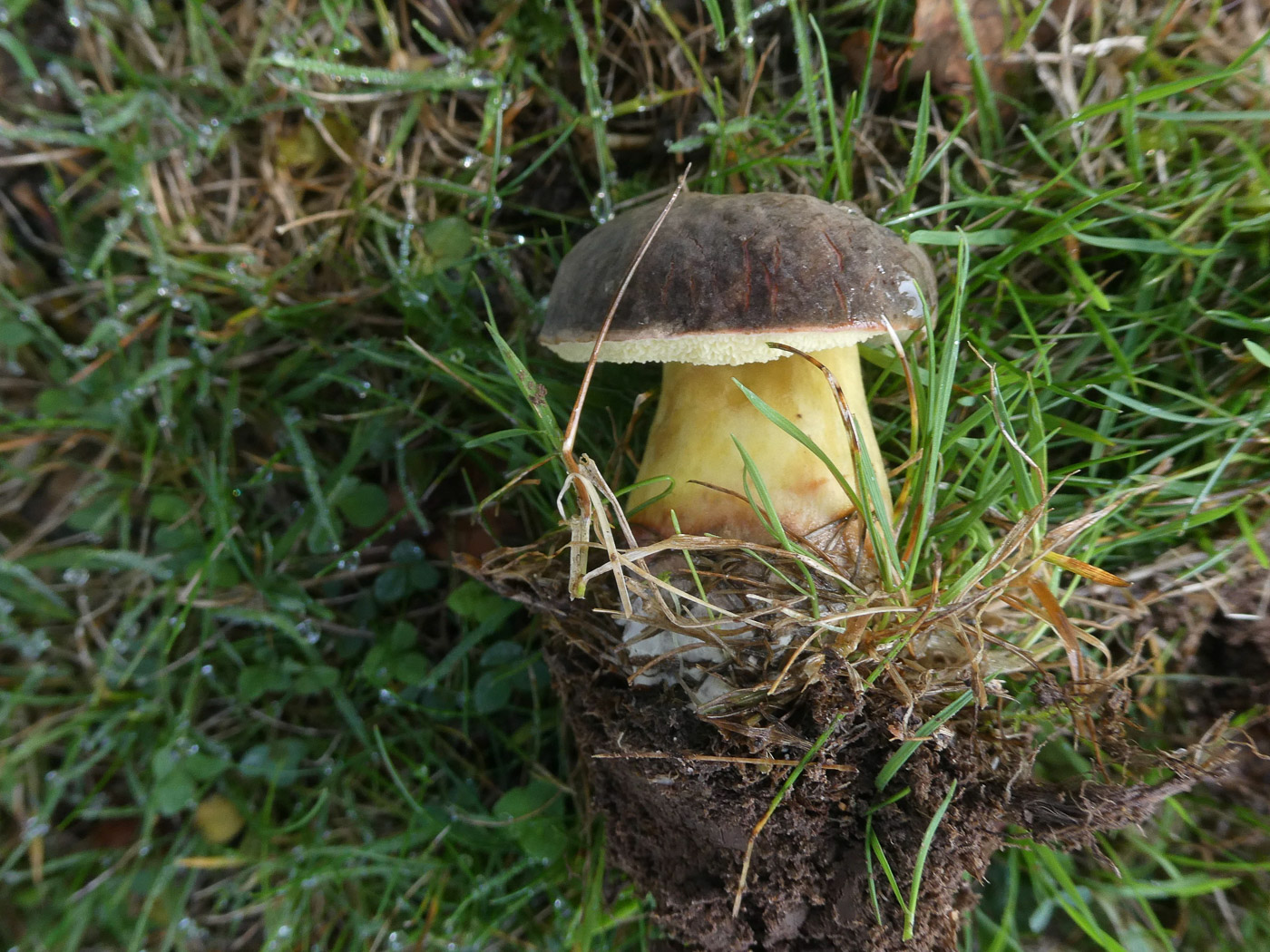
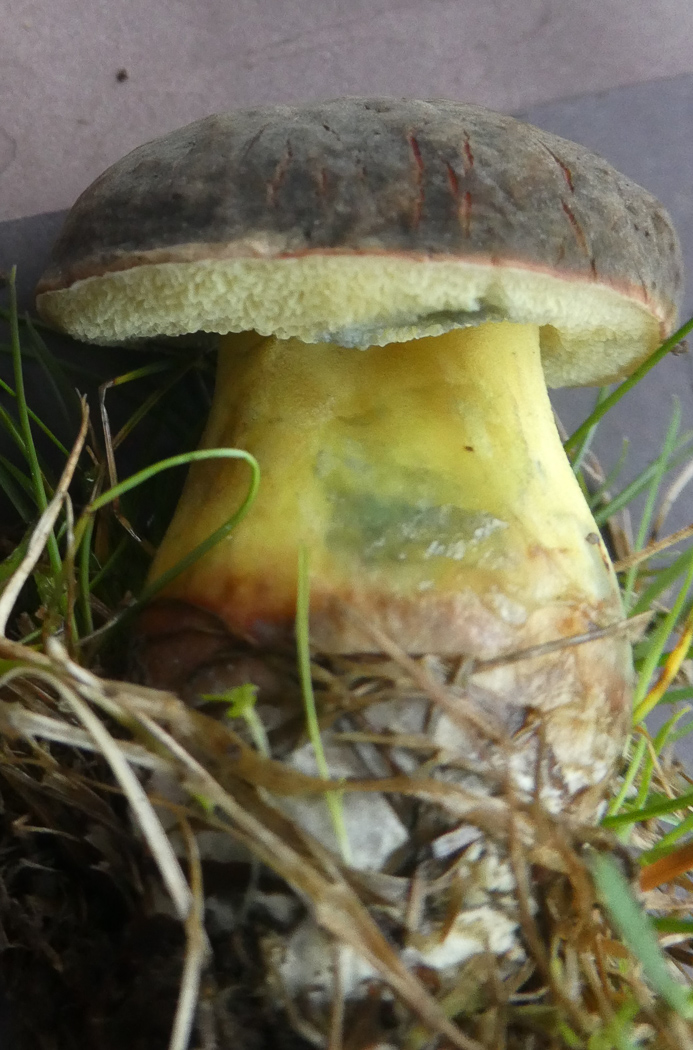 |
October 10th Xerocomellus cisalpinus (Bluefoot Bolete) In Austenwood Common under Oak with Lime nearby Jim Wills found this young bolete which when he assessed all the characters pointed him to this species though to Penny it appears more like X. pruinatus (Matt Bolete). However, Jim comments on it quickly blueing and also on the white flesh within rather than yellow, both feature favouring X. cisalpinus. This group of species are always tricky and when young look extremely similar. Previous finds |
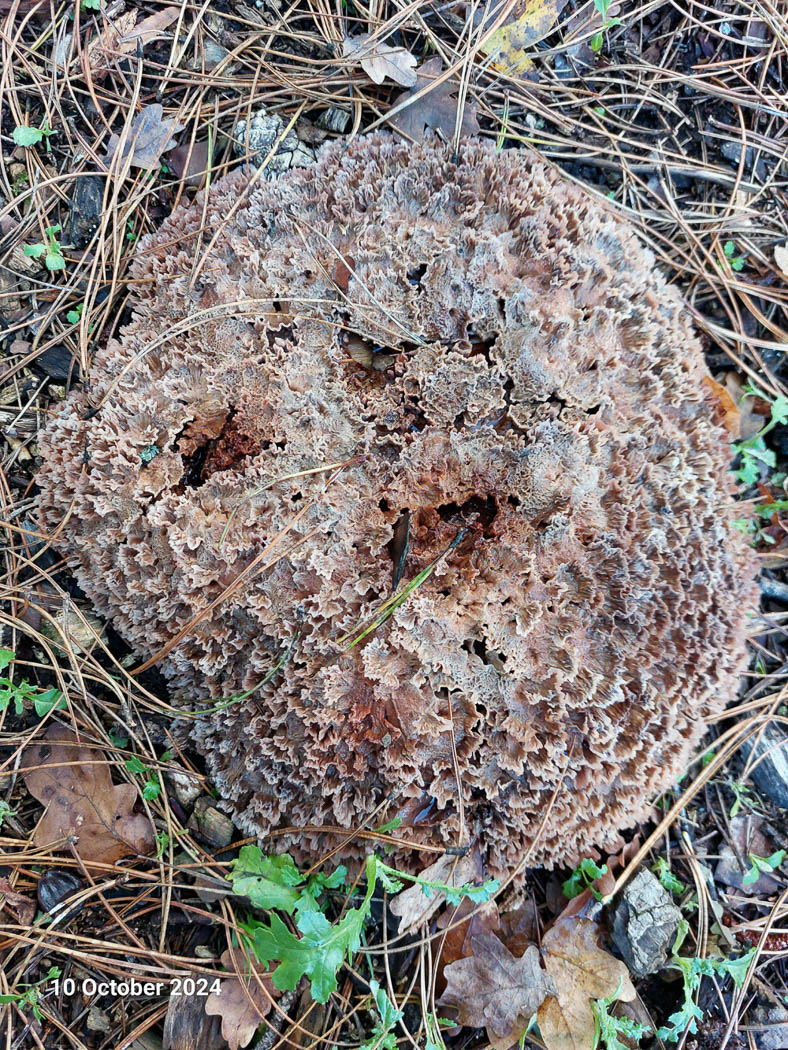 |
October 10th Podoscypha multizonata (Zoned Rosette) In Beaconsfield in the grounds of a school Jesper Launder saw this impressive beast which was over 1 ft across. However, he checked the microscopic characters to make sure because to him it appeared underdeveloped for the species, in which when fully grown this specimen will be enormous! It appears so distinctive, also from the number of UK records not that rare, but we have just two county records, both from Black Park in the early 2000s. A nice find! |
|
|
October 10th Cortinarius subbalaustinus (Burnt Orange Webcap) In Beaconsfield in deep moss under Birch Jesper Launder found this cluster of Cortinarius which needed work at home to identify. This is an uncommon large member of Section Telamonia which associates with Birch, has a streaky hygrophanous orange cap which fades, a stem with clavate base and a sour smell. Jesper commented that it seemed to fit all details well and was a new species for him. It is also new to the county. |
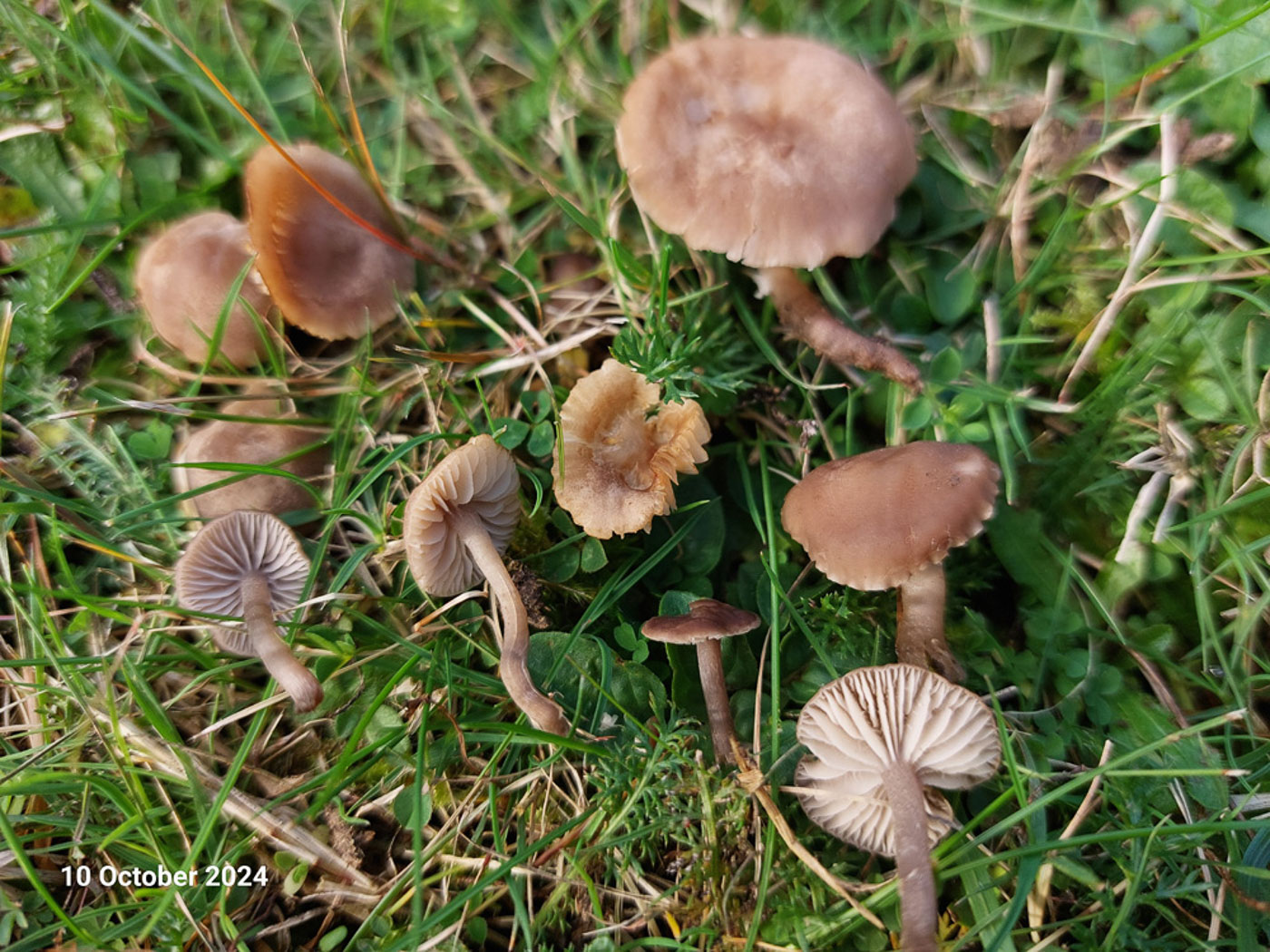 |
October 10th Dermoloma pseudocuneifolium (Dark Crazed Cap) In a grassy garden in Beaconsfield amongst many Parrot Waxcaps, Jesper Launder noticed this group of LBJs and suspected they were the common grassland species D. cuneifolium. Checking at home, however, he noted that the main difference between that species and this much rarer one is that D. pseudocuneifolium has mildly amyloid spores which tallied with this collection perfectly. We have just two previous county records for this species though it may well be that it is not that rare but is easily confused with the commoner species unless the spores are checked with Melzers reagent. Previous finds |
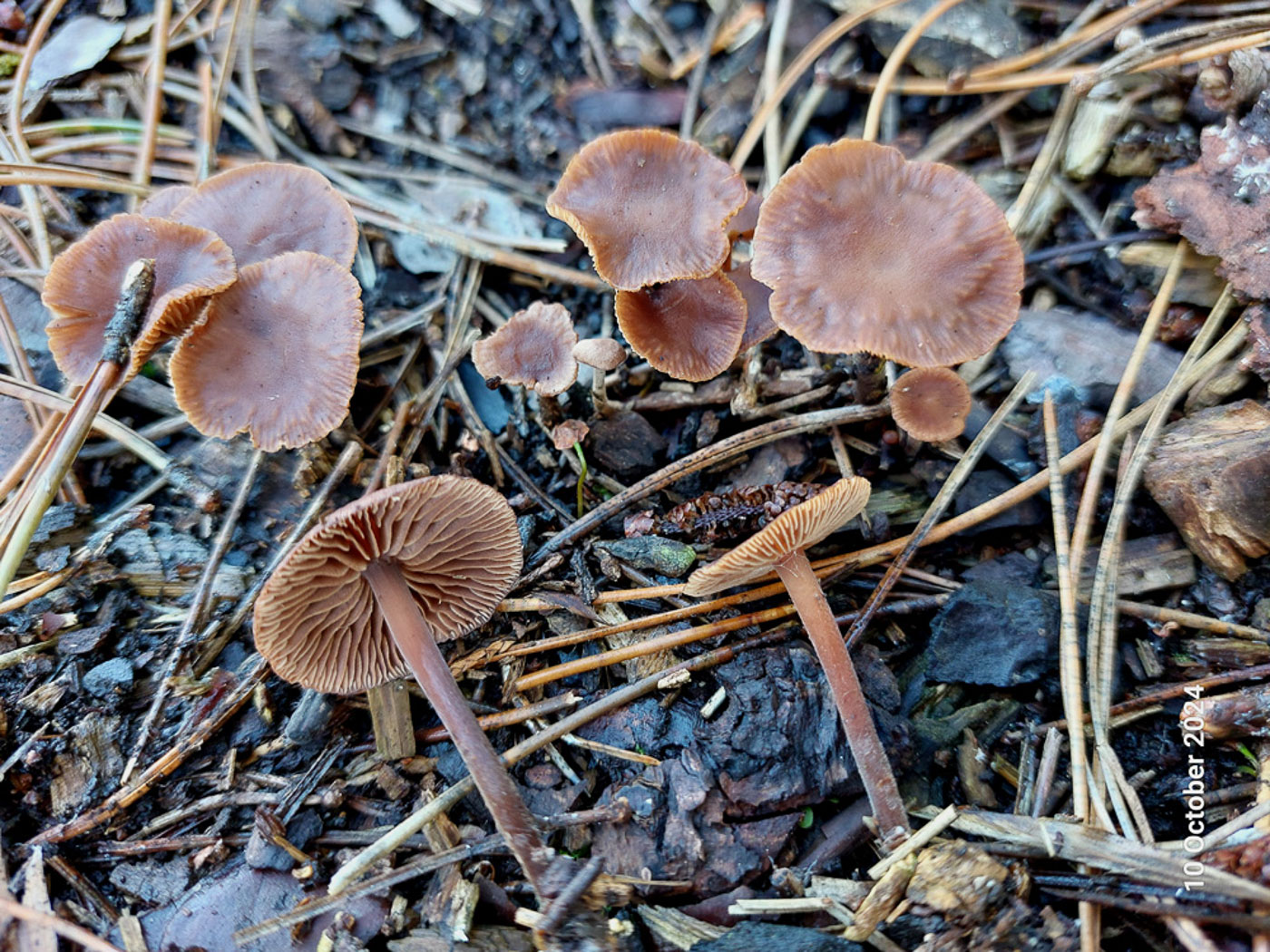 |
October 10th Gymnopus obscuroides (a Toughshank with no English name) In Beaconsfield Jesper Launder noticed this rather small and dark LBJ - a species of Gymnopus, and wondered if it might be G. fuscopurpureus which turns green where treated with KOH but is otherwise very similar to G. obscuroides. At home KOH proved negative, though there is a further very similar species which we find at Stoke Poges Memorial Gardens and now has been sequenced as Collybiopsis villosipes with very few UK records as yet. It would therefore be good to get a sample of this Toughshank sequenced, especially as the Collybiopsis is not included in available books such as the 4 Kibby volumes. See the Finds entry under that name for comparison. Previous finds |
October 9th 2024
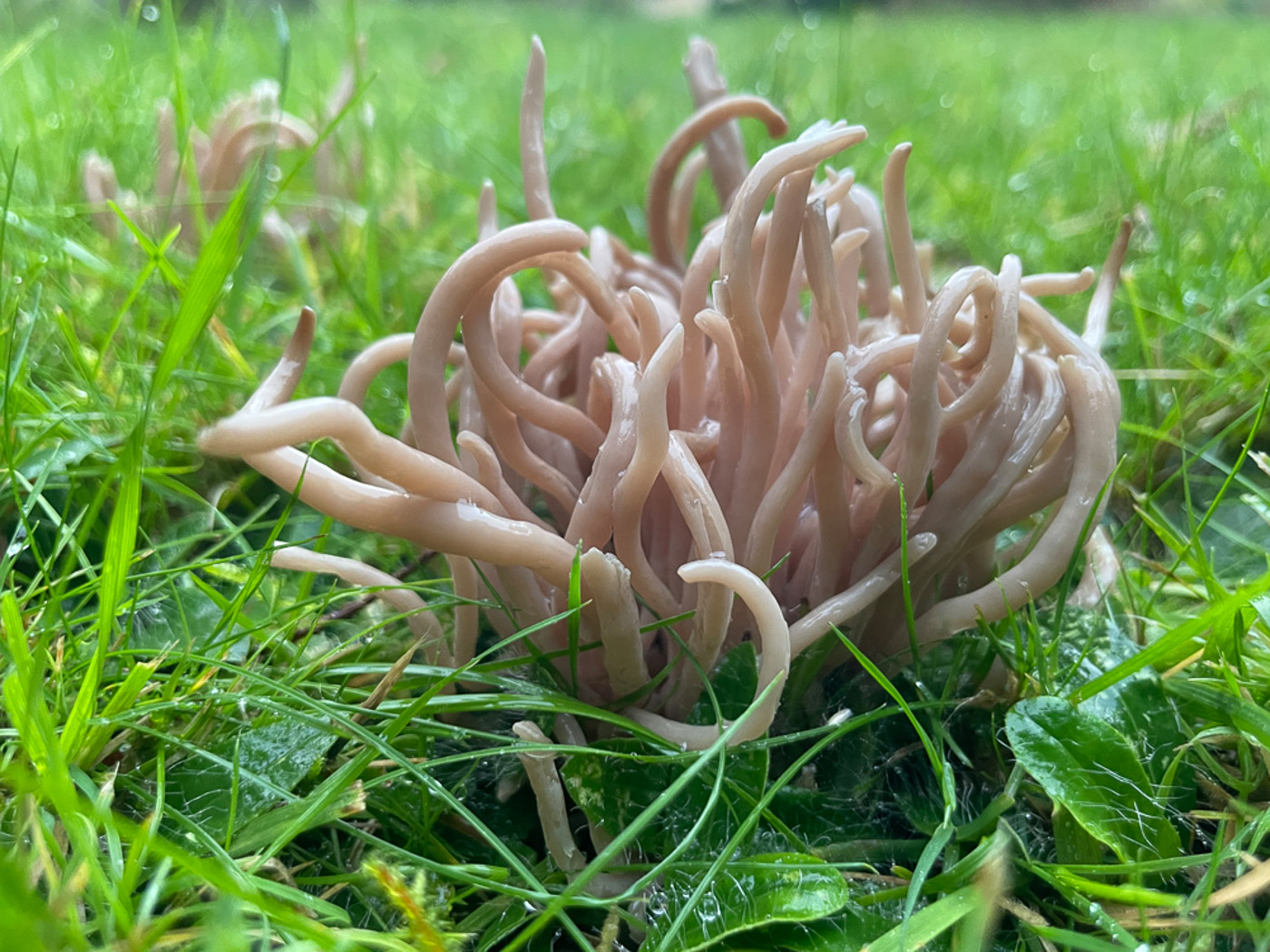 |
October 9th Clavaria fumosa (Smoky Spindles) At Prestwood Churchyard Sarah Ebdon found this beautiful and subtle-coloured club coming up in its usual grassy spot near a large Yew. Though not a common species it appears to be a regular at this site where Penny recalls being excited to find it for the first time 20 years ago, never having seen it before. Previous finds |

.jpg) |
October 9th Clavulina rugosa (Wrinkled Club) At Prestwood Churchyard this was one of several species found by Sarah Ebdon. It favours grassy woodland glades rather than pure grassland sites and here was quite near to trees. It has rather distorted uneven clubs with blunt tips sometimes diverging and grows in groups though not in tight clusters. Previous finds |
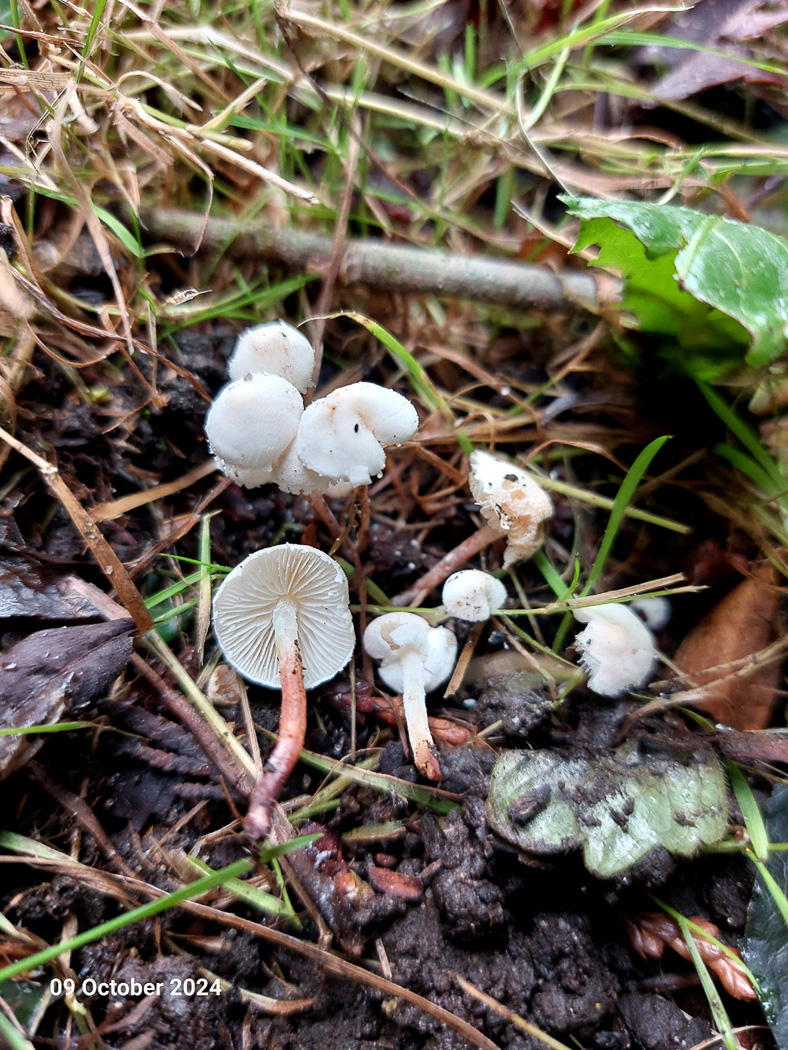 |
October 9th Cystolepiota seminuda (Bearded Dapperling) Along a grassy path at Beaconsfield Golf Course Jesper Launder noticed this little group. Their small size together white free gills, grainy cap surface and a tendency for the stem to be reddish in the lower half were enought to make the ID, confirmed by checking its tiny spores. Though quite a common species this is a new entry for Finds. |
October 8th 2024
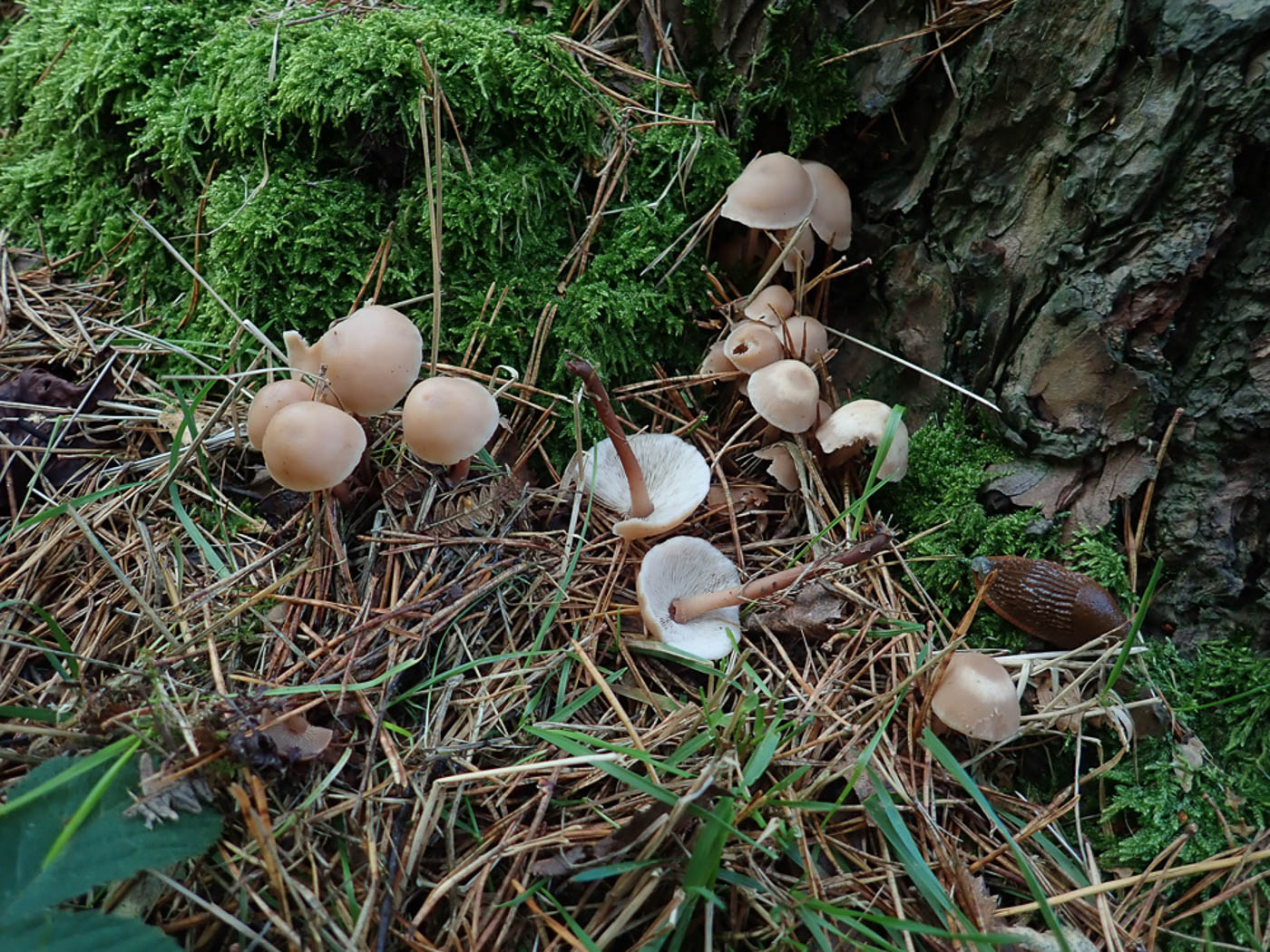 |
October 8th Gymnopus confluens (Clustered Toughshank) At Turville Heath Penny found this group at the base of a Pine though the species is probably more frequent in deciduous litter where it is very common. Features to note: the crowded pale gills and reddish stem which, however, is finely furry all over - this feature helping to separate it from the similar G. erythropus which has a shiny smooth red stem though is less frequent. Previous finds |
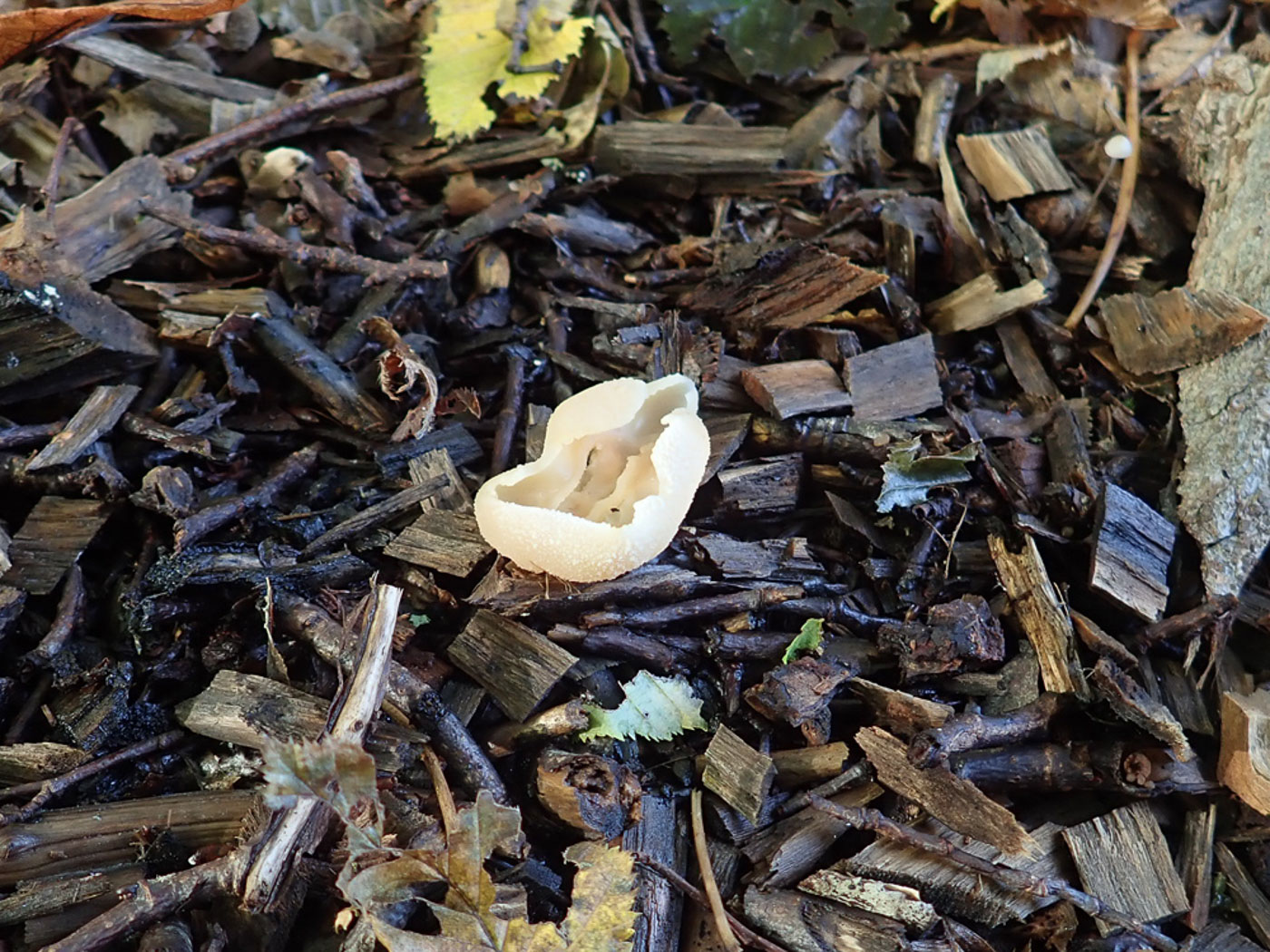 |
October 8th Peziza micropus (Pedicel Cup) In deciduous woody debris at Turville Heath Penny spotted this pale beige cup and took it home to identify. This took ten days, however, before the all-important spores were mature enough (ie having been expelled from the asci) to show their size, shape and ornamentation - all vital to keying out this genus. Previous finds |
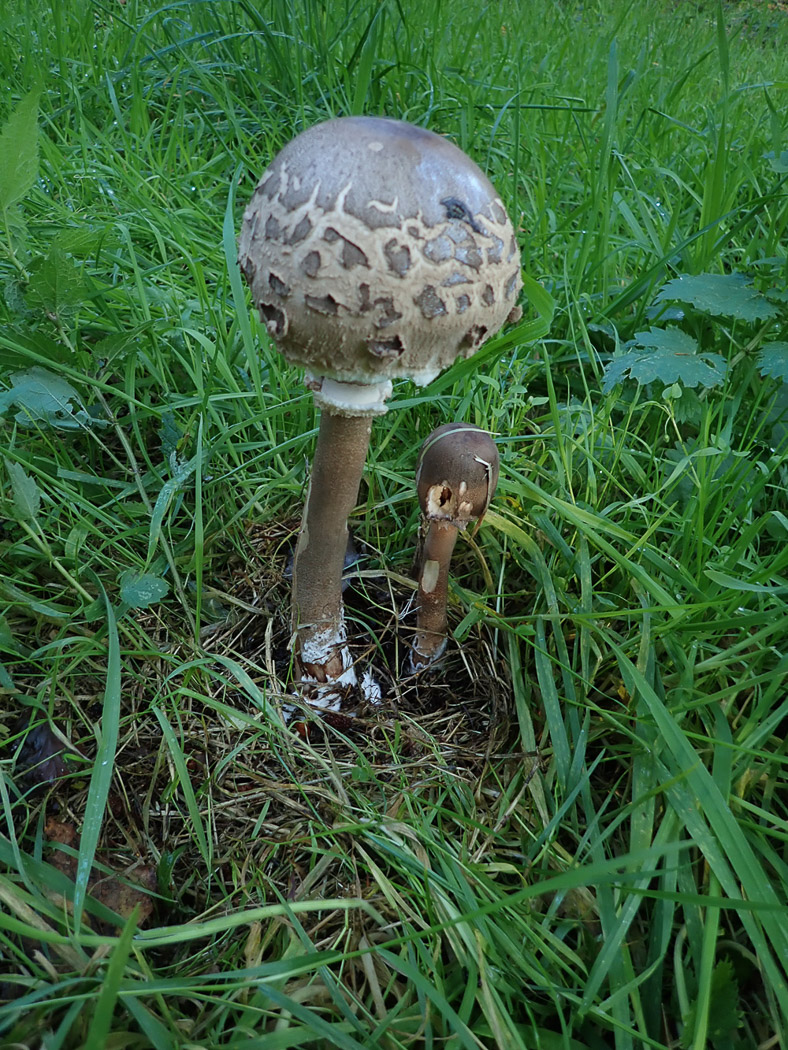 |
October 8th Macrolepiota procera (Parasol) At Turville Heath this is a very common species and is just getting under way now, found here by Penny in grassy areas near to deciduous trees. Previous finds |
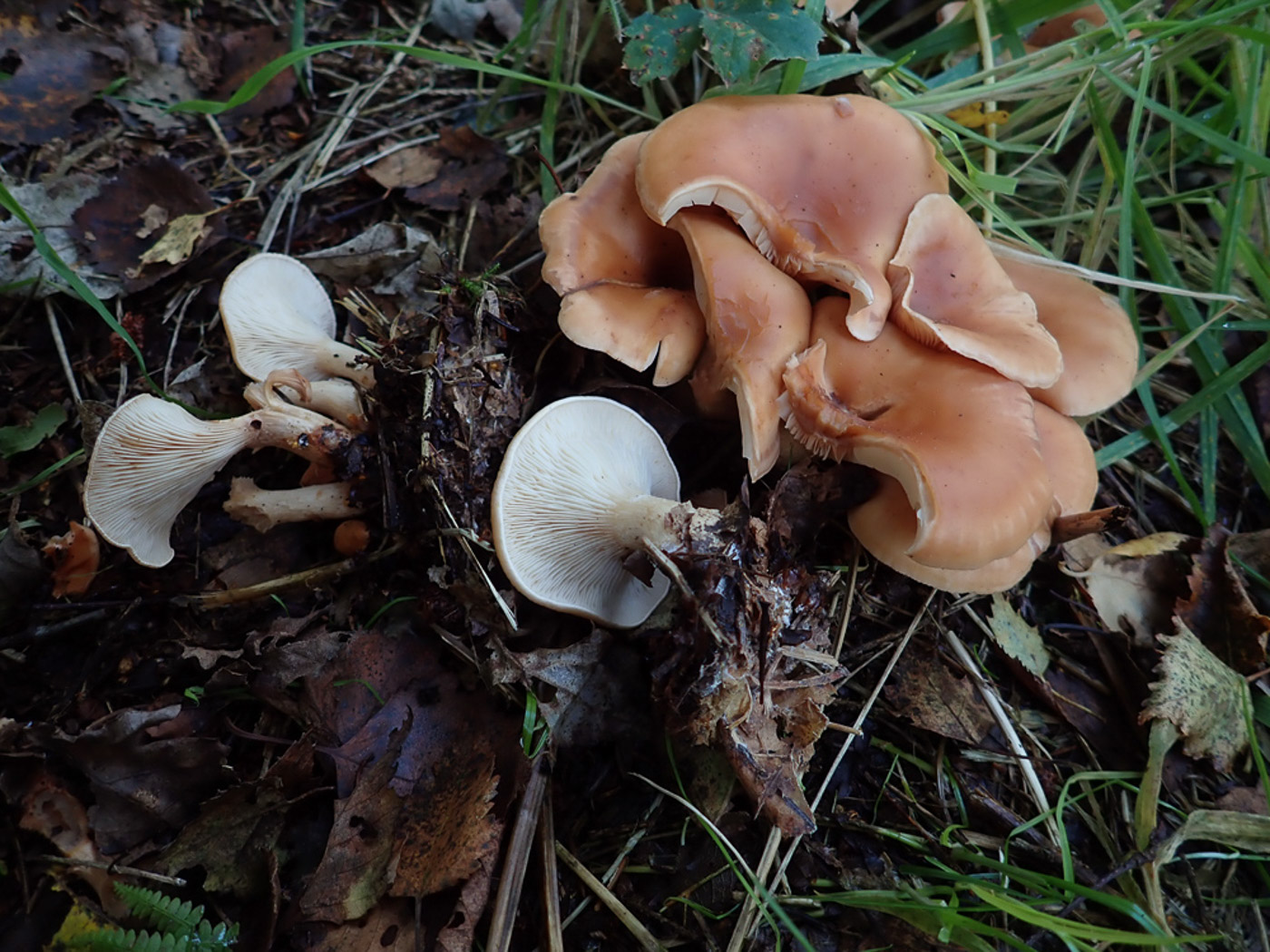 |
October 8th Paralepista flaccida (Tawny Funnel) At Turville Heath things are still moving pretty slowly, but Penny found typical material of this common and distinctive species in the litter under Birch. It occurs frequently under conifer as well as deciduous litter often in troupes. Previous finds |
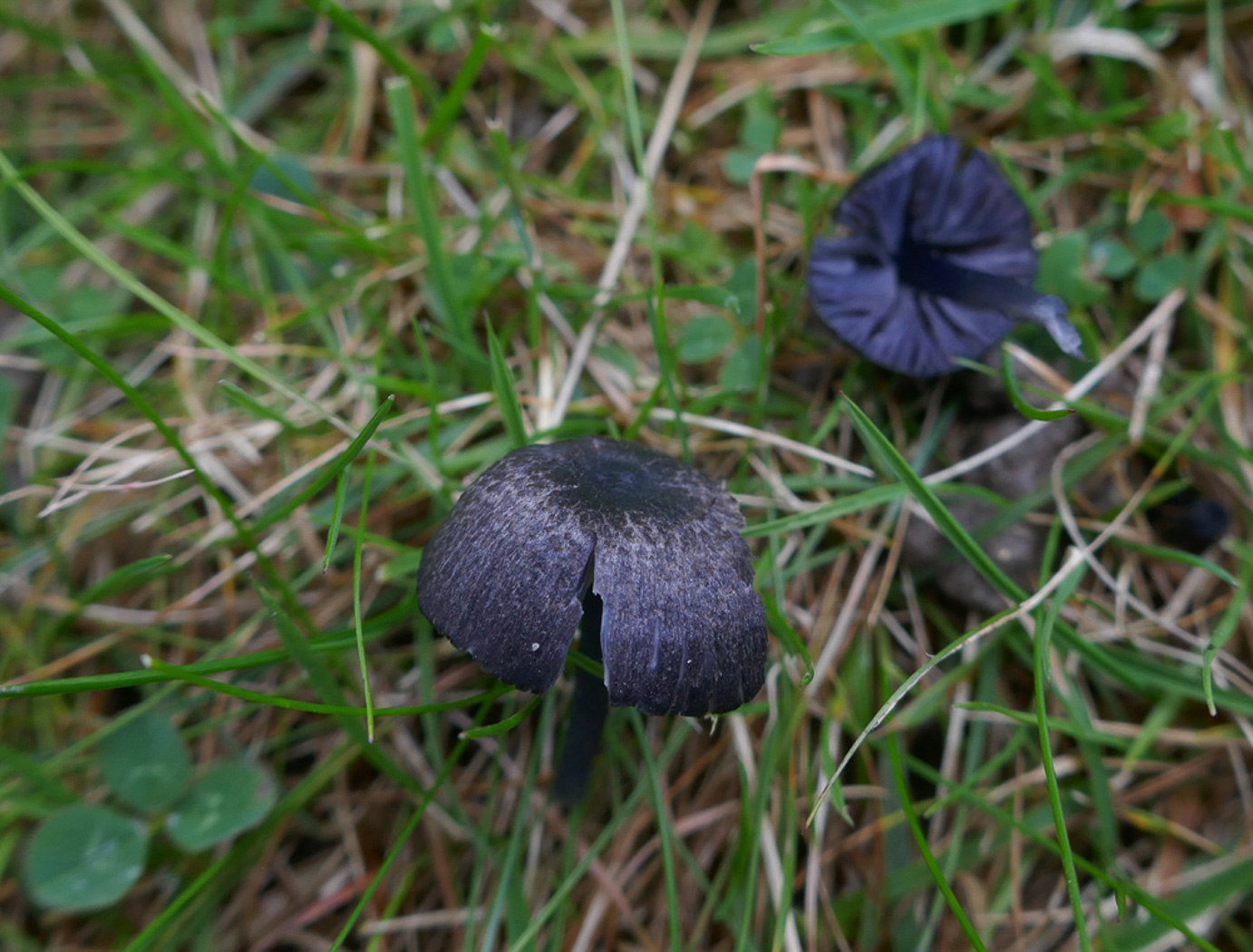
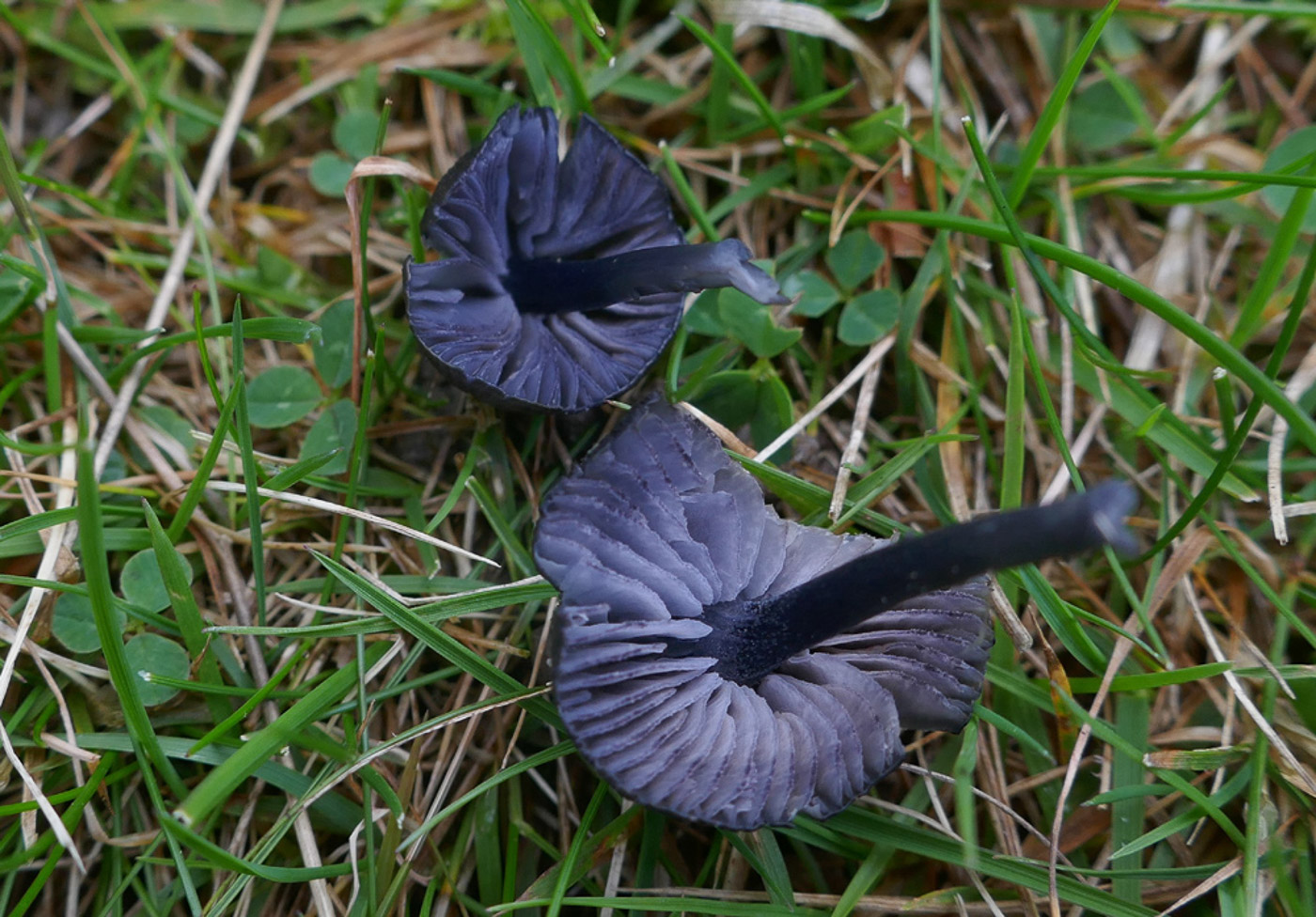 |
October 8th Entoloma serrulatum (Blue-edged Pinkgill) At Stampwell Farm Jackie Ewan found this species together with some other Pinkgills in a heathy grassy area. It is one of the small blue Pinkgills (placed in Section Leptonia) which have a blue edge to the gills and also has a roughened cap surface. Though apparently one of the commonest of this group of species, we do not have that many county records. Previous finds |
October 7th 2024
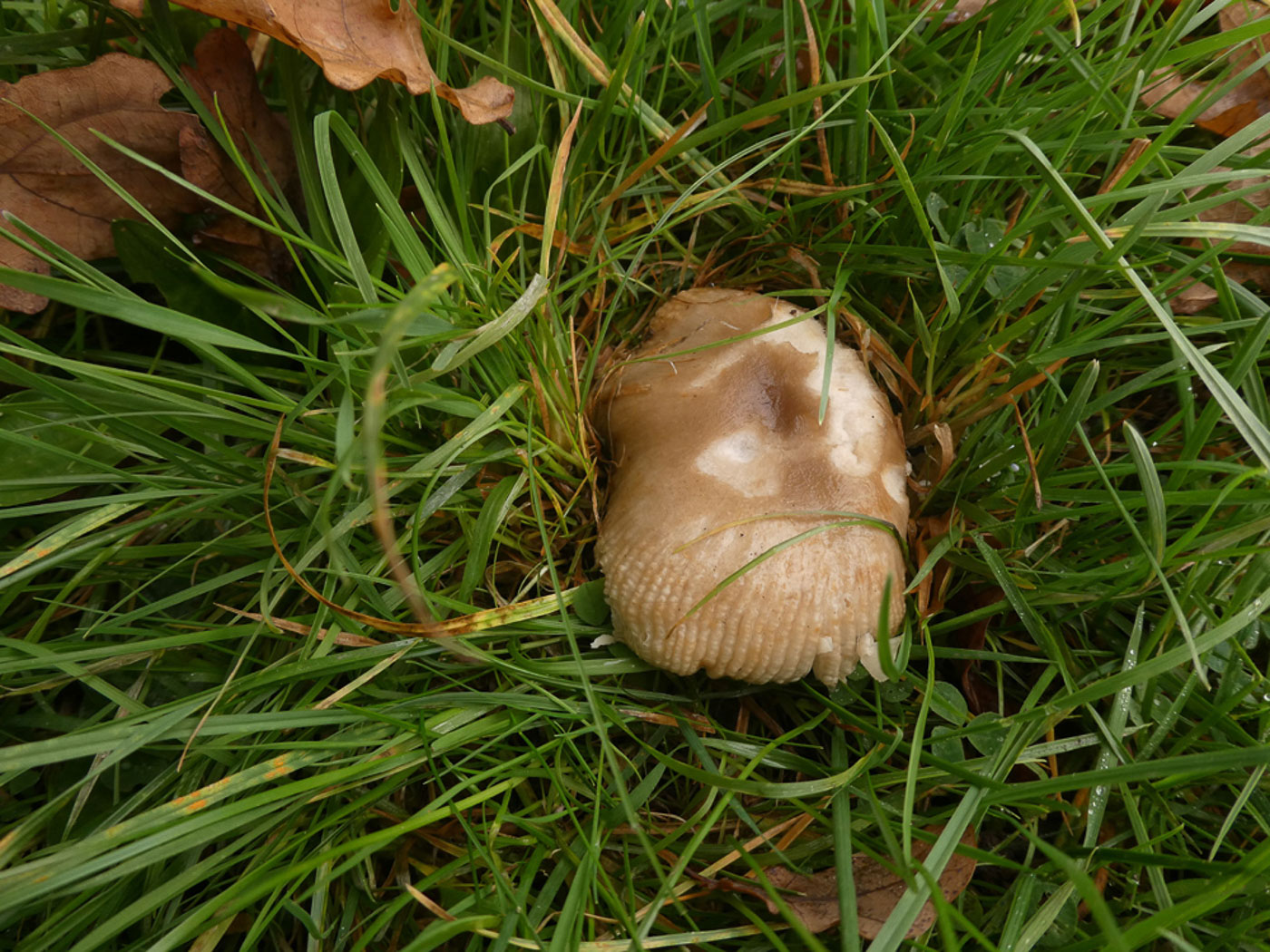
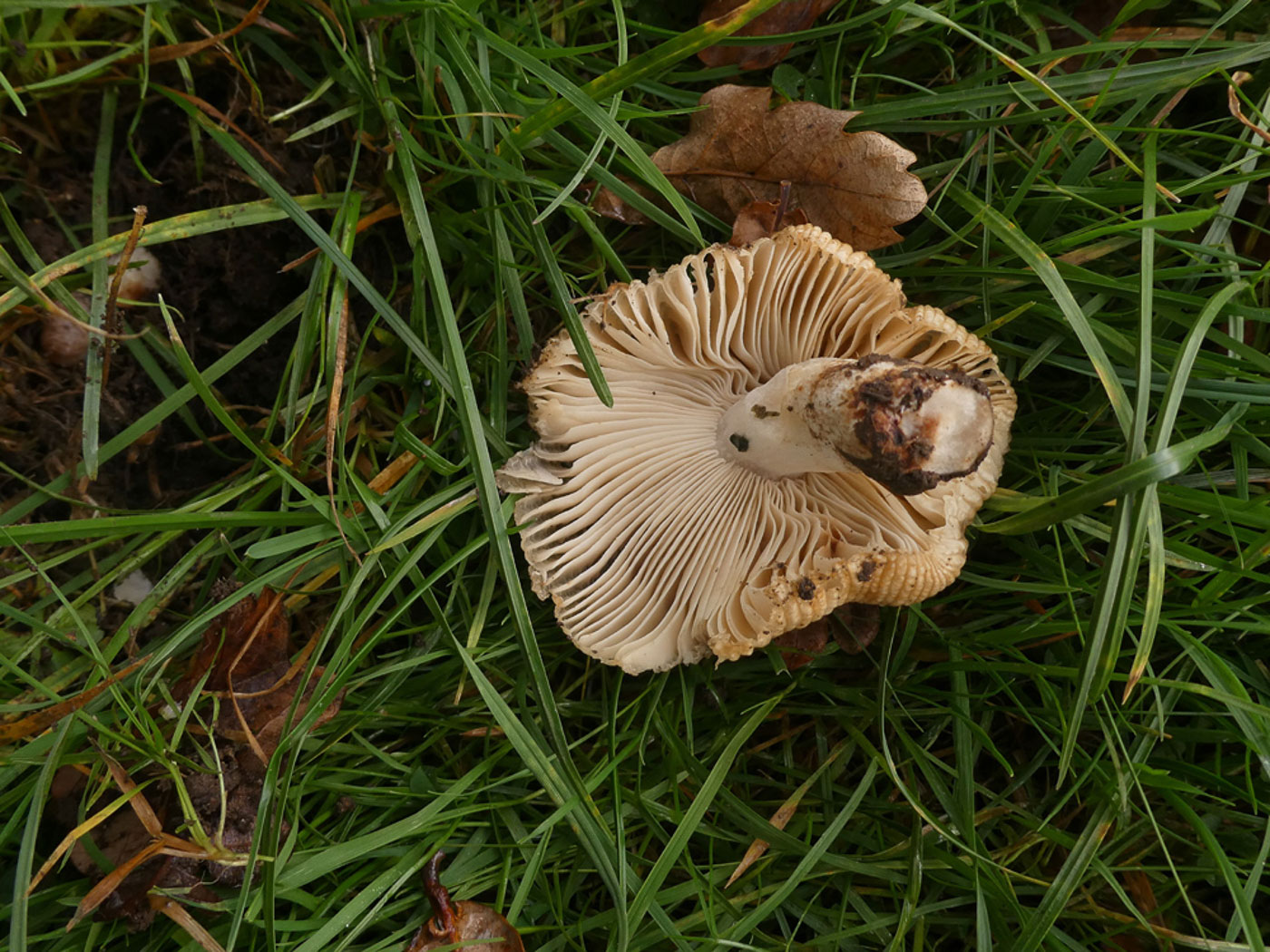
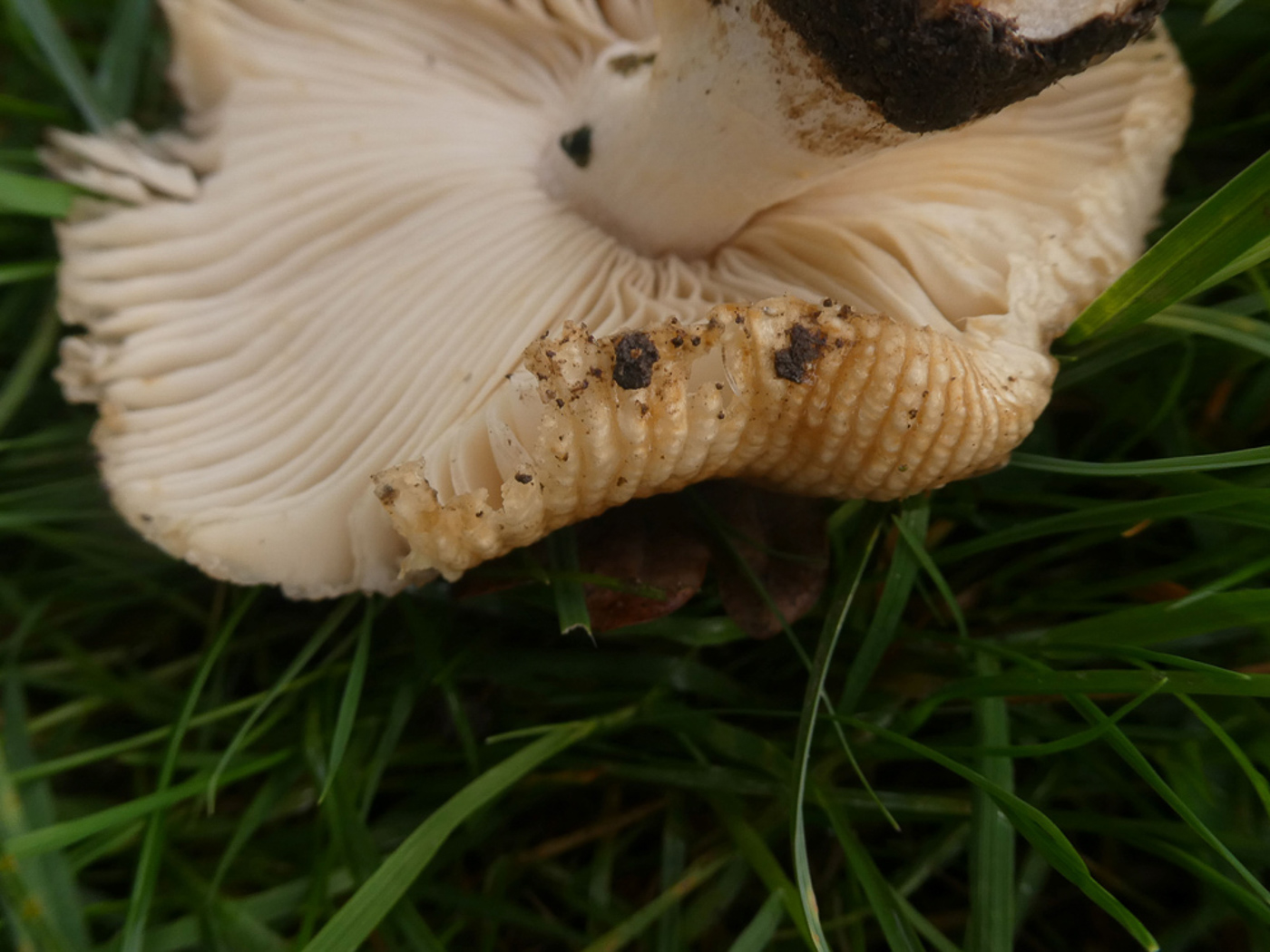 |
October 7th Russula sororia (Sepia Brittlegill) In Austenwood Common Jim Wills found this pale Russula under Oak with which it most commonly occurs. It is one of two very similar species, both belonging to a group of Brittlegills commonly nicknamed 'the smellies' for obvious reasons! Several in this group have an unpleasant cheesy / smelly socks smell and also look very similar being pale and also sticky in wet weather, occurring under Oak. A drop of Guaiac on the stem helps to separate these two, however: it turns deep blue within 10 seconds on R. amoenolens (Camembert Brittlegill and much the commonest of the group) but shows little if any reaction in this time on R. sororia. Jim also discussed this collection with Jesper Launder who confirmed his iD. Previous finds |
 |
October 7th Leucoagaricus cf. carneifolius (a rare Dapperling with no English name) In mossy grass under a large Yew at Prestwood Churchyard Penny noticed what she at first thought might be a small Agaricus - two immature frutibodies, one with ring still covering the gills, the other with ring just disrupting to reveal white crowded gills which had a faint pink glow. The caps were velvety smooth and pale grey but to her surprise a scratch to both cap and stem turned neither yellow nor pink as one would possibly expect in Agaricus. At home there was no sign of the gills becoming darker, nor was there much smell, but there was no point in attempting a spore print with such an immature specimen. So Leucoagaricus seemed the likeliest genus and the only near match seemed to be L. carneifolius, for which there are under 30 UK records, though there are a few deviations from the species description, hence the inclusion of cf in the identification. Unfortunately though a sample was sequenced the result was inconclusive as no sequence of this species exists as yet to compare it with. Previous finds |
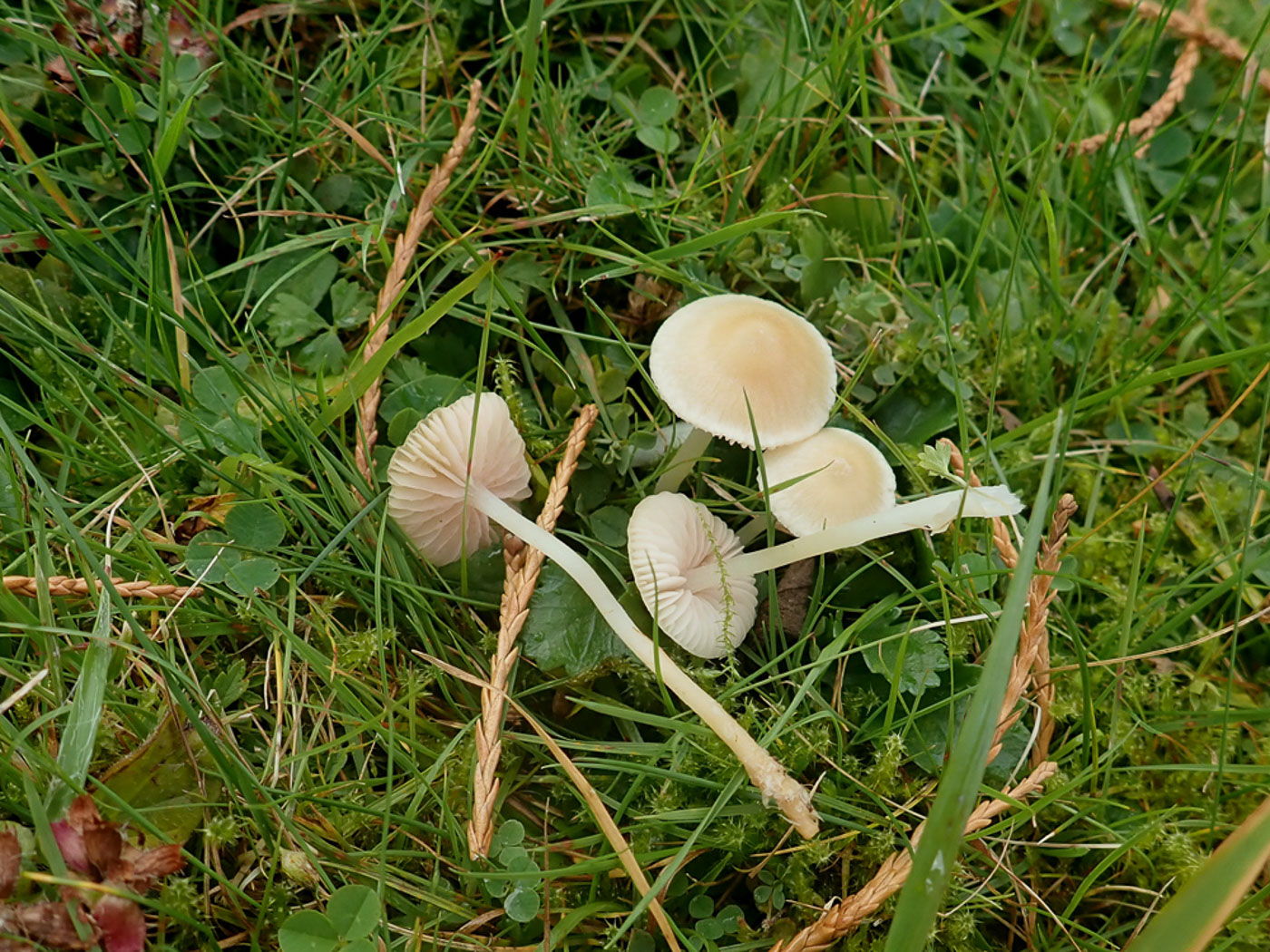
 |
October 7th Entoloma sericellum (Cream Pinkgill) At Prestwood Churchyard Penny found good numbers of this pale Pinkgill coming up in the short mossy grass. Not being a particular fan of the genus she was unsure of the species but as it was fruiting so prolifically she was keen to determine it. Though many online images of the species show a pure white mushroom, she learnt that this is not necessarily the case (as the English name reflects) and it may be that many white Pinkgills are named E. sericellum in error. Anyway the micro-details and general description fitted this collection well. Surprisingly though we have many county records (which I now have some doubts about!) this has not been recorded here before. Previous finds |
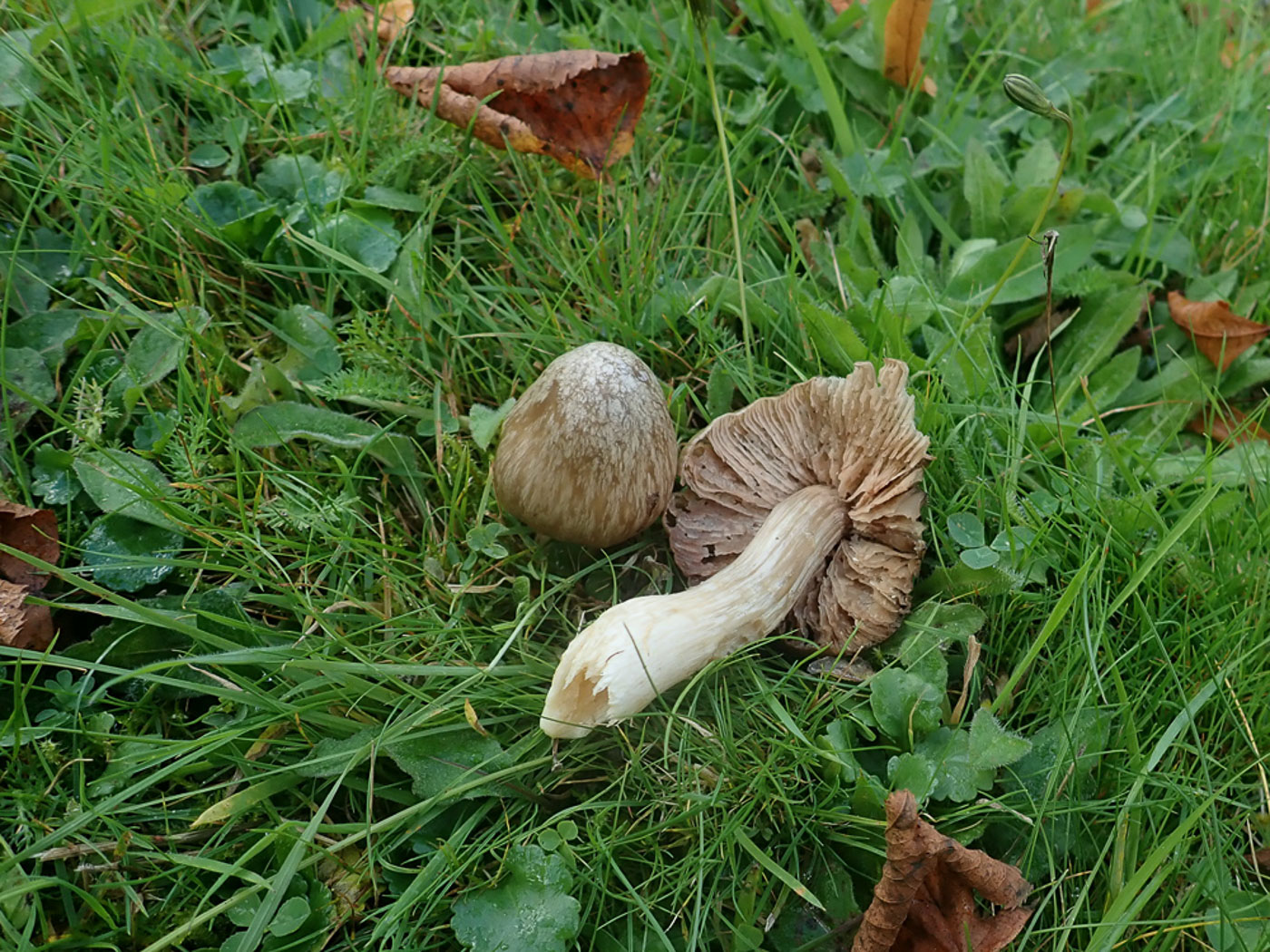 |
October 7th Entoloma prunuloides (Mealy Pinkgill) Having received a photo of this species just taken at Prestwood Churchyard by a non-member wanting to know what it was, Penny decided to visit herself and was suitably rewarded, finding not only this same specimen but a load of other interesting species as well. This is quite a distinctive Pinkgill with thick flesh and stem and a distinct smell of meal - quite often found in this genus. She'd found it here last year which also helped though we have only a handful of other known grassland sites for it but it is by no means rare. Previous finds |
 |
October 7th Hygrocybe citrinovirens (Citrine Waxcap) At Prestwood Churchyard Penny was delighted to see this unusual waxcap whic- both here and at Stowe Landscape Gardens, our only two sites for it. The conical shape together with distinctly greenish yellow colour - very different from other yellow waxcaps - were enough to confirm it, furthermore it was in the identical spot to last year! Previous finds |

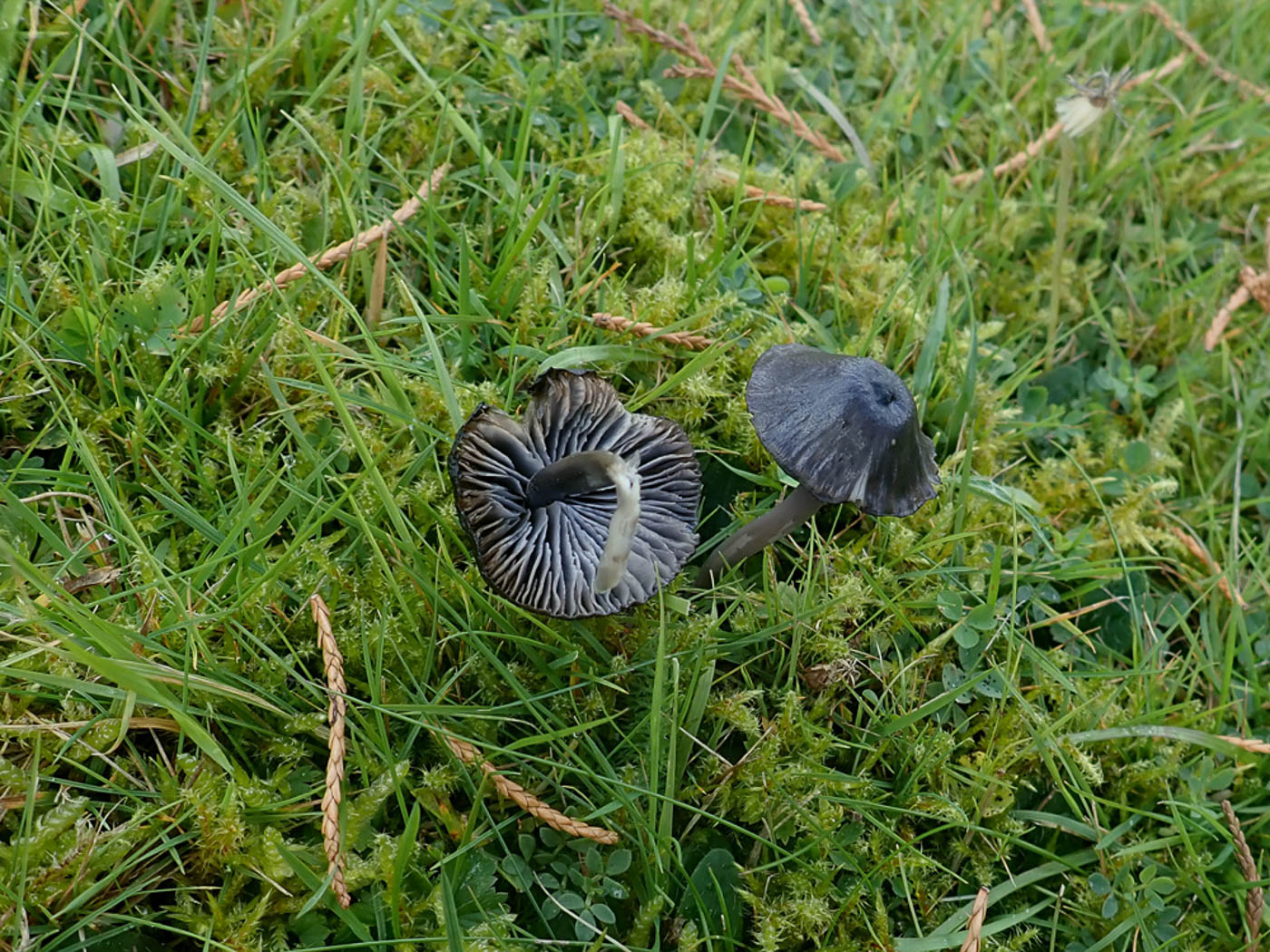

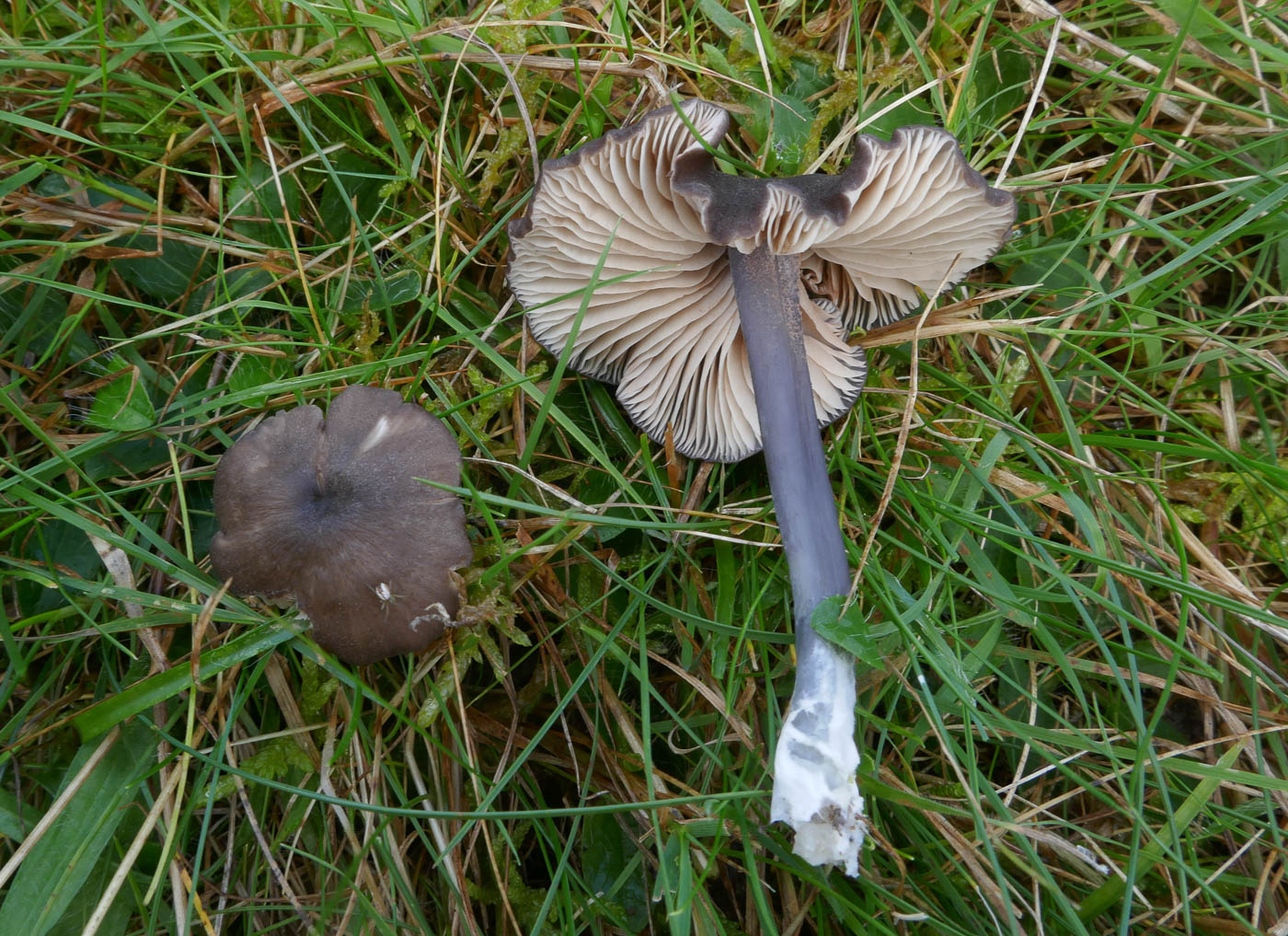
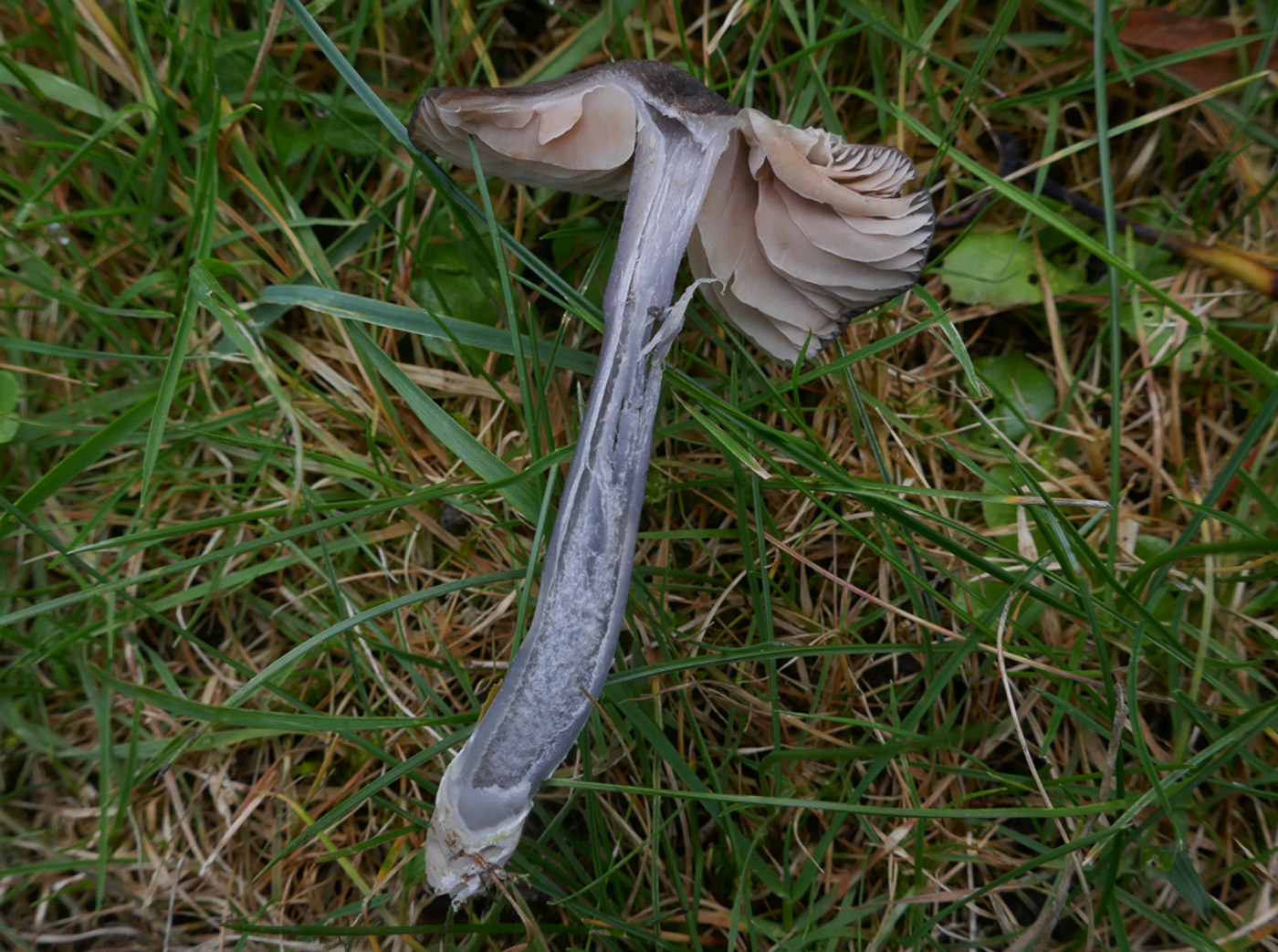 |
October 7th Entoloma corvinum (Crow Pinkgill) At Prestwood Churchyard Penny found these little beauties together with a range of other nice things - a treat after the recent rather disappointing weeks. These small grassland Pinkgills with blue colours belong to Section Leptonia and though there's no difficulty in placing them within this section Penny never finds them easy to identify to species! She worked hard with the scope and various keys, finding some conflicting descriptions which caused some doubts, but ended up with this species which does seem to fit well. However, on finding that we've no previous Bucks records she fears the name is incorrect though this is just the sort of site where special and interesting grassland species would to be found. As so often happens, Jackie Ewan also worked on and identified this species at Stampwell Farm, making collections on both the 8th and 10th. Both Penny's collections will be sequenced and this entry updated accordingly as necessary. |

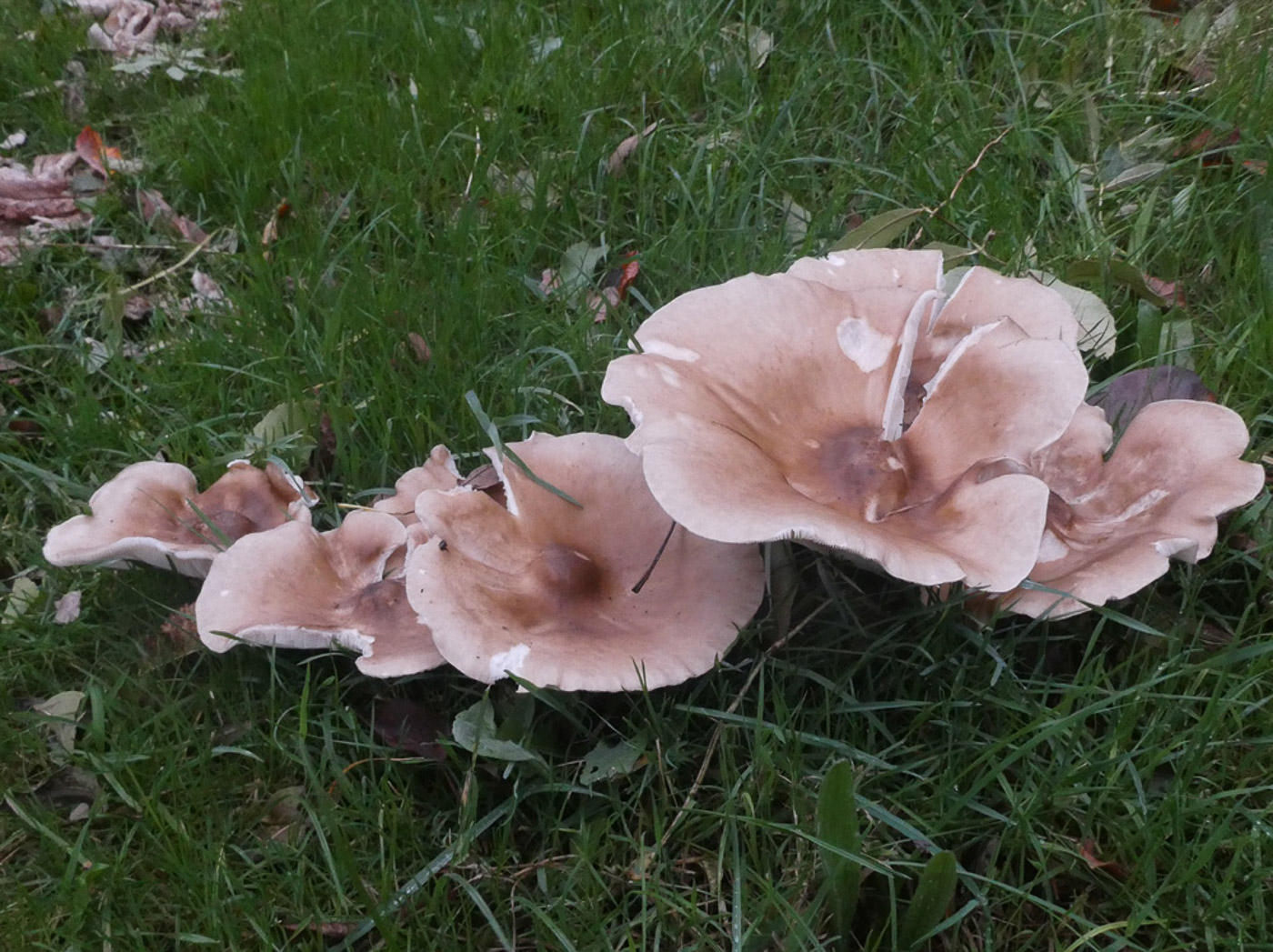
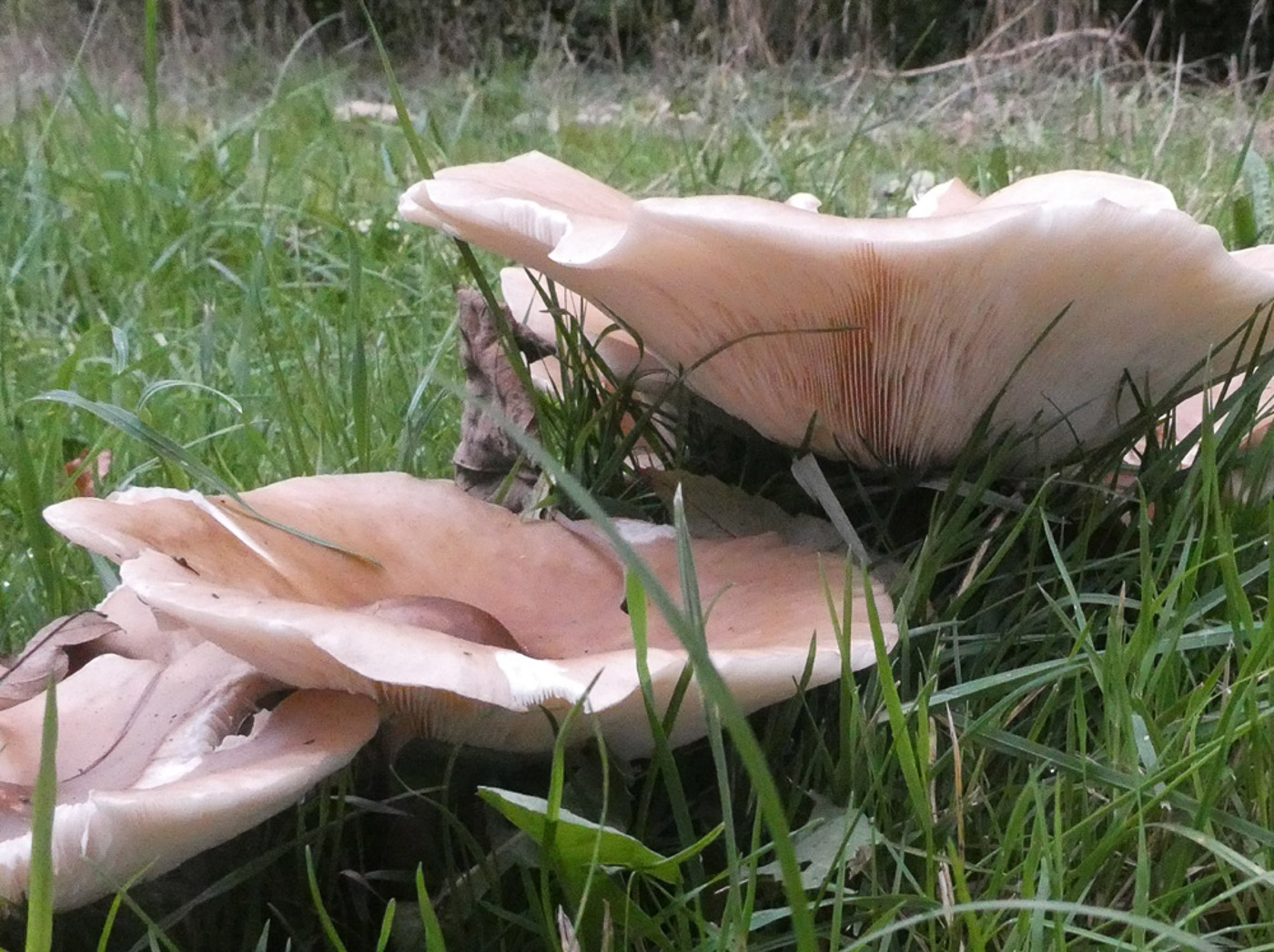 |
October 7th Infundibulicybe geotropa (Trooping Funnel) In longish grass on Austenwood Common Jim Wills came across this impressive display of fruitbodies, identifying them on the spot as this species. The typical rounded central bump of the caps is clearly visible here and this is a large showy species usually with tall stems which are presumably somewhat hidden from view by the grass here. The species is common in grassy glades in woodland as well as grassy areas. Previous finds |
 |
October 7th Cortinarius talus (Honey Webcap) Under Beech in Chalfont St. Peter Jesper Launder found this pair and noticed a striking smell of honey once collected. We have just three previous county records though it is described as a common species belonging to Section Phlegmacium, and though here they are immature and not yet expanded the wide stem base typical of the species at maturity is already visible. Found under Oak and Birch as well, it is the honey smell which is the key diagnostic feature. This is a new entry for Finds. |
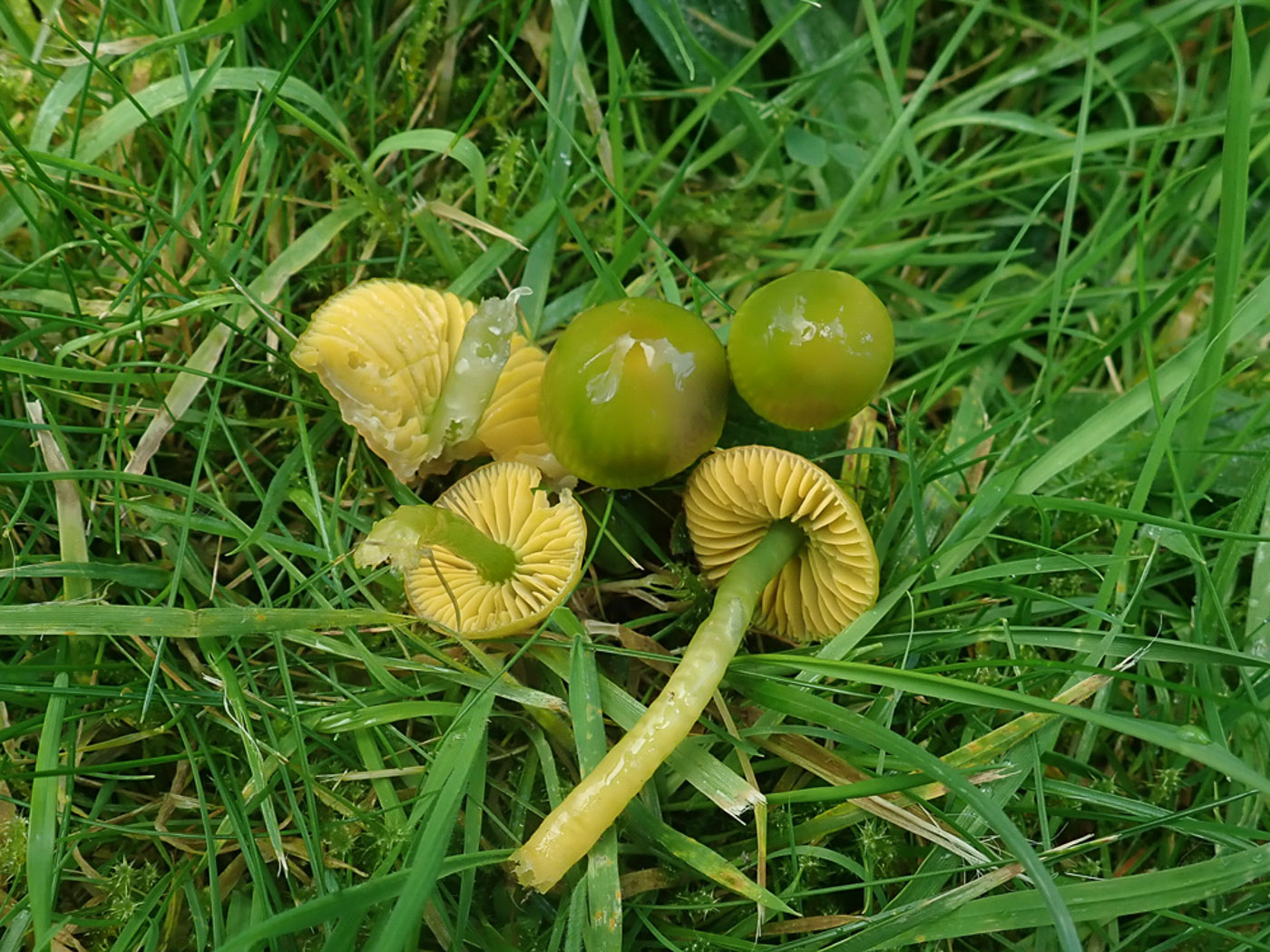 |
October 7th Gliophorus psittacinus (Parrot Waxcap) At Prestwood Churchyard this nice fresh collection was one of several waxcaps found here by Penny today. It was suitably slimy after a recent shower and the green caps and stem apices left no doubt as to its identity - one of our commonest but most pleasing grassland species to find. Previous finds |
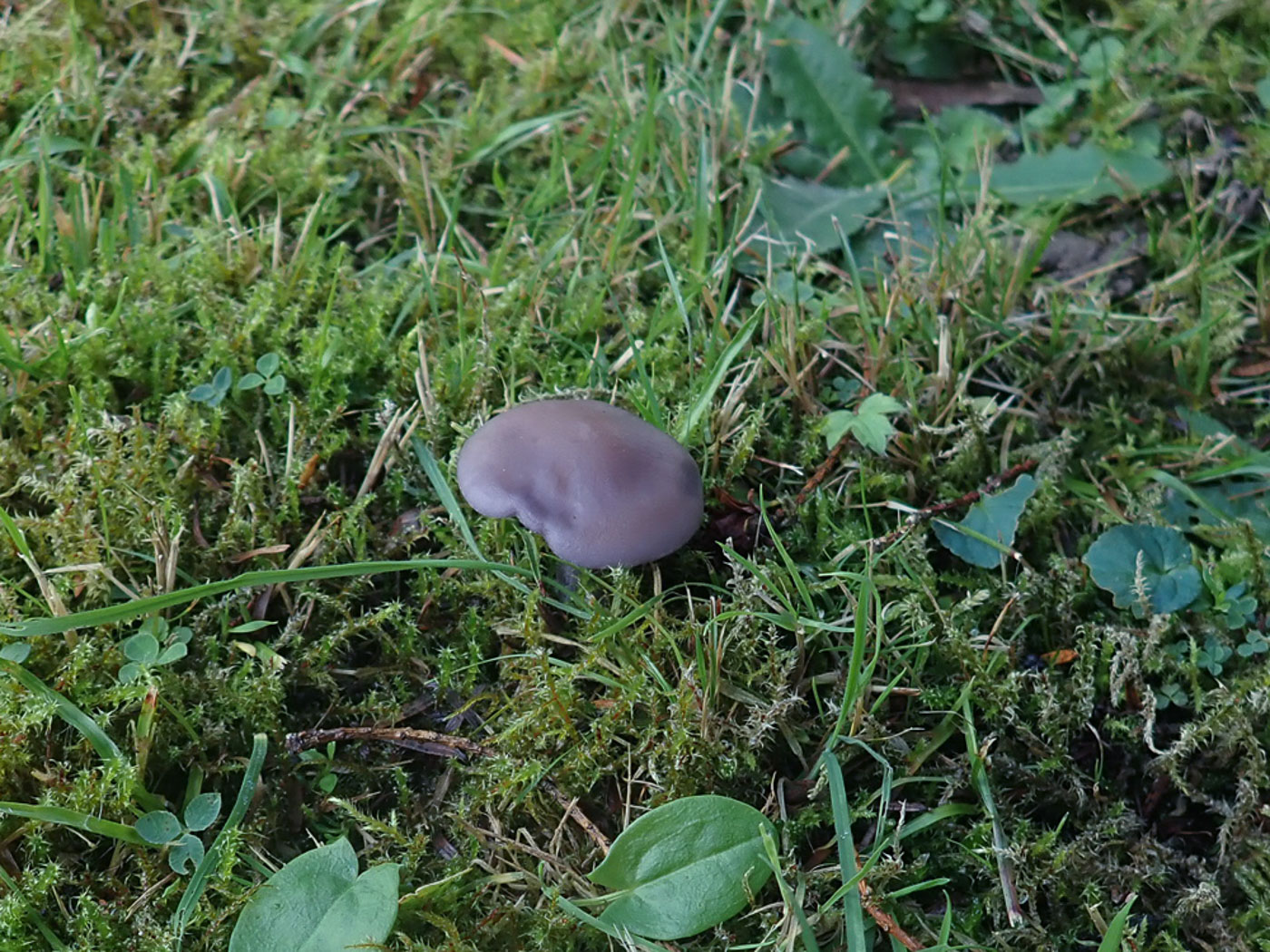
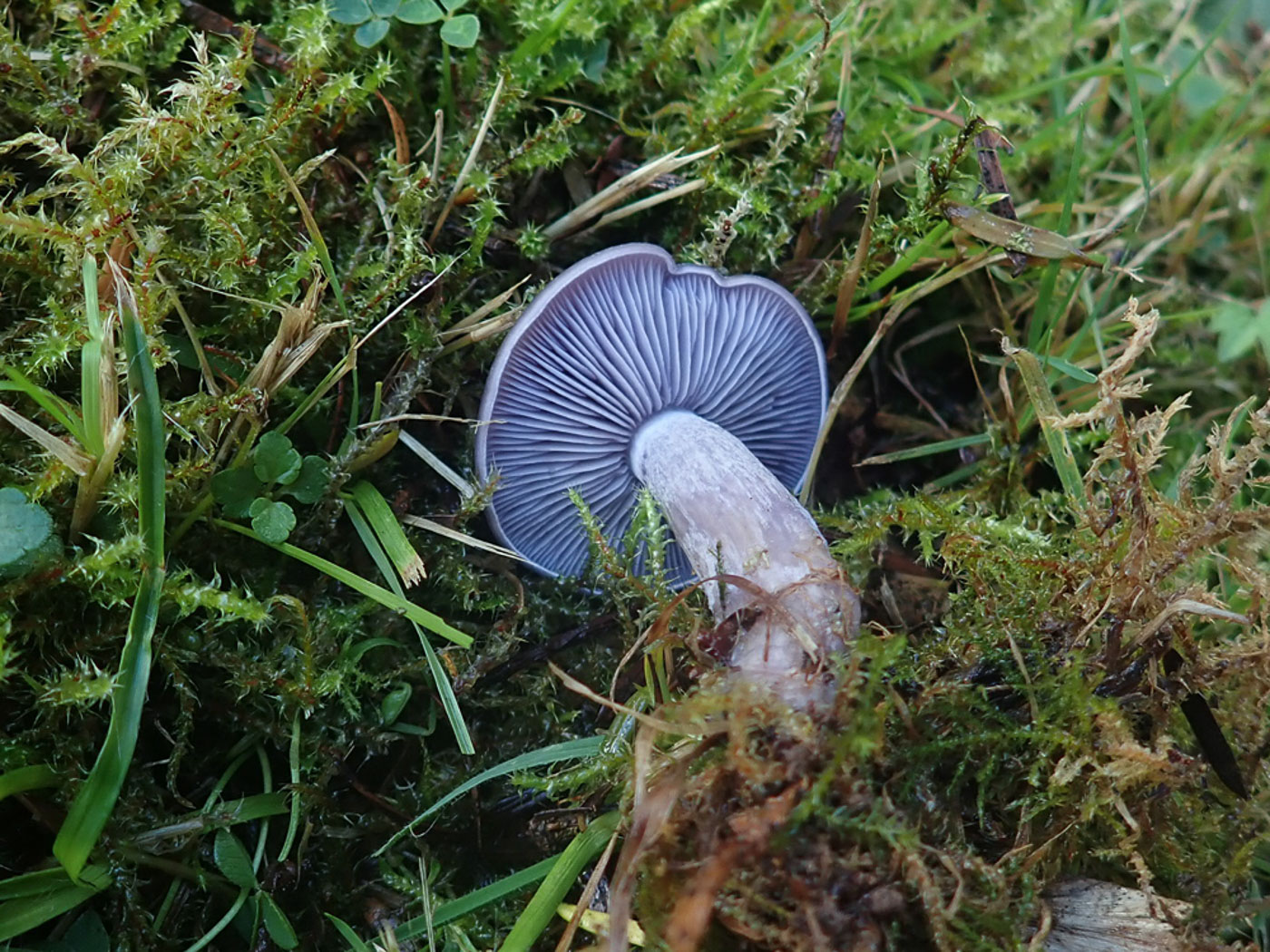 |
October 7th Lepista sordida (Sordid Blewit) In mossy grass under a large Yew at Prestwood Churchyard Penny spotted this singleton with brownish but distinctly violaceous cap, and turning it over the obvious violet gills confirmed her suspcions that it was this species - considerably smaller and thinner-fleshed than the similar L. nuda (Wood Blewit). It favours grassland habitats but can also occur in woodland grassy glades but is not a s common as the larger species. Previous finds |
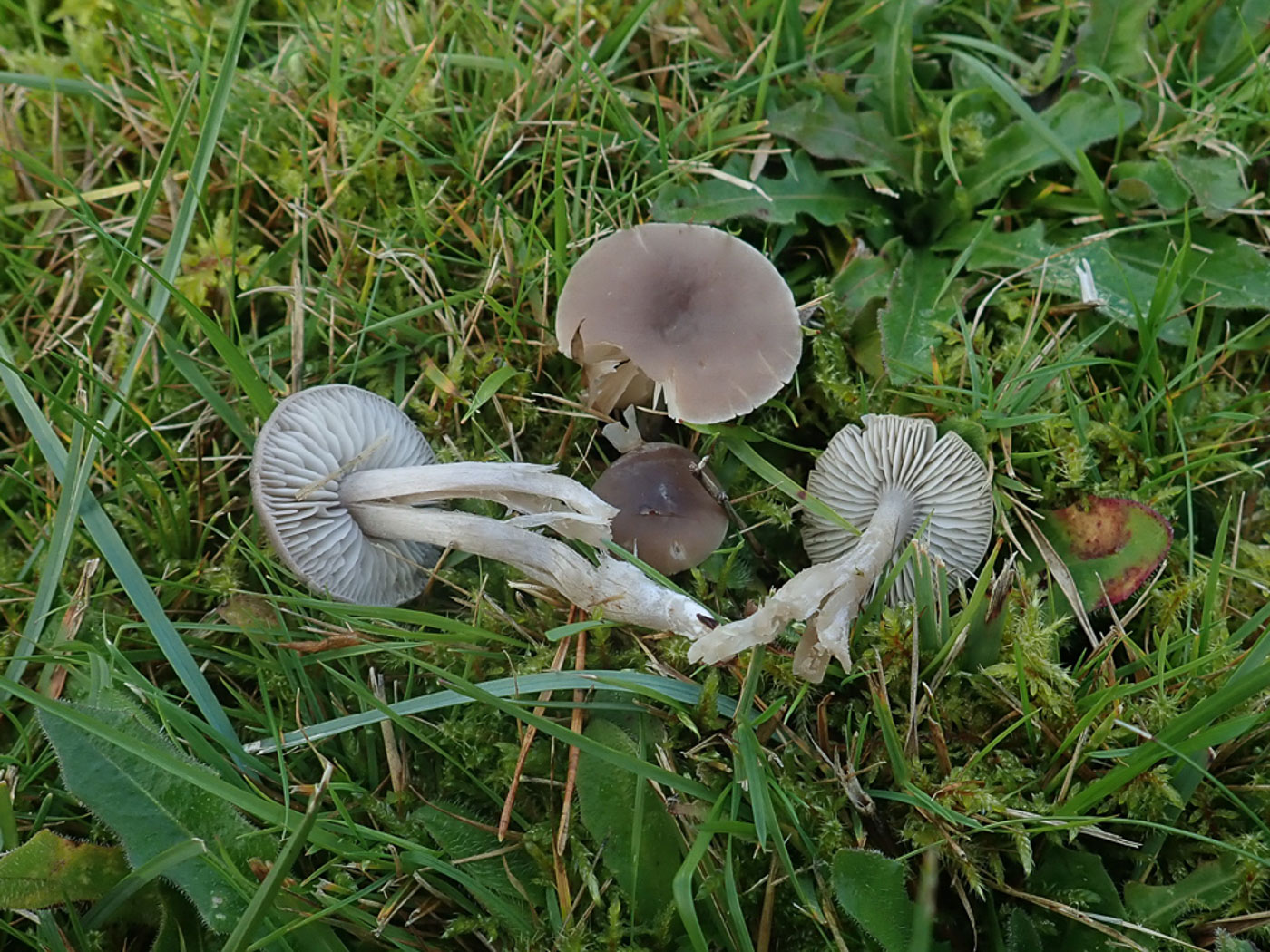 |
October 7th Dermoloma cuneifolium (Crazed Cap) At Prestwood Churchyard Penny found this small cluster of grey-brown little mushrooms with dry caps and pale gills; a quick sniff detected the mealy smell which confirmed the species, not at all unusual in unimproved grassland. Previous finds |
October 5th 2024
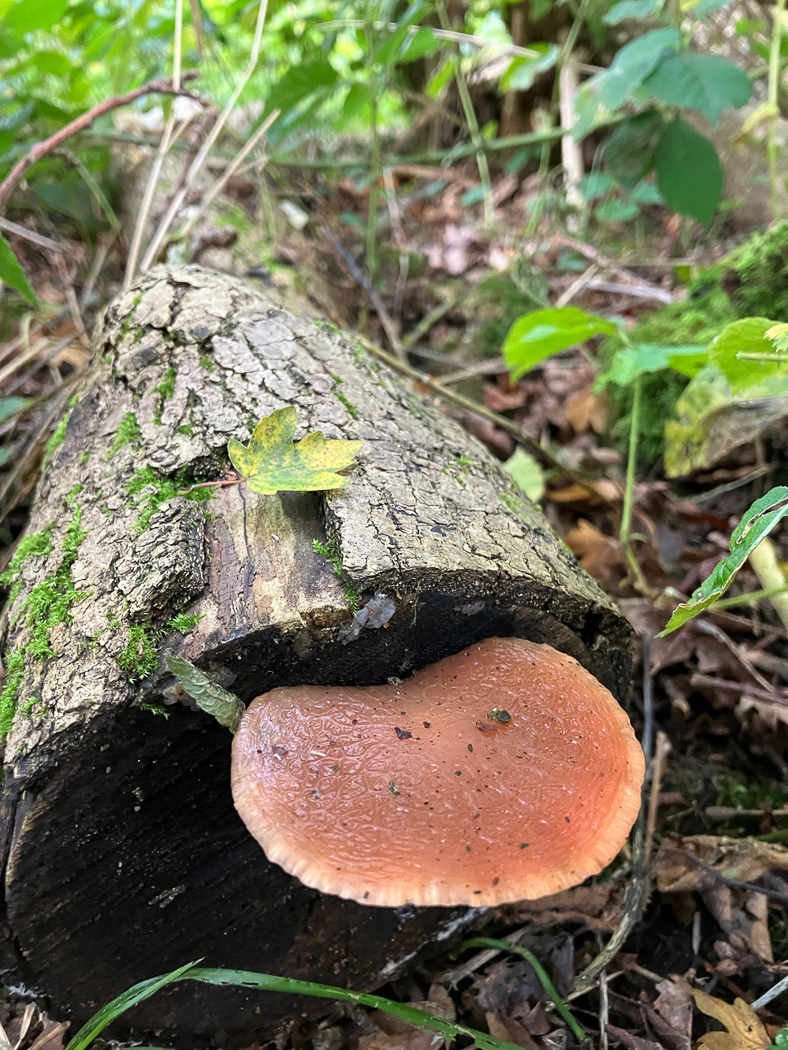


 |
October 5th Rhodotus palmatus (Wrinkled Peach) At Linford Wood Justin Long spotted this attractive and unusual species in two separate spots, the mature specimen being on the end of an Ash log rather than on Elm with which it traditionally associates. Since the demise of Elms in the UK this species became something of a rarity but now seems to be making a comeback with increasing reports of its occurrence on other fallen deciduous woods. In fact a week after this find of Justin's on Ash Peter Townsend reported finding it on Beech at Ragpits Reserve (photo 4). In damp conditions and when fresh and just developing it tends to have these coloured droplets, and the wrinkled surface is showing beautifully in photo 3. Previous finds |
October 4th 2024
 |
October 4th Clathrus archeri (Devil's Fingers) At Stampwell Farm Jackie has recently noticed countless numbers of the gelatinous 'eggs' of this extraordinary species, related to stinkhorns, and at last found one actually emerged! No longer a rarity in the county, it is another fungus apparently on the increase though with a limited number of sites where it does seem to recur once established. Certainly Stampwell Farm is a hotspot! Previous finds |
October 3rd 2024
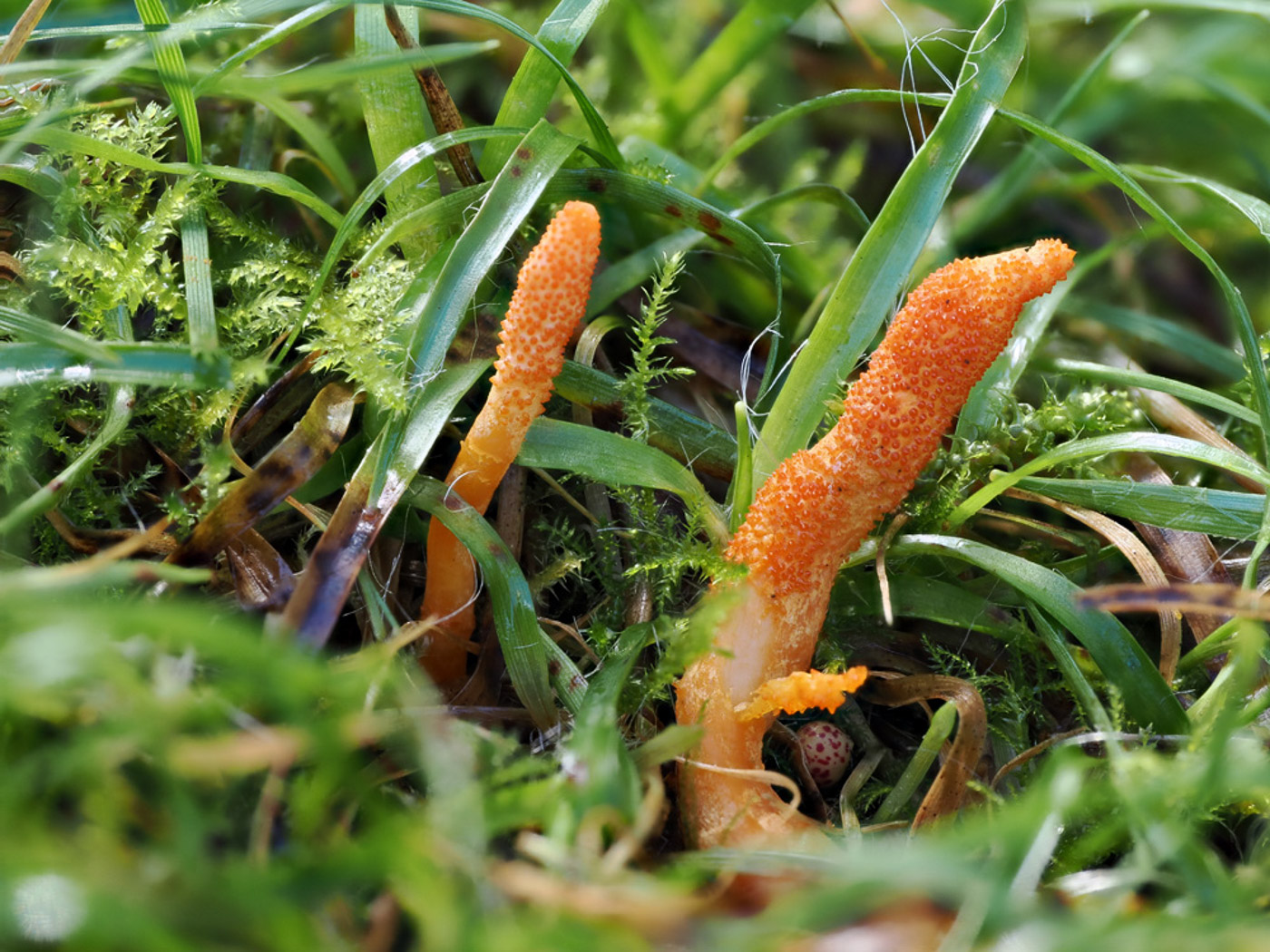 |
October 3rd Cordyceps militaris (Scarlet Caterpillarclub) At Burnham Beeches the sharp-eyed Gill Ferguson spotted a couple of these in the grass, this particular specimen being a double spike with even a third beginning to make an appearance. Underneath there will no doubt have been an unfortunate caterpillar larvae. The species is not rare but despite its bright colour is not easy to spot, often in grassy hedgerows. The photo was taken by Claire Williams. Previous finds |
October 2nd 2024
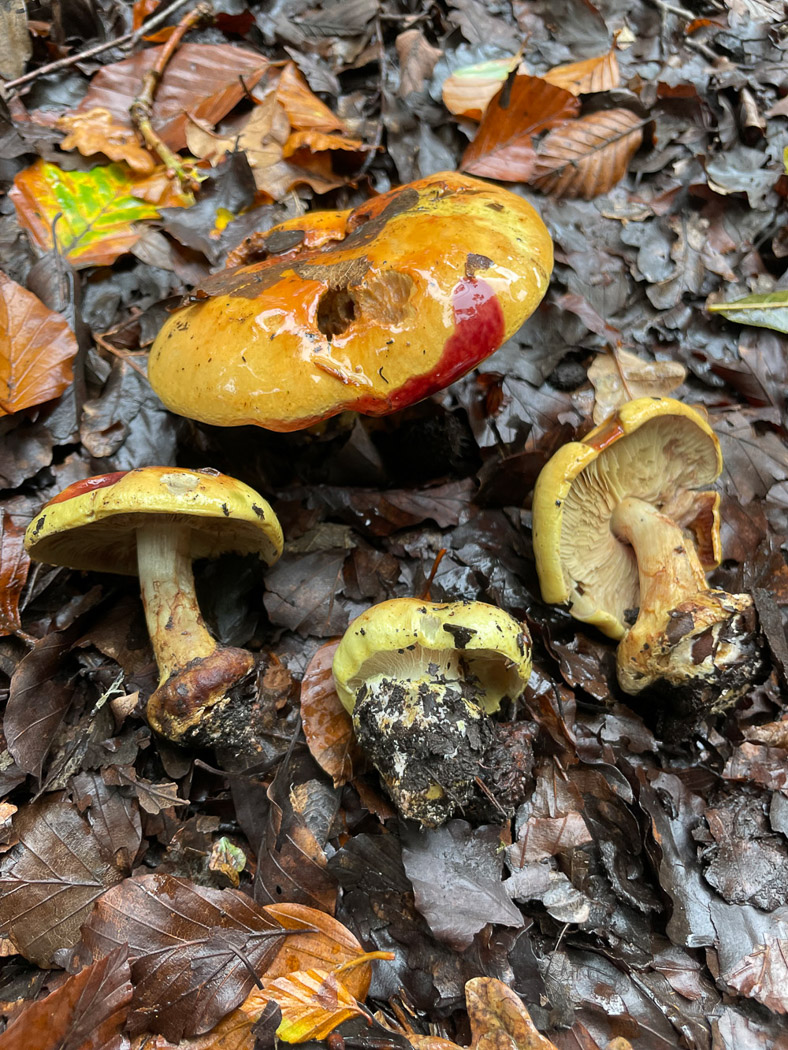
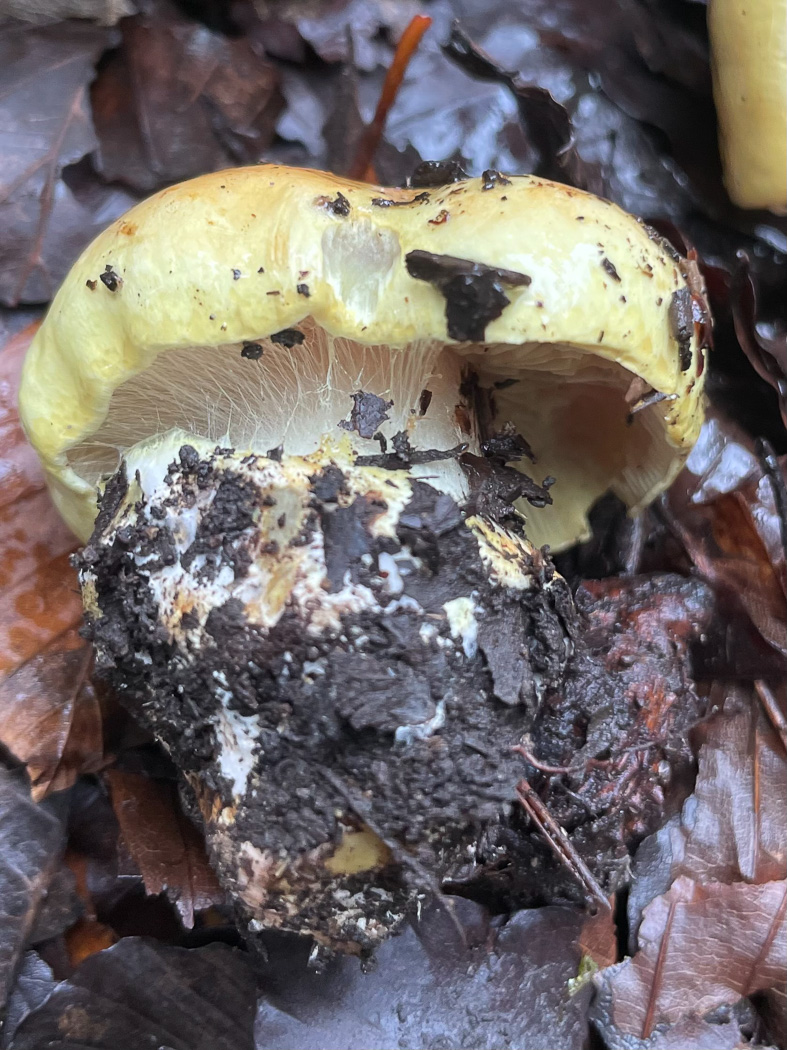 |
October 2nd Cortinarius bergeronii (Chalky Webcap) Near Marlow Common under a mature Beech where this particular species has been found and sequenced several times, Penny made a deliberate stop to see if by any chance it was showing. There it was, a stunning member of Section Phlegmacium having a slimy cap but dry stem and only found in calcareous soil under Beech and occasionally Oak. She moved on rapidly but suggested that Sarah Ebdon and Stephen Plummer might like to return and take a look as well, which they did! Adding a drop of KOH to the cap turns instantly blood red as can be seen in photo 1, though this is not a unique reaction and until quite recently it was assumed it proved the species to be C. elegantissimus (Dapper Webcap). However, DNA has shown there are two extremely similar species though C. bergeronii has smaller spores and now appears to be more common. Many older records of C. elegantissimus are therefore much more likely to be this species. The photos are Sarah's. Previous finds |
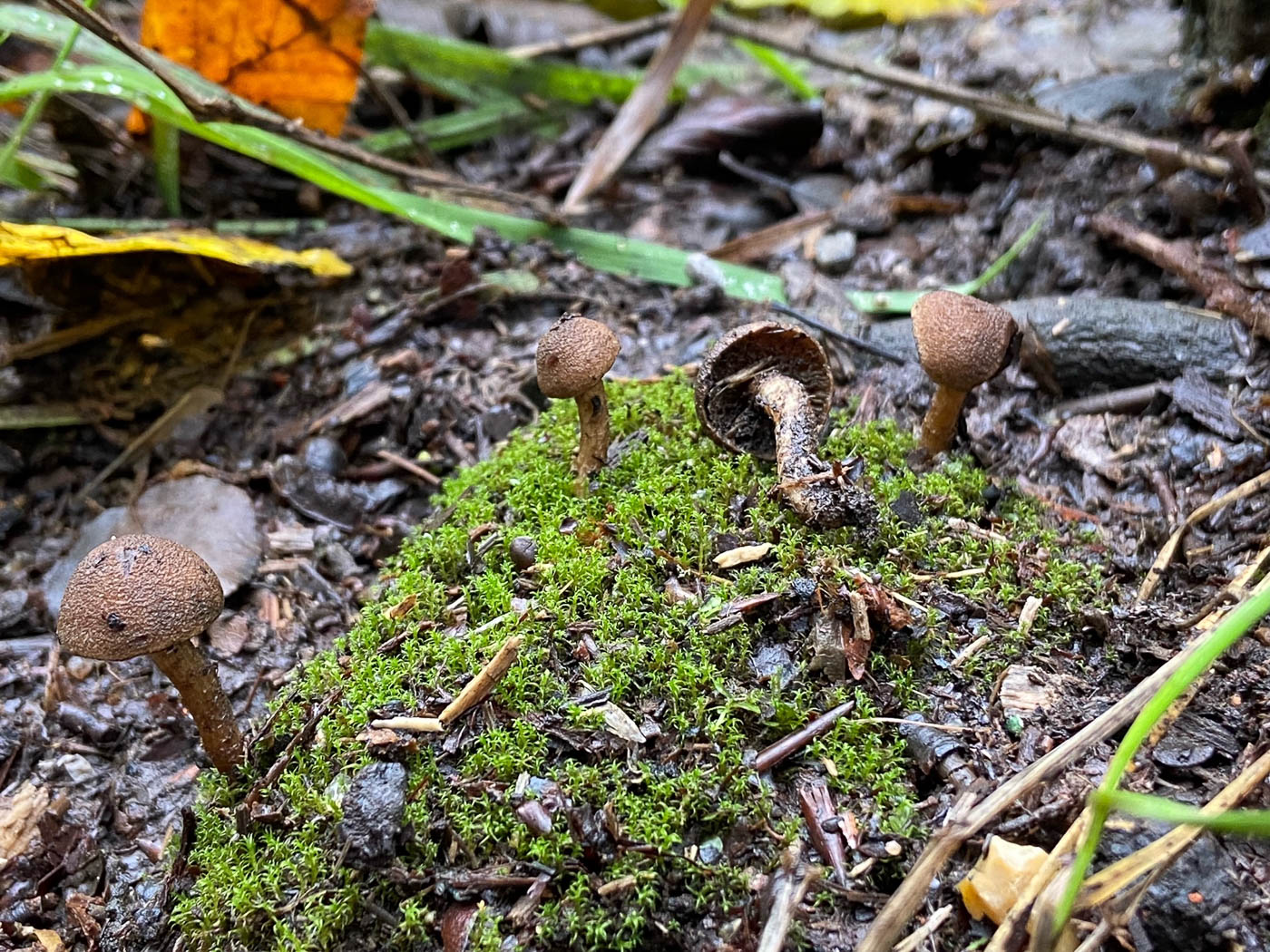 |
October 2nd Mallocybe cf. malenconii (a Fibrecap with no English name) Near Marlow Common under a mature Beech which regularly produces interesting species, Sarah Ebdon and Stephen Plummer noticed this small but unusual-looking Fibrecap and bravely made an attempt at identifying it - no easy task! On sending the photo to Penny she recalled collecting a Mallocybe species from this exact spot in 2021 which was sequenced - the first confirmed sequenced UK record of M. malenconii. She has little doubt that today's collection will prove to be the same but it will be dried and sequenced to make sure. This is a new entry for Finds. The photo is Stephen's. |
September 30th 2024
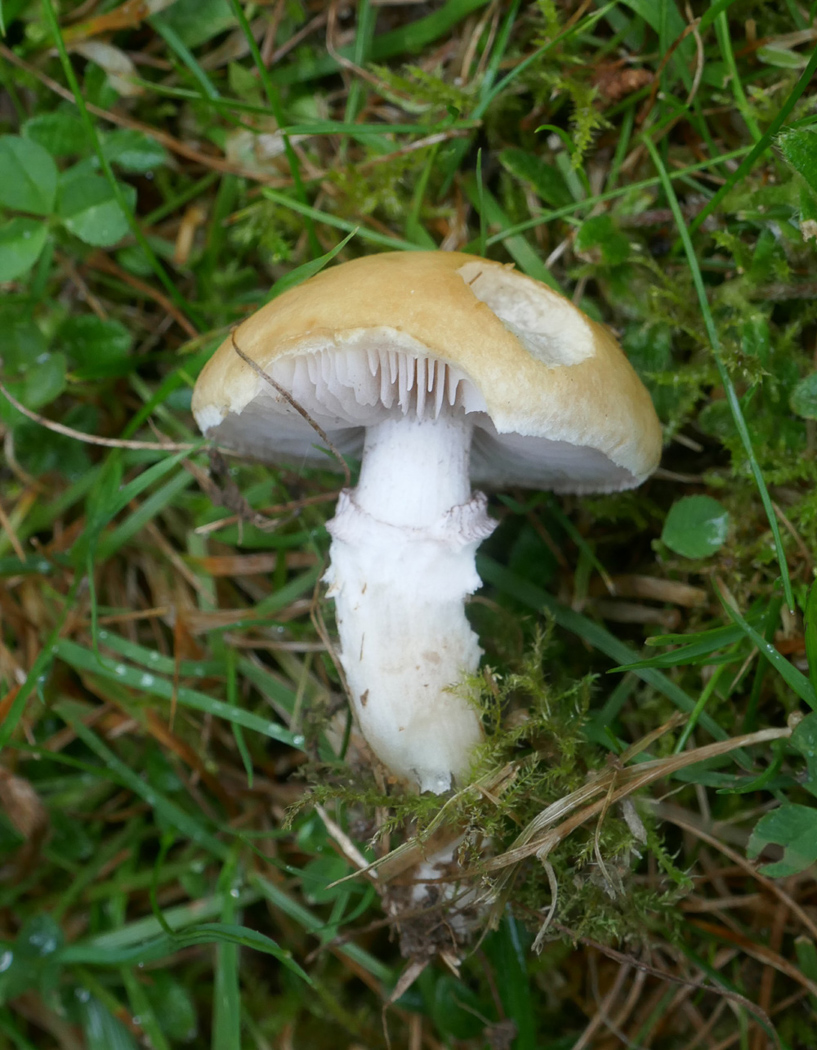
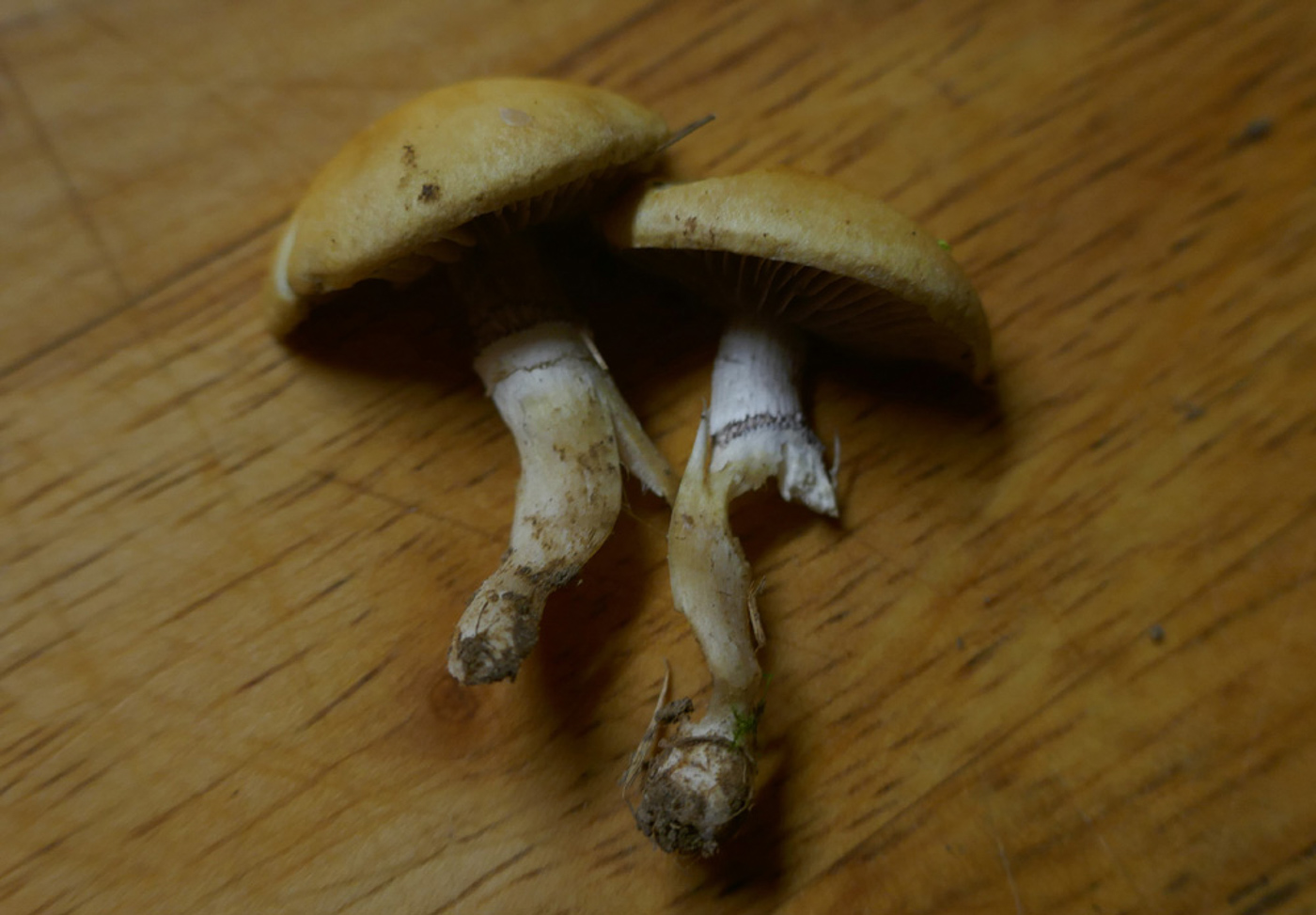 |
September 30th Stropharia coronilla (Garland Roudhead) In a grassy part of Stampwell Farm Jackie Ewan recognised this quite unusual grassland species though she'd not seen it here very frequently. It was a species Derek used to record regularly from his paddock in Oving but we have no records of it since 2011. The yellow cap and distinct grooved ring on the stem which gradually becomes coloured with the dark spores (hence the name garland) are the distinguishing field characters to look for, then confirmation from the microscopic characters is needed if in doubt. This is a new species for Finds. |
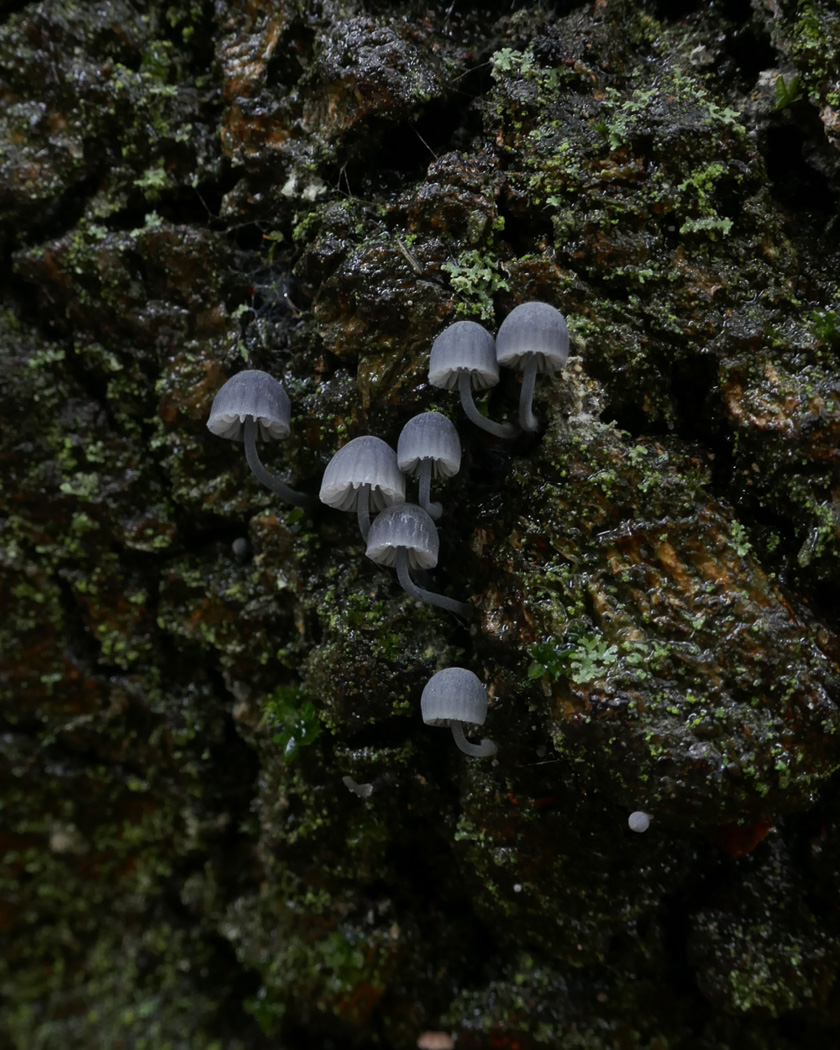 |
September 30th Mycena pseudocorticola (Steely Bonnet) On a mossy Oak trunk at Stampwell Farm Jackie Ewan reports finding this beautiful cluster. This is now the third recent finding of a species considered rare in this area several years ago so presumably is either becoming much more prevalent or this maybe a reflecting of more people noticing it. Previous finds |
September 28th 2024
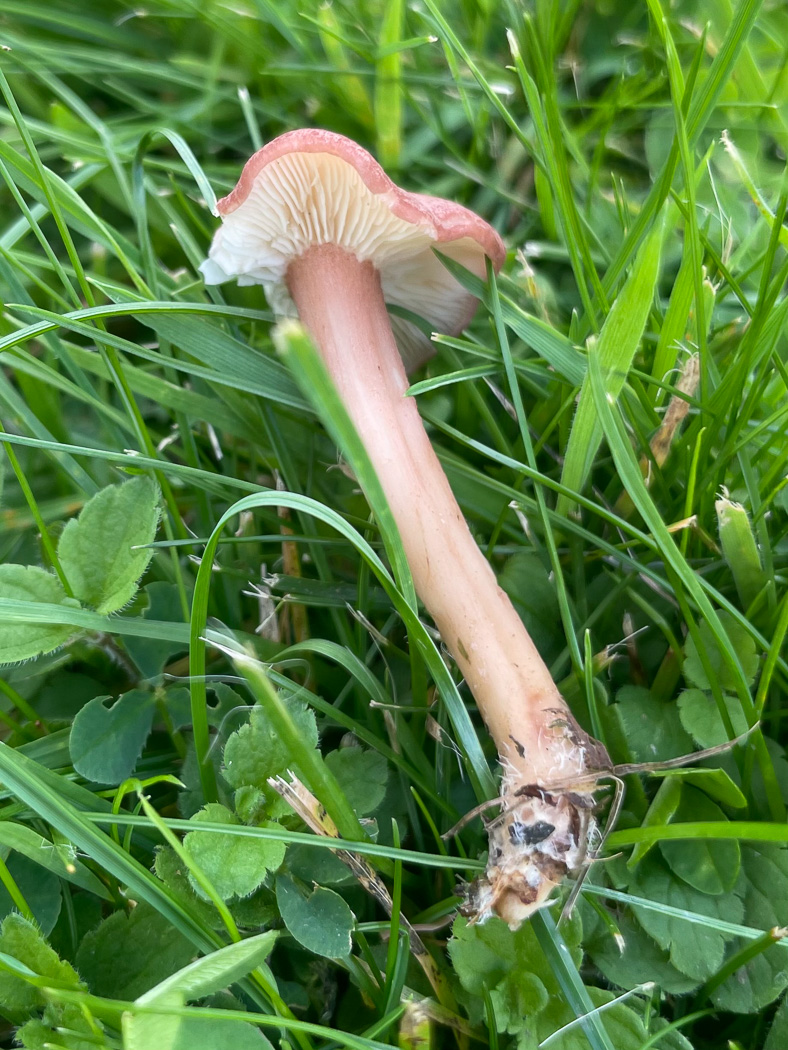
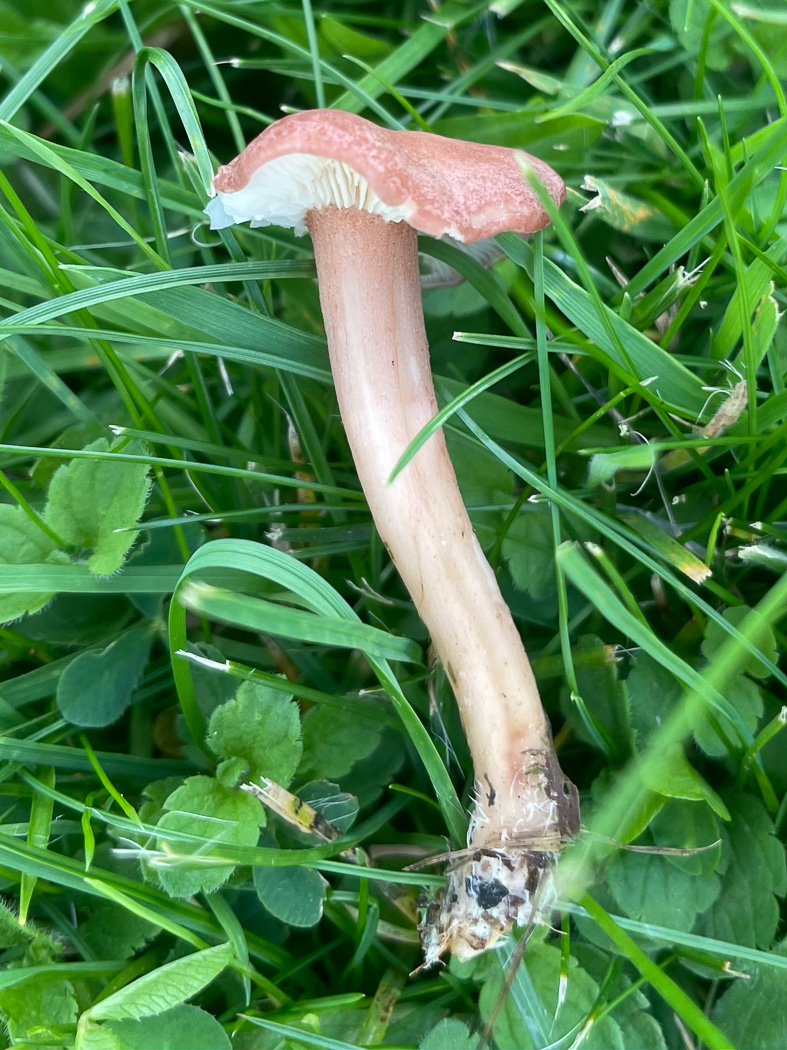 |
September 28th Rugosomyces persicolor (rare Domecap with no common name) In Bradenham Churchyard Sarah Ebdon spotted this little pink beauty in the shortish grass, and checking it at home came to the conclusion that it must be this particular species on account of its decidedly strigose (hairy) stem base which according to Kibby vol 2 separates it from the common grassland species Calocybe carnea (Pink Domecap, now also moved and named Rugosomyces carneus). What Sarah didn't realise (as there's no mention in the text) is that this is a rare species with extremely few UK records as yet! So the material will be sequenced to confirm or otherwise as if proven it is clearly new to the county. |
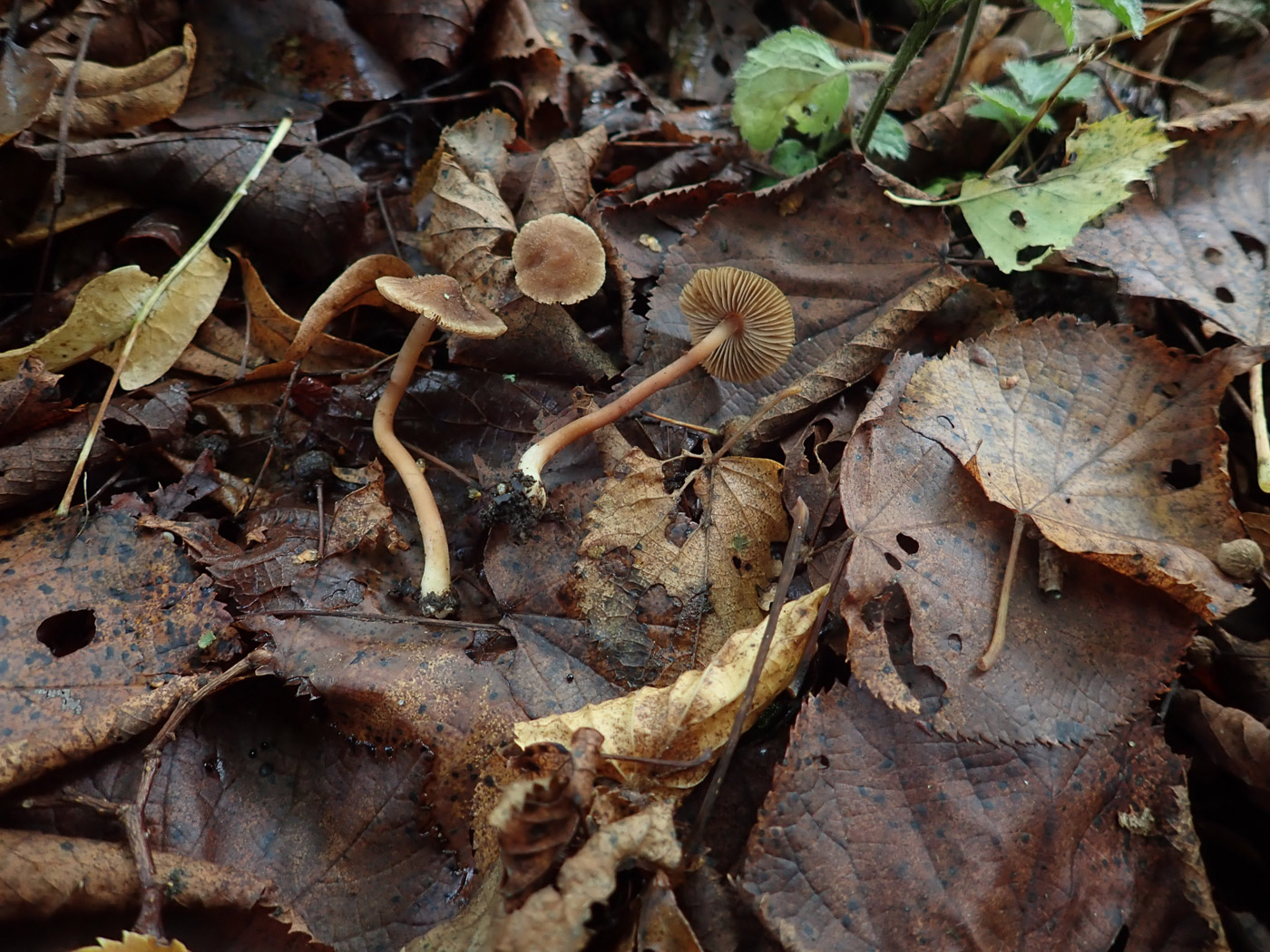 |
September 28th Inocybe calospora (Maritime Mine Fibrecap) At Turville Heath under the limes Penny found three reddish brown LBJs and guessed they were Fibrecaps but it was not until she checked one with a scope at home that she twigged what the species was. Just a quick glance is all that is needed because the spores of this species are unique and round like tiny maritime mines covered in spikes - always a thrill to discover! It is not at all common in this area and was new to the county when it turned up in Jesper Launder's garden in 2022! We also found it on our BFG visit to Rushmere Estate last year, so this is the third county record. Previous finds |
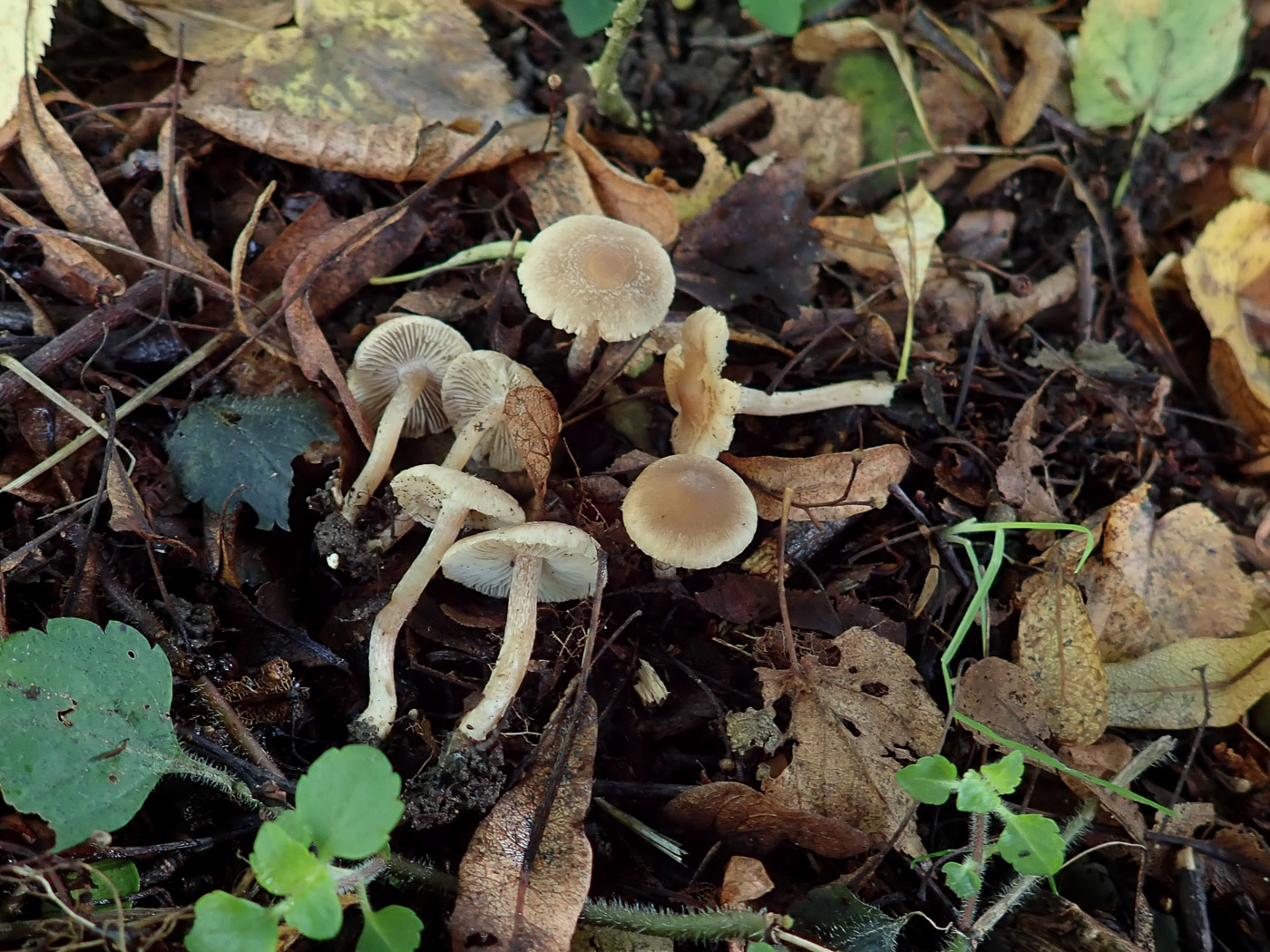 |
September 28th Inocybe cf obscurobadia (a Fibrecap with no common name) At Turville Heath Penny found this small LBJ amongst the many more brightly coloured Fibrecaps coming up under the Limes. When she came to examine it at home she noticed a distinctive smell of Pelargonium which instantly alerted her to the possibility of several Fibrecaps which have that smell as they start to dry a bit. The microscopic details soon led her to this species, not a rarity though new to this site and not one she's come across for several years. This is also a new species for Finds. |
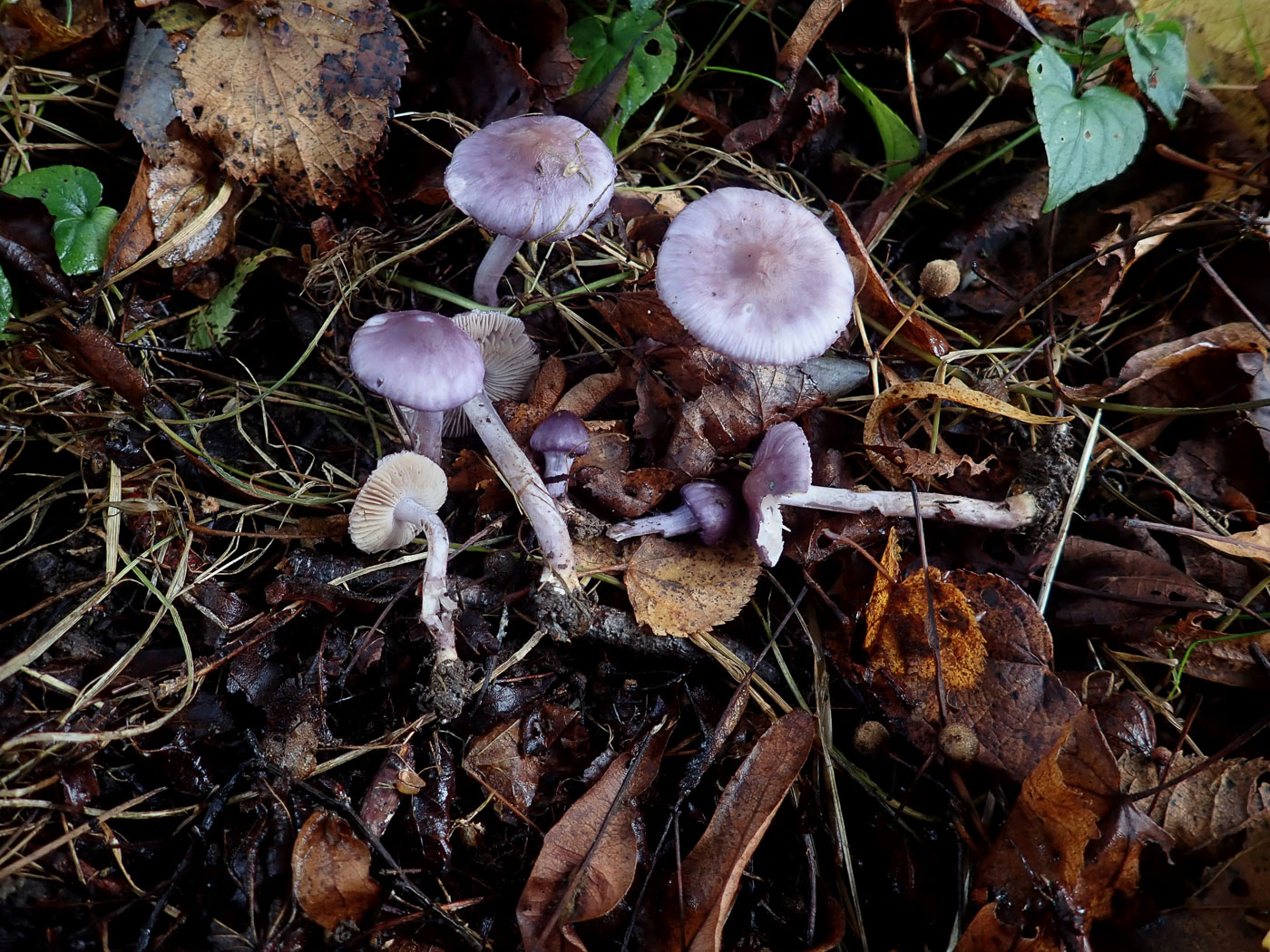 |
September 28th Inocybe tyrii (a Fibrecap with no common name) At Turville Heath Penny found the white and lilac Fibrecaps coming up under the Limes in their hundreds today. She is assuming that as several lilac collections from this spot have now been confirmed with sequencing as I. tyrii (which was new to the UK from here in 2022 almost to the day!) that this is also that species. The collection will also be sequenced in due course. Previous finds |
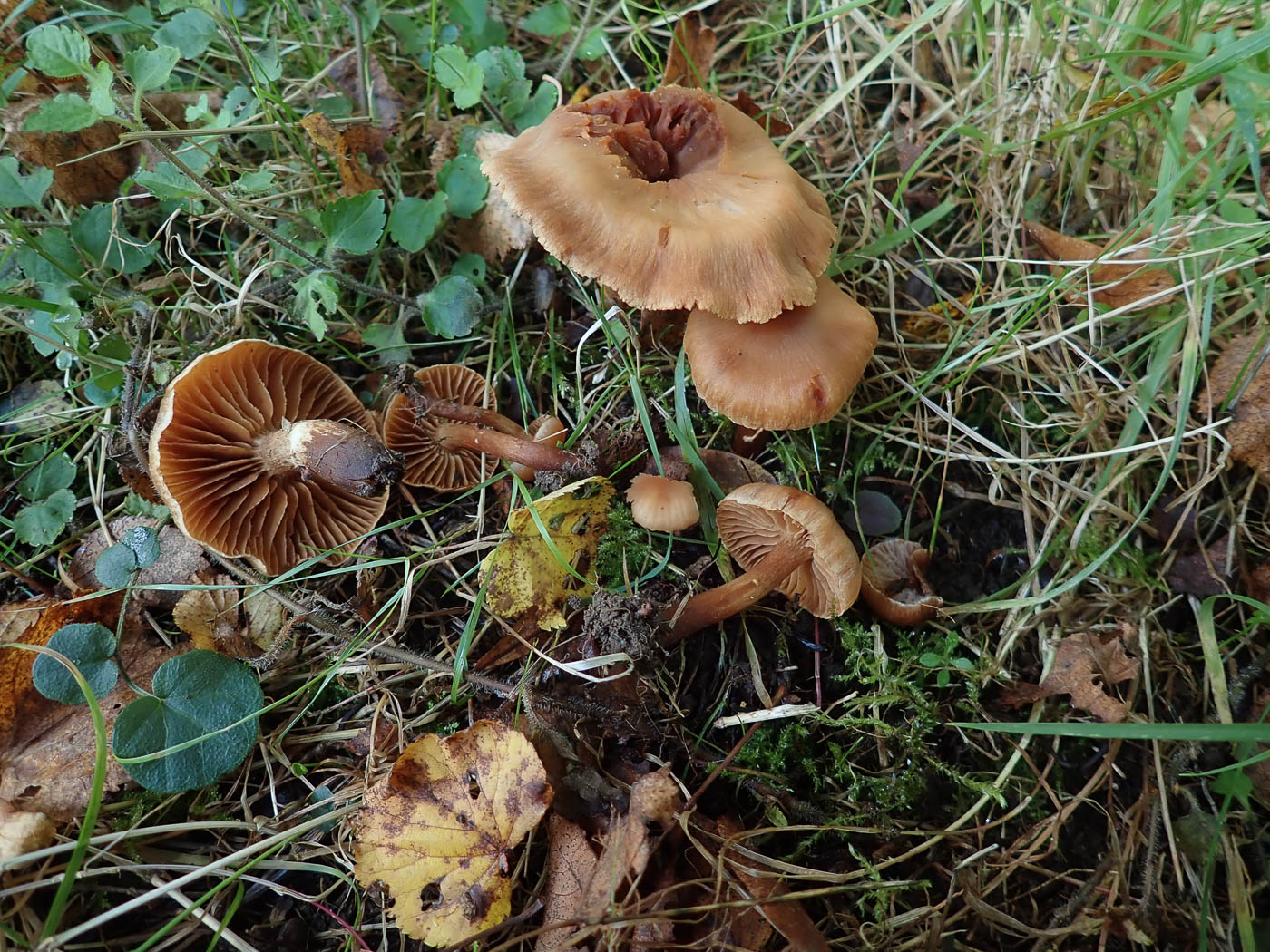 |
September 28th Cortinarius hinnuleus (Earthy Webcap) At Turville Heath Penny found a fresh collection of this quite unusual Webcap coming up in its regular spot under Lime where she's found it for the last few years. She was pleased to be able to get confirmation of her ID from Mario Tortelli the next day at Hodgemoor Wood as there are several species close to this one (all members of the notoriously tricky Section Telamonia) which also have these widely spaced gills and an earthy smell. Previous finds |
September 27th 2024
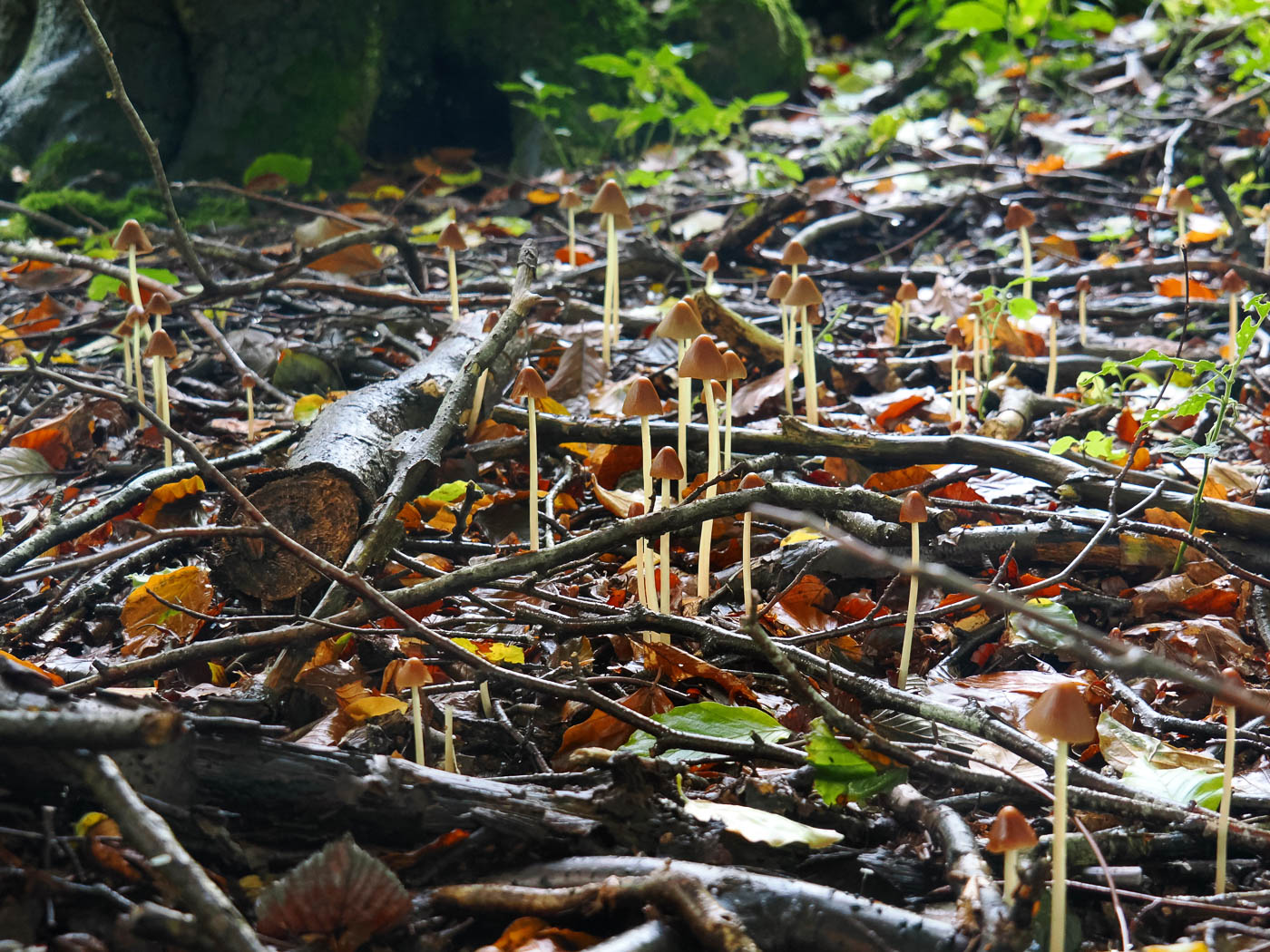 |
September 27th Parasola conopilea (Conical Brittlestem) At Bittam's Wood, part of the Dancersend Reserve, Mick Jones was impressed by the sheer numbers of this species coming up in the deciduous litter and obviously triggered by the recent rains. Though now in genus Parasola and as such a member of the Inkcaps, it was (until DNA sequencing proved otherwise) in genus Psathyrella - known as the Brittlestems, thus the reason for its common name which thankfully remains unchanged! Its white stem - which is indeed brittle - and brown conical cap give it a mycenoid appearance though on the tall side for that genus, but one glance at the gills which quickly develop a dark grey-brown colour tells one this belongs to a dark-spored genus and not one related to Mycena. Previous finds |
September 26th 2024
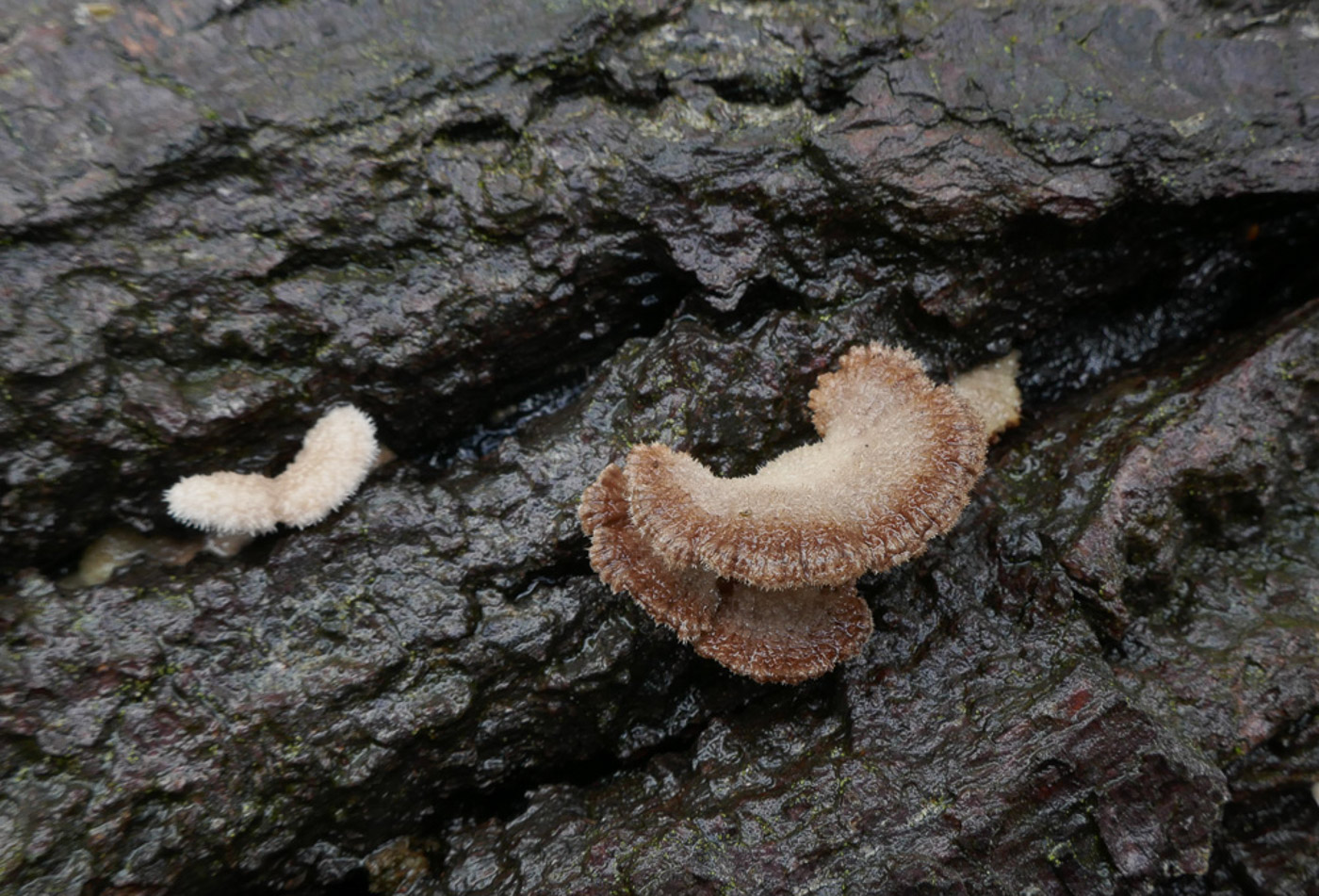
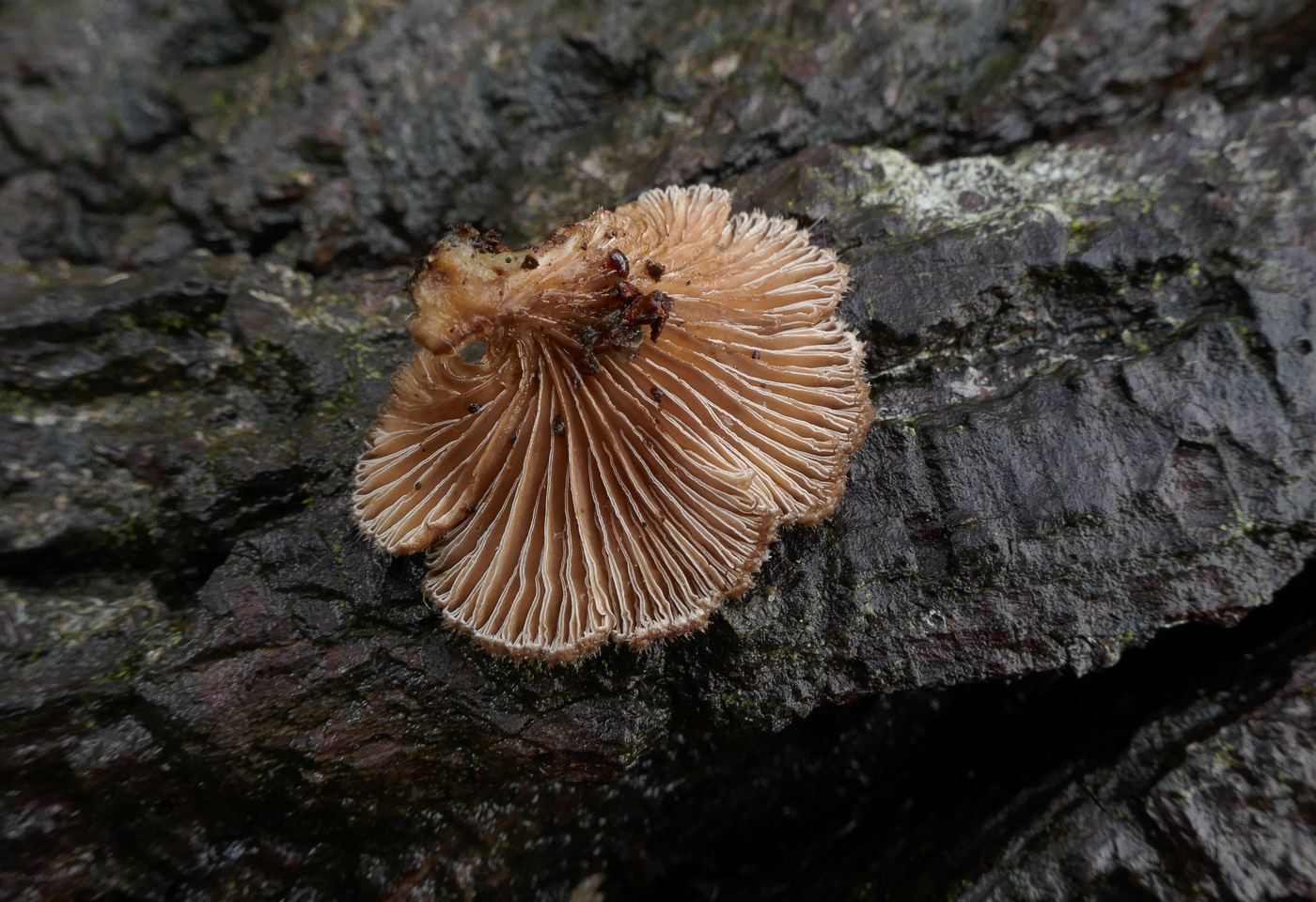
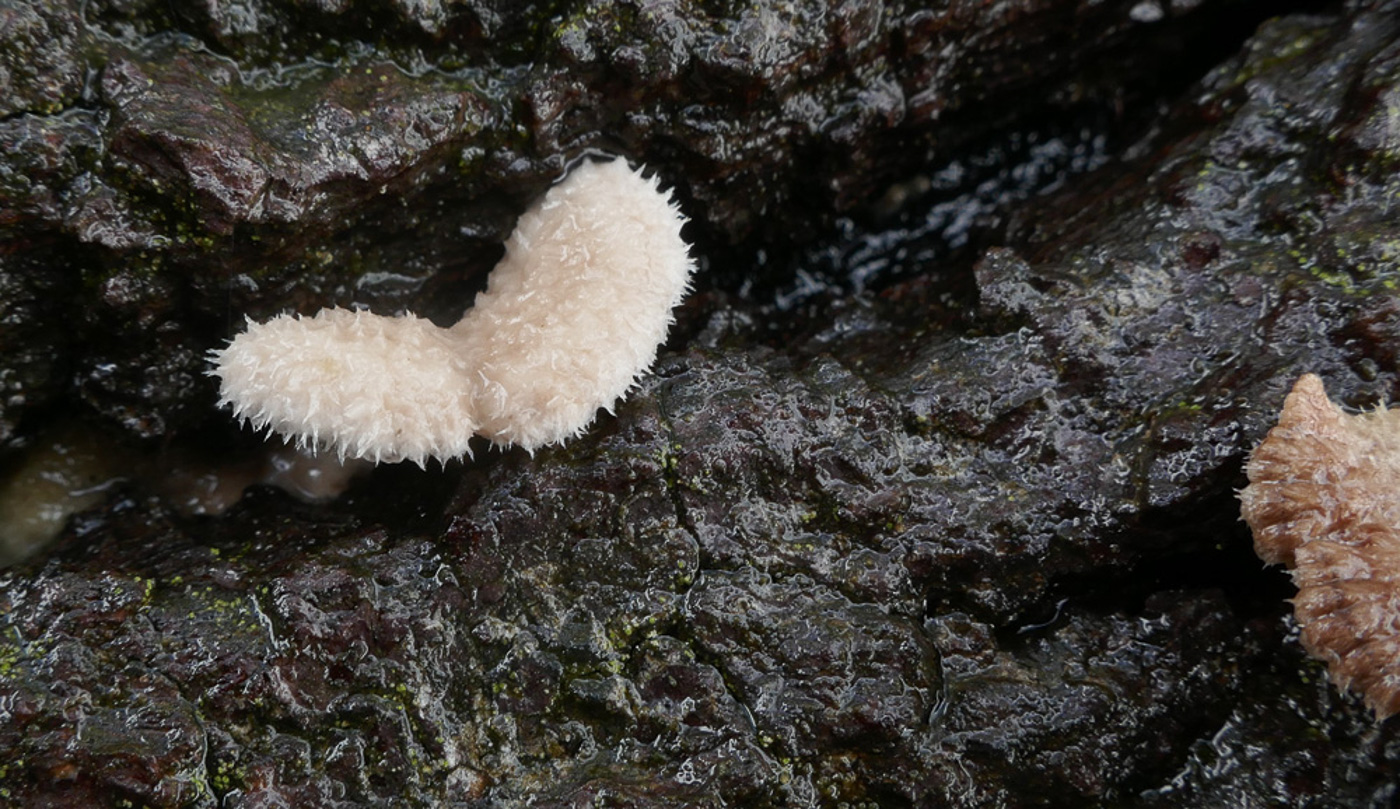
|
September 26th Schizophyllum commune (Split Gill) On a felled Oak trunk at Stampwell Farm Jackie Ewan noticed this species just beginning to make an appearance. The pale colour, hairy surface, halfmoon shape (rather like a hairy Crepidotus - Oysterling) and distinctive gill formation (see photo 2) make this an easy one to recognise. Photo 3 is of an immature specimen. Previous finds |
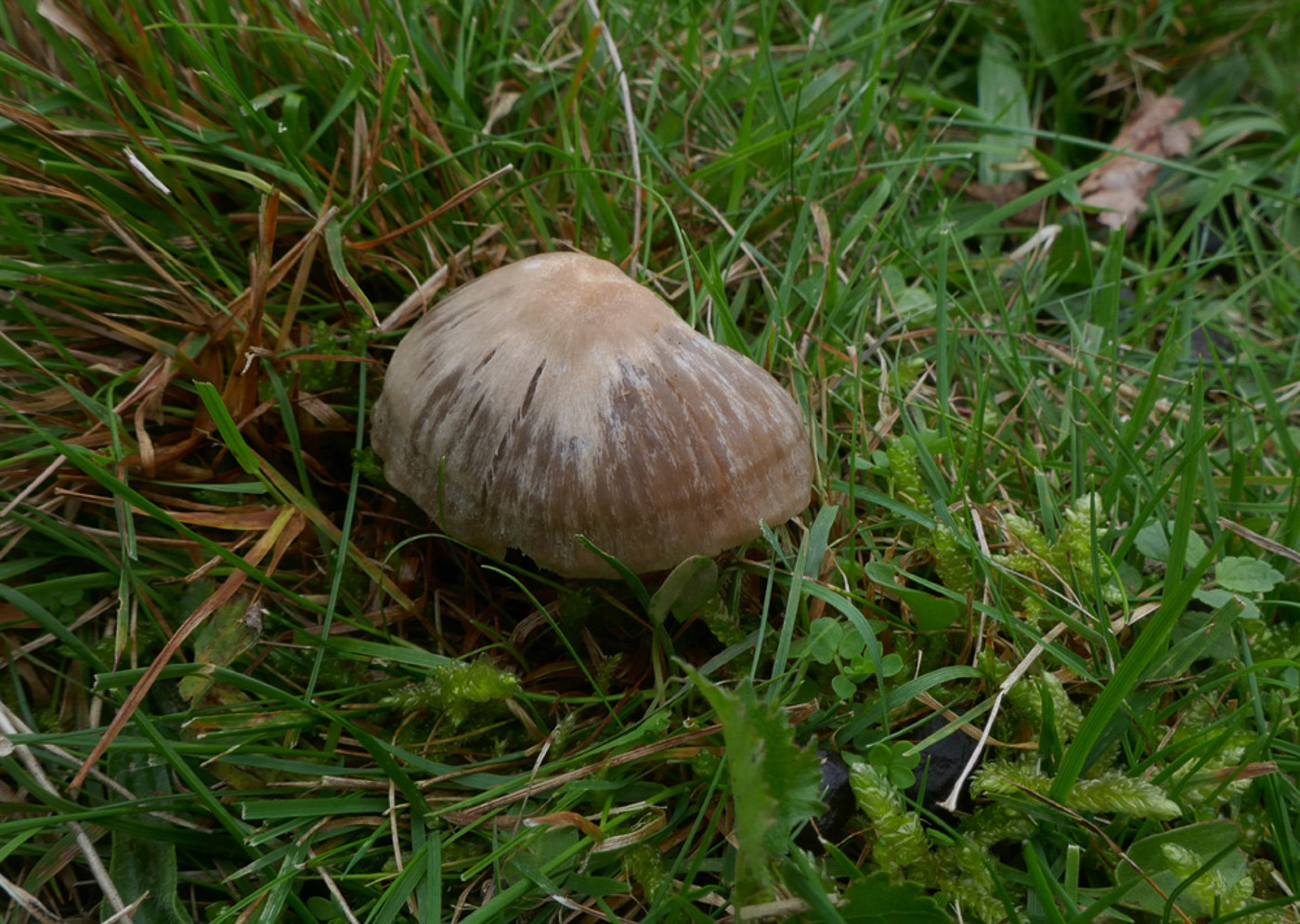
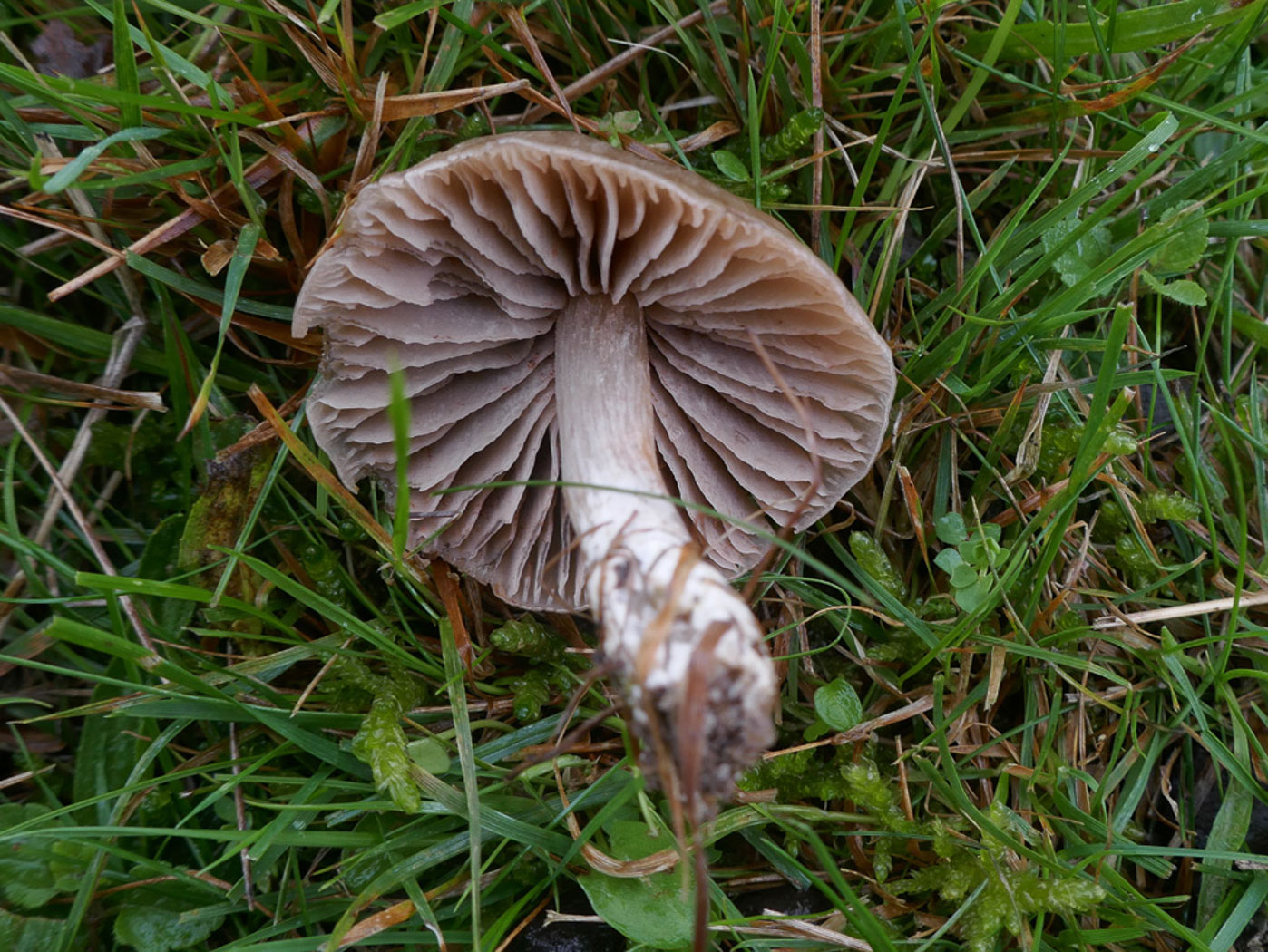 |
September 26th Entoloma ameides (Bubblegum Pinkgill) In a grassy patch at Stampwell Farm Jackie Ewan found this singleton Pinkgill and took it home to work on, noting the odd smell which was not mealy as quite a few of this genus are. The microscopic characters keyed out to this quite unusual species which we don't often record. Previous finds |
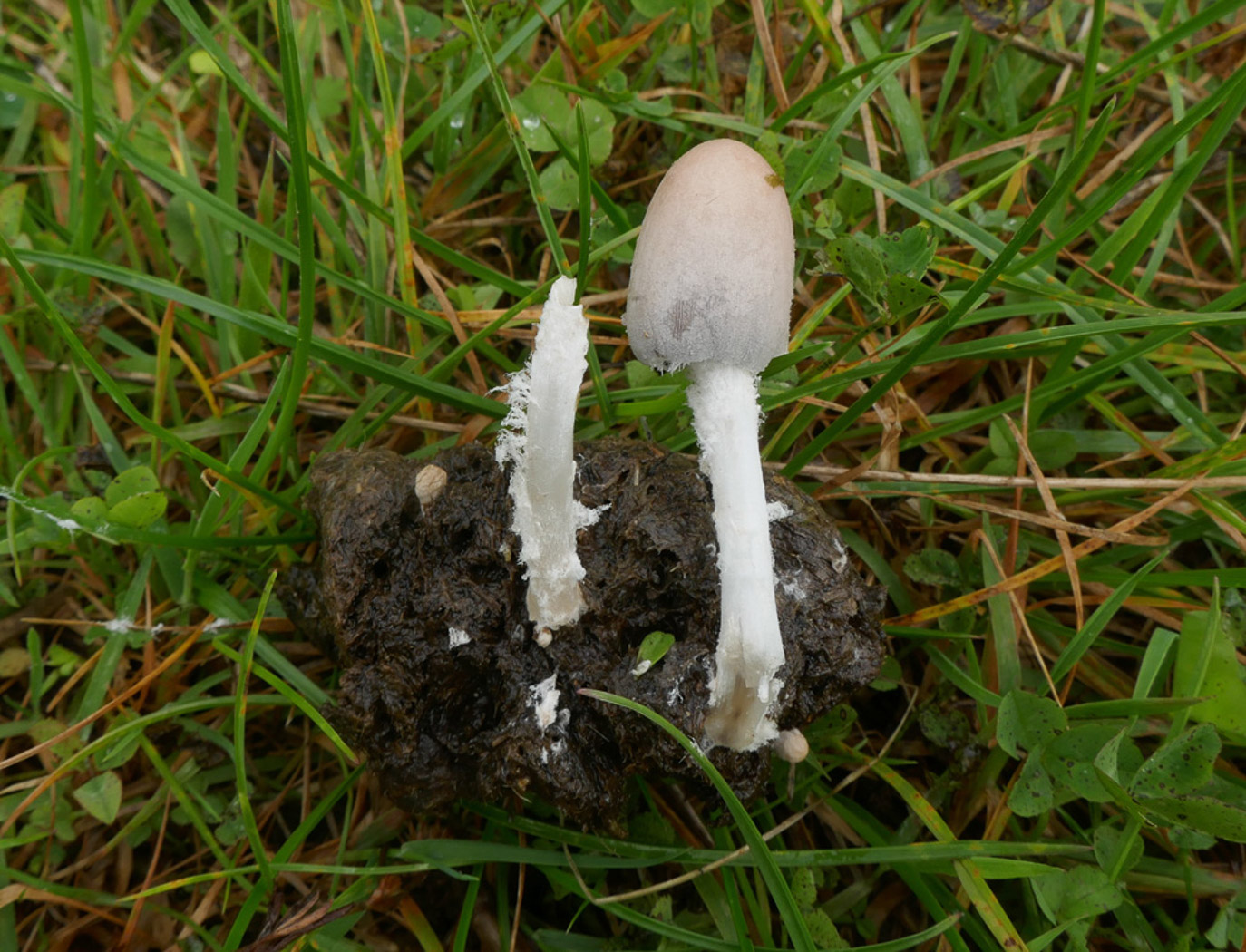
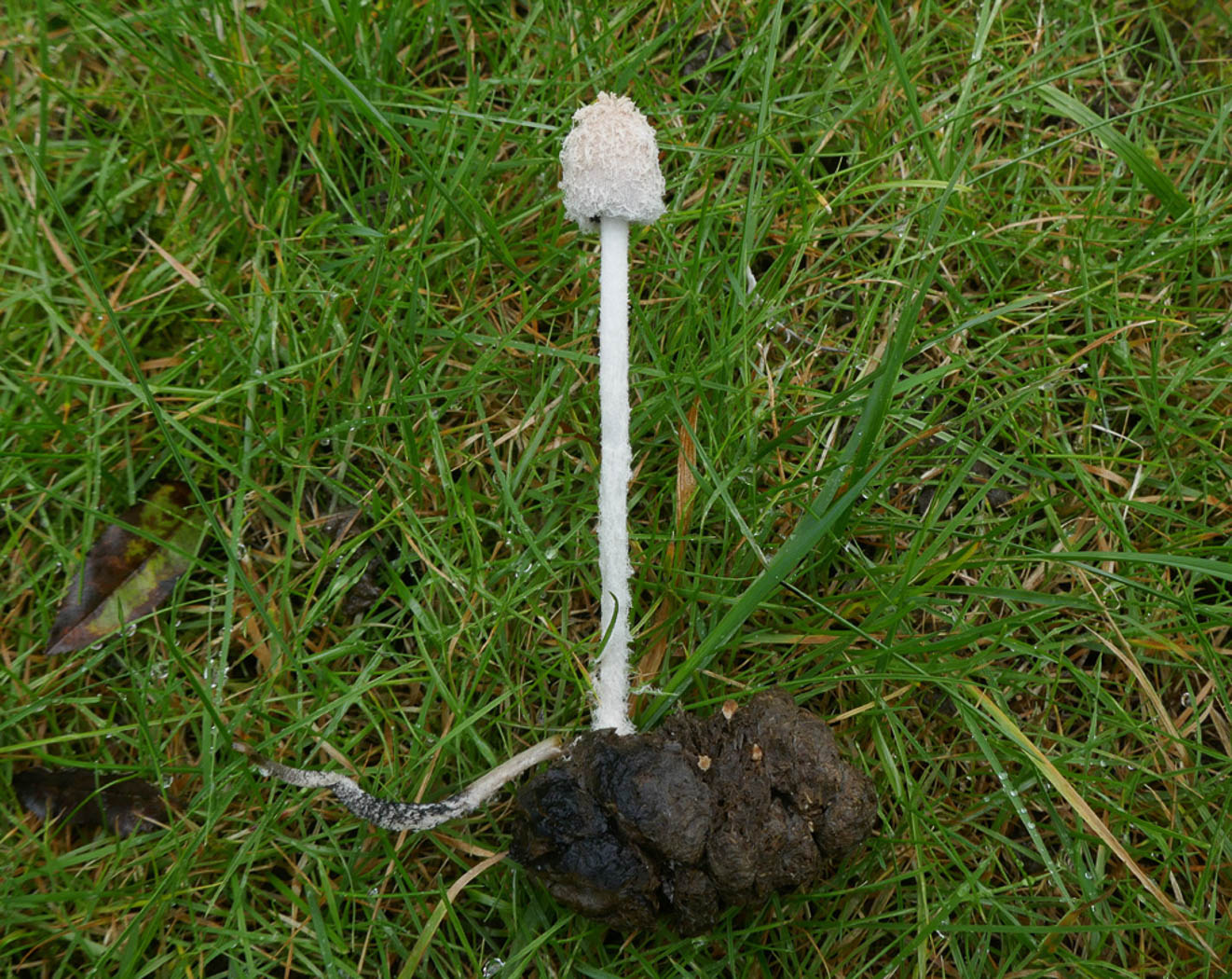
 |
September 26th Coprinopsis pseudonivea (Aromatic Inkcap) At Stampwell Farm Jackie Ewan found this Inkcap on a piece of dung, then retained and incubated the piece for a few days and sure enough a nice fresh fruitbody obliged (photo 3). The species is very close to the more common dung associating C. nivea (Snowy Inkcap) but has smaller spores and the characteristic thick coating of veil is not pure white but has a slightly cream pink tint as seen here. It was not known in the UK till 2006 but is now quite a common species. Previous finds |
September 25th 2024
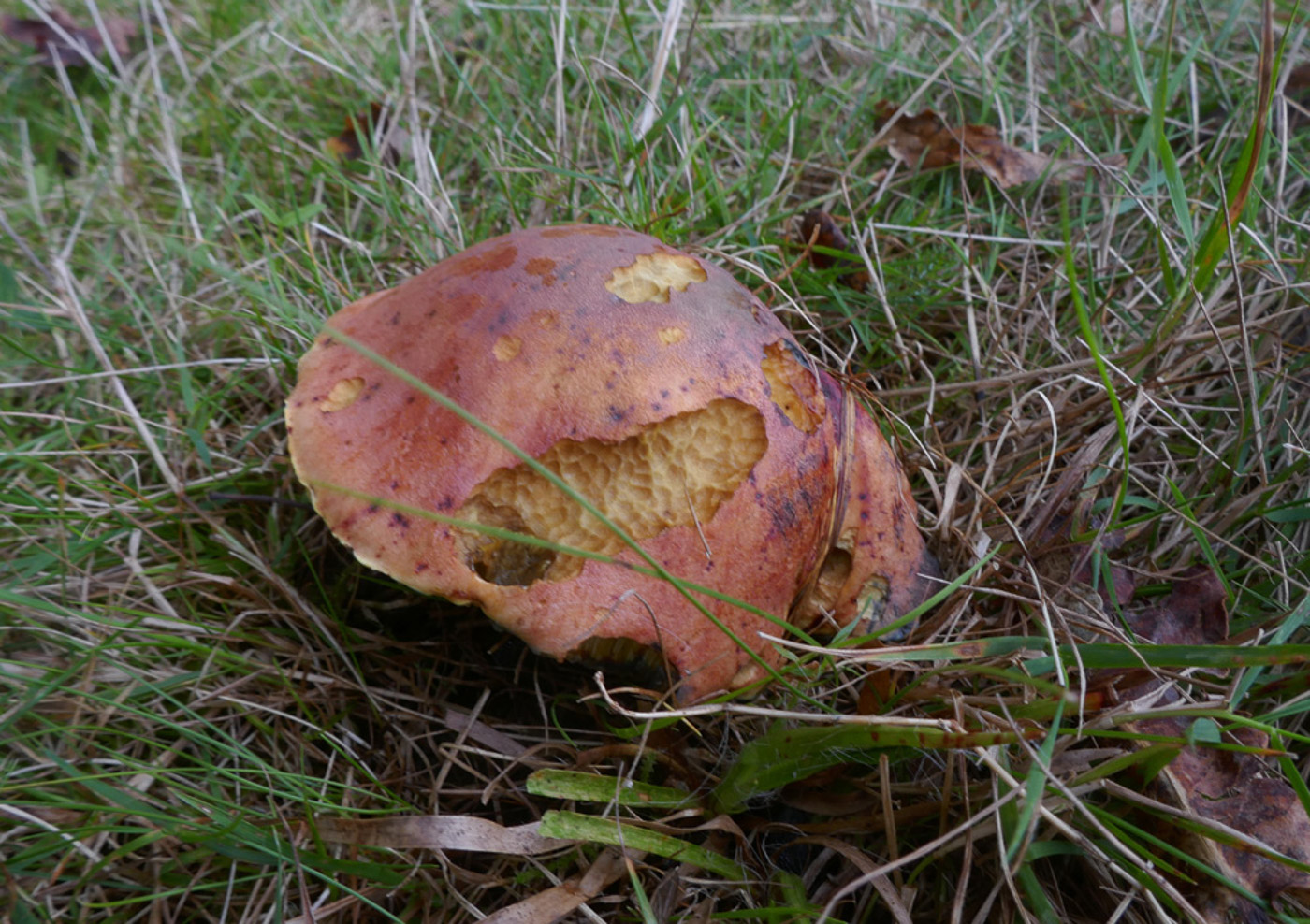
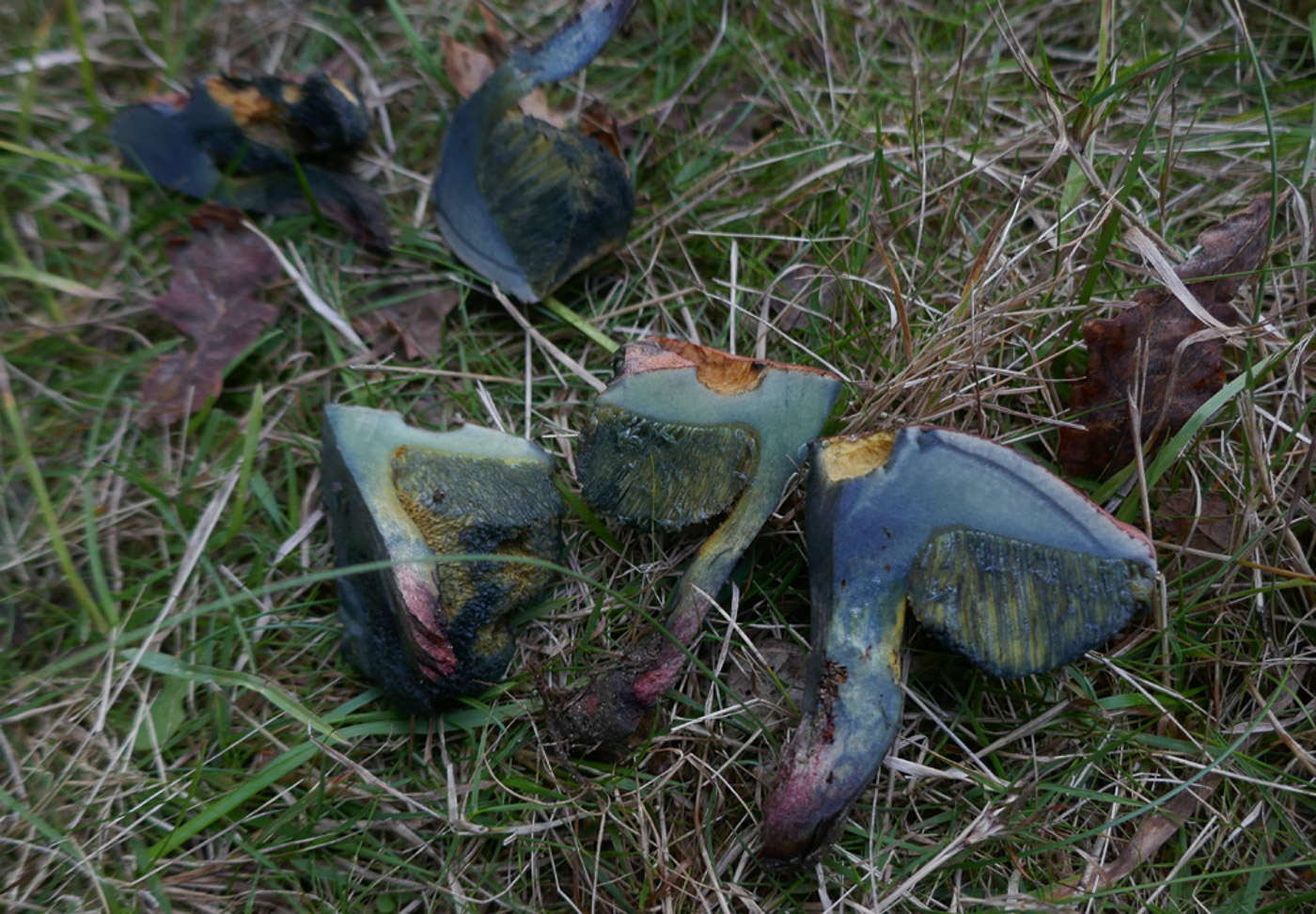 |
September 25th Suillellus queletii (Deceiving Bolete) At Stampwell Farm Jackie Ewan found this impressive species where she'd found it before. It was very common last year but all boletes have been in short supply locally this autumn so far. The strongly and quickly blueing flesh when exposed to air, together with the beetroot red stem base are good clues to its identity. Previous finds |
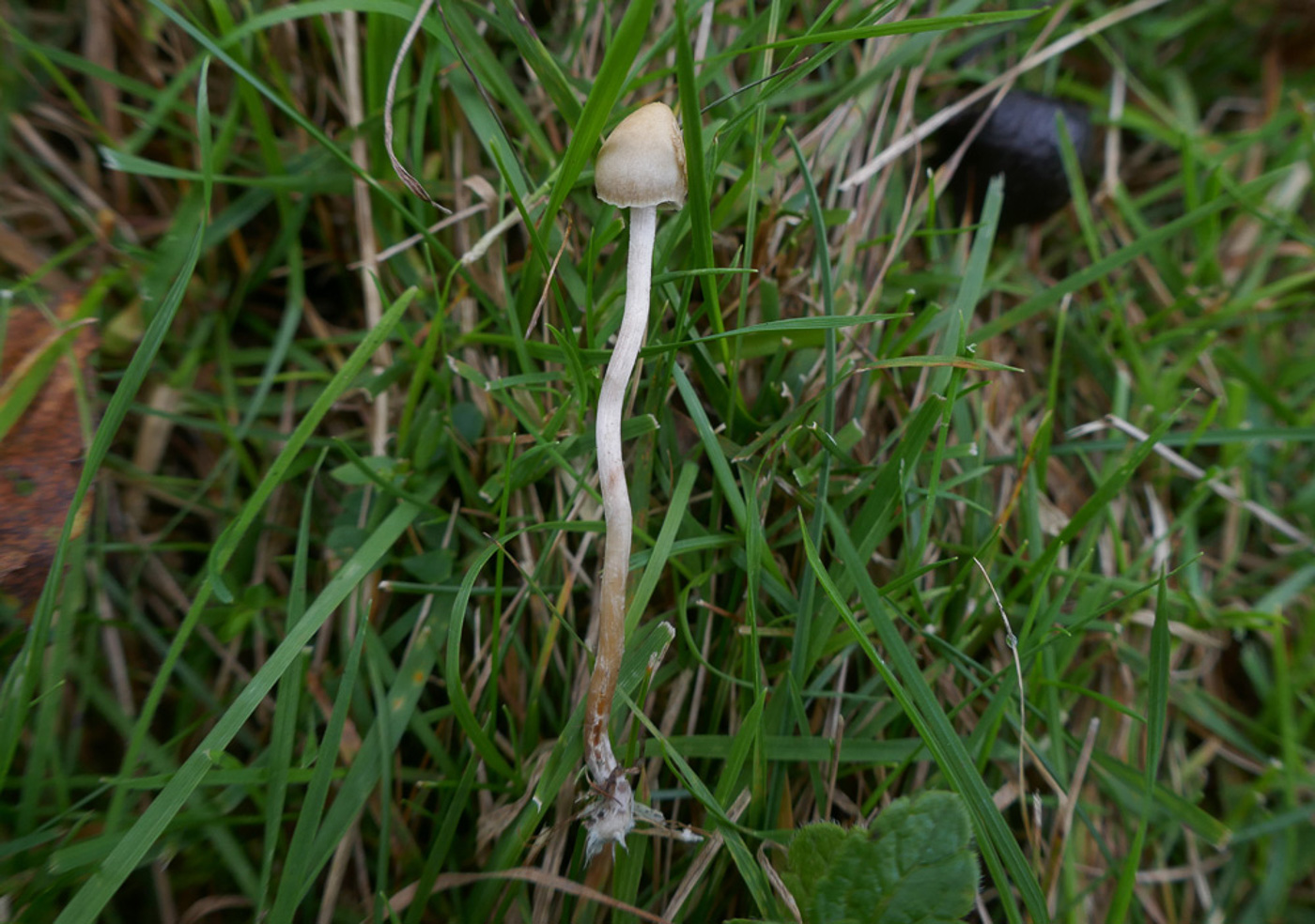 |
September 25th Psilocybe semilanceata (Magic Mushroom / Liberty Cap) At Stampwell Farm Jackie Ewan found just this one fruitbody in a grassy field and from its acutely conical cap, long stem and dark gills had no doubt as to its identity. Previous finds |
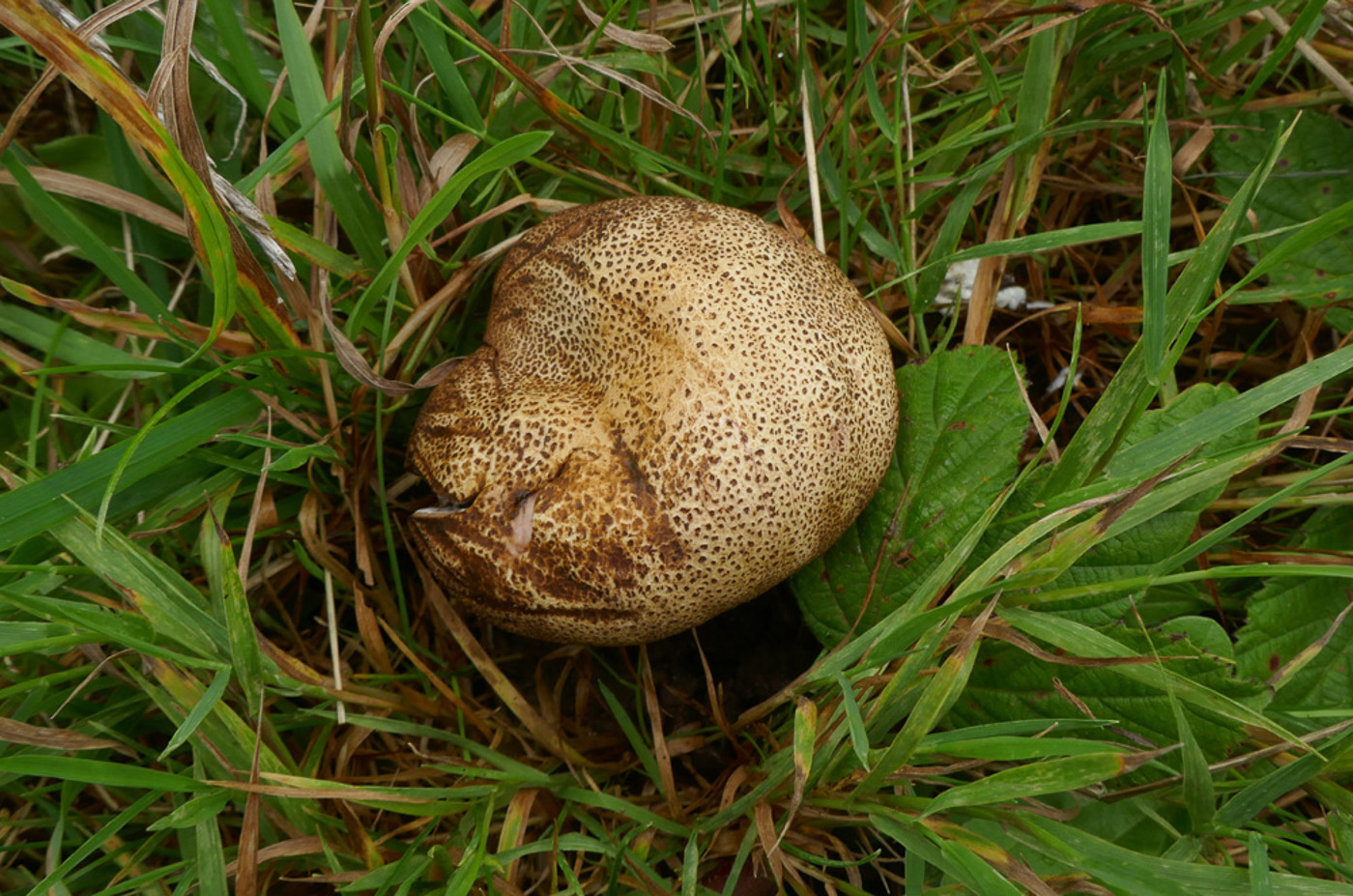
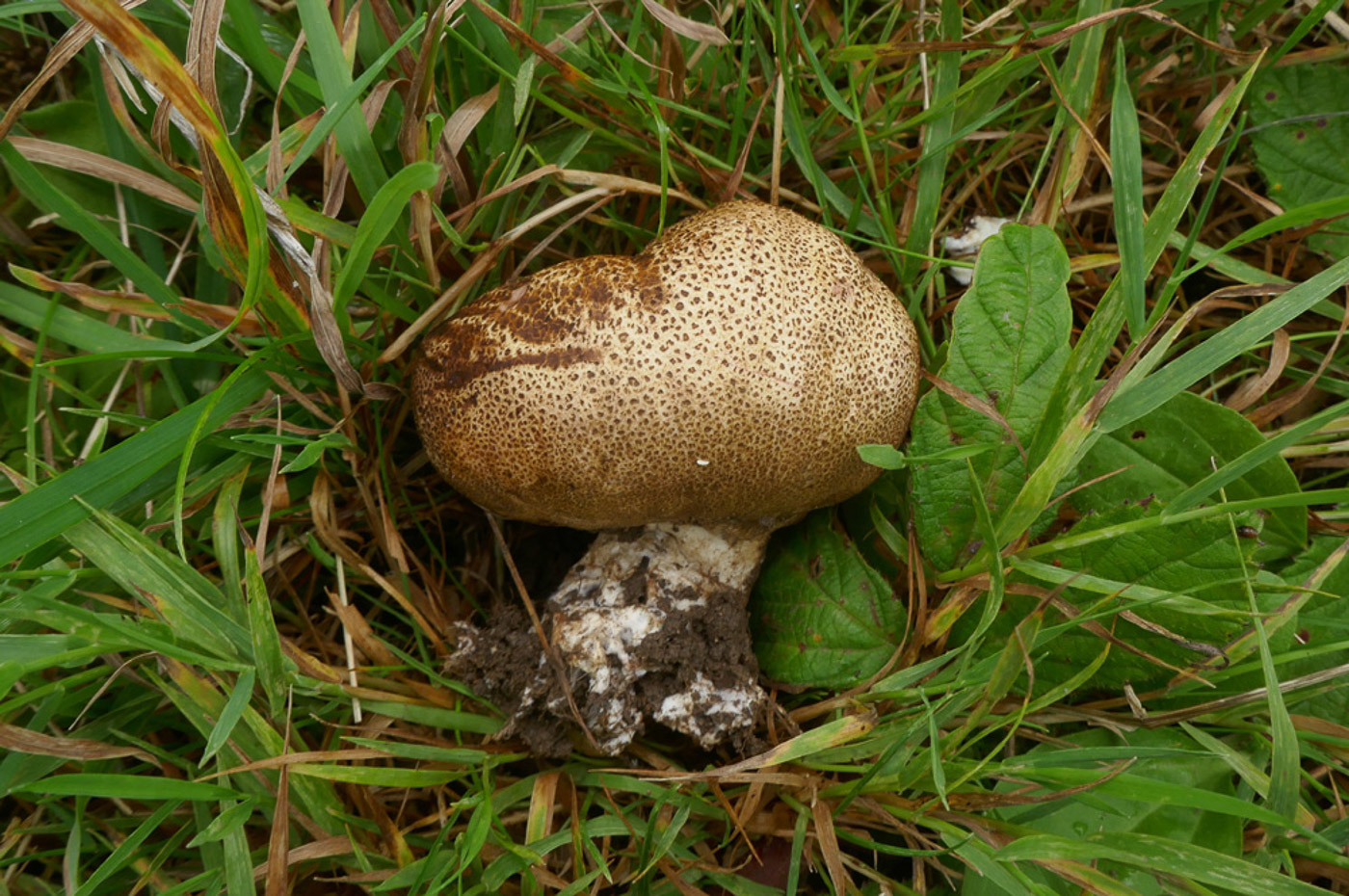 |
September 25th Scleroderma areolatum (Leopard Earthball) At Stampwell Farm under Oak Jackie Ewan noticed this species, recognising it from markings on the surface similar to that of a leopardskin. However, some collections are not so obviously marked and can easily be confused with the somewhat similar S. verrucosum (Scaly Earthball). In fact we regularly have debates in the field comparing the two species and many mycologists would argue that it's unsafe to decide purely from the markings without recourse to a scope to compare the spores. Previous finds |
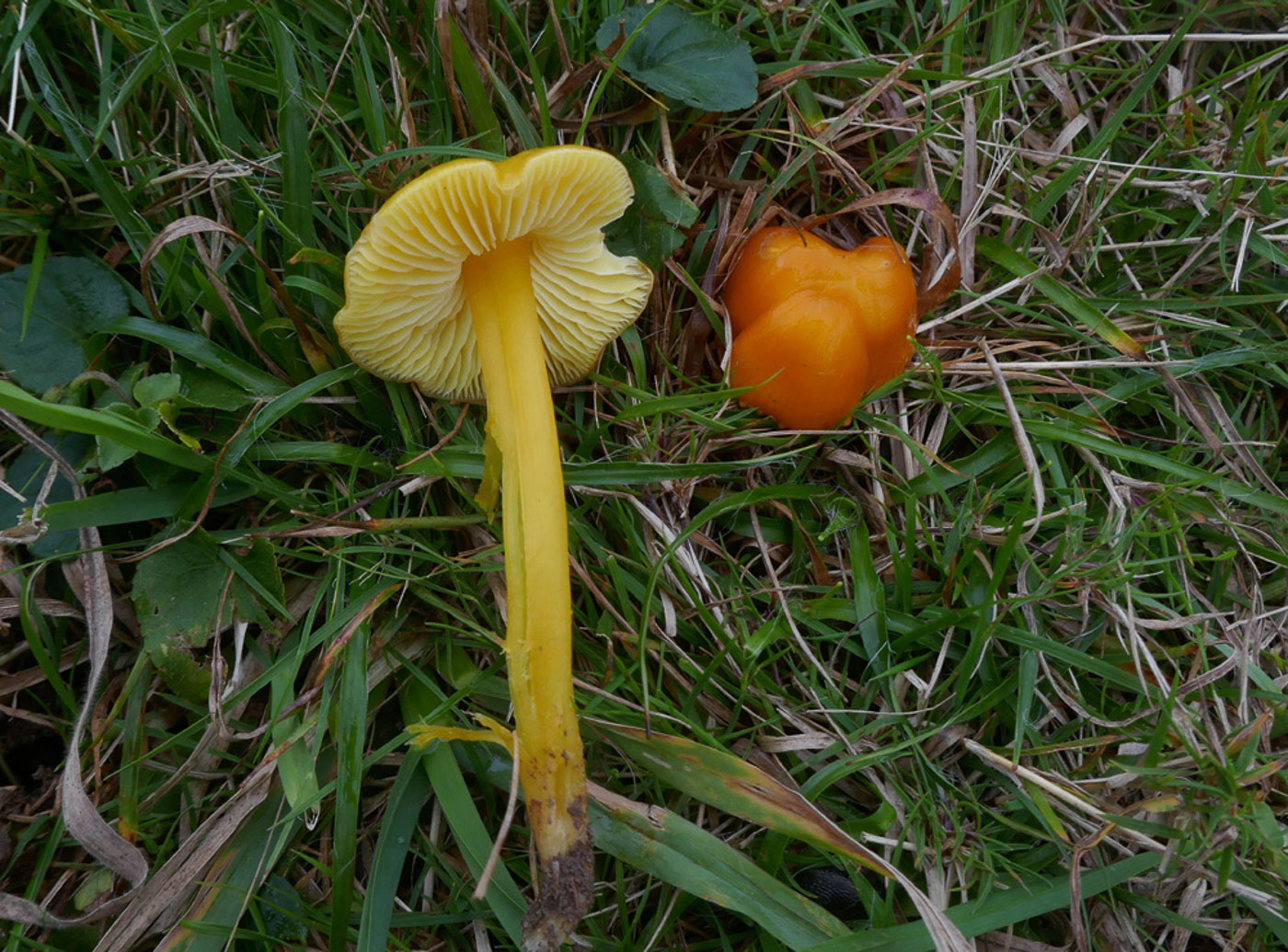 |
September 25th Hygrocybe chlorophana (Golden Waxcap) At Stampwell Farm Jackie Ewan found this bright mushroom in a grassy area - one she knows well from this site and often finds. When small it can be tricky to distinguish from other yellow waxcaps but when full size it is bigger than the other lookalikes. If in doubt a scope is needed to check the length of the gill trama - much longer in this species than many others. Previous finds |
September 24th 2024
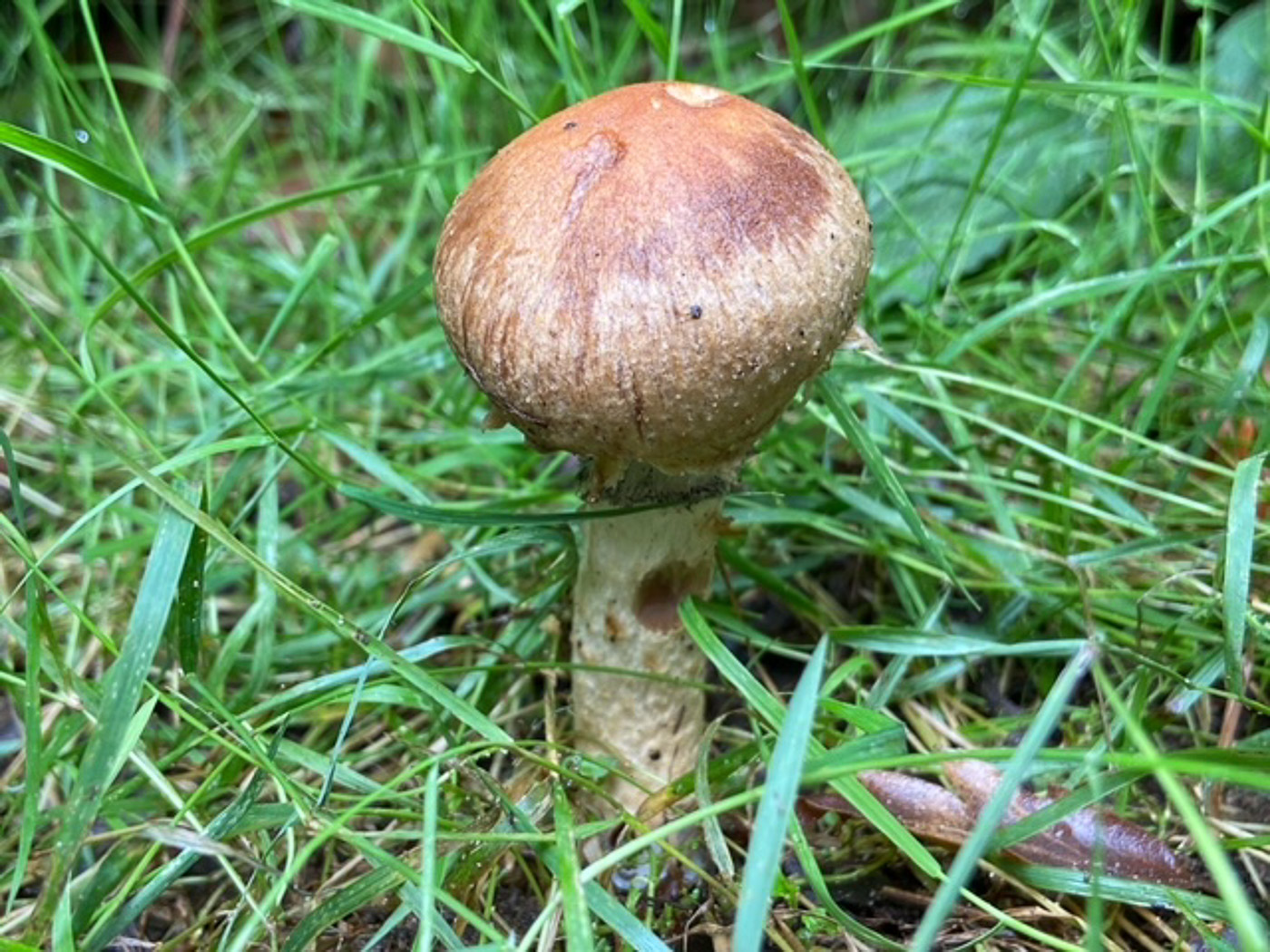
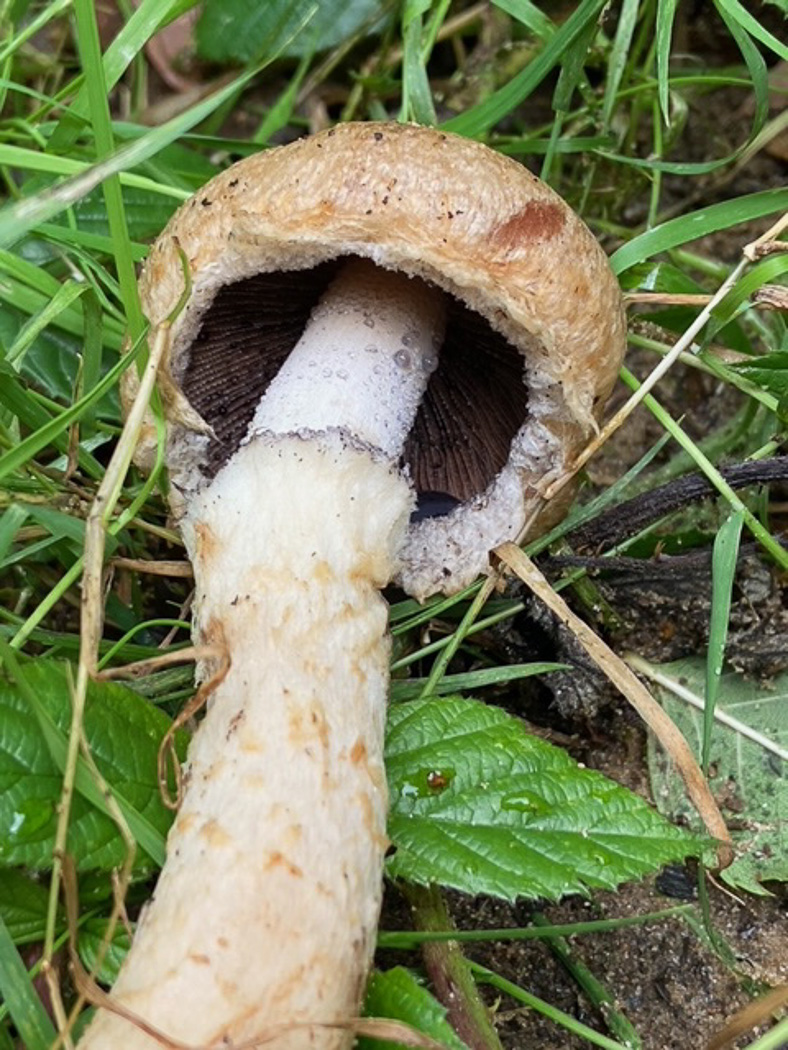
|
September 24th Lacrymaria lacrymabunda (Weeping Widow) At Rushmere Estate a few days earlier Stephen Plummer noticed a small cluster of brown-capped mushrooms just emerging in a grassy path edge though with no gills showing as yet (photo 1). He was stumped and showed a specimen to Penny the next day who suspected it might be a species of Cortinarius (Webcap) but suggested he return to the spot in the hope of some further developed examples. This he did today when all was revealed! The gills, now just visible, made it obvious this was no Cortinarius as they were far too dark, and their telltale purplish black colour with tears of moisture droplets on the edge left no doubt as to its identity (photo 2). This is a fairly nondescript common brown mushroom which can confuse (as we found!). Another feature to note, besides the distinctive gills and its preference for grassy soil, is the fluffy ring on the stem which can sometimes leave ragged remnants on the cap margin as well.The species is often to be found in churchyards around the gravestones though there is nothing sinister to be read into this association! Previous finds |
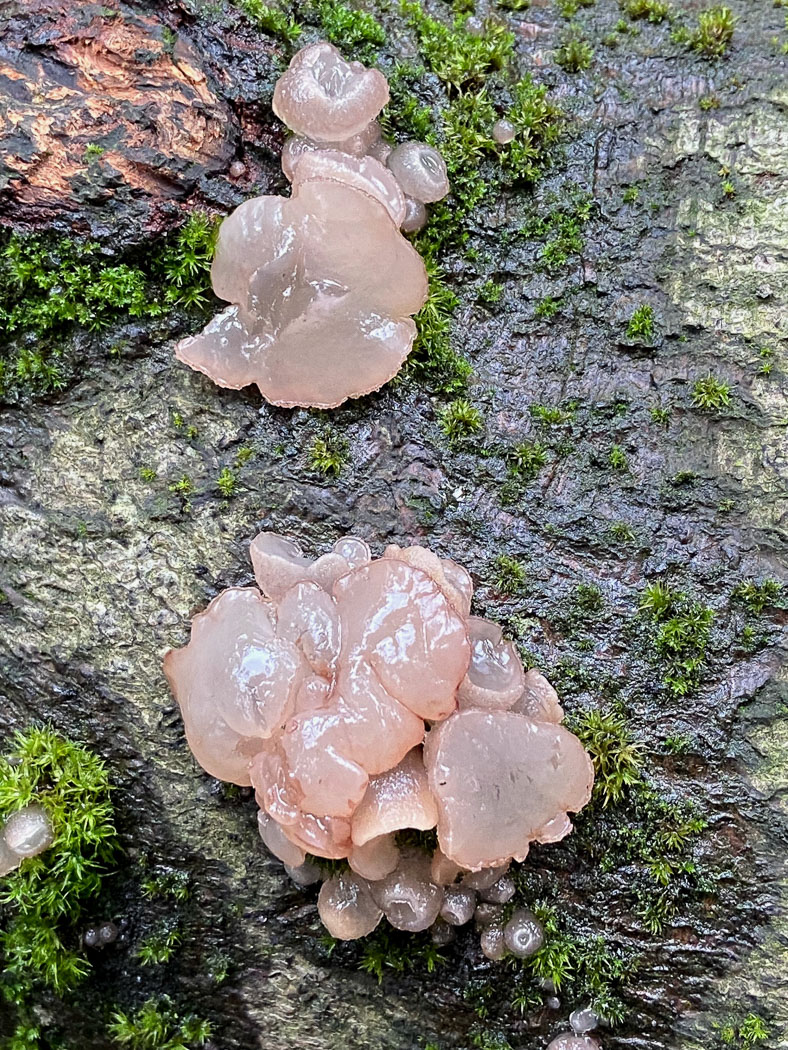 |
September 24th Neobulgaria pura (Beech Jellydisc) At Rushmere Estate Stephen Plummer notices these nice fresh specimens on a fallen Beech trunk. When pale like this there should be no danger of confusing the species with Ascocoryne sarcoides (Purple Jellydisc) which is smaller, darker and more squiggly(!) though the two can often be found quite close together. Previous finds |
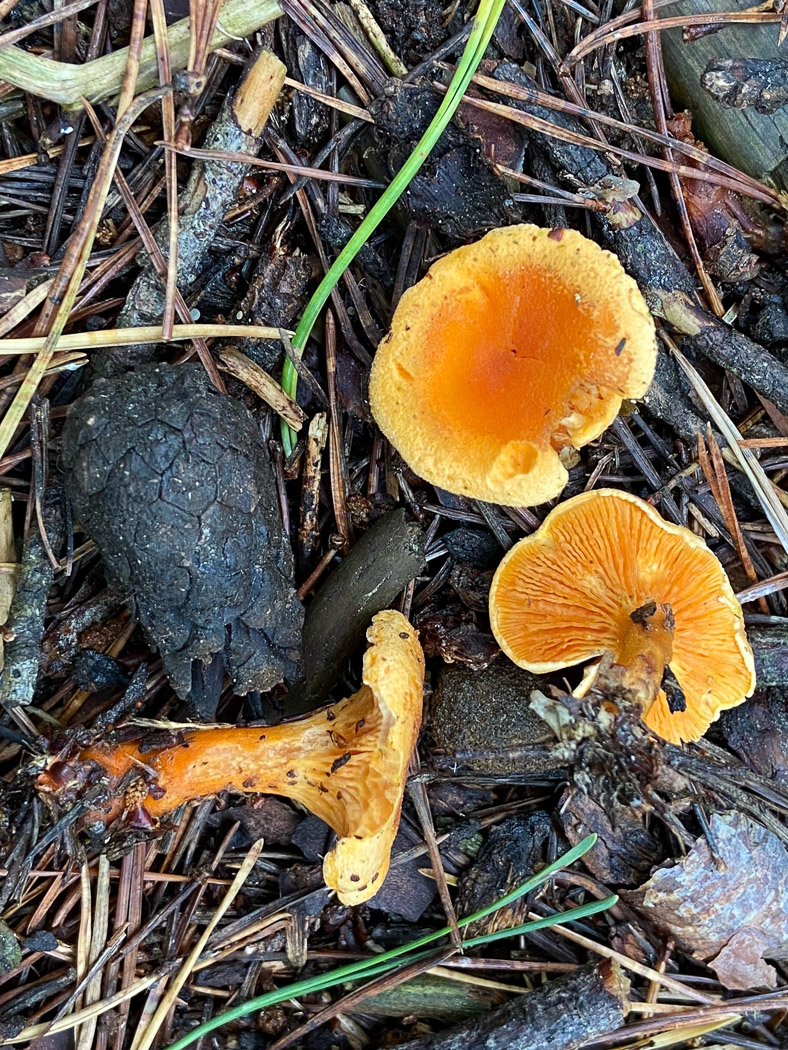 |
September 24th Hygrophoropsis aurantiaca (False Chanterelle) At Rushmere Estate Stephen Plummer found this species whilst under Pine. It tends to favour conifer woodland but can also occur in deciduous woods. Noting the sharp edged gills seen here should prevent any confusion with Cantharellus cibarius (Chanterelle) which has much broader 'foldlike' gills, though both species do have a similar colour and general shape. Previous finds |
September 23rd 2024

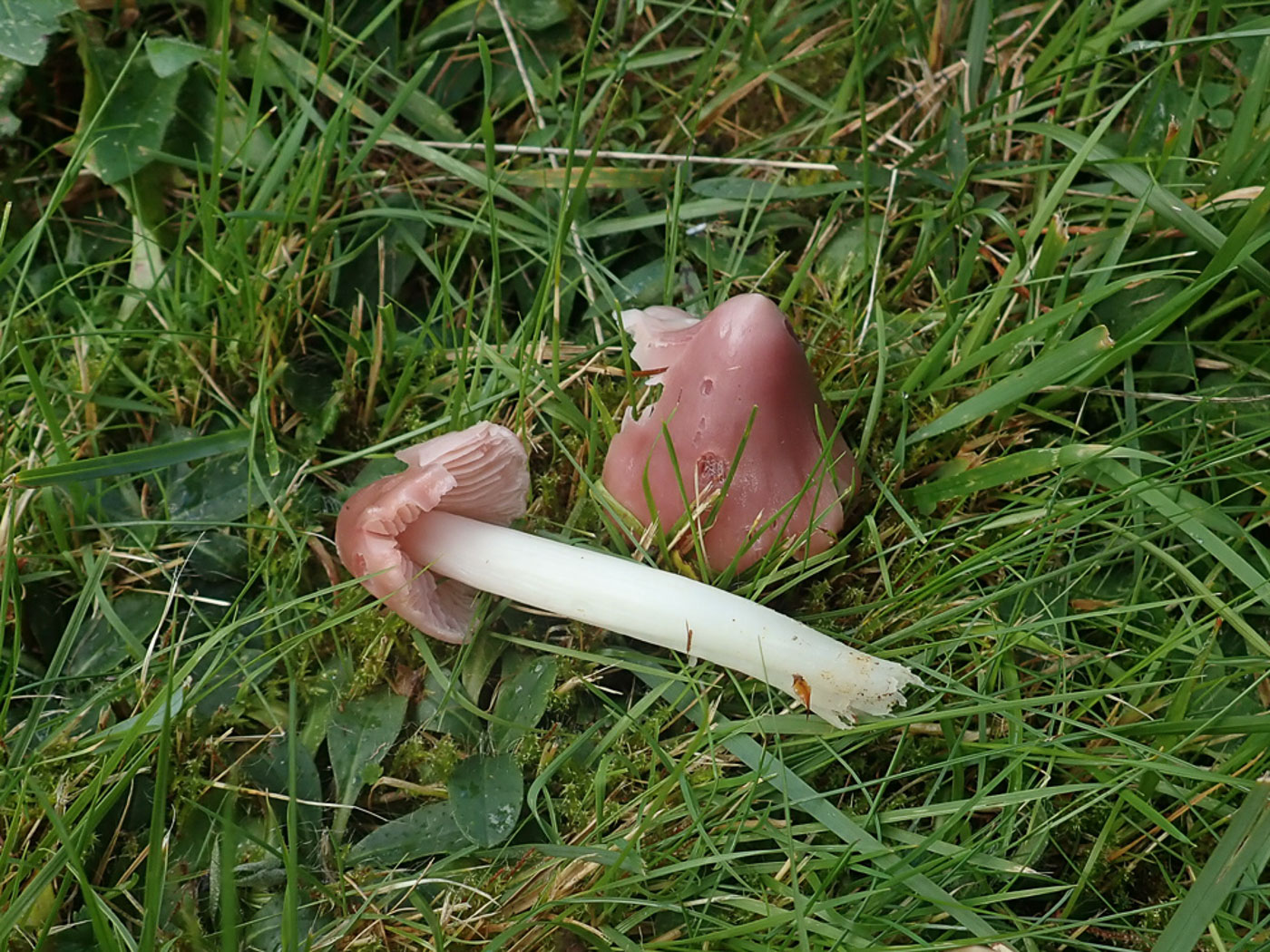 |
September 23rd Porpolomopsis calyptriformis (Pink Waxcap) In Prestwood churchyard Sarah Ebdon was rewarded by finding this beauty. Previously in genus Hygrocybe, a more apt English name is Ballerina, especially as there are now other pink waxcaps, but we'll stay with the official name for now! This species is always considered one of the jewels in the waxcap crown and is not that common though we're lucky enough to have several sites for it in the south of the county. A couple of weeks later when Penny visited this great little grassland site this delightful species was still fruiting (photo 2) Previous finds |
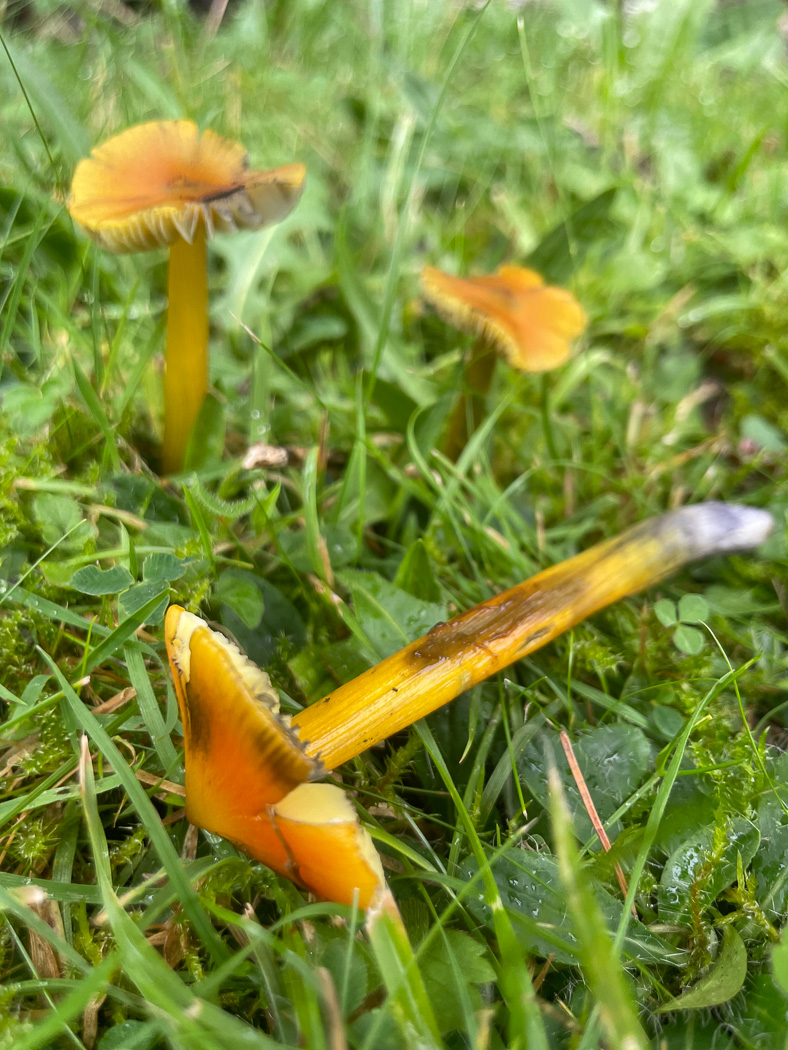
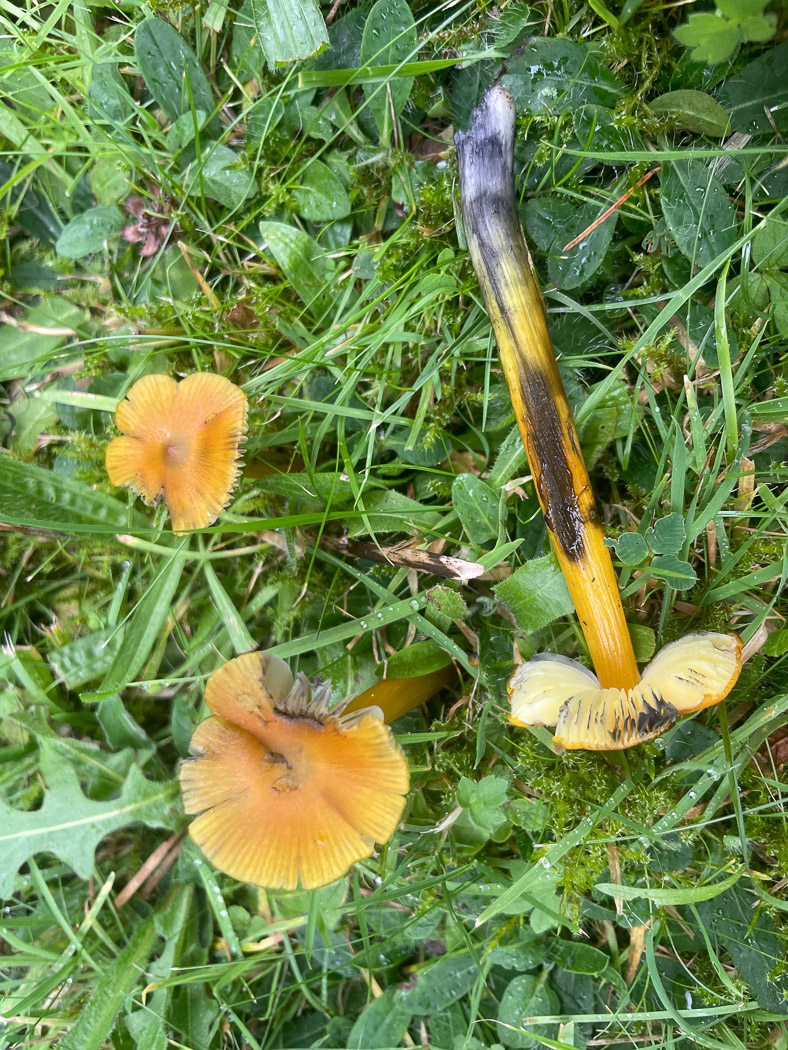 |
September 23rd Hygrocybe conica (Blackening Waxcap) In Prestwood churchyard Sarah Ebdon found several waxcaps which she thought were probably H. conica though the typical blackening was hardly apparent. However, after scratching the stem and waiting 30 minutes (photo 2) it became obvious that her first thoughts were correct. This is quite a variable species, known to be a complex, so no doubt will in time be further split up. Previous finds |
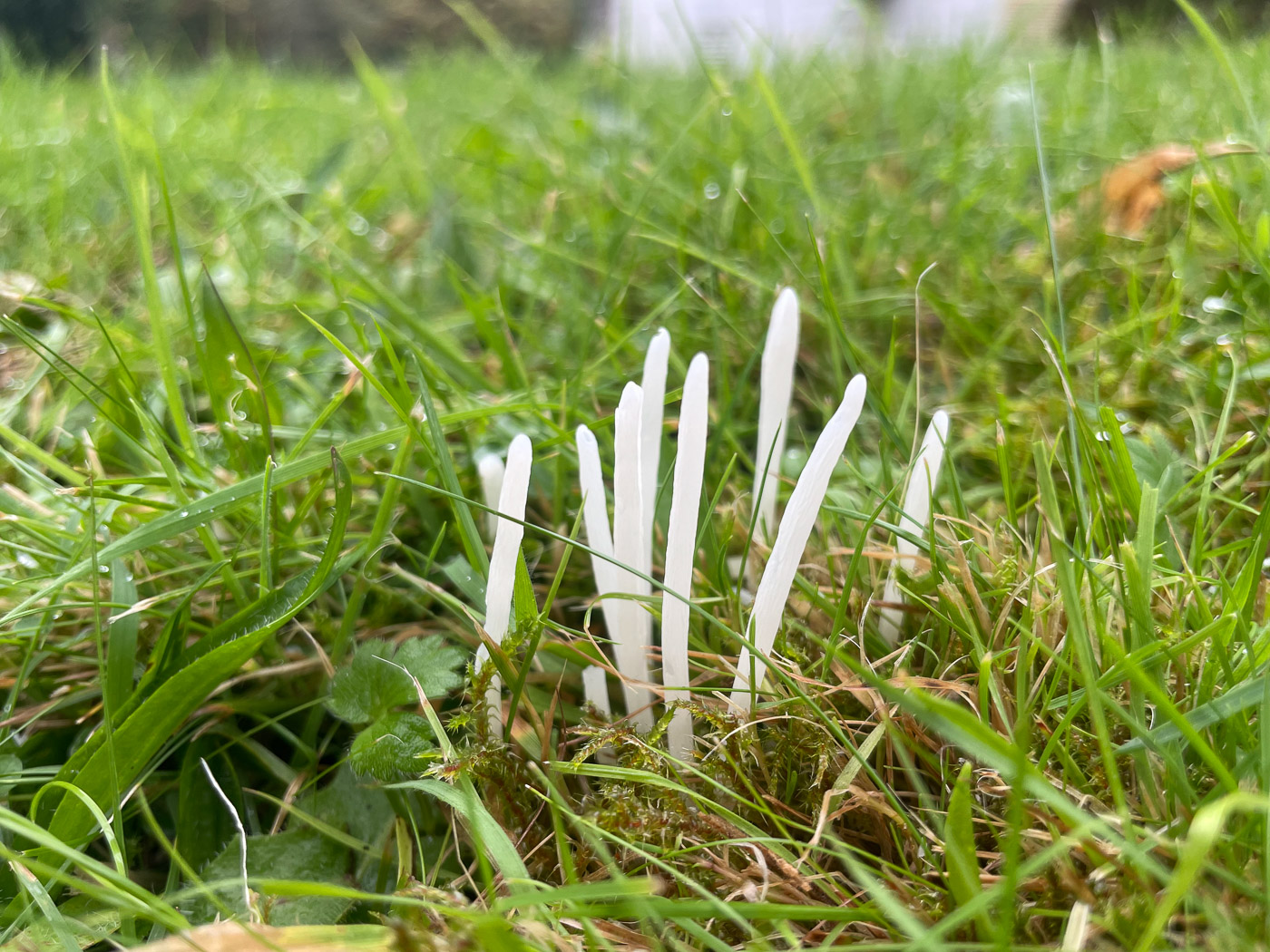 |
September 23rd Clavaria fragilis (White Spindles) In Prestwood churchyard Sarah Ebdon found several grassland species beginning to appear, this being one of them. It is not that common but quite often found at this site - one of our best for such species - and can be recognised by its habit of growing in loose clusters and lack of a separate stem beneath the club-shaped top section. The spore shape and size is also a useful confirmation, differing from other possibly similar species. Previous finds |
September 20th 2024
 |
September 20th Baeospora myosura (Conifercone Cap) In Rushmere Estate Stephen Plummer noticed this Pine cone nicely adorned with this little 'mycenoid' species. Apart from always growing on cones, its main distinguishing feature is the extremely crowded and rather shallow gills, and it typically has rather a strigose stem base - very pronounced in this example. It is quite common wherever Pines occur. Previous finds |
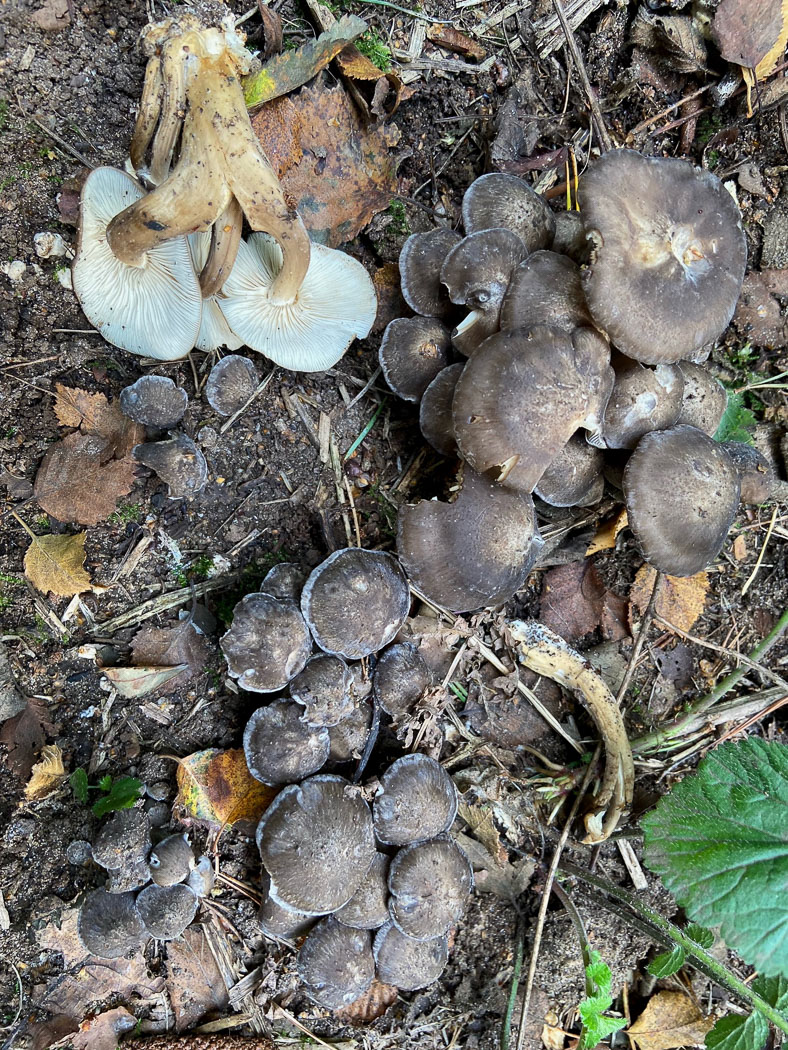 |
September 20th Lyophyllum decastes (Clustered Domecap) In Rushmere Estate Stephen Plummer found this nice clump in mixed litter, checked its identity at home then showed the collection to Penny and Derek for confirmation. This is a fairly common but nondescript species of woodland paths, quite flexible in texture, its most distinctive characters being its fasciculate habit (ie with stems often conjoining as in Hypholoma fasciculare) and contrasting dark cap with pale gills. Previous finds |
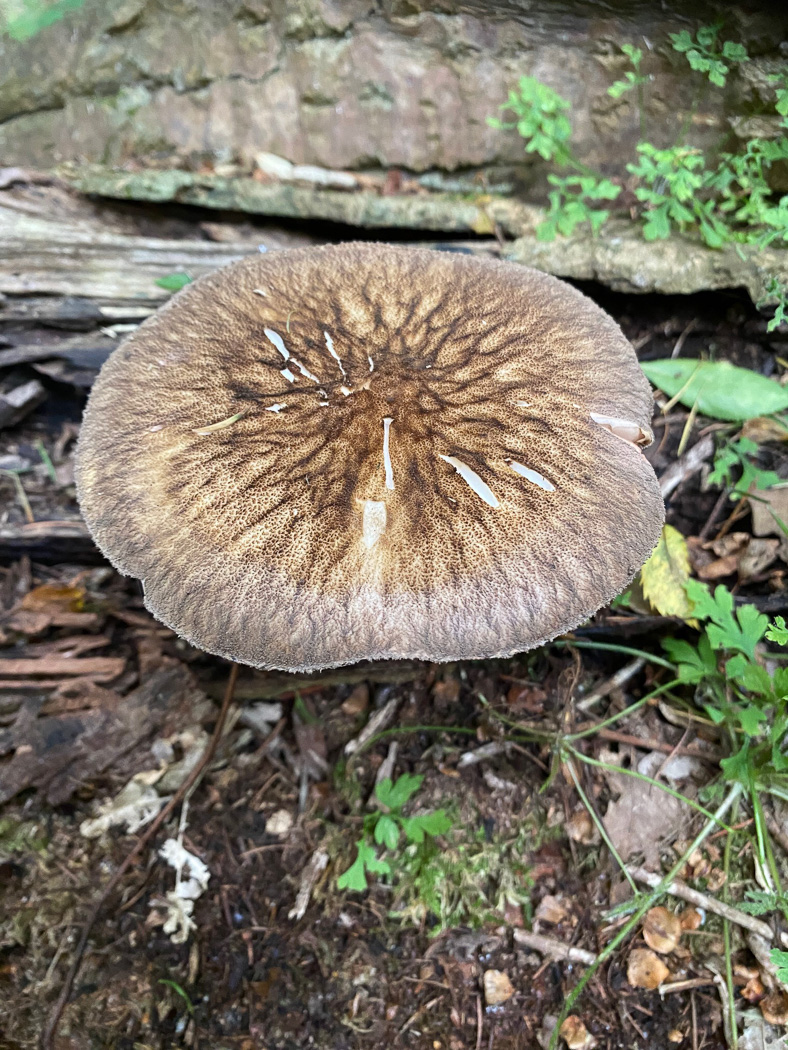
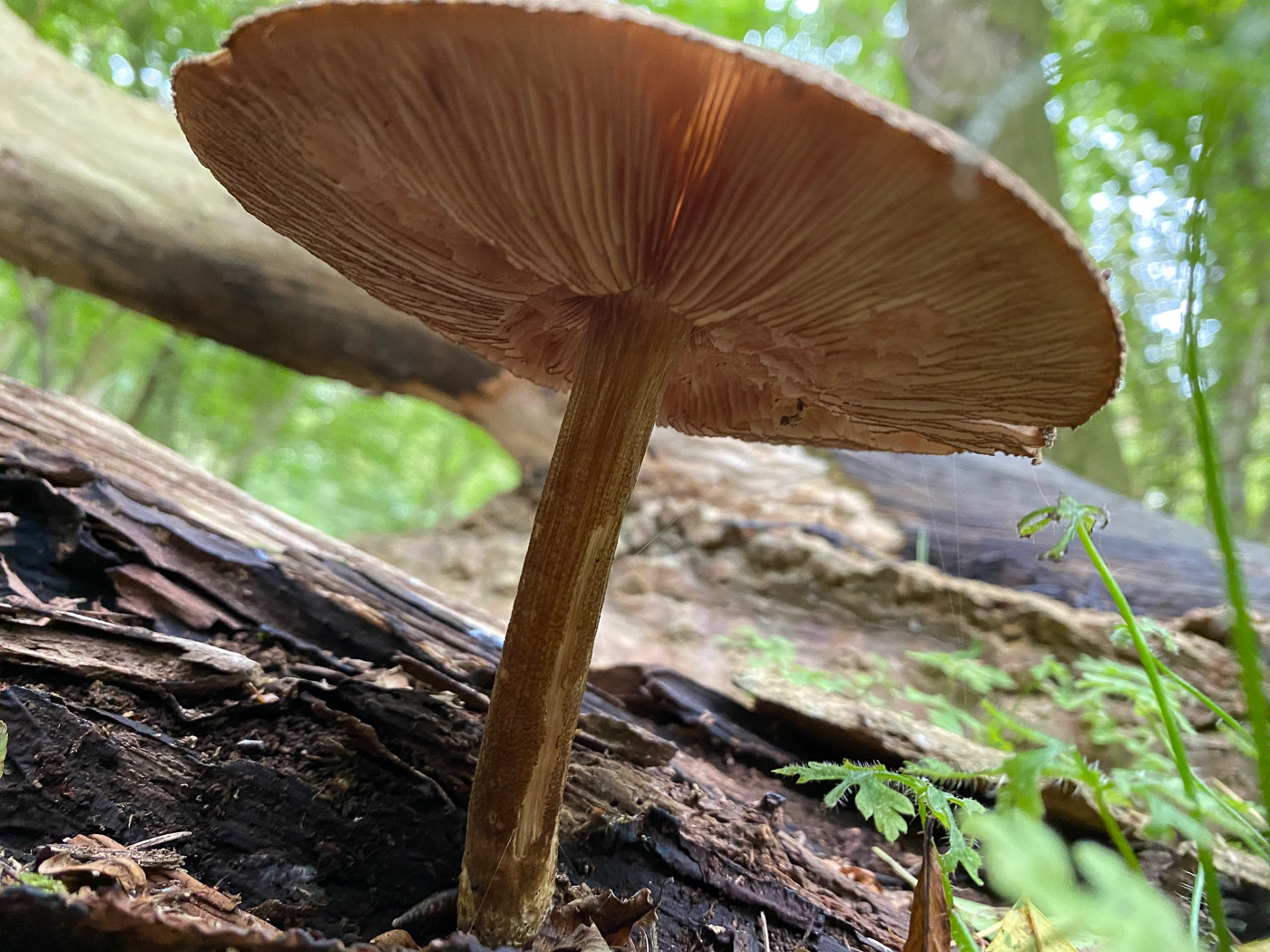 |
September 20th Pluteus umbrosus (Velvet Shield) In Bernwood Forest Chris Grimbly found this Pluteus on a felled deciduous trunk. This is one of two species which have a dark gill edge but is distinct in having a finely velvet cap surface which is also on the stem. The other much rarer species, P. atromarginatus, is normally a conifer associate and lacks this cap surface and has a streaky fibrillose stem. The microscopic features are also very different and the safest way to separate the two if in doubt. Previous finds |
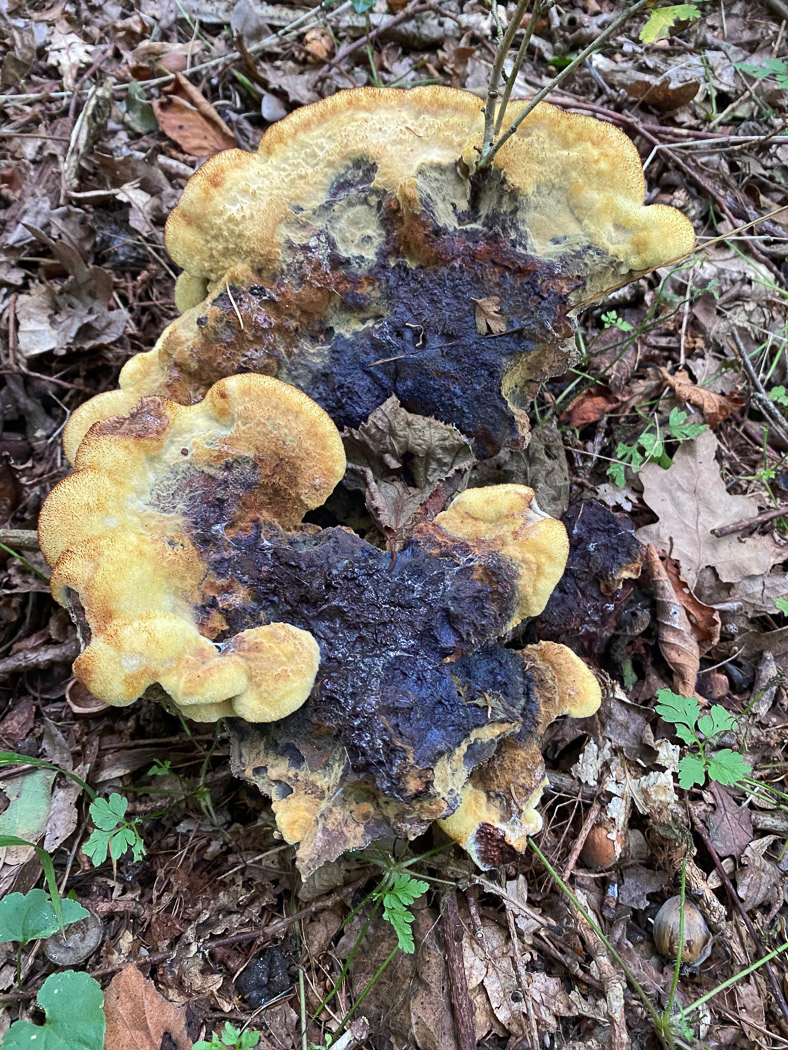 |
September 20th Phaeolus schweinitzii (Dyer's Mazegill) In Bernwood Forest Chris Grimbly came across this impressive species at the base of a Pine. When fresh and young it appears soft and ochre yellowish with rounded edges though as it expands it hardens with darker reds and browns, becoming large dinner plate size. As the name implies, it has been used as a dye for material and wool in the past and is still used in this way by enthusiasts. It is always associated with conifers, growing on the roots usually quite near to the trunk. Previous finds |
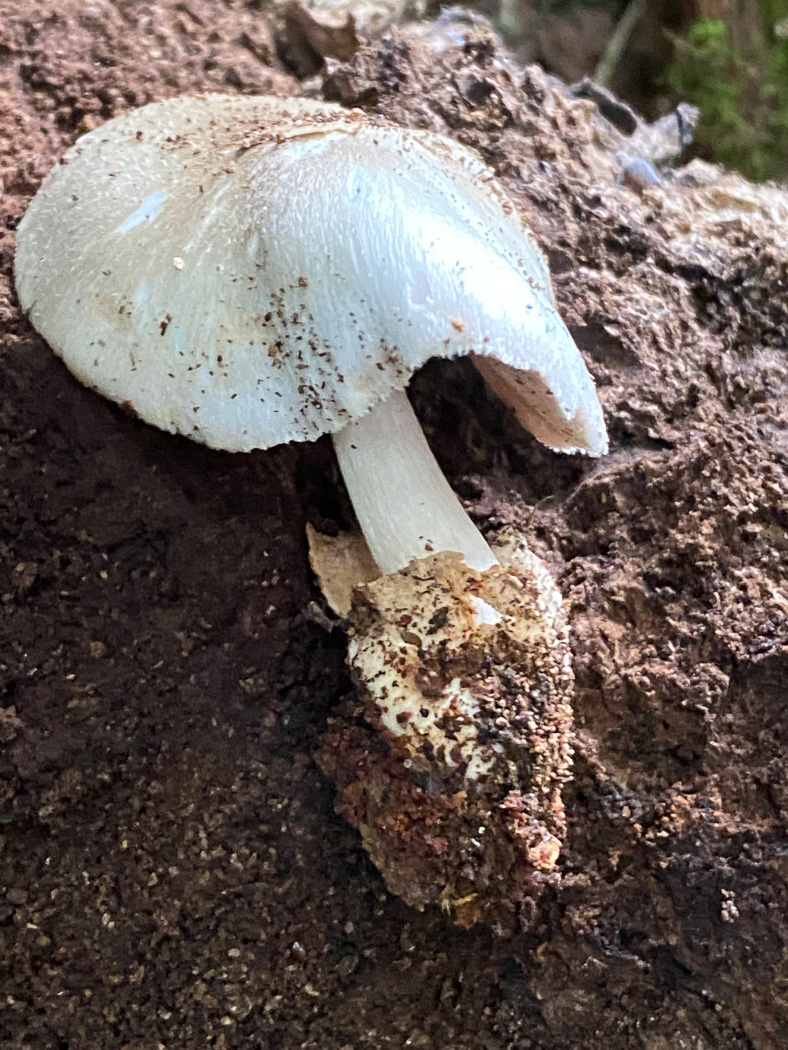
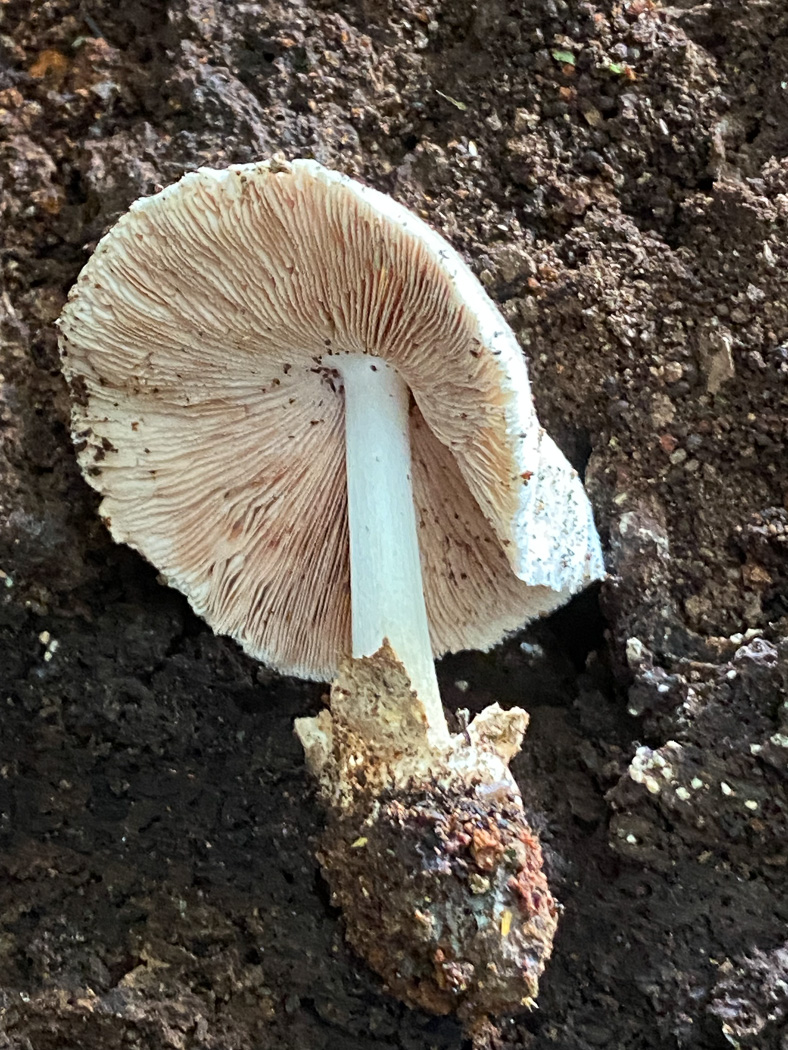 |
September 20th Volvariella bombycina (Silky Rosegill) On a fallen deciduous trunk in Bernwood Forest Chris Grimbly spotted this unusual species. The easiest way to describe it is very similar to a species of Pluteus - ie on wood, with pink free crowded gills - but with one clear difference: it has a Grisette-like volva at the stem base. This feature can be fragile and sometimes easily lost leaving the ID in doubt, but the cream cap colour together with fine silky hairs should be sufficient to alert one to its identity. Previous finds |
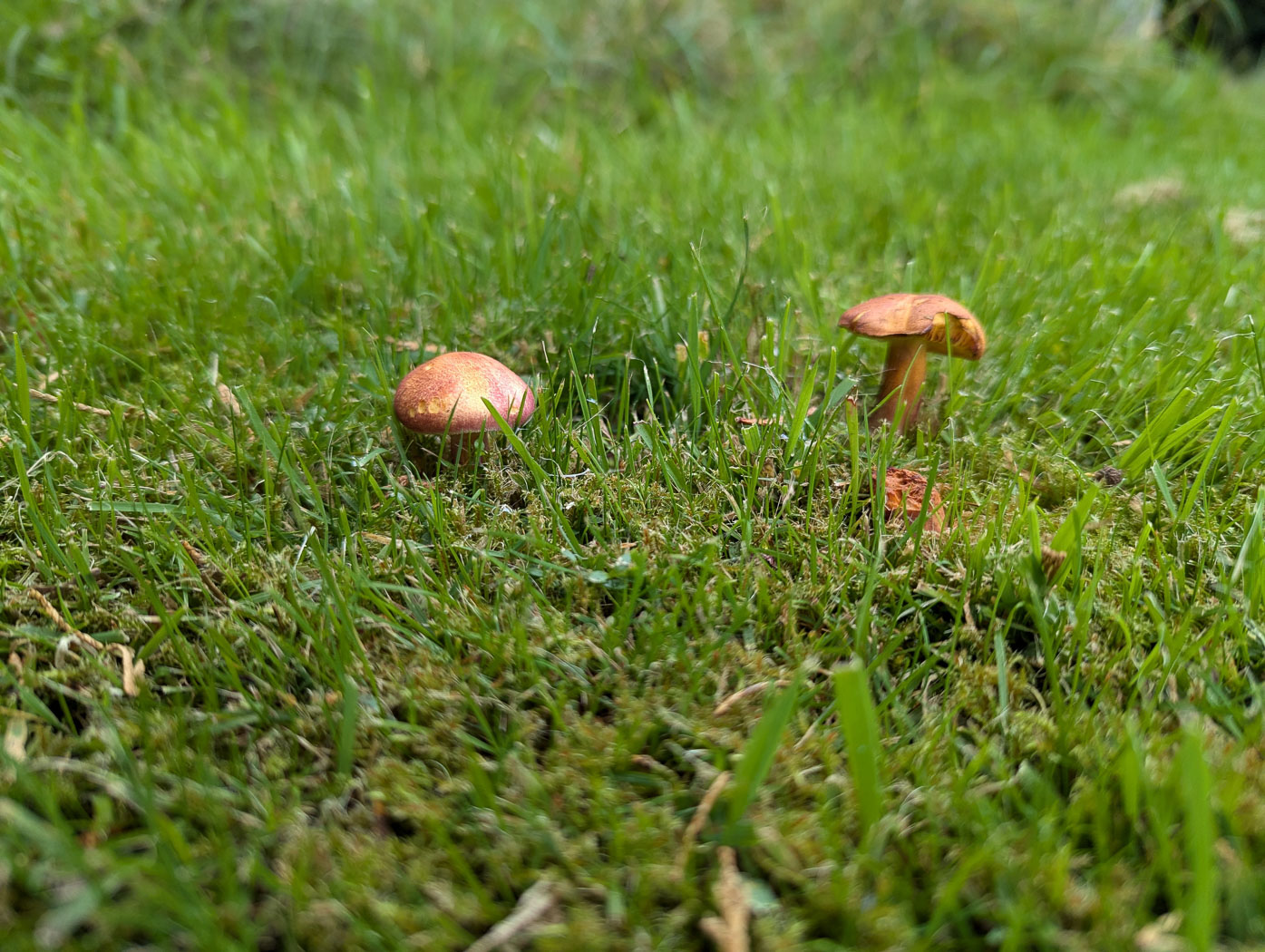
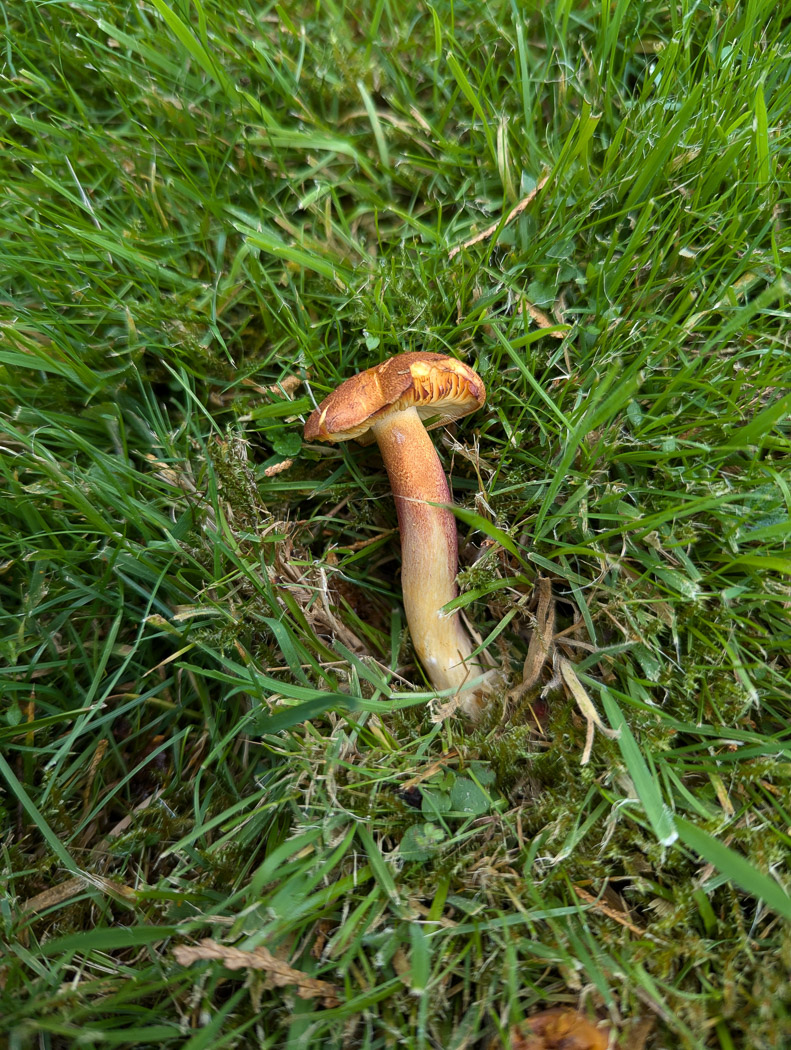
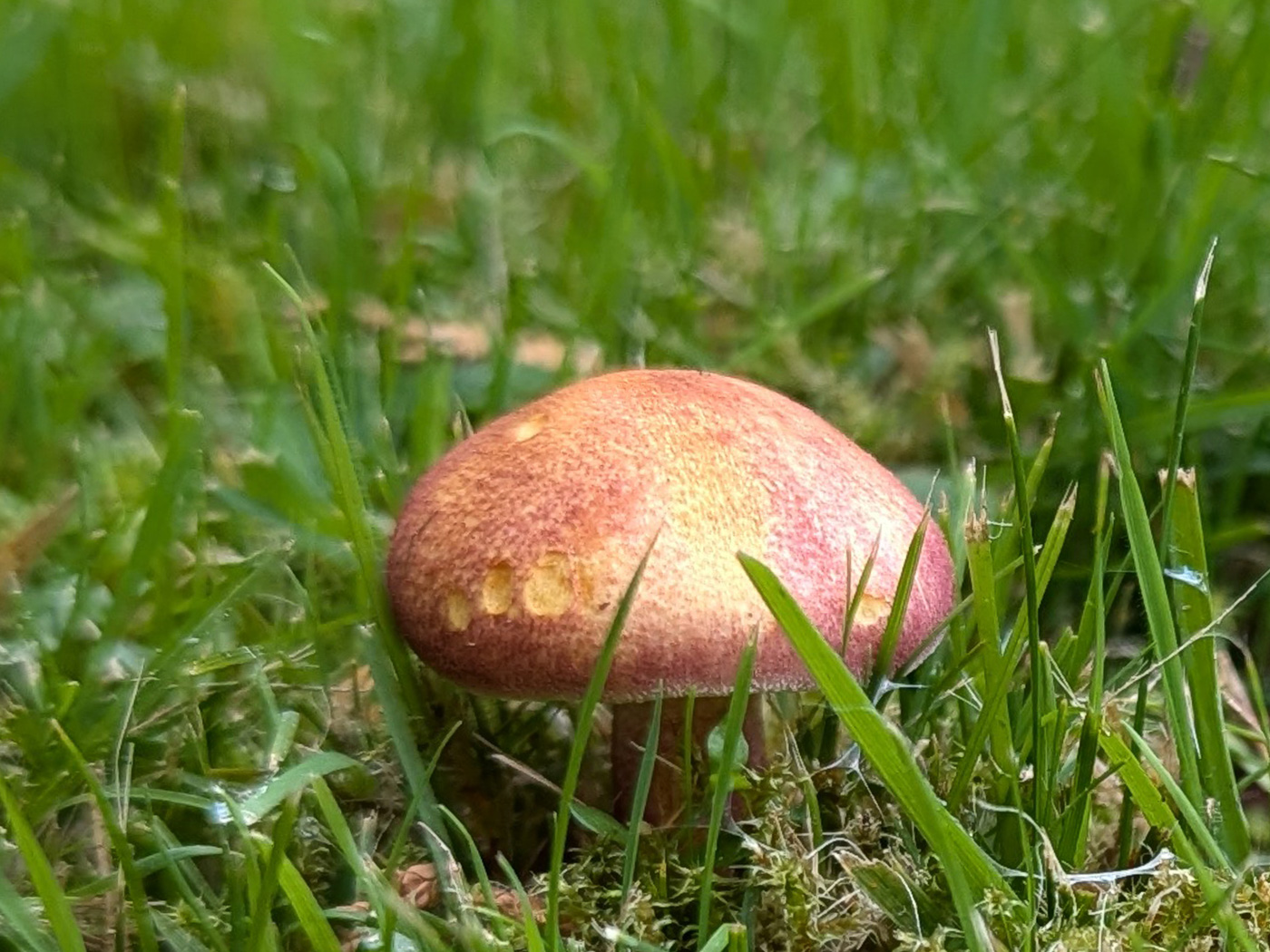 |
September 20th Tricholomopsis rutilans (Plums and Custard) On a hurried visit to Penn Street Churchyard Claire Williams spotted what she assumed was possibly a Waxcap in the grass though near Pine, and sent her photos to Penny for a second opinion. However, Penny is naming this Plums and Custard (hopefully correctly!) and guesses that it was growing on submerged Pine wood or roots. The jizz just doesn't look right for a Waxcap despite the bright colours and apparent grassy habitat, also zooming in (photo 3) the typical mottled cap colours of the species become much more obvious. Previous finds |
September 13th 2024
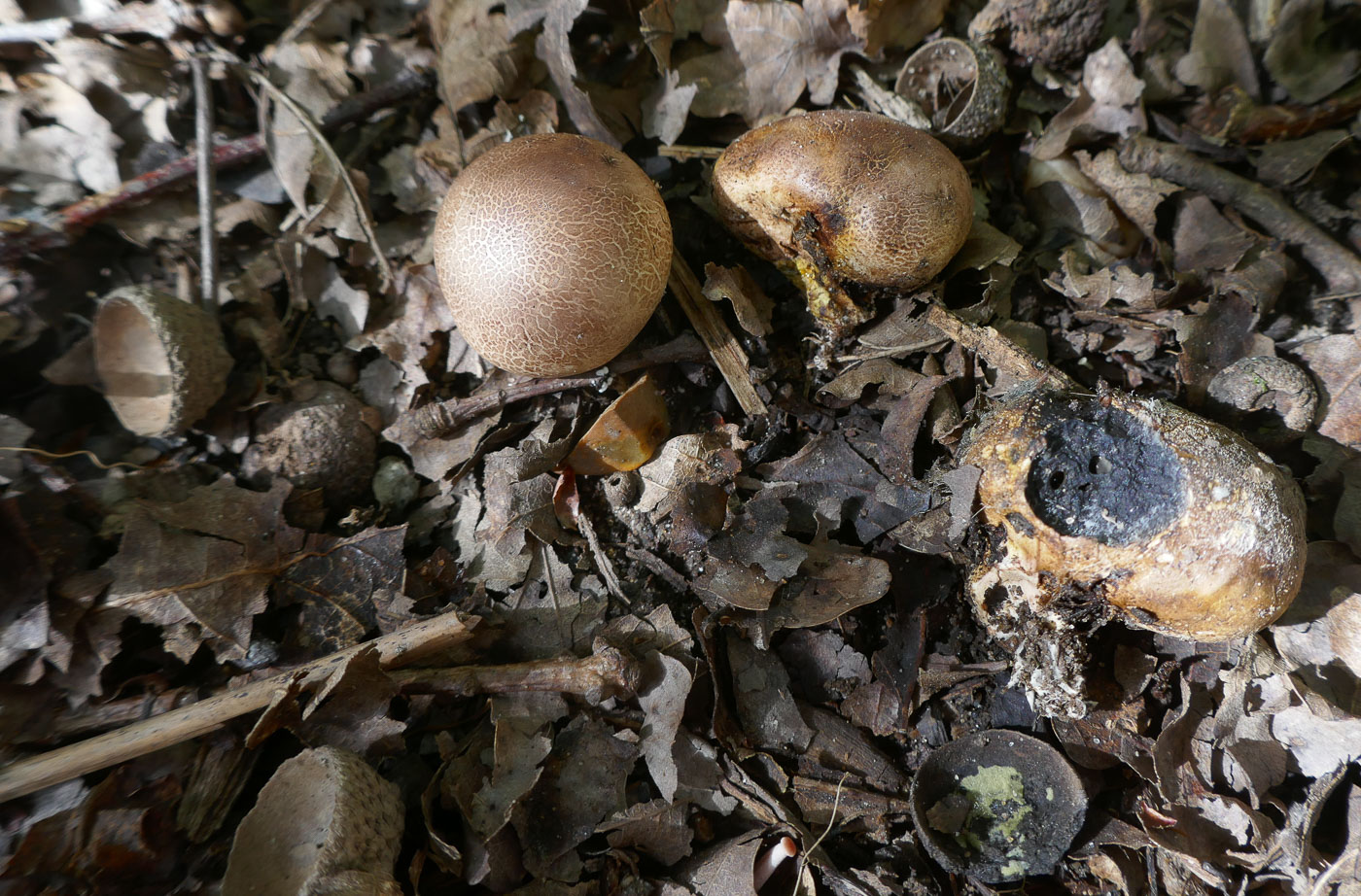
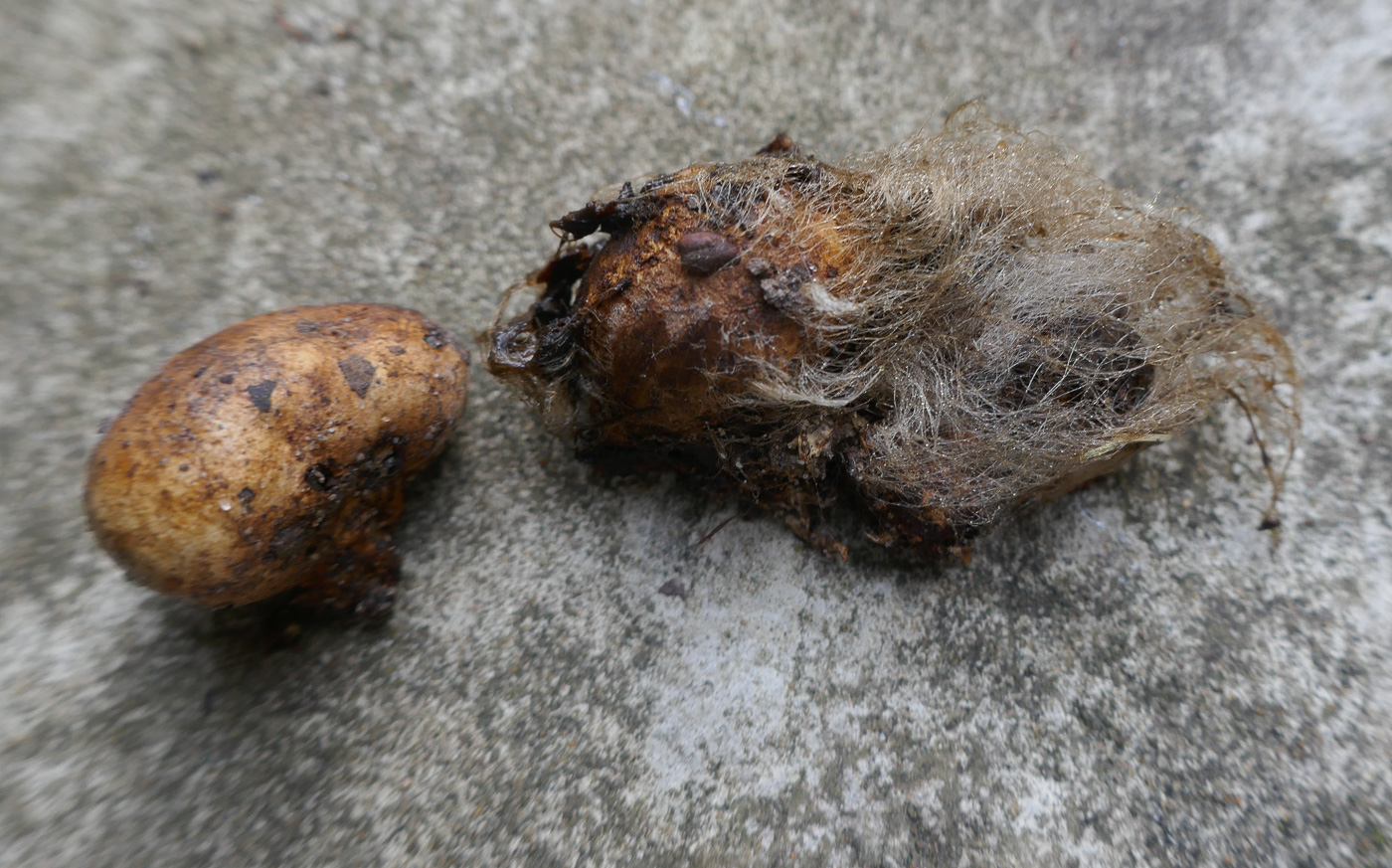 |
September 13th Scleroderma bovista (Potato Earthball) Under Oak at Stampwell Farm Jackie Ewan found these small Earthballs, much smoother and usually with a less distinct stem compared to both S. verrucosum and S. areolatum. Jackie commented that the outer surface turned red on damaging though Penny finds this is not that useful a pointer to species as both the other two species can also react in that way. The microscopic differences – both spore ornamentation and presence of clamps - are definitive for this species, however. It certainly has a resemblance to a potato which also helps! Photo 2 shows a remarkable sprouting of fine 'hairs' which developed after the specimen had been retained in a pot for a few days! Previous finds |
September 12th 2024
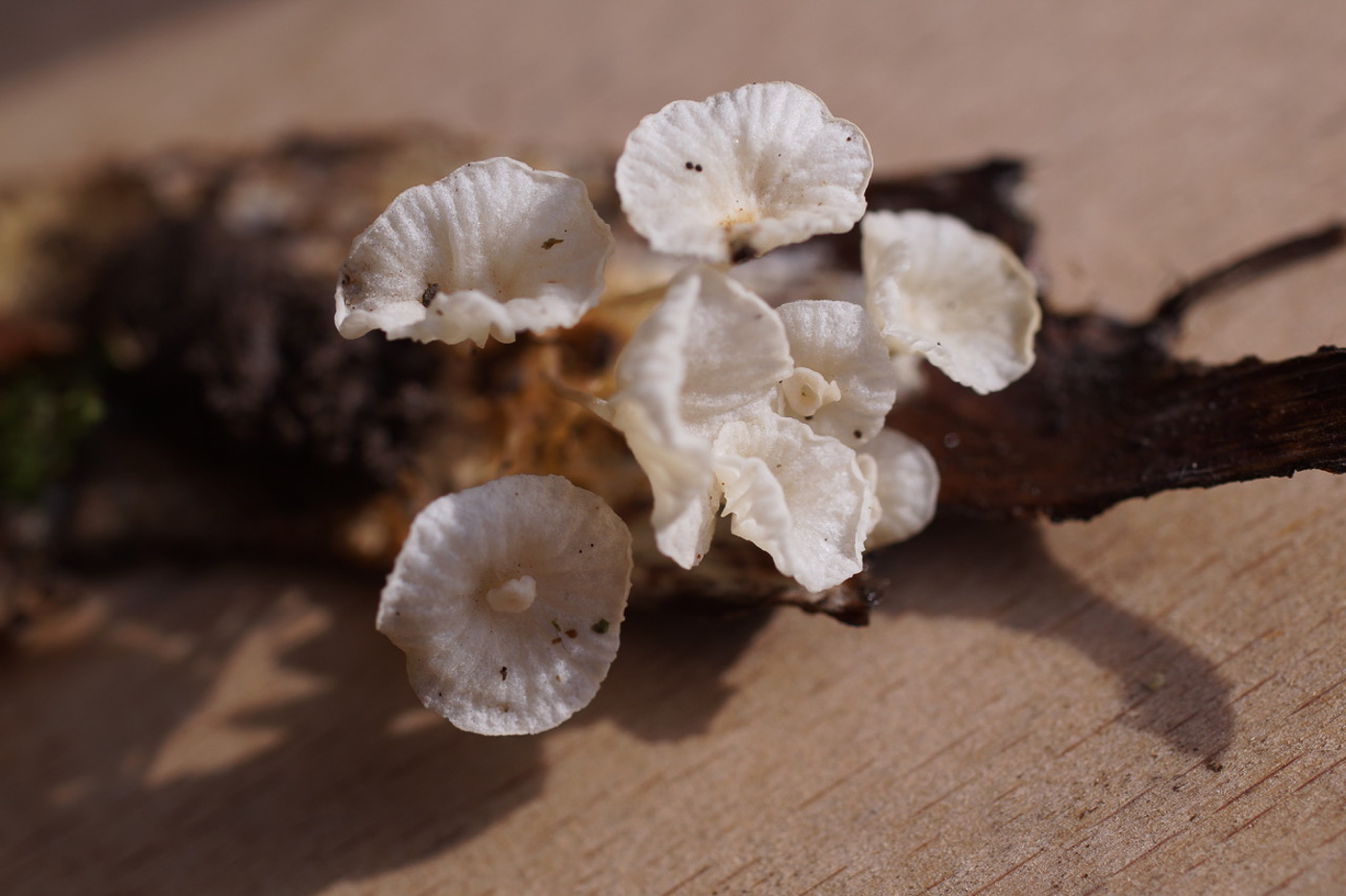
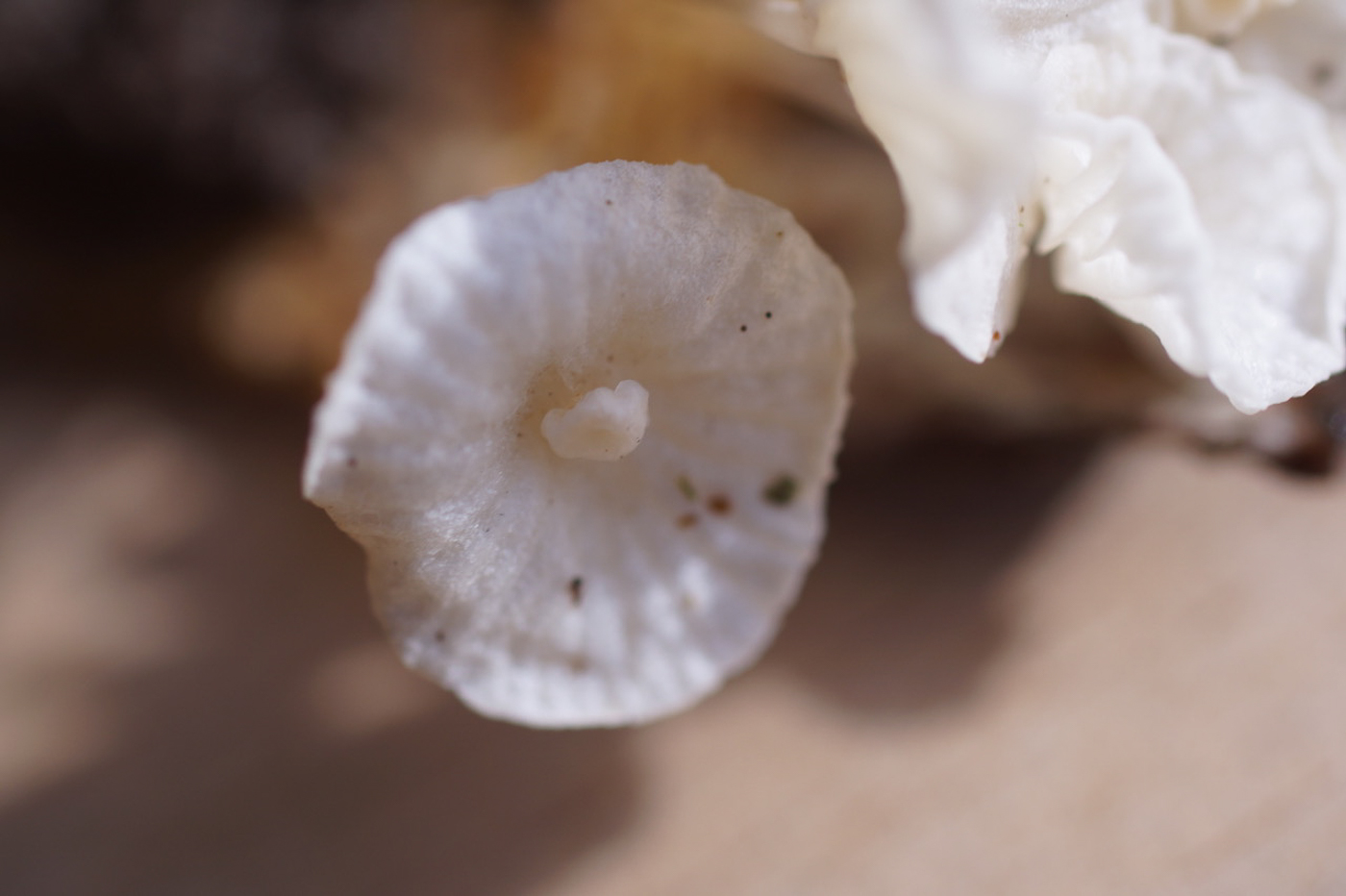
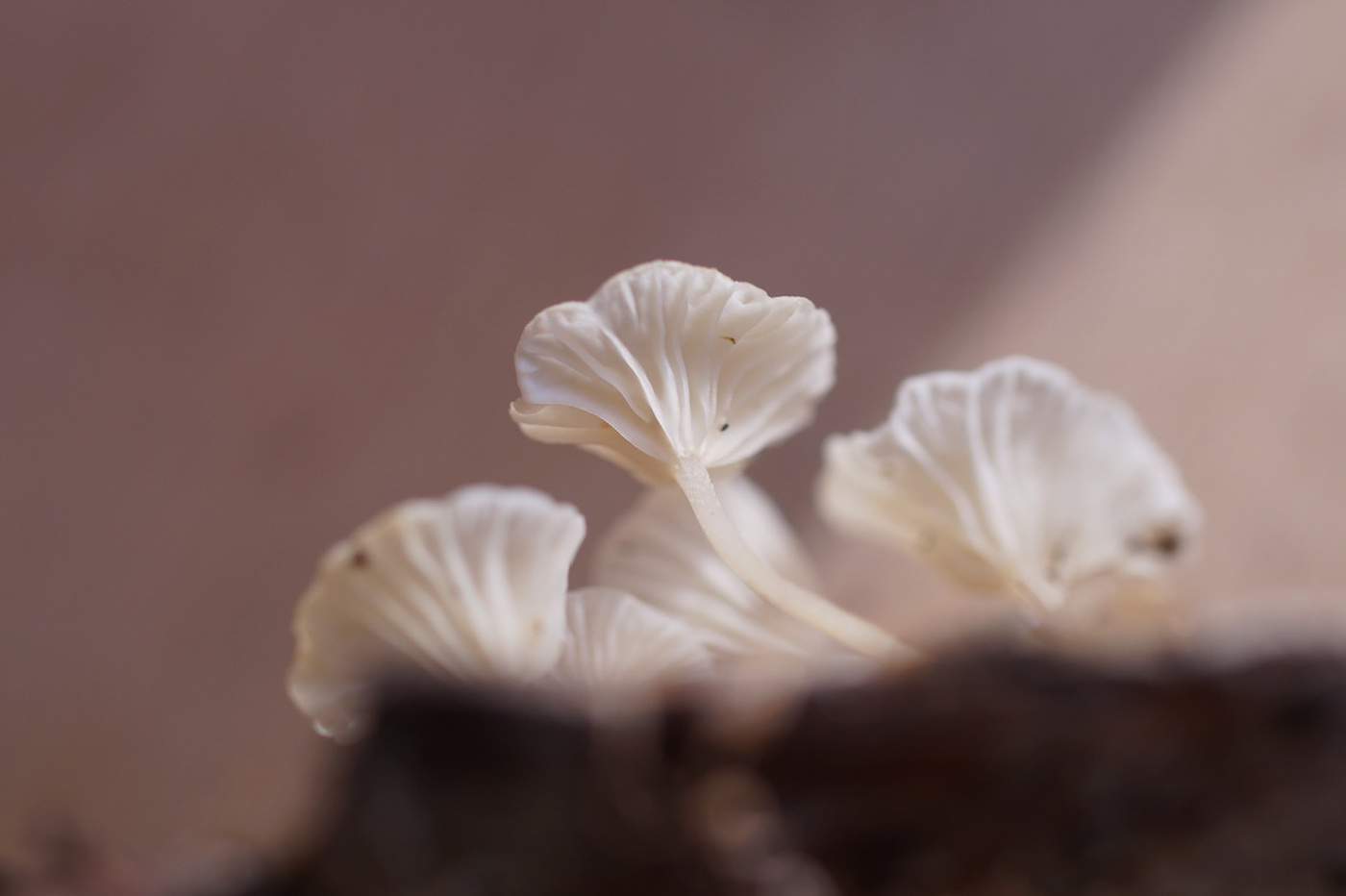 |
September 12th Marasmiellus vaillantii (Goblet Parachute) In Salden Wood Bob Simpson found these tiny white mushrooms on a piece of woody debris and was intrigued by the unusual and almost petal-like appearance of the cap! At home he wondered if it could be this species but sent his photos to Penny who'd also not seen it with caps like this. However the microscopic features fitted fine as did its size and general appearance apart from the extra mini-caps in the middle! Misformed caps do occur from time to time in many species, however. This is quite a common mushroom found often in clusters or loose groups on woody debris and dead vegetation. It was also found three days later on our walk at Wotton Park Estate. Do not confuse with the much more common and superficially similar Marasmius rotula (Collared Parachute) which, however, has an entirely different gill attachment. Previous finds |
September 11th 2024
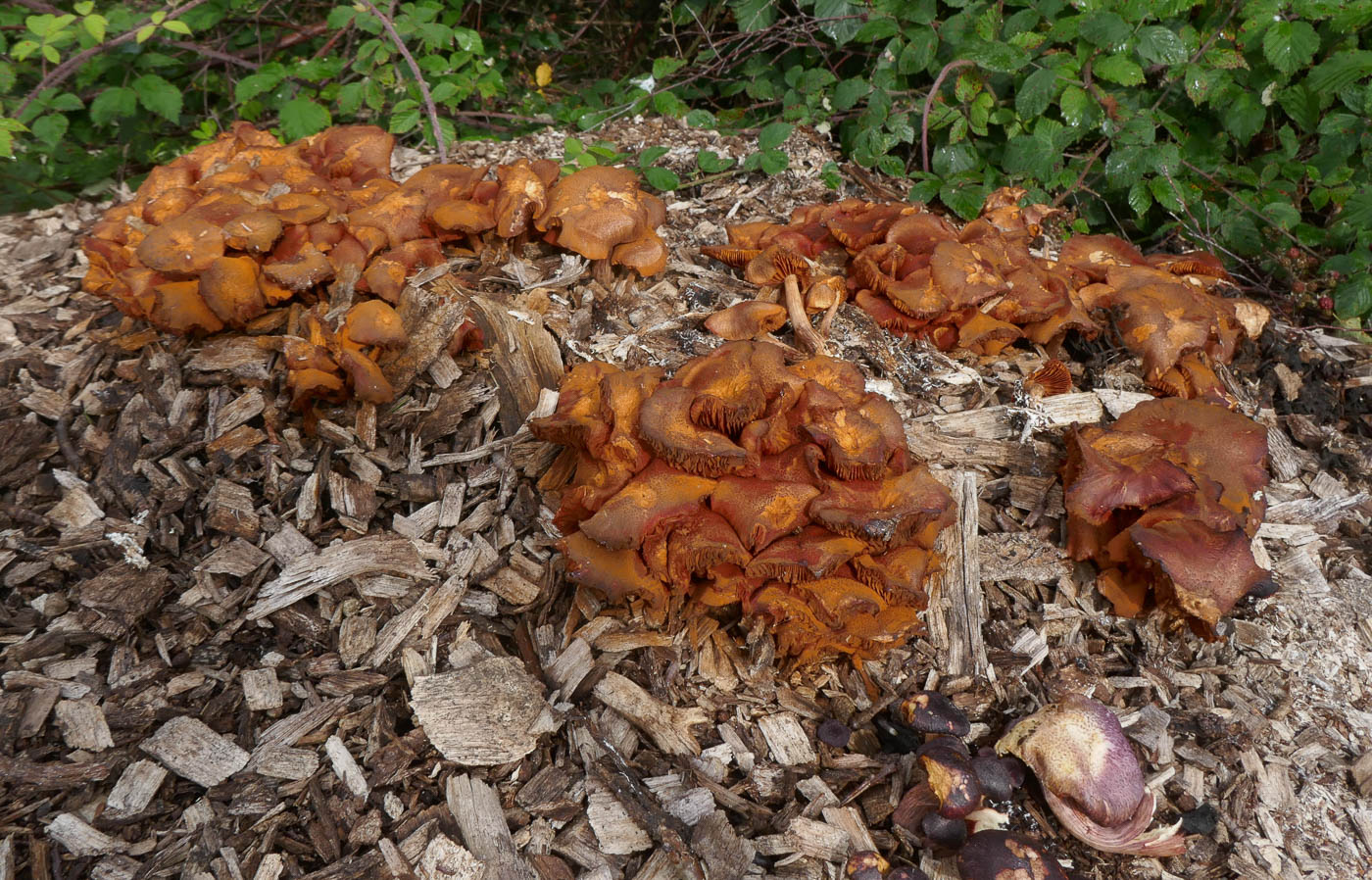
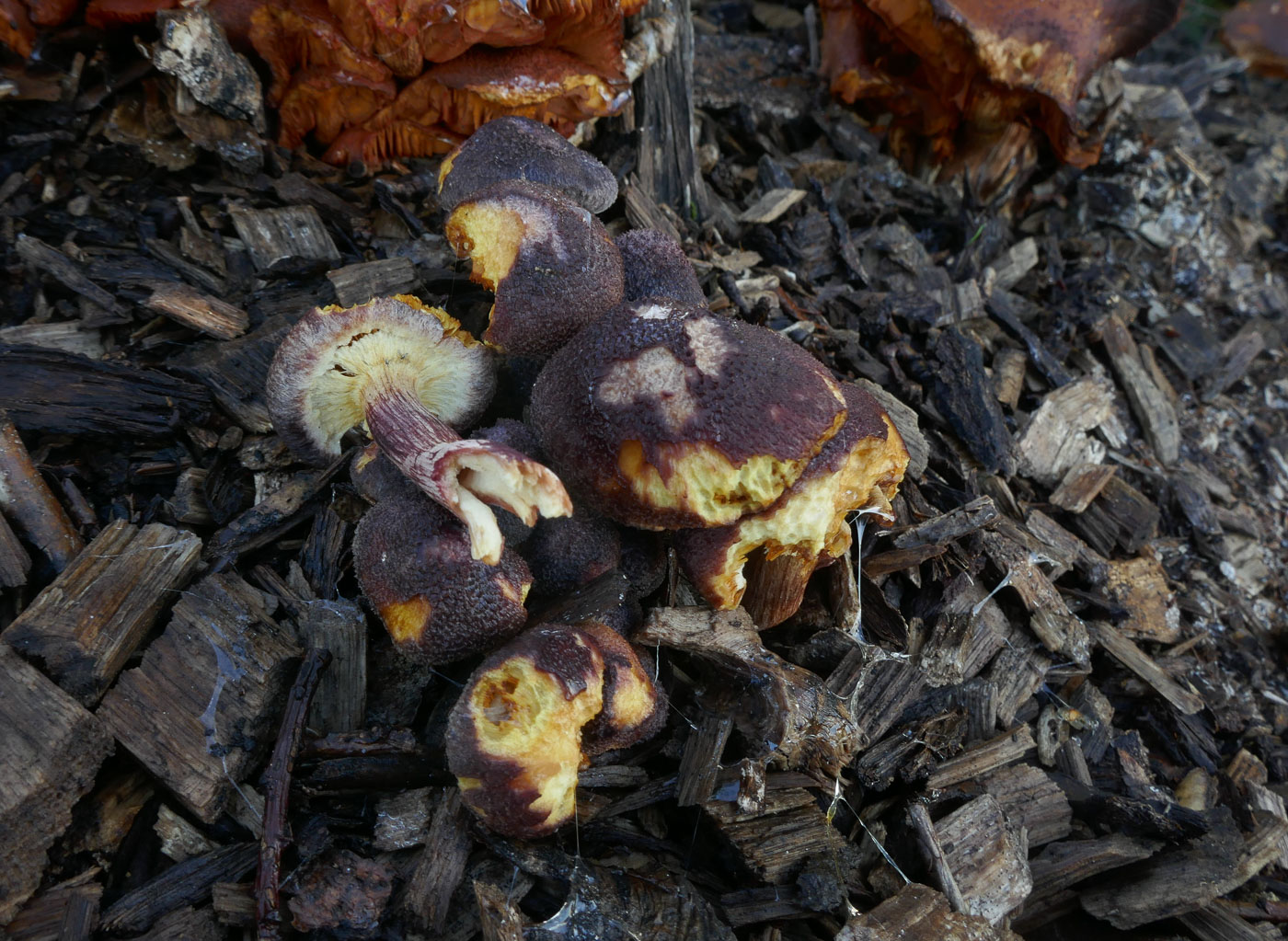
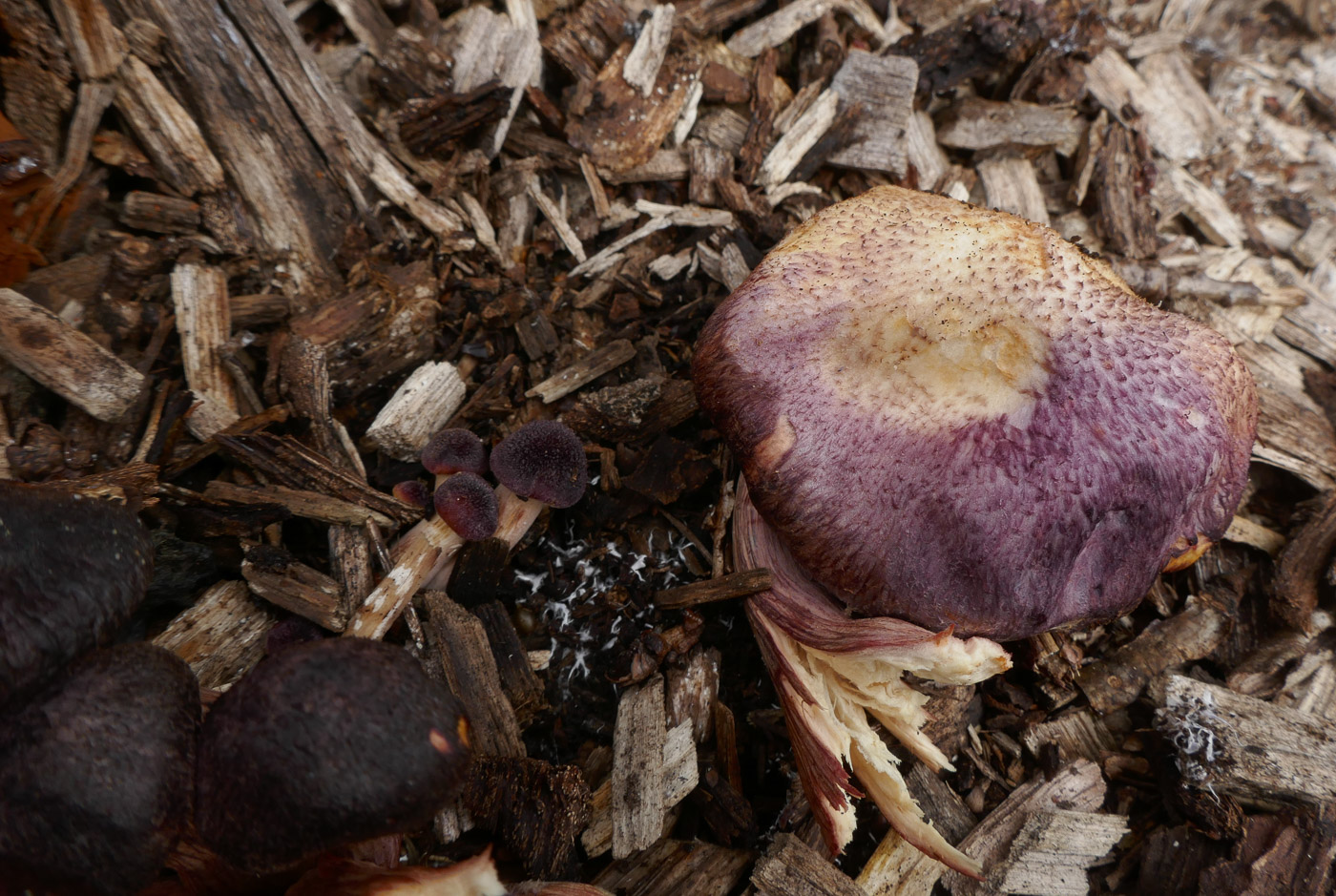
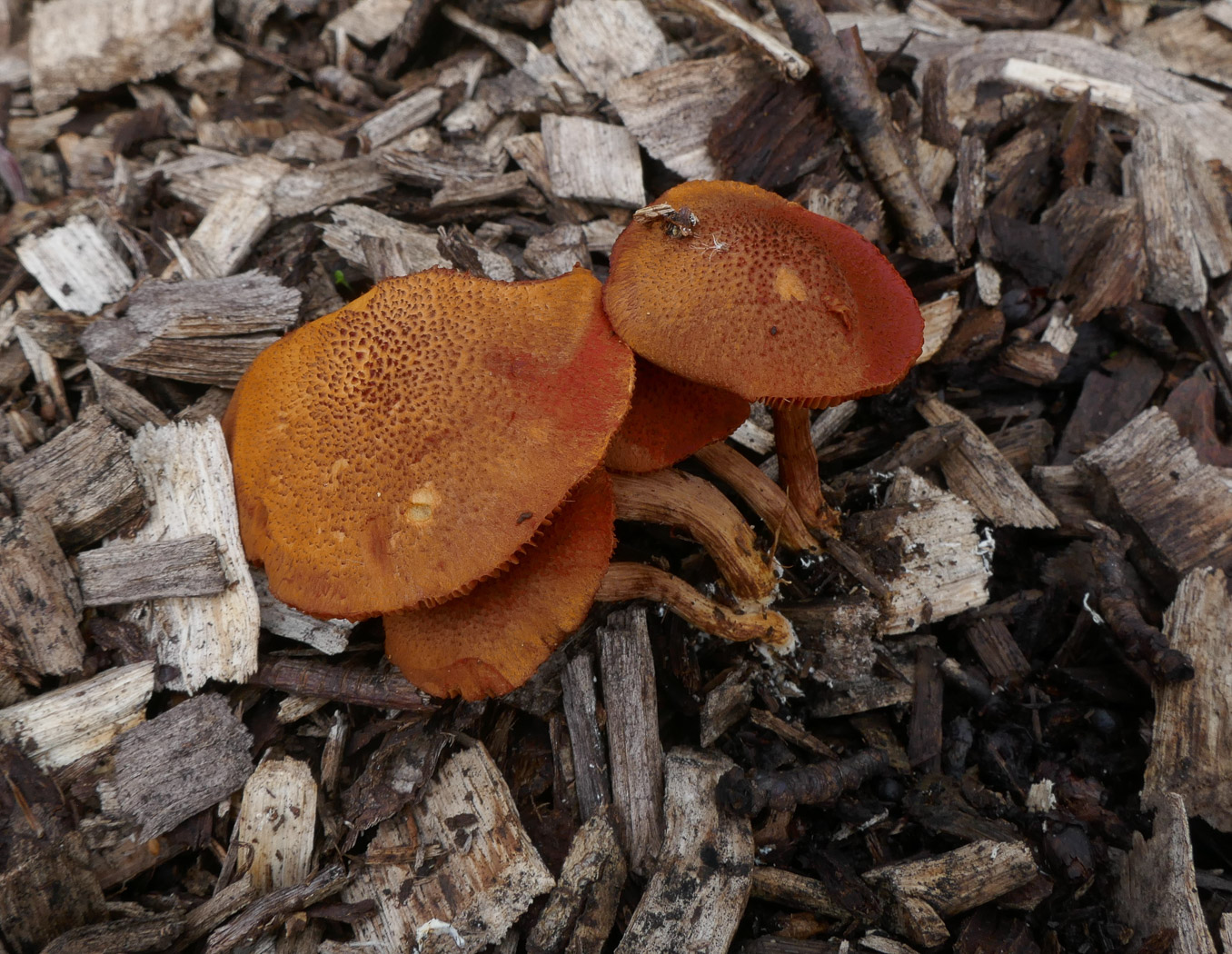
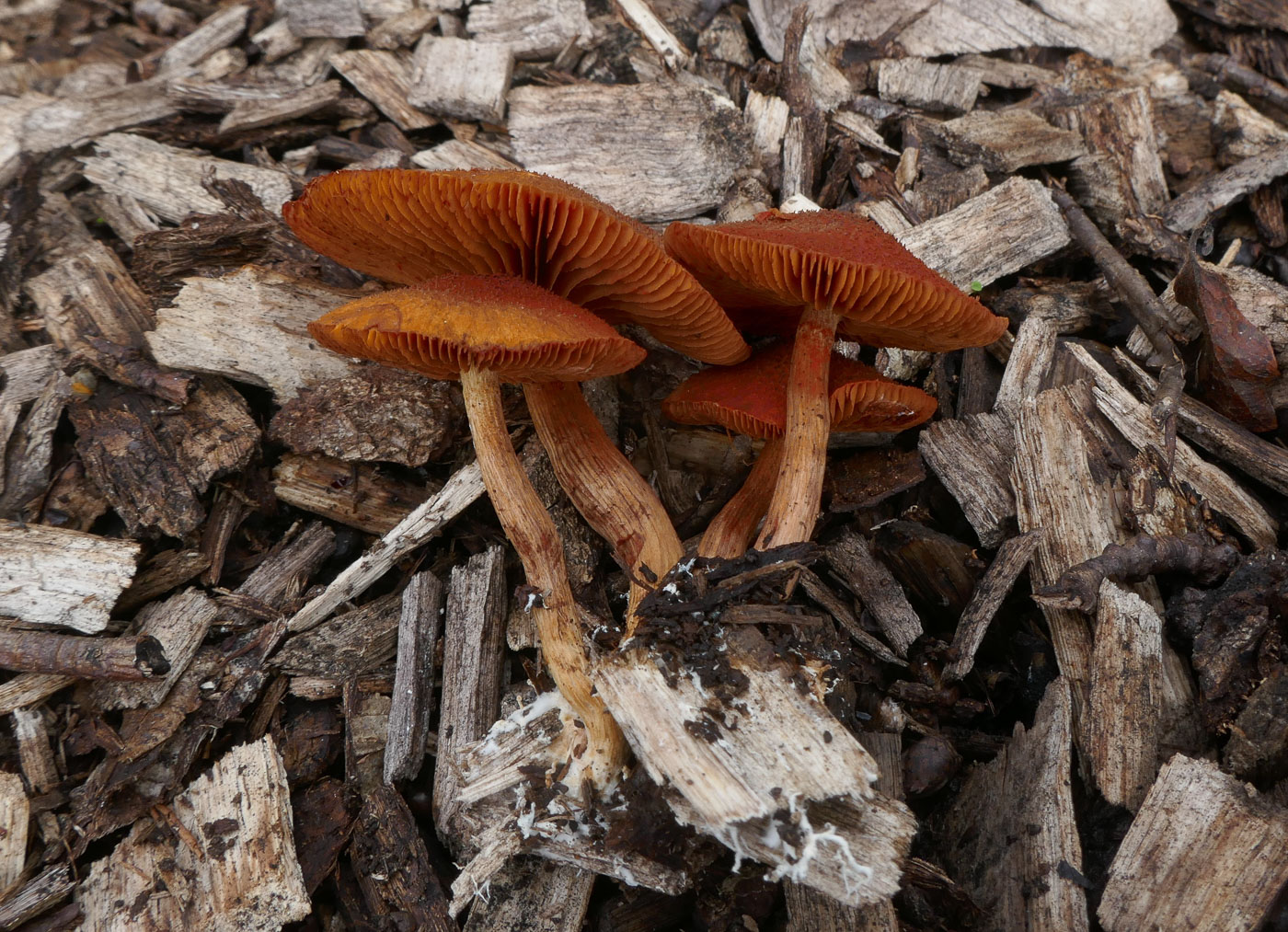
 |
September11th Gymnopilus dilepis (Magenta Rustgill) In a large pile of well rotted woodchip at Stampwell Farm Jackie Ewan watched good numbers of this species developing over a few days and eventually realised what the species must be. This is an unusual Rustgill which first made an appearance in the UK in 1995, probably introduced on some imported woodchip, and by the time we first found it in Bucks (at Stoke Common) in 2010 there were about 30 UK records, all from the south of England. Though still uncommon, when it fruits it seems to appear in large numbers as seen here, and this was also the case at Stoke Common and at our only other site when found in Naphill Common in 2022. This is a distinctive species with an unusual magenta cap colour (not unlike that of Tricholomopsis rutilans - Plums and Custard) when it first appears though it becomes mush rustier as it matures. Usually recorded on conifer woodchip, Jackie reports that it was on the chips of a mix of different deciduous woods here. Previous finds |
September 10th 2024
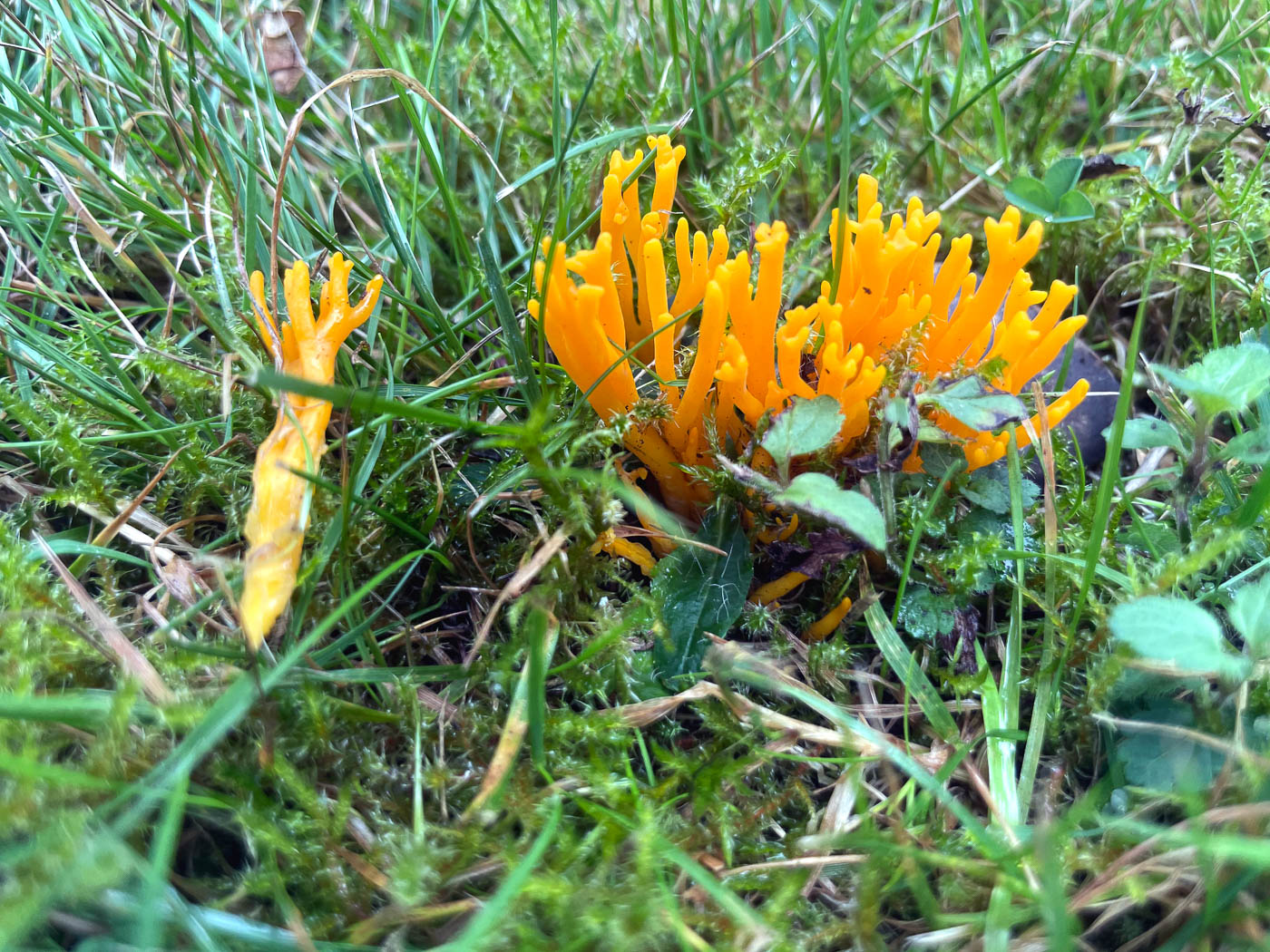 |
September 10th Clavulinopsis corniculata (Meadow Coral) In Lacey Green churchyard Sarah Ebdon found this coral growing in shortish grass. It is usually possible to name this one in the field owing to its branching clustered habit and small size compared to other similar yellow species which are either individual clubs or if clustered then not branching in this way. Previous finds |
September 9th 2024
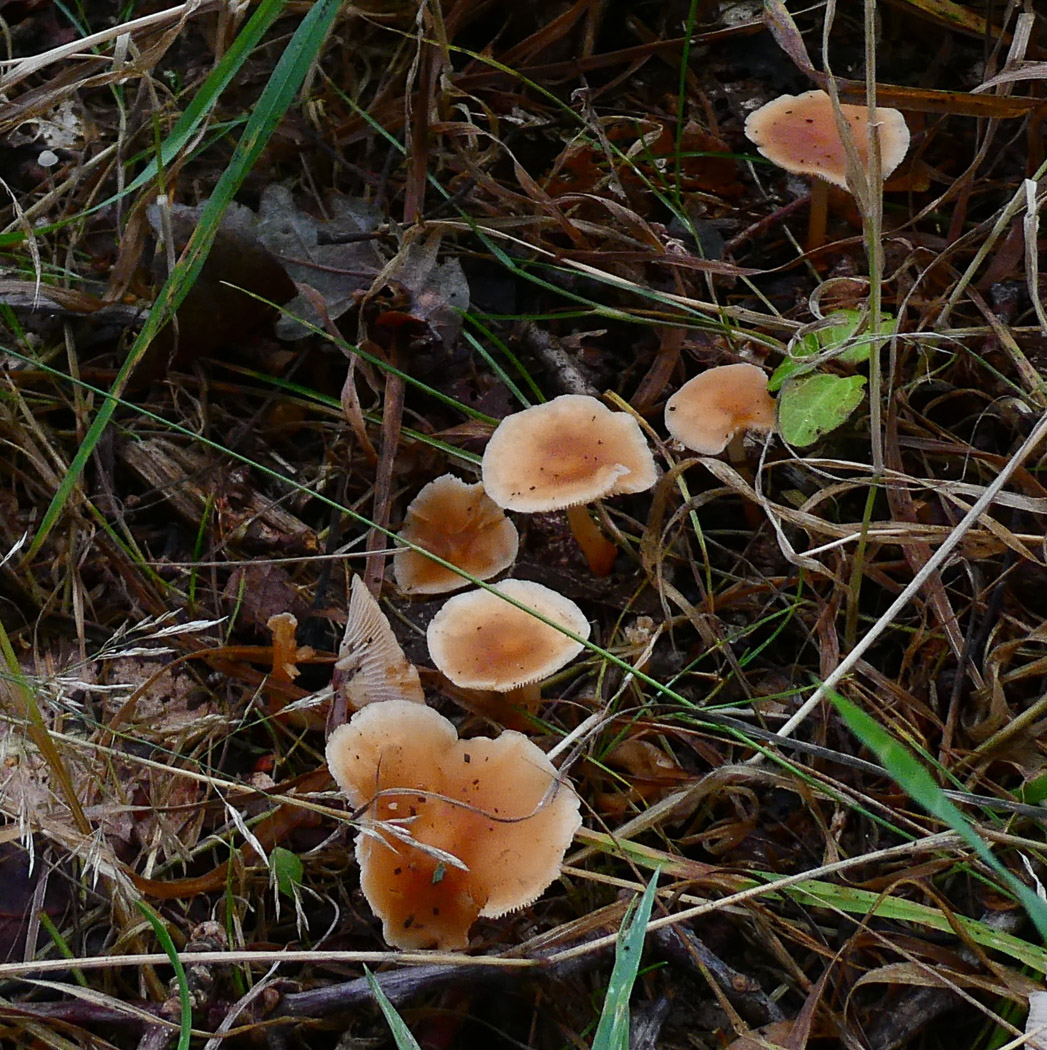
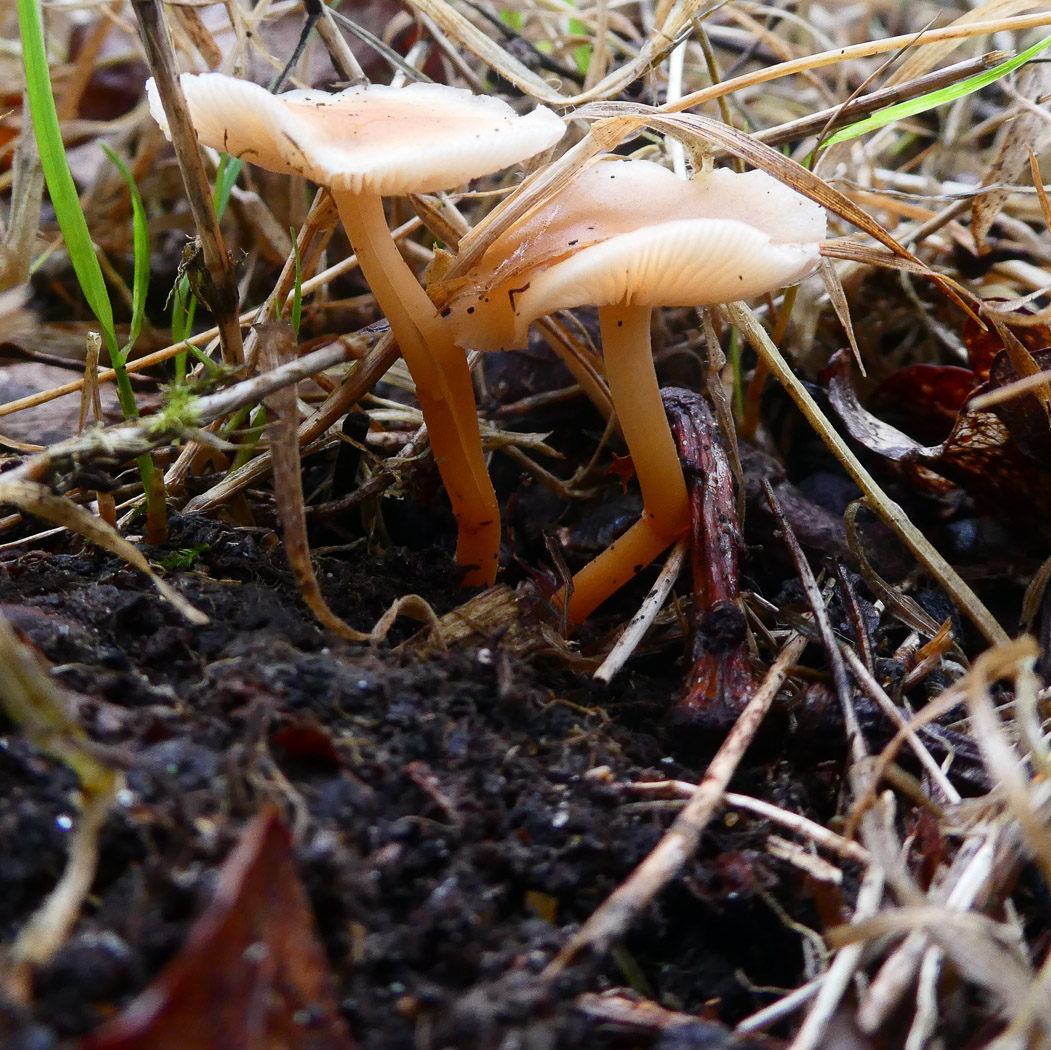
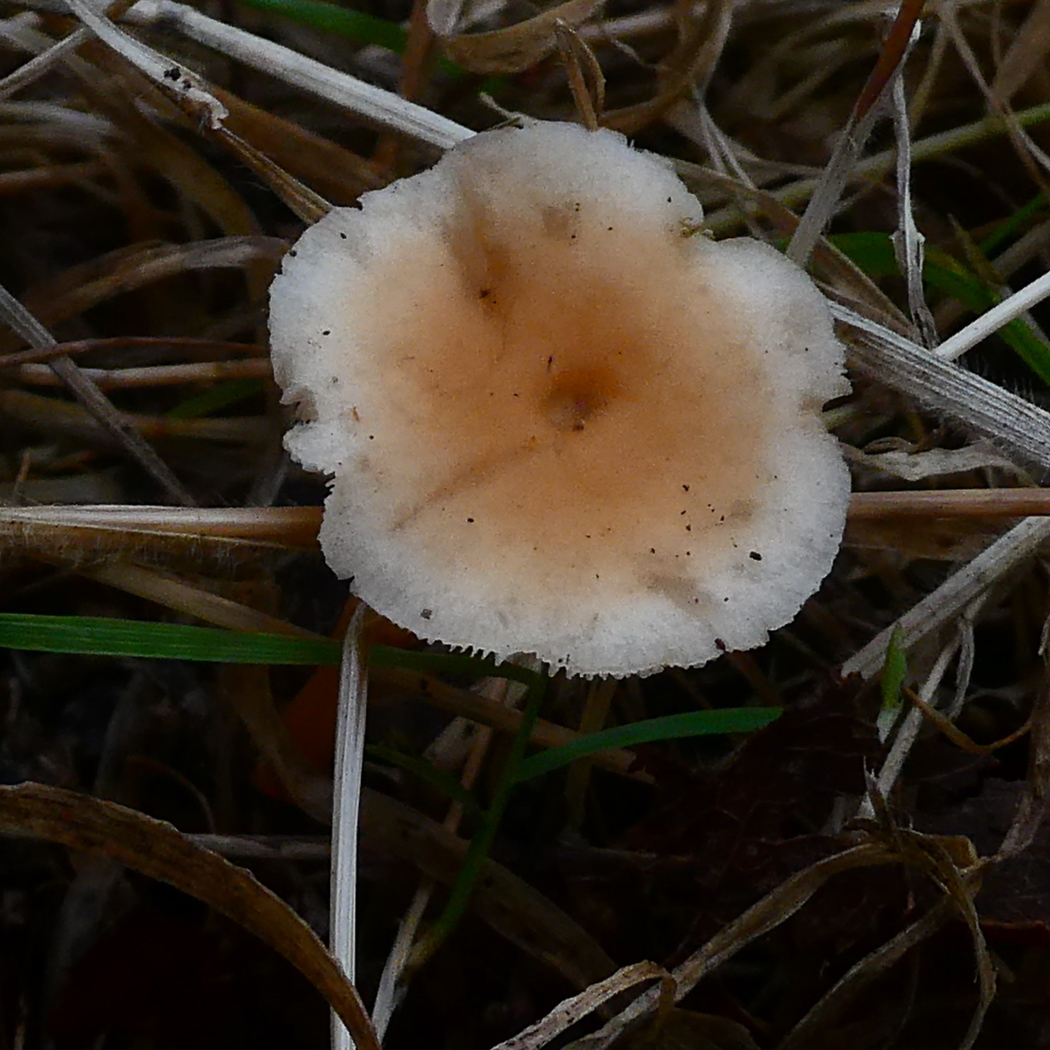
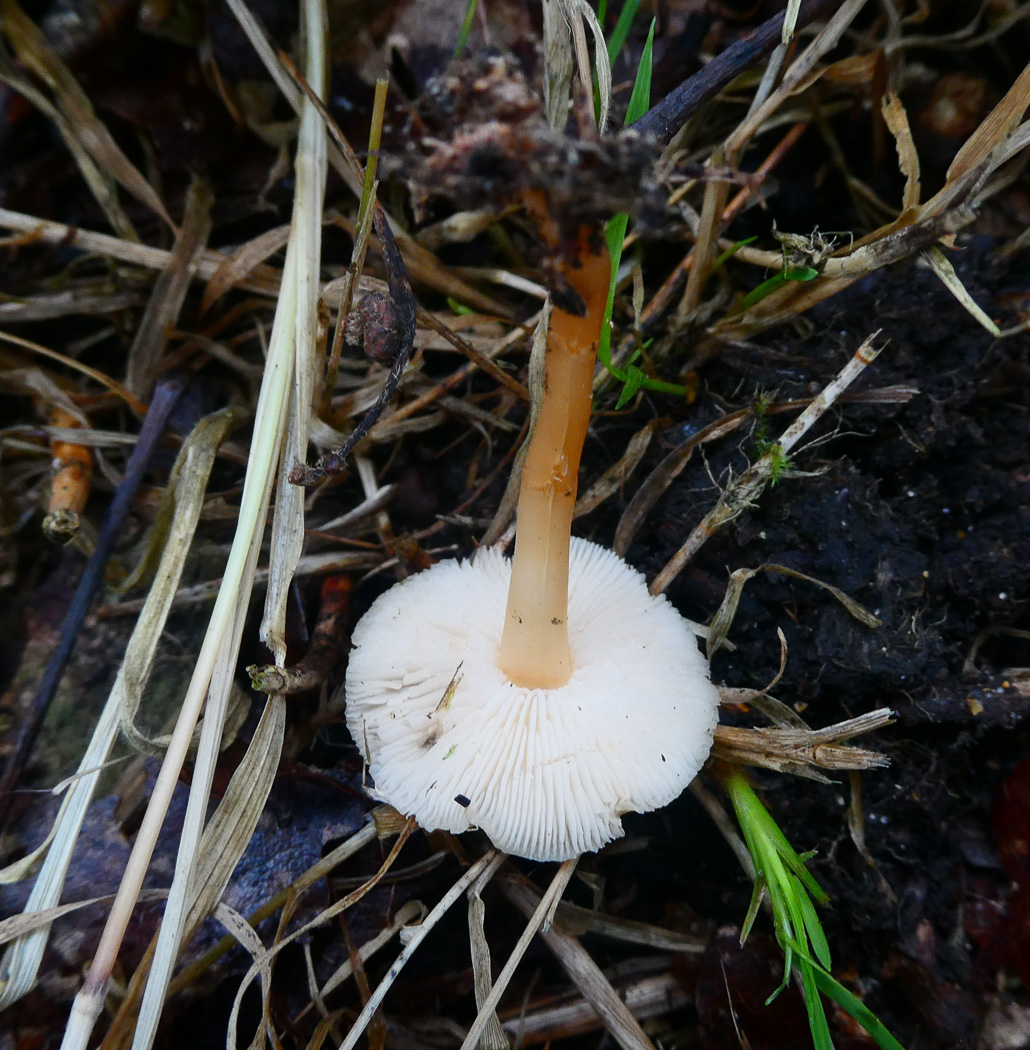 |
September 9th Gymnopus dryophilus (Russet Toughshank) In Austenwood Common Jim Wills came across this group in Oak litter, recognised the genus and whittled it down to either G. dryophilus or G. erythropus (Redleg Toughshank). When the caps are faded these two can look quite similar superficially but the stem features are quite different, the latter having a distinctly red stem (not at all orange) which is shiny and smooth as opposed to the more or less concolorous stem of G. dryophilus though it can become quite faded like the cap too. G. dryophilus is one of our commonest mushrooms in woodlandglades. Previous finds |
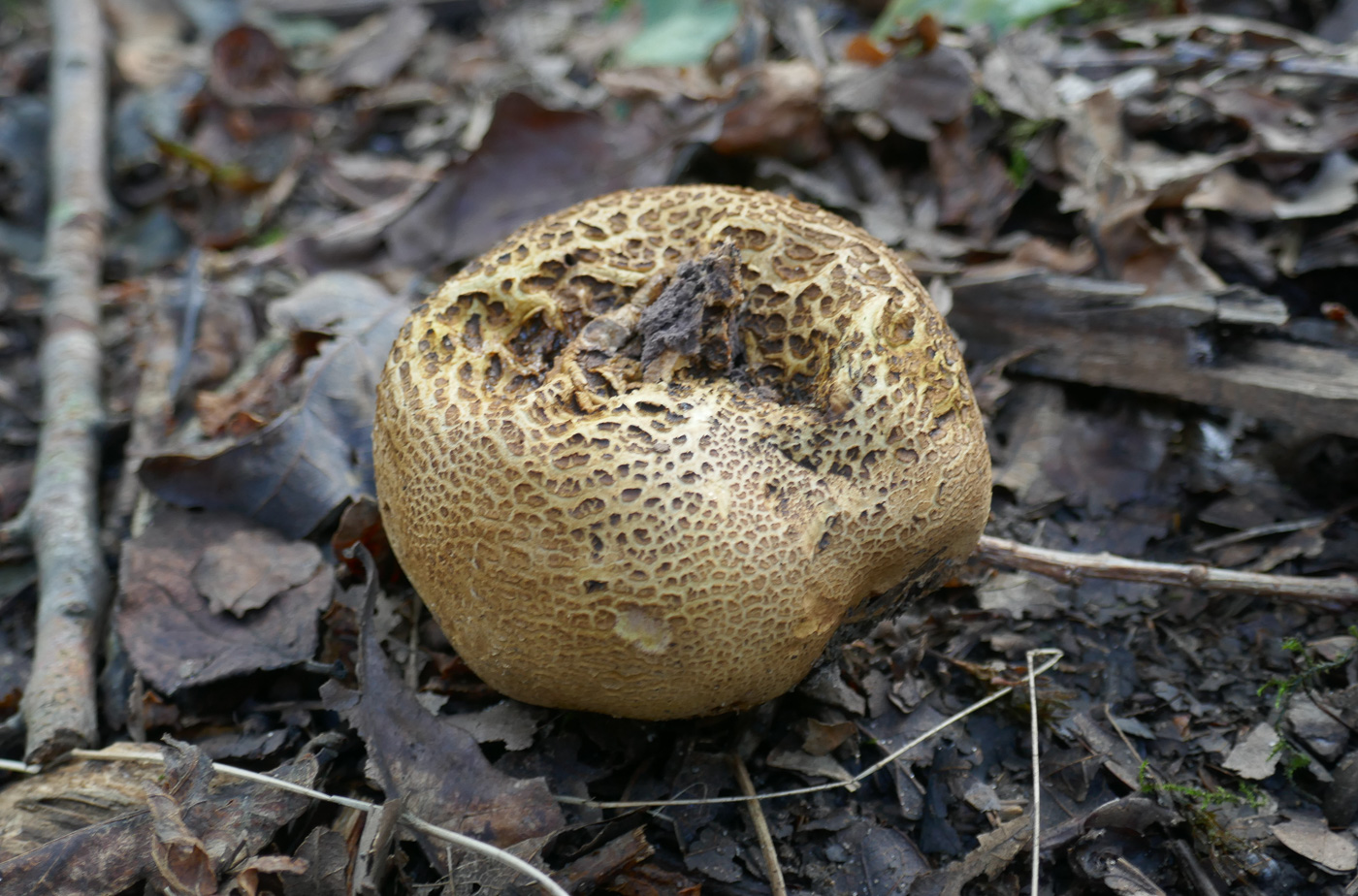
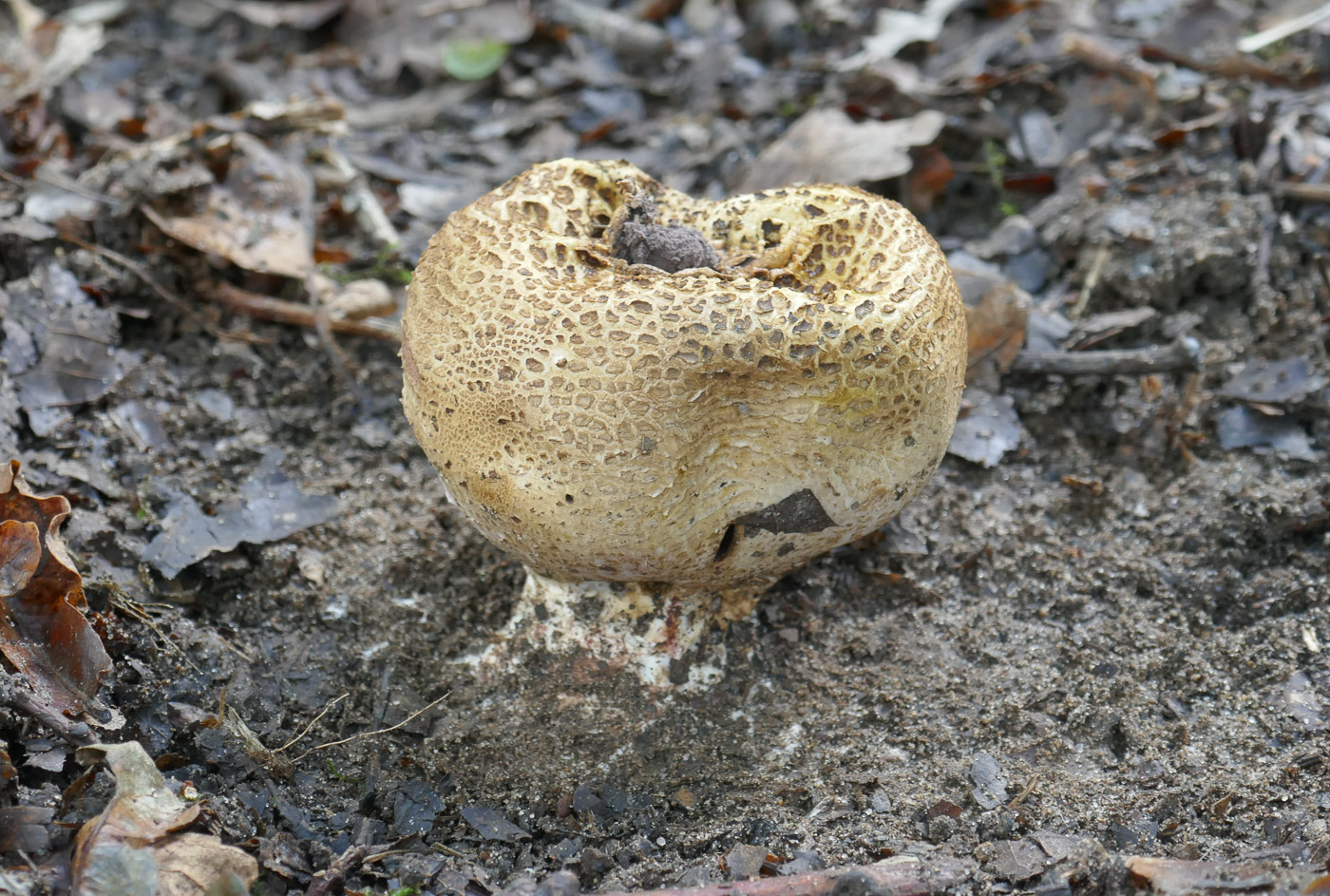
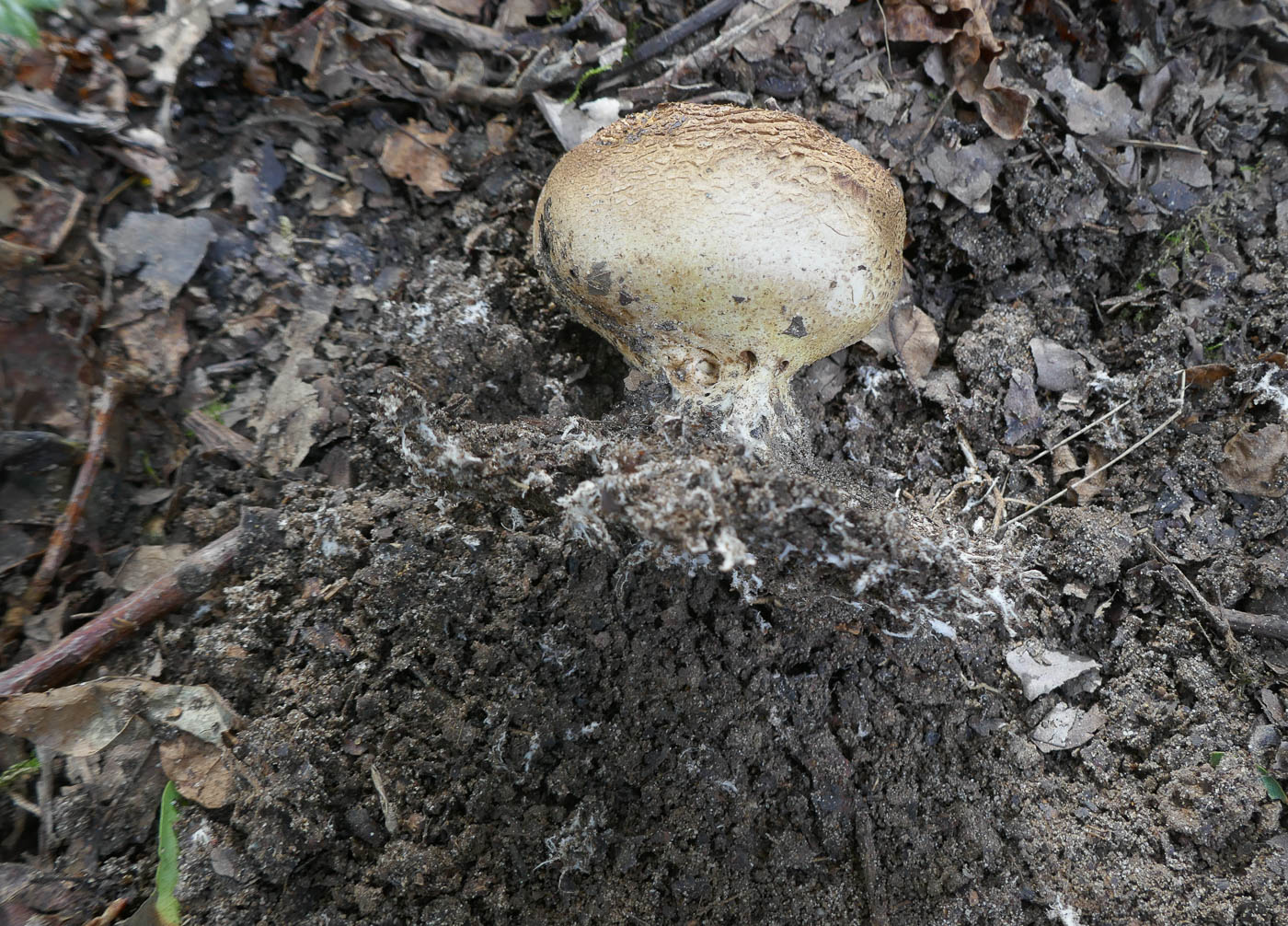 |
September 9th Scleroderma verrucosum (Scaly Earthball) At Stampwell Farm Jackie Ewan reports a few things beginning to appear now. This is one of them, though both Jackie and Penny initially mistook this Earthball for S. citrinum owing to its dirty yellowish appearance. However, a few days later when it had developed a distinct stem and aged a bit (see photo 3) Jackie realised it was not that species but in fact S. verrucosum! It just goes to show how easy it is make make incorrect assumptions even over common species ....... Previous finds |
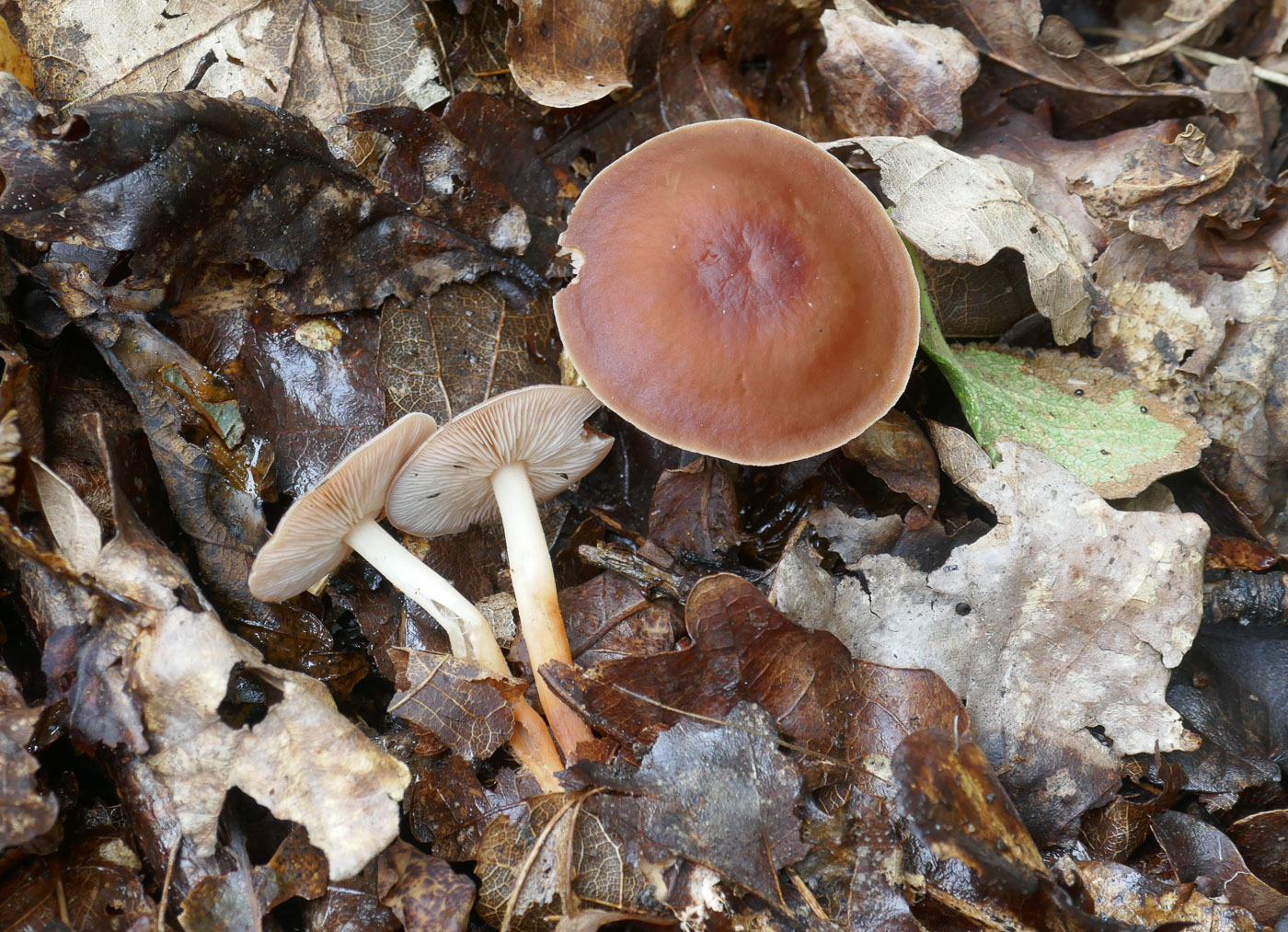 |
September 9th Gymnopus ocior (Spring Toughshank) This is another early season regular fruiter at Stampwell Farm, found by Jackie. We've had a couple of collections confirmed with sequencing because it is easy to confuse with the much more common G. dryophilus (Russet Toughshank) which despite its English name is usually less conspicuously russet than G. ocior! Previous finds |
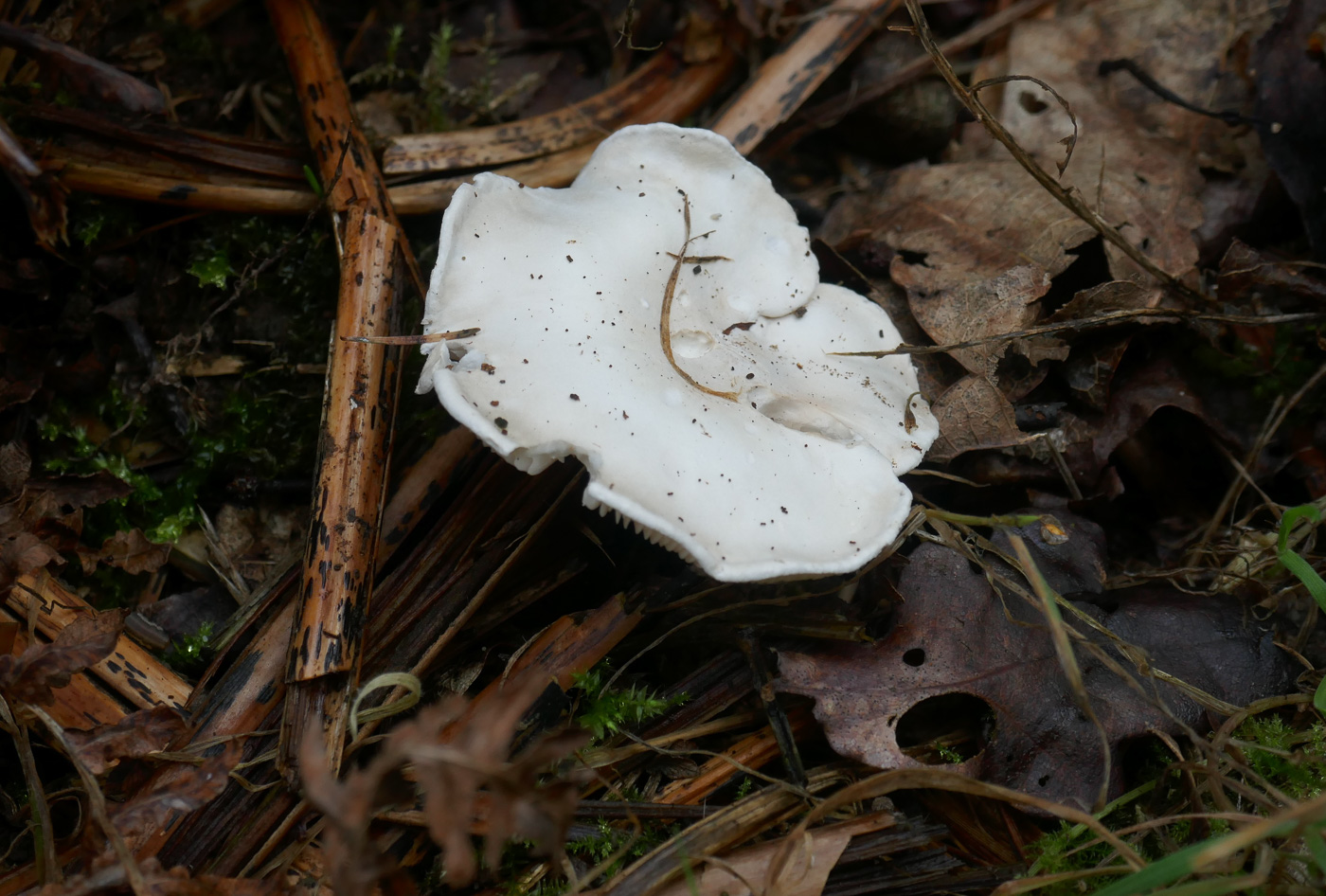
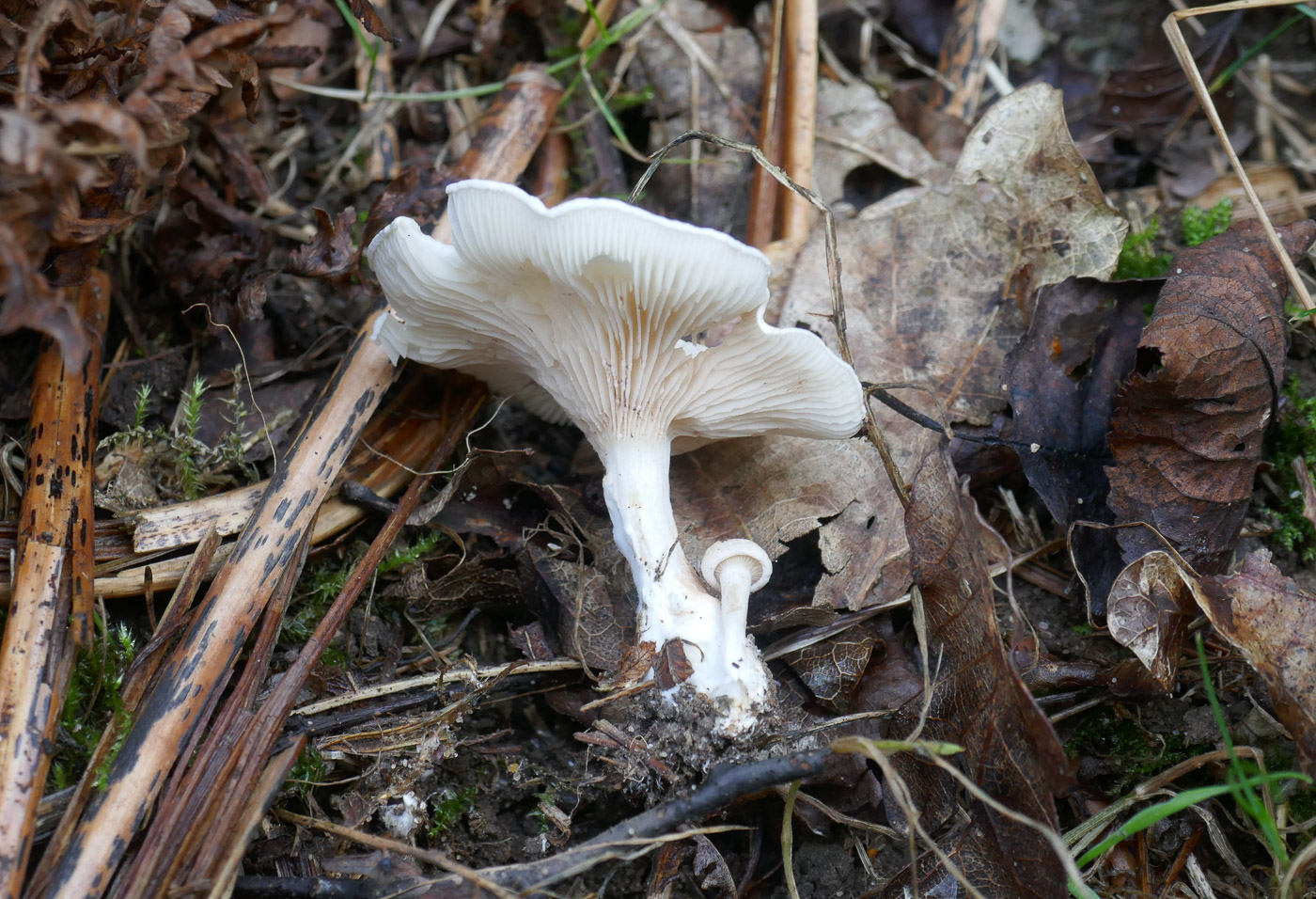 |
September 9th Clitopilus prunulus (The Miller) At Stampwell Farm this species is a regular early season mushroom coming up in grassland and grassy pathsides. It has a mealy smell (of rancid flour) and decurrent gills which turn pink as they mature. Previous finds |

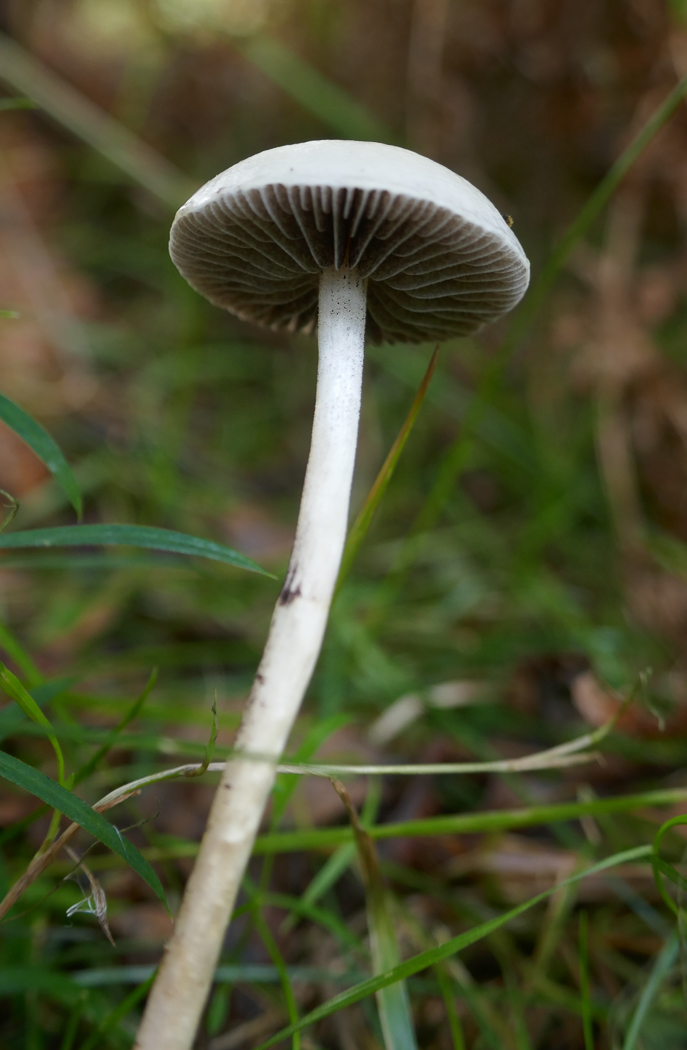 |
September 9th Protostropharia semiglobata (Dung Roundhead) At Stampwell Farm Jackie Ewan noticed this singleton on some dung. This common grazed grassland species was previously in genus Stropharia though at least its English name remains constant to lesson the confusion when this happens. Previous finds |
September 8th 2024

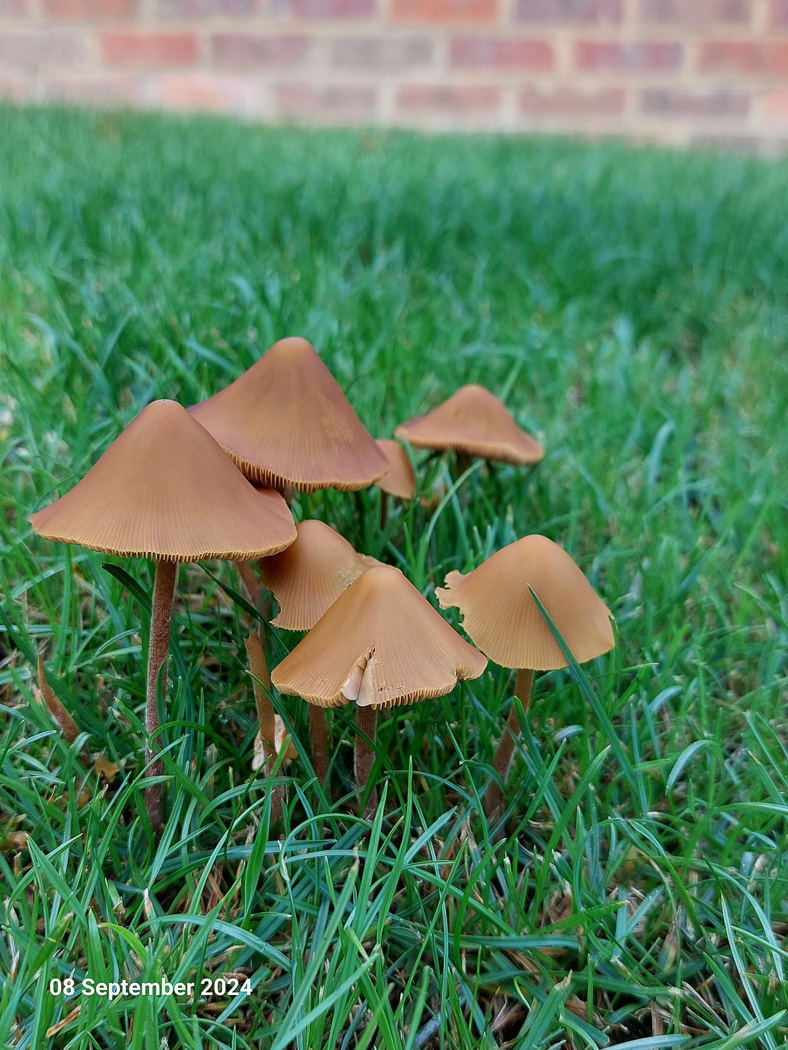 |
September 8th Conocybe aurea (a rare Conecap with no English name) In Gerrards Cross in a patch of recently laid turf Jesper Launder noticed good numbers of this LBJ coming up. He took a sample home to work on and keyed it out very convincingly to this species for which there appear to be extremely few UK records. For this reason we sent a sample for sequencing with the result that Jesper's ID has now been confirmed. This is new to the county with only 9 FRDBI records, and is also a new entry for Finds. |
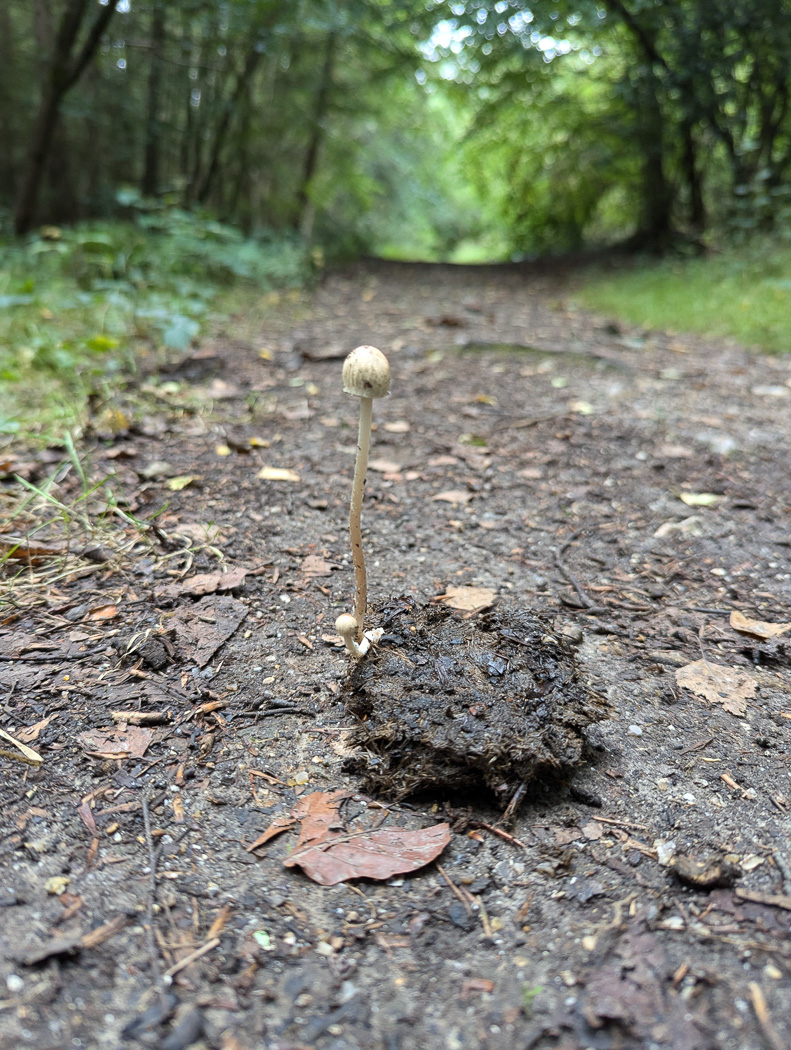
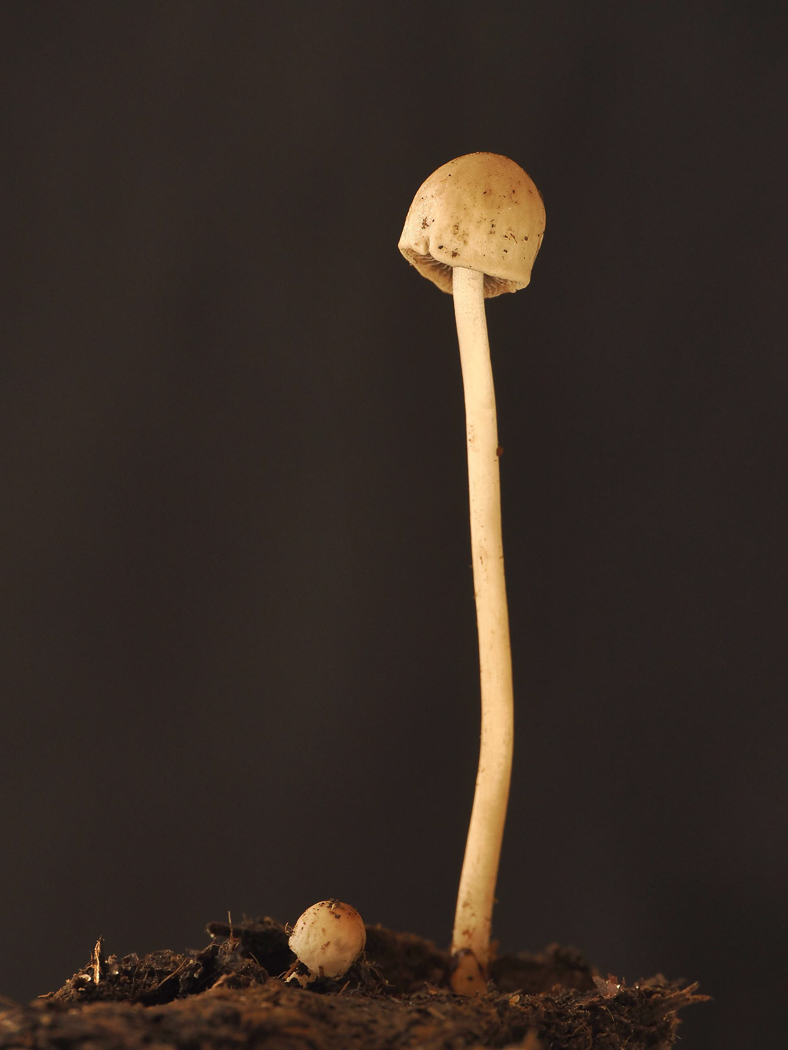 |
September 8th Panaeolus semiovatus (Egghead Mottlegill) Whilst biking in Bradenham Wood Claire Williams nearly went over this piece of dung but happened to notice the fungi growing out of it as she rode past! Stopping to take a closer look, she noted the slimy stem which had just faint signs of ring remnants (hardly visible here) together with the typical campanulate cap and although the gills were still somewhat pale for this dark-sored genus she correctly identified the species which is not uncommon but always on dung or remains of dung. Often after heavy rain species normally seen with a ring on the stem when young will lose it, causing confusion when it is missing. Previous finds |
September 7th 2024
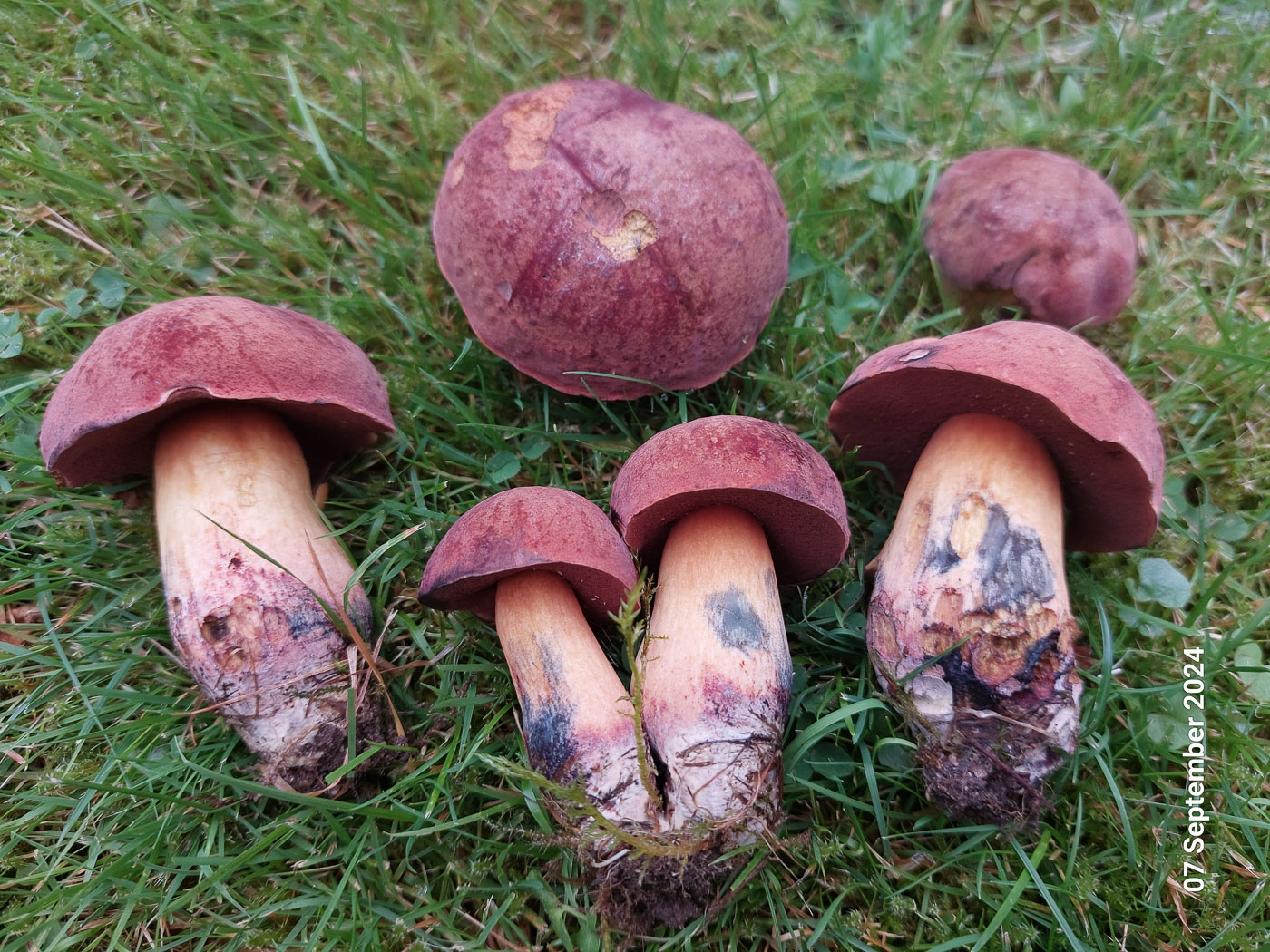 |
September 7th Suillellus queletii (Deceiving Bolete) In Little Chalfont Jesper launder came across about 20 fruitbodies of this impressive mushroom under deciduous trees a sure sign that the autumn season is at last on its way. This species appears to be becoming more common in our area though it may be that we are now more skilled at recognising it from the other similar lookalikes with reddish pores and blueing flesh. The tapering almost rooting stem base which shows beetroot red flesh are the pointers to distinguish it. Previous finds |
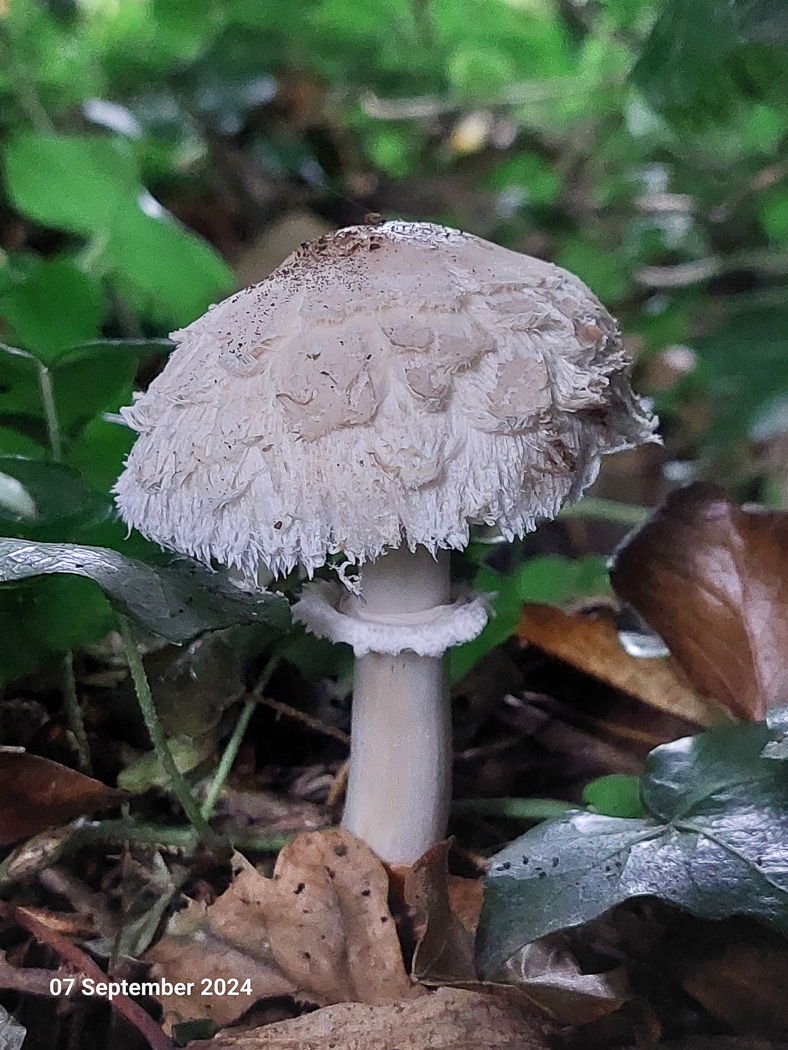 |
September 7th Chlorophyllum rhacodes (Shaggy Parasol) Near Chalfont St Peter Jesper Launder spotted this Parasol just visible above the vegetation in a roadside verge. The white stem with lack of any brown snakeskin markings confirmed it as this species rather than the true Parasol - compare with the Parasol entry two days earlier. Previous finds |
September 6th 2024
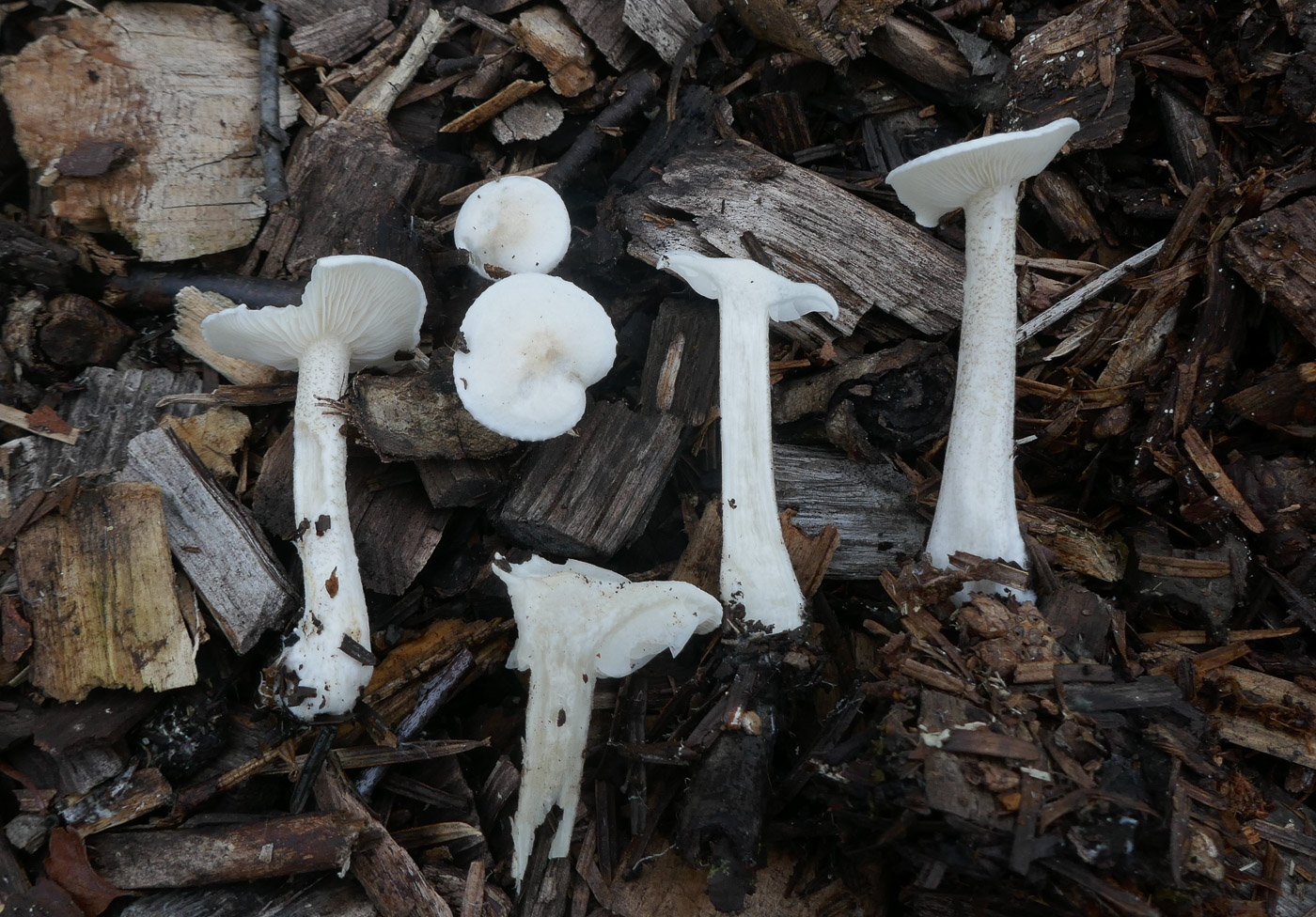 |
September 6th Melanoleuca verrucipes (Warty Cavalier) In some woodchip at Stampwell Farm Jackie Ewan was initially stumped by this cluster of an unusual white mushroom and emailed Penny for suggetions. As soon as she mentioned the presence of black scaly markings as in the genus Leccinum on the white stem, Penny was able to point her in the right direction. This is a common feature in Leccinum, helping to separate it from other Bolete genera, but is very unusual in any other genera and notably a good way of distinguishing this particular member of an otherwise rather nondescript genus. We have just three other county sites where it's been found, one of them earlier this year in Stoke Common - not far from Stampwell Farm as the kite flies. Previous finds |
September 5th 2024
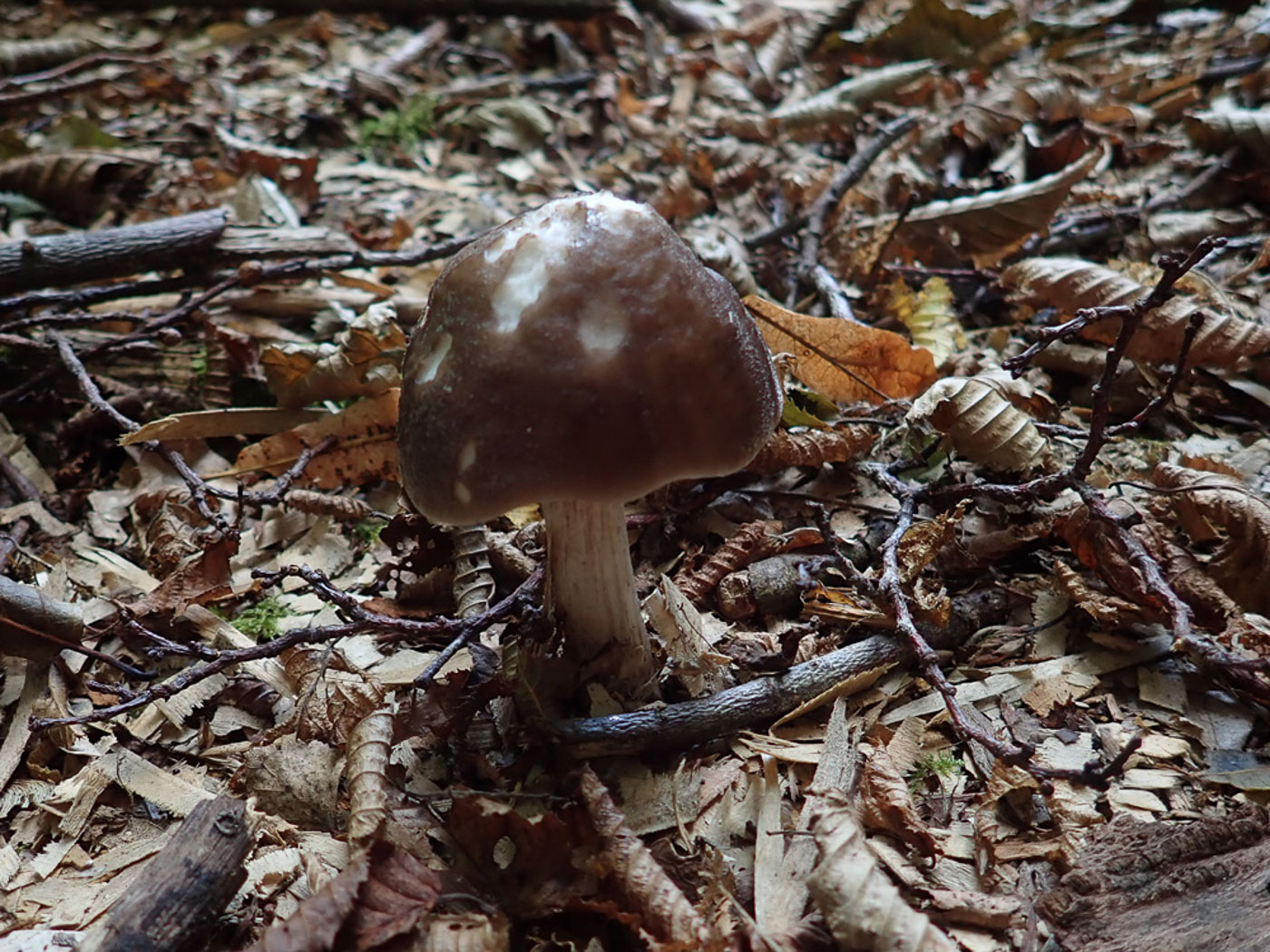
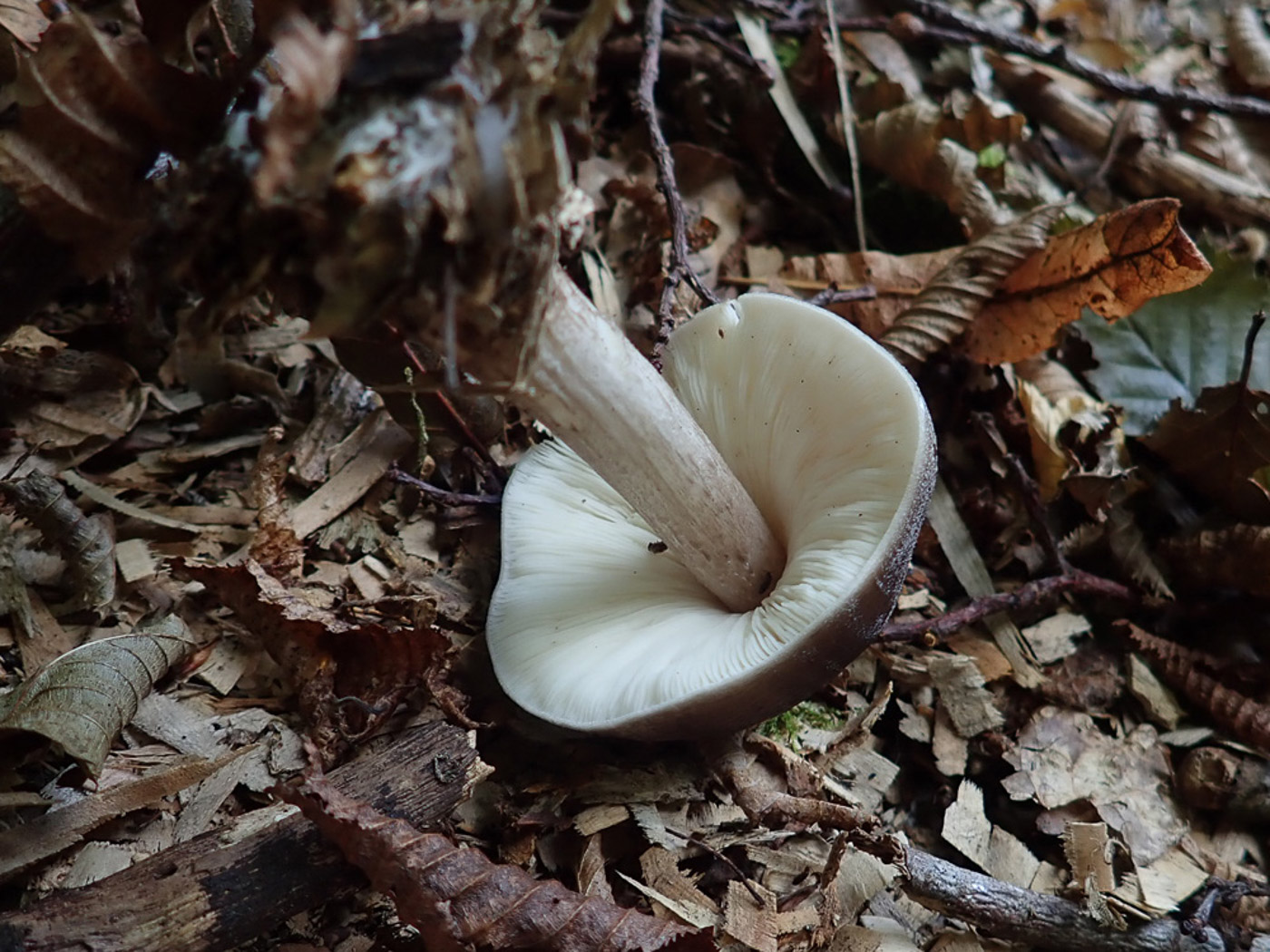
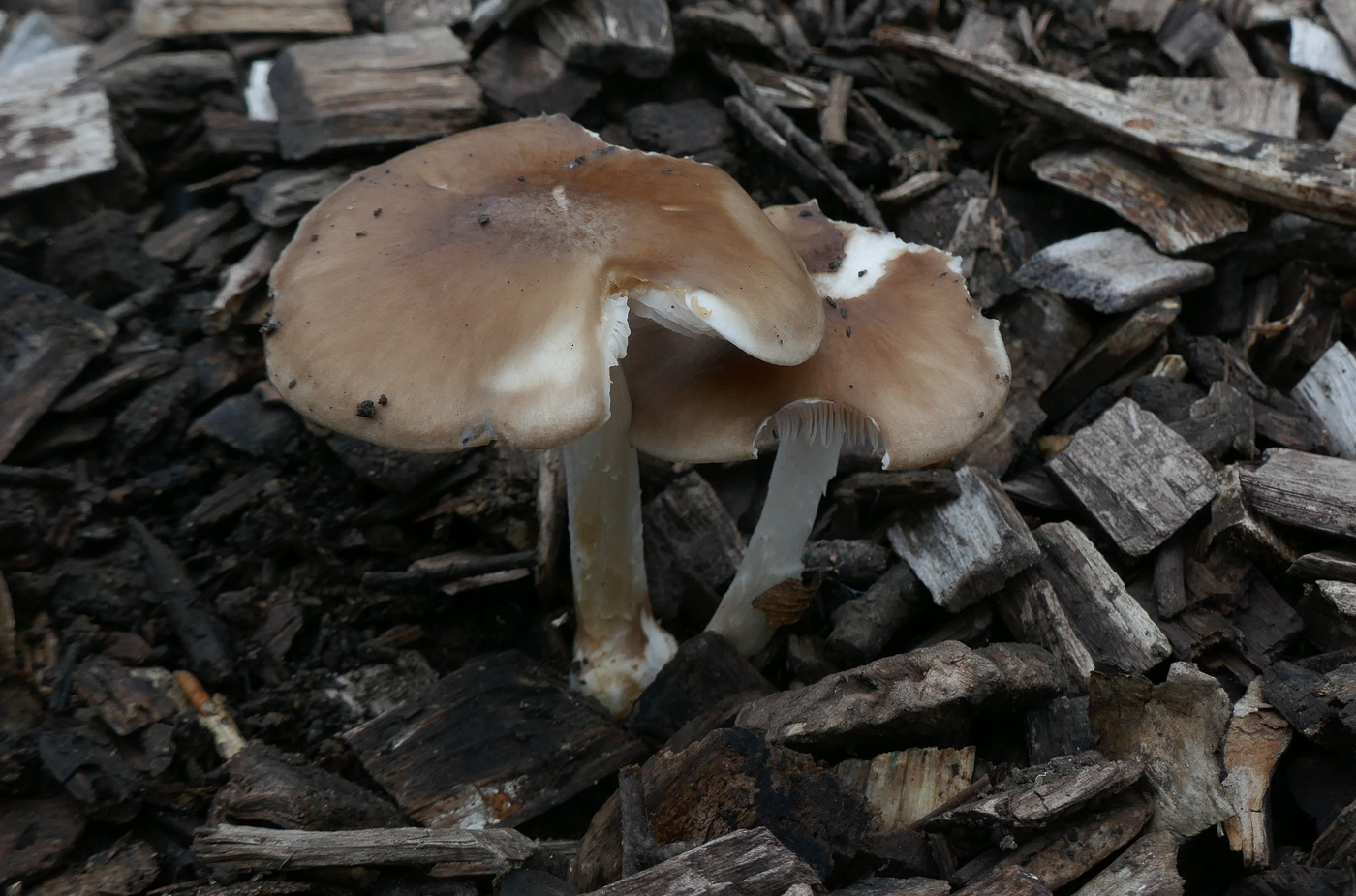
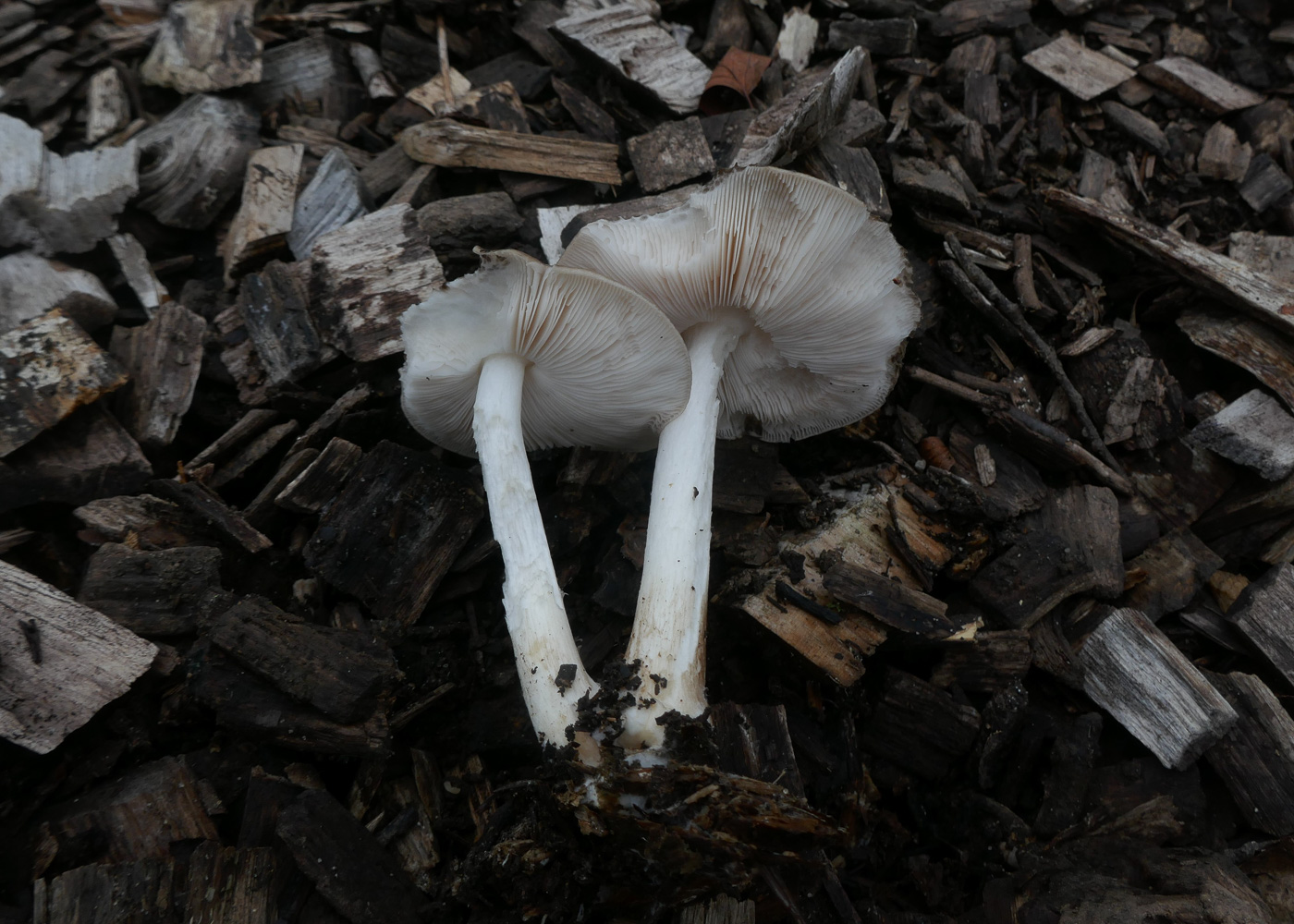 |
September 5th Pluteus cervinus (Deer Shield) On woodchip at Turville Heath Penny found this nibbled singleton and confirmed her ID turning it over to see the free gills which were, however, still white rather than pink (though they were suitably pink by the next morning). The next day she received Jackie Ewan's photos of the same species also found on woodchip at Stampwell Farm. Note the different shades of brown between the two collections - this common species is quite variable and can be surprisingly dark brown and though often on fallen branches is just as happy in deciduous woodchip where it is often much bigger than when on wood. Previous finds |
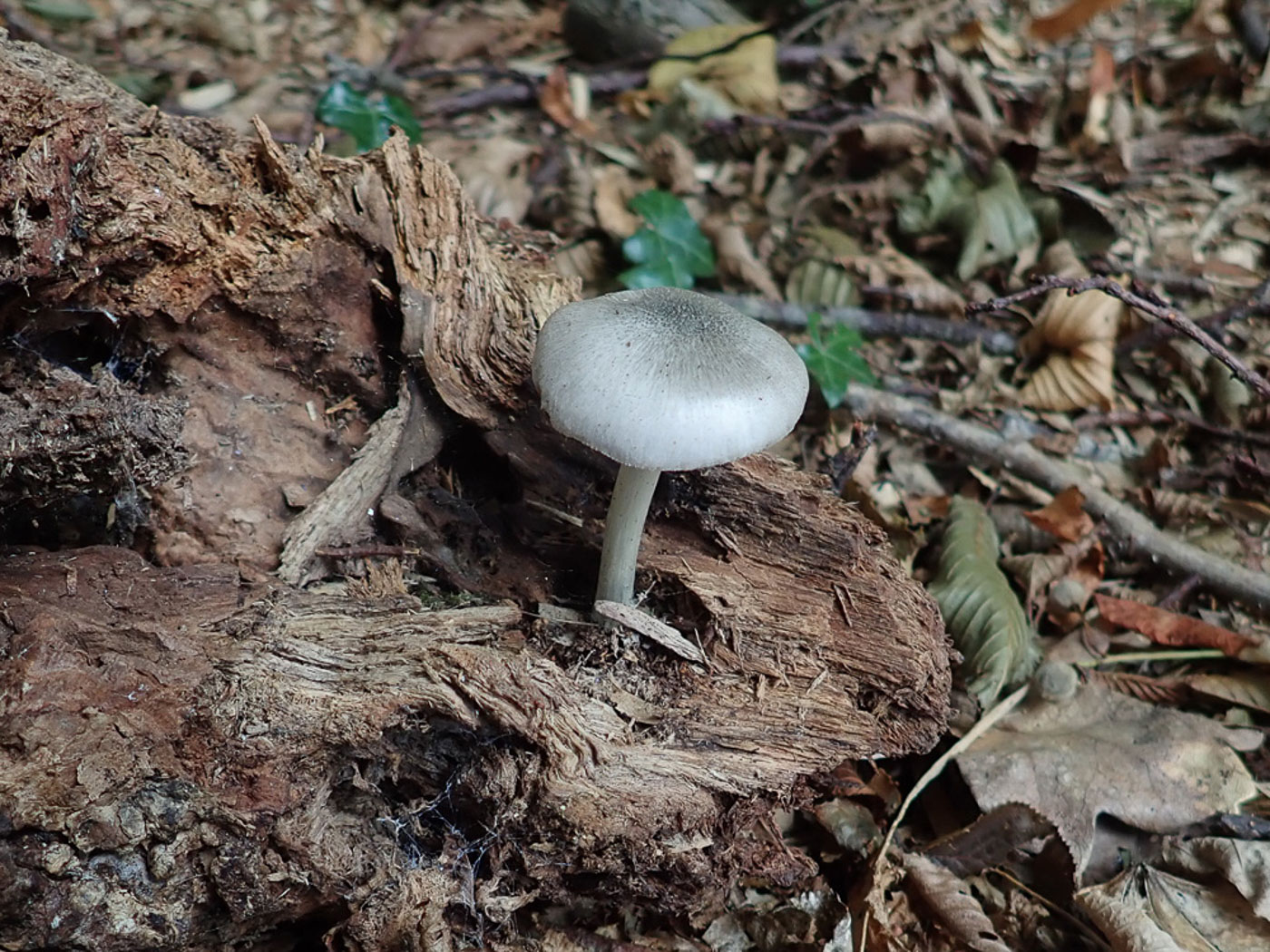
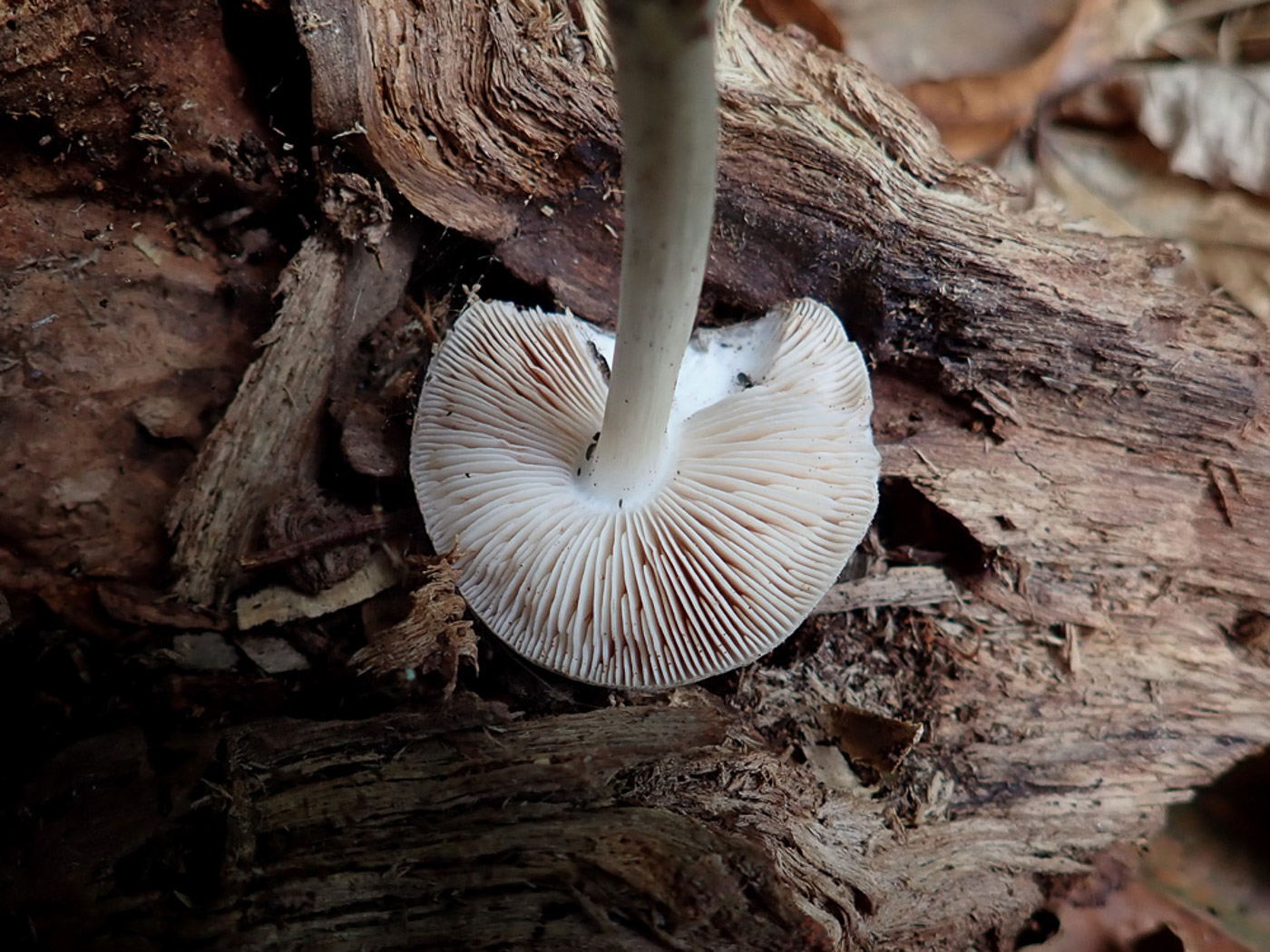 |
September 5th Pluteus salicinus (Willow Shield) On a chunk of bare wood from a large fallen Lime at Turville Heath Penny spotted this singleton Pluteus, recognising the species from the grey cap with no hint of brown as in P. cervinus. Turning it over the gills were suitably free and turning pink, confirming the genus. The species is not rare though much less common that P. cervinus, also usually smaller than that species. It is just as likely to be found on deciduous woods other than Willow despite its misleading English name. Previous finds |
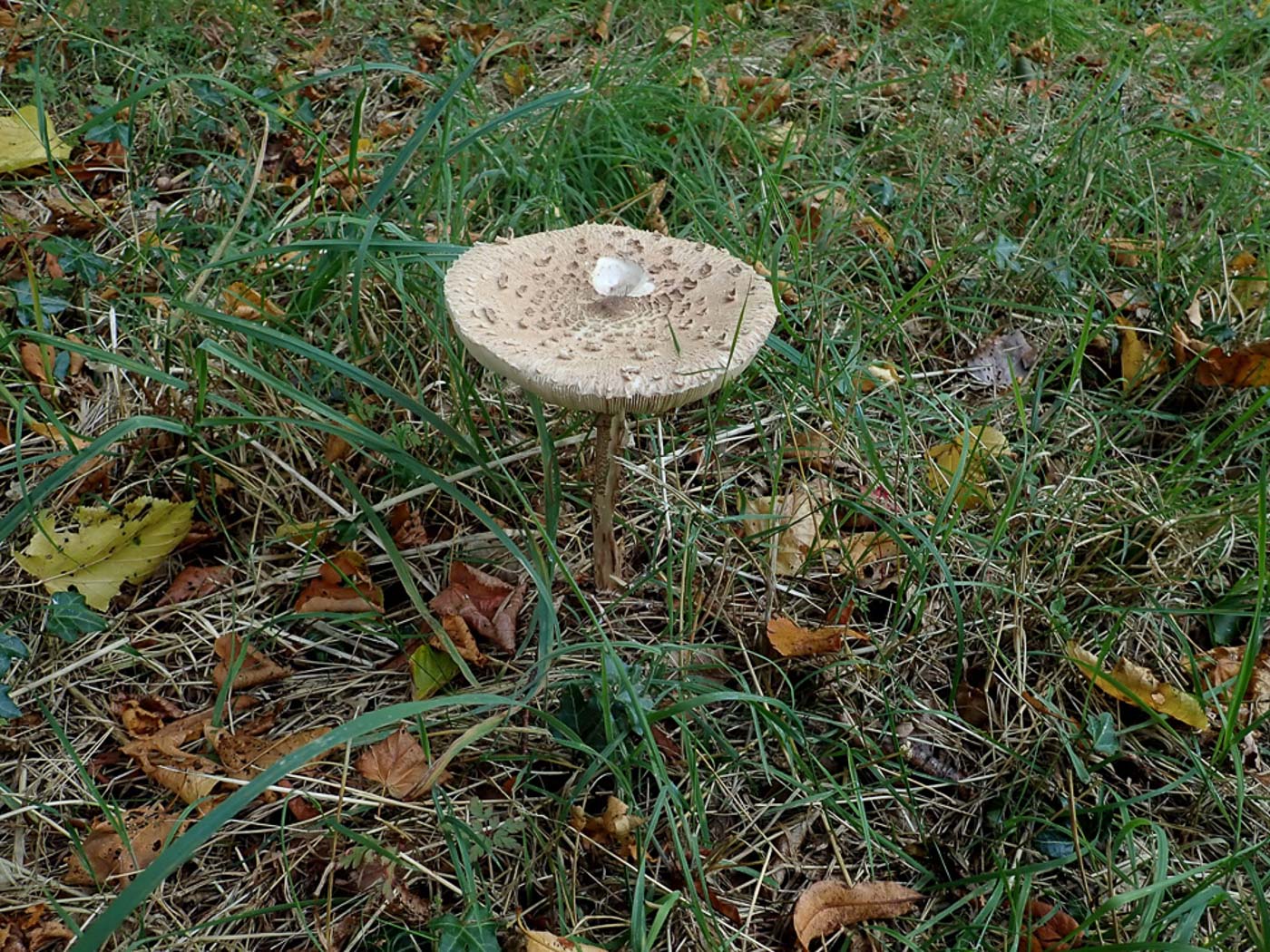
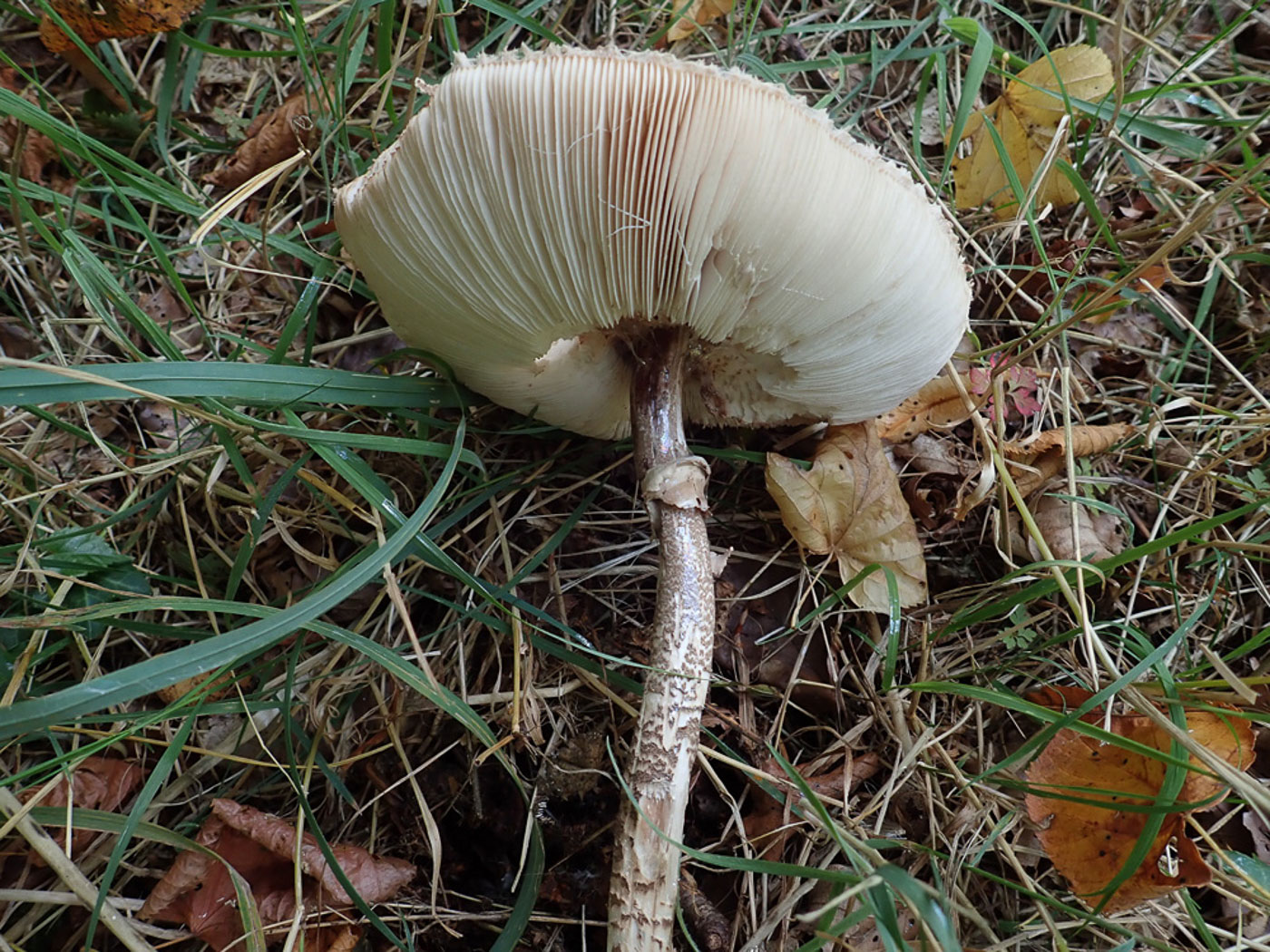
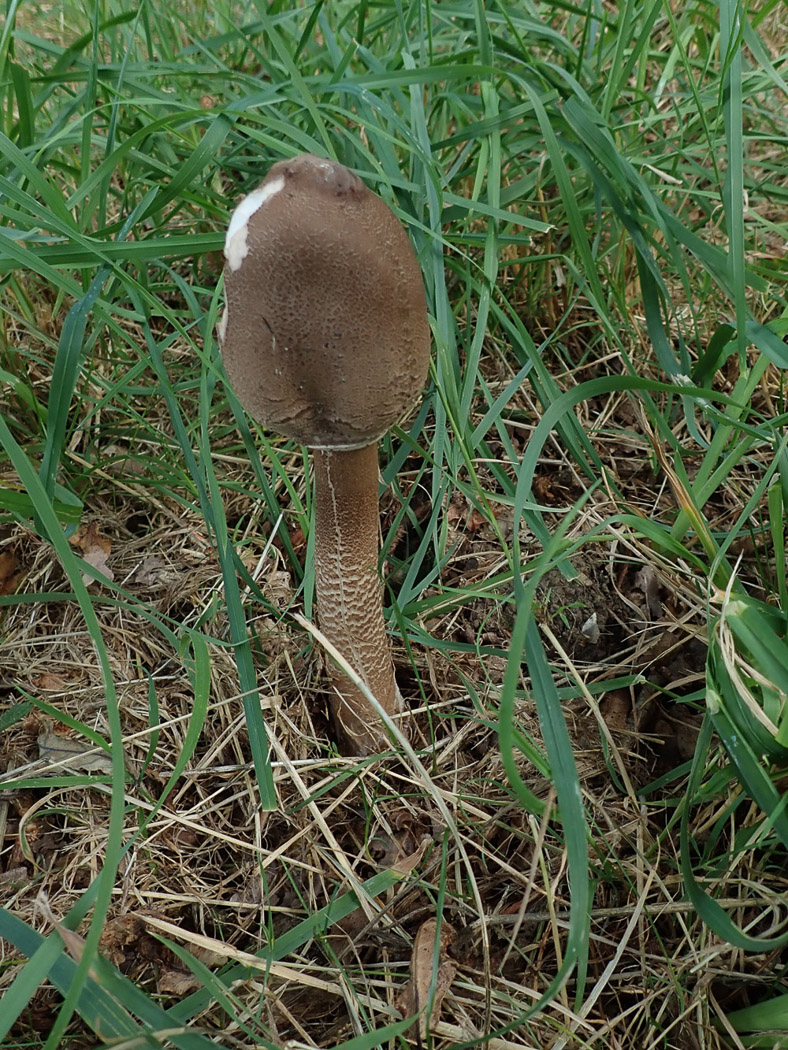 |
September 5th Macrolepiota konradii (a Parasol with no English name) At Turville Heath Penny was not surprised to come across several examples of this species which seems to be very common here in the grassy undergrowth under both Birch and Oak. The brown snakeskin stem markings (photos 2 and 3) instantly eliminate the very similar genus Chlorophyllum, though deciding whether this was M. procera (Parasol) or even M. mastoidea (Slender Parasol) can be tricky. The cap scales (photo 1) are clearly not abundant enough for M. procera in Penny's opinion therefore pointing to M. konradii, but this species is regularly synonymised with M. mastoidea which however has a prominant central nipple (not seen here). Despite no separation between these two species appears to be confirmed with sequencing as yet, Penny is still of the opinion that there is a distinct difference in jizz (general appearance) between the two! Time will tell. Previous finds |
September 3rd 2024
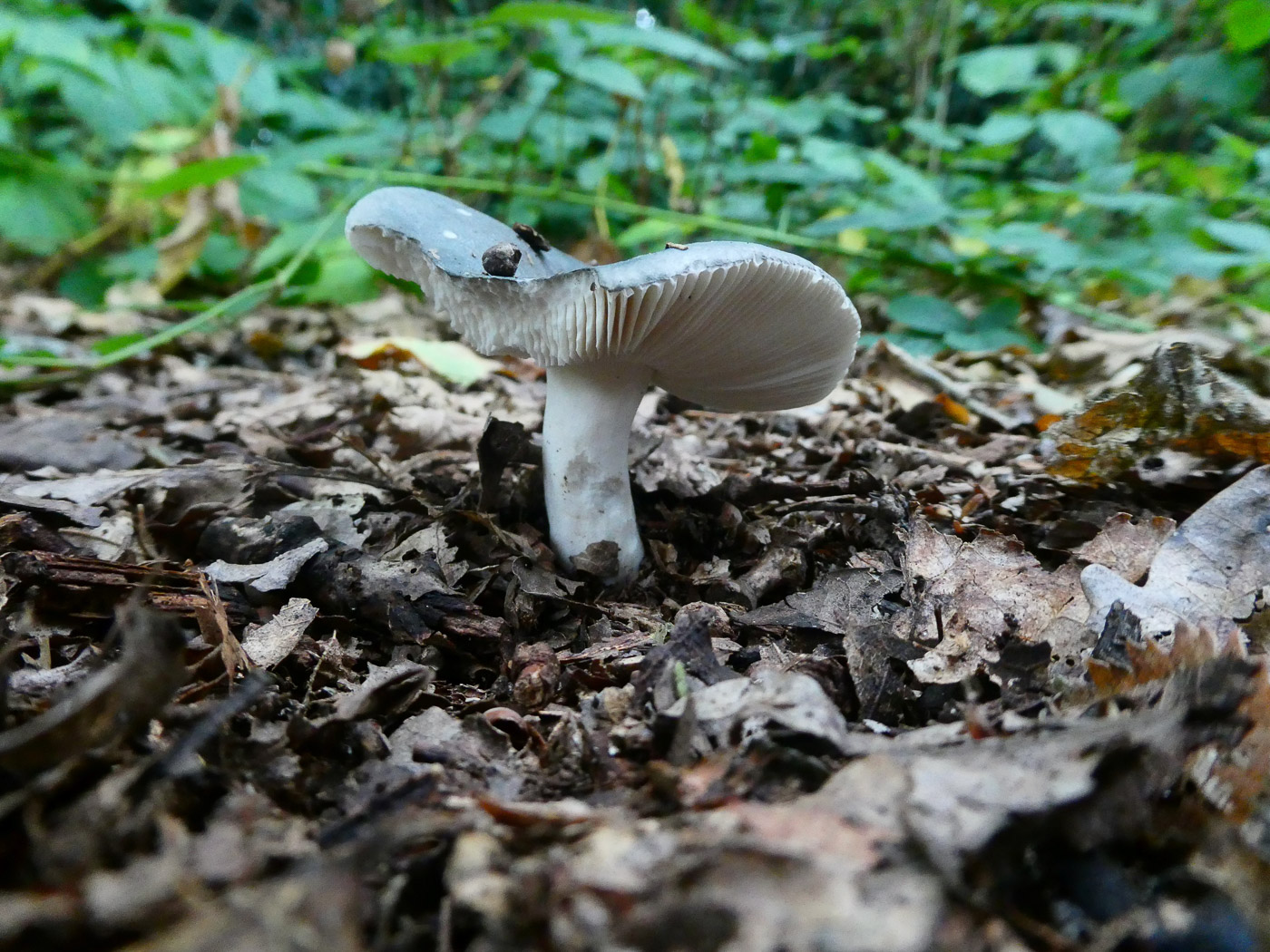
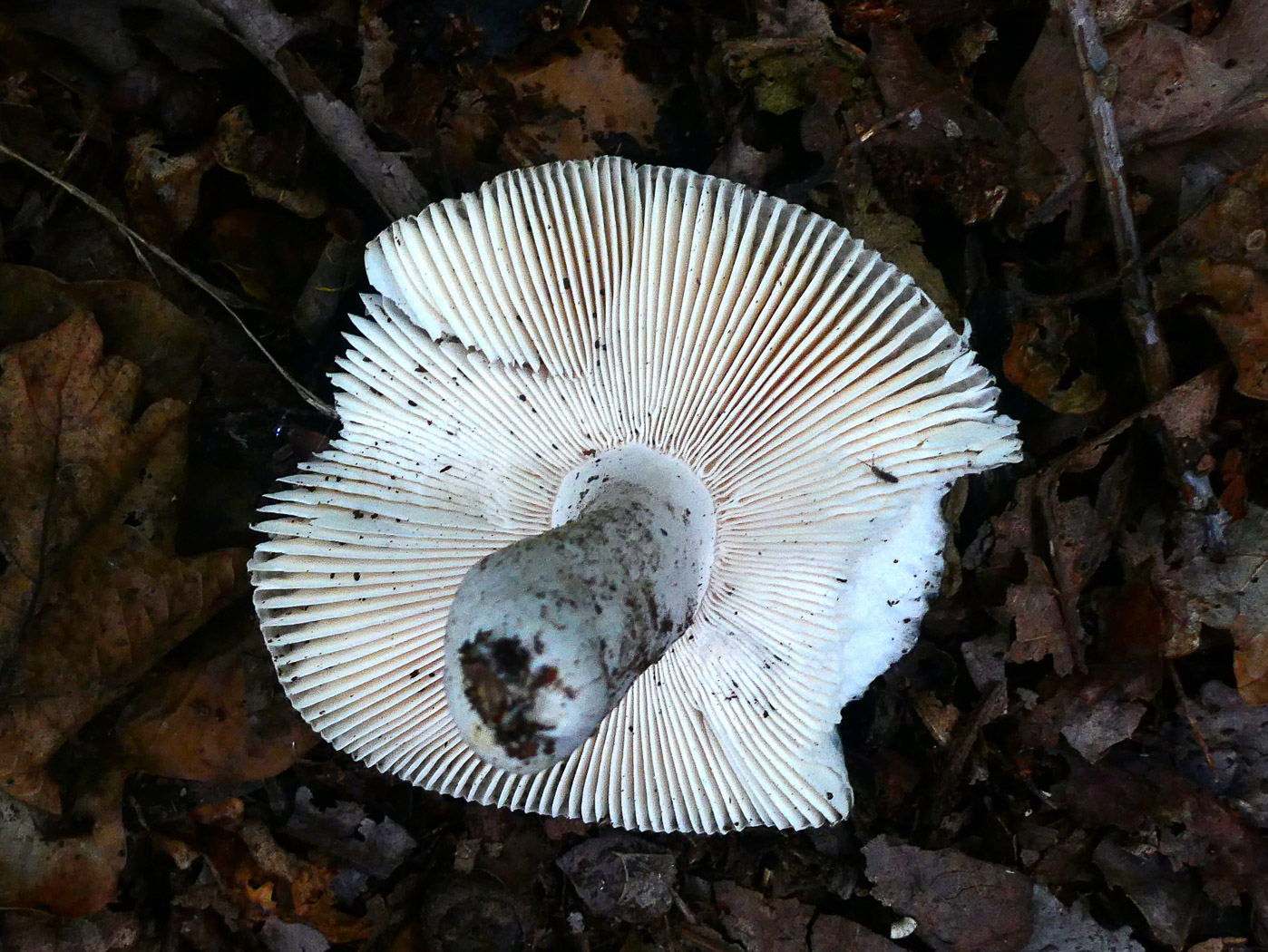
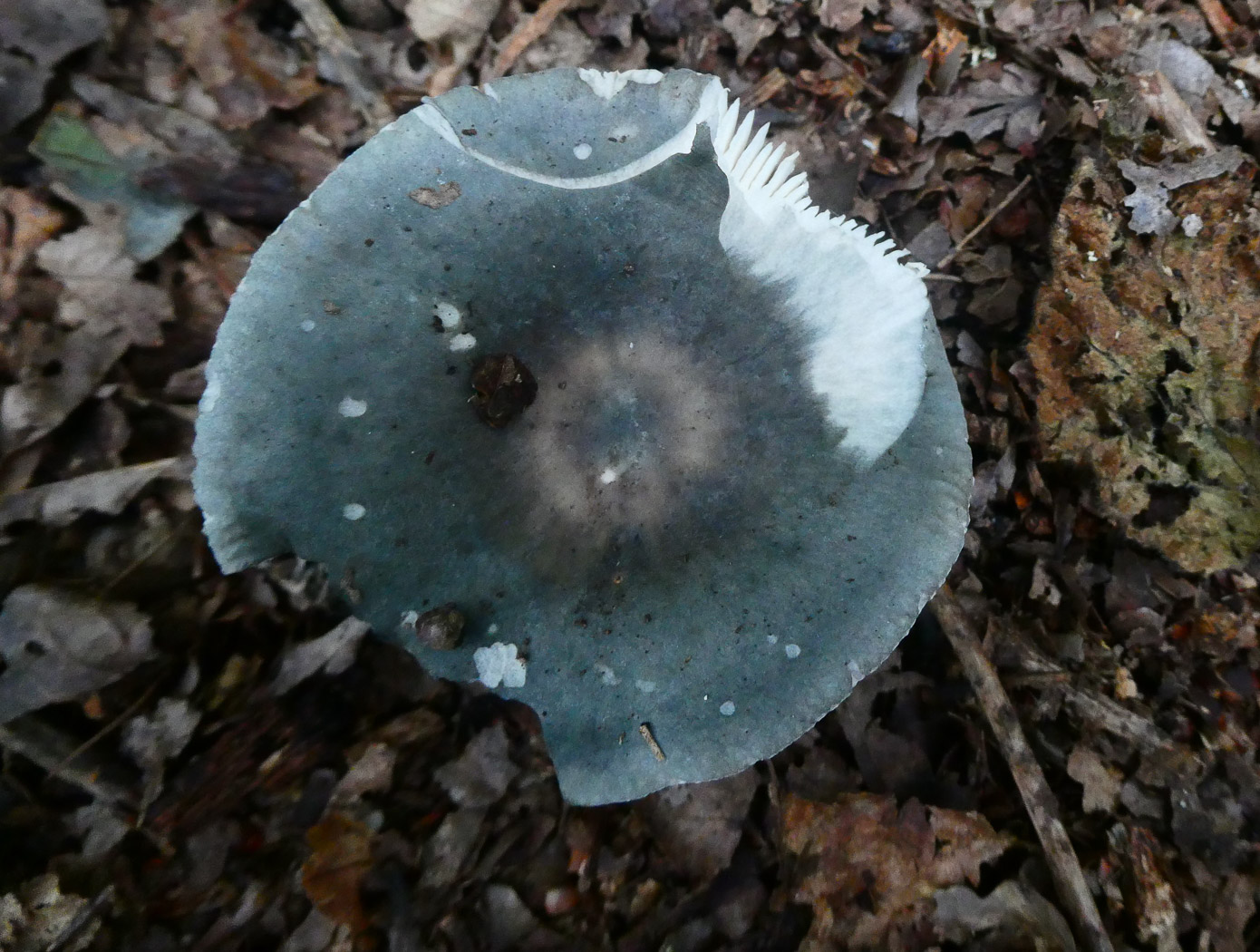 |
September 3rd Russula parazurea (Powdery Brittlegill) In Austenwood Common under Oak Jim Wills found this singleton green Brittlegill and correctly identified it noting the various clues. It is one of several green species (though can sometimes be much browner, like the colour of the cap centre seen here) and the salmon reaction when rubbed with a crystal of iron salts, also the cream gills, quickly eliminated both R. heterophylla and R. cyanoxantha. Other possible contenders were R. grisea and R. ionochlora, but its occurrence under Oak (its preferred host) together with blue-green rather than violet-pink flesh revealed by peeling the cuticle pointed to R. parazurea. Furthermore, the dull pruinose cap surface (as if with a bloom like a grape) confirmed it. Previous finds |
September 2nd 2024
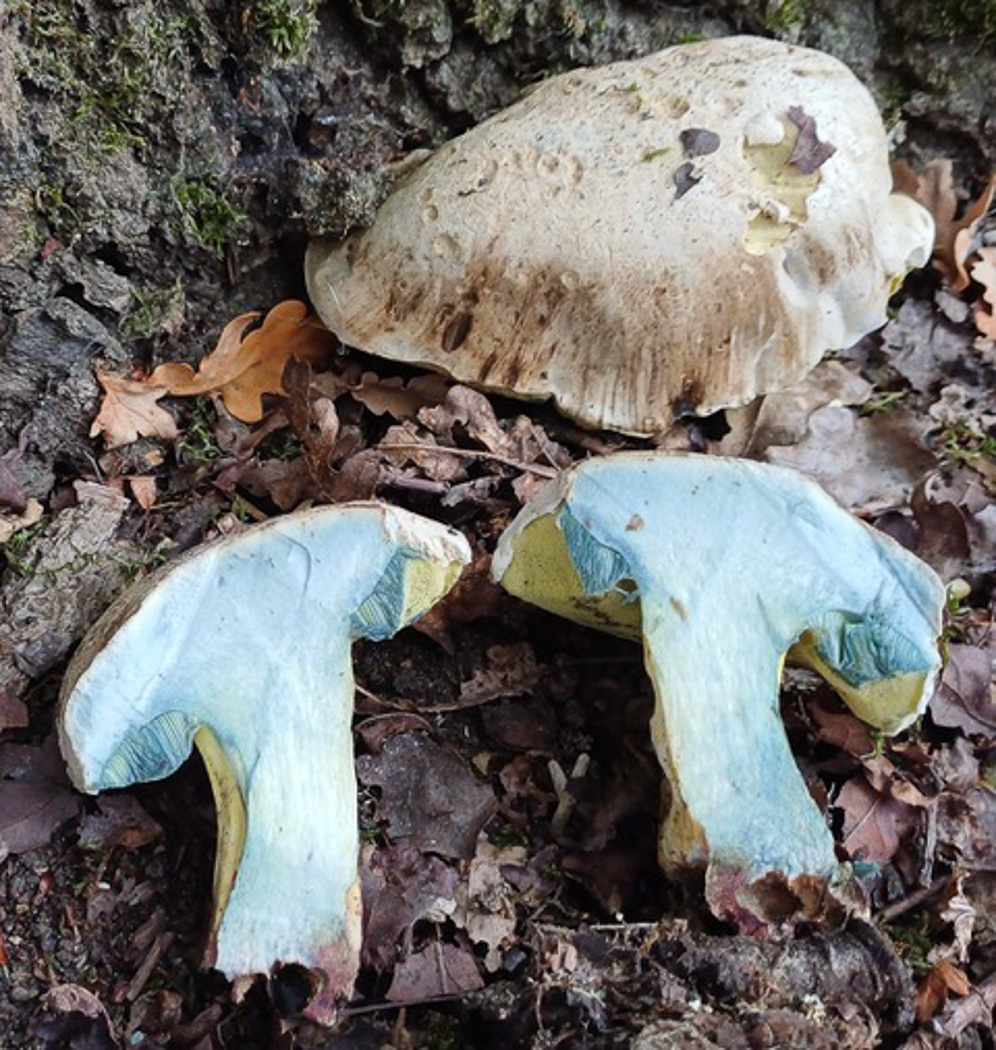
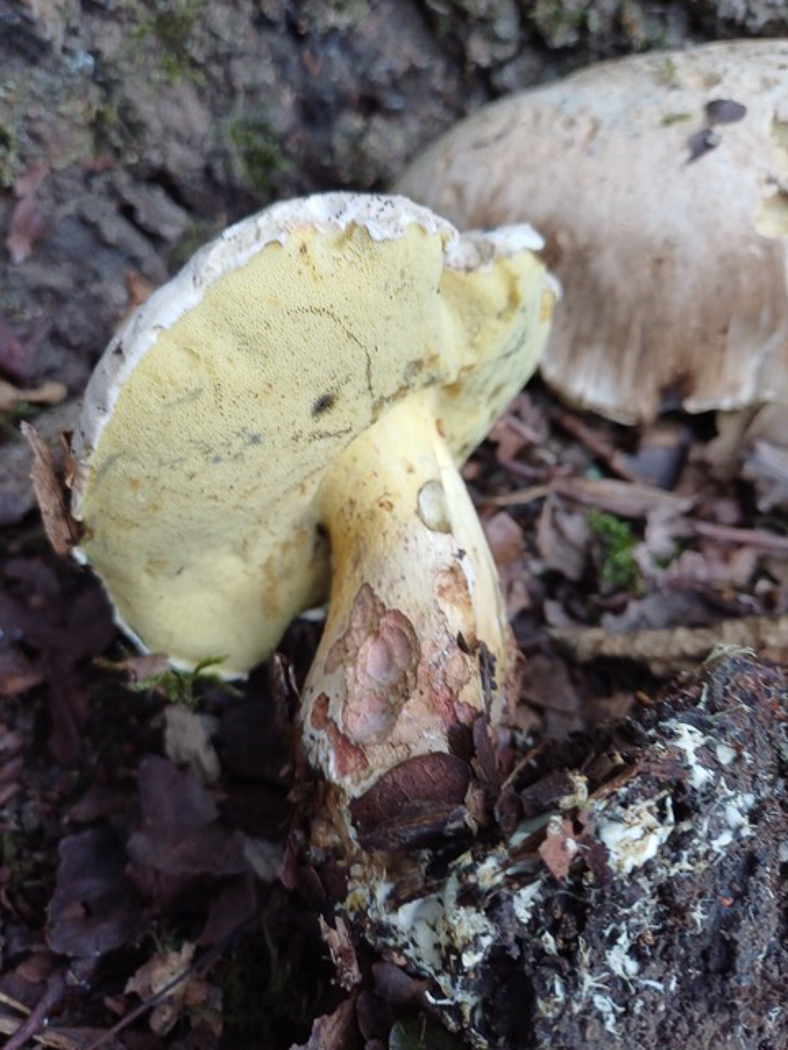

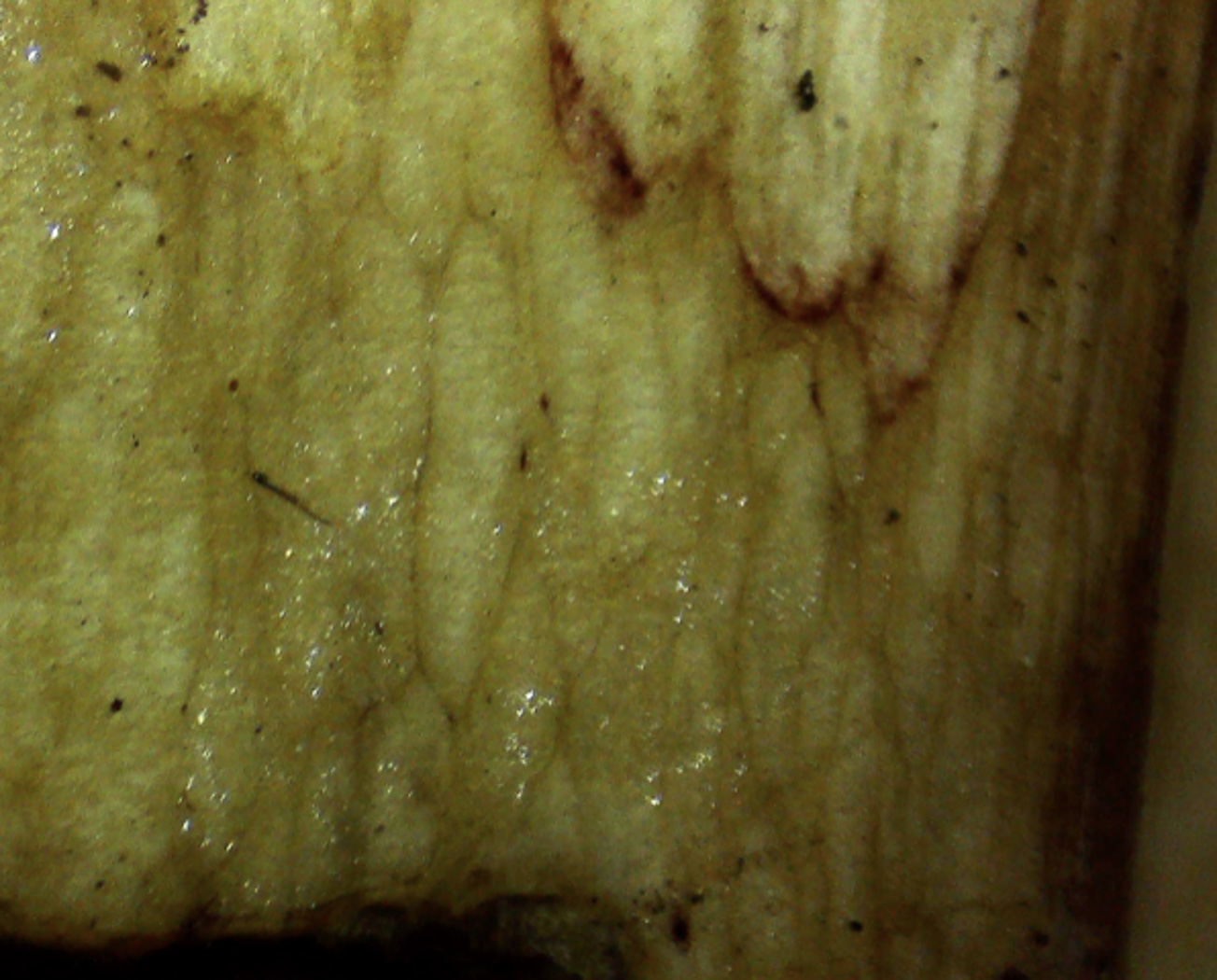 |
September 2nd Caloboletus cf. radicans (Rooting Bolete) In Salden Wood under Oak Bob Simpson found three specimens of this unusual and substantial species, though we are in doubt as to whether it is C. radicans because we now know there is another very similar but much rarer species, C. kluzakii (no English name) which is tricky to tell apart without recourse to DNA sequencing. It was first recorded in the UK in 2020 and we already have one confirmed Bucks collection; it is possible that this might be the second as it does appear to have a slight red flush at the stem base which is apparently one of the differences. For now we'll list it as C. radicans and once sequenced we'll up date this entry. Previous finds |
August 31st 2024
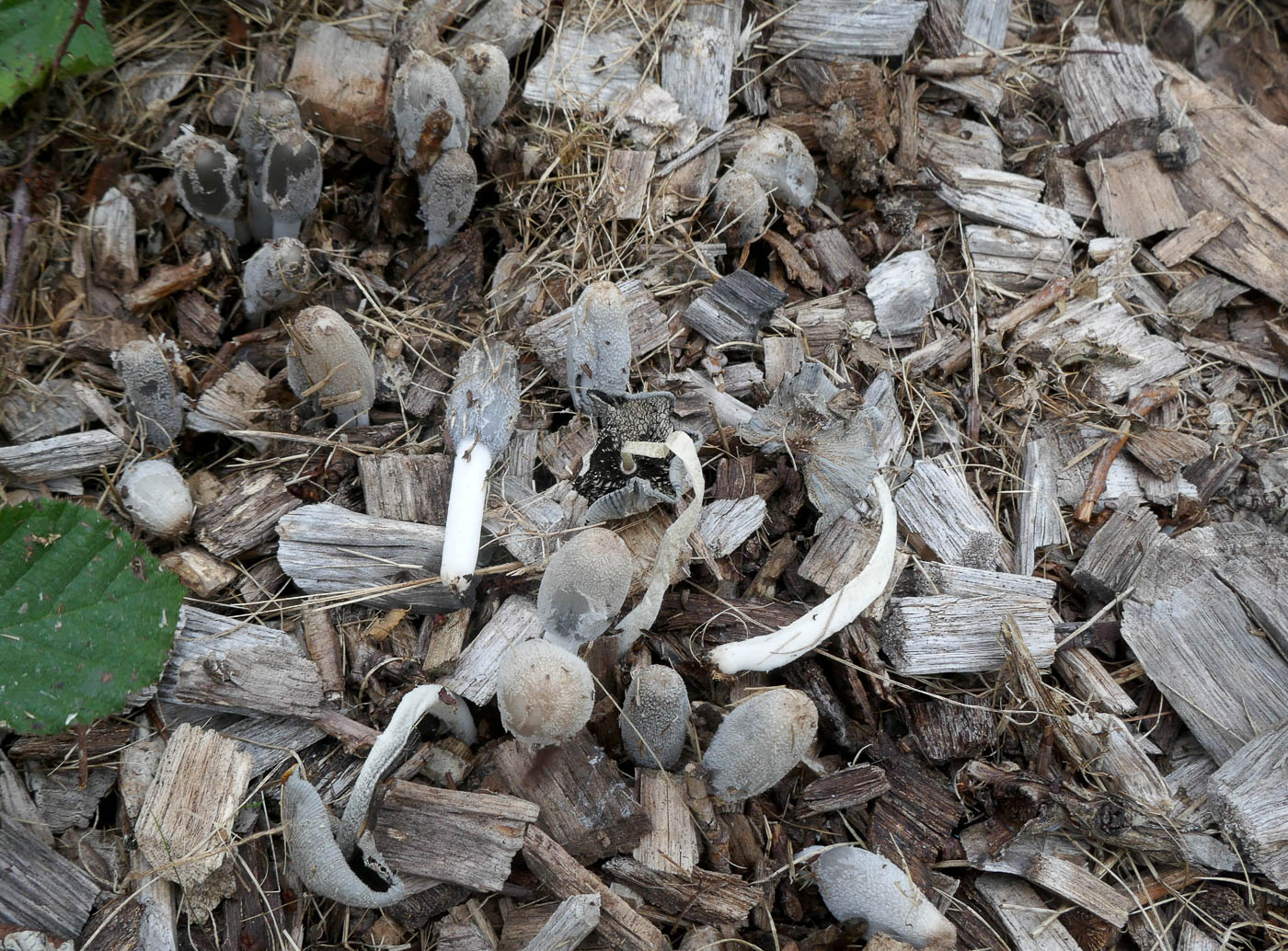 |
August 31st Coprinopsis lagopus (Haresfoot Inkcap) At Stampwell Farm Jackie Ewan noticed this patch of nice fresh Inkcaps coming up in some woodchip. The English name refers to the species when at this attractive immature furry stage though it only takes a day or so before the fruitbodies look very different (as seen in the two lower fruitbodies with stems which have rather collapsed). Previous finds |
August 27th 2024
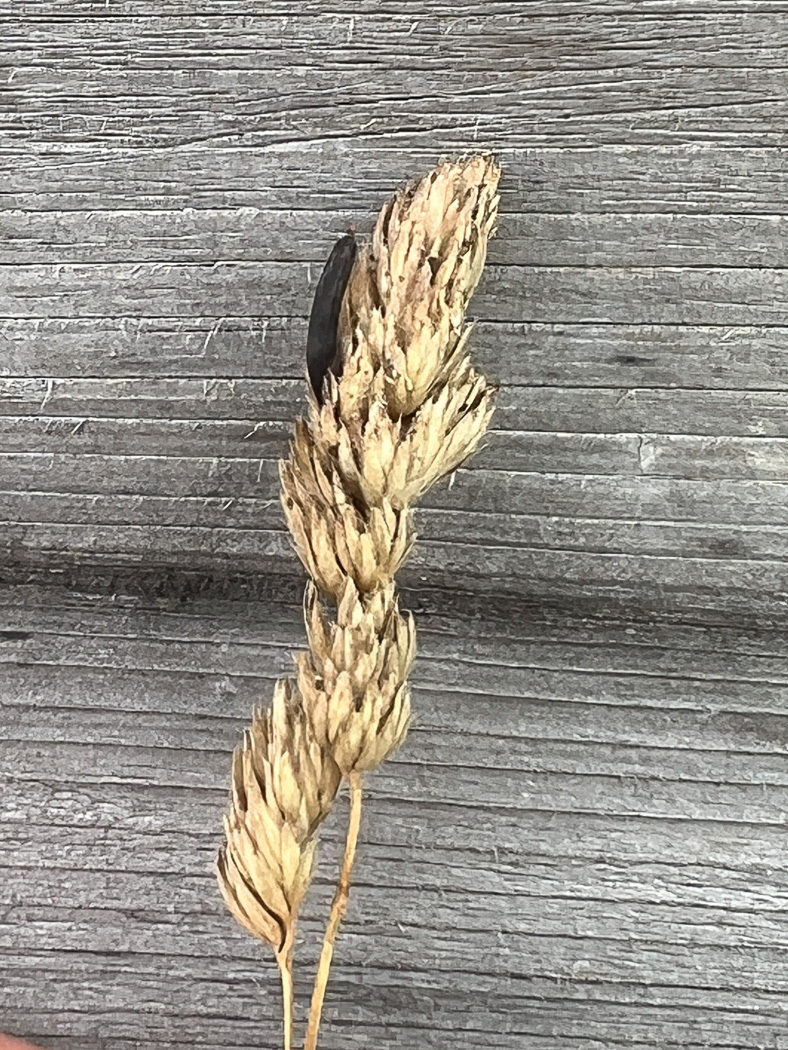 |
August 27th Claviceps purpurea (Ergot) At Dancersend Neil Fletcher found this unusual ascomycete which grows on the heads of grasses including Rye, forming a dark hard sclerotia (seen here). This is a dangerously toxic species and in past centuries was responsible for many deaths but nowadays all grain seed is treated thus removing the threat to both humans and livestock. It has also been used medicinally but owing to the dangerous side effects this practice has been discontinued. We have about 16 county records with several from this site. Previous finds |
August 26th 2024
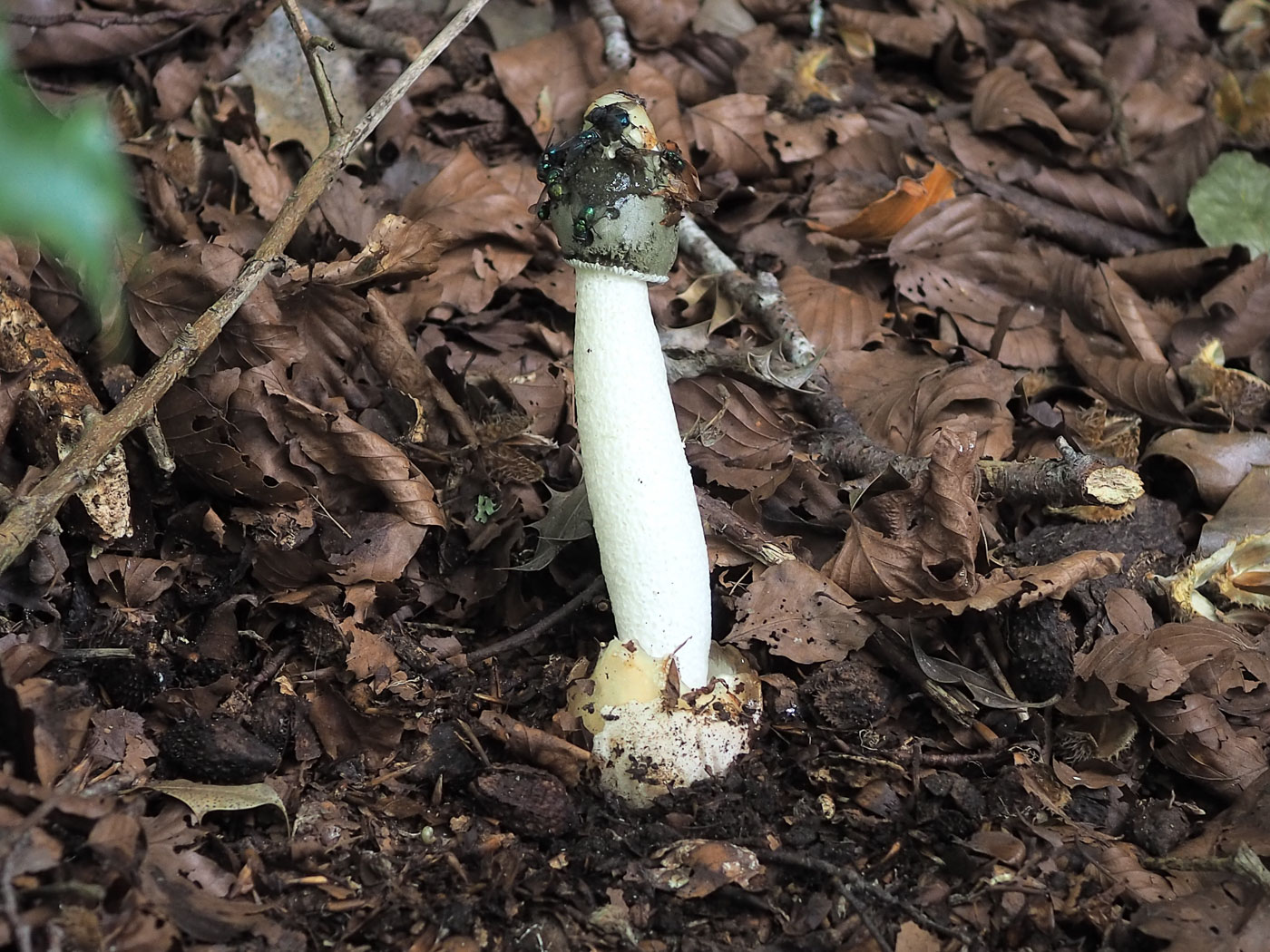 |
August 26th Phallus impudicus (Stinkhorn) In Bottom Wood (near Piddington) John Catterson commented that he could smell a stinkhorn nearby, and Lesley then looked around to locate it! John's photo clearly shows the species at its smelliest with lots of the olive green gleba visible and attracting the hungry flies! The 'egg' from which it has emerged is also nicely visible here. Previous finds |
August 20th 2024
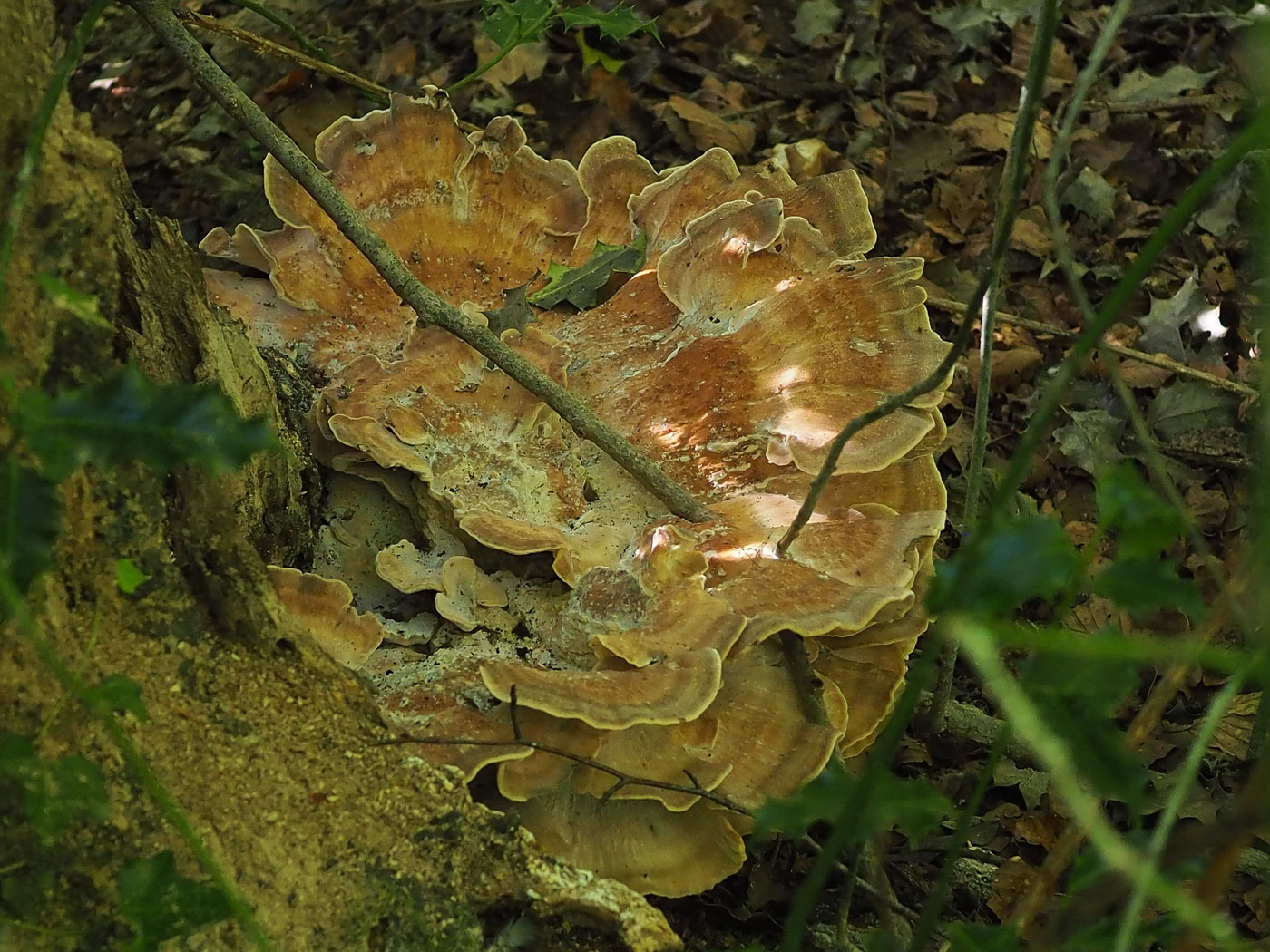
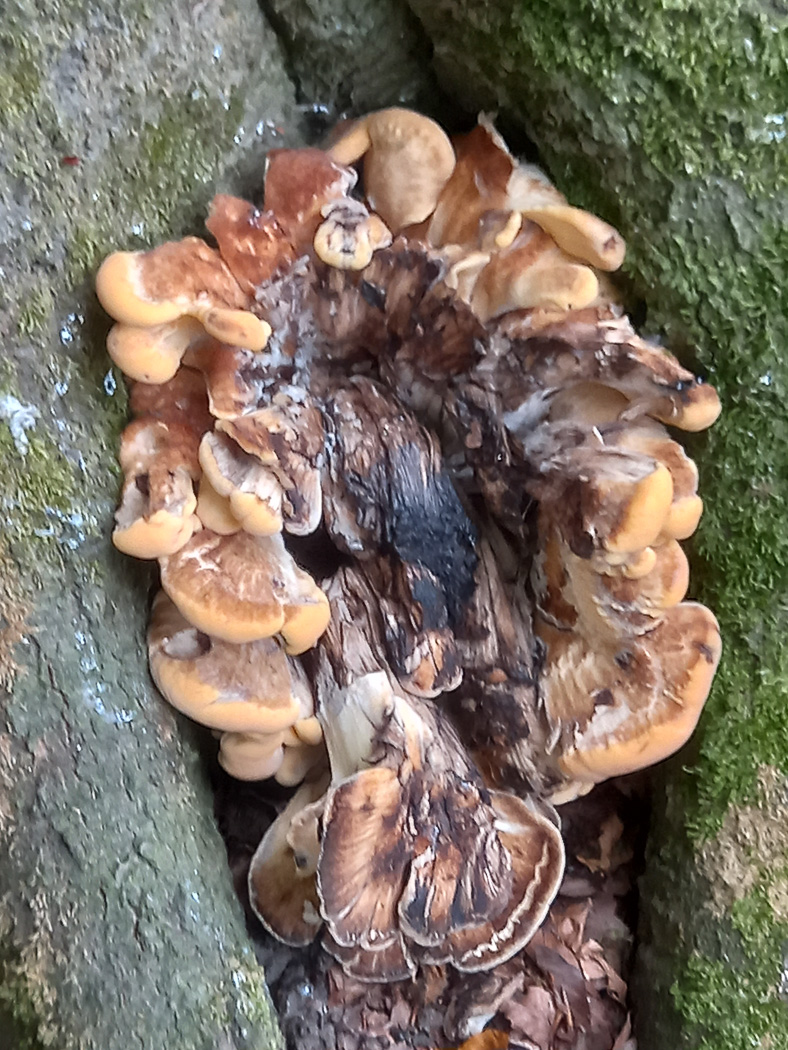 |
August 20th Meripilus giganteus (Giant Polypore) In Tinkers Wood John Catterson noticed this charismatic species just beginning to spread at the base of an unidentified rotten trunk (likeliest to be Beech). When at full size there's no mistaking this bracket but when young like this it could possibly be confused with Grifola frondosa (Hen of the Woods) which as chance would have it was found yesterday (see entry below) giving an opportunity to compare the two. If in doubt, break a piece off and keep an eye on it for half an hour; if the Giant it will gradually blacken where bruised, if the Hen it won't! Photo 2 is of another immature collection found by Greg Douglas on Beech in Captain's Wood Chesham a couple of weeks later. Previous finds |
August 19th 2024
 |
August 19th Grifola frondosa (Hen of the Woods) In Stoke Poges Memorial Gardens Gill Ferguson spotted this stunning fungus at the bottom of a trunk (but was so busy admiring it that she didn't notice the host tree!). It is a distinctive tiered bracket fungus, not that common and usually at the base of either Oak or Beech. New to the site, we have quite a few records though Penny's not seen it since the earlier Finds entry in 2020. See comments on that entry for a bit more information. Previous finds |
August 17th 2024
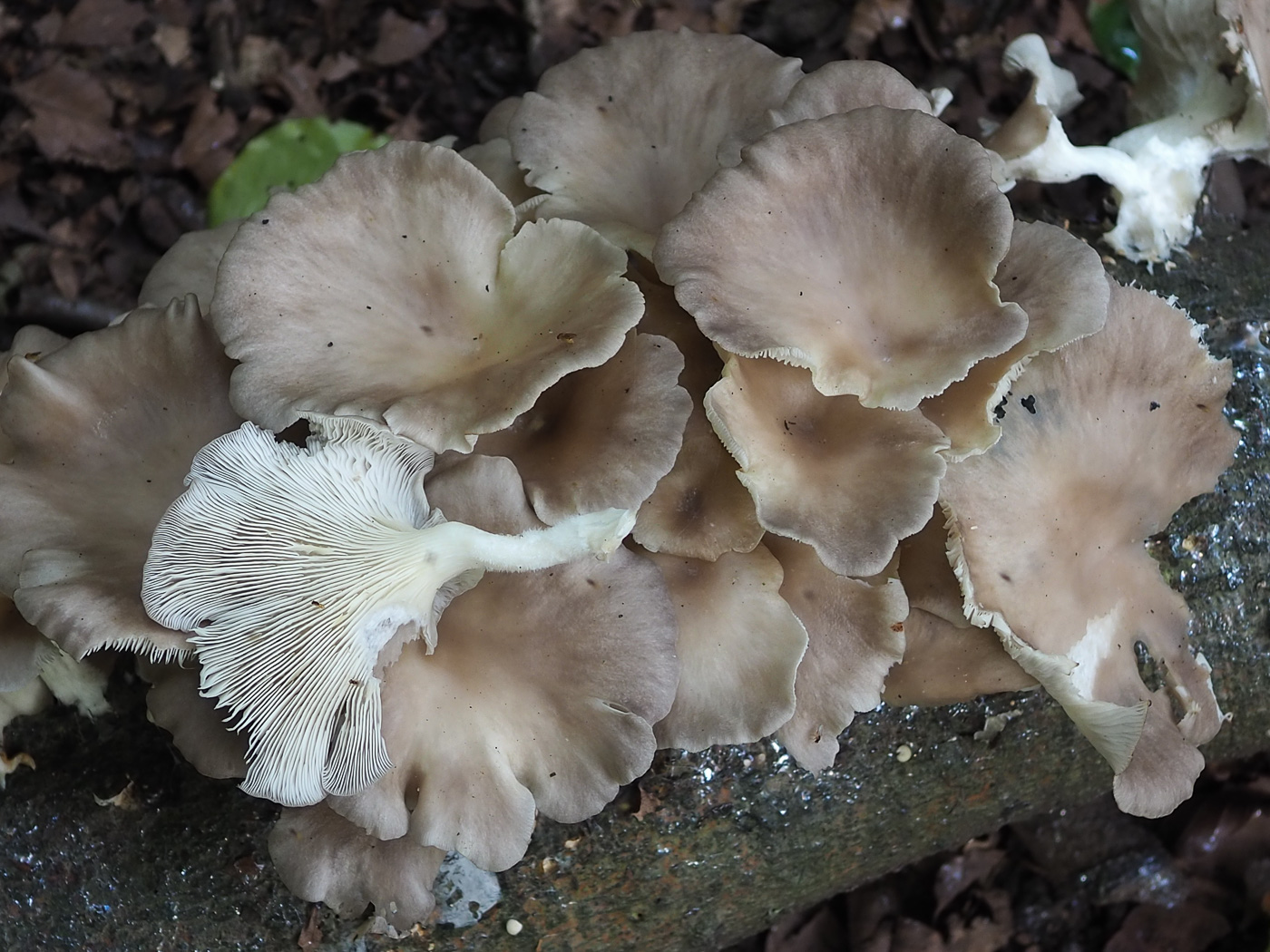 |
August 17th Pleurotus ostreatus (Oyster Mushroom ) In Tinkers Wood John Catterson found this nice cluster on an Oak log. Sure signs that thing fungal re at last starting to move again! Previous finds |
August 15th 2024
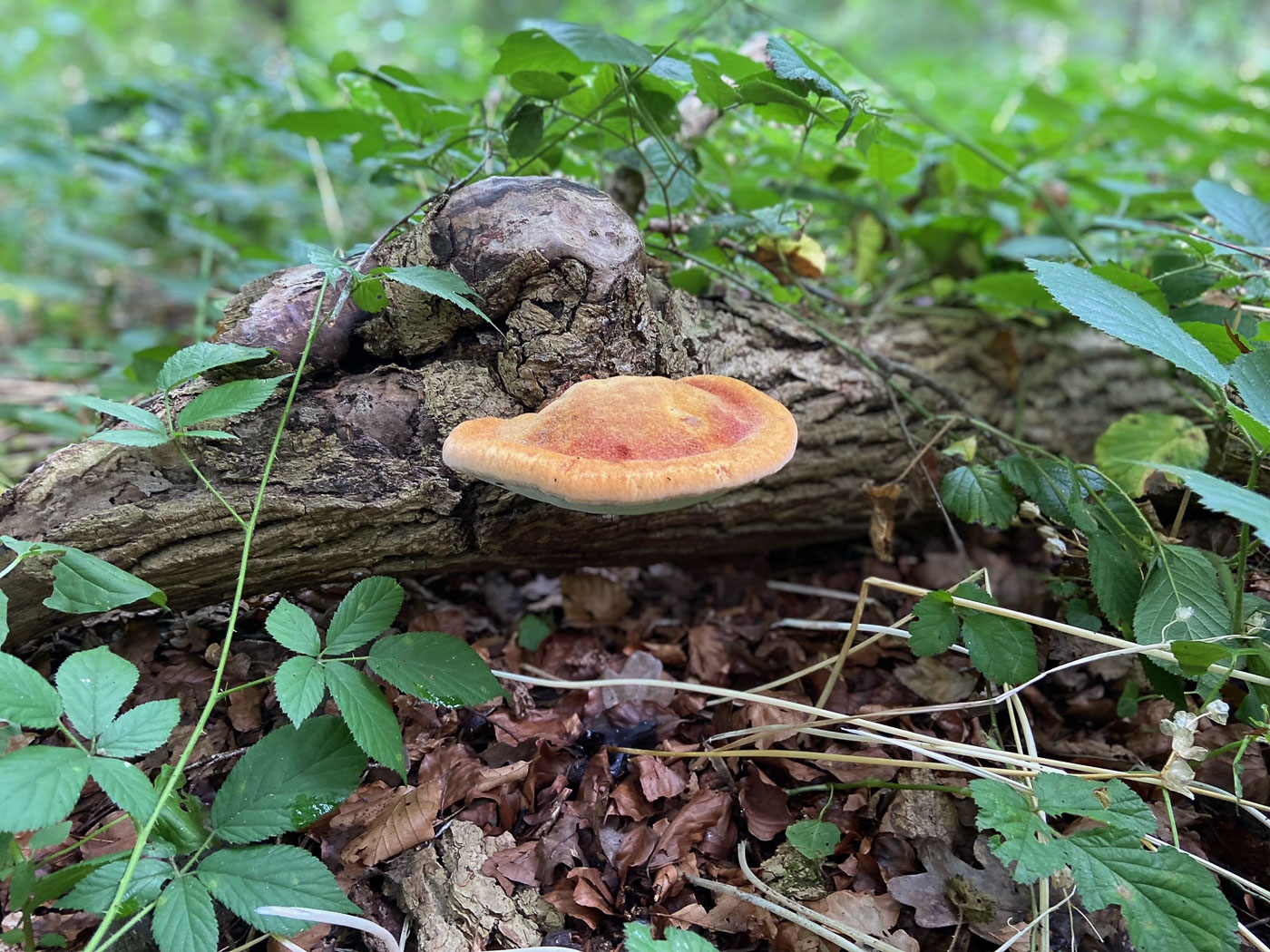
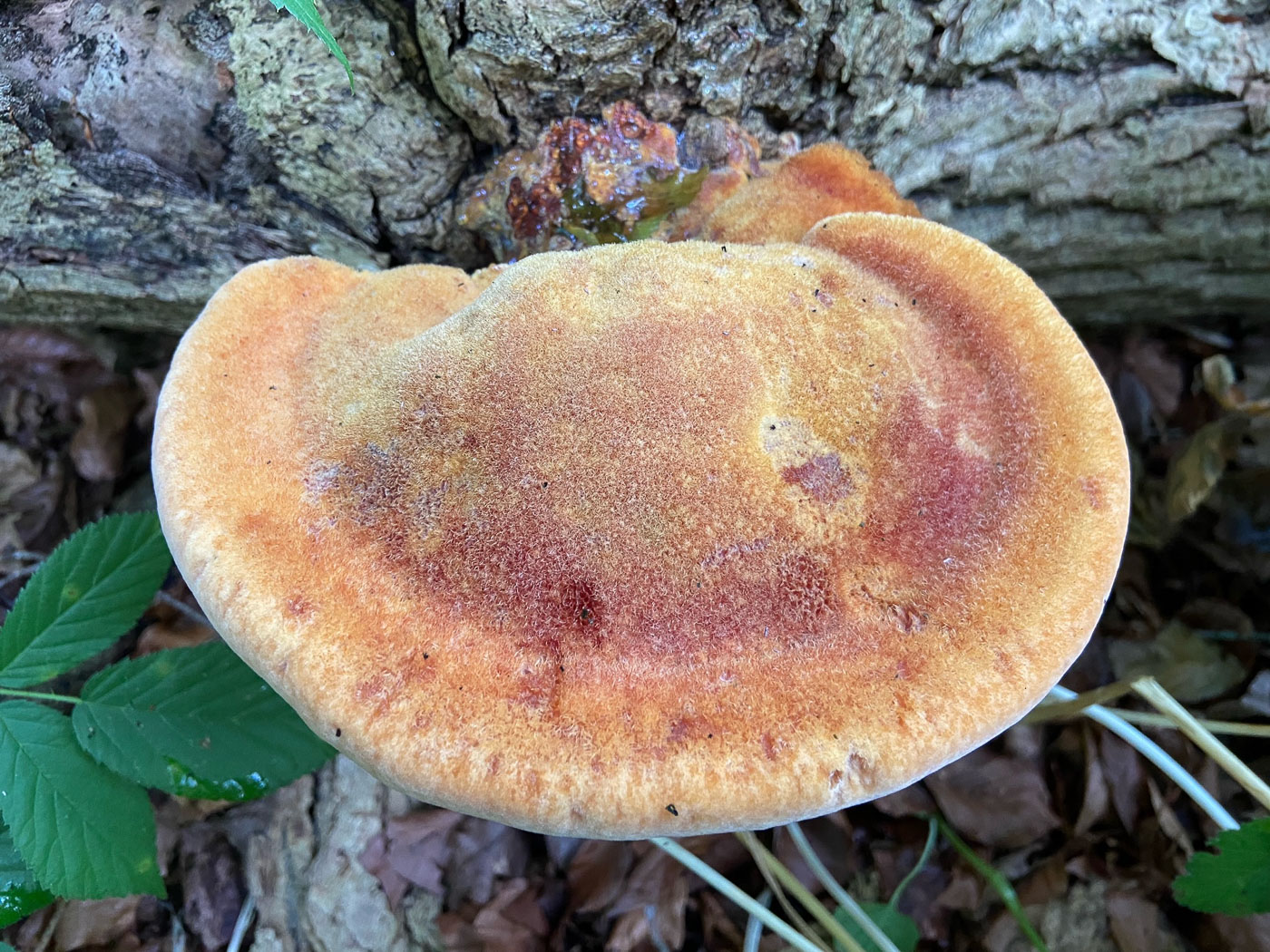
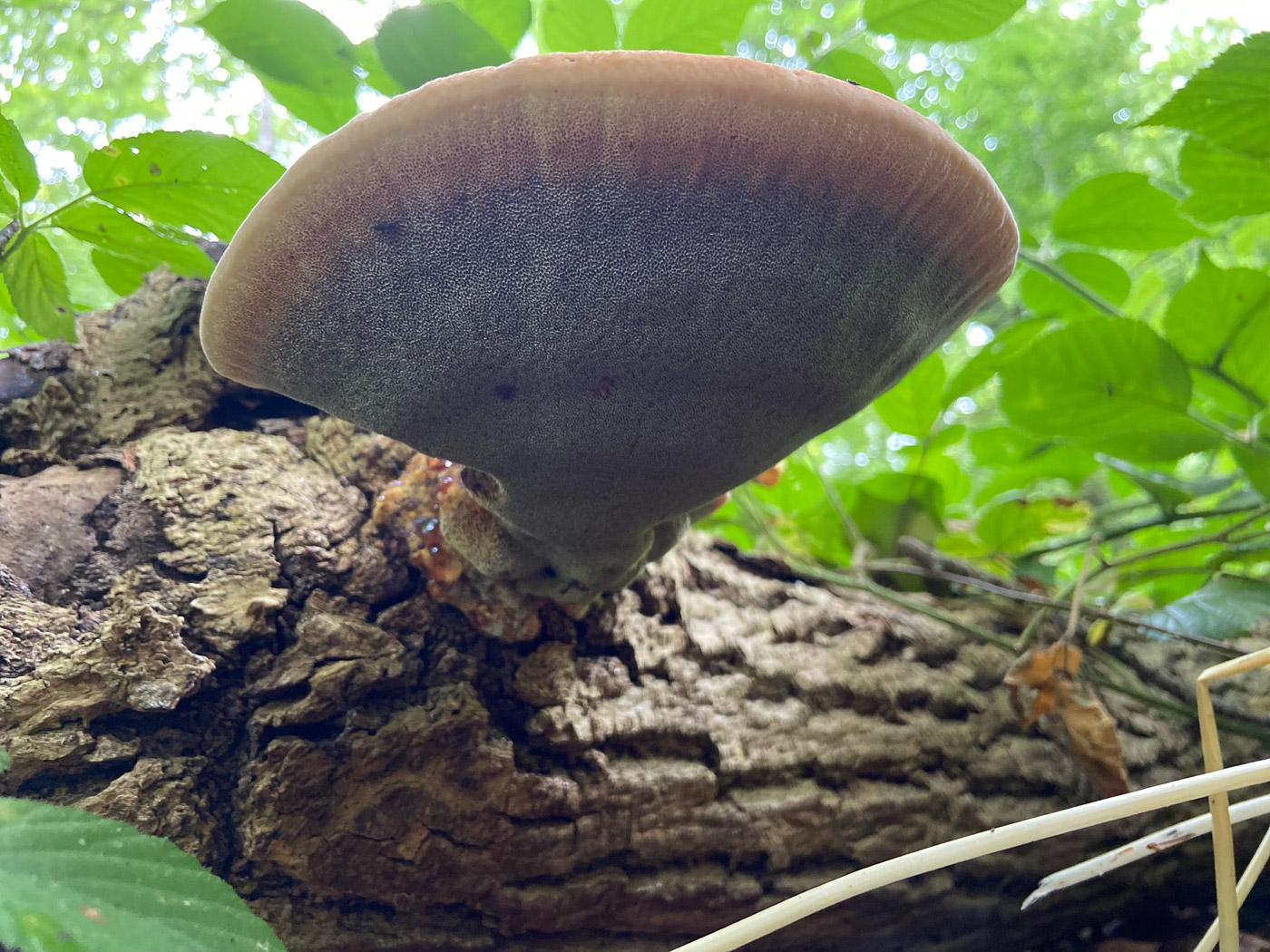

|
August 15th Fistulina hepatica (Beefsteak Fungus) In Pullingshill Wood Stephen Plummer found this attractive bracket on fallen Oak and sent his photos (1-3) to Penny for confirmation as this was young material and not yet showing the exterior blood red signs which give the species away. Photo 4 was sent in by Gill Ferguson from Burnham Beeches two days later with no doubt about the typical bloody signs here! This is about the time to be looking out for this charismatic bracket which is soft in texture and often to be found on standing or fallen Oak. Previous finds |
August 14th 2024
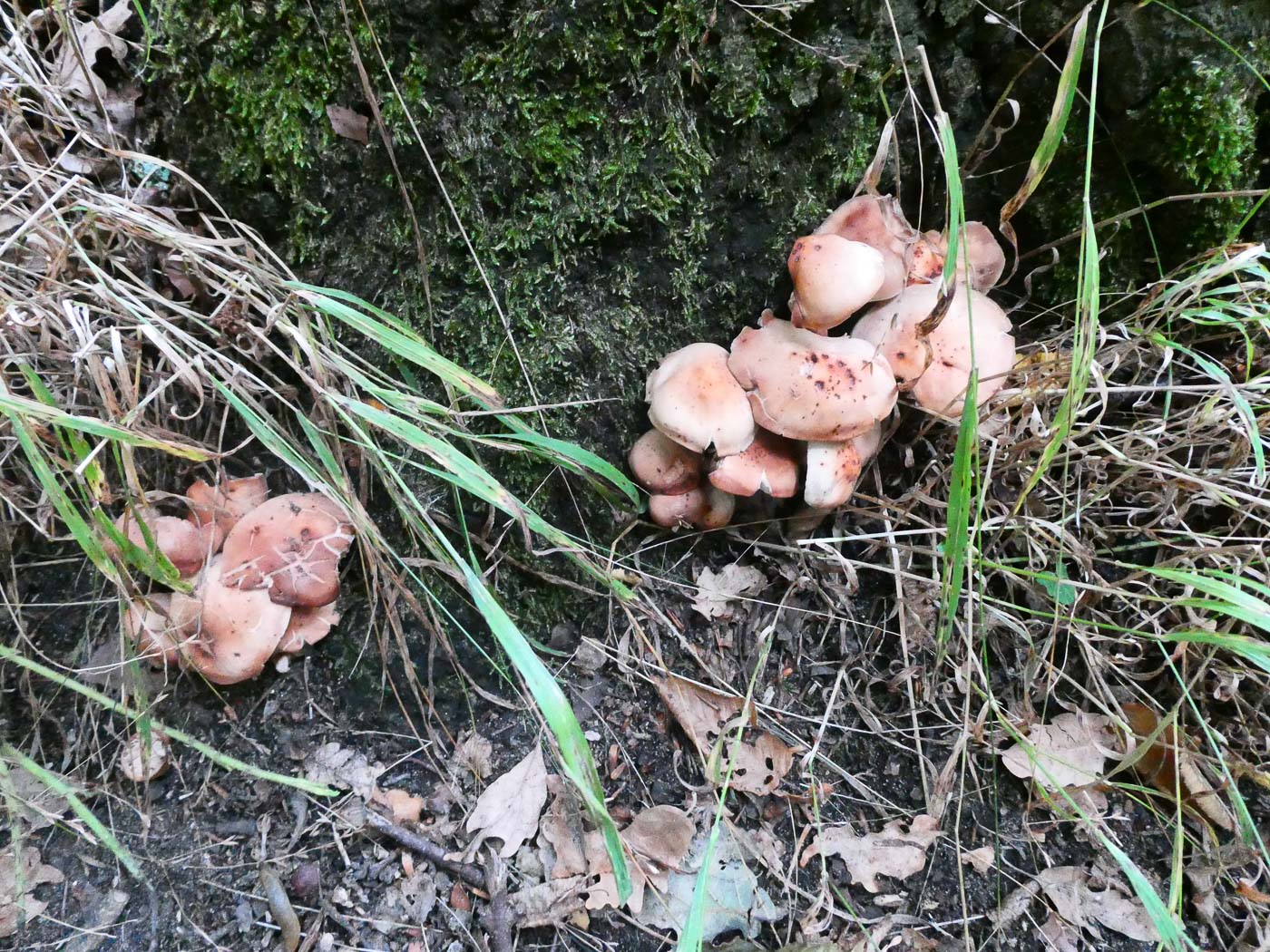
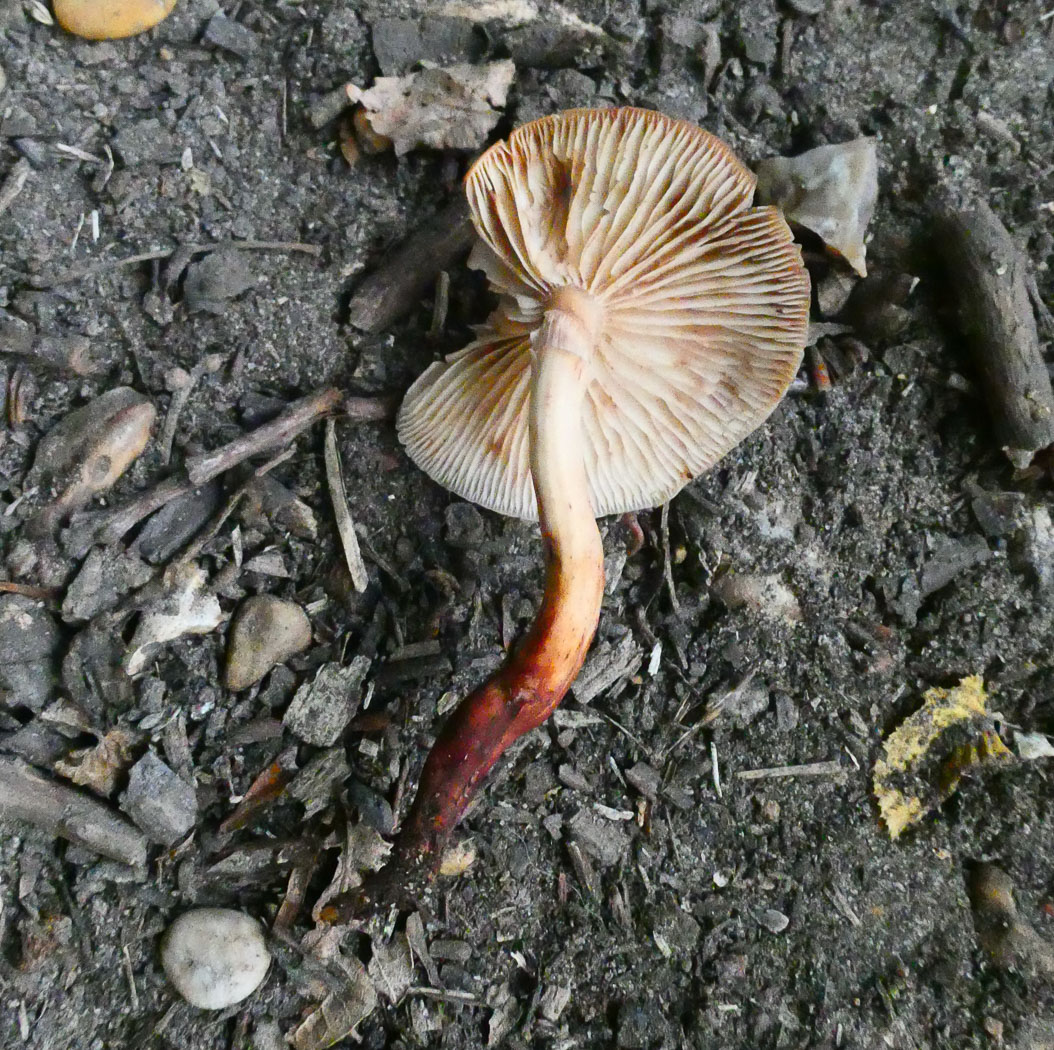 |
August 14th Gymnopus fusipes (Spindle Toughshank) In woodland near Chalfont St. Peter Jim Wills noticed this clustered species at the base of an Oak trunk. Though a common species and often an early fruiter, nothing has been very common so far this summer so finding anything worthy of a photo has been a challenge. Photo 2 shows its typical tapering stem base, often conjoined to its neighbour in this species and a useful clue, together with its flexible rubbery general texture, to its identity if in any doubt. Previous finds |
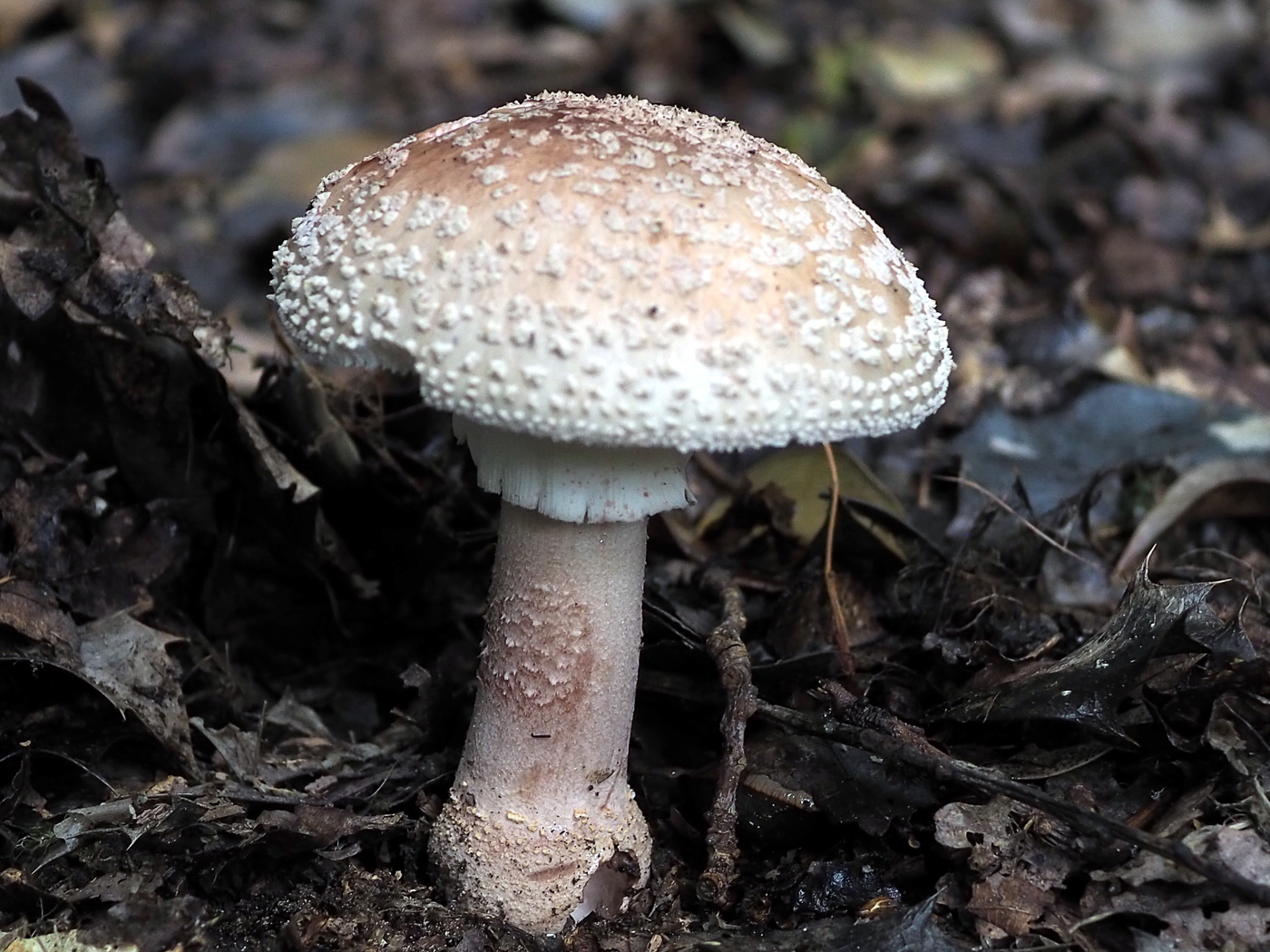 |
August 14th Amanita rubescens (Blusher) In Naphill Common John Catterson was pleased to find this distinctive species in good condition and showing all its characters nicely. This is often an early fruiter but when there is little fungi about for hungry mammals to nibble at it is unusual to find either an Amanita or even a Brittlegill with so little damage. Note the pink blushing visible on the stem, also the ring, the swollen base and the veil remnants on the cap - all sure signs of this common species Previous finds |
August 12th 2024
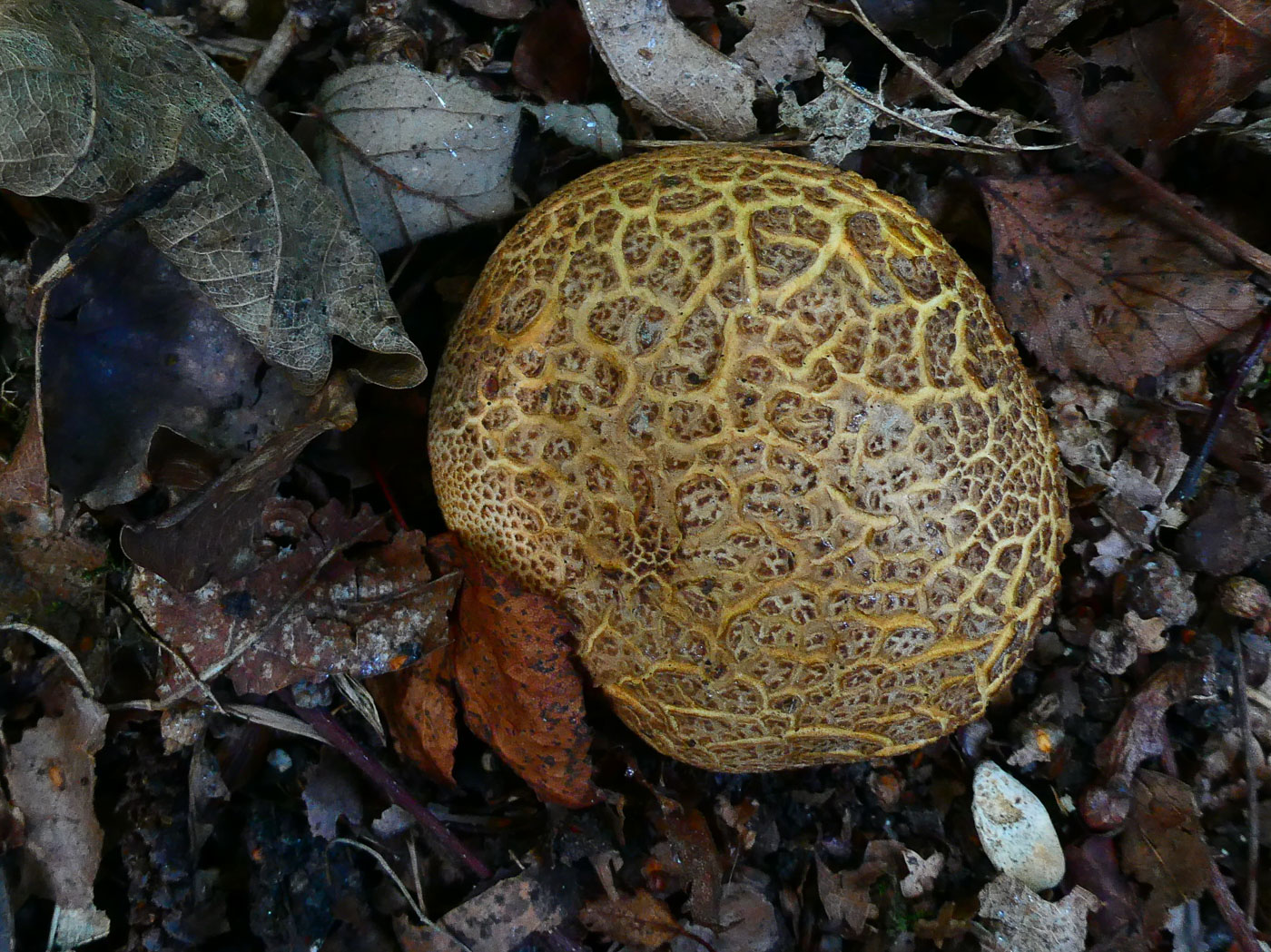
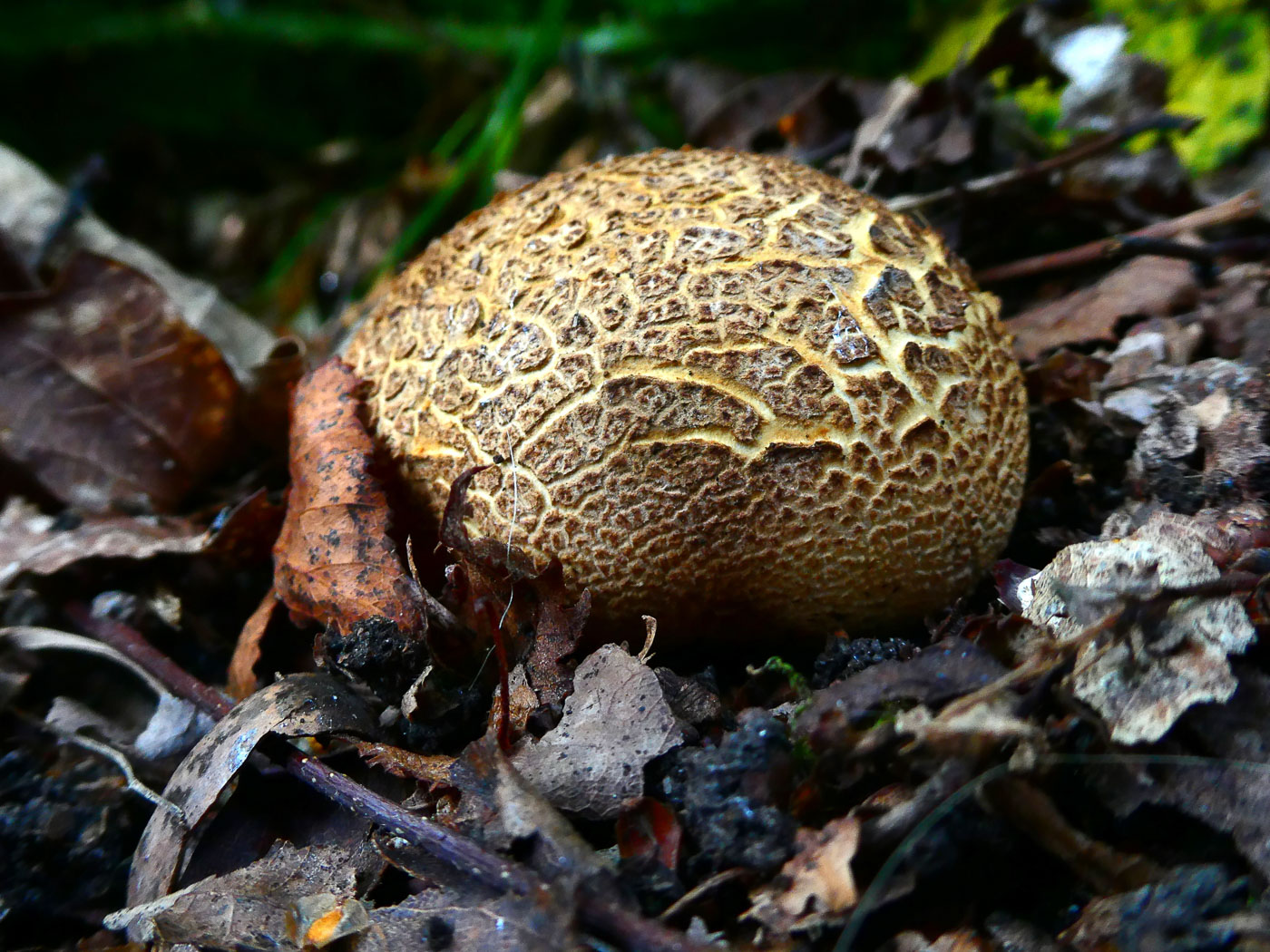
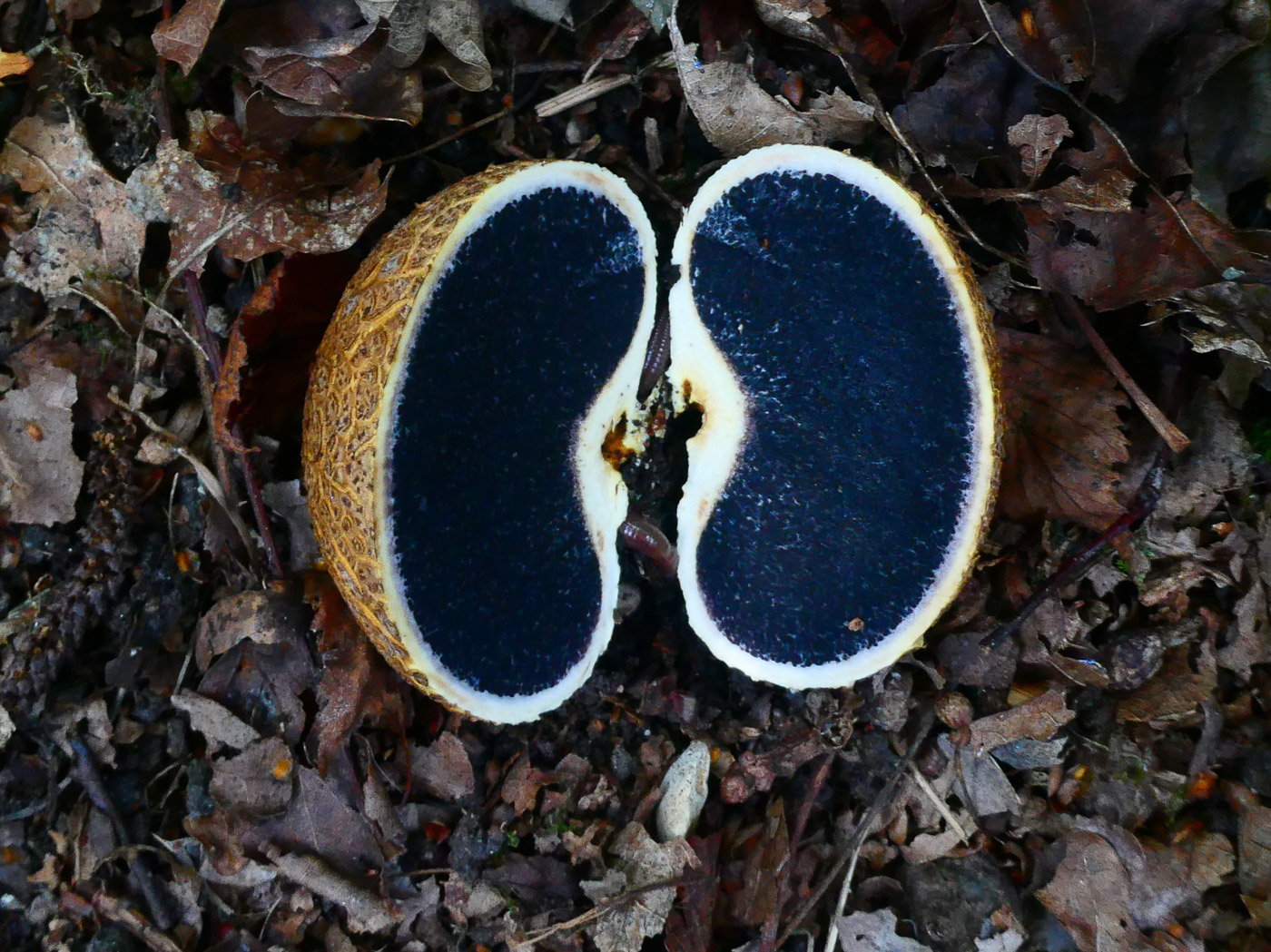 |
August 12th Scleroderma citrinum (Common Earthball) On Goldhill Common under Oak and Birch Jim Wills found this species fruiting in good numbers. The tough scaly surface together with its thick skin and almost black interior when sliced open (when an unpleasant rubbery smell is apparent) help to separate it from other species of Earthball. Previous finds |
August 9th 2024
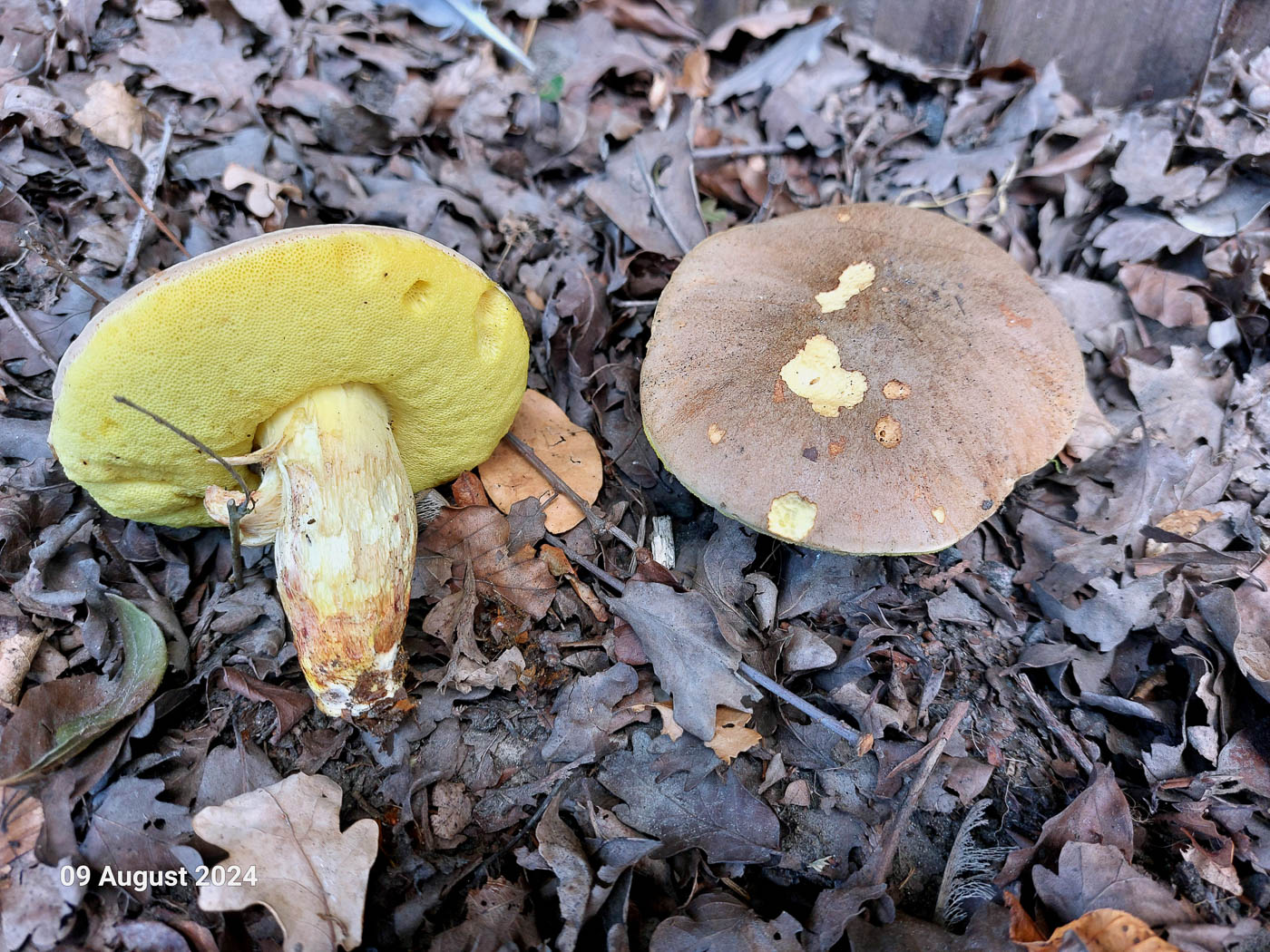 |
August 9th Hemileccinum impolitum (Iodine Bolete) In a roadside verge under Oak in Gerrards Cross Jesper Launder found this smart pair of boletes despite the area being very dry. On picking one the strong smell of iodoform was immediately apparent (Jesper described them as reeking!) leaving him in no doubt as to the species, this confirmed with one press of the pores which then failed to show any sign of blueing. This is a large chunky solid species with a preference for sandy calcareous soils under Oak and should present no problems to identify if the smell and lack of blueing on the pores are noticed. Previous finds |
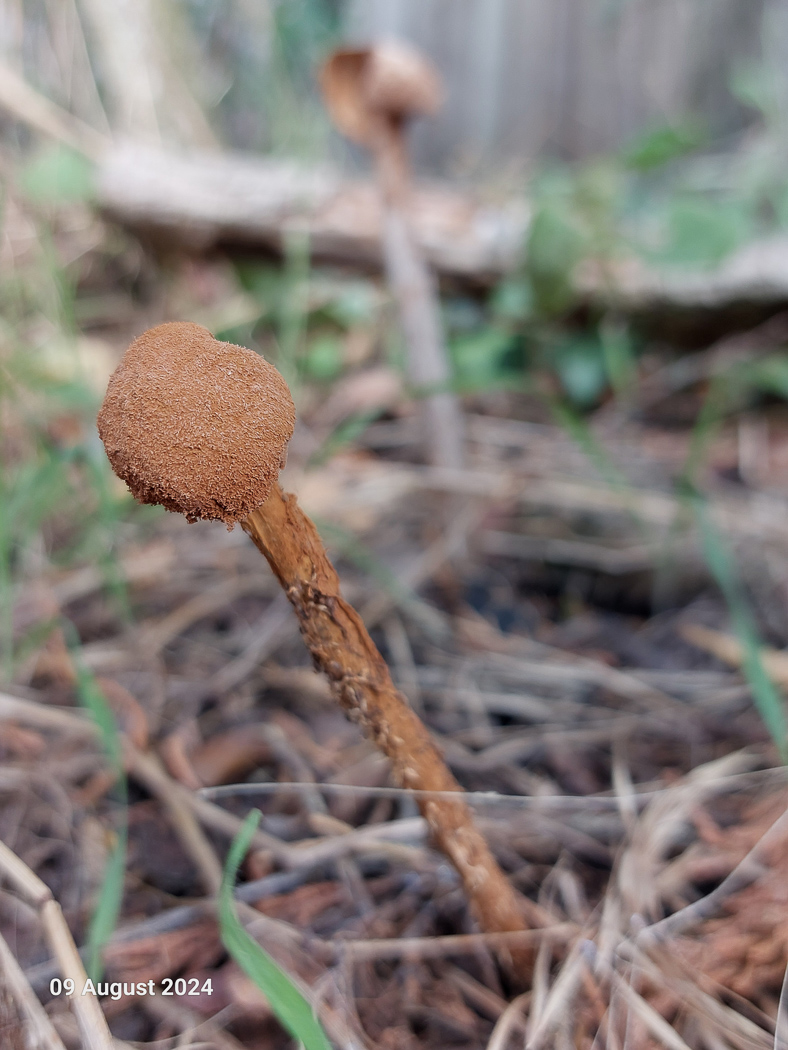
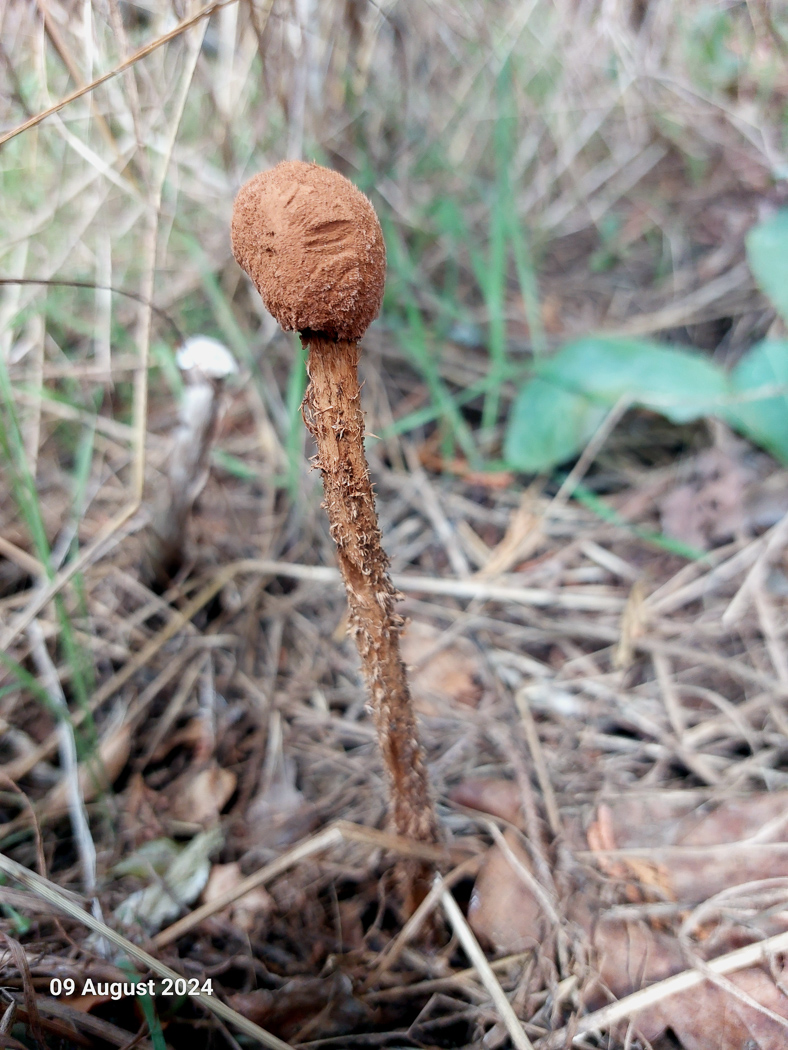
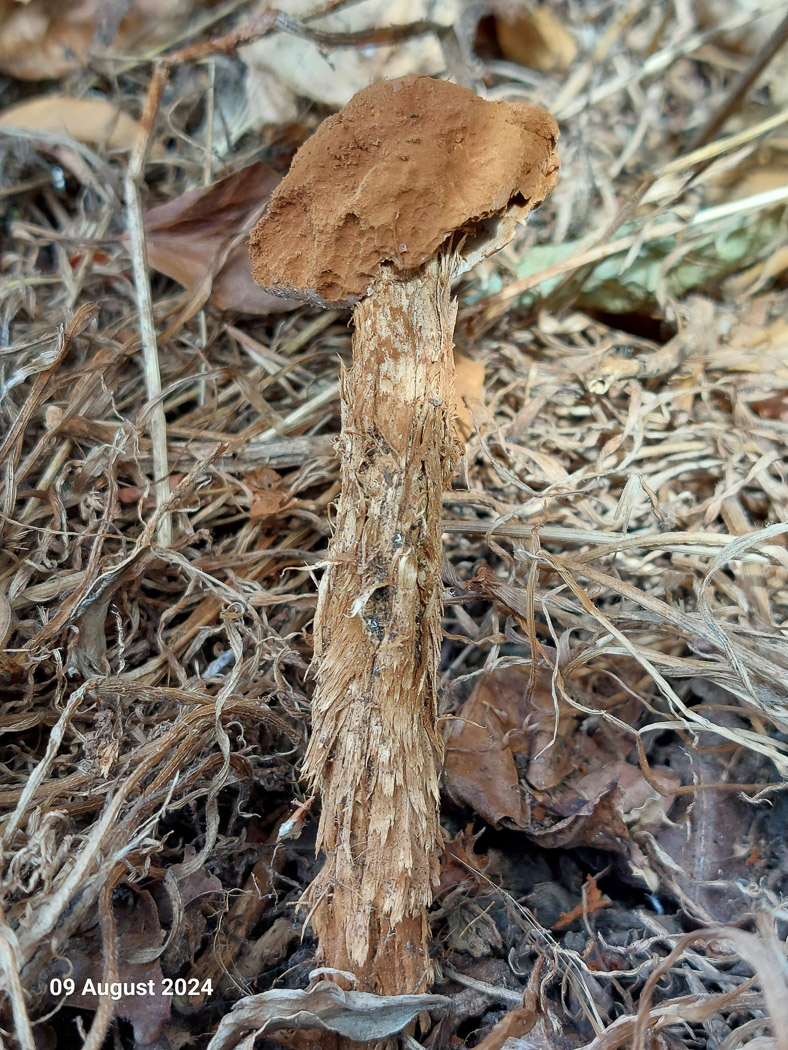
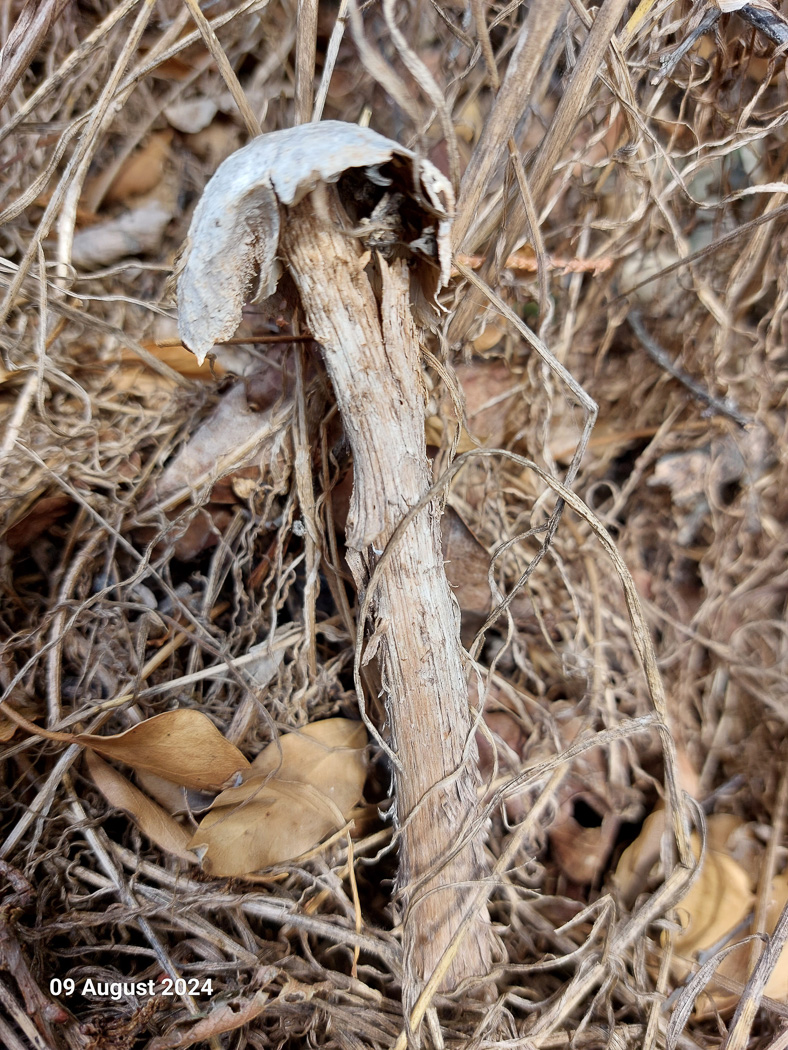 |
August 9th Battarrea phalloides (Sandy Stiltball) In Fulmer Jesper Launder was both astonished and delighted to spot a group of these rare and strange looking fungi in a dry grassy roadside bank near some Leylandii. Related to the gasteroid (stomach) fungi, the species is on the Red Data List and as such protected by law (thus should not be picked). Jesper reports that there were three fresh stalks about 10 cm tall amongst some 6 or 7 much older dilapidated specimens - probably left from last year. The species is woody and tough, also somewhat unpredictable where it fruits, but does seem to like banks with sandy soil near conifer and has now been found several times in the county, always in urban areas. This is the second find of the year and we now have four similar sites for it in Bucks, so rather like the equally strange and also gasteroid species Clathrus ruber it does seem to be on the increase. Climate change? Previous finds |
July 30th 2024
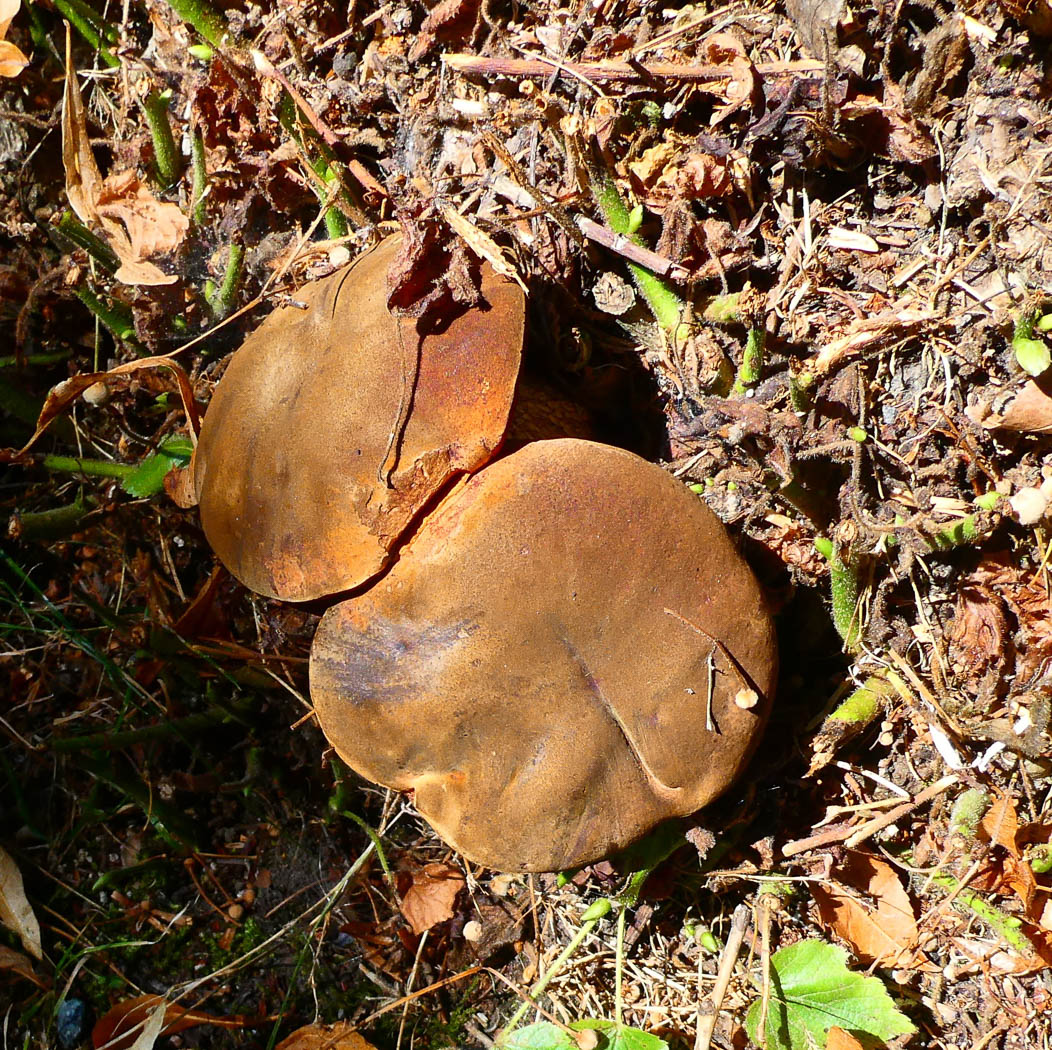
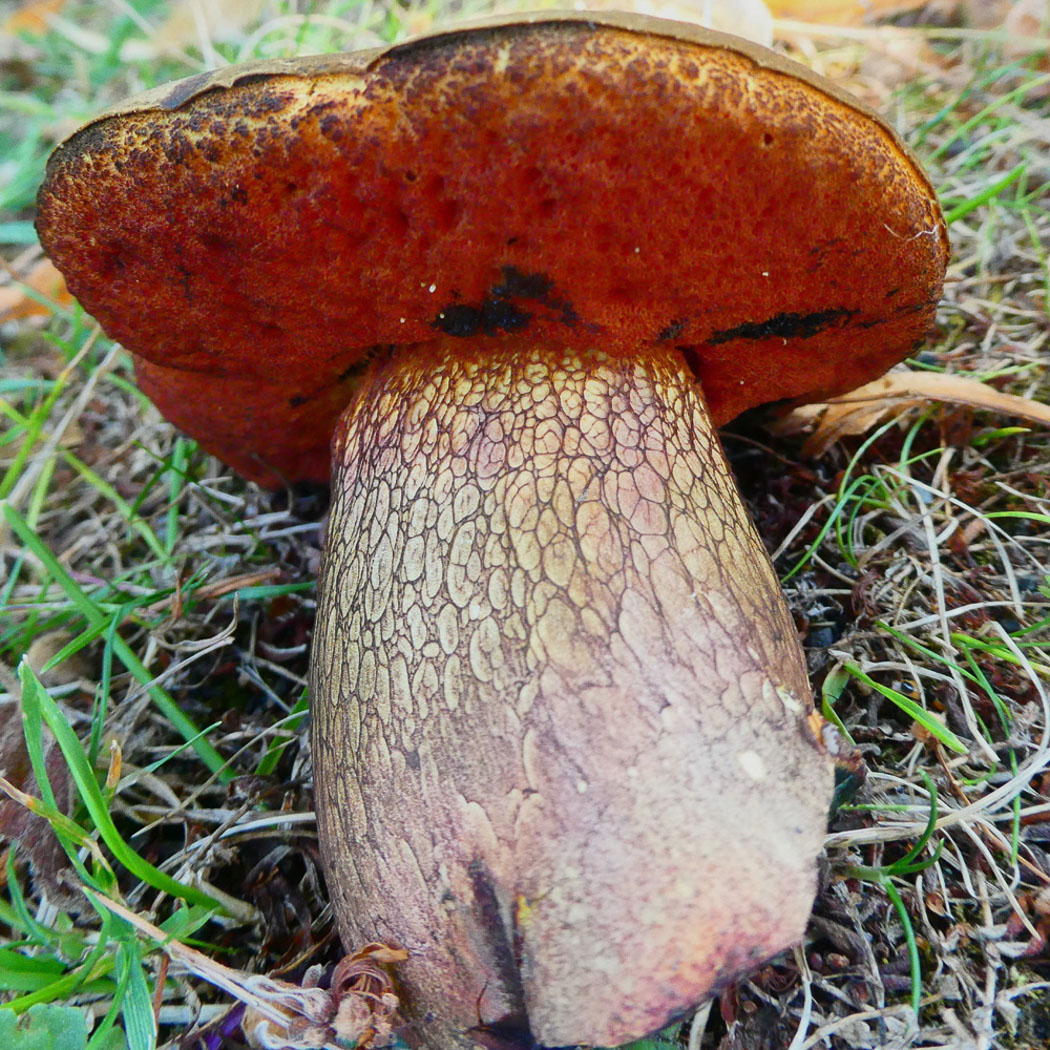
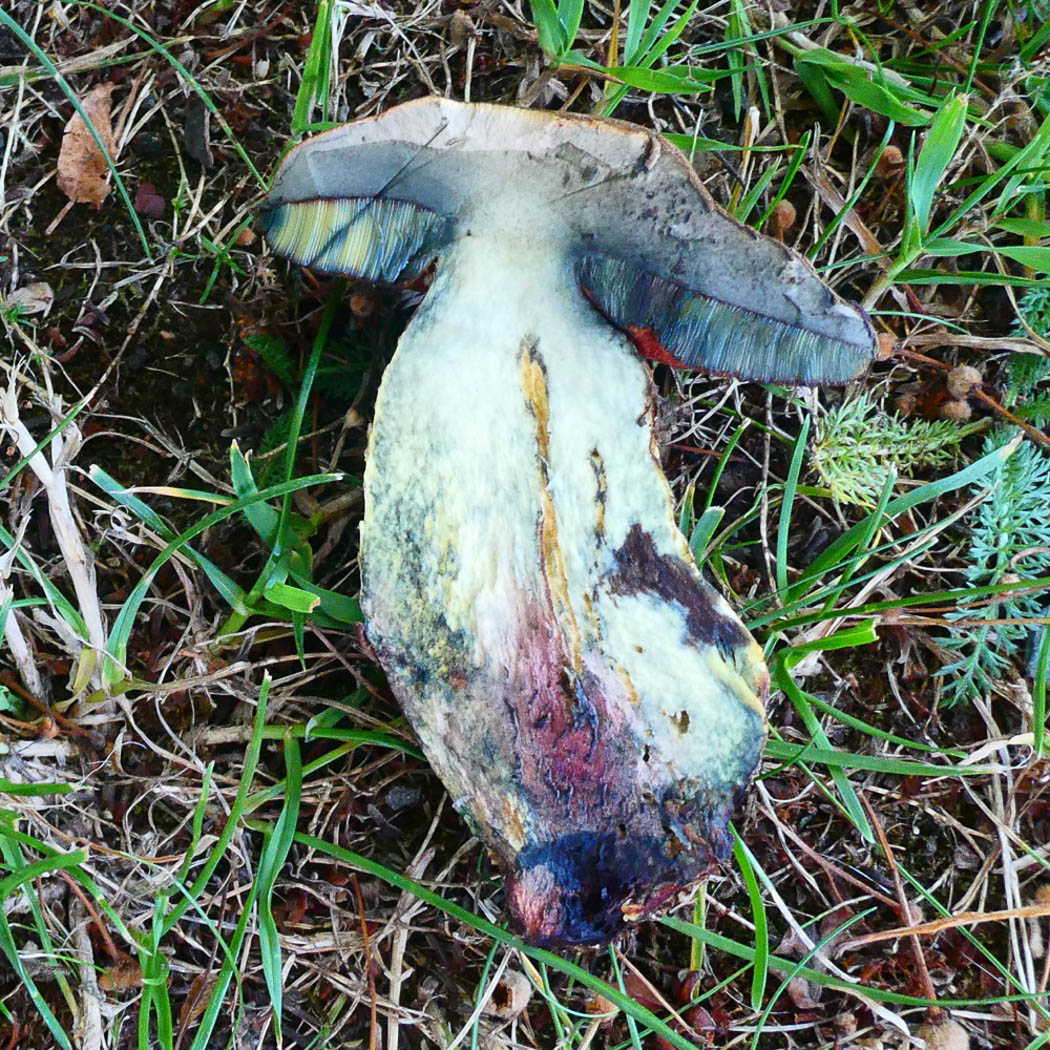
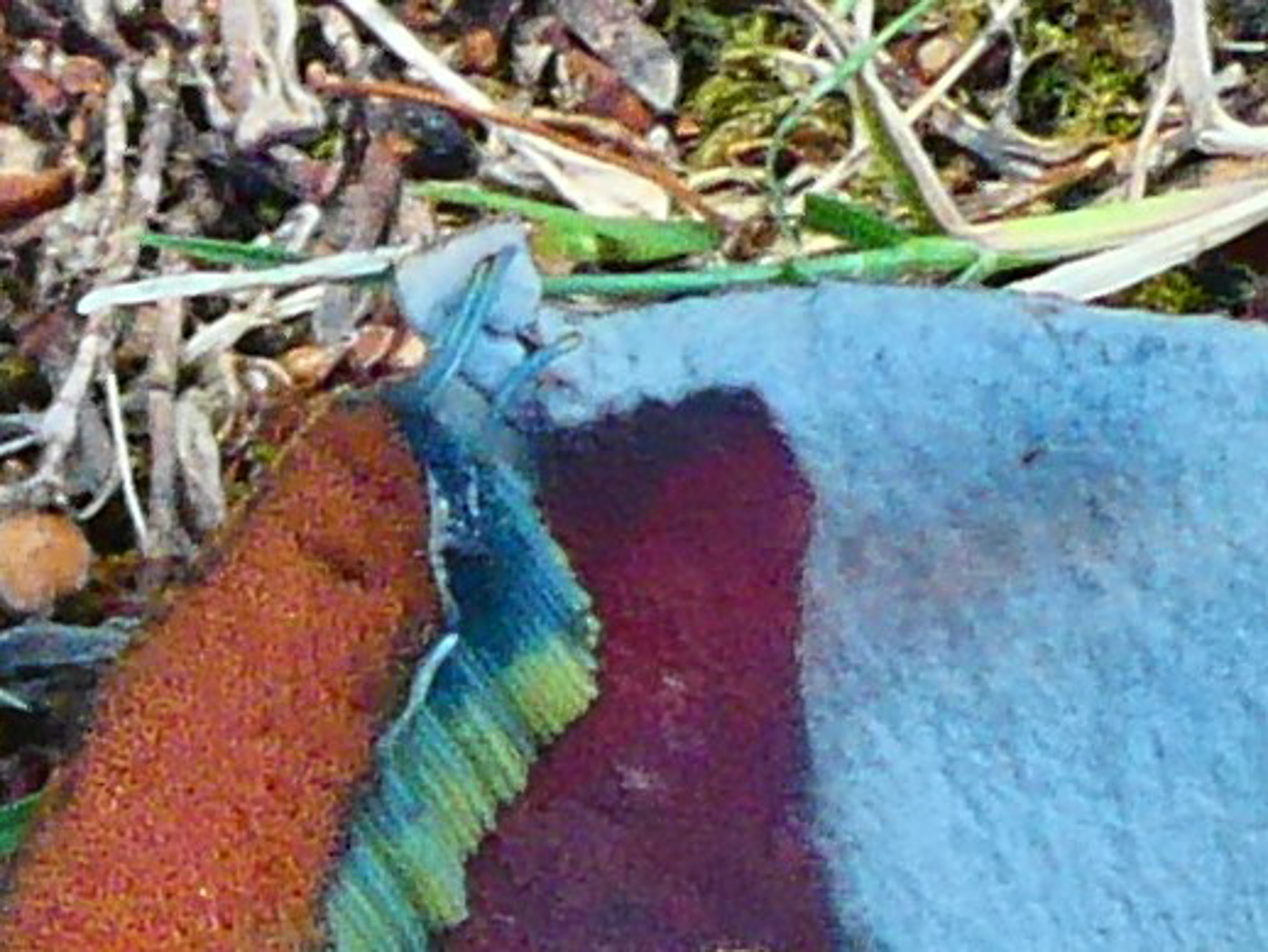 |
July 30th Suillellus luridus (Lurid Bolete) In a roadside verge in Chalfont St. Peter Jim Wills came across a group of ten boletes fruiting in soil under Lime, his photo 1 is of a conjoined pair. The colour of the pores and bluing flesh when exposed to air quickly limited the possibilities so he took one home to work out which of the three likeliest candidates it was. The impressive and prominent network (see photo 2) covering the entire stem eliminated Neoboletus luridiformis (Scarletina Bolete) - by far the commonest of our red-pored boletes, and also pointed to S. luridiformis rather than S. queletii (Deceiving Bolete) - another contender which also has a network but it is less well defined and tends to be only in the lower stem. Jim placed a drop of Melzer's reagent on the lower stem flesh (see photo 3) which turned deep blue further confirming it was one of these two species (N. luridiformis flesh turns dirty brown ie a negative reaction). Both species are positive with Melzers and have some beetroot red colour in the lower stem flesh but this is much more marked in B. queletii which furthermore has an abruptly tapering and rooting stem base - not seen here. B. queletii is the rarer of the two species but was much in evidence last summer in our area. So both are well worth looking out for now. Incidentally, photo 4 is a good example of how to separate the genus Xerocomellus from other bolete genera: when the tubes (under the cap flesh) are pulled apart the individual tubes remain intact in all boletes except Xerocomellus where they rupture. Previous finds |
July 19th 2024
July 13th 2024
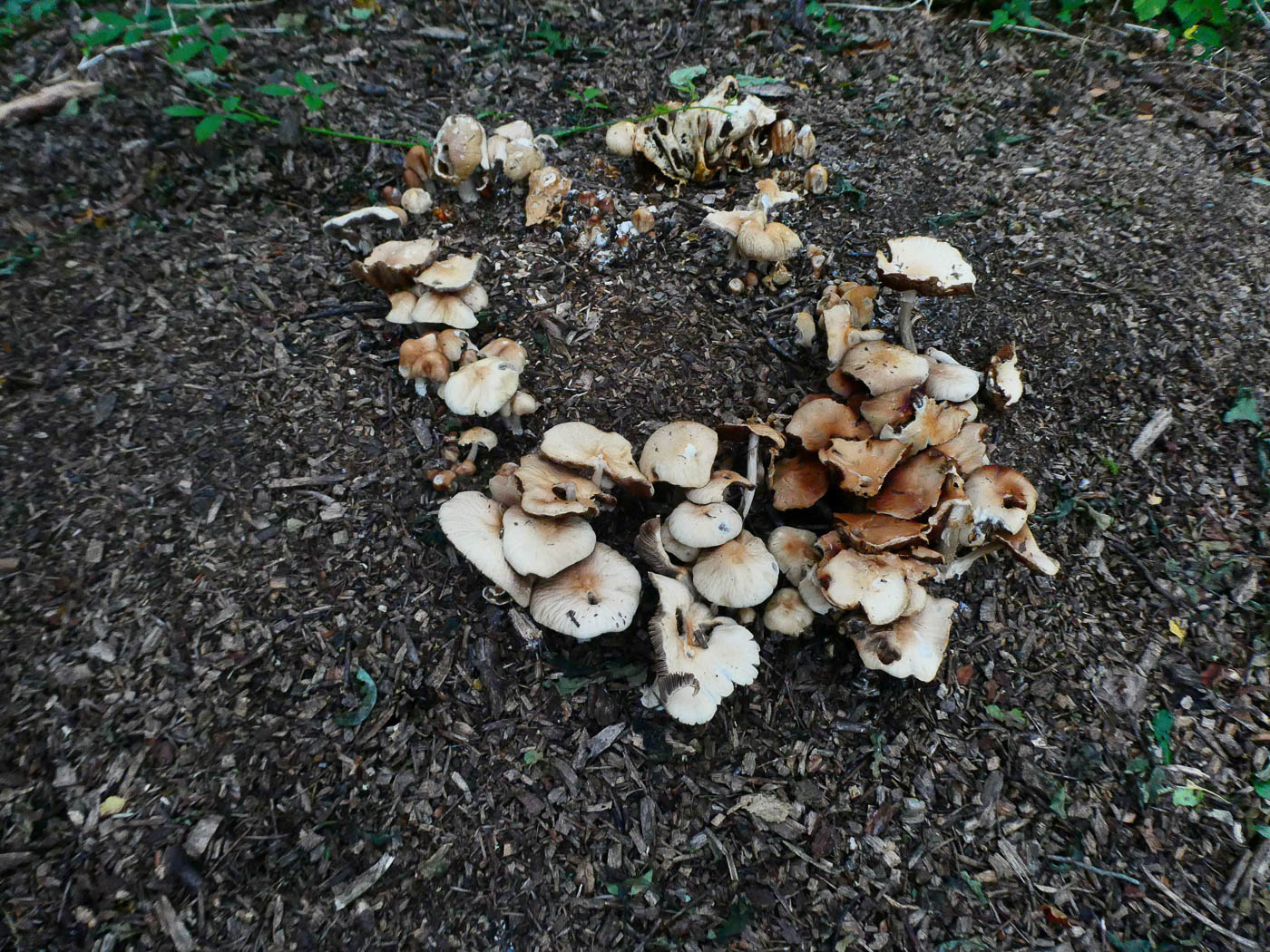
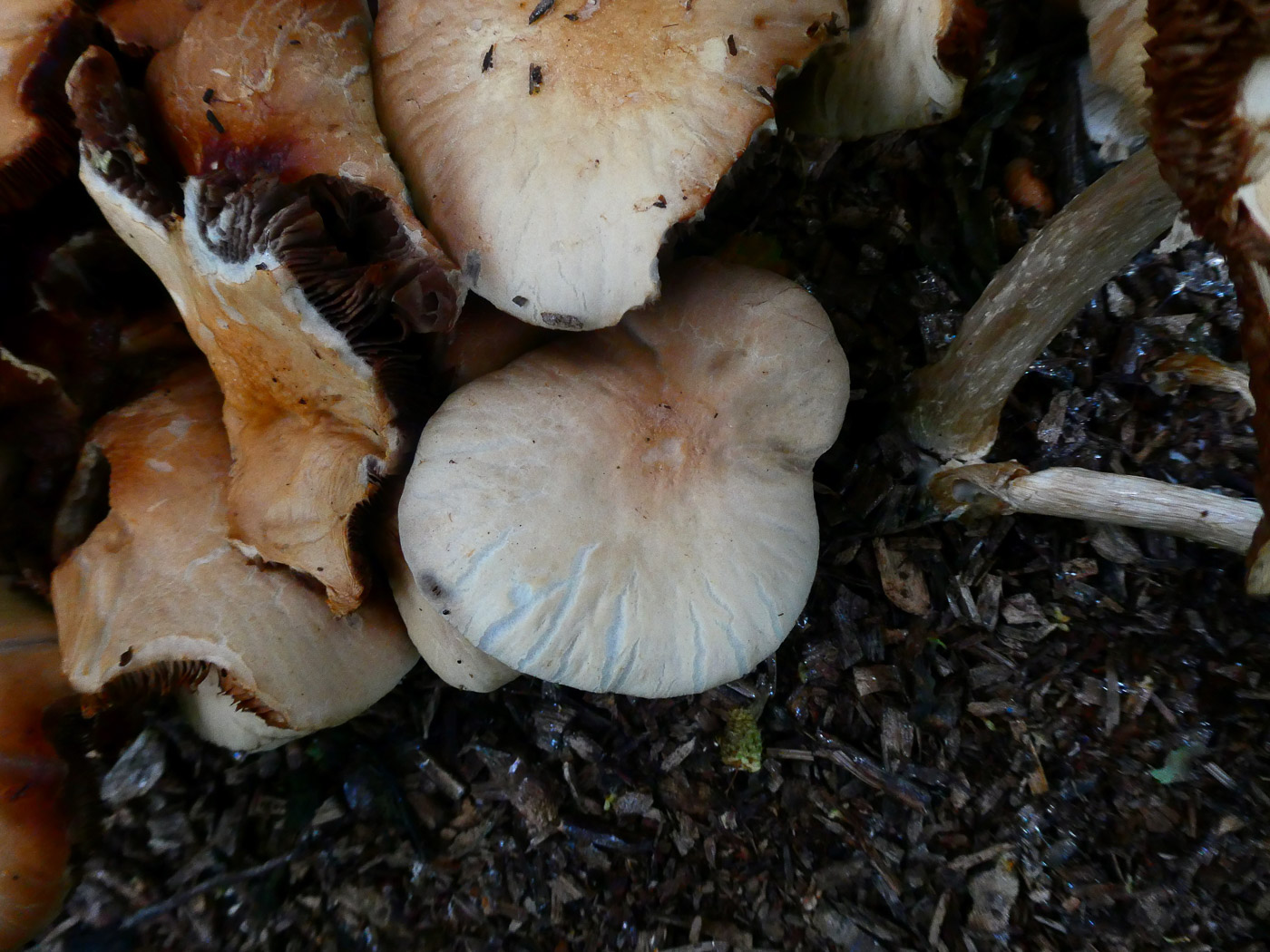
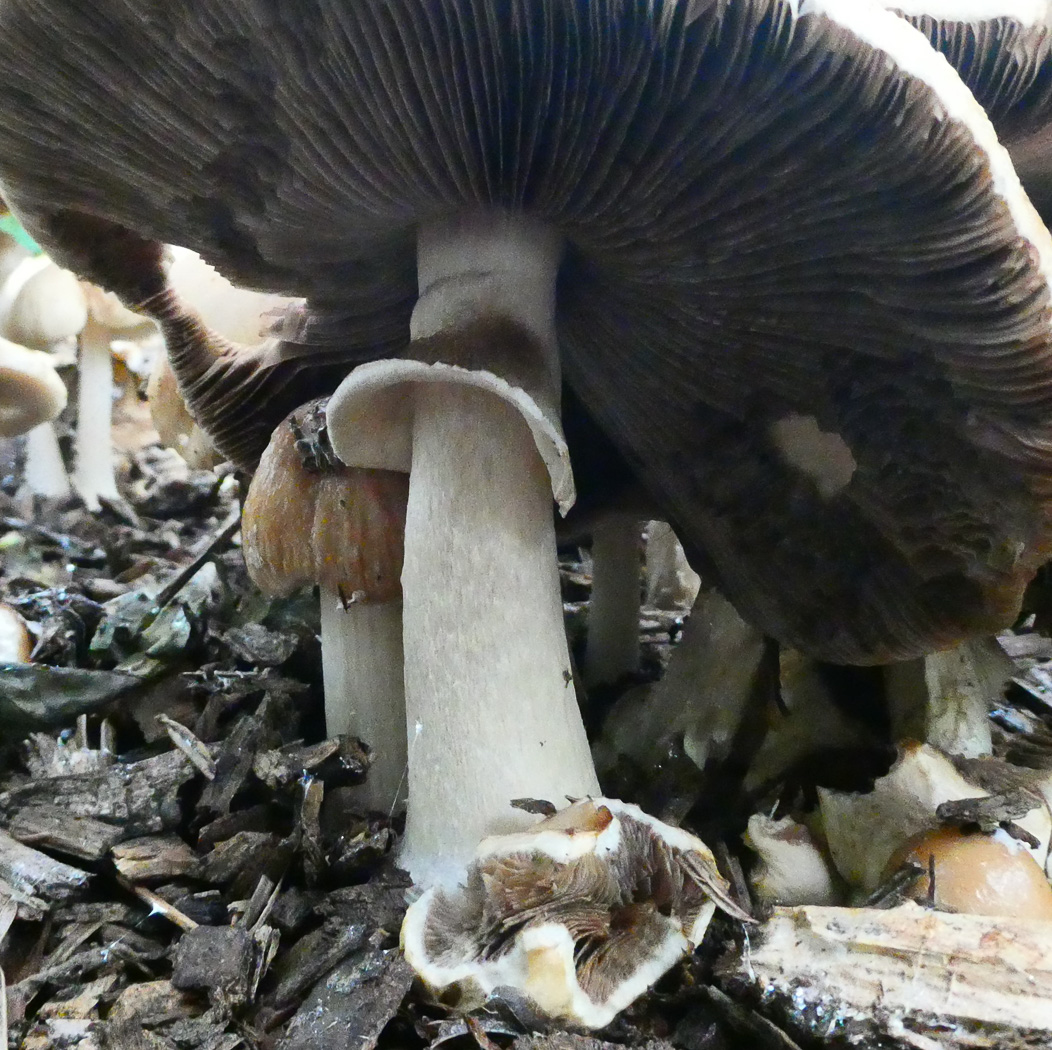 |
July 13th Agrocybe rivulosa (Wrinkled Fieldcap) On a path covered in old woodchips in Austenwood, Chalfont St. Peter, Jim Wills spotted several clumps of mushrooms obviously triggered into action after the recent rains. Described as an alien species which arrived here 20 years ago, probably on imported woodchip, it has spread rapidly and is now relatively common, favouring well rotted woodchip piles. Typical of the genus it has a pale cap not unlike Agaricus, fruits mainly in summer, has deep brown spores and a marked ring on the stem which hangs down (pendant - see photo 3). The cap soon develops deep wrinkles or fissures (see photo 2). Similar is Cyclocybe cylindracea - previously in Agrocybe and also found on woodchip. They can be separated by smell - farinaceous in today's species but aromatic in C. cylindracea, also with microscopy - the spores of today's species having a notably larger germ pore. Previous finds |
July 5th 2024
July 1st 2024

